
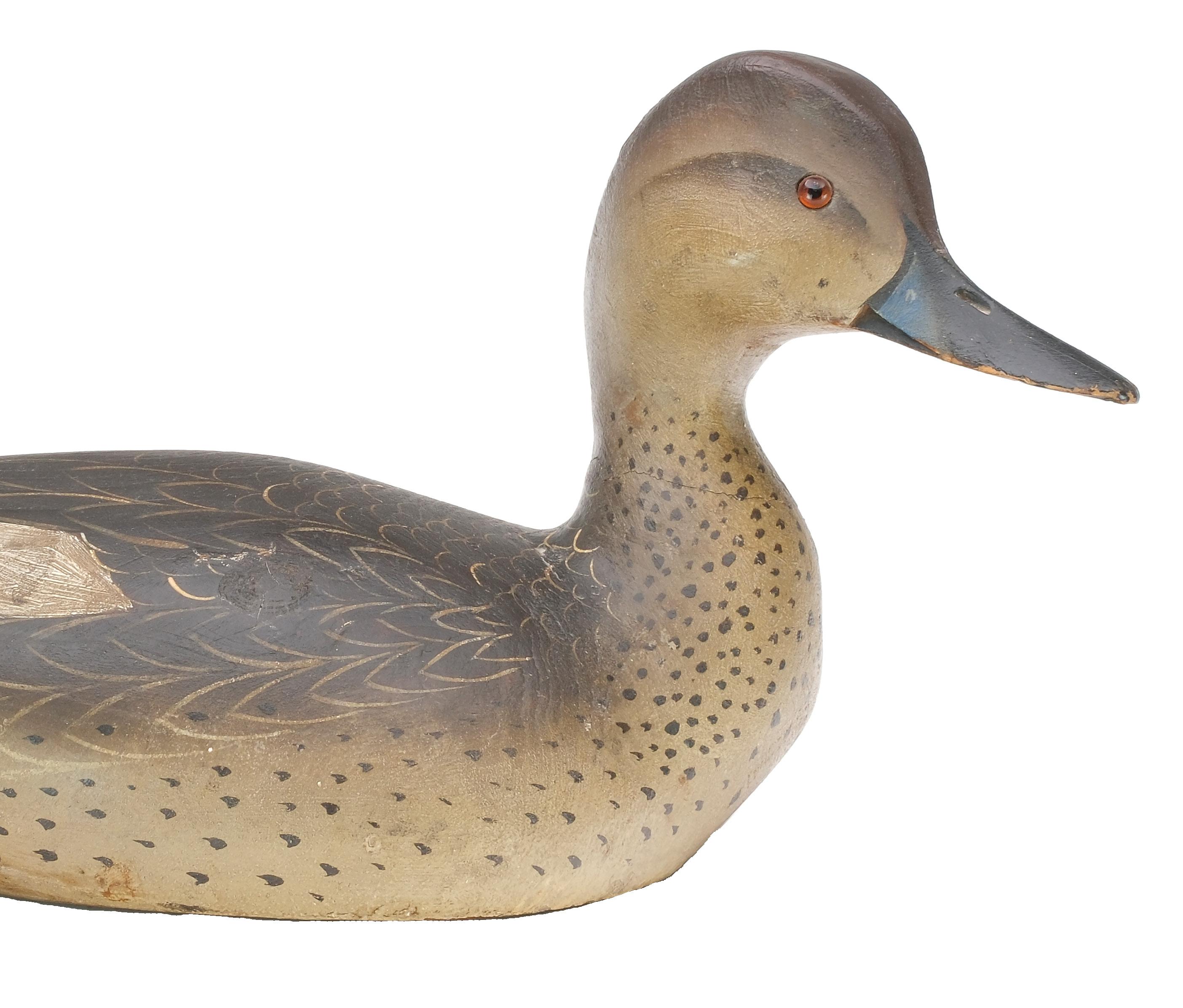
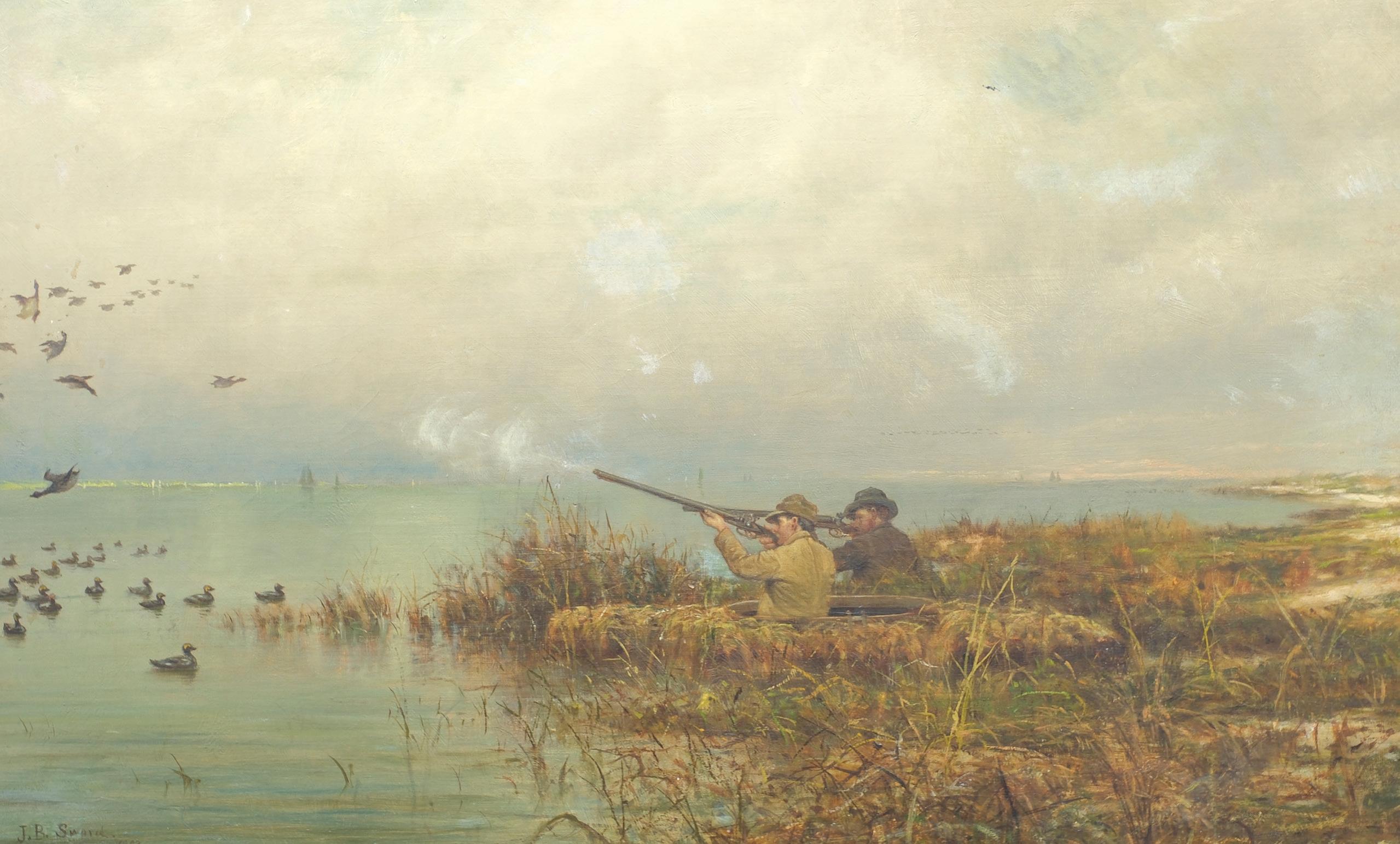
North American Decoys At Auction November 11 & 12, 2023 Guyette & Deeter, Inc.






58 6a 397 59 47 41
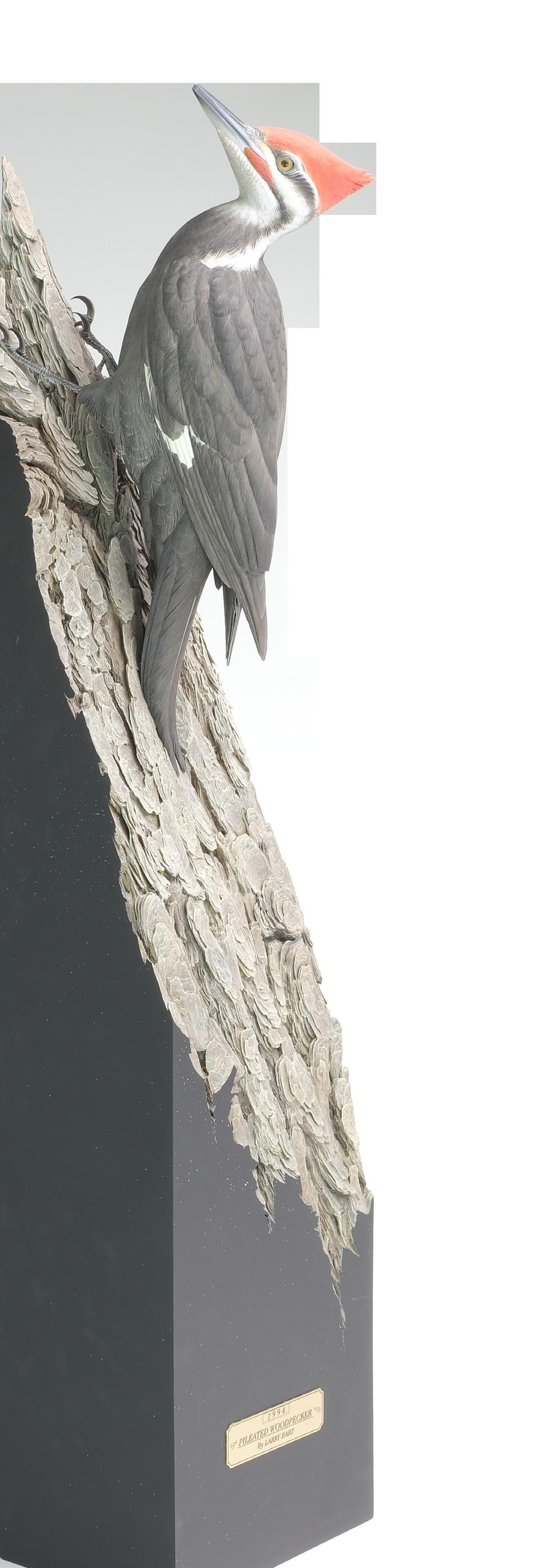

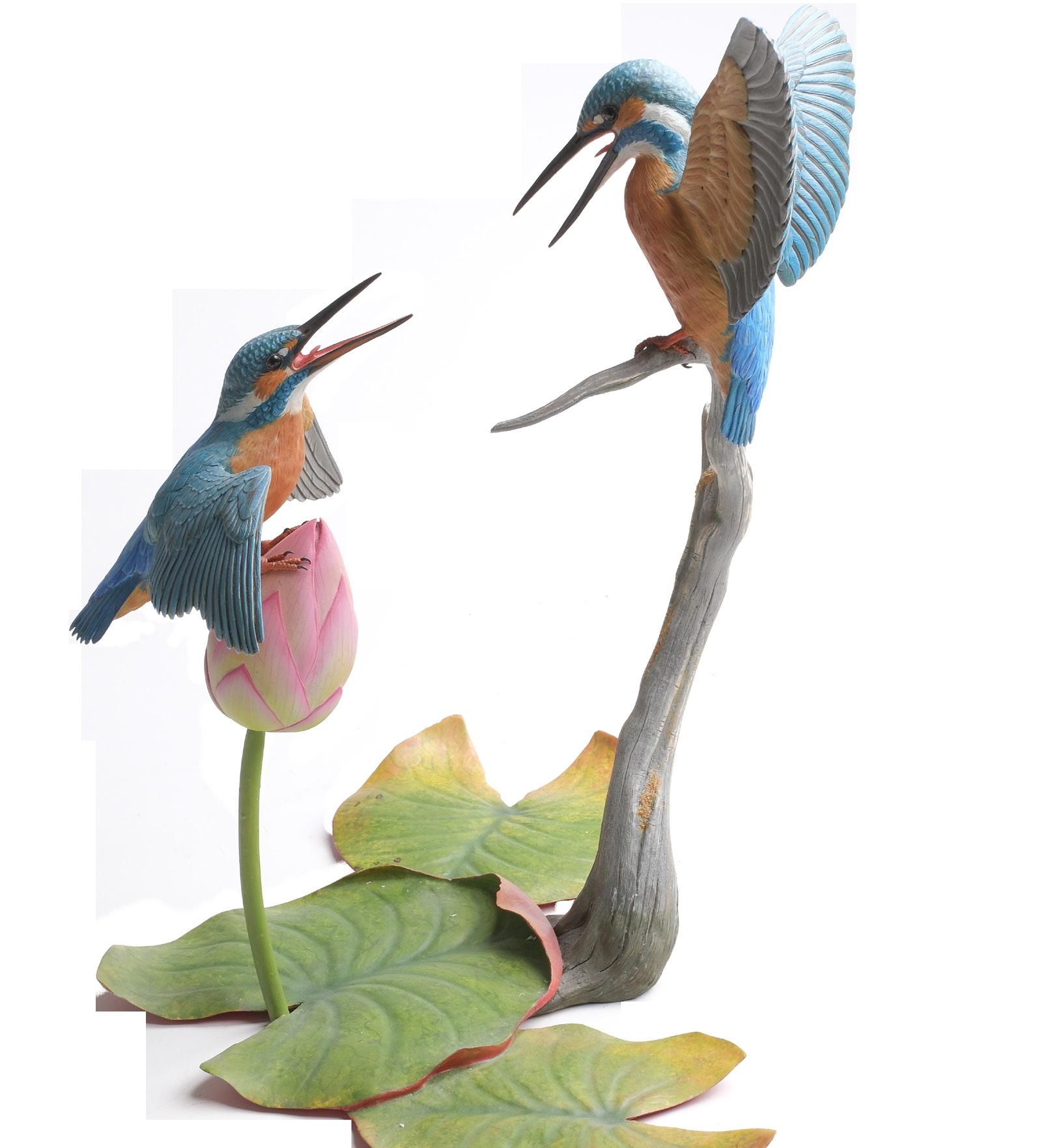

Guyette & Deeter - Decoys and Sporting Art at Auction
In conjunction with the Easton Waterfowl Festival
Schedule of events:
Thursday, November 9th
• 4PM: 52nd Annual Waterfowl Festival Opening Ceremony at the Tidewater Inn
• 5PM - 8:30PM: Waterfowl Festival Premiere Night Gala - Downtown Easton
• Tickets to the Waterfowl Fundraising Gala are $200. Receive a 10% discount by purchasing through the Guyette & Deeter office by calling 410-745-0485. You can pick up your tickets at the office, 1210 S. Talbot St in St. Michaels.
Friday, November 10th - The Country School, Easton, Maryland
Open to the public - no tickets needed!
The Country School is located at 716 Goldsborough St.
• 10AM - 7PM: 50 table, indoor decoy show and outdoor tailgating
• Limited tailgating space still available - contact the Waterfowl Festival at 410-822-4567 and ask for Megan
• 10AM - 7PM: The Harry Walsh Artifacts will be set up near the auction hall with a small taste of what will be on exhibit at the High School. Veteran Waterfowl Hall of Fame collectors Henry Stansbury, C. John Sullivan, and Kim & Ronnie Newcomb will be exhibiting decoys by Ira Hudson and Charles Nelson Barnard, as well as historical hunting accessories and tools of the trade.
• 4PM - 7PM: Guyette and Deeter welcome reception and auction preview
Saturday, November 11th - The Country School, Easton, Maryland
• 8AM - 5PM: 50 table, indoor decoy show and limited outdoor tailgating
• 8AM - 9:30AM: Guyette and Deeter Auction Preview
• 10AM - 5PM: The Harry Walsh Artifacts display
• 10AM - 5PM: Guyette and Deeter: Decoys and Sporting Art at Auction
Sunday, November 12th - The Country School, Easton, Maryland
• 8AM - 4PM: 50 table, indoor decoy show and limited outdoor tailgating
• 8AM - 9:30AM: Guyette and Deeter Auction Preview
• 10AM - 4PM: The Harry Walsh Artifacts display
• 10AM - 4PM: Guyette and Deeter: Decoys and Sporting Art at Auction
For more information on the Waterfowl Festival schedule visit www.waterfowlfestival.org/schedule
Guyette & Deeter, Inc.
North American Decoys At Auction

Held in conjunction with the Easton Waterfowl Festival
The live auction will be held at the The Country School
716 Goldsborough St
Easton, MD 21601
Friday, November 10, 2023
Welcome Reception and Preview
4:00 PM - 7:00 PM
Saturday, November 11, 2023
Preview 8:00 AM - 9:30AM
Auction 10:00 AM
Sunday, November 12 2023
Preview 8:00 AM - 9:30AM
Auction 10:00 AM
For questions during the auction call 410-745-0485
If you are interested in viewing a particular piece at the office, please call to be sure it will be available there at the time you plan to visit. We may also be in your area, and so a private viewing may be available. Please contact us for our schedule.
Catalog $45. Out of Country $70
Absentee, Phone & Online Bidding accepted call 410-745-0485 for arrangements
For free decoy appraisal contact:
Jon Deeter | jdeeter@guyetteanddeeter.com | 440-610-1768
Zac Cote | zcote@guyetteanddeeter.com | 207-321-8091
Cooper Rossner | cooper@guyetteanddeeter.com | 609-560-8028
Gary Guyette | gary@guyetteanddeeter.com | 410-745-0485
Important Notices:
■ GUARANTEE - We have made a concerted effort to accurately catalog and describe the property to be sold. The decoys and paintings have guaranteed condition reports. Should the need arise, the auctioneer reserves the right to make verbal corrections and provide additional information from the block at the time of the sale. Absentee bids will not be executed on items that are found to be other than described in the catalog. Since opinions can differ, particularly in the matter of condition, the auctioneer will be sole judge in the matter of refunds. If we fail to identify a flaw that has an impact on the value, you can return the decoy.
■ DURATION OF GUARANTEE - Requests for a refund on an item purchased through a Guyette and Deeter, Inc. auction must be made within 3 days of the time you take physical possession of your purchases. Whether your items are shipped, delivered, or picked up at the auction site, it is still 3 days from date of possession. This guarantee is null and void if payment is received or mail is postmarked more than 30 days from the sale end date. The guarantee is also null and void if you choose to not take possession of your purchases within the 30 days. If you have paid for your purchases within the 30 days but Guyette and Deeter, Inc is unable to ship your item within the guarantee period, the guarantee will be extended until 3 days from the shipping delivery date. This policy protects our consignors by enabling us to make consignor payments in a timely manner.

■ Under no circumstances will we be responsible for damage to frames or glass, or damage caused by them. Paintings determined to be of high value or large size may be subject to special packaging at the buyers expense. Under no circumstances will we be responsible for damage to fragile decoratives. These items are marked in the catalog with an *.
■ Stands are not included with the decoys or weathervanes unless specified in catalog.
■ All duck calls have condition reports, but are sold “As Is”.

■ Trade Up Program - A limited number of decoys purchased may be paid for by consigning decoys. To participate, please contact our office ahead of time to discuss details.
■ Free appraisals are available with no obligation to consign and any correspondence is strictly confidential.
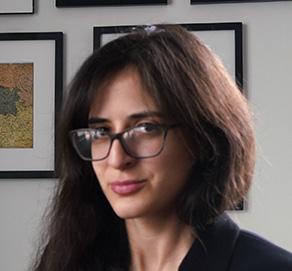
■ Pick up hours are 1pm – 5pm beginning November 15, or by appointment. Please call ahead so we can have your items ready.
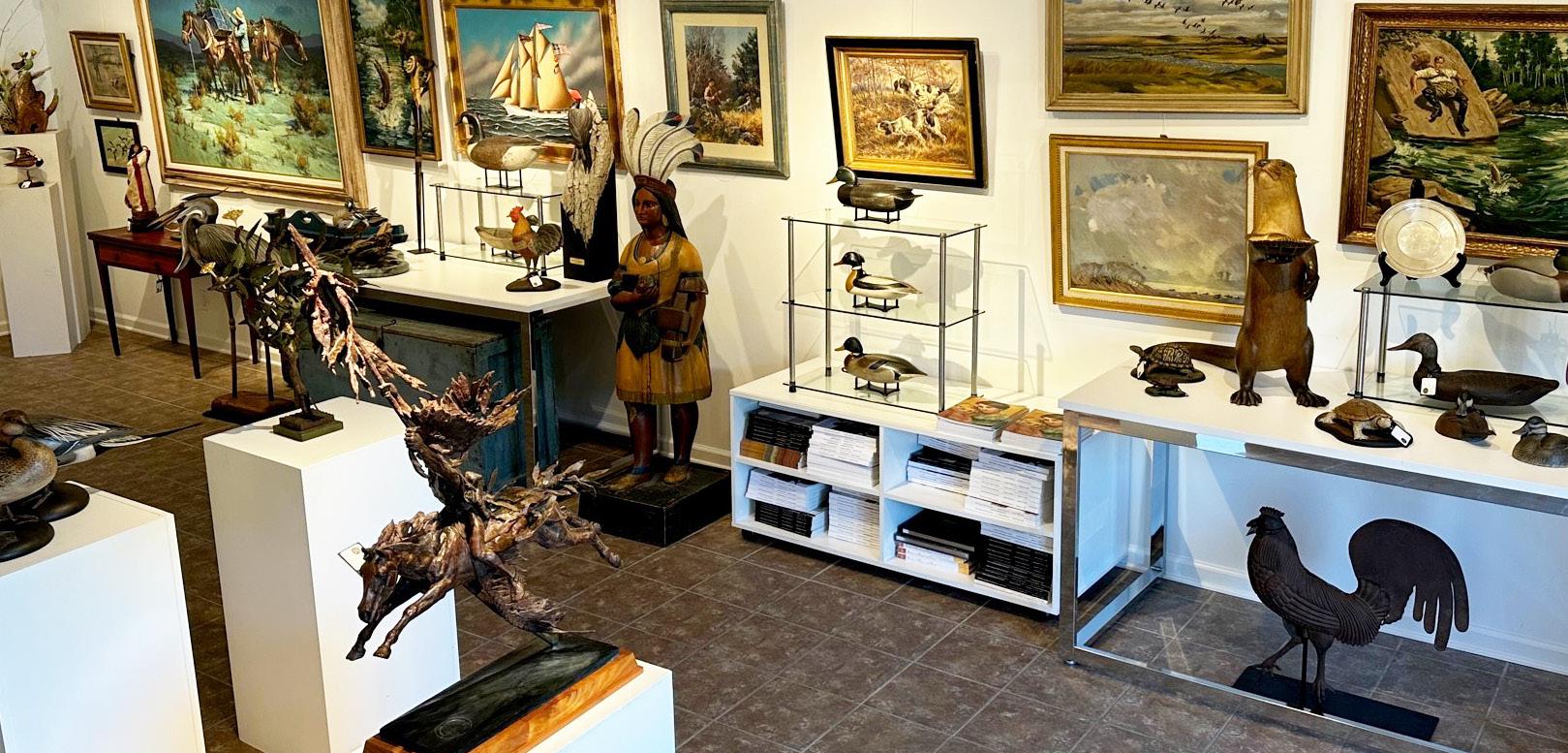
Future Auctions
New location | Same great town 1210 S Talbot St, Unit A | St. Michaels, MD 21663 February 2024 Fine Sporting Arms Chesapeake Bay Maritime Museum St. Michaels, Maryland April 25 & 26, 2024 Decoys, Sporting Art & Americana The Westin Chicago-Lombard Lombard, Illinois
Josh Loewenstein er F ine Sporting Arms Division Head
J. Wesley Dillon Fir earms consultant
Mehves Lelic Fine Art Consultant and Essayist
Jon & Leigh Ann Deeter

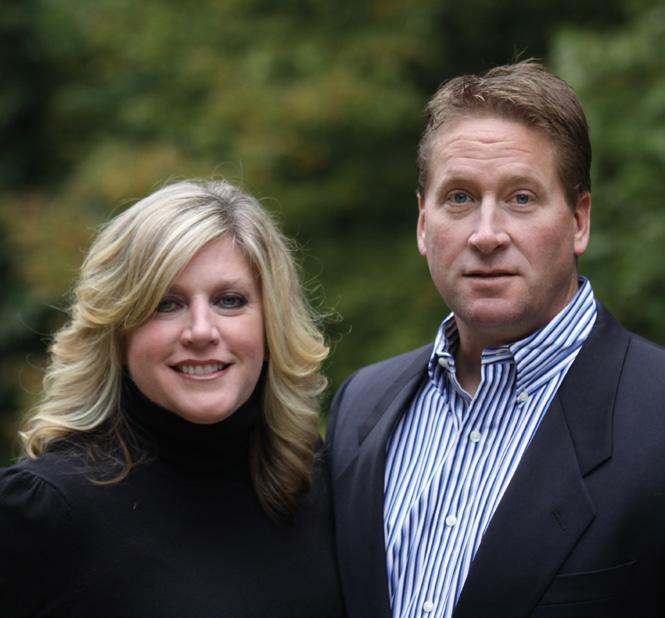
1210 S Talbot St, Unit A St. Michaels, Md 21663 Tel: 440-610-1768
jdeeter@guyetteanddeeter.com
Lacey & Zac Cote
PO Box 347 Freeport, ME 04032 Tel: 207-321-8091
zcote@guyetteanddeeter.com
Gary Guyette Consultant
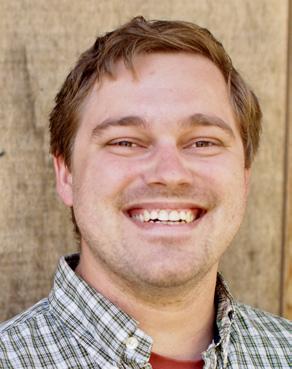



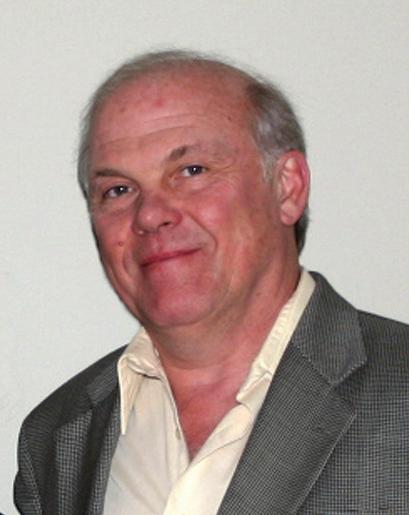
St. Michaels, Maryland Tel: 410-924-5678
gary@guyetteanddeeter.com
Ed Kenney
Merchandise Manager & Shipping
St. Michaels, Maryland Tel: 410-745-0485
shipping@guyetteanddeeter.com
Mike Stevenson Graphic Designer St. Michaels, Maryland Tel: 410-745-0485
michael@guyetteanddeeter.com
Allison Banks
Office Manager
St. Michaels, Maryland Tel: 410-745-0485
auction@guyetteanddeeter.com
A.J. Smith Photography
St. Michaels, Maryland Tel: 410-745-0485
photography@guyetteanddeeter.com
Mike Roberts Shipping
St. Michaels, Maryland Tel: 410-745-0485
ups@guyetteanddeeter.com
Cooper Rossner

Weekly Auction Manager St. Michaels, Maryland Tel: 609-560-8028
cooper@guyetteanddeeter.com
Stormi Lind
Bookkeeper
St. Michaels, Maryland Tel: 410-745-0485
billing@guyetteanddeeter.com
Megan Stroyan Clarke Finance Manager

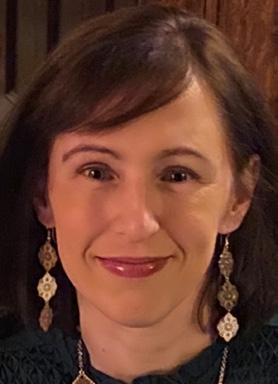

St. Michaels, Maryland Tel: 410-745-0485
billing@guyetteanddeeter.com
Bill Lapointe
Decoy Consultant and Essayist Swansea, Massachusetts Tel: 774-644-9426
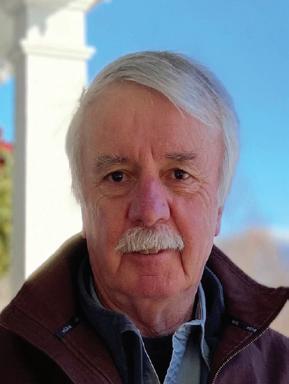
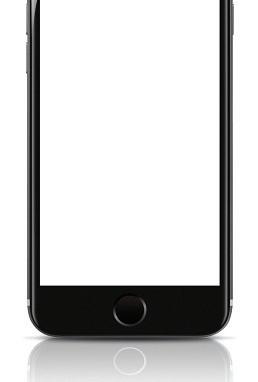
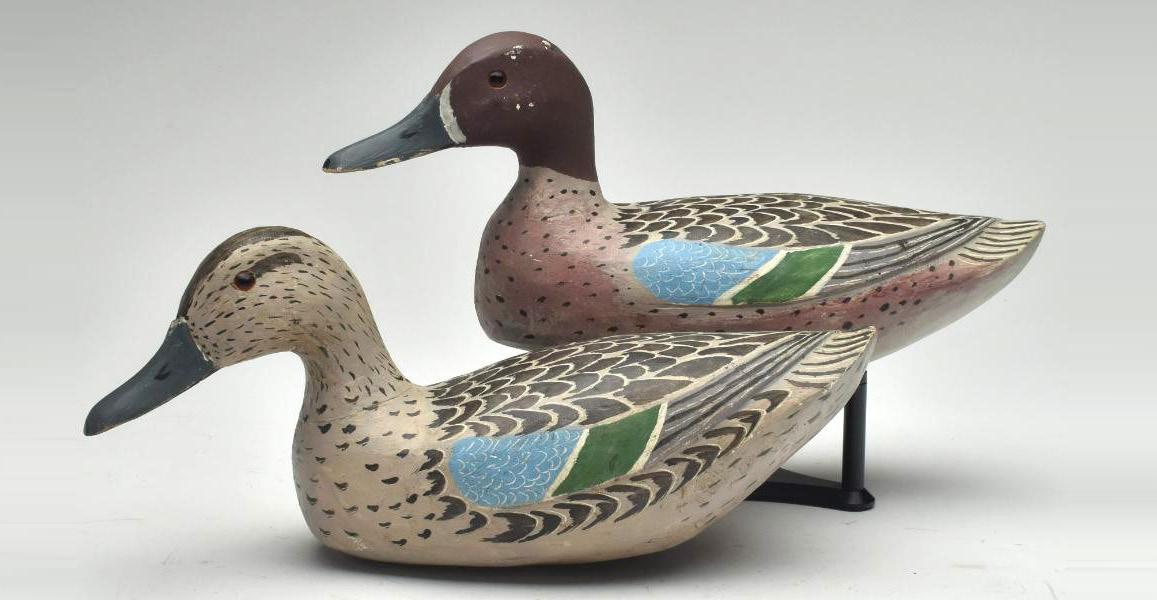



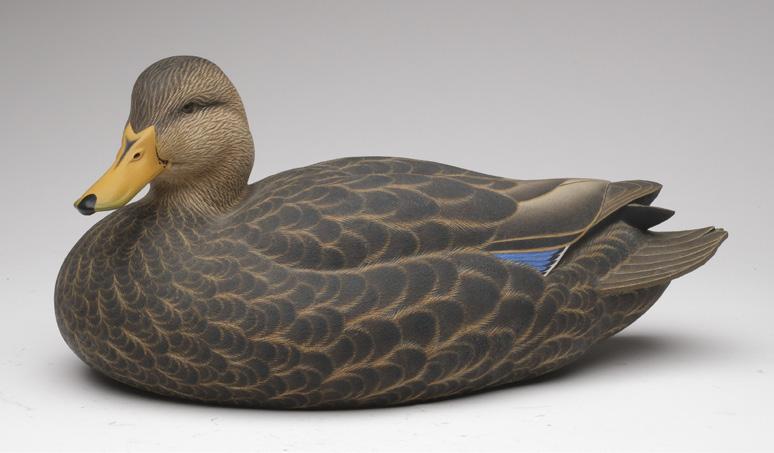

Weekly Online Auctions Ending Every Thursday Night Guaranteed condition reports, multiple photos, quick shipping, great deals on quality items Online Bidding Available for All Guyette & Deeter, Inc. Auctions The best way to bid online at Guyette & Deeter auctions with the lowest platform fee availa ble. Sa ve up to 4% using our app! Simply go to bid.guyetteanddeeter.com or use the QR code Online bidding features real time competitive bidding and live streaming video straight from the auction. bid.guyetteanddeeter.com | For questions, contact: Cooper Rossner 609-560-8028 | cooper@guyetteanddeeter.com 1210 S Talbot St, Unit A | St. Michaels, MD 21663 Recent Sales
Sold!
Pair of blue wing teal, George Frederick.
$4,080
“The Eastern Shoreman” goose call by Sean Mann Sold $4,082
Redhead, Mason Decoy factory. Sold! $5,160
Pair of bluebills, Jim Schmiedlin. Sold! $8,520
Black duck, Jett Brunet. Sold! $6,480
Session One
Saturday, November 11, 2023
10:00 am
Lots 1 - 251
Session Two
Sunday, November 12, 2023
10:00 am

Lots 252 - 477
Please read conditions of sale in the back of catalog

Ward Brothers Contemporary Carvings Virginia Shorebird Decoys Maryland New Jersey Elmer Crowell 100 - 118 Contemporary Carvings 119 - 147 Ward Brothers 148 - 157 Maryland 158 - 181 North Carolina 182 - 196 New England 197 - 219 Shorebird Decoys 220 - 233 Fish Items of Interest 234 - 251 10 - 25 26 - 47 48 - 57 58 - 82 83 - 99 233a - 233r 1 - 9 Jim Schmiedlin 252 - 258 Midwest 259 - 263 Factory Decoys 264 - 282 Illinois River 283 - 291 New York 292 - 296 Joel Barber collection 297 - 316 Sporting Art 317 - 360 Decorative Carvings 361 - 387 American West Charles Bergman New York 398 - 401 Maryland 402 - 417 Virginia 418 - 425 Miniatures 426 - 435 Shorebird Decoys Canada 439 - 451 Louisiana 452 - 466 Sporting Art 467 - 477 387a - 396 435a - 438 397
I had the pleasure of meeting Dave over forty years ago. We were both relatively new collectors but loved the “art of the deal” and, even more so, dealing with people. There was no way I could have imagined standing in the Havre de Grace gym in 1981 that I had just met one of the true characters in the decoy community and a-rest-of-my-life best friend.
Always the consummate gentlemen, Dave openly spent hours sharing his passion and knowledge of decoys with strangers who happened to pass by his booth, only to soon become part of his widespread group of friends. But it was behind the scenes where Dave starred as the omnipresent wheeler and dealer. On slow days at a show, Dave would look at me and say: “it’s time to get this party started”. He would then move from table to table and make bids on a whole slew of modestly priced decoys, only to reoffer them, sometimes at a gain – often at a small loss, at tables on the other side of the show. Dave loved collecting and admiring fine pieces, but what made his heart tick was ACTION!
Over the years Deve’s zeal to create action never ceased to amaze me. At the McCleary Auction my son worked with Dave to concoct a call-option transaction whereby Dave paid me a sum of money upfront to have the option for the next 24 hours to buy a pair of Sterling pintails I already owned at a pre-set price that was generous to me but lower then were he thought a similar pair would sell at auction the next day. Dave loved the many moving parts of this deal and spoke about it for years to come. During winter months Dave and I would chat frequently, and our conversations would often end with he or I offering to buy or sell a few decoys. Over a five-year period, I owned those same Sterling Pintails, that will be auctioned at this year’s Festival, five different times each time coming to and from Dave at various prices or in exchange for any number of other birds in trade. Dave’s primary purpose in all this was never about economics, but instead about fun – and oh what fun we shared between us.
A great thing I was able to watch for many years was Dave’s interaction as one of the “Three Musketeers” of the Decoy Community. Having the good fortune to spend in-truck-driving-time with Dave, Vance Strausberg and Larry Larramy was like witnessing a cross between the NFL draft and an IPO’s first day of trading on the NYSE. One day driving to New England the boys set
a record, I believe will never be broken, for the most decoy trades between common parties in a single day. At one point I recall 10 trades occurred in less than five minutes. On another road trip they developed a one-page ad, listing maybe 15 or so decoys they collected over the years among themselves that would be available for sale for one-million dollars. They then published the ad and had grins on their faces like kids who just won their Little League championship game. To this day I am not sure they ever sold a bird from the ad, but for them it sure was fun developing the idea.
In the past decade, I often would visit Dave at his farm. In the evenings we would share a fine meal and a drink and admire the many paintings, decoys and collectibles displayed around the rooms in his house. He would look upon the many Peterson’s and tell me little known facts about Oscar’s life or how he thought some of the lure’s he made had been used. He frequently would share with me his passion for hunting and then say he regretted never having hunted over a rig of Wards at some point in his life. In these moments I realized how much joy collecting had brought Dave throughout his life, and at the same time how much joy Dave’s friendship had brought others in their lives.... and to me in my life.

Dave, thank you for being my friend!
- John Collier
Dave and Dutchie enjoying the St. Michaels Decoy show 2014.
The David Fannon collection
In Memoriam
Dave Fannon introduced me to spearing decoys and was a powerful force for the direction and development of my affection for all decoy collecting. We met in the late 80’s while I was on the road antiquing with my Mom in a big cargo van headed to Kentucky. I was a small-time antique dealer in Oklahoma City, specializing in sporting collectibles, cabin décor, and was a picker for Ralph Lauren retail stores. When we got to the Mississippi River Mom said, “Have you ever been to Hannibal Missouri? That’s Mark Twain’s birthplace.” I replied, “No! Let’s go!” So, we made a hard left, changed course, and headed north up the Mississippi antiquing along the way.

Eventually we came upon St Charles Illinois where we saw a billboard that said, “Antique Show - State Fairgrounds”. We decided to stop, and I spent most of my money. As we were pulling out of the parking lot, I saw another smaller sign that said, “Decoy Show – Pheasant Run Resort” with an arrow pointing right. I was intrigued! It was already late afternoon, Mom was tired so we got a hotel room, and I took off by myself to Pheasant Run to look around. What an unexpected surprise! I had no idea that decoys were a whole collecting field!
I entered a bustling glass hallway that connected dozens of rooms where dealers were trading out of their rooms! Men were carrying all sorts of sporting items under their arms, and everyone was in camo or khaki! I could smell cigars and bourbon. Duck calls and mens laughter filled the hallways! It was glorious! Then I walked into this guy’s room where there were about 4 or 5 men talking. Both hotel beds and the dresser were covered with beautiful, fascinating, carved and painted fish, and a few locked glass-topped cases holding more fish. A friendly fellow with a broad smile said, “Hello there! What are you looking for?” He said his name was Dave, and offered to answer any questions. I looked all around at the fish and finally mustered the courage to say, “What are these?” Every head in the room turned and Dave said, “Where are you from little lady?” I replied, “Oklahoma”. He grinned this gigantic frisky smile and said, “Well, I don’t imagine there’s much ice-fishing out there in Oklahoma!” I asked, “What’s icefishing?” I noticed a couple of the other men’s brows lifted and eyes rolled. He moved a little closer and politely proceeded to explain in detail how ice-fishing and spearing-decoys worked! He encouraged me to examine the fish, and let me handle the better ones in the cases! I was captivated! The clouds parted, the heavens opened up, and the course of my collecting changed at that show! He described fishing techniques I’d never heard of! He answered all my naïve questions, and recommended some books, leaving me even more curious. He was generous with his time, he never blew me off, or tried to rush me out the door, nor treated me like an idiot, or someone who wasn’t going to spend any money. When I left, he gave me his card and said, “Now come back and see me Oklahoma gal!”
After immersing myself in what few books I could find, the next year I drove back up to the show at Pheasant Run. When I walked into Dave’s room he grinned that grin and shouted out, “Why there’s my Oklahoma gal!” That day we became friends! I began attending more auctions and shows, and we struck up a liking for each other! When I married my husband Dusty in the early 90’s he also came to love decoy collecting, and became very good friends with Dave as well. Dave was always enthusiastic and generous to share knowledge with us, even when we didn’t buy from him.
Thirty years later, when his wife Dutchy and my husband Dusty passed away, just a few years apart, Dave and I often sat talking about our spouses and sharing photos of happy memories during the auctions, and over cocktails and dinner. He adored his Dutchy, and beamed when he talked about her. In his last few years he needed help getting around at the auctions and I was delighted when he’d call and ask if I was coming to the next auction because he needed a dance partner! I was always honored that he wanted the assistance of my arm.
Dave Fannon was special. One of a kind. He was intelligent, curious, and mischievous. He was blunt, grumpy, and often held a grudge. He was also forgiving, generous, sentimental, a true patriot, a loyal friend, and the best hugger. You always knew where you stood with Dave, and I liked that about him. He was a passionate collector until the very end, a great storyteller, an adoring husband and father. And to me he was a gentleman, and the dearest of friends. All of us in the decoy world will miss his enormous personality, his rollicking stories, his prized fellowship, and that frisky grin!
Had I not turned north at the Mississippi River, I might never have met Dave Fannon. I can hardly imagine how drastically different my life would have been. I would have missed out on the grand adventures of decoy collecting…..and a most remarkable friendship. For so many of us, auctions and shows will never be the same without him. I pray there are decoy events in Heaven, because I know Dave won’t be hard to find.
The David Fannon collection
An Outstanding Mentor… and the Life of the Party!
I feel fortunate that just as I was starting to get serious about decoys, Dave was one of the first people I met. It was at a small decoy show in Pennsylvania, where I was excited to learn he had been the owner of a DLF-branded Canada goose decoy I had recently purchased at an antique shop. His first words to me as I handed him the decoy were: “Son of a bitch, I haven’t seen that bird in 10 years – damn kids stole the whole rig right off my farm… where the hell did you get it?” I told him the whole story and, despite my young age at the time, assured Dave that I was not one of the “damn kids” who had stolen the geese from his field. He grinned from ear to ear, laughed and immediately put me at ease. He seemed delighted to meet a new collector, and when I told him I lived in Alexandria, Virginia, not far from where he had grown up, we really hit it off.
It was a long drive out to Amissville, but it was always worth it. Most times I would find something great to take home, but even when I didn’t, I left with great stories, new information about important decoy makers and hunting rigs, and most importantly, I left with insights and perspectives on what makes a great collectible decoy. I’ll never forget Dave’s early advice that you should look for great form or great paint when considering a decoy
and when you find both in the same bird, you buy it. To this day, many of my favorite decoys are birds that once sat on Dave’s shelves. And in a few cases, I know he sold me decoys that he really wasn’t anxious to part with, but he knew they would find a great home with me.

He was loud and gruff and the life of the party, but he was also patient, encouraging, enlightening and always a lot of fun to be around. He sharpened my focus as a collector, pushed me toward better birds and always struck deals that made it possible for me to land the
members will never forget the incredible decoys Dave brought to our club meetings, and the epic but always good-natured display competitions, many with friend Barry Serafin, that he so thoroughly enjoyed. I will also never forget the time he brought the most incredible pair of high-head canvasbacks by Charles Nelson Barnard to one of our club meetings and just put them casually in the middle of the table as a centerpiece, amidst all our burgers and beers.
Another great memory comes from an East Coast Decoy Collectors gathering many years ago. It was in the evening, when everyone gets back to the hotel from dinner and gathers in the rooms to enjoy a drink, talk about the good old days and those great decoys that got away. I was in one of the rooms with Dave where the tall tales were in full swing when in walked a couple we didn’t recognize. I later found out they were brand new to decoys and this was the very first decoy event they had attended. They seemed nervous and out of place but very interested in all the decoys they were seeing. Dave got up from the party, which continued to go on behind him, and walked over to the couple and introduced himself. He then proceeded to talk to them about decoys for 20 minutes, patiently answering every question they had. And this wasn’t even in Dave’s room. Seeing this was a big deal to me, because I know how much Dave loved being in the middle of all the storytelling action, but he was always willing to help out and encourage new collectors and serve as a great ambassador for our hobby. That’s who Dave was.
The tailgates and auctions won’t be the same without Dave there, but I will always remember what he taught me and treasure the birds on my shelves that passed through his hands. And whenever I think of his everpresent grin and that hearty laugh, I’ll smile and know there’s a part of him still here with us.
–
In Memoriam
Dave Fannon was a great friend. We hunted, fished, traveled and collected together for about 40 years. Mostly we hunted on the Chesapeake but also in Saskatchewan, Manitoba and Ontario. In Canada we always went with other waterfowl decoy collectors, all great friends!
Dave also liked to fish, making numerous trips to Alaska to fly fish. All of this took a back seat to his passion for collecting and deal making. He liked to collect groups. If he found a bird he liked there soon would be a similar one by that maker.

Of course, the collection changed frequently, giving the opportunity for new finds.
It is hard to tell how many decoy events we attended. Some were great, some were slow. The slow shows would always be brought to life by Dave. He could make things happen and he did.
Along the way spear fishing decoys became a new favorite. He could collect a group and carry them all in one suitcase! His Oscar Peterson collection was one of the best known.

All of this gave Dave the opportunity to make new friends and collectors. Our collecting would have a huge hole in it – and I don’t think it will ever be filled.
- Vance Strausburg
I met Dave in the mid 80’s at an antique shop in Madison, Virginia, where I bought my first old decoy. We talked and discovered we both enjoyed hunting, fishing, and decoys. Dave invited me to visit his farm in Amissville and our longtime friendship became established. Later, we began setting up at small Virginia venues and these venues grew to larger shows – Ward, Cleveland, and Chicago.
Over the years Dave and I shared many good times, adventures and laughs and very few disputes. He was a great friend and mentor and will always be in my daily thoughts.
If anyone is interested in hearing other stories about Dave, stop me and ask and I’ll be glad to share. Fond memories,
- Jon Ritchie
Ward Brothers Crisfield, Maryland
The Ward’s reputation for excellence is well known among the decoy collecting community. Their lives have been well documented in numerous books and articles devoted to them and their work. Both men, like their father before them, were, initially, barbers by trade in the hardscrabble, working, coastal community of Crisfield. Ducks and geese were vigorously hunted, not only for sustenance but, until 1918, also as a welcome source of income. As one would expect, the brothers’ first decoys were produced for their own use, as well as that of their immediate neighbors. After WWI and the Great Depression of the 1930’s, economic conditions throughout the country began to improve, and the hunting of waterfowl as a necessity, changed to pursuing the birds for sport. This new attitude saw the demand for decoys shift into high gear. The Ward’s were quick to capitalize on the trend, and their carving efforts, as well as their creative genius, flourished.
The brothers certainly were not the only ones carving decoys. Talented, and some not so talented, craftsmen and hobbyists throughout the seaboard produced birds for the hunt. There was a major difference, however. Most carvers worked to develop a particular style of decoy that they felt was workable and, once satisfied, they rarely wavered from that style. The Ward’s, on the other hand, were never satisfied. At any given
period, they sought to produce the very best decoy they could. Over their carving career, their decoys saw distinctive shifts in designs as the two men constantly sought perfection. Today, these changes have been categorized or identified by descriptive terms that reflect the design at the time. Labels such as “Fat Jaw”, “Knot Head”, “Hump Back”, “Slot Back” and others began to appear in collector’s vocabulary. Other designs were classified on the basis of when they were produced, the “1936 classic” style being a typical example. Finally, some readily identifiable designs emerged based upon a special order being filled, such as the decoys destined for clubs like “The Bishops Head Club” and “The Deal Island Club”. From about the late 1950’s through the 1960’s, sport hunting began to decline in popularity and wooden decoys were rapidly being replaced with those using more “modern” materials. The Ward’s fame by this point had spread across the country and they adapted by shifting to more decorative work to supply the increased demand from the new breed of decoy collectors.
1 Outstanding pinched breast style pintail hen, Ward Brothers, Crisfield, Maryland, circa 1931. Head is slightly turned and reared back. “Pintail female 1931” written in pencil on underside. This is one of the most desirable body styles of the Ward brothers work. This is an extra fine example. Measures 17.5” long. Very minor roughness on edge of bill, otherwise excellent and original.
Literature: “The Ward Brothers’ Decoys: A Collector’s Guide”, Ronald J Gard and Brian J McGrath, page 60 and 54, rigmate pictured. (40,000 - 60,000)

12
Session One • Saturday, November 11, 2023 • 10:00am
Even though neither brother received any formal training in art, their work was always of the highest quality, both in terms of carving as well as paint. All their decoys are considered highly desirable and collectible. Certain styles, however, have achieved particular prominence in terms of rarity and desirability. The coveted “Pinch Breast” designs created around 1932 are considered some of the very finest ever produced by the two men. Their quality was admired by early sportsmen of note, such as Dr Edgar Burke and Glen L Martin who included them in their rigs, as did prestigious private clubs, such as the White Mallard Club in California, which ordered a number of this style for use by its members. Early sporting author Eugene Connett, in his 1947 “Duck Shooting Along The Atlantic Tidewater”, chose to picture this style in his book labeling it “(A) contemporary decoy made by Lemuel T Ward - - - “. Whereas other styles can be seen in a wide variety of species, the Ward’s seem to have only employed this pinch breast design in a very limited number of canvasbacks, pintails, bluebills, and goldeneyes. As their description implies, they are characterized by the distinctive contour between the front of the breast and the side, or wing portion, of the bird’s body, which effectively gives the illusion of a swimming bird. Their heads are held high, and the bill carving is distinctive, with the dished-out forehead just above the bill being a feature not normally seen in Ward decoys. As with other decoys by the Ward’s, their painted plumage is outstanding.
Noted collector and author Ron Gard sings the praises of this style labeling it “spectacular” . He goes on to state that “the design is the best in Ward pintails - - - “ and concludes by proclaiming them “very rare” .


This is an extra fine example that has never been offered at auction.
Rare pair of 1948 model greenwing teal, Ward Brothers, Crisfield, Maryland. Balsa bodies with slightly turned cedar heads. Both have a 3” long ice dip behind the neck. Fine feather paint detail. Measure 12” long. Near mint original paint; structurally very good.

Literature: “Ward Brother Decoys,” Ron Gard and Brian McGrath. (8,000 - 12,000)

2
3 Pintail hen, Ward Brothers, Crisfield, Maryland. 1948 style with balsa body and inserted cedar tail. Head is turned approximately 30 degrees. Signed and dated on the underside. Measures 15.75” long. An almost unnoticeable hairline seam in bill where it appears to have been cracked and tightly reset, otherwise near mint.
Provenance: Gary Ross collection. (3,000 - 5,000)
4 Rare rigmate pair of mallards, Ward Brothers, Crisfield, Maryland, circa 1954. Both are keeled, with “LT Ward & Bro, Crisfield, Maryland” written on side of keels. Both have turned heads, balsa body, and hardwood inserted tails. Measure 18” long. Both are in strong original paint with very light wear, mostly from handling.
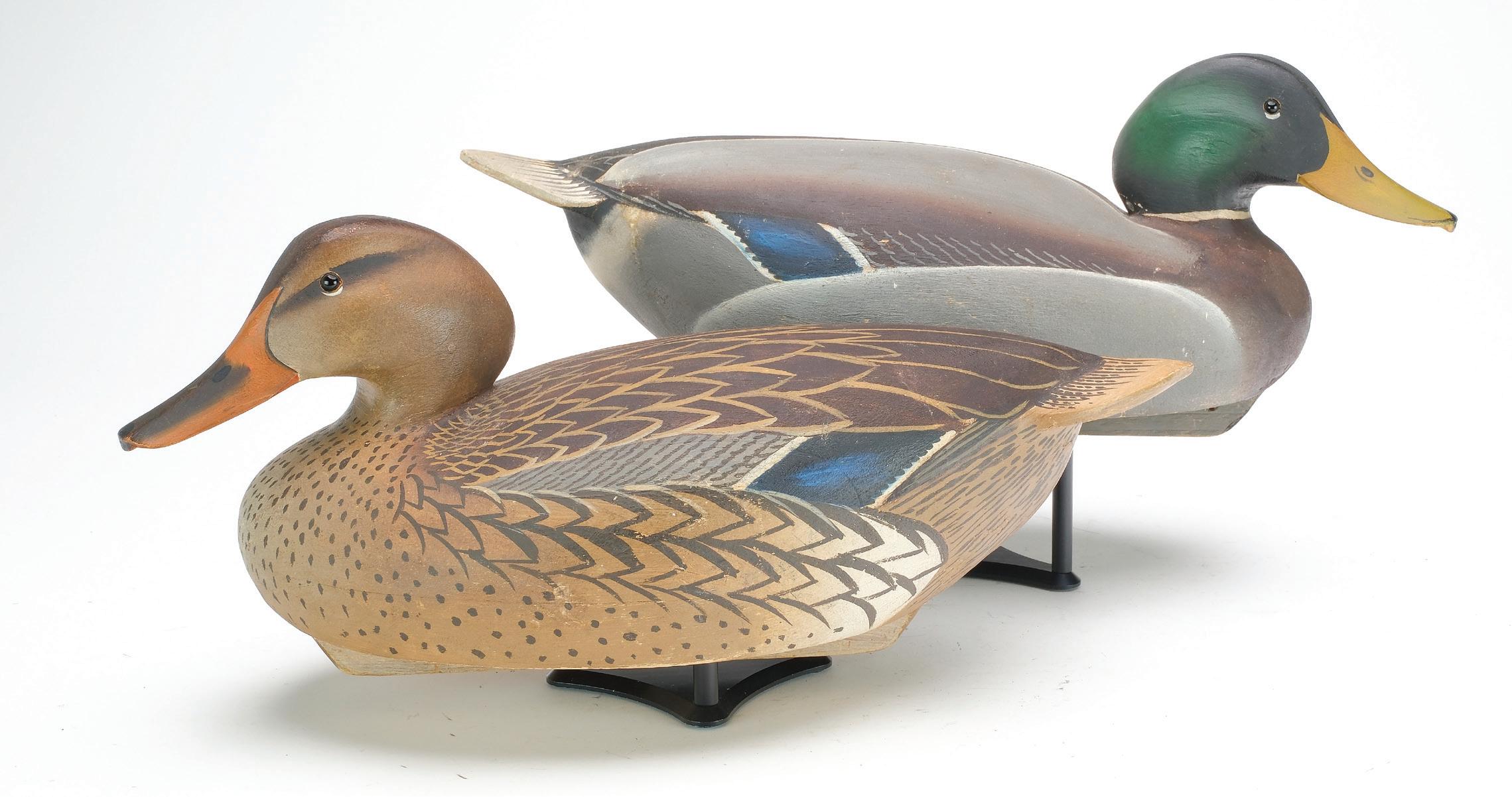

Provenance: David Fannon collection.
Literature: “The Ward Brothers’ Decoys: A Collector’s Guide”, Ronald J Gard and Brian J McGrath, page 84, similar decoys pictured. (5,000 - 8,000)
15 3
4
5 Mallard, Ward Brothers, Crisfield, Maryland. 1936 style with head turned 45 degrees. VL&A ink stamp on the underside. Decoy was never rigged or weighted. Measures 16.5” long. Original paint with minor flaking and wear; hairline crack through neck with minor flaking, otherwise excellent structurally.


Provenance: David Fannon collection. (10,000 - 14,000)

5
6 Bluebill, Ward Brothers, Crisfield, Maryland. 1936 style with slightly turned head and thick stipple paint on back. Bill Purnell collection brand on the underside. Also signed and dated by the makers at a later date. Measures 16” long. Original paint with minor discoloration and wear; tiny chipping and roughness on edge of bill; minor separation to filler on one side of neck seat; minor roughness on one edge of tail.

Provenance: Provenance: William Purnell Jr collection. Dave Fannon collection.

(6,000 - 9,000)

The decoy that brought recognition and fame to Crisfield
The first record of anything that resembles the modern Decoy Show was held in 1876 at the International Centennial Exposition in Philadelphia. This contest focused purely on the decoy’s ability to function as an object to attract the live bird, something of vital importance when wild game still played a major role in the American diet. Ben Holmes of Stratford, CT won this inaugural exhibition. By the early 1900’s, game, including waterfowl, began to play a relatively minor role in feeding Americans, and the population was beginning to develop a more conservation minded attitude. Joel Barber (and others) began to recognize the decoy as something to be enjoyed for its aesthetic value, in addition to functioning as a tool of the hunt. In 1923, Barber joined forces with the Anti-Duskers Society in Bellport, NY (Long Island), a group of sportsmen acting to put an end to shooting after dark, to stage what is now recognized as the first true decoy show. Function was still paramount, but the decoy was now, for the first time, judged on more than its ability to act as simply a lure. Shang Wheeler was the overall winner of the 1923 show. The contest was received with enthusiasm and was repeated in 1924, but not again until 1931 and 1932. From 1948 through 1951, decoy contests were held at the National Sportsmans Show and the National Decoy Makers Contest in New York City.

The 1948 contest was sponsored by the F.M Schaffer Brewing Co and was held at the Grand Central Palace, the foremost exposition hall in New York at the time. The contest was well advertised in numerous newspapers and periodicals such as “Field and Stream” magazine. Lem and Steve were talked into entering the competition by a friend. This proved to be very sage advice on the part of the friend, when their sleeping mallard drake won “Best of Show”.
In 1948, Lem was 52 and Steve was 53. By this point, they had been carving for quite a while, and had experimented with a number of styles, all meant primarily for the hunter. The wooden bird, however, was beginning to be surpassed by alternative materials and more economical construction processes. The 1948 show, as evidenced by the Ward’s winning entry, saw the widespread acceptance of the decoy as both a functional and a decorative object. The Brother’s name recognition became more far flung and orders began to flow into their small shop in Crisfield. The sleeping mallard was the beginning of their shift in design concept from working birds to, ultimately, completely decorative carving. It is a decoy of major historical significance.
It would be fair to say that it was the 1948 show that catapulted the Ward’s to their national recognition as the amazing artist that they were.
18
6a
One of the most iconic and important Ward Brother’s decoys to be offered at auction. Sleeping mallard drake made in 1948, partially, if not totally responsible for catapulting the Ward’s fame in to national notoriety. Also included with this decoy is the exact sterling silver serving engraved tray which reads, “Best in Show 1948, National Decoy Makers Contest, National Sportsman Show, New York City. Presented by R.J. Schaffer to LT Ward”. The exact ribbon is also included and the button at center reads, “National Decoy Makers Contest 1948.” Branded “WHP Jr” tiwce


in underside for Bill Purnell, and “SGH” for Somers G. Headly. In Ward pen on underside is written, “Best Decoy, New York Sportsman Show 1948 LT Ward Crisfield, Maryland”. Balsa body with inserted hardwood tail and carved pine head. Eyes are painted to imitate a resting or sleeping pose. A stamp or sticker of a photograph taken at the show was affixed to one side of the body. A small rectangle near the head impression is left where the entrance number for the decoy would have been. There is also a display card on the underside created at the time the decoy was in the collection of Somers Headly. Measures 15” long. Paint is excellent and original with a few small nicks and spots from handling wear.
Literature: “The Ward Brothers’ Decoys: A Collector’s Guide”, Ronald J Gard and Brian J McGrath, page 8 and 84, exact decoy pictured. (35,000 - 75,000)
7 Early fat jaw bluebill hen, Ward Brothers, Crisfield, Maryland, circa 1915. Slightly extended, paddle tail with turned head and glass eyes. Measures 15” long. Structurally good with approximately 50% paint missing, of the paint that remains, most of it is original with the exception of a lighter brown color that appears some places on breast, side of cheek, and small spot of back; original stippling on the body; retains texture; one wing patch has remained intact. (4,000 - 6,000)


Pintail, Ward Brothers, Crisfield, Maryland. 1936 style with slightly turned head. “MK” branded on the underside for the collection of Mort Kramer. Also signed and dated 1936 by the Ward Brothers at a later date. Measures 16.5” long. Original paint with moderate gunning wear; small dents and shot marks; minor roughness on edge of tail and bill; rust staining on breast from a nail and corrugated fastener used in the making.

Provenance: Mort Kramer collection. Gary Ross collection. (5,000 - 8,000)

8
Pair of canvasbacks, Ward Brothers, Crisfield, Maryland. 1936 models with slightly turned heads. Signed on the undersides at a later date. Measure 16.5” and 17” long. Original paint with minor flaking and wear; one side of hen’s bill with a professional chip repair; hairline crack in drake’s tail.


9
Provenance: David Fannon collection. (20,000 - 30,000)
In the 1930s, the Ward Brothers were at the top of their game for several reasons. They had been making decoys since about 1918, so they had honed their skills of carving and painting. They were young and physically able to handle the grind of turning out large volumes of decoys, but also mentally able to concentrate on the quality. They were still somewhat undiscovered as celebrities, so they did not yet have the distractions that burdened them in their later years. The decoys made during these years are sought after by collectors from across the globe. Most specifically, the decoys in the style known as “1936” are iconic within the scope of the Ward Brothers’ work. This pattern was created, perfected, and produced from about the early 1930s until about 1945.

23
Mark McNair b. 1950 | Craddockville, Virginia
10
Pair of American mergansers, Mark McNair, Craddockville, Virginia. Long hollow carved bodies. Relief carved wings and eyes. Hen with extended crest. “McNair” carved on the undersides. Also with 1997 stamped into the lead weights. Measure 21.75” long. Made to appear older, excellent and original.

Provenance: Mark and Ann Terry collection.
(2,500 - 3,500)
11 Trio of running curlew, Mark McNair, Craddockville, Virginia. Carved in the style of the once world record curlew from Massachusetts. Relief wing carving with raised wingtips. McNair carved in the underside. Bills are carved wood. Measure 22.5” long. All are excellent and original.

Provenance: David Fannon collection.
(3,000 - 4,000)
24
10 11
Greenwing teal, Mark McNair, Craddockville, Virginia. Hollow carved with relief wing and raised wingtips. Head with extended crest is tucked on to body. “McNair” carved on the underside. Measures 12.25” long. Excellent and original.
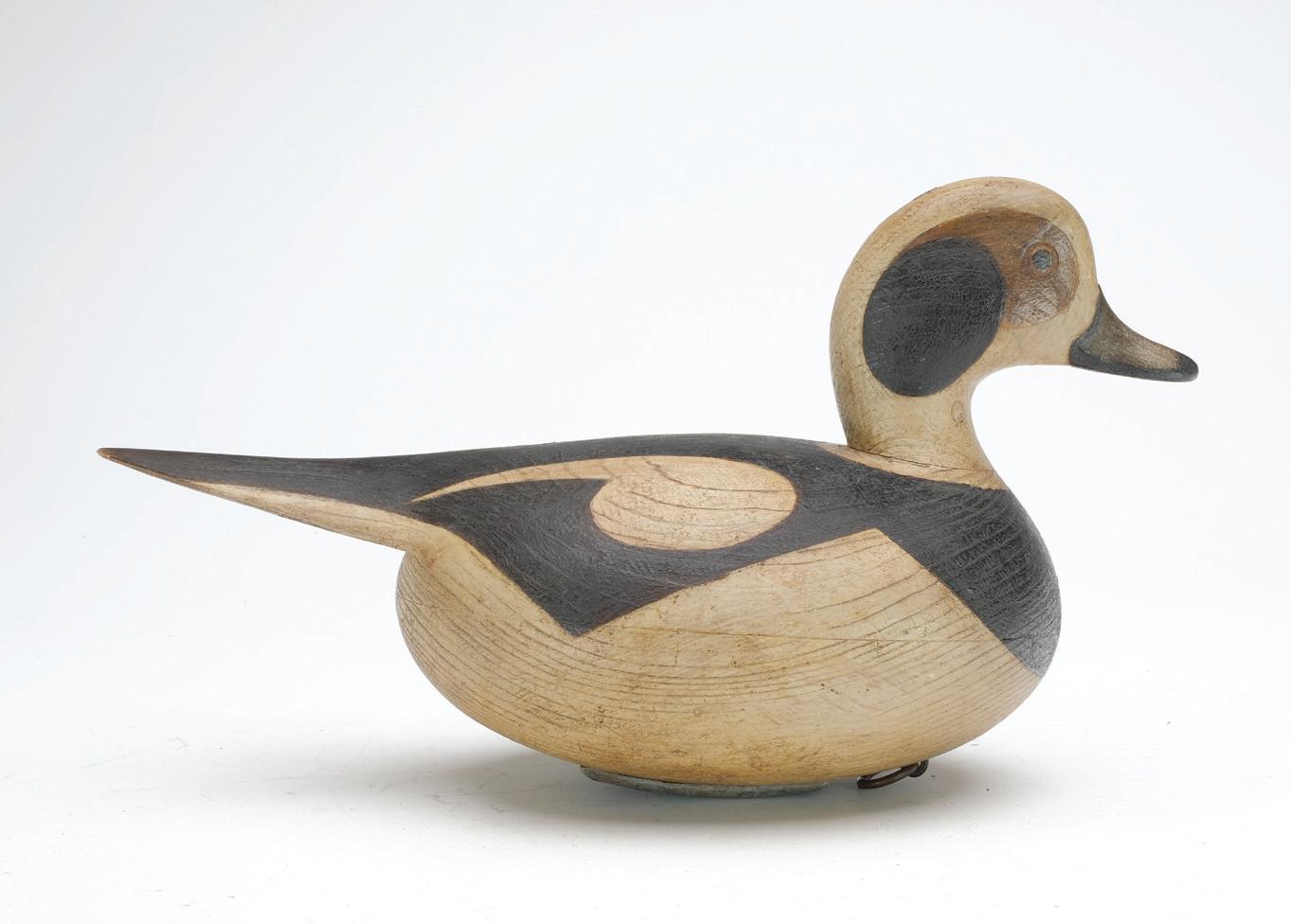


Provenance: Mark and Ann Terry
(1,000 - 1,400)
Excellent and original.
Provenance: Mark and Ann Terry
(1,000 - 1,500)
Provenance: Mark and Ann Terry
(1,200 - 1,800)
25 12
collection.
13 Bluewing teal, Mark McNair, Craddockville, Virginia. Hollow carved with relief wing and raised wingtips. “McNair” carved on the underside. Measures 12.75” long.
collection.
14 Long tail duck, Mark McNair, Craddockville, Virginia. Hollow carved with slightly turned head and carved eyes. “McNair” carved in the underside. Measures 12.5” long. Made to appear older, excellent and original.
12 14 13
collection.
15 Early preening widgeon, Mark McNair, Craddockville, Virginia. Hollow carved with head turned, preening back feathers. Comb feather paint detail on back. Maker’s name carved in the underside. Measures 13” long. Original paint that has darkened slightly under a thin coat of varnish; a few minor paint rubs, otherwise very good. (800 - 1,200)
16 Early ruddy duck, Mark McNair, Craddockville, Virginia. Hollow carved with raised neck seat and upswept tail. “McNair” carved in the underside. “1975” and “Old Lyme” stamped in to lead weight. Measures 12” long. Made to appear older, excellent and original.

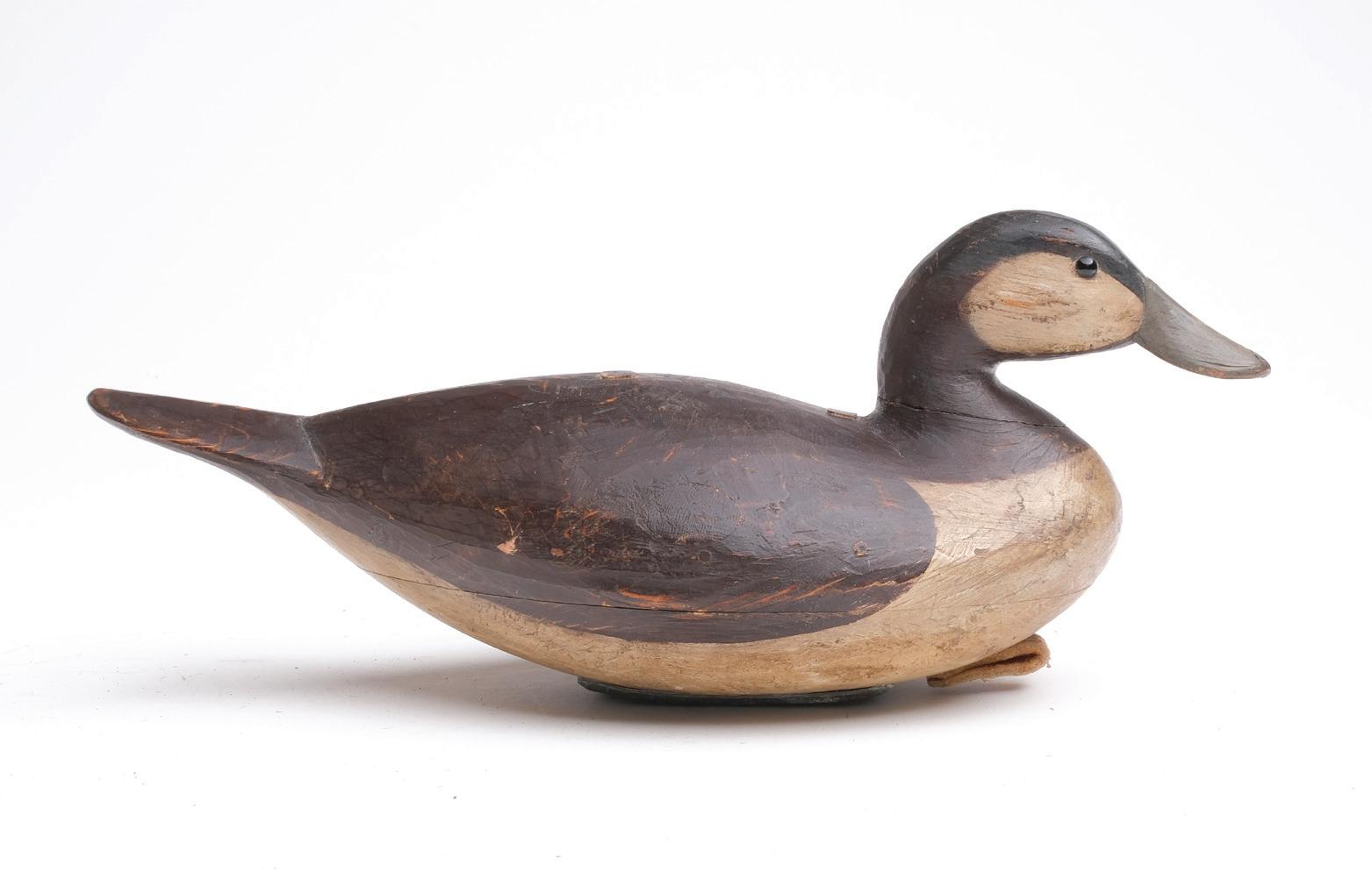

Provenance: Mark and Ann Terry collection. (1,000 - 1,400)
17 Very rare goldeneye, Mark McNair, Craddockville, Virginia. Slightly turned head. “McNair” carved in the underside. Also “T Eastland” scratched in to the wet paint on the underside by the maker when the decoy was made. Tim Eastland collection ink stamp on the underside. Measures 14.75” long. Original paint with minor gunning wear; tiny flake to filler above nail at neck seat.
Provenance: Timothy Eastland collection. (1,200 - 1,800)
26
15 16 17
Oversize merganser, Mark McNair, Craddockville, Virginia. Long, inlayed neck seat and carved eyes. Applied paint bristle crest. “McNair” carved in the underside. Measures 20” long. Made to appear older, excellent and original.


Provenance: Mark and Ann Terry collection. (1,200 - 1,800)
19 Long tail duck, Mark McNair, Craddockville, Virginia. Inlayed neck seat and carved eyes. “McNair” carved in the underside. Measures 14.5” long. Made to appear older, excellent and original.

Provenance: Mark and Ann Terry collection. (800 - 1,200)
20 Black
Mark McNair, Craddockville, Virginia. Carved in the Seaford, Long Island style, with relief wing carving and carved eyes. McNair carved in the underside. Measures 12.5” long. Small amount of sap bleed on breast, otherwise excellent and original.
Provenance: David Fannon collection. (600 - 900)
27 18
bellied plover,
18 19 20
William Gibian
1946 | Onancock, Virginia
21 Pair of standing pintail, William Gibian, Onancock, Virginia. Raised wingtips and relief feather carving. Extended, crossed tail sprig on drake. Comb feather paint detail on drake. Both heads are slightly turned, with drake’s in alert pose and hen’s in tucked pose. Large paper labels on the underside of bases are signed and personalized by the maker. Measure 17” and 23.5” long, stand 12.5” and 15.5” tall. Very minor discoloration on drake’s breast, otherwise excellent and original.

Provenance: Gary Ross collection.
(3,000 - 5,000)
22 Standing blue goose, William Gibian, Onancock, Virginia. Raised wingtips and slightly turned head with open bill. Relief carved wing and tail feathers. “Gibian” carved in the underside. Maker’s business card signed on underside of base. Measures 19” long, stands 18” tall. Varnish has discolored somewhat, otherwise excellent and original.
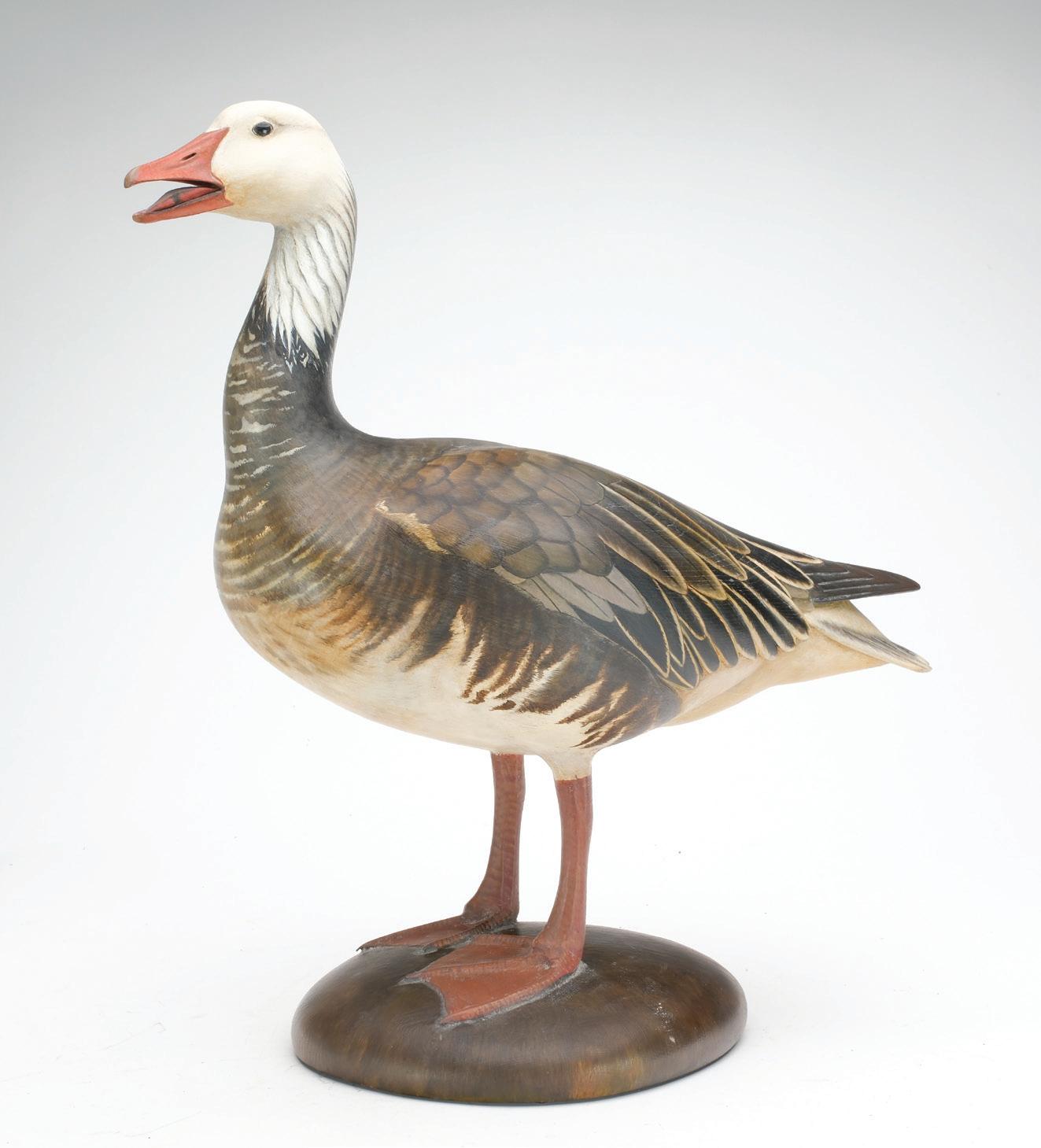
Provenance: Gary Ross collection.
(2,000 - 3,000)
28
21 22
b.
Decorative ruddy turnstone, William Gibian, Onancock, Virginia. Raised wing with head turned, preening a single inserted feather. Relief feather carving. “Gibian” carved on the underside of bird. Maker’s business card on the underside of base is signed and dated 3/09. Measures 8.25” long, stands 8.5” tall. Discoloration from sap bleed on underside, otherwise excellent.
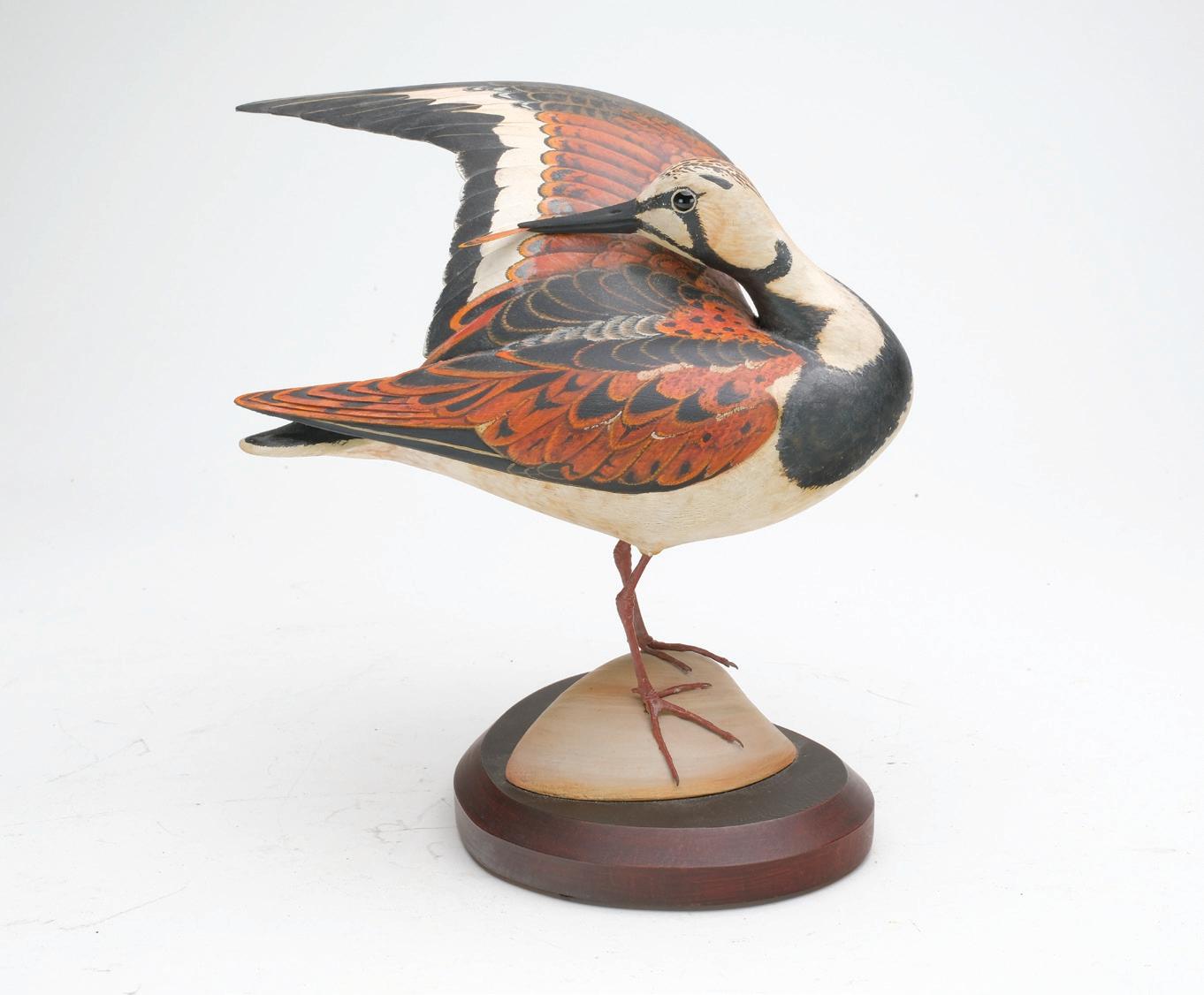
Provenance: Gary Ross collection.
(1,200 - 1,800)
24 Yellowlegs, William Gibian, Onancock, Virginia. Gibian’s signed business card on underside with the date ‘05. Signed “Gibian” on underside of belly. Wire legs with wrapped thighs. In the style of the famous Toronto Harbor gunning shorebirds. Glass eyes with raised, split wingtips and dropped tail. Stands 12.5” tall. Excellent and original.

(1,200 – 1,500)
25 Oversize black duck, William Gibian, Onancock, Virginia. Hollow with deep relief wing carving and raised wingtips. Head is turned and reared back, preening one side of breast. Scratch feather paint detail on head. “Gibian” carved on the underside. Bird was rigged and weighted for use. Measures 18” long. Small paint rub on tip of tail and each wingtip was darkened, otherwise excellent.
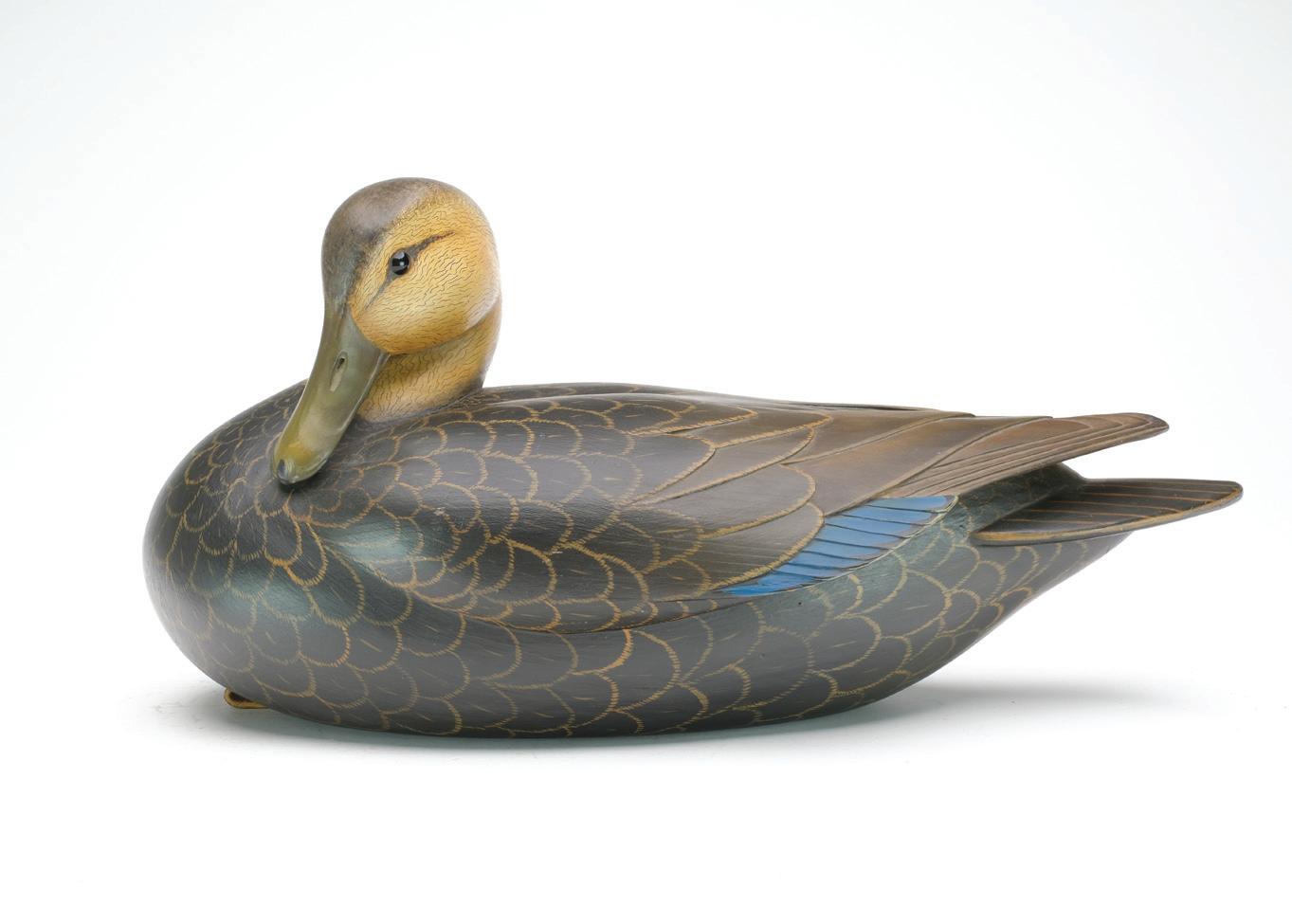
Provenance: Gary Ross collection.
(1,000 - 1,400)
29 23
23 25 24
26 Pair of oversize mergansers, Reggie Birch, Chincoteague, Virginia. Hollow carved in the style of Lothrop Holmes. Relief wing carving and slightly turned heads, with inlayed wooden crests. “R Birch” carved in the undersides. Also retain the maker’s ink stamp. Measure 18” and 19.25” long. Excellent and original. (600 - 900)
27 Canada goose, Reggie Birch, Chincoteague, Virginia. Signed and dated 14 on underside. Made in the style of the famous sleeping Canada goose by Charles Safford. Made from one piece of wood. 22” long. Surface has been stressed to create the appearance of age. (800 - 1,200)
28 Black duck, Reggie Birch, Chincoteague, Virginia. Preening pose with relief wingtip carving and scratch feather paint detail on head. “R Birch” carved in the underside. Also with the maker’s ink stamp. Measures 14.25” long. Excellent and original. (400 - 600)
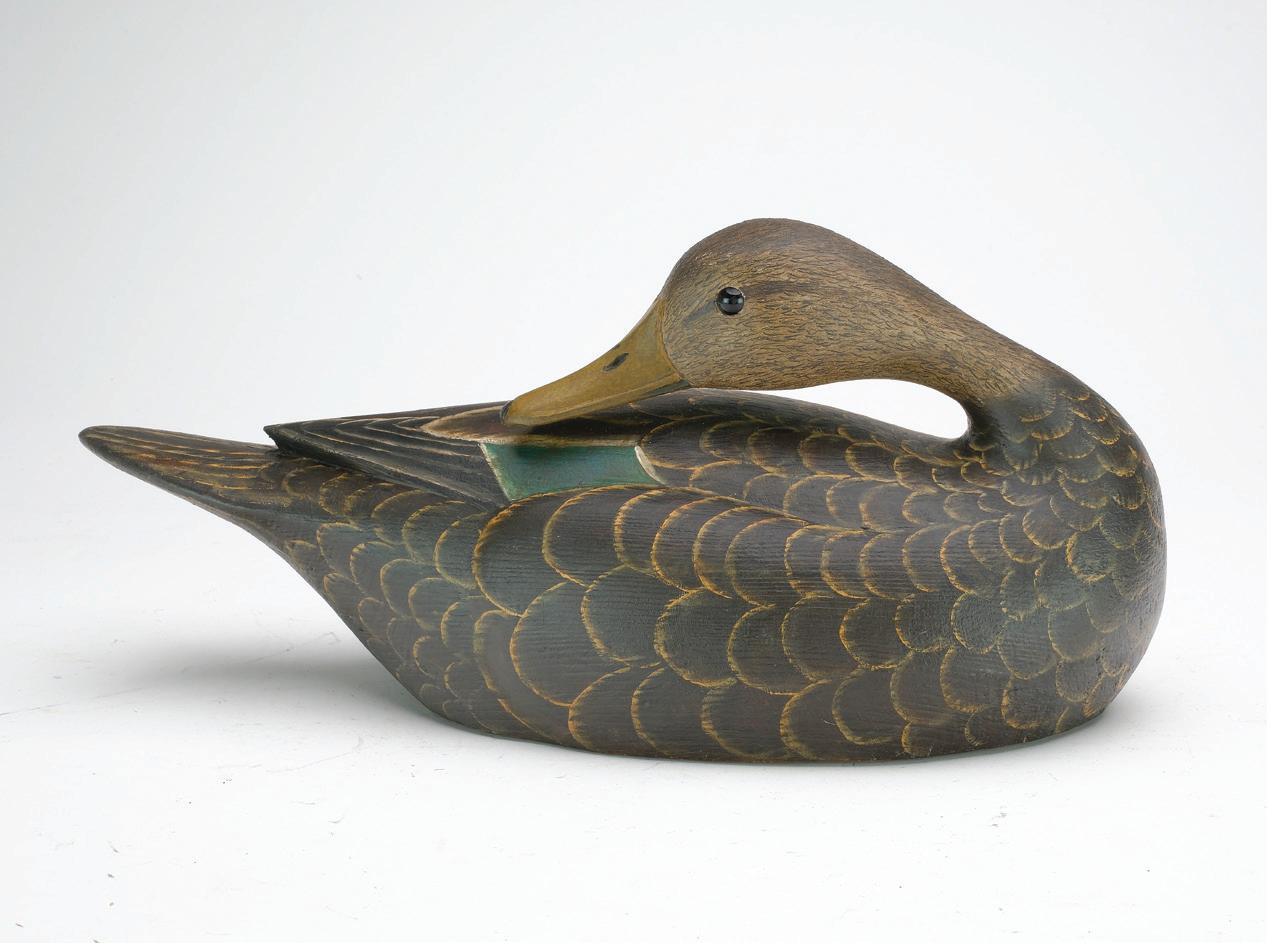

29 Bufflehead, Reggie Birch, Chincoteague, Virginia. Hollow carved in the stye of Nathan Cobb, with inlayed neck seat and relief wingtip carving. “R Birch” carved on the underside. Measures 12.5” long. Made to look older; very good and original. (400 - 600)
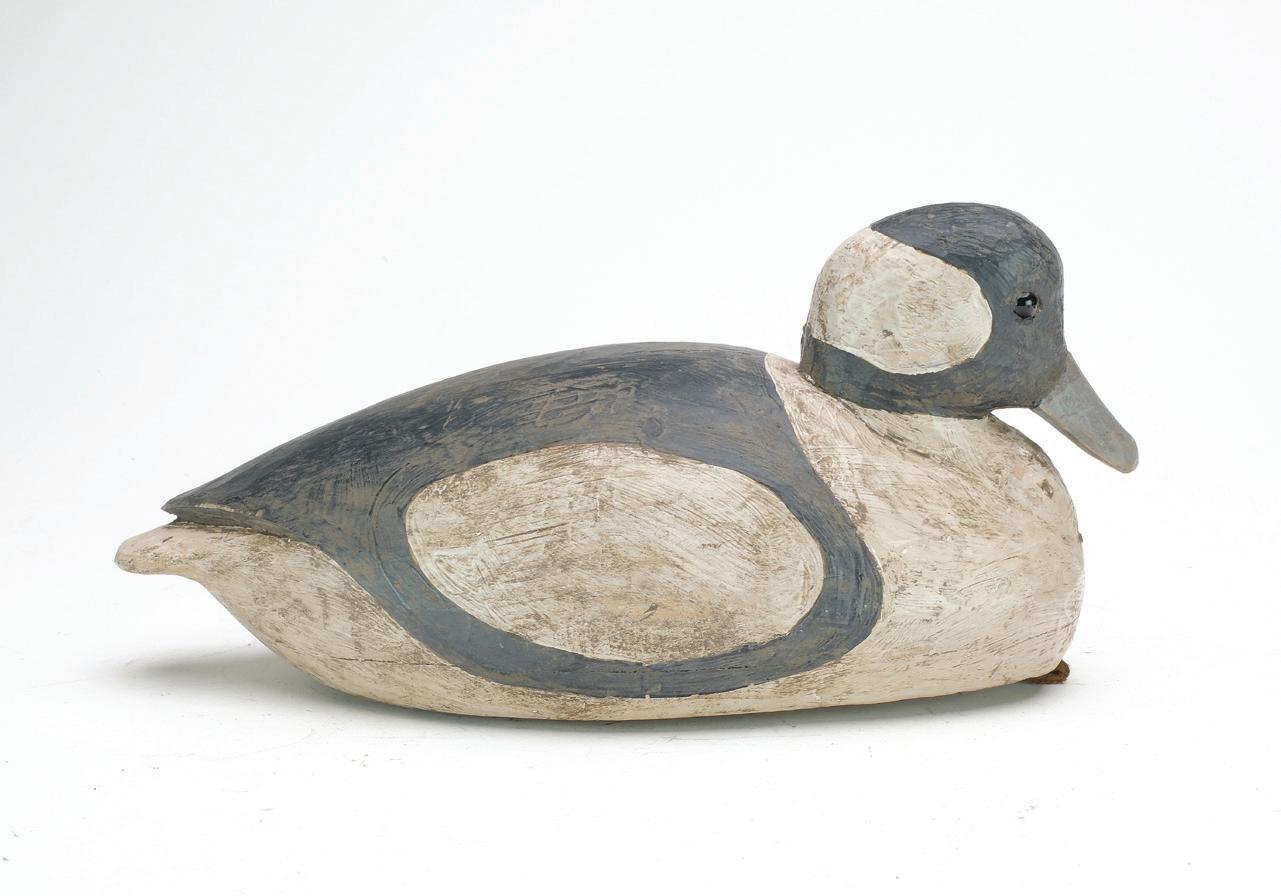
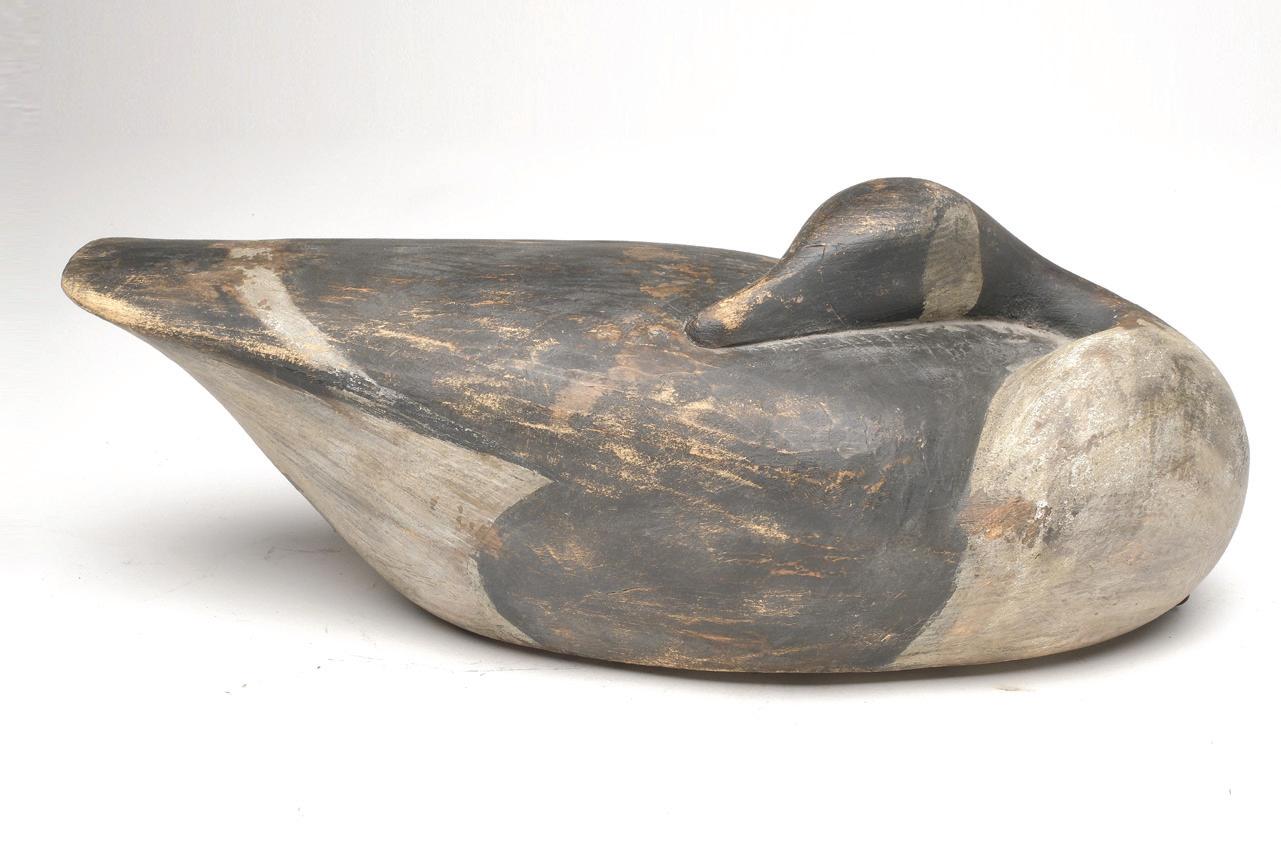
30 26 28 27 29
Outstanding Canada goose, Doug Jester, Chincoteague, Virginia, 2nd quarter 20th century. Two piece body with raised neck seat and tack eyes. Decoy was never rigged or weighted and is signed and dated 1946 on the underside by the maker. Measures 24” long. A few small dents and paint rubs, otherwise excellent and original.

Provenance: Henry Fleckenstein collection. (6,000 - 9,000)

30
Doug Jester
From “Southern Decoys,” Henry Fleckenstein, Jr.
31 Very rare ruddy duck, Doug Jester, Chincoteague, Virginia. Believed to be one of two or three known. Scratch feather paint on back. Ink stamp on the underside from the collection of Dr. George Ross Starr, Jr. Also with “R2” on the underside indicating it was the second ruddy duck in Dr Starr’s collection. Decoy was never rigged or weighted. Measures 10.75” long. Original paint under an early coat of varnish with moderate flaking from Dr. Starr’s pool room; excellent structurally.
Provenance: Ex collection of Dr. George Ross Starr.
Literature: “Decoys of the mid-Atlantic region”, Henry A. Fleckenstein Jr, page 273, exact decoy pictured.
(5,000 - 8,000)
32 Oversize merganser, Doug Jester, Chincoteague, Virginia. Large decoy, with raised neck seat and carved tines of crest. Measures 17.75” long. Original paint with minor flaking and wear; tight crazing on top of tail; hairline crack along back and in neck seat.

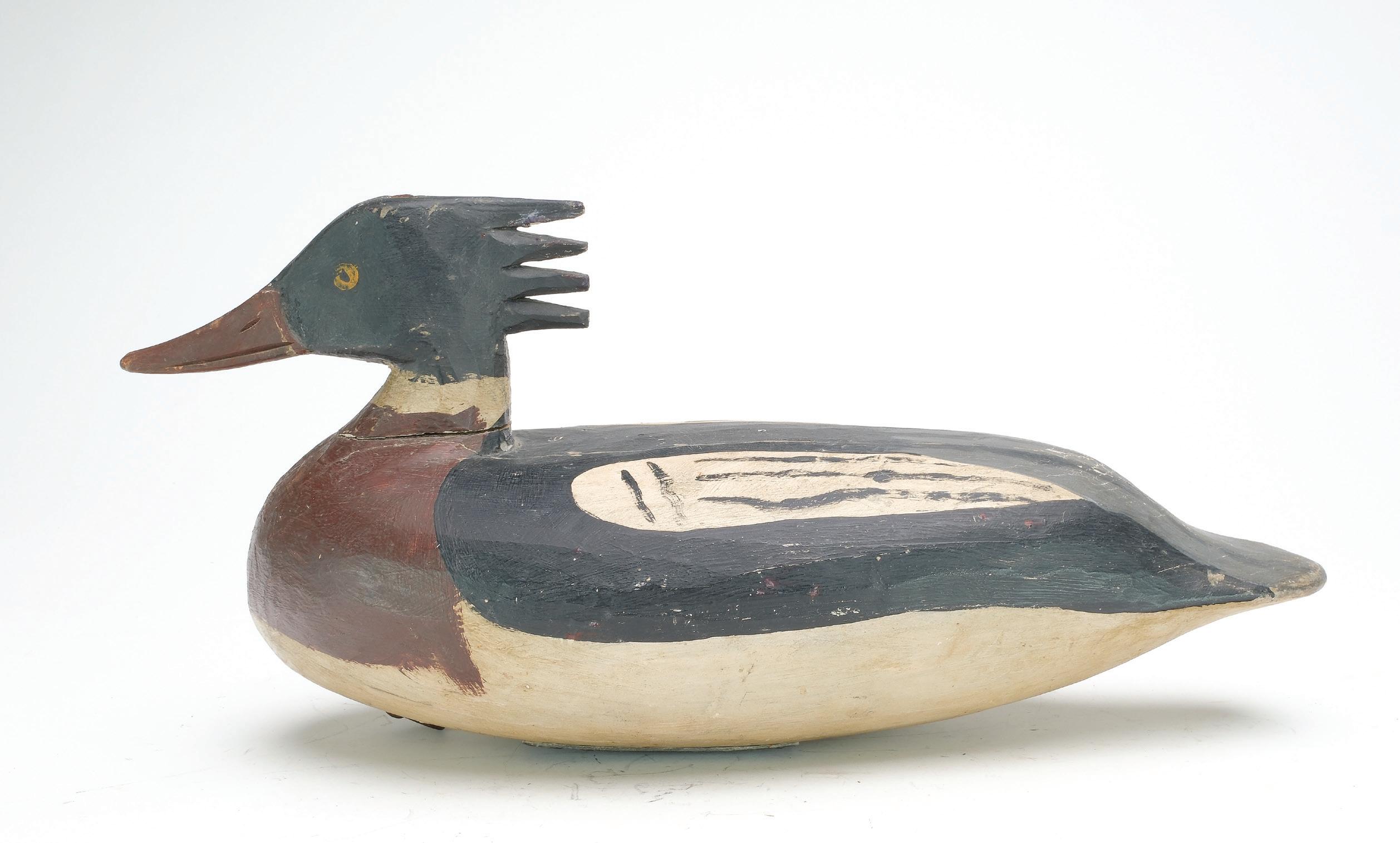

Provenance: Ex collection of Leonard Willis.
(3,000 - 4,000)
32 31 32 Virginia
Very rare preening black duck, Miles Hancock, Chincoteague, Virginia. Head is turned with bill resting on back. Scratch feather paint detail on body and head. Measures 15” long. Original paint with minor flaking and wear; drip of varnish on one side; black paint that was used on head dripped down one side of the neck in the making.
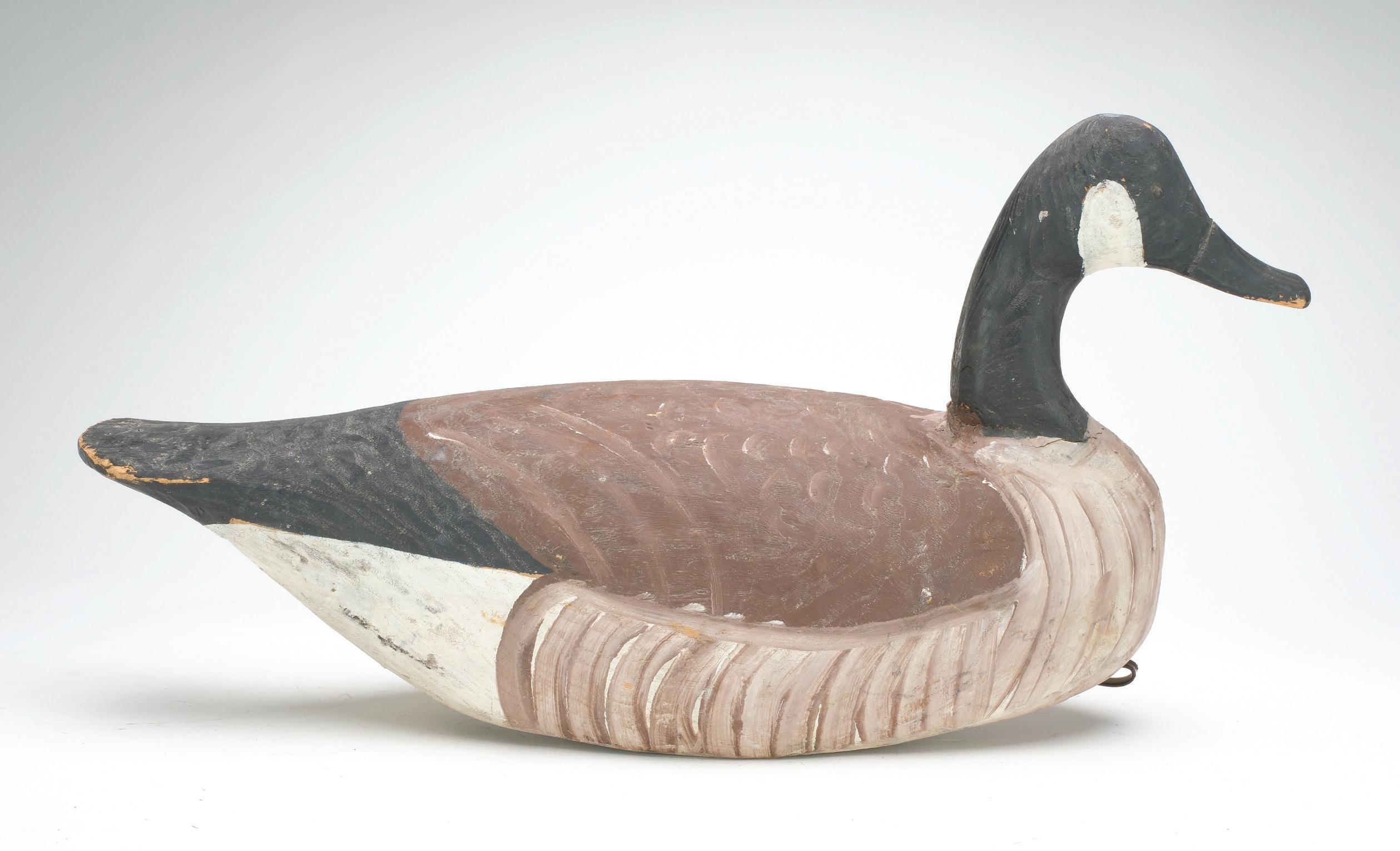

Provenance: Henry Fleckenstein collection. (3,000 - 4,000)
34
Virginia. Cottonwood body and head, with raised neck seat and tack eyes. Measures 24.75” long. Excellent original paint with minor wear; very minor roughness on edge of bill and tail, otherwise excellent structurally. (2,000 - 3,000)
33 33 34 33
Canada goose, Miles Hancock, Chincoteague,
35 Pair of bluebills, Miles Hancock, Chincoteague, Virginia. Scratch feather paint detail on hen. “EPK” branded on underside of drake, for the hunting rig of Emerson Polk Kellam. Both with tack eyes. Measure 15” and 16” long. Original paint with very minor wear; thin coat of varnish has yellowed somewhat; both are very good structurally. (600 - 900)
36 Canvasback hen, Miles Hancock, Chincoteague, Virginia. Scratch feather paint detail and tack eyes. “EPK” stamped twice on the underside for the rig of Emerson Polk Kellam. Also with the Philadelphia Wildfowl Exhibition ink stamp on the underside. Measures 16.25” long. Original paint with minor wear; small chip and minor roughness on edge of tail. (500 - 800)
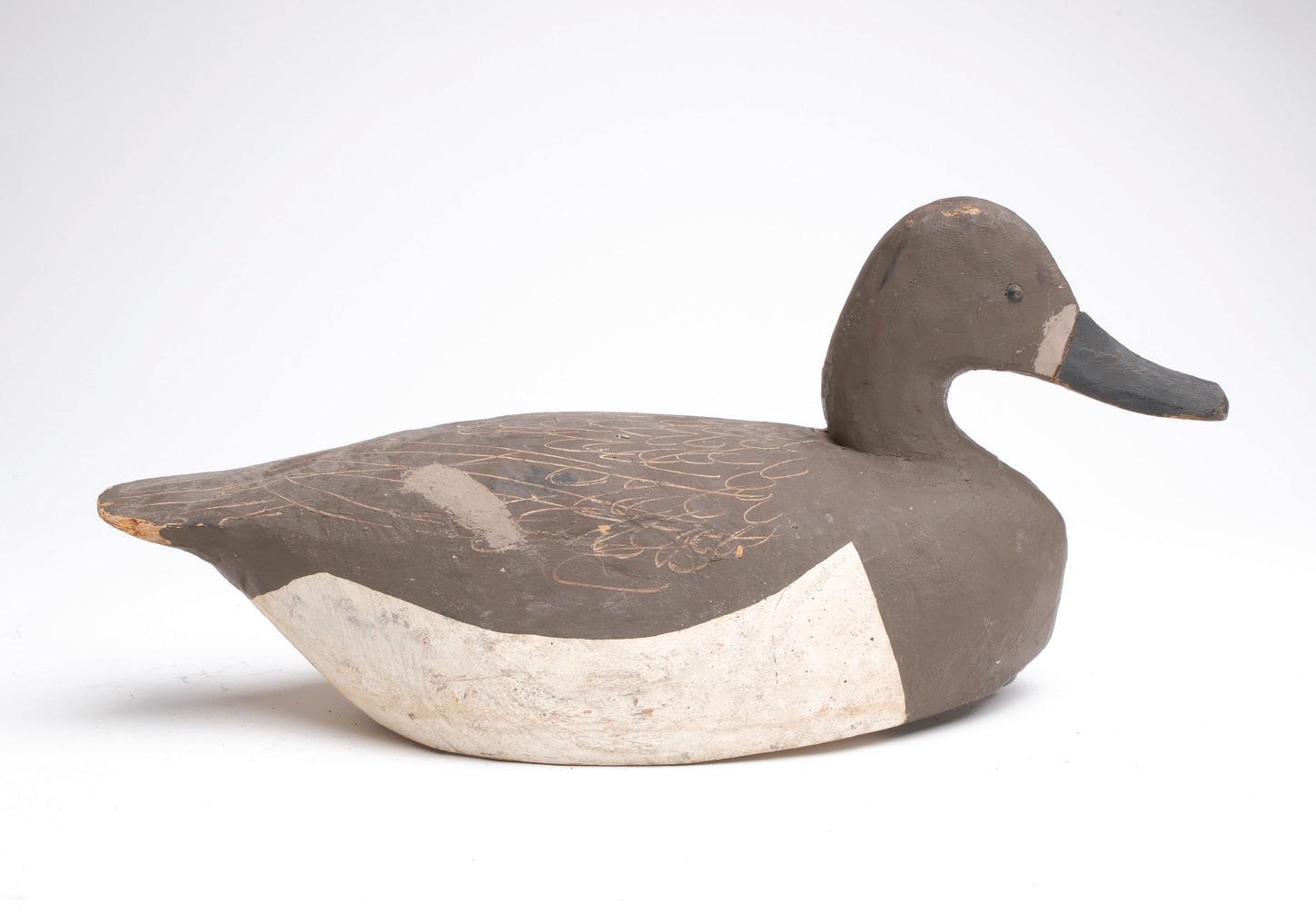
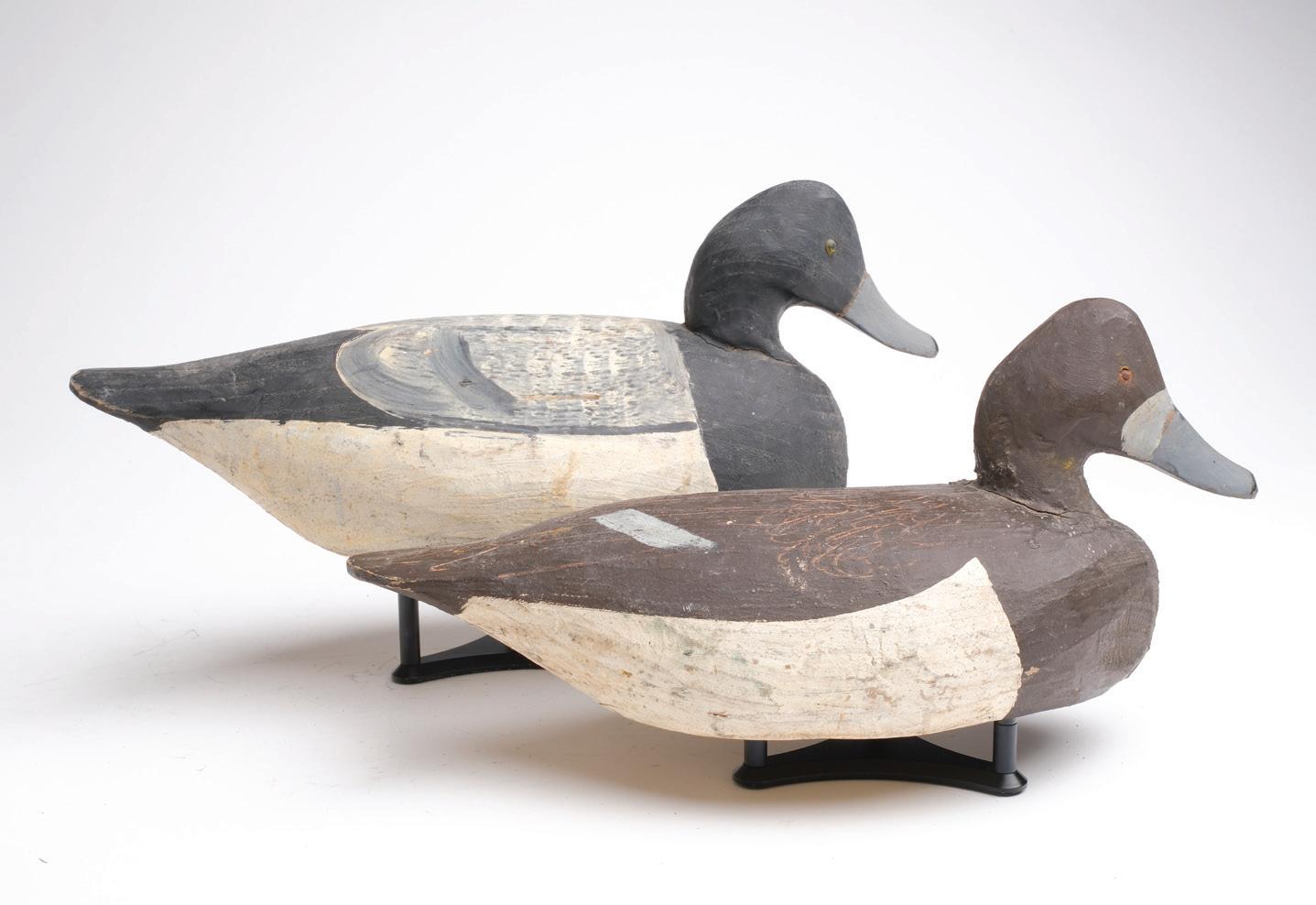
37 Redhead, Doug Jester, Chincoteague, Virginia, 2nd quarter 20th century. Raised neck seat and painted eyes. Measures 16” long. Original paint with moderate flaking and wear; thin wash of gray added to back; crack through neck; hairline separation at wood grain on one side. (800 - 1,200)

34
35 37 36
Ike Phillips, Wachapregue, Virginia, 2nd quarter 20th century. Two piece body. Measures 13.5” long. Original paint with moderate gunning wear; crack through neck with small amount of filler and touchup added long ago; minor roughness on tail. (1,200 - 1,800)

Bluebill
Chincoteague, Virginia, 2nd quarter 20th century. Each with balsa body and inlayed lead weight. One in sleeping pose. Measure 15” and 16” long. Original paint with minor to moderate gunning wear; one with more dents and roughness than the other; chipping and loss to one tail.

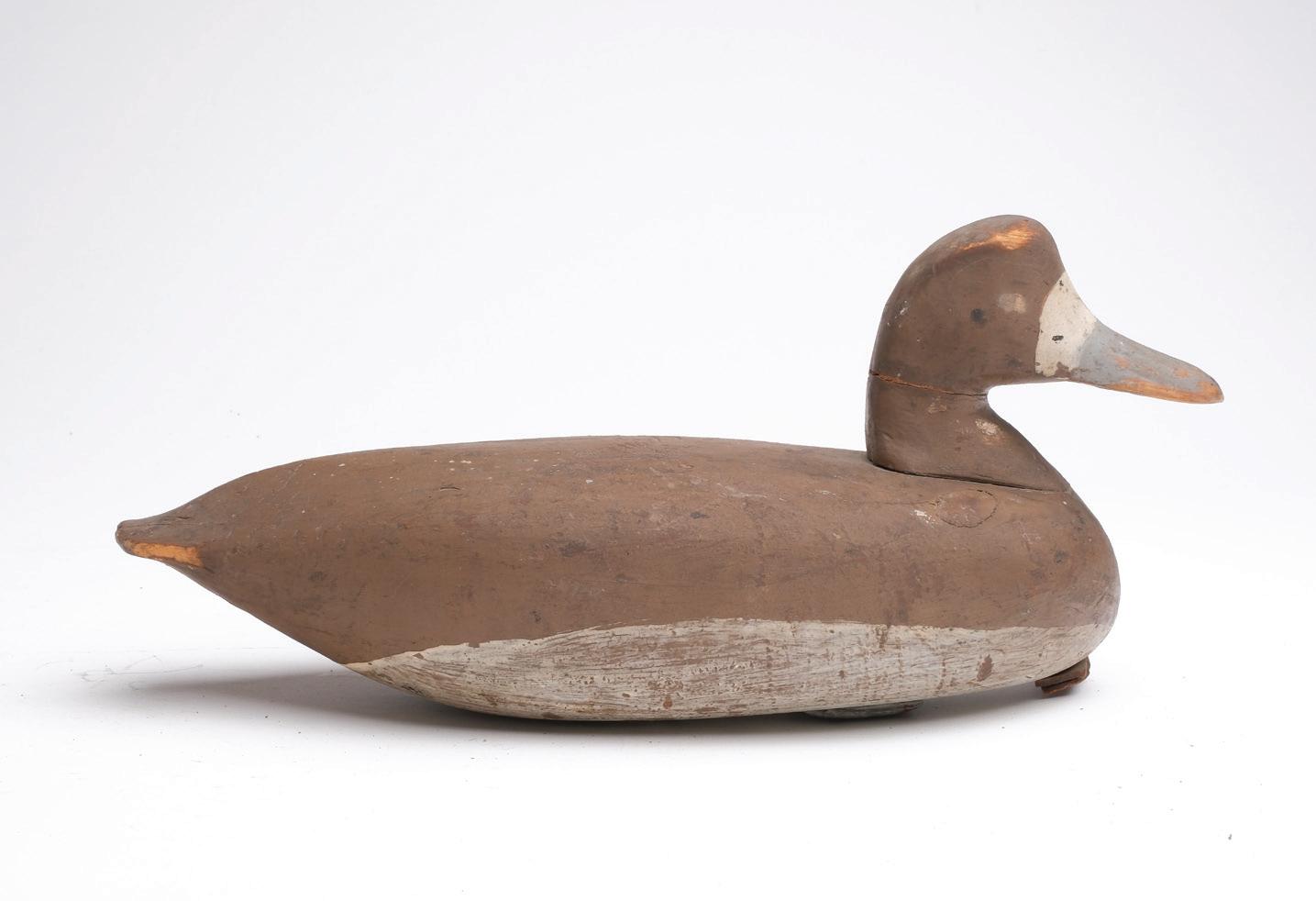
(1,000 - 1,500)
Virginia,
1930s. Hollow carved with relief wingtip carving and raised neck seat. Scratch feather paint detail on back and sides. Measures 16.5” long. Appealing in use repaint by Ira Hudson with moderate flaking and wear; drying crack in one side of head; tight crack along the underside. (800 - 1,200)
35
38
hen,
39 Pair of black ducks, Dave “Umbrella” Watson,
38 40 39
40 Black duck, Dave “Umbrella” Watson, Chincoteague,
circa
41 Rare Canada goose by a member of the Doughty family, likely Eli Doughty, Hog Island, Virginia, last quarter 19th century. Raised wing tip carving. Slight ice groove behind neck seat. Stick up hole drilled in the underside. Measures 21.5” long. Early in use repaint by Ira Hudson shows moderate gunning wear; crack through neck seat and vertically on head; drying crack along the back and underside of tail.


Provenance: Leonard Willis collection.
Literature: “Wings of Wonder”, Dr. S. Lloyd Newberry, page 272, similar geese pictured. (20,000 - 30,000)
36
In 1844 Martin and Mary Doughty (Douty) welcomed a son they named Eli into the population of approximately 300 residents that inhabited the tiny settlement of Broadwater, on Hog Island. Settled in 1692, this island lies across the bay from Willis Wharf, Virginia, and is one of the larger barrier islands running along the Atlantic coast of Virginia’s Eastern Shore. Little is known of Eli’s early years but it would be a logical assumption that, like most other ‘islanders’, his life would be tied to the water. In 1866 he married Margaret Elizabeth, and the couple would ultimately raise a large family of four sons and two daughters. The 1870 Census records indicate that he and his young family were living in Eastville, where he earned a living as a fisherman, oyster planter or oysterman. By 1880 the growing family had moved to Franktown, which remained Eli’s home until his death in 1923. He was buried in the Downing Cemetery in Willis Wharf, VA.
For many years, the Doughtys maintained a large and prominent presence on Hog Island. Men of the family were known to be watermen or lighthouse keepers, and hunting guides. Some of them probably served visiting sportsmen at the Broadwater Hunt Club on the Island during the years of 1895 until it ceased operation around 1915. Eli’s oldest son Henry lived to be 94, and had the distinction of serving as waterfowl guide to President Grover Cleveland when he came to Hog Island to hunt. As noted by an early writer:
“Hog Island is, at certain seasons of the year, ideal ground for the sportsman. Machipongo Inlet and its channels is a famous feeding ground for wild geese and that king of wildfowl, the brant, and the marshes abound with black duck. In the spring and summer, the curlew, willet and greybacks flock to the oyster shoals and ponds in the meadows. Fine bags can be made of these delicious birds that have all the flavor of the salt crustaceans on which they feed. The hotel, erected by Mrs. Stockton of Atlantic City is open all year for the accommodation of tourist, sportsmen and other visitors. Most of the prominent sportsmen of the north pay a visit to the island to shoot bay birds and waterfowl”.
We also know many Doughty men were avid waterfowl hunters, as this abundant harvest provided food and income for many local families. Their pursuit of waterfowl on the open waters surrounding the islands would have required the use of decoys with unique characteristics. For the most part, little is known about decoy carvers on Hog Island. However, those carved by the Doughty family are often described as being among the very finest representatives of what has become known as the “Hog Island Style”.

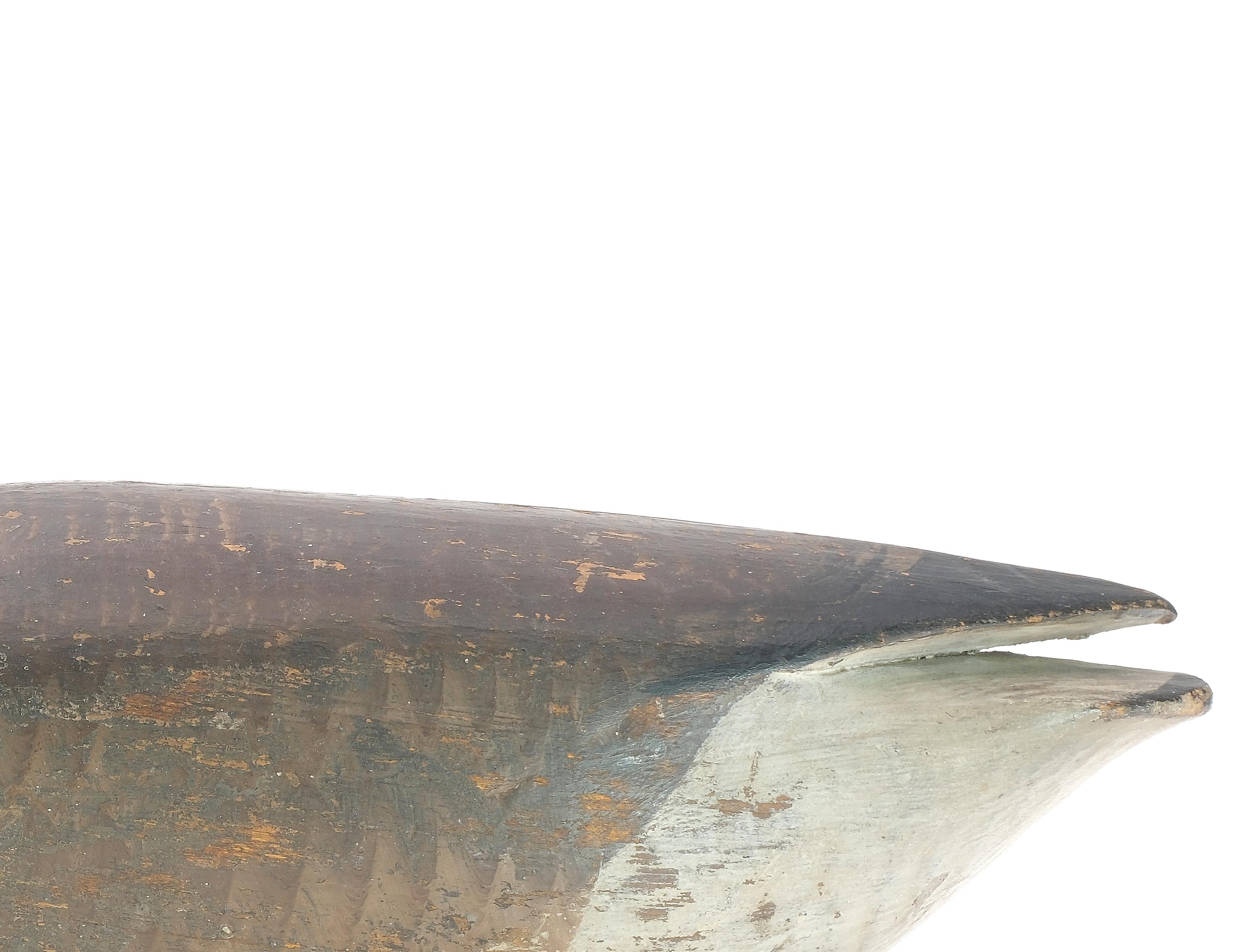 Doughty family Canada goose pictured in “Decoys: North America’s One Hundred Greatest,” Loy S. Harrell, Jr.
Doughty family Canada goose pictured in “Decoys: North America’s One Hundred Greatest,” Loy S. Harrell, Jr.
42 Brant, Charles Jester, Chincoteague, Virginia, 1st quarter 20th century. Hollow carved with raised neck seat and flat bottom. Measures 16” long. Appealing in use repaint by Ira Hudson shows minor to moderate wear; tight crack along the underside; tight seam through neck where head was off and reset; old chip in underside of bill with two tiny nails added on the underside.
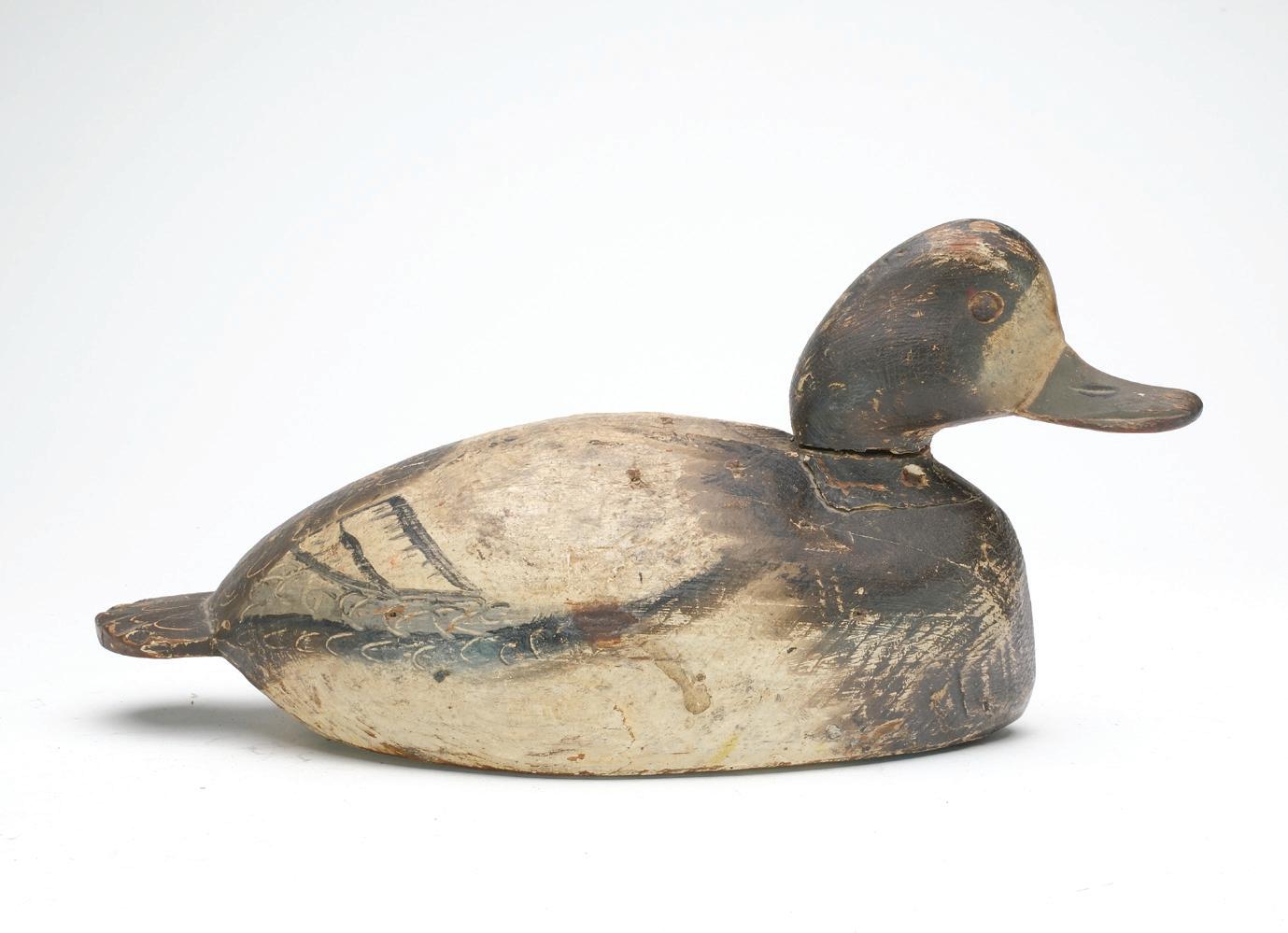
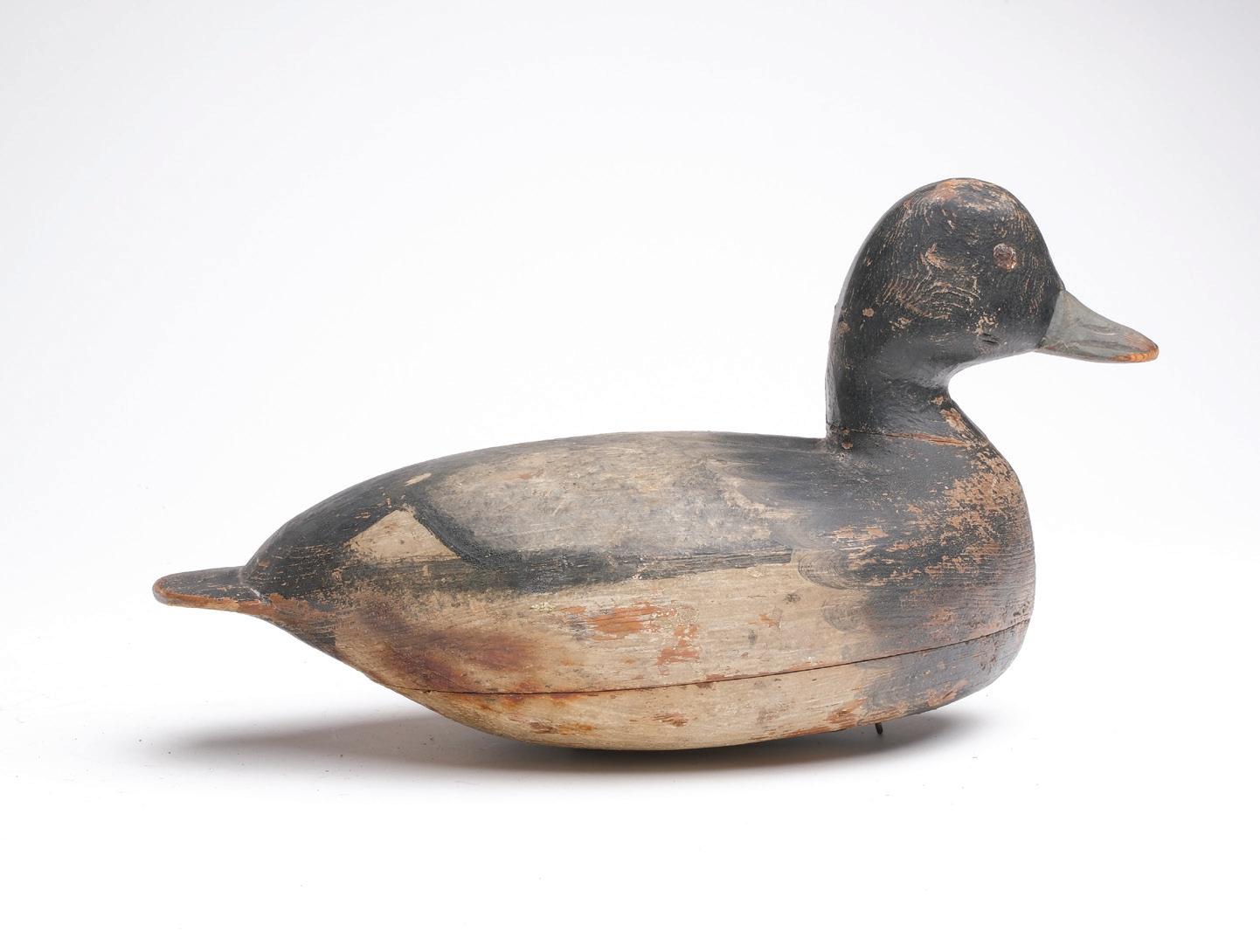
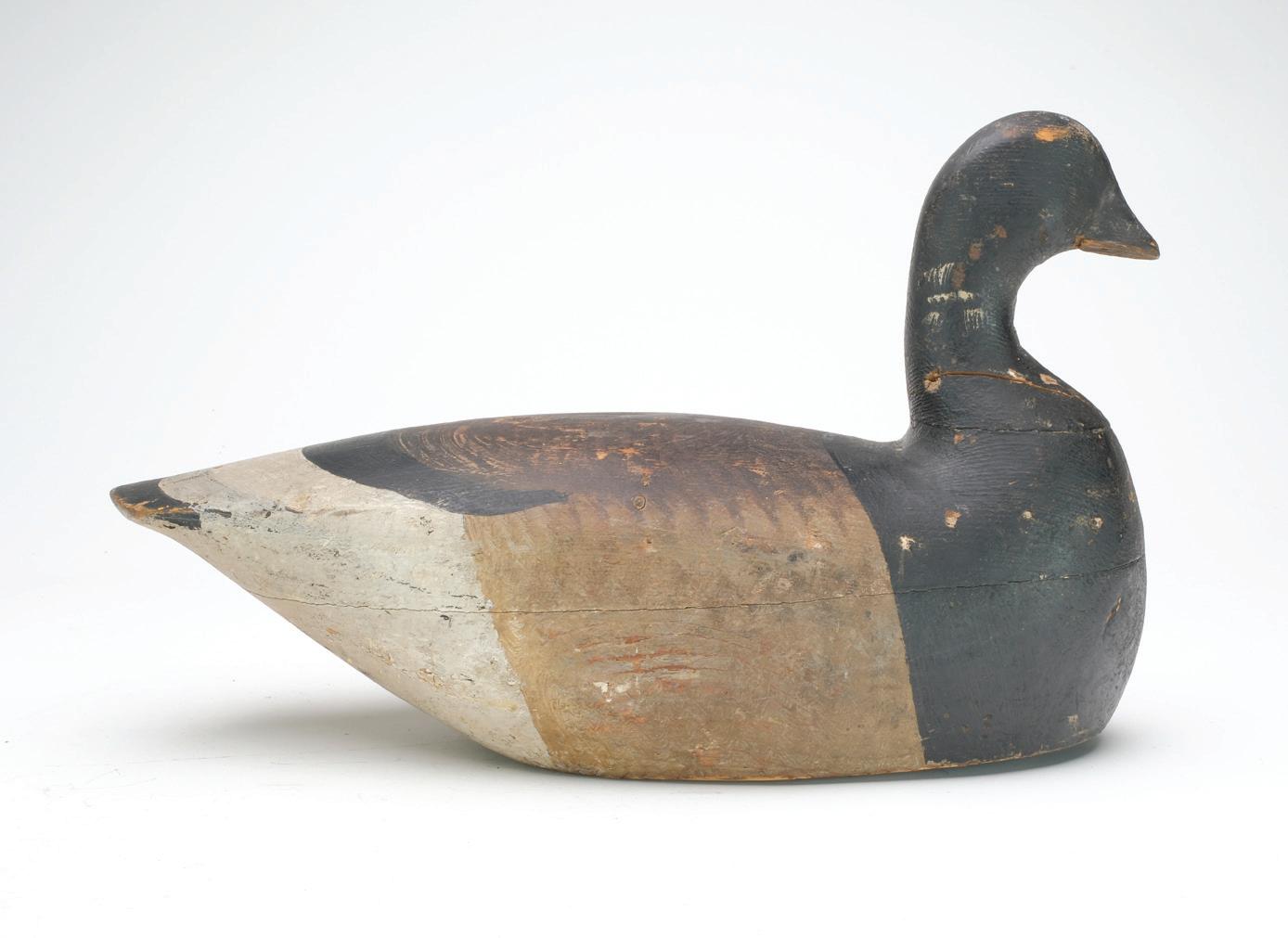
(800 - 1,200)
43 Hollow carved bluebill, Ira Hudson, Chincoteague, Virginia, 1st quarter 20th century. Hollow, two piece body with raised neck seat and tack eyes. Excellent scallop paint detail where the black of breast meets the body. Roy Bull collection brand on the underside. Measures 13” long. Original paint with moderate flaking and wear; significant flaking on the breast; nails at body seam near tail with staining; a few tight cracks where nails added in body seam.
(800 - 1,200)
44 Bluebill hen, Ira Hudson, Chincoteague, Virginia. Flat bottom with extended fluted tail. Ice groove behind neck. Tack eyes. “F” branded in underside for the collection of Henry Fleckenstein, Jr. Measures 15” long. Original paint with a few shot scars; moderate gunning wear; crack at neck.
(1,000 - 1,500)
38
42 44 43
45 Rare flying redhead, Ira Hudson, Chincoteague, Virginia, 1st quarter 20th century. Applied wings and appealing scratch feather paint detail. Measures 19.5” long, with a 20.5” wingspan. Original paint that has darkened with age; appealing crazing to an early varnish layer; wings have been professionally reset with touchup at the seams; minor roughness at tip of wings; applied wooden legs are missing; chipping on back of wings near body. (12,000 - 18,000)



Nathan Cobb, Jr.
1825 - 1905 | Cobb Island, Virginia
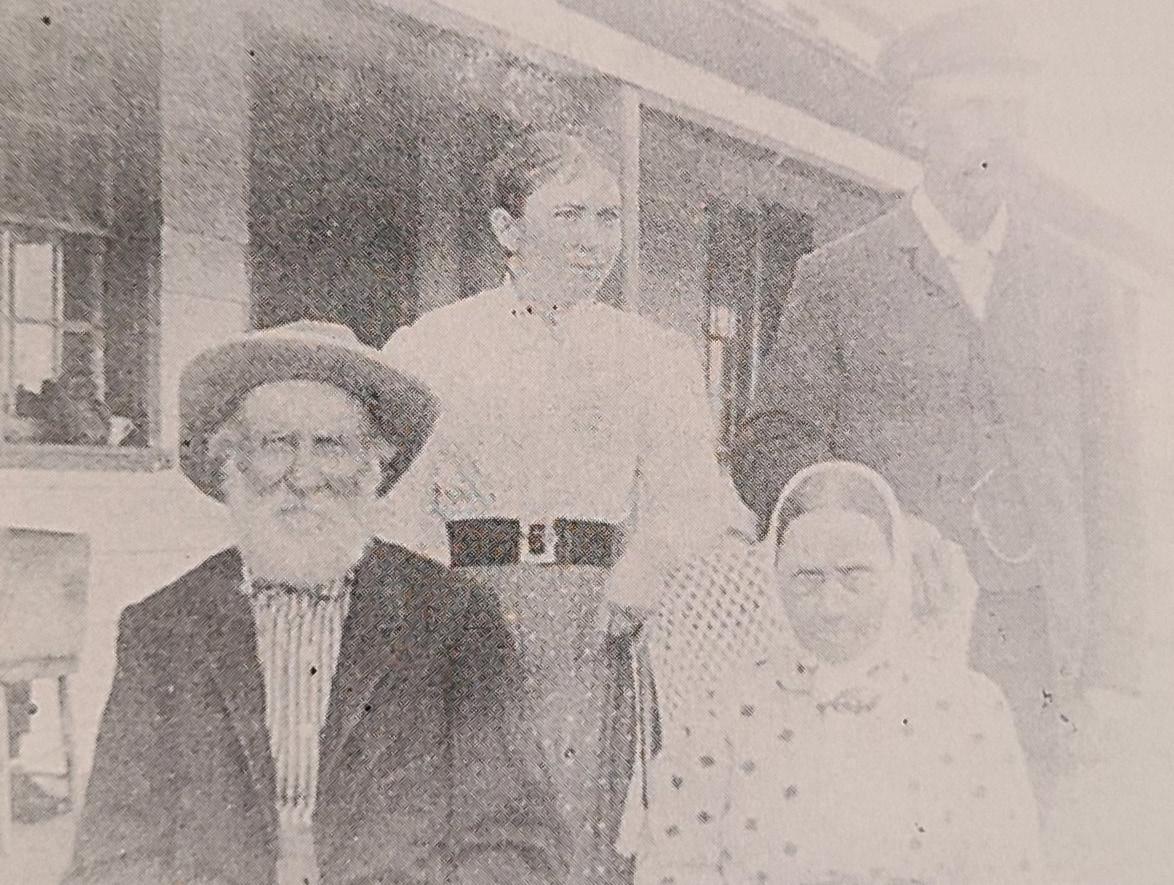

The abundance and variety of waterfowl on and near Cobb Island provided for the highly successful market and sport hunting. The decoys were of rugged construction consistent with the severe conditions that often plagued Cobb Island over the years. Nathan Jr. produced ducks, geese, brant and shorebirds in a multitude of poses which created a sense of movement and realism to the rig. Curved and twisted necks with cantered heads, notched tails, and inlet heads are but a few of the characteristics which set Cobb decoys apart from other Virginia makers and established the tremendous folk art appeal that attracts collectors today.

40
46
Swimming brant, Nathan Cobb, Jr., Cobb Island, Virginia, last quarter 19th century. Hollow carved with inlayed head that is slightly turned and cocked to one side. Wingtips are carved off of the body. Serifed “N” carved in the underside. Measures 18” long. Very early in use repaint with significant flaking and wear; two chips at base of neck were resecured with old nails, with a small chip still missing.

Provenance: Recently deaccessioned from an East Coast Museum. Museum collection since 1977. (20,000 - 30,000)
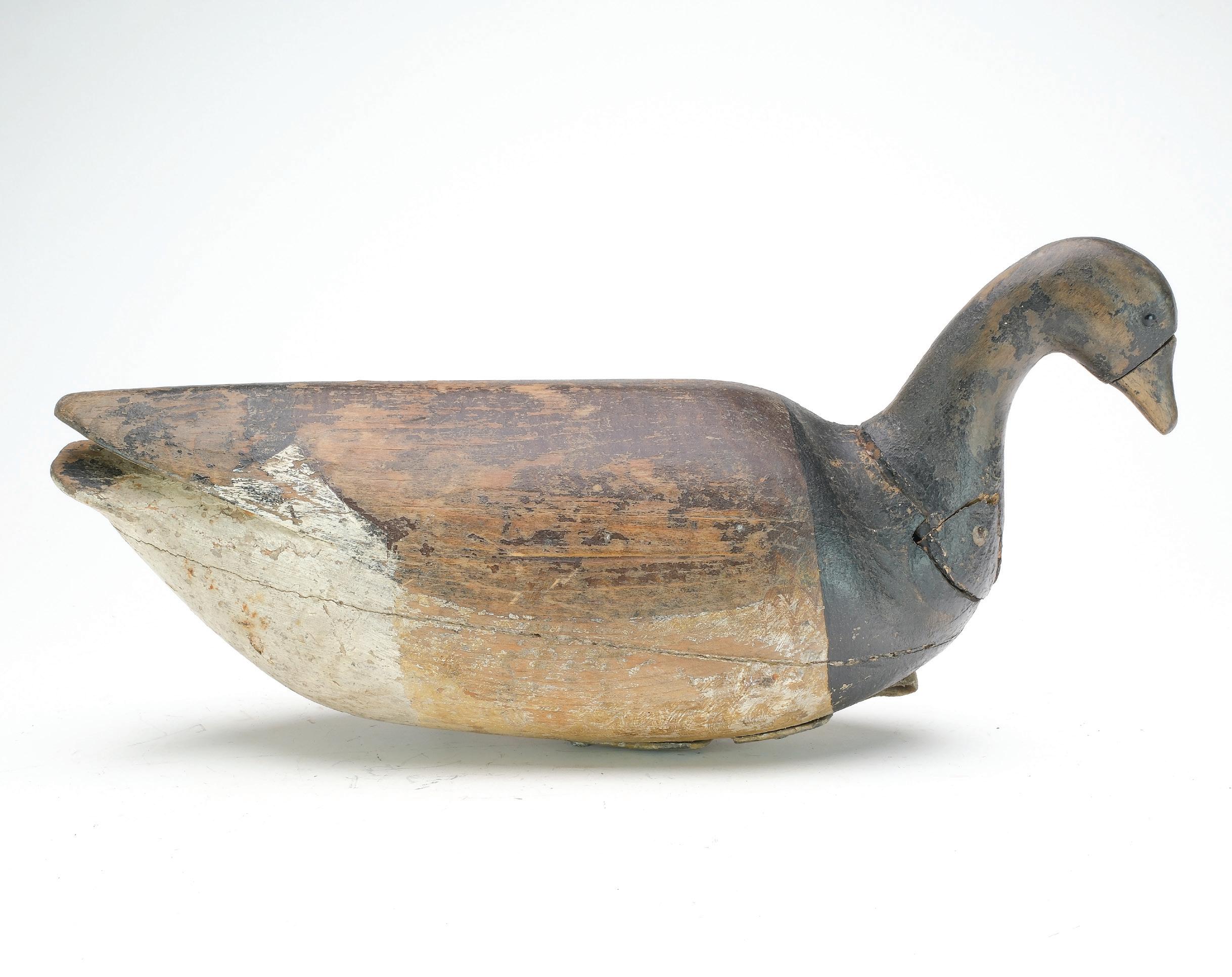
Albert Cobb
1836 - 1890 | Cobb Island, Virginia

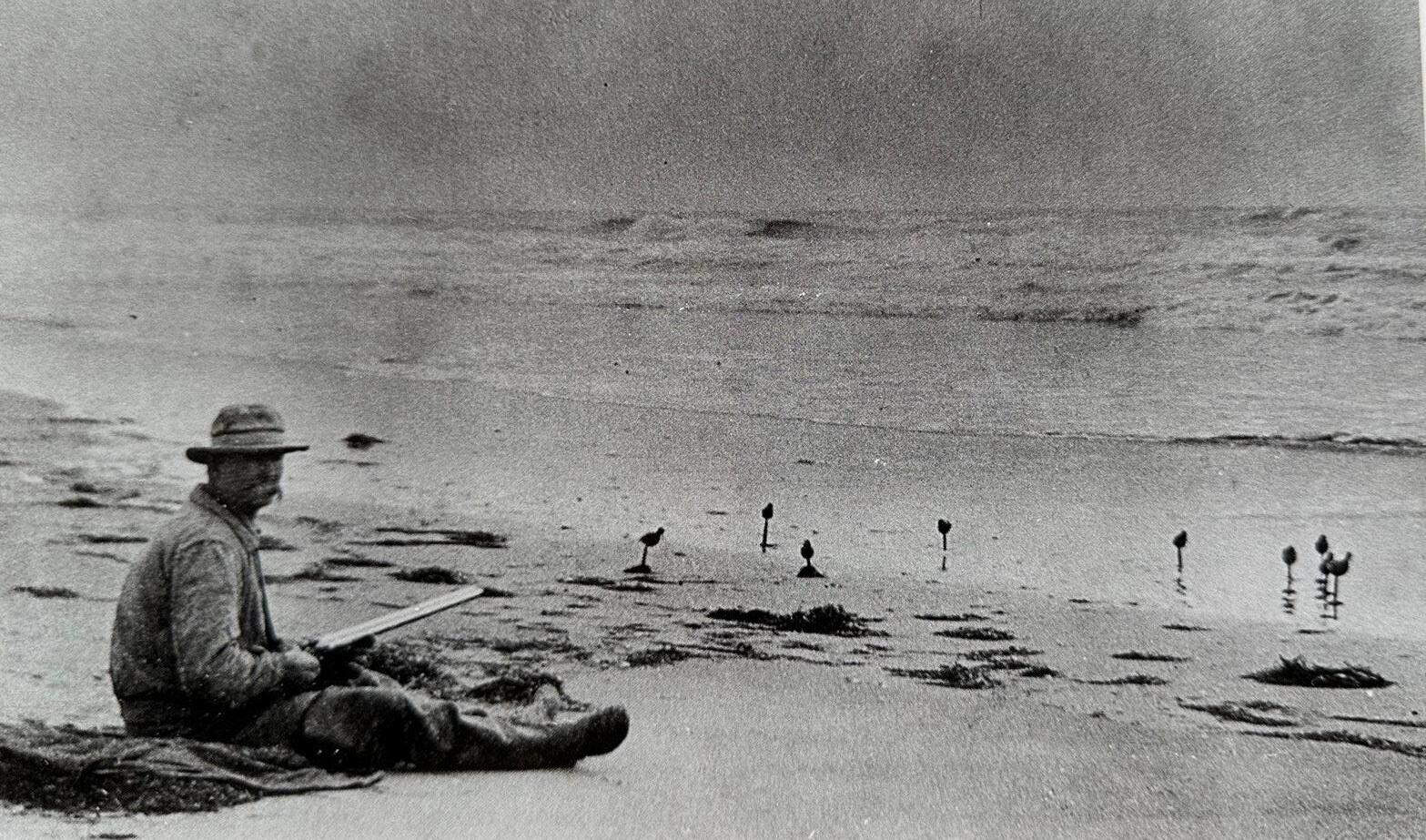
Albert was born in Eastham on the outer arm of Cape Cod, Massachusetts. While he was still young, his father, Nathan, moved the family to a small, undeveloped Island off the Virginia coast. Here, the Cobb’s developed a multifaceted business empire, including a hotel that catered to sportsmen. By at least 1870, the census indicates that the business-oriented Albert was serving as a “hotel keeper” on the Island. One phase of the hotel’s hunting operation involved shorebird shooting, an activity greatly enhanced by the use of decoys. Various members of the Cobb family, as well as some of the hotel’s guides, rose to the occasion and produced some of the most iconic shorebirds ever carved in Virginia. Among these, the decoys produced by Albert can be distinguished by his “Masonic A” which he carved into them. Dr Lloyd Newberry, in his excellent book, “Wings of Wonder”, discusses the various decoys produced on the Island and how to distinguish their makers. The red knots carved by Albert are considered some of his best work.
 George Doughty hunting shorebirds, circa 1890, most likely on Cobb’s Island. Photo credit, “Wings of Wonder,” Lloyd Newberry
Photo credit, “Wings of Wonder,” Lloyd Newberry
George Doughty hunting shorebirds, circa 1890, most likely on Cobb’s Island. Photo credit, “Wings of Wonder,” Lloyd Newberry
Photo credit, “Wings of Wonder,” Lloyd Newberry
47 Robin
Albert Cobb, Cobb Island, Virginia, last quarter 19th century. In running pose with carved eyes. Masonic style “A” carved in underside. Raised “V” wingtip carving and relief carved wings. Sam Dyke collection ink stamp on underside. Measures 8.5” long. Original paint with moderate gunning wear; small dents and shot marks; small chips on bill where it meets the face; minor roughness on tip of raised wingtip.


Provenance: Ex Sam Dyke collection. Acquired from N.H. Coniff in 1967.
Literature: “Wings of Wonder”, Dr. S. Lloyd Newberry, page 260, exact decoy pictured. (15,000 - 25,000)
43
snipe,
Shorebirds
48
Excellent curlew from the Chincoteague, Virginia area, last quarter 19th century. Raised neck seat and scratch feather paint detail. Slight ridge down center of tail. Measures 16” long. Original paint with moderate flaking and wear; minor roughness on edge of tail; a few small dents in one side and a hairline crack on underside, otherwise very good structurally.

Provenance: David Good collection purchased by Bob Burger, then acquired by David Fannon. David Fannon collection. (10,000 - 15,000)

44
49
Very rare curlew, Luther Nottingham, Capeville, Virginia, last quarter 19th century. Two piece body style with slightly turned head and relief wing carving. ‘LLN’ carved on the underside of tail. Measures 13” long. Original paint with minor wear on most of the decoy; lightly hit by shot; roughness with some losses on edge of tail.

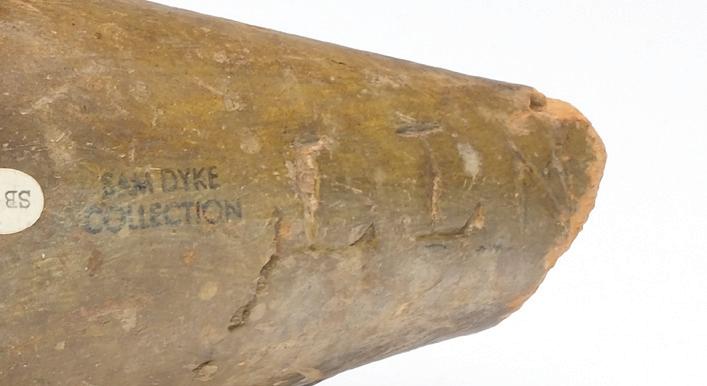


Provenance: Ex. D.C. North collection.
Literature: “Southern Decoys,” Henry Fleckenstein, Jr. (8,000 - 12,000)
50 Large and plump curlew from the eastern shore of Virginia. Relief wing tip carving. “N” for the collection of DC North branded on underside. Bill is splined through back of head. Measures 13” long. Nearly all the paint is missing, but the decoy is structurally good with great patina.
Provenance: David Fannon collection. (4,000 - 6,000)
45
50 49
51 Black bellied plover from Cobb Island, Virginia, circa 1900. Carved eyes. Sam Dyke collection ink stamp on underside. Measures 10.5” long. Original paint with moderate flaking and wear; hairline drying cracks in one side; the original bill is loose in the head.

(2,500 - 3,500)
52 Two yellowlegs, Ira Hudson, Chincoteague, Virginia, 1st quarter 20th century. Scratch feather paint detail. Measure 10.25” and 10.75” long. Original paint with moderate wear; a few small dents; tight drying crack in one, and a small chip at stick hole in the other; each with a professional bill replacement and tail chip repair.
Provenance: David Fannon collection. (2,000 - 4,000)
53 Yellowlegs, Ira Hudson, Chincoteague, Virginia, 1st quarter 20th century. Scratch feather paint detail. Measures 11” long. Original paint with moderate wear under an early coat of varnish; a few small spots of touchup at flaking and at a chip in the tail; bill is a later replacement.
Provenance: David Fannon collection. (1,200 - 1,800)
54 Yellowlegs, Ira Hudson, Chincoteague, Virginia, 1st quarter 20th century. Measures 10.5” long. Original paint with minor wear; under a thin coat of varnish; minor roughness on edge of tail; the replaced bill is half missing.


Provenance: David Fannon collection. (1,500 - 2,500)
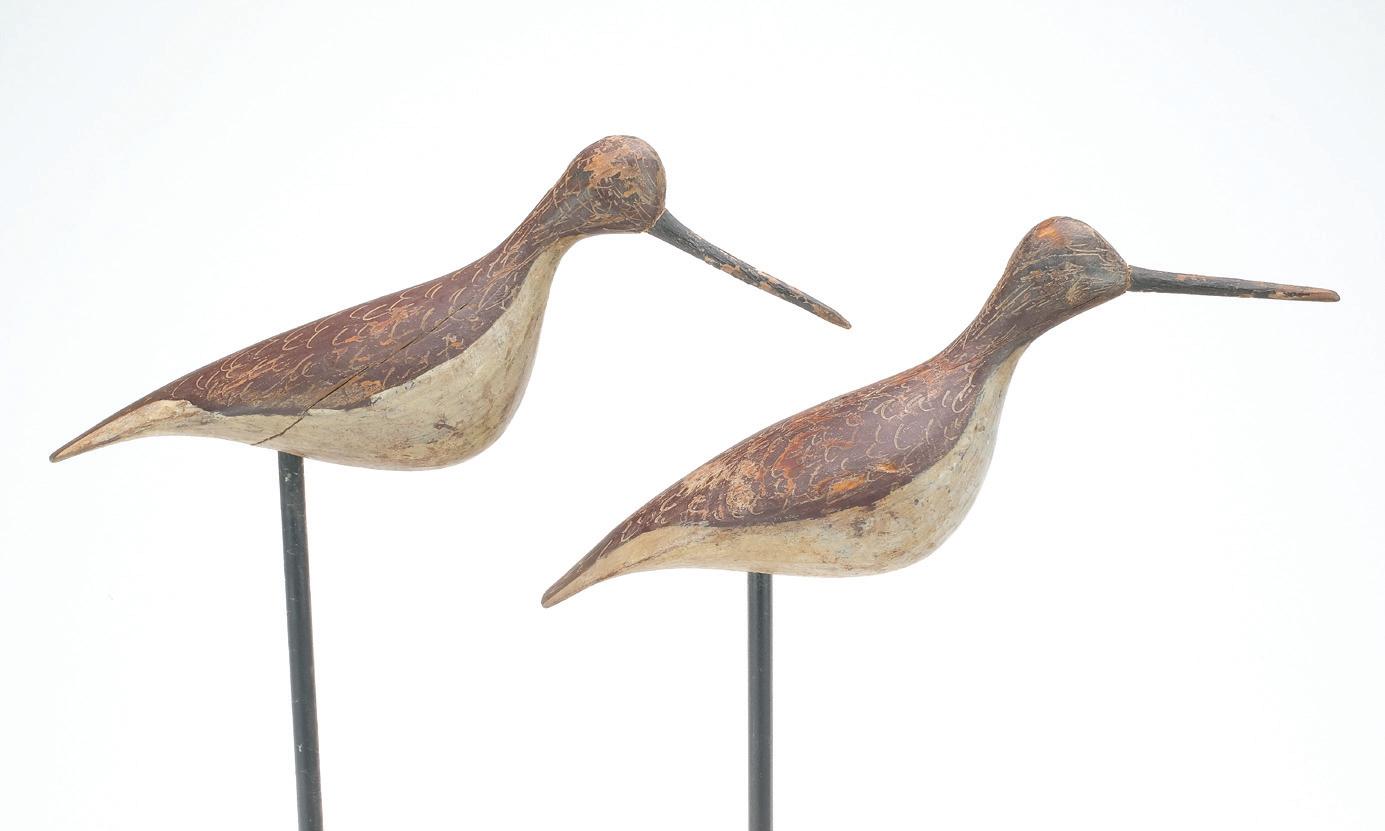
51 53 54 52
55 Plump sanderling, Dave “Umbrella” Watson, Chincoteague, Virginia, circa 1900. Well fed belly with relief wingtip carving. Measures 6.25” long. Original paint with moderate flaking and wear; surface has darkened with age; approximately half the bill is missing; lightly hit by shot in one side.
(1,500 - 2,500)
56 Yellowlegs, Charles Clark, Chincoteague, Virginia, 1st quarter 20th century. Ridge down back and tail, and concave carving under tial. Measures 11.25” long. Early second coat of paint with moderate discoloration and wear; heavily hit by shot; chip in each side of tail; drying cracks along one side; bill is a professional replacement. (600 - 900)
57 Black bellied plover from Virginia, 1st quarter 20th century. Relief wing carving. Measures 9.25” long. Original paint that has been waxed with moderate discoloration and minor wear; sap bleed on breast; roughness on back of head; bill is a later replacement.


Provenance: David Fannon collection. (400 - 600)

57
55
56
Maryland
Charles Nelson Barnard
1876 - 1958 | Havre de Grace, Maryland
The well-known rig of decoys bearing the brand of J.P or J. Pusey have been traced to Joel Boone Pusey (1888 – 1965) of Brick House Farm near Aberdeen MD. Mr. Pusey was born into a prestigious Havre de Grace family. His father was a successful merchant, United States Sub Treasurer and three-time mayor of Havre de Grace. In 1913 he married Florence Grace Michael who, too, came from a prominent Havre de Grace family, her father being a local Bank president and farmer. Joel’s father-in-law, John M Michael owned a farm on the southern shore of Swan Creek where it empties into the lower end of the Susquehanna Flats. In 1883, Mr. Michael and his brother expanded the farm by purchasing “Oakington”, a large property on the opposite side of Swan Creek with extensive frontage directly on the Chesapeake. After his marriage, Joel and his wife resided with her parents on the Michael’s farm, and he assumed a position in the family’s elaborate canning operations there.

As stated in his obituary, Joel Pusey “- - - was an ardent sportsmen and member of a hunting club in Aberdeen”. The farms owned by the Michaels, (later occupied by Pusey) were a waterfowler’s dream. Hunting along the shores of both properties provided excellent shooting as did the vast expanse of the “Flats”. There were undoubtedly shore blinds, as well as at least one sinkbox rig (Joel’s son, John, first shot out his father’s box when he was only 14). As with other hunting rigs of the day, the family’s decoys numbered between
300 and 400 birds. Most were by the best of the local Havre de Grace carvers (Hollys, McGaw, Barnes, etc), as well as the usual lesser number of breakaways or floaters from some of the Flats’ well known gunning scows, such as ‘Twilight’ and ‘Reckless’. Still others bear the brands of nearby clubs, like the San Domingo Farm Club. Certainly, as far as today’s collectors are concerned, a highlight of the family’s flock would be the high head canvasbacks by Charles Nelson Barnard (1876 – 1958) of Havre de Grace. At a minimum, the Pusey rig contained at least seven of these regal decoys which would have been used on the wings of the sinkbox to help shield the hunter. Surviving examples are considered to be one of the centerpieces of any quality upper Bay collection.
48
As with many such early rigs, the Pusey birds were handed down in the family. Joel may have inherited them from an earlier relative as well as perhaps purchasing some himself, and he, in turn, passed the decoys down to his two sons, John and Clarence. It must have been quite an exciting sight when noted collector C. John Sullivan, on one of his multiple visits to the Pusey farm, finally got to see the extensive rig in its entirety, in the darkness of the family’s warehouse. One can imagine his horror as the then owner clambered over the piles while John flinched at the imagined damage being done. The owners response: “- - - this won’t hurt them at all. How do you think we use to handle them, with kid gloves?”.
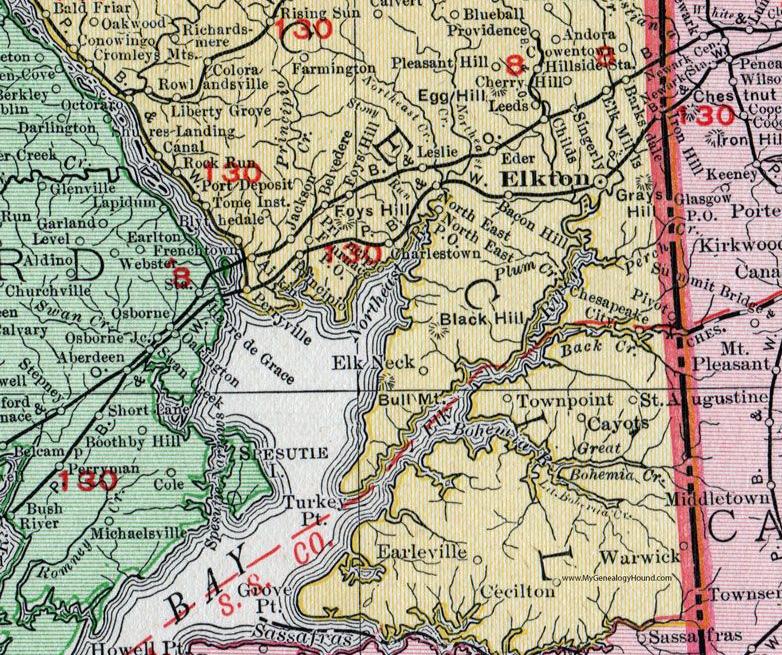
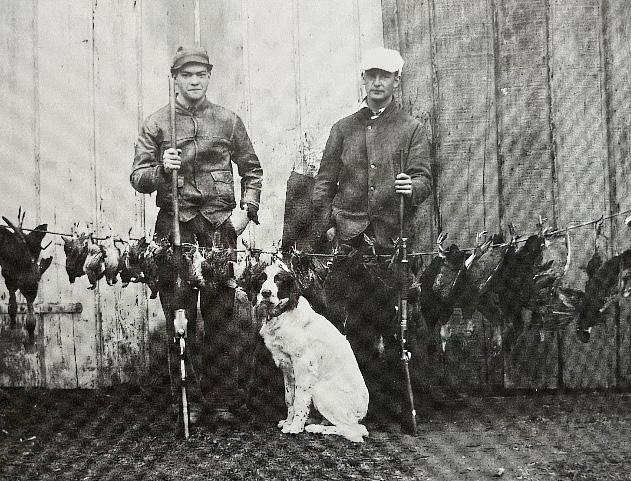
 The Pusey brothers, John M and Clarence
Pusey farm
The Pusey brothers, John M and Clarence
Pusey farm
58 Outstanding high head canvasback hen, Charles Nelson Barnard, Havre de Grace, Maryland, 1st quarter 20th century. Raised neck seat and reared back high head. “J. Pusey” branded on the underside. Measures 15” long. Original paint with minor to moderate gunning wear; moderately hit by shot with three larger shot strikes on one side of bill and head that has caused small chips; minor roughness on edge of tail.


Provenance: David Fannon collection.
Literature: “Decoys of the mid-Atlantic region”, Henry A. Fleckenstein Jr, page 121, rigmate pictured. “Waterfowling on the Susquehanna Flats”, Michael Daley, page 28, similar pair pictured. (15,000 - 25,000)
50
59
Excellent high head canvasback, Charles Nelson Barnard, Havre de Grace, Maryland, 1st quarter 20th century. Raised neck seat and reared back high head. Measures 15.5” long. Mix of original paint and very early thin second coat on head and breast; minor to moderate wear; minor roughness and chipping on edge of bill; old chip in top of head; soft heart wood along one side of body.


Provenance: David Fannon collection.
Literature: “Waterfowling on the Susquehanna Flats”, Michael Daley, page 28, similar pair pictured. (12,000 - 18,000)
51
James Holly
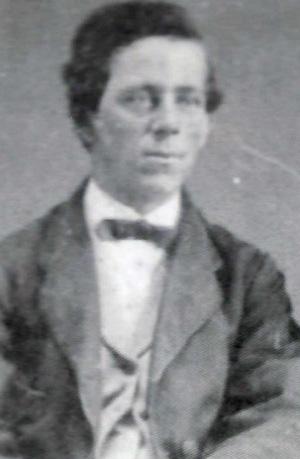
1855 - 1935 | Havre de Grace, Maryland
One of the premier ducking families on the upper Chesapeake were the Holly’s of Havre de Grace. James was the middle son of patriarch John (“Daddy”) Holly and all of the male family members were known to carve fine decoys. James, however, was, first and foremost, a boat builder and this occupation certainly becomes apparent when viewing his decoys, which are distinguished by their sleek, smooth lines. His innate artistic abilities also show themselves when we learn that he played in the local band and was one of the best ice skaters on the Susquehanna River.

When one thinks of the Susquehanna Flats, it is the canvasback and other closely related divers that instantly come to mind, with huge rafts of these birds bobbing around the many sinkboxes of the region. At certain times of the year, the area surely would have also attracted the common puddle ducks such as blacks, teal, pintail, and mallards. The total number of decoys produced for these species, however, would represent a mere fraction of the total number of decoys in use. James Holly is known to have carved examples of each of these choice ducks and his are considered to be among the best examples from Harford County.
Mallards were one of the rarer species carved and hollow decoys were practically unheard of. The example being offered here is generally conceded to be the ONLY known hollow example, thus making it exceedingly rare and desirable. Adding to its appeal is the fact that it has survived about one hundred years in its original paint, which remains in outstanding condition.
 James T Holly c1880
James T Holly c1880
Exceedingly rare and possibly unique hollow carved mallard, James Holly, Havre de Grace, Maryland, 1st quarter 20th century. Two piece hollow carved body with hard chine line along upper sides. Measures 17.5” long. Original paint with moderate gunning wear; minor chipping and roughness on edge of tail; tight crack through neck; shot strike on one side of face and bill.


Provenance: David Fannon collection.
Literature: “Waterfowling on the Susquehanna Flats”, Michael Daley, page 164, exact decoy pictured. (8,000 - 12,000)
60
Rare rigmate pair of canvasbacks, James Holly, Havre de Grace, Maryland, circa 1900. Both retain the original metal rig tag for John McKeag, Darby, Pennsylvania. Both branded “F” on the underside for Henry Fleckenstein. Measure 15.25” long. Original paint that has darkened with age showing minor gunning wear; two small nails added to hen’s neck seat with minor chipping around nail head on one side; minor flaking to filler on top of hen’s head; minor roughness on edge of drake’s tail; slight separation to a small knot on drake’s back.
Provenance: David Fannon collection. (5,000 - 8,000)
For years, a small number of exceptional canvasbacks, considered among the finest produced by celebrated Havre de Grace carver James Holly (1849 – 1935), have stirred the imagination of advanced collectors of Upper Bay birds. The decoys bear the rig tags of John McKeag or Fred Hildebrand. Both men identified their home on trap tags affixed to the decoys as either Darby, PA or Upper Darby, PA respectfully. Both towns are located on the Delaware River near the southwest boundary of Philadelphia, a location fairly well removed from the shores of the Susquehanna Flats. Traditionally, decoys from the River, Philadelphia in particular, were fairly delicate, light weight, hollow decoys representing those species commonly hunted in the area (bluebills and puddle ducks specifically). Canvasbacks, particularly solid, rugged decoys meant to attract them, would have been considered an abnormality. A 2015 article in Decoy Magazine by respected collector and historian, Chad Tragakis, finally shed some light on the confusion.
Based on his research, Chad was able to surmise that both men hunted the stretch of the Delaware River between the mouth of the Schuylkill River and Darby Creek and that the preferred hunting method of both men was that of skulling to the resting flocks. This section of the Delaware could contain some rather rough and turbulent currents, especially after dredging operations on the river were carried out c1902. If McKeag and Hildebrand set their rig(s) in the open water at the middle of the river, as would be expected if targeting canvasbacks, then a rugged, solid decoy, such as those used on the upper Chesapeake, would have certainly rode the water better. The men chose their decoys carefully. The rigs of both men contained
decoys carved at slightly different times by Holly, between 1910 and 1920, suggesting that they were purchased separately, and possibly second-hand. It is believed that Hildebrand purchased his decoys first, followed at a later date by McKeag. Mr. Tragakis presents a compelling case that, at some point, the men joined forces, combined the two rigs, and the pair began to hunt together. Based partially on the fact that the decoys were transported in skull boats, it is estimated that the total rig probably numbered between 50 and 75 birds.
The lives of both men share a number of similarities. Both had parents that immigrated to the US, Hildebrand’s from Russia, and McKeag’s from Ireland. Fred was born in Philadelphia while John McKeag was born in Belfast, Northern Ireland and came to the US with his parents in 1904-5. The two men spent their younger years in Philadelphia and both worked in trades that involved metal working. McKeag spent practically his entire life employed as a sheet metal worker, while Hidebrand was a draftsman for businesses ranging from the production of gun sights to electrical components. They were confirmed bachelors who, initially, lived in neighboring communities. Hildebrand resided in Upper Darby from at least 1920 to the time of his death in a nursing home, while Mckeag lived in nearby Colwyn from at least 1930 through 1940, moving to Upper Darby by the time of the 1950 Federal Census, and remaining there until his passing of a heart attack.
Decoys from their rig(s) represent some of the finest examples of James Holly’s carving efforts and are treasured additions to mature upper bay collections.

54 62
Very rare rigmate pair of canvasbacks, Charles Nelson Barnard, Havre de Grace, Maryland, 1st quarter 20th century. Raised neck seats with mid neck height style. “J.P.” branded on the underside of each for the rig of James Pusey. Measure 15” long. Hen in original paint with moderate wear, drake with a very early second coat to head and breast; small dents and shot marks; lost filler on one side of drake; drying crack along underside of drake; professional restoration to the bottom half of drake’s bill; crack through hen’s neck.

Provenance: David Fannon collection. (8,000 - 12,000)

63
The J. Schick rig
The following is a synopsis of research conducted by Chad Tragakis and Kevin Peel for possible future publication. Guyette and Deeter gratefully acknowledge their scholarship as well as their willingness to share their findings with us for presentation here.
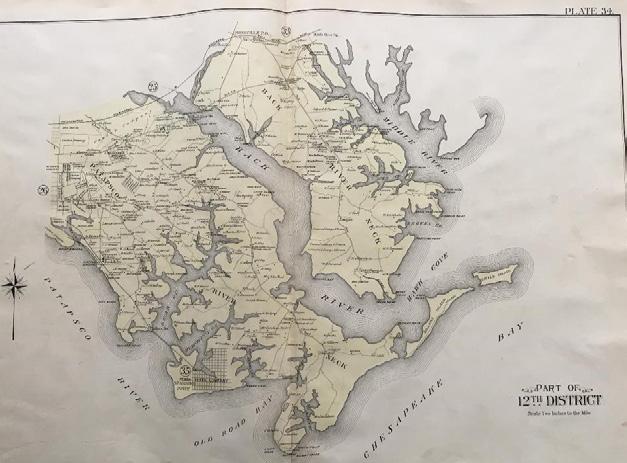
Over the last 40 years, a small group of uniquely stylized decoys, many bearing the “J. SCHICK” brand, have been found. Their first appearance at auction (apparently with little or no provenance), was at an early 1993 Richard W Oliver sale in Salisbury, MD, and some, again originating from an unknown location, appeared at a Virginia Beach show at about the same time. These two areas seem to be outliers since the majority of examples have been collected from the areas between Baltimore City and Harford County, MD. Decoys by this maker have surfaced around the historic gunning areas of Millers Island, the Middle and Back River Necks, and the Gunpowder River. These include examples from the rig of Henry George Krotee (1896 – 1974) that were used on Dundee and Saltpeter Creeks (see note 2) adjacent to Carroll’s Island in Baltimore County. Subtle differences among the decoys would seem to indicate that the birds were carved at different times, and the

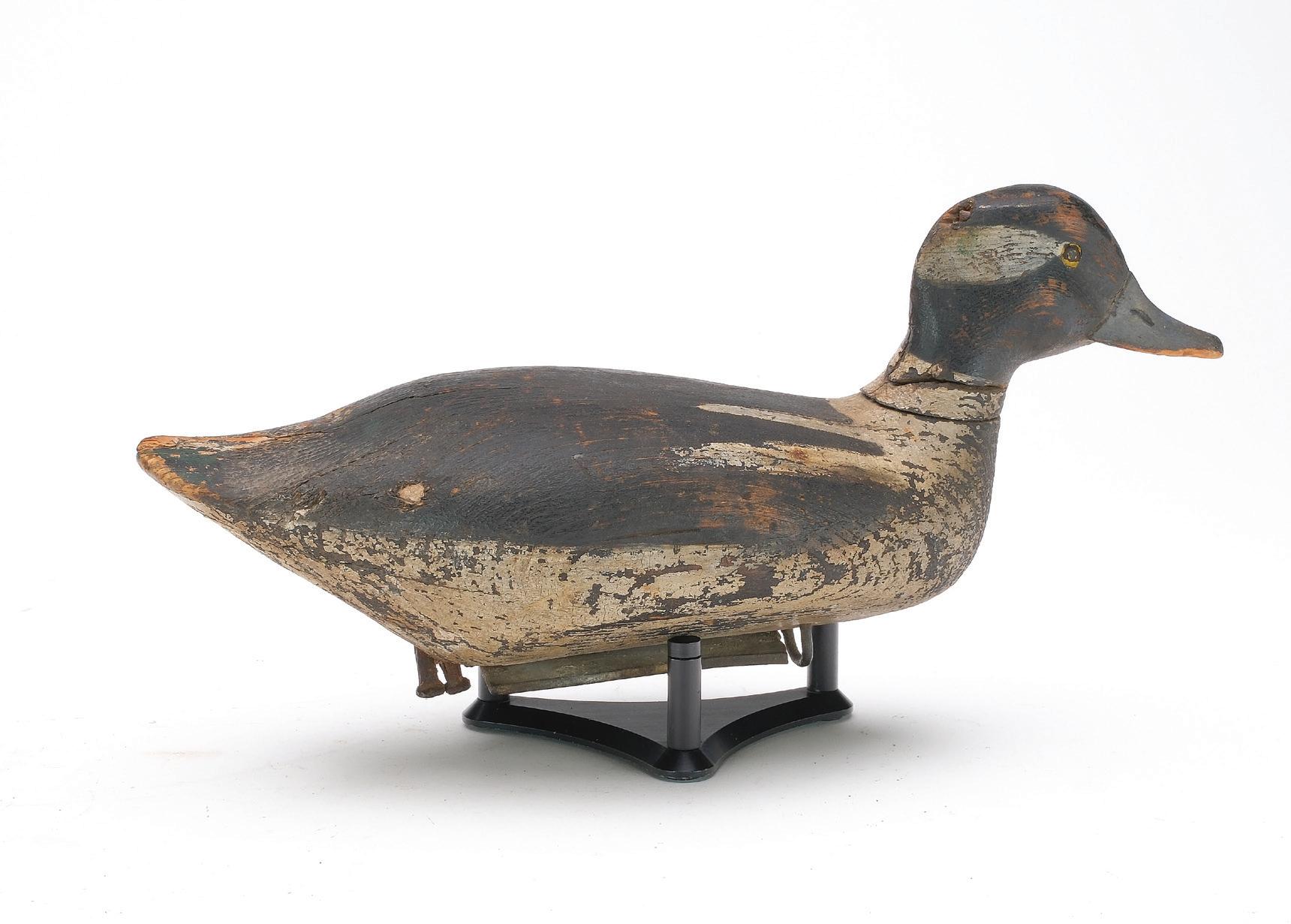
presence of large marine spikes used as ballast on some, coupled with their superb construction and styling, have led many to suggest that they were from the hands of a boat builder or, at least, a very competent carpenter. Some collectors believe that they were carved by Schick for his own use, but it’s more likely that Schick was merely the owner of the decoys bearing his name. The basis for this assertion is that more unbranded than branded decoys, clearly by the same hand, have been found. The maker of these decoys carved a number of species, but it’s the rare buffleheads in the rig that are among the most admired and coveted by today’s collectors.
64 A rare and desirable swimming bufflehead drake from the maker of the Schick rig, Havre de Grace, Maryland, circa 1900. Swimming form with a slightly turned and reaching head. Carved eyes. Measures 13” long. Old crazed and flaking paint which appears to be original; some cracks and separation at tail; dent in top of back; a few spots worn to bare wood on head and
56
64
Patapsco, Back, and Middle Rivers
While the exact owner of the branded examples cannot be ascertained with absolute certainty at present, a growing consensus considers the most probable candidate as one John Schick (1854 –1926), a German born saloon keeper from Baltimore who was a known deer hunter and owned a Chesapeake Bay retriever, a breed favored by local duck hunters, in the early 1890s. This John Schick lived and worked in the vicinity of the Fells Point and Canton waterfronts, an area just to the north of Point Breeze on the Patapsco River, which afforded him some of the best waterfowling near Baltimore ( see note 1) . This information has led some to date the rig to circa 1870-90.
In the opinion of both Chad and Kevin: “While - - - the maker and history of the Schick rig decoys remain a mystery - - - one thing that is absolutely not in dispute – they are incredible works by a master craftsman, rich in history and worthy of a place in the best collections of American decoys”.
65 Rare bufflehead drake from the maker of the Schick rig, Havre de Grace, Maryland, circa 1900. Carved eyes with swimming and slightly tilted head. 11.5” long. Imperfection to wood at one side of body; several tight cracks in neck; rough area around tail; early paint


Notes:
1. John Schick immigrated to the United States with his parents in 1870. That same year he is found in the census living in Baltimore and working as an “apprentice to Baker”. By 1880 he had married his first wife Mary and is listed in the census as being a “Restaurant keeper”. The household also included her mother as well as a “servant”. They had a daughter, Mary, but sadly, his wife died in 1901. He apparently remarried in 1911 this time to Anna Bruetting, but she too passed soon thereafter. He died in 1926 after a lingering illness.
2. Henry George Krotee was born into a large farm family on the outskirts of Baltimore. He worked on the farm until 1917 when he served two years in the Army during WWI. Returning home, he married Ruth L Herrmann and they raised 3 children while Henry worked as a plumber. He died in Raspeburg, a suburb of Baltimore.
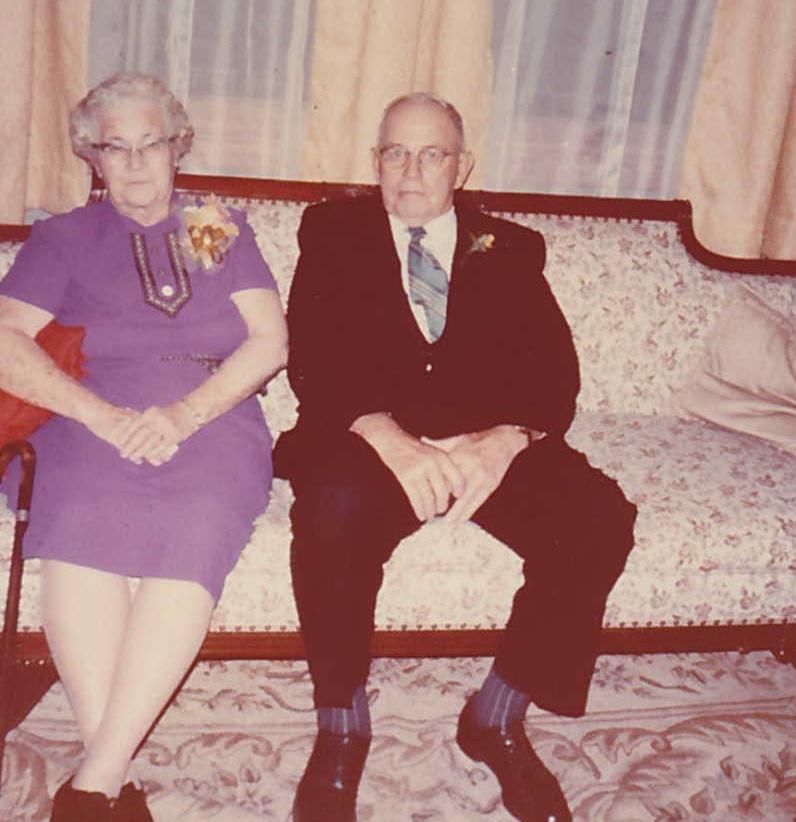
57
65
Ruth and George Krotee
Noted historian C John Sullivan in his “A Chronicle of Letters: Robert F McGaw Jr. Decoy Maker, 1879 – 1958” describes McGaw’s work as “. . . magnificent folk art . . .” and states that “ his decoys were among the finest to float on the Susquehanna Flats.”. Honors continued, even well after his death when, in 1985, the U.S. Postal Service featured a McGaw canvasback on one of the first U.S. commemorative decoy stamps. Today, his work can be appreciated through its inclusion in some of the finest Chesapeake Bay collections and through exhibits such as that at the Havre de Grace Decoy Museum.
66 Canvasback, Robert McGaw, Havre de Grace, Maryland, 2nd quarter 20th century. So called “Postage Stamp” rig. Retains the original dogbone weight. Measures 15” long. Original paint with very minor wear; scattered paint rubs; filler added to a split in the underside when the decoy was made, otherwise excellent structurally. (5,000 - 8,000)



58
US Post Office commemorative stamp from 1985
Rare redhead drake, John “Daddy” Holly, Havre de Grace, Maryland, 2nd half 19th century. Measures 14” long. A working repair, possibly in the making, to an imperfection on the right side of the body; heavy gunning wear; paint appears to be original; worn to bare spots on approximately 20% on the body; a small patch was also made to the decoy on the underside; cracks at neck have separated but are secure; this is a very rare decoy in original paint.
Provenance: David Fannon collection.
(3,000 - 5,000)
69 High head canvasback, James Holly, Havre de Grace, Maryland, 1st quarter 20th century. Measures 16” long. Early in use repaint with significant flaking and wear; a few small dents; drying crack in one side secured by two old nails; otherwise very good structurally.
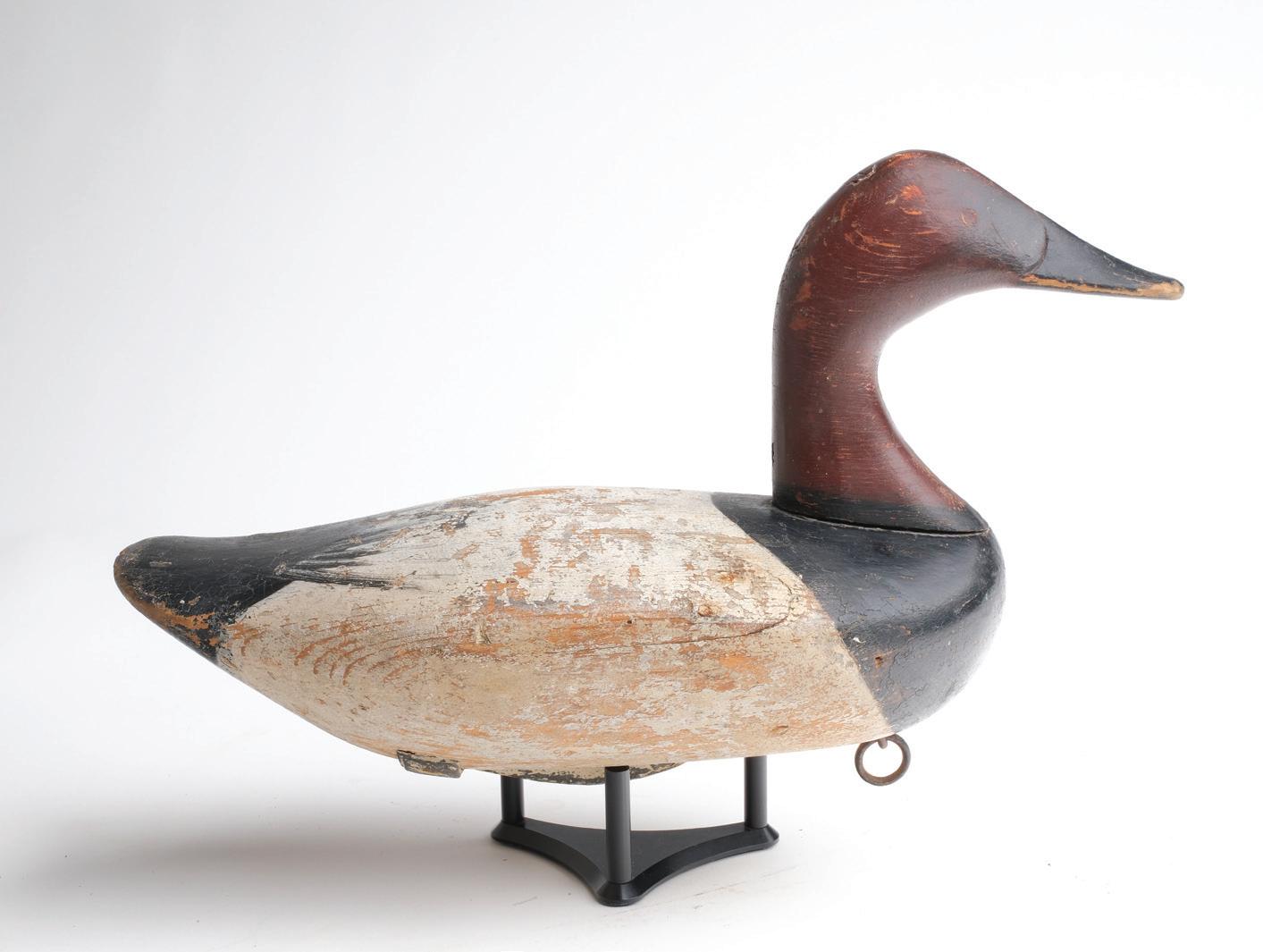


(1,000 - 1,400)
68 Redhead, Ben Dye, Perryville, Maryland, last quarter 19th century. Raised neck seat and tack eyes. “F” branded on the underside for the collection of Henry Fleckenstein. Measures 12” long. Old in use repaint has worn down to a very early surface including some bare wood; drying crack in one lower side and a small loss to knot in same side; multiple drying cracks in head and upper part of bill.
(1,200 - 1,800)
67
59 67 69 68
Canvasback hen, John Graham, Charlestown, Maryland, last quarter 19th century. Slightly flat bottomed with an iron keel weight and raised neck seat. Measures 15” long. Early in use repaint with moderate to significant wear; minor chipping and roughness on edge of tail; old neck crack repair. (1,200 - 1,800)

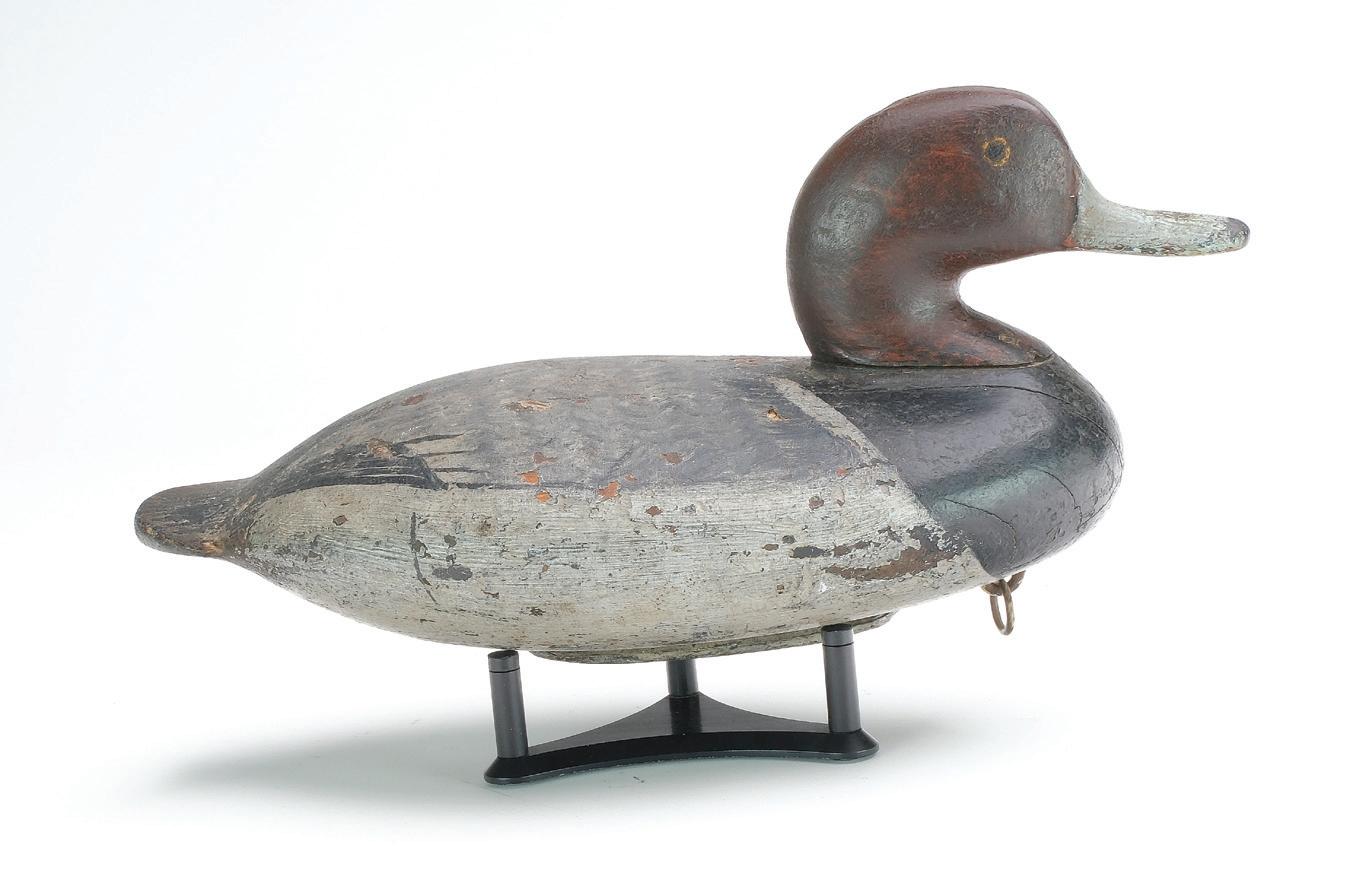
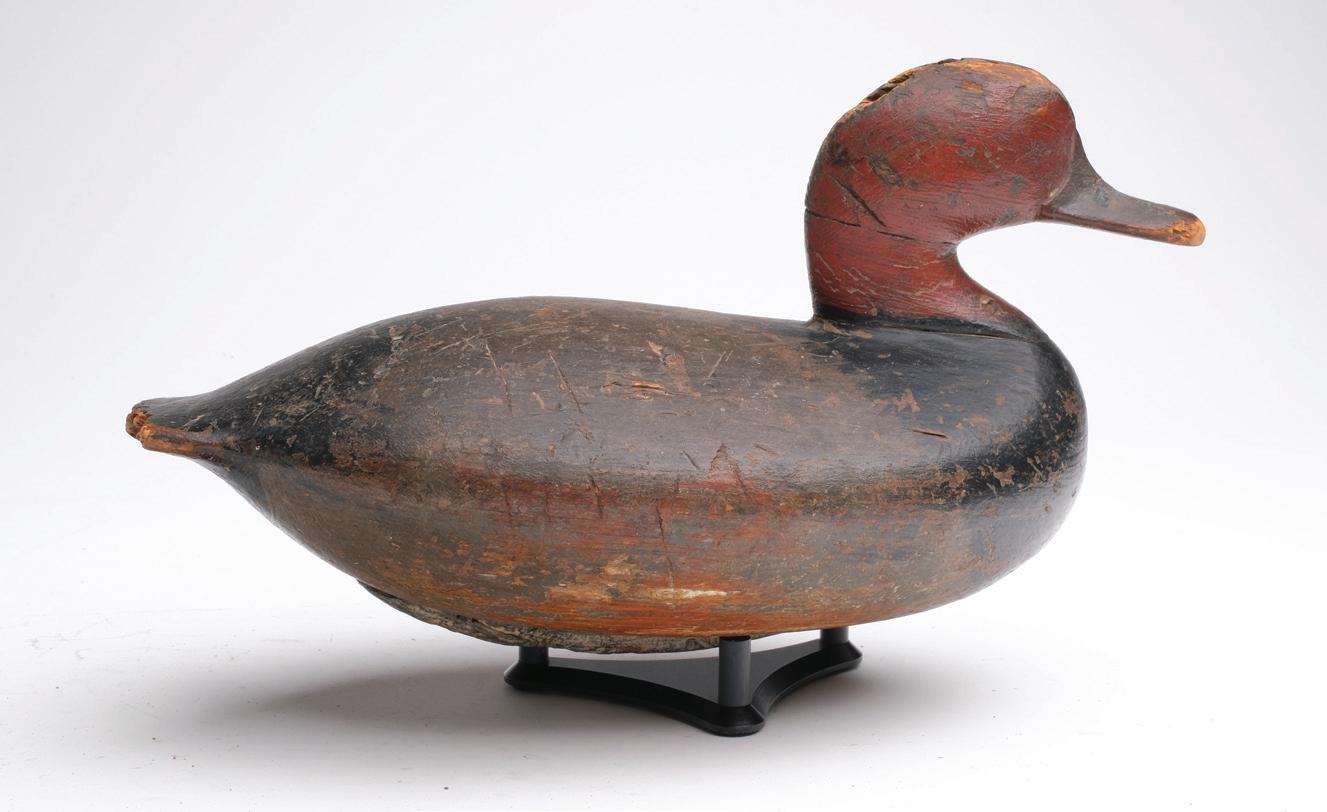

71 Redhead, Ben Dye, Perryville, Maryland, last quarter 19th century. Raised neck seat and center tail orientation typical of Cecil County decoys. Small collection ink stamp that looks like “McKierny”. Measures 13” long. Paint appears to be a mix of original and very early in use repaint with moderate to significant gunning wear; many dents and shot marks; loss to wood on underside; chipping on tail and top of head; crack through neck with a nail added on top of head to secure; roughness on edge of bill and top of head.
Provenance: Mark and Ann Terry collection. (1,200 - 1,800)
72 Redhead, Ben Dye, Perryville, Maryland, last quarter 19th century. Branded “PK Barnes” on the underside. Also branded “F” for Henry Fleckenstein. Measures 13.5” long. Early second coat of paint by the maker with moderate flaking and wear; more recent strengthening to black on breast and red on head; tight drying cracks in breast; very minor roughness on one side of tail.
Provenance: David Fannon collection. (1,200 - 1,800)
73 Canvasback, Charles Nelson Barnard, Havre de Grace, Maryland, 1st quarter 20th century. Raised neck seat and reared back, mid head style. Measures 15.5” long. White areas are original with moderate wear; the rest in an early second coat of paint; moderately hit by shot; area of roughness on one side of body and on edge of bill. (2,000 - 4,000)
70
70 72 71 73
Bluebill, William Heverin, Charlestown, Maryland, circa 1900. Thinner than typical body, with raised neck seat. “Jos.D.Crowl” stamped in to lead weight. Measures 14” long. Original paint that has darkened with age; minor flaking on back appears to be from heat exposure; very minor wear; thin chip on one side of bill was darkened. (1,200 - 1,800)

75 Canvasback hen, William Heverin, Charlestown, Maryland, 1st quarter 20th century. Raised neck seat and angel wing paint pattern. Decoy was never rigged or weighted. Measures 15.5” long. Original paint with moderate wear; small spot of filler and touchup on one side of head. (2,000 - 3,000)
76 Canvasback, William Heverin, Charlestown, Maryland, 1st quarter 20th century. Decoy was never rigged or weighted. Measures 15.25” long. Original paint with minor flaking and wear; hairline cracks along one side; cracks and splits in neck and back of head. (1,000 - 2,000)



77 Bluebill, Joe Dye, Perryville, Maryland, 1st quarter 20th century. Raised neck seat and slight bill carving. “F” branded on the underside for the collection of Henry Fleckenstein. Measures 13.75” long. Original paint with moderate flaking and wear; hairline drying cracks in breast and back; hairline drying cracks in back of head.
Provenance: Mark and Ann Terry collection. (800 - 1,200)
74
74 76 75 77
78 Canvasback, John Holly, Havre de Grace, Maryland, last quarter 19th century. “North Carolina” branded on the underside. Measures 13.5” long. Old in use repaint with moderate flaking and wear; shallow chips on each side; separation at a knot on each side of tail; crack through neck; minor roughness on edge of tail.



Provenance: Mark and Ann Terry collection. (800 - 1,200)
79 Canvasback hen, Lum Fletcher, Havre de Grace, Maryland, 1st quarter 20th century. Raised neck seat and slightly flat sided head. “WM.A.Smith” and “The Parks” branded twice in the underside. Measures 15.25” long. Original paint with moderate to significant wear; tight drying cracks along the body; hit by shot with a few shot strikes causing chips in bill; tight vertical cracks in back of neck.

Provenance: Mark and Ann Terry collection. (800 - 1,200)

79a Canvasback hen, John Graham, Havre de Grace, Maryland, last quarter 19th century. Branded “PK Barnes” on underside. Slightly raised neck shelf. Measures 13.5” long. Old paint which is a mix of more modern and old working; bill has been strengthened with a small amount of putty; head has been broken and reattached; neck crack has been secured. (800 - 1,200)

62
78 79 79a
Redhead hen, John “Daddy” Holly, Havre de Grace, Maryland, last quarter 19th century. “T Dows” branded on the underside over an earlier brand that is illegible. Used at the Currituck Club, Poplar Branch, North Carolina. Measures 13” long. Paint was restored to look older; hairline crack in one side of neck seat.
Provenance: Mark and Ann Terry collection. (600 - 900)
81 Redhead, John Holly, Havre de Grace, Maryland, last quarter 19th century. Branded “H.E.Jones” and “F.S???” on the underside. Measures 14” long. Paint has worn off the decoy with only traces left on head, bill, and breast; lots of tight drying cracks throughout; two large dents on back; minor chipping and roughness on edge of tail.
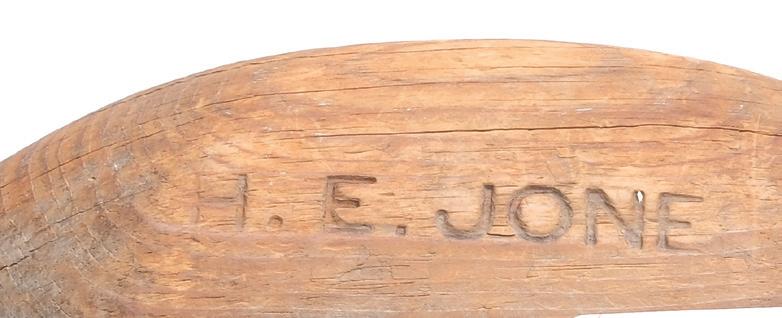

Provenance: Mark and Ann Terry collection. (400 - 600)

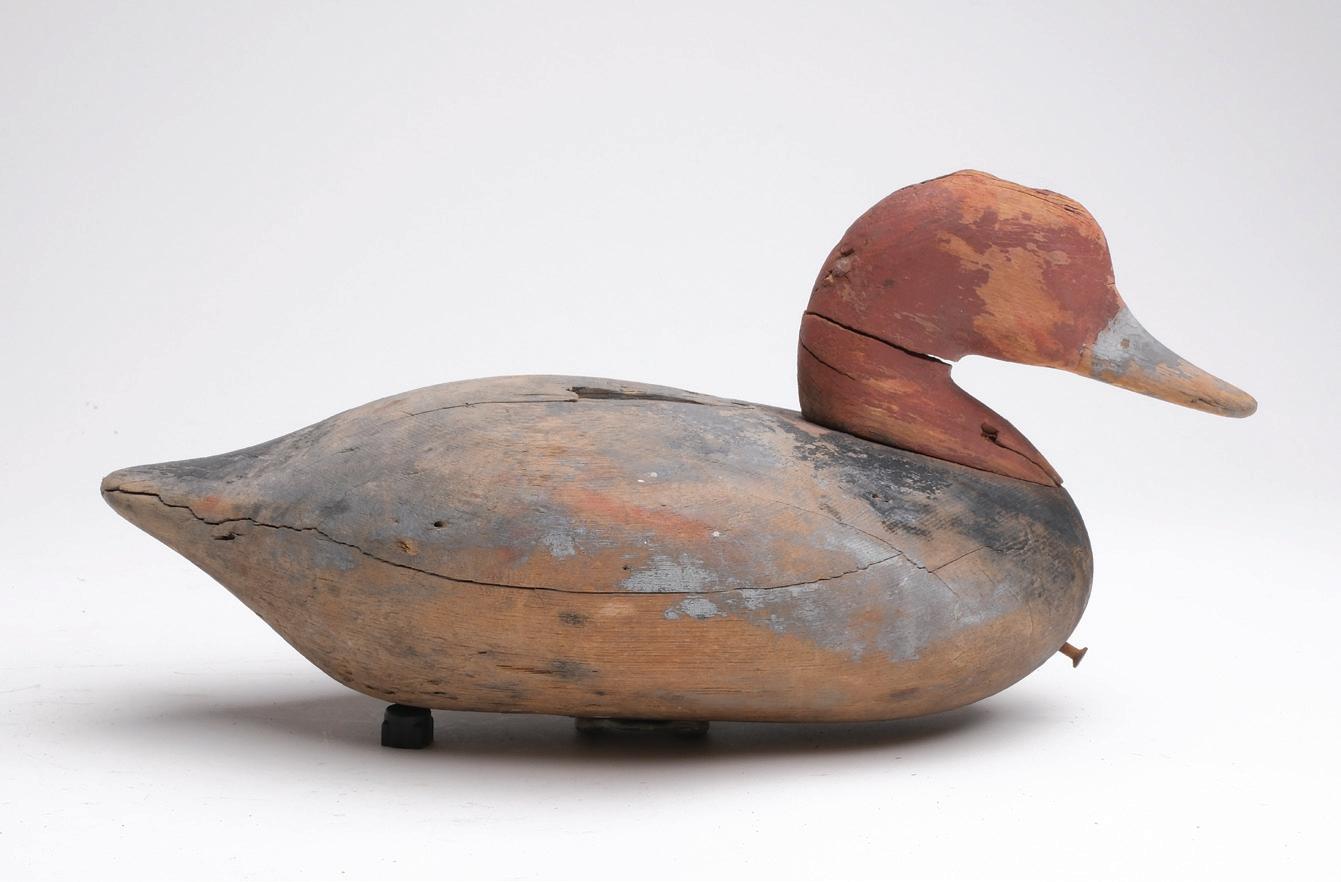


82 Redhead, Dick Howlett, Havre de Grace, Maryland, last quarter 19th century. “C.T.V.S.” branded on the underside. Also branded “Frame”. Charles Townsend Van Santvoord (1854-1895) and Charles Pleasant Frame (1839-1903) were wealthy New York sportsman who were members of the Narrows Island Club in Currituck County, North Carolina where the decoy was used. Inlayed strip weight on the underside. Measures 13” long. Very early paint with significant wear down to much bare wood; drying cracks and defects in wood on back and underside; wooden patch in breast; drying cracks in neck and head; old chip on top of head.
Provenance: Mark and Ann Terry collection. (500 - 800)
63 80
80 81 82
Nathan Rowley Horner
1881 - 1942 | West Creek, New Jersey
Horner was the quintessential New Jersey bayman. Both Federal and State censuses list his occupation as employed as “Oysterman, “clamming”, “boat builder”, “Captain” or “caretaker gunning club”. Somewhat ironically there is no mention that he also just happened to be among the very best of New Jersey decoy carvers of his day, rivaled by, perhaps, only Harry V Shourds. Many would award him the title of “The Best”.

He was born into a working family in Atlantic City where his father worked as a blacksmith. In 1902, he married Lillian M Bartlett in Tuckerton, and they began to raise their family of four children. Nathan’s various jobs took him to a number of locations around Little Egg Harbor Bay, located roughly in the middle of the famed Barnegat Bay. This area was a very well-known area for waterfowling. An 1883 issue of “Forest and Stream” listed no fewer than 20 guides working out of Tuckerton alone and there were certainly others in bordering communities. One of these was Horner’s uncle Ellis Parker, who managed the Middle Sedge Gun Club. Soon after his marriage, Nathan found employment at the club working as a cook, guide, and decoy maker. He is also known to have hosted hunting parties at his houseboat moored at Shelter Island in the middle of the Bay. Horner’s earliest decoy carving efforts are believed to date to the late 1800’s and these were almost certainly influenced by his neighbor, the prolific Harry V Shourds (1861 – 1920) of Tuckerton. By the time of his association with Parker, he had refined a style of his own. Fellow carver and guide Chris Sprague also worked at the club and the three men (Parker, Horner, and Sprague) would occasionally collaborate on the carving or repairing the decoys at the club. In the 1930’s, with the decline of favored bay vegetation and the burning of the Middle Sedge Club, Horner moved his family to West Creek where he would spend his remaining years.

The decoys attributed solely to Horner are considered his best work. One of his most celebrated rigs was a small group he made for Bill Sandor (1914 – 2001) of Parkertown around 1936. Although Horner was battling cancer at the time, he agreed to take on the order if Sandor was not in a hurry and was willing to take fewer birds than he had initially requested. The rig, when finished, consisted of a few black ducks and a very small number of mallards, initially thought to number no more than three pair (see note 1). The decoy from the rig being offered here is a newly discovered example. Sandor rig birds are identified by Horner’s addition of an ice grove, their finely applied paint and their unique weights. As noted by Horner historian and author Allen Linkchorst:
“Horner’s last decoys, carved after his move to West Creek, display the ultimate refinement in his carvings and an artistic use of blended and stippled paint”.

Horner’s lifetime output pales in comparison to other New Jersey greats such as H.V Shourds. His mallards are among the rarer of his species and the few existing Sandor rig examples are undoubtedly the finest of these.
Notes: 1.Until 1999, only three, two drakes and a hen were known from the rig
64
New Jersey
Ellis Parker boatyard with Parker, Horner and Sprague decoys
83

Rare and outstanding mallard, Nathan Rowley Horner, West Creek, New Jersey, 1st quarter 20th century. From the rig of Bill Sandor. Hollow carved with large tack eyes and carved ice groove behind neck seat. Excellent paint detail on back. Museum inventory number in ink on underside, also signed “Robt. Staniford, Quogue”. Measures 16.5” long. Original paint with some crazing on head and tail area; some bubbling on lower half of decoy from heat exposure; small spots of paint pulls; area on one wing patch that floureseces, but is not touchup, it is where the varnish layer was not applied; a few scattered spots of touchup to paint pulls; strip of white added after the varnish layer on top of tail likely done by the maker.

Provenance: Recently deaccessioned from an East Coast Museum. Museum collection since 1965. (30,000 - 50,000)

Lloyd Parker
1859 - 1921 | Parkertown, New Jersey
Located just north of its more well-known neighbor, Tuckerton, lies the community of Parkertown. The hamlet is located on the shore of Little Egg Harbor, a portion of the fabled Barnegat Bay. An 1876 map indicates that, of the 23 identified dwellings in the village, over half were occupied by members of the Parker clan. A 1900 federal census lists almost all (65 in total) of the adult males in the small, rural enclave employed as “oysterman” while others were in trades such as farming or boat building. One of these boat builders was Alfred Parker (1824-1909) and his wife, Mary Jane (1835 – 1904). Among their children was a son, Lloyd.
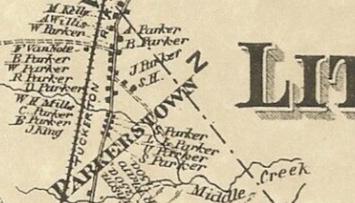

Lloyd spent his entire life in Parkertown, never married, and lived with his parents until the time of their passing. He then moved to a home on Parker Lane North, abutting a small saltwater creek which emptied directly into the Bay. Since at least age eighteen, he earned his livelihood, like most of his neighbors, from working the Bay, listing his occupation as either “oysterman” or “bayman”. Although never mentioned in any document, we know that he was also working as a market hunter, shipping his birds to Boston or New York, where black ducks were bringing 75 cents a pair. There is no mention of his ever acting as a guide, but that would not seem an unreasonable assumption. More importantly, Parker was a known commercial decoy carver who produced some of the finest decoys ever carved in New Jersey.
• “One of the very best first generation (pre 1920) New Jersey decoy carvers.” Jim Doherty
• “Parker is at the focus of a Parkertown tradition.”Kenneth Gosner
• “(Parker) must be considered a competitor of his neighbor Harry Shourds” Bill Mackey
• “(He) was a skilled craftsman, making an outstanding decoy - - - delicately made (and) painted beautifully.”Henry Fleckenstein
Living with his boat building father for fifty years, Parker was certainly familiar with woodworking and the use of tools. Working full time as a bayman, however, meant that his total decoy output was limited, and certainly
fell well behind that of men like H.V. Shourds. His birds were entirely hand sawed and chopped, notable for their lightness and their distinguishing carved crest, rather than the comb style or design used by many of his contemporaries. His work was the inspiration for a number of local carvers to follow, among them his neighbor, Bill Brown, and his hunting partner, Charles W Turner. Parker sold his birds both to local hunters as well as to hunting clubs along the entire coast. His going price for ducks in 1912 was $7 per dozen.
A pair of his mergansers were selected for inclusion in Loy Harrell’s “Decoys – North America’s One Hundred Greatest”. This is the first time it has been offered for public sale.
NOTE: Guyette and Deeter would like to thank Russ Alen for providing vital information used in this article.

66
Parkertown 1878
84
Extremely rare red breasted merganser, Lloyd Parker, Parkertown, New Jersey, last quarter 19th century. Very thinly hollowed with raised neck seat and extended crest. Decoy was never rigged or weighted. Measures 15.5” long. Original paint with minor flaking and wear; moderate flaking to a primer coat on the underside; fine hairline crack in bill.


Provenance: Recently deaccessioned from an East Coast Museum. Museum collection since 1965.
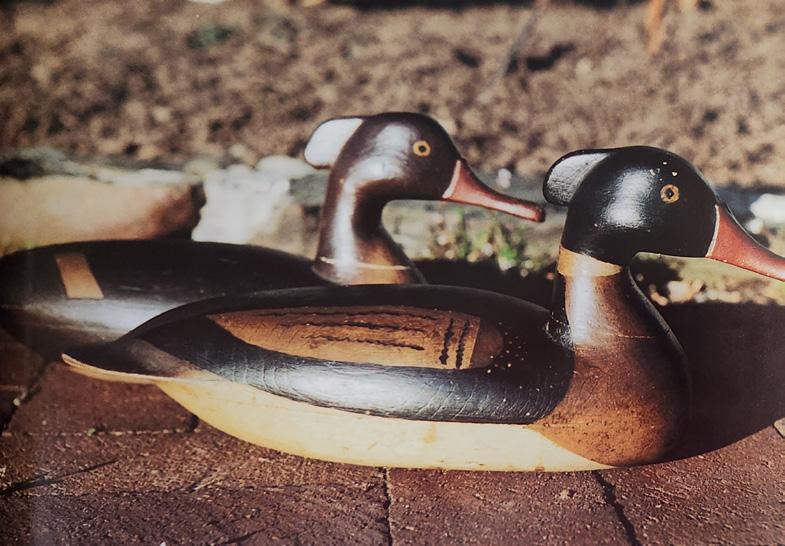
Literature: “Decoys of the mid-Atlantic region”, Henry A. Fleckenstein Jr, page 26 and 140, similar pair pictured. (25,000 - 35,000)
 Lloyd Parker mergansers pictured in “Decoys: North America’s One Hundred Greatest,” Loy S. Harrell, Jr.
Lloyd Parker mergansers pictured in “Decoys: North America’s One Hundred Greatest,” Loy S. Harrell, Jr.
Harry V. Shourds
1861 - 1920 | Tuckerton, New Jersey
Of the multitude of men who carved working decoys, a few giants stand out. Each flyway and region had its local icons but a much smaller number became recognized nationally for their outstanding craftsmanship. Crowell, Perdue, Cobb and others are recognized as producing outstanding representatives of their local style of carving. In New Jersey, Harry Vinuckson Shourds is certainly in the top two or so names that everyone clearly associates with the best of the Barnegat style.

Born the son of Samuel F and Elizabeth Shourds, young Harry was one of eight children who scratched out an existence on their father’s “sailor” salary. As late as 1880, census records indicate that he was still living at home but had no listed occupation. In November of 1884, he married Mary Agnes Bartholomew (who apparently went by the name of Agnes) and, by 1900, they had had four children. Record keeping must have been very lax, for the census on that date still shows him as having no listed occupation – a very unlikely reality. Eventually he would list his occupation as “carpenter – house (1910)” or “painter – general (1920)”. Considering the huge number of decoys that he would ultimately produce, this (nor guiding) is never listed as his source of income in the federal or state record.

68
Classic Canada goose decoy, Harry V Shourds, Tuckerton, New Jersey, circa 1900. Hollow carved with tack eyes and inlet lead weight. Measures 23.5” long. Original paint with good detail; minor wear and good patina; thin crack in top of tail, extending a little ways up the back; professional neck crack repair with touchup in that area.


Provenance: Megargee collection. Acquired from Al Kurtz Absecon, New Jersey in 1960. Private Texas collection.
Literature: “New Jersey Decoys,” Henry Fleckenstein, Jr. “Classic New Jersey Decoys,” James Doherty, Jr. (25,000 - 35,000)
85
86 Rare flying brant, Harry V. Shourds, Tuckerton, New Jersey. Solid body stick up brant with tack eyes and applied canvas wings. Ink stamp from the collection of Dr. George Ross Starr. Measures 23” long, with a 30” wing span. Original paint with moderate flaking, mostly on back; thin wash of black on head and neck; drying crack along the back; minor roughness on bill; canvas on wings has been professionally restored.

(2,500 - 3,500)
87 Early Canada goose, similar to or made by Harry V. Shourds, Tuckerton, New Jersey, last quarter 19th century. Hollow carved. Branded “Geo C. Carson” on the underside. Measures 23” long. Original paint with significant wear down to much of the bare wood; professional neck repair around center of neck; lightly hit by shot; crack in breast where nail was added to secure the body seam; tight drying crack along back.
(1,500 - 2,500)

70 86 87
88 Goldeneye drake, Harry V. Shourds, Tuckerton, New Jersey, last quarter 19th century. Hollow carved with raised neck seat and inlayed lead weight. Measures 13.75” long. Original paint with moderate flaking and wear; minor separation at body seam; narrow defect in wood in one side of body; professional bill chip repair with some touchup to bill and head.
(2,500 - 3,500)
89 Black duck, Clark Madera, Pitman, New Jersey, circa 1920s. Hollow carved body and carved eyes. Measures 16.5” long. Flocked paint appears original with minor gunning wear; underside may have a second coat of black; filler above one small nail in neck seat has flaked, otherwise excellent structurally. (400 - 600)



90 Black duck, Bradford Salmons, Staffordsville, New Jersey, circa 1900. Hollow carved with raised and forward slanting neck seat. Doherty collection sticker on the underside. Measures 17” long. Mix of original and very early in use repaint with moderate flaking and wear; minor chipping in one eye; crack through neck secured with three nails.
Provenance: Ex James R. Doherty collection. (800 - 1,200)
71
88 89 90
New Jersey
For many years, the life of John English remained obscure and his work occasionally misidentified. Early writers all differed when listing his birth and death dates, with birth estimates ranging from 1849 to 1852 and deaths from 1910 to 1915. Allen Linckhorst finally got it right when he recorded his birth as 1848, but he was unsure of his death. Current online genealogical information suggests that his death occurred in 1911, while he was a resident of the Bucks County Home in Doylestown, but this too should be confirmed.


What has been verified is that he lived a very bluecollar life. His father was a farm laborer in Mansfield, NJ and John followed his lead through at least 1870. In 1873, he married Rebecca Pierson in Burlington and he worked as a “mechanic”. By 1880, he had moved to Florence and was employed in a similar industry, listing himself as working in an “Iron Foundry”. By the time of the 1900 census, he worked as a “fisherman” as did his son, Daniel. His other son, John Jr, was seemingly employed in the textile industry working as a “thread dresser” or a “Dyer”. His wife died in 1910 and John lived out his remaining years as a lodger in the home of Joseph Hines in Burlington, NJ.
His decoys were uniquely his own design and were a remarkable shift from birds previously carved on that stretch of the Delaware River. Authors such as Fleckenstein, as well as Huster and Knight, all sing his praises, but their comments can best be summarized by Kenneth Gosner who wrote:
“The work of John English set a standard against which other Delaware River makers have been measured and compared ever since ”
Noted Delaware River authority, collector and historian, Bob White, labels John English as: “the ultimate Delaware River carver.”
John English’s total lifetime output has been estimated at about 500 decoys and this number included a wide variety of species. As birds in his own rig began to show wear, he would sell them to other hunters and carve a fresh rig for himself. Undoubtedly, many of his “used birds” would have been touched up by their new owners. His son, Daniel, also carved some fine birds using his father’s patterns, and these have occasionally been confused with the work of his mentor. After John English died, John Dawson, a much younger carver, acquired a very large rig of English’s decoys and proceeded to repaint them. Finding an all-original John English decoy, especially a mallard drake, is certainly not an easy task. The decoy being offered here should be considered a great rarity and a worthy addition to any advanced collection.

72
John English 1852 - 1915 | Florence,
Foundry, Florence NJ
Delaware River at Florence, NJ
Outstanding mallard drake, John English, Florence, New Jersey, last quarter 19th century. Hollow carved with raised “V” wingtips and incised feather carving. Museum inventory number in ink on underside. Measures 15.75” long. Original paint with very minor wear under an early coat of varnish that has darkened with age; small chip in tail that was darkened, otherwise excellent structurally.
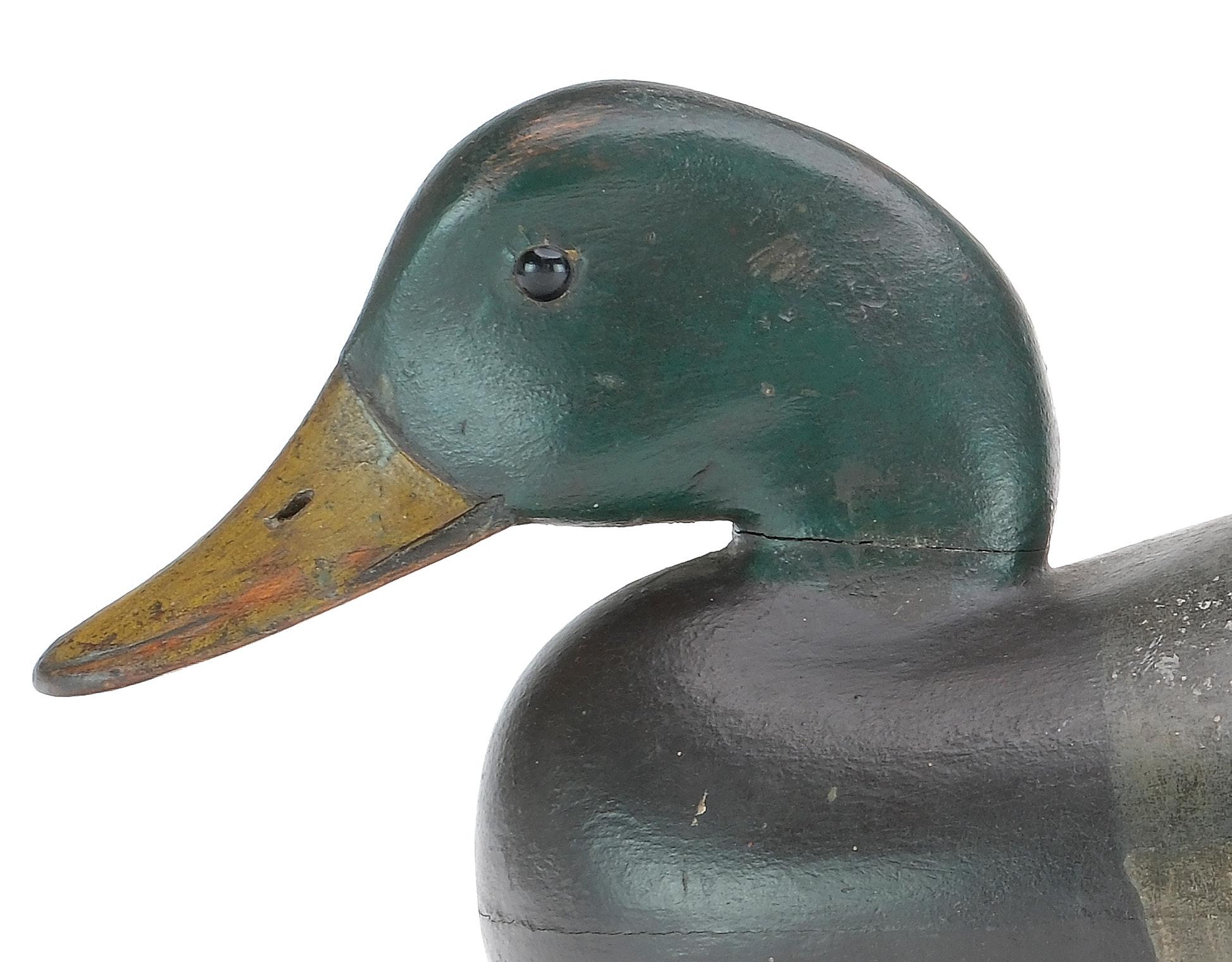

Provenance: Recently deaccessioned from an East Coast Museum. (30,000 - 50,000)
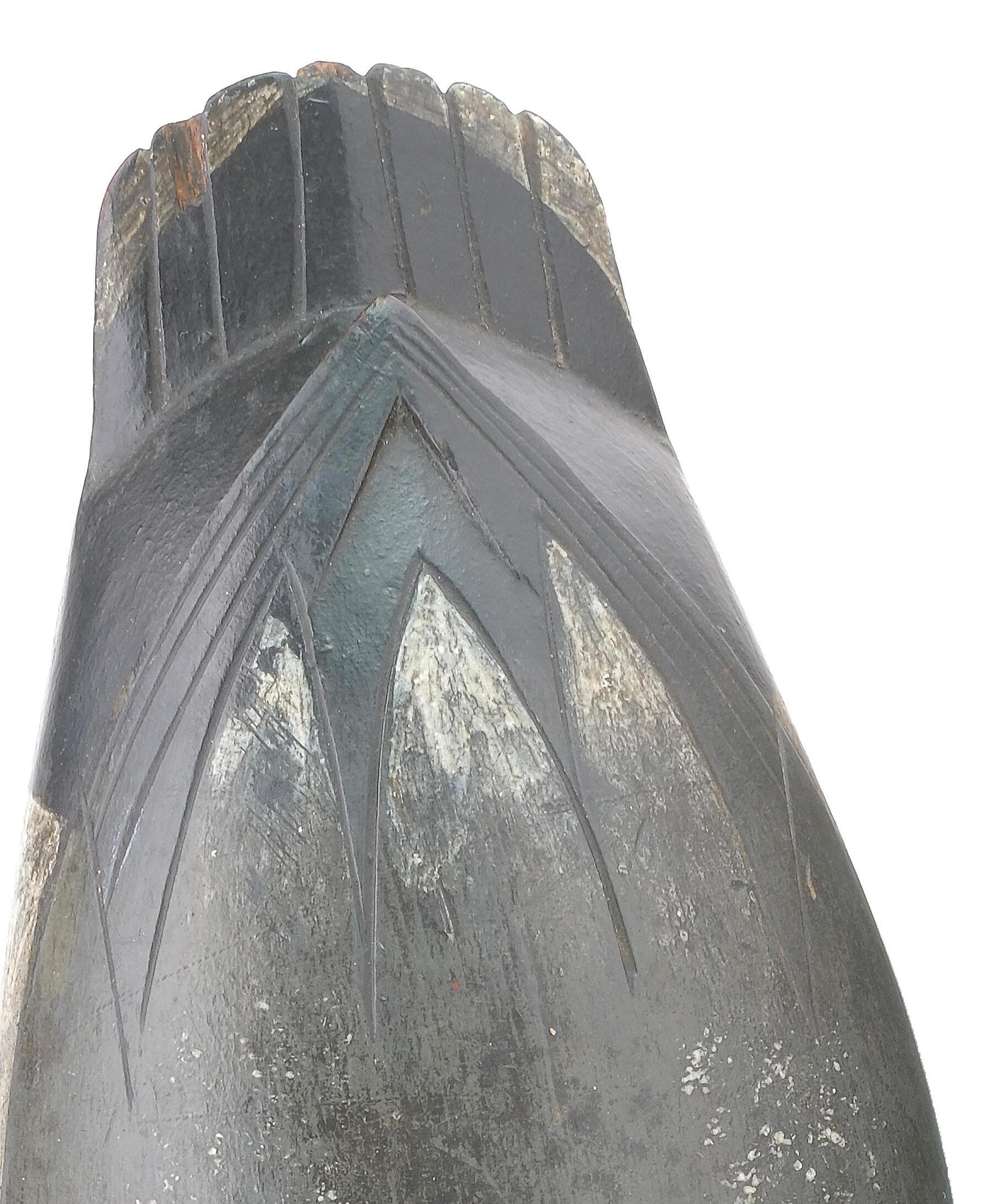
91
Samuel Thomas Archer
1894 - 1986 | Bordentown, New Jersey

Breaking from the traditional carving styles of the Bordentown area, Archer made mostly solid decoys with flat bottoms, and his racy mergansers are no exception. These decoys are thought to have been made around 1910 for his own personal use. Archer was a foreman at the Bristol, Pennsylvania Shipyard with a reputation as a skilled hunter and trapper. He was known as the best sculling oar maker in the area. His recorded sales of oars boast a total of nearly one thousand.

74
92
Very rare rigmate pair of American mergansers, Sam Archer, Bordentown, New Jersey, 1st quarter 20th century. Extended crests and tiny bead eyes. Measures 15.5” and 16” long. Original paint with minor to moderate gunning wear; protected under a very early coat of varnish that has darkened with age; appealing crazing on breasts; crack in one side of hen’s neck; area of flaking down to primer coat on one side of hen’s breast.
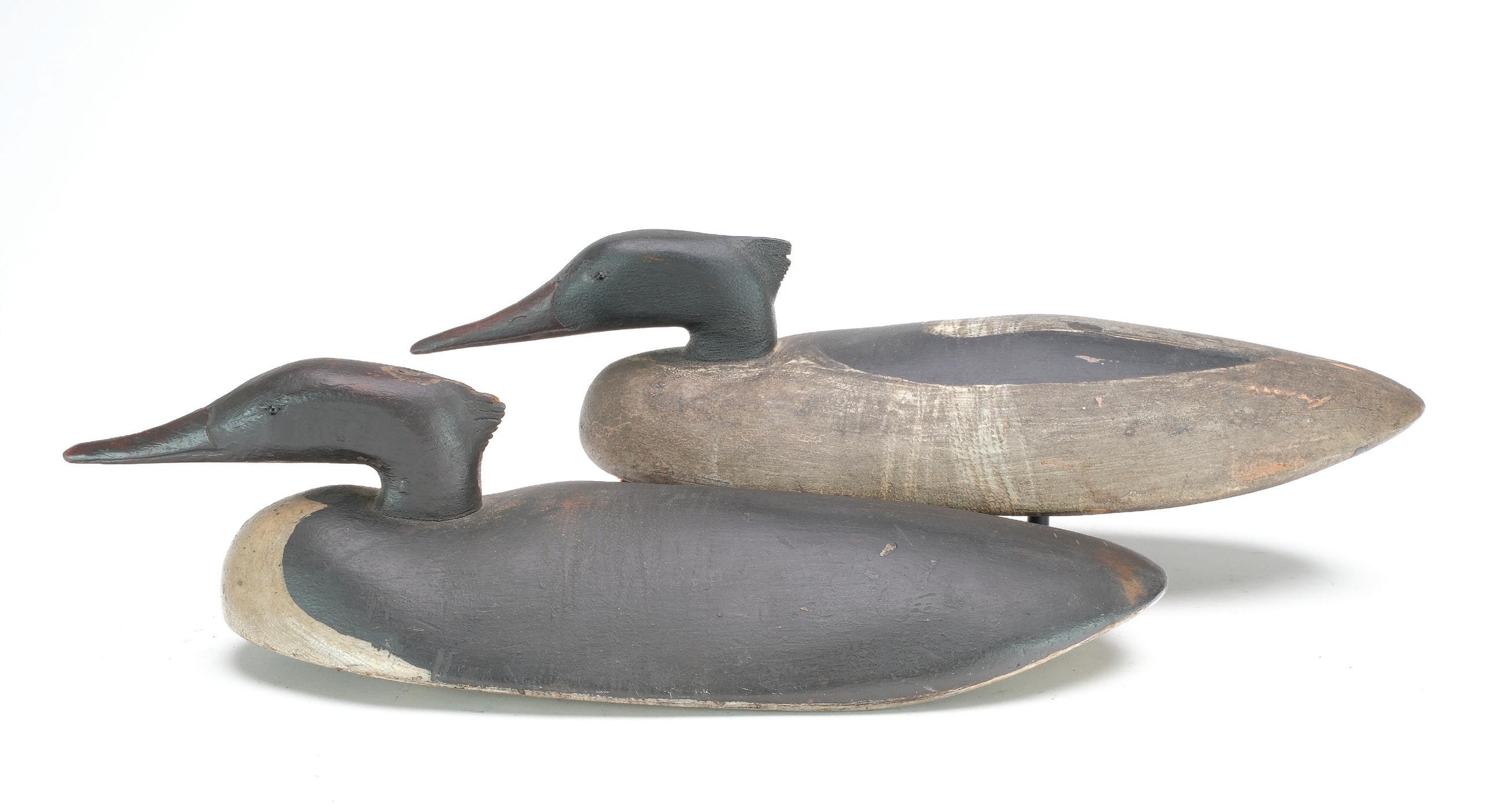
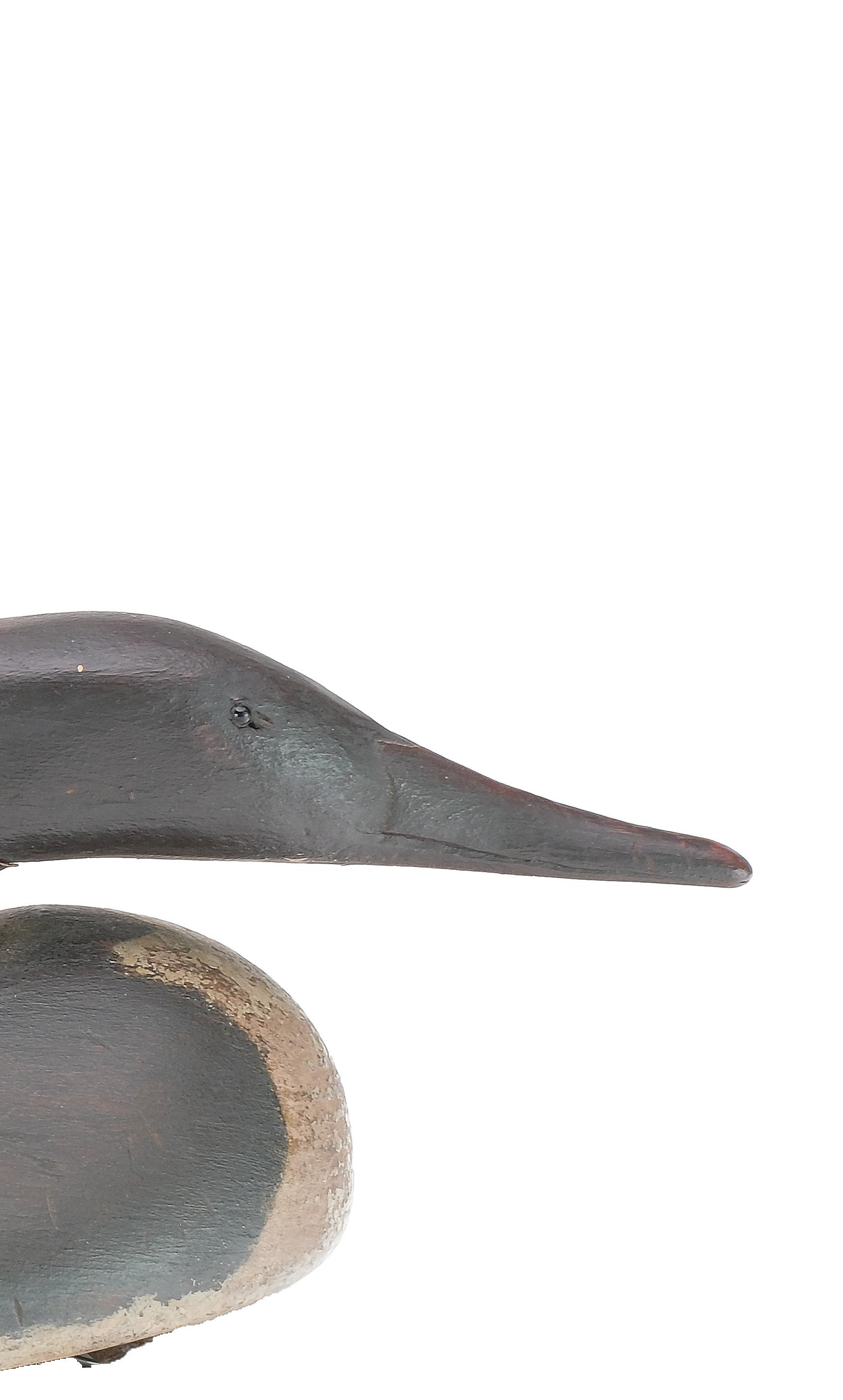
Literature: “Decoys of the mid-Atlantic region”, Henry A. Fleckenstein Jr, page 68, exact pair pictured.

75
(12,000 - 18,000)
It is said the the decoys made for hunting ducks on the Delaware River needed to be superbly realistic because of the style of hunting. Named “scull hunting” after the type of boat used, it originated because hunters recognized that ducks found safety by gathering into large groups, called “rafts.” These birds were simply reverting back to their nesting ground habits by practicing safety in numbers. A scull hunter sets a rig of decoys, then rows his boat upstream. The birds eventually settle in with the decoys. After the hunter feels there are enough ducks in with the decoys, he guides his boat downstream to surprise the awaiting quarry. Delaware River hunters went to great lengths to make realistic decoys so the ducks would feel comfortable among the wooden counterfeiters, until the hunter was within range.

76
93 Rare pair of widgeon by a member of the English family, Florence, New Jersey, 1st quarter 20th century. Hollow carved with raised V wingtips and incised tail feather carving. “DSC” stamped in the underside for the collection of David Campbell. Measure 15” long. Original paint with moderate wear under a thin coat of varnish that has darkened with age; minor roughness on tip of hen’s tail and bill tip. (8,000 - 12,000)


77
Jess Heisler was an avid hunter and competitive trap shooter who was a very talented craftsman. He enjoyed restoring antique furniture for the well healed patrons of Burlington, New Jersey and excelled at boat building and creating effective hunting decoys. His decoys were influenced by the English family of Florence and are some of the most refined carvings of the Delaware River tradition.


78
94 Mallard, Jess Heisler, Burlington, New Jersey, 2nd quarter 20th century. Hollow carved with raised V wingtips and relief tail feather carving. Measures 17” long. Original paint with very minor wear; some roughness on one side of tail. (5,000 - 8,000)
Joe was born in Fallsington, PA to J Milner and Mabel King but the family soon moved to Bristol. In 1925, he married his wife Emma and the couple set up housekeeping in Edgely. By at least 1930, he listed his occupation as “electrician” and, by 1940 he described himself as a “bill collector”. At that time he was working for the Pennsylvania Electric Co and was responsible for tracking down customers who were delinquent in paying their bills. He held that position until he retired in 1971 and left for Idaho where he continued to hunt and fish with his son, Joe Jr. Always a lover of horses, while in the west, he participated in a number of old west ‘roundups’. He is buried in the Bristol Cemetery in Bristol, PA.
Always an avid outdoorsman, he was a long time upland and large game hunter but did not begin waterfowling until 1939 when he designed and carved his first rig of
decoys. By 1941 he had built his own boat and had teamed up with noted carver Bill Quinn. The pair would carve together and ply the waters of the Delaware until Joe left to serve in WWII. His decoys closely follow the traditional style as developed on his section of the river and are obviously influenced by the work of John English. He apparently only carved for his own use and his output was extremely limited. Author Allen Linkchorst estimates his total production at only 57 decoys, a few of which were made purely as decoratives. All of his work was of the very highest quality, and has been described as “crisp and animated” with paint that is “subtle yet exacting” Others have defined his efforts as “streamlined” yet “delicate and sculptured”. He must be considered one of the finest of the Delaware River carvers.
95 Black duck, Joseph King, Edgely, Pennsylvania, 1st quarter 20th century. Hollow carved in tucked head pose with raised V wingtips and incised tail feather carving. Maker’s name was stamped in to underside of weight. Measures 15.5” long. Original paint with very minor wear; tiny chip in one side of bill tip; square wooden patch on one side of breast from when the decoy was made. (8,000 - 12,000)

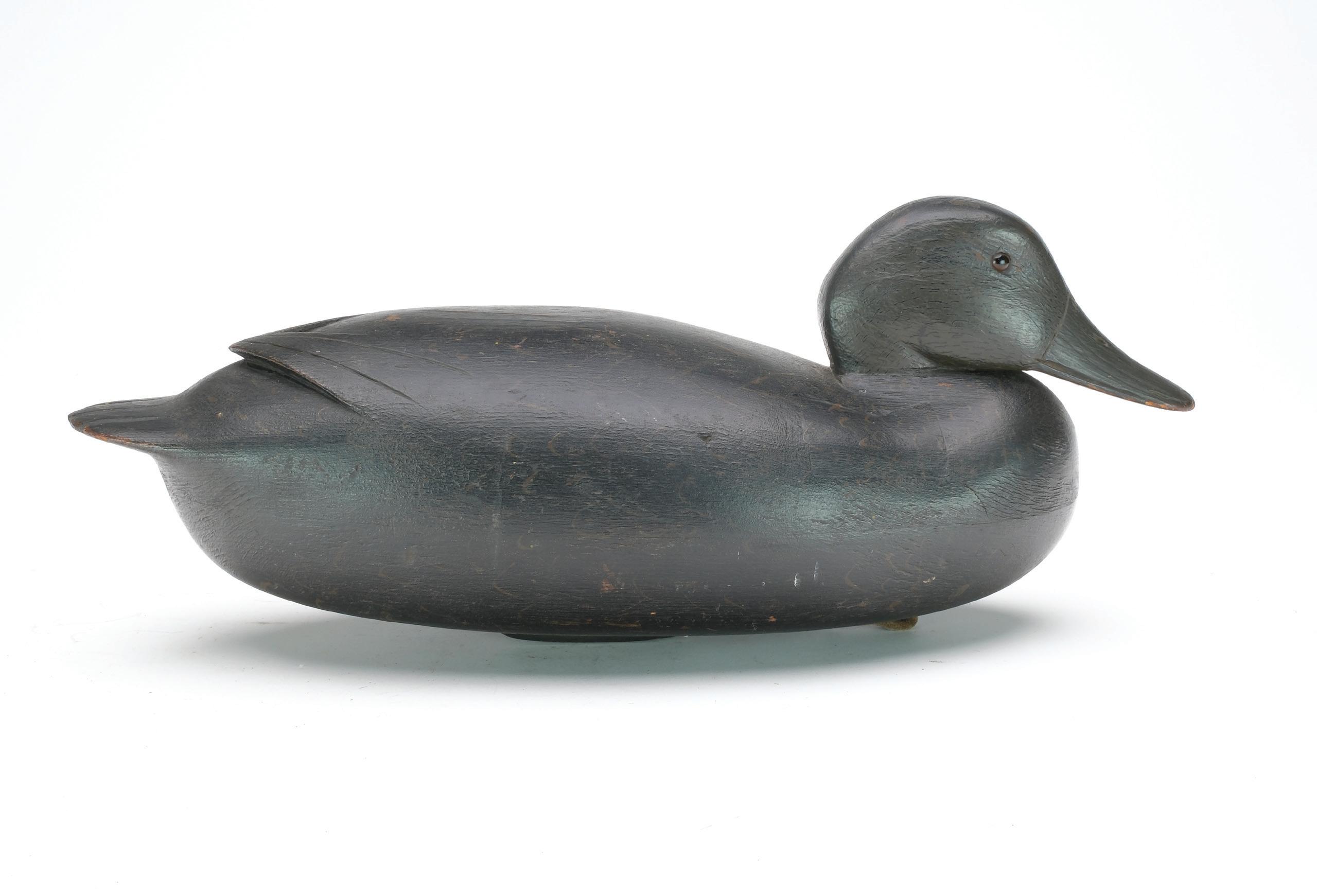
96
Rare English/Dawson pintail hen, John English, Florence New Jersey, last quarter 19th century. Hollow carved with raised ‘V’ wing tips, tack eyes, and relief tail feather carving. Carved by John English of Florence, New Jersey and painted by John Dawson of Trenton, New Jersey. Believed to be one of two English pintail hens in John Dawson paint. Measures 14.5” long. In use repaint by Dawson with very minor wear; very minor roughness on tip of tail, otherwise excellent structurally.

Provenance: Ex William J. Mackey Jr. collection. Ex Bob White collection. Ex Jim and Pat Doherty collection. Doherty collection sticker on underside. (10,000 - 15,000)

97 Very rare bufflehead, Florence, New Jersey, last quarter 19th century. Solid body with tack eyes. Very similar in style to the English family. Measures 11” long. Very dry original paint with minor to moderate wear; tight paint shrinkage on breast; small chip in one tail feather; tight drying crack along the underside; 1” dent on each side of body; the bill is a very well done replacement.



(1,200 - 1,800)
(3,000 - 5,000)
wear; minor separation at a knot on one side, otherwise very good structurally.
(600 - 900)
81
98 Widgeon, John Blair, Jr., Philadelphia, Pennsylvania, circa 1930. Hollow carved with slightly forward head pose. Measures 13.5” long. Paint is an excellent professional restoration in the Blair style, done to look older; hairline crack through neck; very minor separation at body seam.
99 Oversize canvasback hen, Charles Black, Bordentown, New Jersey. Hollow carved with raised “V” wingtip carving. Head is reared back on an angled neck seat. The body is very similar to the work of John Dawson. Measures 19.5” long. Original paint with minor flaking and
97 98 99
Elmer Crowell
1862 - 1952 | East Harwich, Massachusetts
100 Exceedingly rare working scoter, Elmer Crowell, East Harwich, Massachusetts, circa 1915. With Crowell’s oval brand in the underside, also branded “CM” for friend, Clem Mayo of Orleans, Massachusetts. Very slightly lifted head. Measures 18” long. Excellent original paint with only a few tiny flakes; structurally excellent.

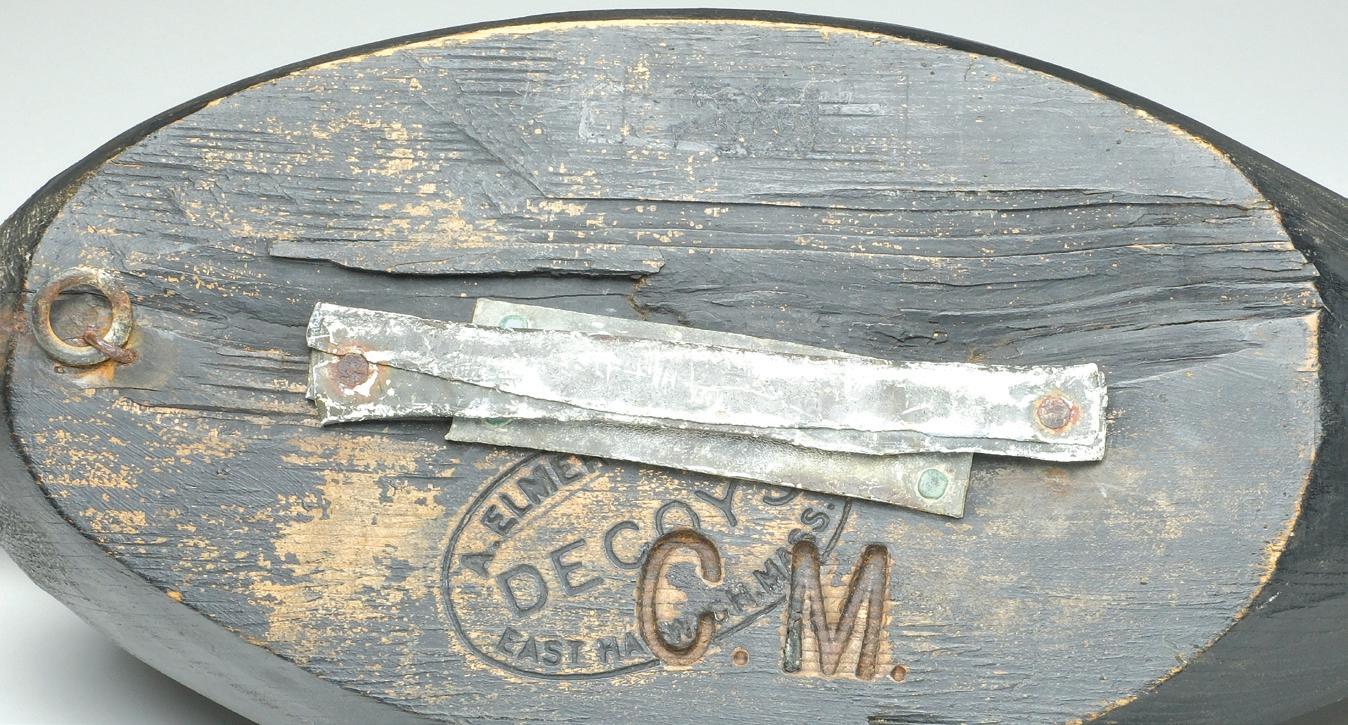
Literature: “Songless Aviary,” Brian Cullity. (20,000 - 30,000)

82

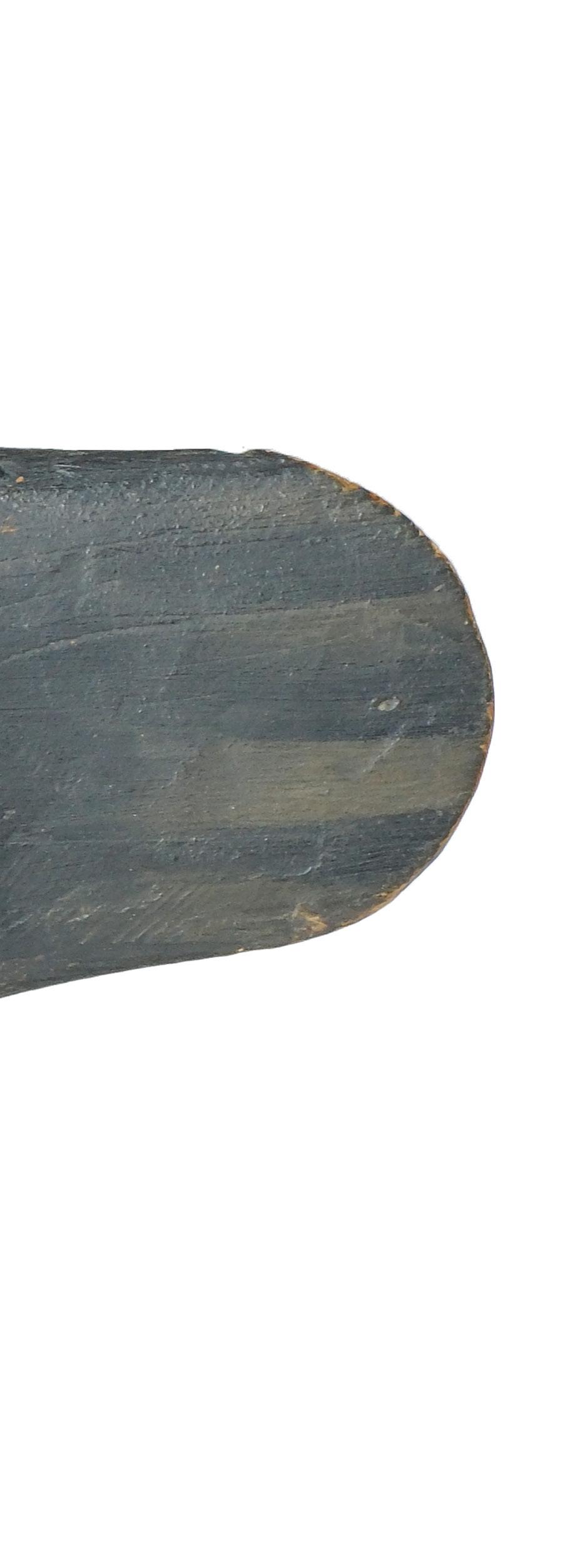




101
101 Swimming merganser hen, Elmer Crowell, East Harwich, Massachusetts. In swimming pose with relief tail feather carving and tack eyes. Maker’s oval brand on the underside. Also branded “Q” for the Quandy collection. Measures 19.5” long. Original paint with minor flaking and wear; hairline crack along one side from when the decoy was made; head was professionally tightened to body with ring of touchup at neck seat. (10,000 - 15,000)
102 Mallard, Elmer Crowell, East Harwich, Massachusetts, 1st quarter 20th century. From Westport, Massachusetts, found near the Pequaw Honk Club. Never before offered for public sale. Oval brand with slightly turned head and relief tail feather carving. Decoy was never rigged or weighted. Measures 17” long. Original paint that has darkened slightly under an early coat of varnish; scattered paint rubs; 3” narrow dent in one side; fine hairline cracks from when the decoy was made.


(6,000 - 9,000)

85
(4,000 - 6,000)
103 Early redhead hen, Elmer Crowell, East Harwich, Massachusetts. Pre brand model with slightly turned head and relief tail feather carving. “Q” branded on the underside for the Quandy collection. Measures 13.75” long. Original paint with minor to moderate wear; remnants of old newspaper were stuck to the underside and a few spots on body with an early varnish layer added over.
104 Bluebill, Elmer Crowell, East Harwich, Massachusetts. Decorative gunning style bird with two round inlayed weights on the underside. Maker’s rectangle stamp on the underside. Head is tucked and turned 30 degrees. Measures 13” long. Original paint with very minor flaking and wear; very good structurally.
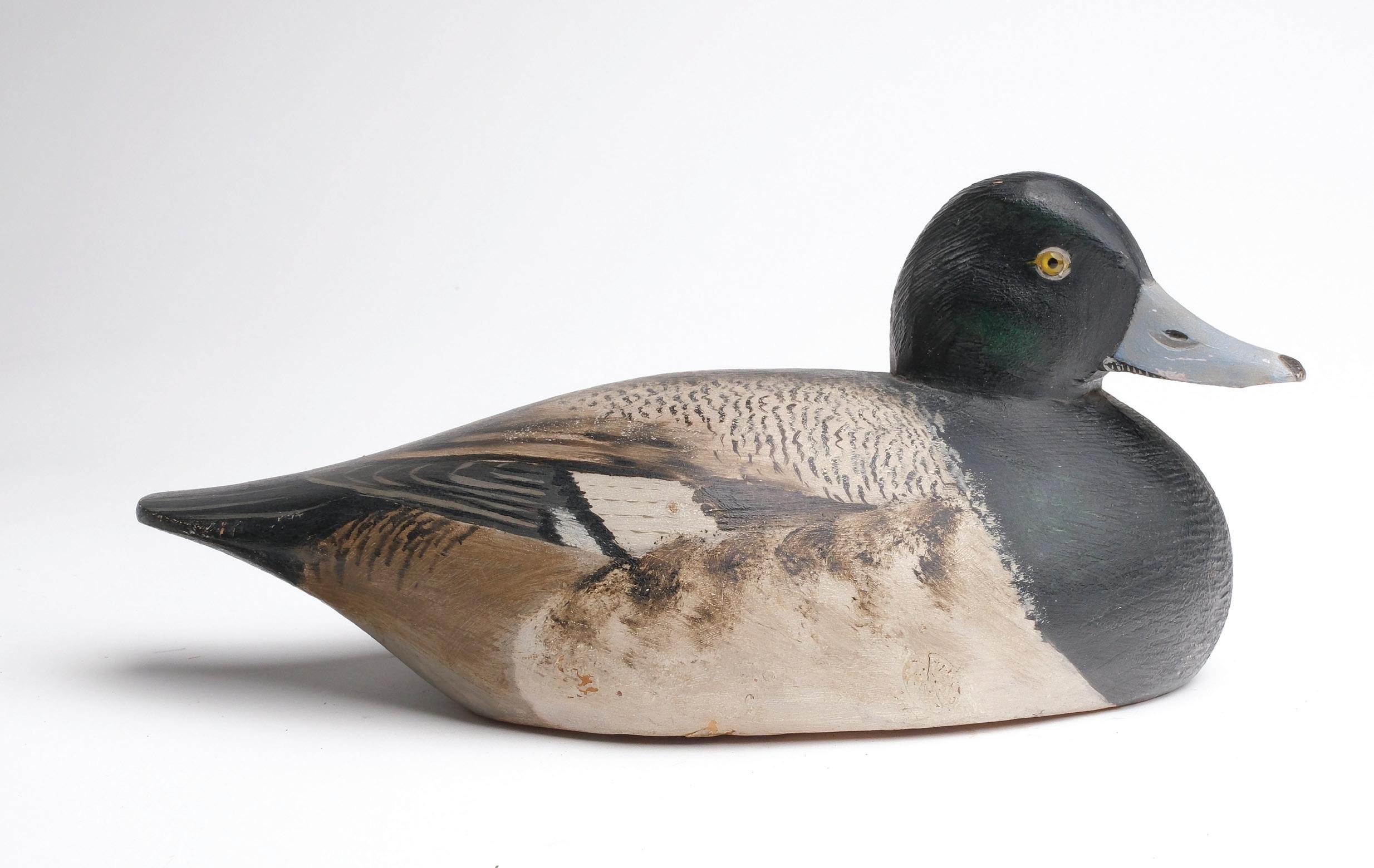
(2,500 - 3,500)

103 104
105 Pair of decorative bluebills with chicks, Elmer Crowell, East Harwich, Massachusetts, 2nd quarter 20th century. A special-order family of bluebills. Drake and hen are 2/3 size, measures 10.5” in length. Both are stamped and signed “AE Crowell” on underside in Crowell’s pen and ink. Both have turned heads. Both are in original paint and have similar cracks in necks; hen has a few small spots of flaking at top of head and a small piece of wood missing near crack in neck. Three small ducklings, are the only ducklings we have ever seen by Crowell. Each is signed “AE Crowell maker Cape Cod” on underside. Measure 4.5” long. All three are in original paint wth just a tiny amount of wear at tips of bills.

Provenance: Colby Atwood’s grandparents, John and Eugenia Atwood, were wealthy patrons of the arts who lived in Philadelphia, Pennsylvania but also had connections to the Seattle, Washington, art scene. (Eugenia’s brother was the founder of the Seattle Art Museum, to which Eugenia generously donated some of her collection.) The Atwoods regularly summered in the Chatham area of Cape Cod, beginning in 1936, building a “cottage” there in 1940. By decent in the Atwood family. (8,000 - 12,000)
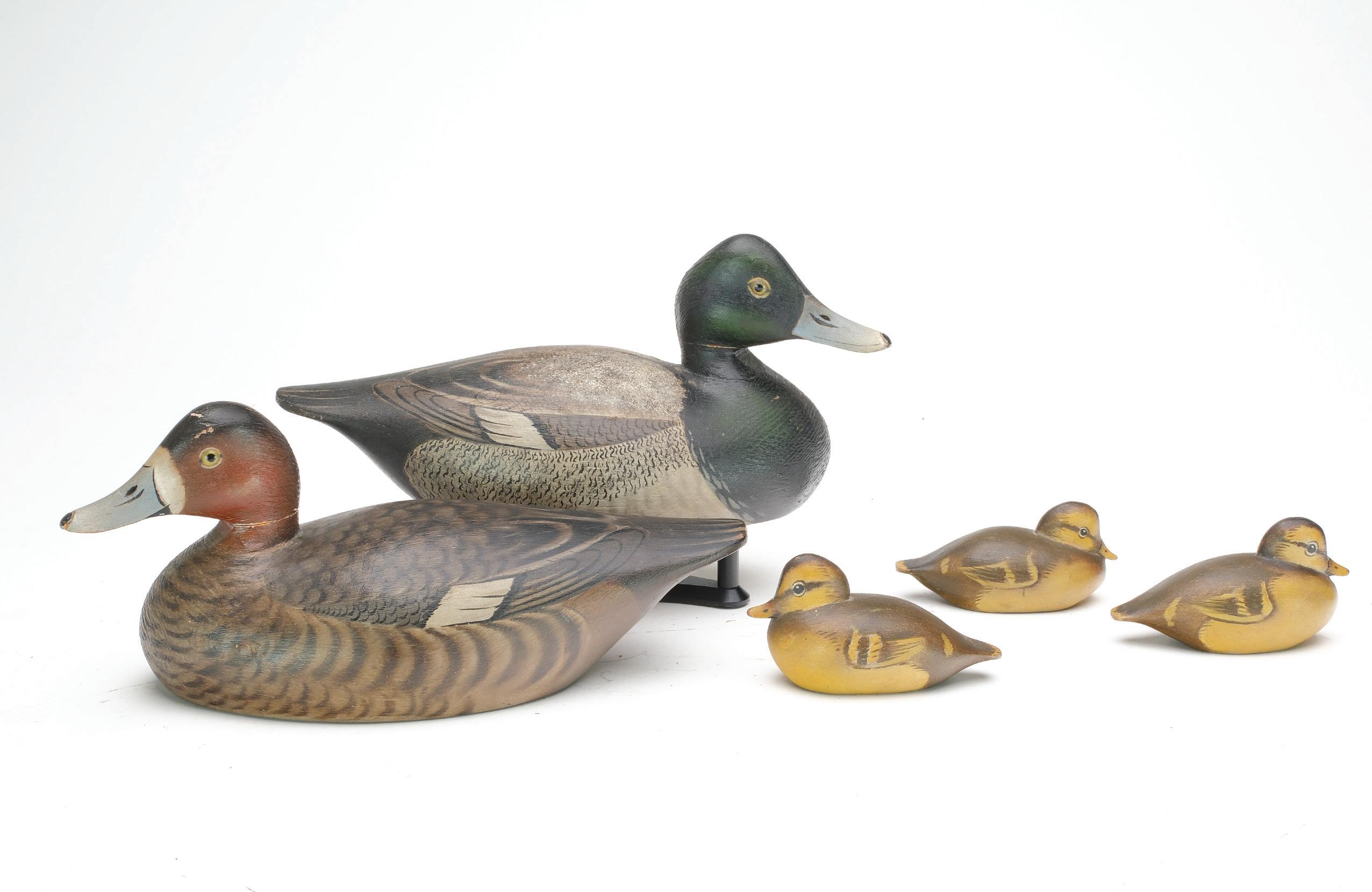
87
Davenport West was born in Galveston, Texas and graduated with his medical degree from Princeton University, class of 1905. Upon graduation he moved to New York City where he became a staff physician at the Rooselelt Hospital (now part of Mt Sinai hospital) at West 59th St.
In 1917, he married Dorothy Phelps of New Jersey, whose father was a wealthy banker. Financially, Mr West was very successful, always enjoying the services of up to three domestics at his home in Manhatten. He and his wife often traveled abroad, always in first class. It is not known if he was ever a sportsman, or if he and his wife simply enjoyed wildlife, the only vague clue being their four month stay in Capetown, South Africa in 1956. Dr West died on a trip to the Bahamas and is buried in Simsbury, CT.

We do not know how or when Mr and Mrs West became aware of Elmer Crowell. One reference indicates that, at some point, the doctor and his wife maintained a summer home in Harwichport and that his son, Davenport Jr and his wife, traveled there in 1947 on their honeymoon.




What we do know is that the couple greatly admired the work of Elmer Crowell, placing numerous orders with him over a number of years, and amassing one of the finer private collections of his decorative, life size, songbirds. His name can now be added to the growing list of wealthy patrons that allowed Crowell to flourish at his art.
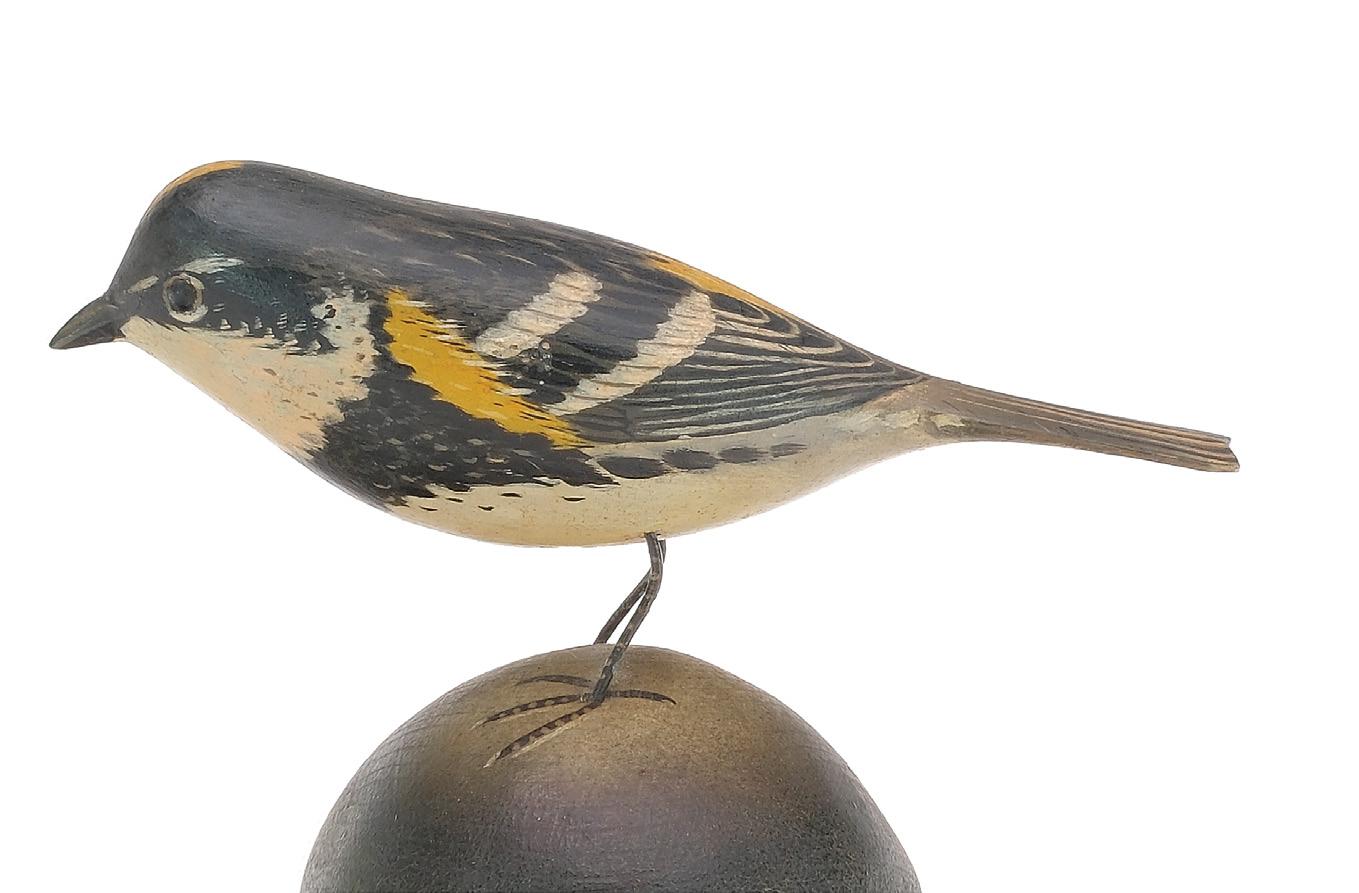



88
Dr.
| 1882 – 1960 | New York, NY
Davenport Atchison West
Dr. Davenport West Mrs. Dorothy Phelps West
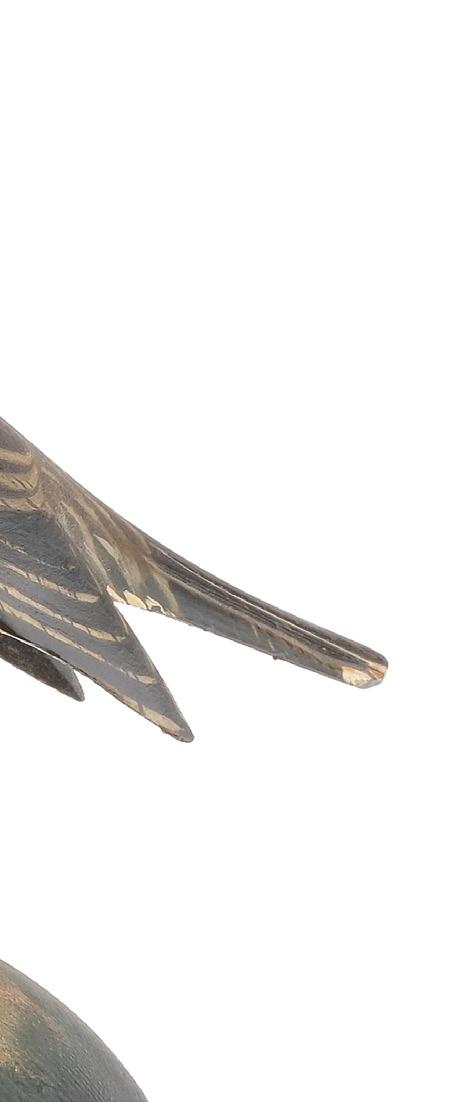


89
105a Full size Baltimore oriole, Elmer Crowell, East Harwich, Massachusetts. Mounted on carved wooden base bearing Crowell’s oval hot brand and also signed by maker on underside. Dropped tail with excellent paint execution. Stands almost 5” tall. Excellent and original. (6,000 - 9,000)
105b Full size Myrtle warbler, Elmer Crowell, East Harwich, Massachusetts. Signed on underside and retains a well executed image of one of Crowell’s rarer ink stamps, reading “A.E. Crowell maker high class decoys”. Mounted on carved dome shaped base with wire legs. Stands 3.5” tall. Very good and excellent. (5,000 - 8,000)
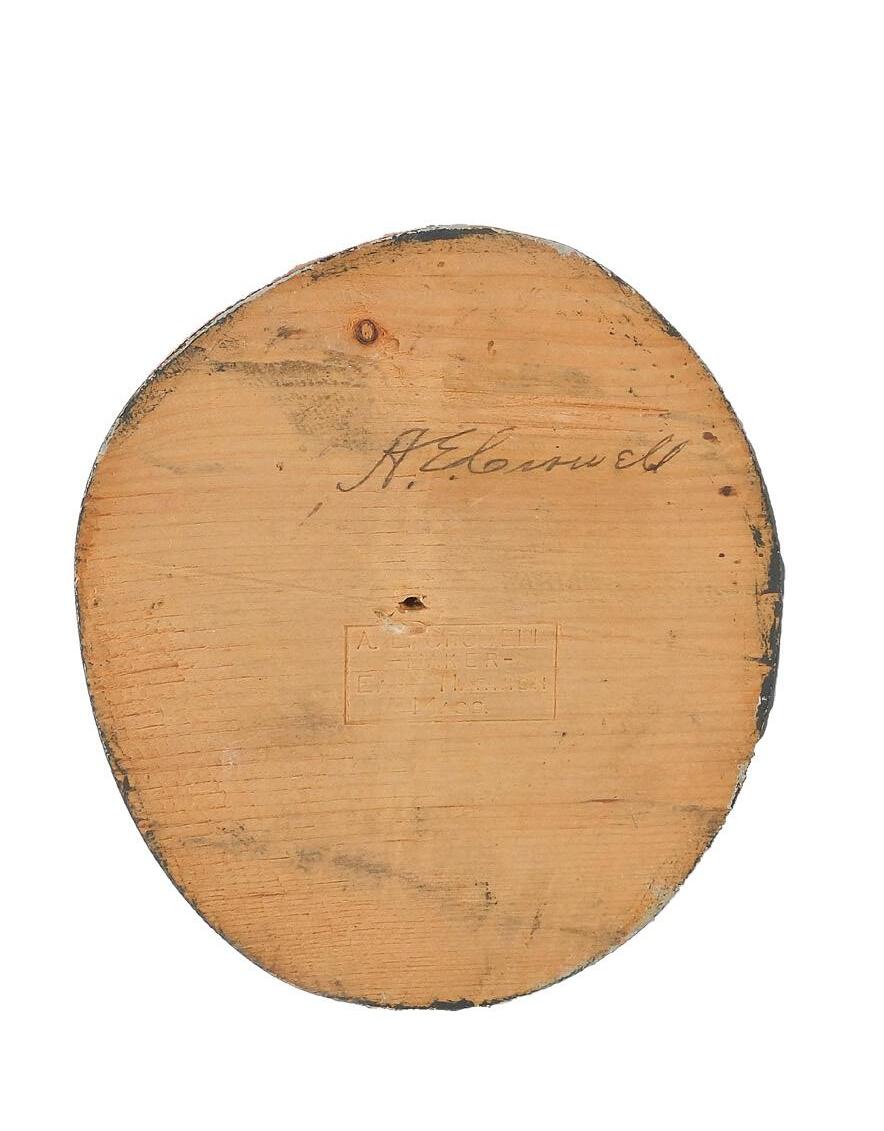


105c Full size robin, Elmer Crowell, East Harwich, Massachusetts. Retains Crowell’s rectangular stamp, as well as ink signature. Full size with feet staggered as if walking. Wingtips are dropped, tail is carved. Stands 6” tall. Strong original paint with a very tiny spot of inpainting at the tip of the bill where the bill meets the face; and a spot at each thigh where cracked putty was replaced; restoration to one rear toe. (5,000 - 8,000)

90
105b
105c
105d Full size cardinal, Elmer Crowell, East Harwich, Massachusetts. Retains Crowell’s rectangular stamp as well as ink signature, “Maker Cape Cod” and dated 1944. Wire legs on chip carved base with dropped wingtips. Raised carved tail and alert crest. 5” tall. Strong original paint with minor crazing to areas of base. (6,000 - 9,000)
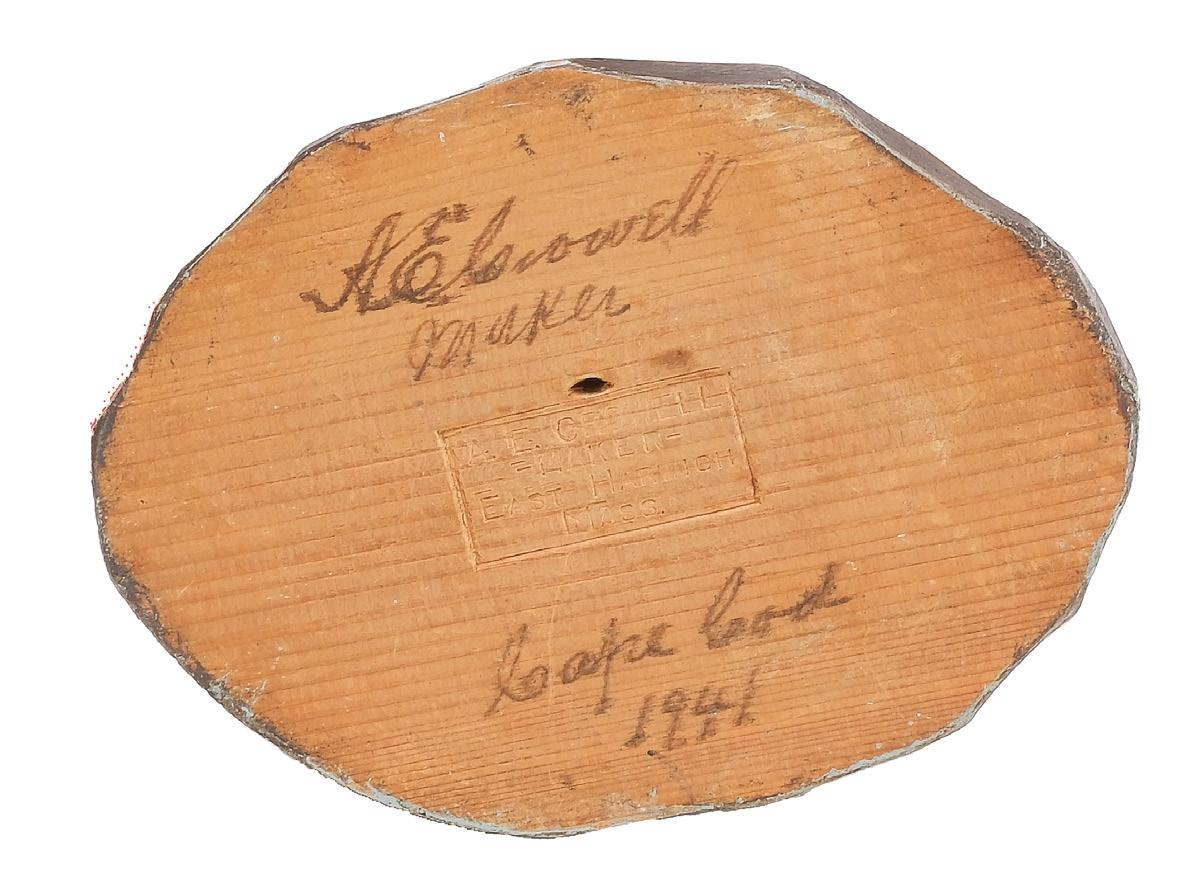

91
106 Canada goose, Elmer Crowell, East Harwich, Massachusetts, 1st quarter 20th century. Maker’s oval brand on the underside, with a stick up hole drilled through the center. “R.A. Nickerson” branded twice on the underside. Measures 22.5” long. Mix of original paint and early working repaint by Crowell; professional tail and neck repair; drying split along the underside.


92
(3,000 - 5,000)
107
Oversize black duck, Elmer Crowell, East Harwich, Massachusetts. Maker’s oval brand is partially visible under a flat pad weight. “BRR Gun Club” carved in one lower side. Measures 20” long. Original paint with moderate gunning wear under a thick coat of varnish; drying cracks running the length of the body; slight separation at neck seat; minor chip on tip of tail; a small hole at the center of back from when the decoy was mounted as a lamp has been plugged and touched up.
(2,000 - 3,000)
108 Two Canada goose heads, Elmer Crowell, East Harwich, Massachusetts. Standard size heads with large tack eyes and detailed bill carving. Stand 6.5” tall. Original paint with minor wear; tiny chip in one bill; area of discoloration to one side of one head.

(600 - 900)
109 Mallard hen, Elmer Crowell, East Harwich, Massachusetts, circa 1900. An early prebrand example, with turned head and glass eyes. Measures 16.5” long. Original paint that has flaked and crazed to expose a gray primer coat or bare wood in approximately 30% of the body; two small drips of white paint on one side of breast; rough area at side of tail; a few small scratches.


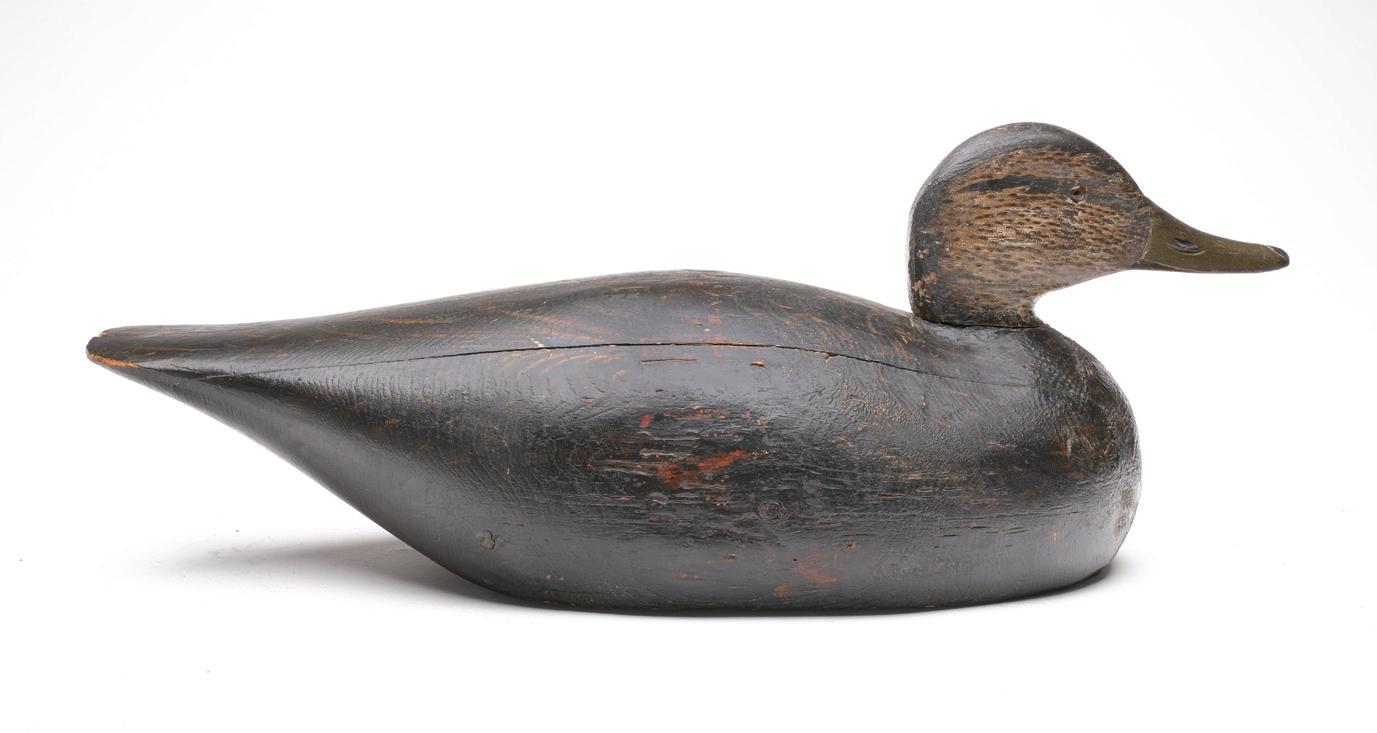
(1,800 - 2,500)
110 Pintail hen bust, Elmer Crowell, East Harwich, Massachusetts. Excellent feather blending and bill carving. Mounted to a modern wooden base. Head measures 6.25” long. Small paint flake above filler at one eye, otherwise excellent.
(1,200 - 1,500)
93
107 109 108 110
111 1/3 size flying merganser, Elmer Crowell, East Harwich, Massachusetts. Mounted to a wood backboard purportedly painted by Crowell. Merganser measures 7.25” long, contemporary frame measures 18” across. Original paint with a few minor rubs; chip in tip and one edge of applied wing was professionally restored.
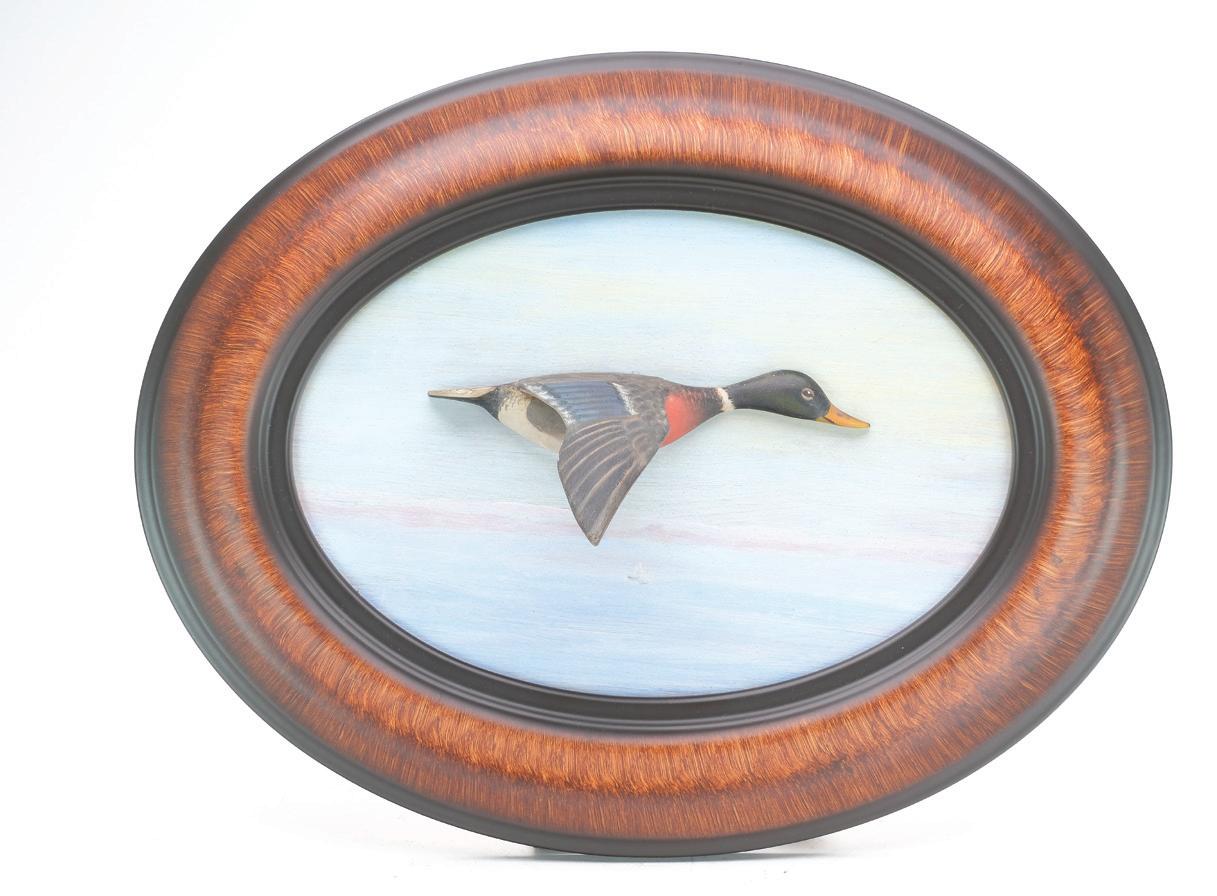

Provenance: David Fannon collection. (1,000 - 1,500)
112 1/3 size flying mallard, Elmer Crowell, East Harwich, Massachusetts. Mounted to a wooden backboard, purportedly painted by Crowell. Mallard measures 7.75” long, contemporary frame measures 18” across. Original paint with a few minor rubs; applied wing was professionally reset with touchup along the seam.
Provenance: David Fannon collection. (1,000 - 1,500)
113 Miniature black duck, Elmer Crowell, East Harwich, Massachusetts. In running pose with raised wingtips. Makers rectangle stamp on the underside, as well as the number 20 in pencil. Measures 6” long. Small spots of touchup at chips in tip of raised wing and tail; small spot of touchup on underside of bill.

(1,000 - 1,500)
114 A pair of miniature flying mallards, Elmer Crowell, East Harwich, Massachusetts, 2nd quarter 20th century. A gift from Crowell to a member of the Pequaw Honk club in Little Compton, Rhode Island. Drake is signed in Crowell’s hand on back. 4” long. Hen has tiny spots of inpainting at tail and tip of lifted wing. Drake has had the wing tightened and a small spot of paint restored on wing.
(2,000 - 2,500)

94
111 113 112 114
115 Miniature bluebill, Elmer Crowell, East Harwich, Massachusetts. Faintly signed on the underside. Raised wingtips. Measures 3.75” long. Original paint with moderate crazing on breast and tail area; surface has darkened slightly with age.



(800 - 1,200)
116 Men’s cufflink box decorated with a miniature mallard drake by Elmer Crowell. Box is 10” long. Crowell decoy is in original paint, but head has been broken off and reglued; small amount of wear at top of head.

Provenance: David Fannon collection. (400 - 600 )
117 Miniature goldeneye drake, Elmer Crowell, East Harwich, Massachusetts. Maker’s rectangle stamp on underside. 4.25” long. Almost insignificant small rub at tip of bill; otherwise excellent and original.
(1,200 - 1,500)
118 Early miniature pintail, Elmer Crowell, East Harwich, Massachusetts. Split tail and thin neck carving. White painted underside is unmarked. Measures 5” long. Original paint that has darkened with age; professional tail, bill, and neck crack repair. (800 - 1,000)
95
115 117 116 118
Contemporary Carvings

Frank Finney
b. 1947 | Cape Charles, Virginia
They always have been my favorite animal, as a boy, I trapped. It was always a fantasy to catch one, and I never did! I always saw their signs, but I never could hold them.
Back in the day there was only one buyer. When I was trapping I would always go to the location and look at the pelts hanging and was fascinated with them. The man’s name was Lee Dick Fisher and he would have hundreds of skinout animals, raccoons mostly, but also muskrat and mink. It was a fantasy world for a young man, my love of the outdoors, always intrigued, and possessed my life.
 - Frank Finney
- Frank Finney
119
Outstanding full size standing otter, Frank Finney, Cape Charles, Virginia. Thinly hollowed body and head. One arm is outstretched holding a turtle shell. Applied metal whiskers and detailed feet and hands. Maker’s initials on the underside of feet. Stands 29” tall, and measures 28” from tip of tail to front of left foot. Excellent and original.
(12,000 - 18,000)

97
119a Exceptional bird tree with flowering magnolias and three ruby throated hummingbirds, Frank Finney, Cape Charles, Virginia. Two males in flight with a female nestled in to a hummingbird nest created in the branch bend. Nest is complete with two eggs and is made with a light magnet so she is secure but removable in the nest. Each bird has glass eyes, carved wings and tail. Each leaf is individually carved and there are eight yellow flowered blooms. Tree is mounted to decorative chip carved base, and stands 25” tall. Excellent and original.
(10,000 - 15,000)

98

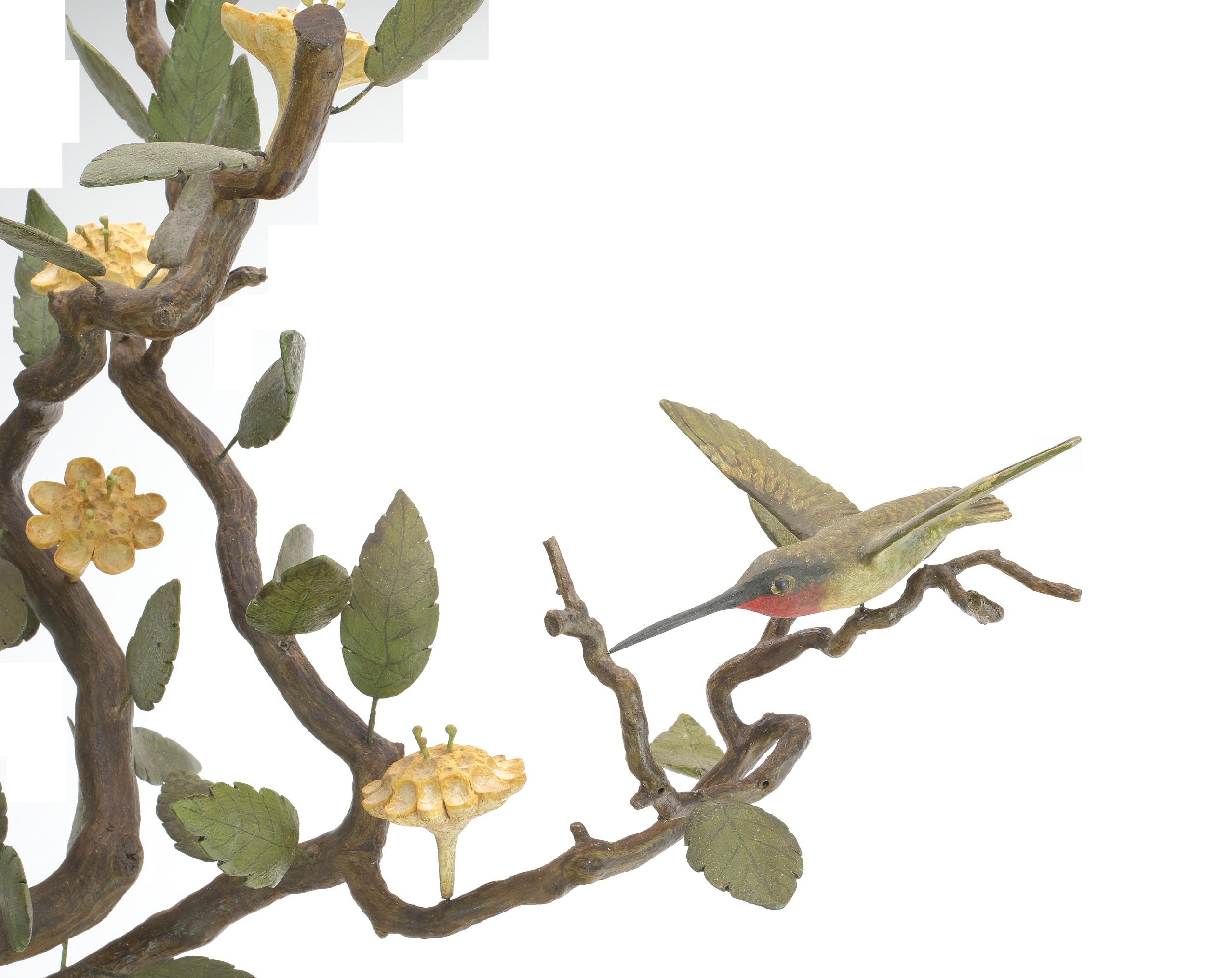
“Bering Sea” carved walking stick, Frank Finney, Cape Charles, Virginia. An outstanding folk carving with walrus and Inuit head carved at top. Narwhal and relief carved fishing hook. Measures 36.25” tall. Hairline crack on one side of walrus was filled and touched up by the artist after the varnish layer; otherwise excellent and original. (6,000 - 9,000)



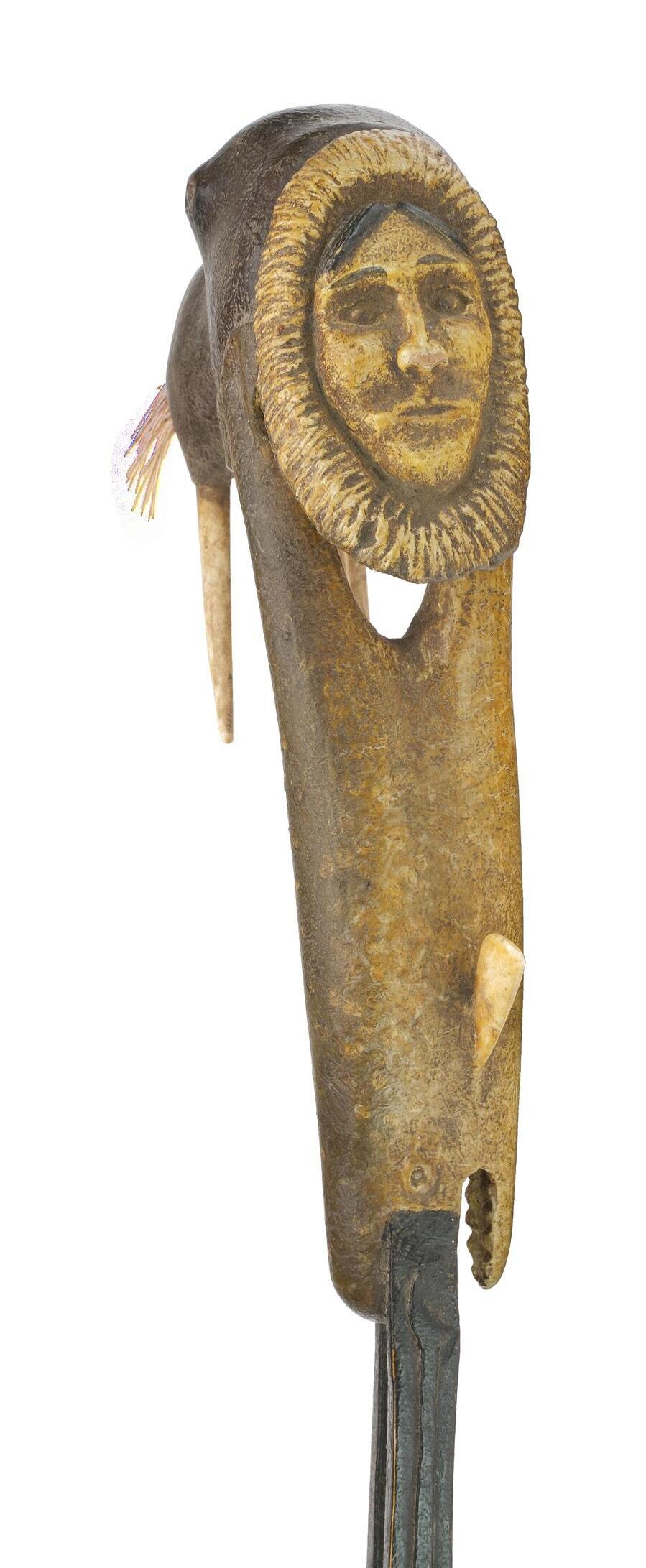
120
122 Excellent calling towhee, Frank Finney, Cape Charles, Virginia. Bird is standing on carved pineapple base with outstretched wings and upturned head with open beak. Relief wing and tail feather carving. Maker’s ink stamp on the underside of base. Towhee measures 8.5” long, piece measures 11.75” tall. Excellent and original. (2,000 - 3,000)
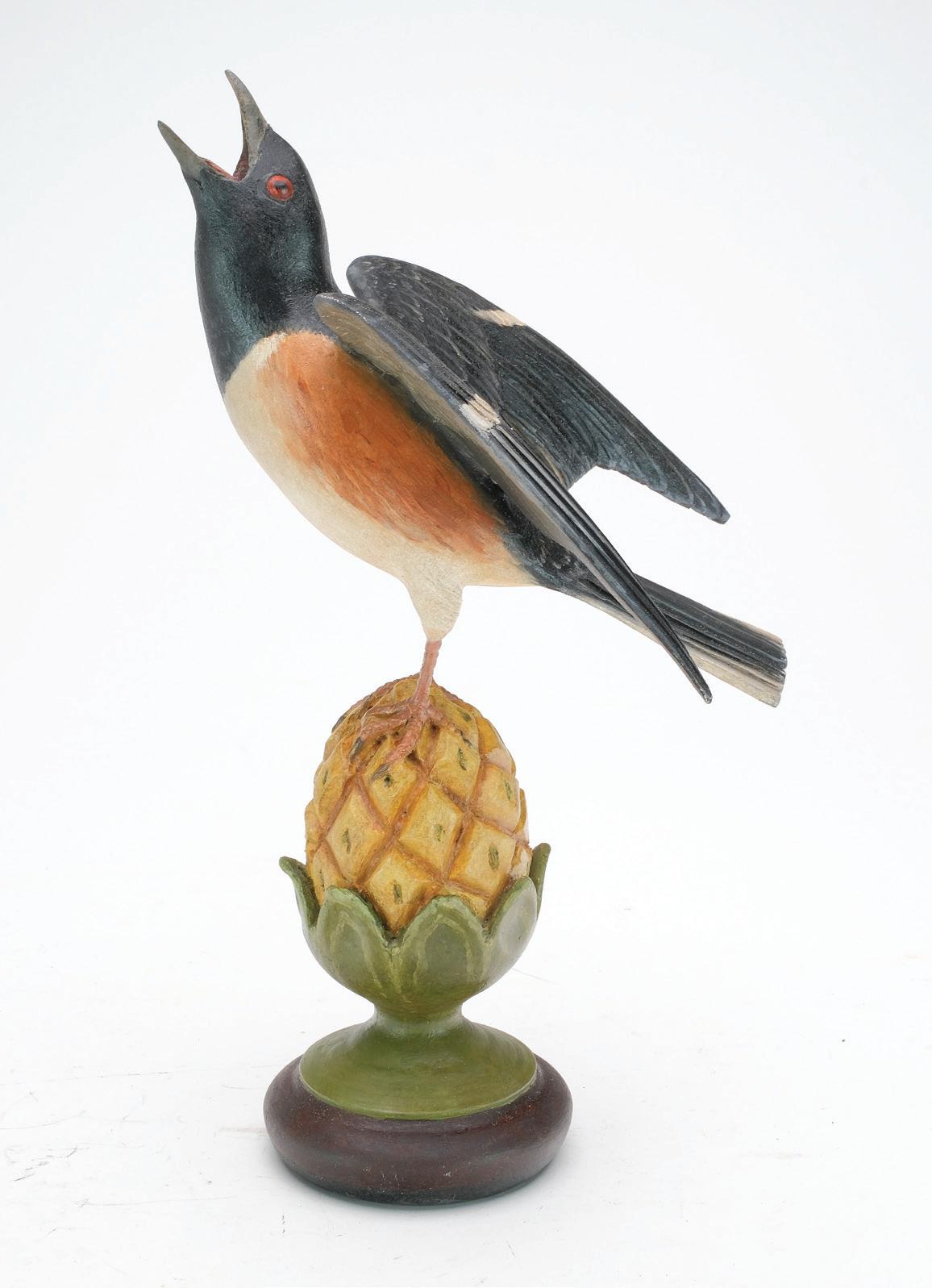
121 Full size standing chicken, Frank Finney, Cape Charles, Virginia. Slightly turned head with relief carved wattles. Relief wing and tail feather carving. Maker’s initials carved in to top of base. Stands 13.5” tall. Excellent and original. (4,000 - 6,000)

101 121 122
123 Miniature turkey, Frank Finney, Cape Charles, Virginia. An excellent carving with fat body, dropped wings, and fanned out tail. Applied paint bristle beard. Maker’s initials carved on the underside. Maker’s ink stamp also on the underside. Stands 5.25” tall including base. Excellent and original. (1,200 - 1,800)

124 Ladder-backed woodpecker, Frank Finney, Cape Charles, Virginia. Slightly turned head with open beak clutching a grub. Relief wing carving. Identified on the underside and the maker’s initials carved in to the underside. Measures 7.5” long, stands 4.5” tall including base. Excellent and original. (800 - 1,200)
125 Eastern meadowlark, Frank Finney, Cape Charles, Virginia. Calling pose, with open beak. Relief wing carving with raised wingtips. Maker’s initials carved on the underside. Measures 6.5” long, stands 3.75” tall including base. Excellent and original. (600 - 900)

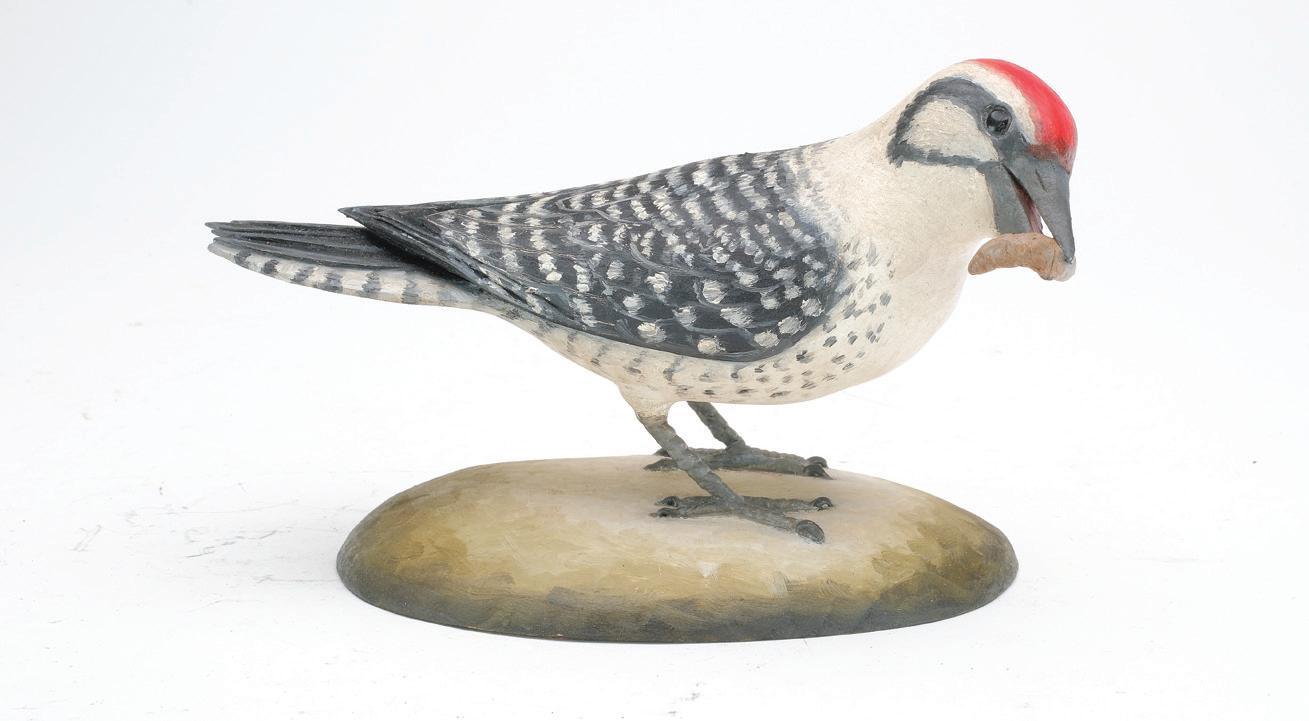
126 Miniature mourning dove, Frank Finney, Cape Charles, Virginia. Raised wingtips and relief tail feather carving. Maker’s initials carved in the underside. Measures 6.25” long, stands 3” including base. Excellent and original.
(300 - 500)

102
123 125 124 126
127 Miniature woodduck family diorama, Frank Finney, Cape Charles, Virginia. Hen and drake are standing on driftwood, with chicks swimming towards a dead dragonfly. One chick and the drake have open bills. One chick has one raised wing and head turned over back. Relief wing and tail feather carving. maker’s initials carved on the base. Entire piece measures 14.5” across, drake stands 6” tall including base. Excellent and original.
(1,000 - 1,500)
128 Miniature pair of pintails, Frank Finney, Cape Charles, Virginia. Hen in preening pose, with raised wingtips and relief feather carving. Drake in calling pose with both wings raised off of body. Maker’s initials carved on base. Entire piece measures 11.5” across, and 6.5” tall. Drake’s tail was broken off and reset, otherwise excellent and original. (1,200 - 1,800)

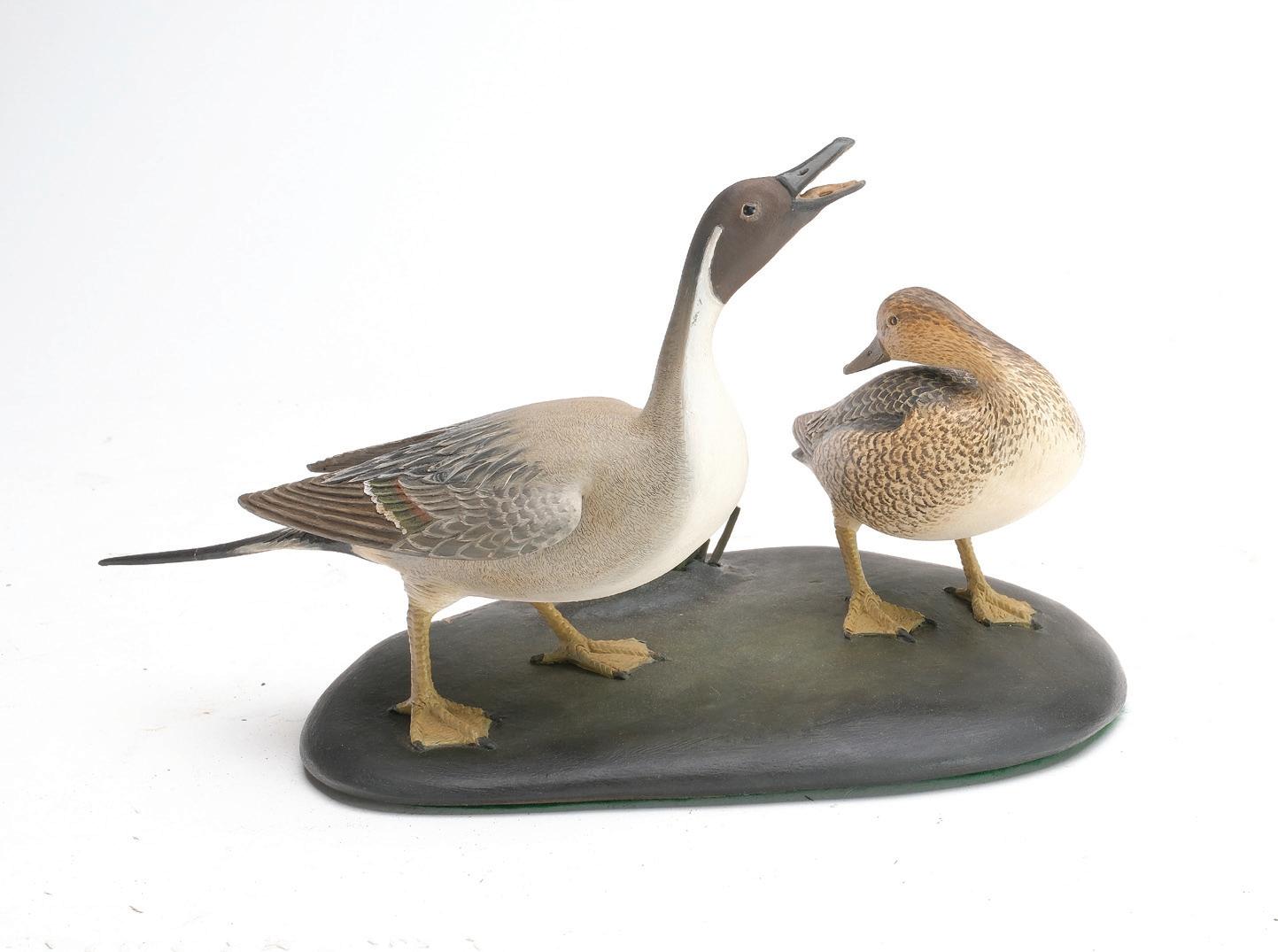
129 Pair of full-size canvasbacks, Frank Finney, Cape Charles, Virginia. Tucked heads with slight relief wing carving. Comb feather paint detail on back and sides. Maker’s initials carved in the underside. Measure 15.5” and 16.5” long. Excellent and original. (1,500 - 2,500)
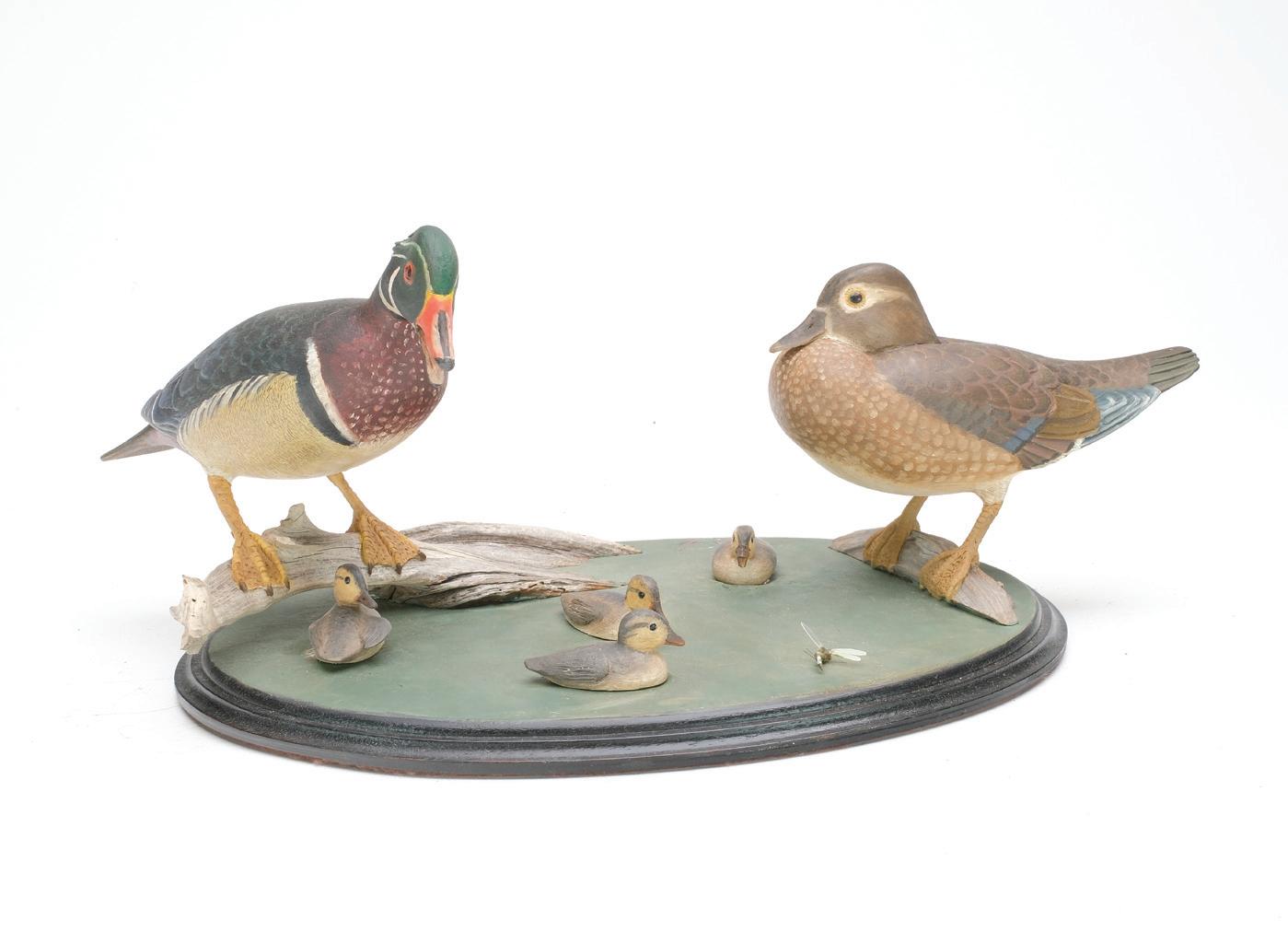
103
127 128 129
130
130 Sculptural swan, Frank Finney, Cape Charles, Virginia. Hollow carved with head pointed skyward in a drinking motion. Maker’s initials carved in the underside. Measures 34” from tail to breast, and 40” tall. A few minor dents and paint rubs, otherwise excellent and original.
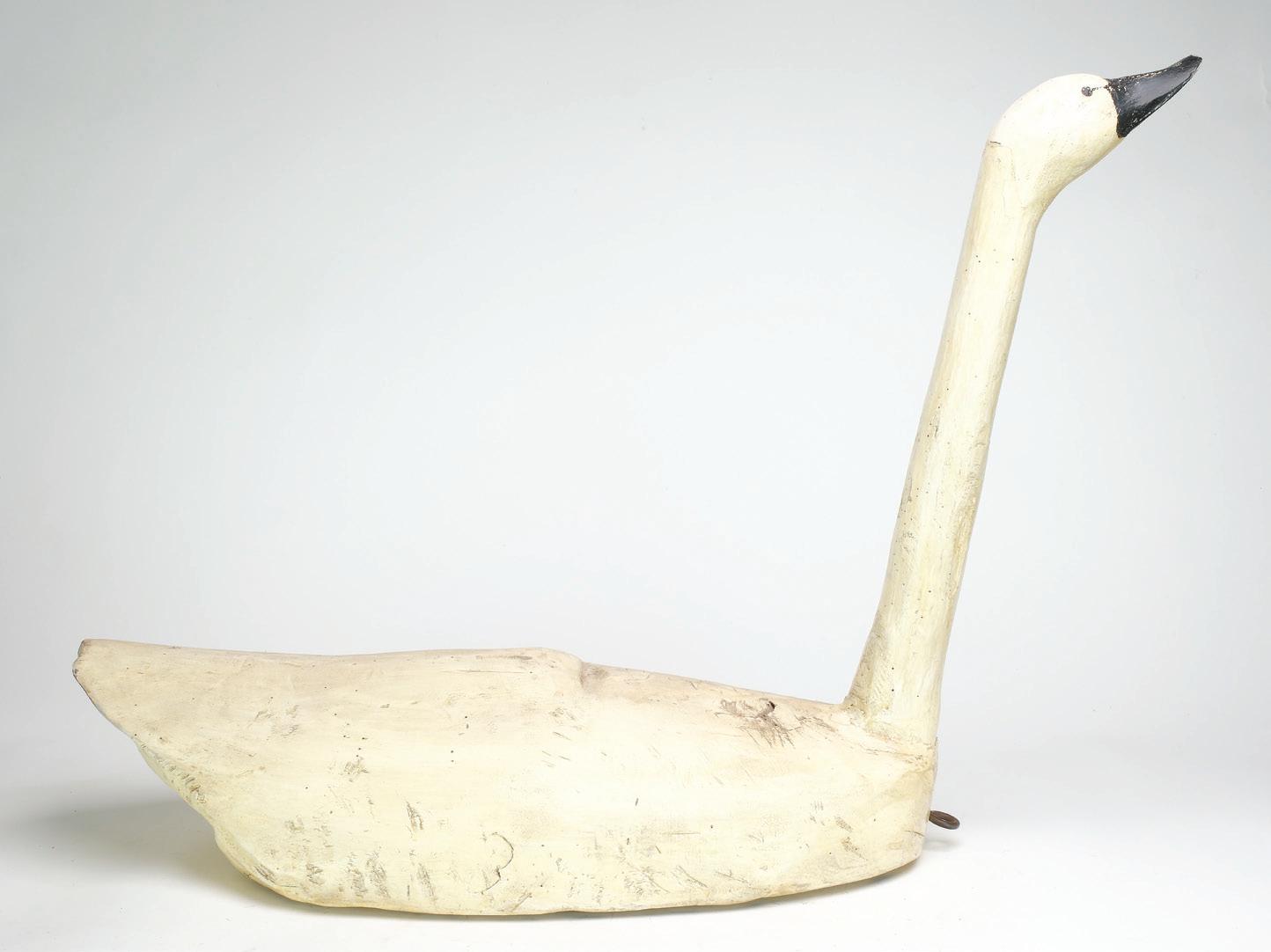
(2,500 - 3,500)
131 An early and large swan, Frank Finney, Cape Charles, Virginia. Probably made around 1970. An alert up looking head with a straight neck. Retains Charlie Hunter collection tag on underside. Measures 31” tall, and approximately 42” long. Original paint with shot scars; some wood imperfection and stress to create the appearance of age.

(800 - 1,200)
132 Large hollow carved Canada goose, Frank Finney, Cape Charles, Virginia. With Frank’s fancy “FF” carved in underside. Raised and separated wingtips with head that is slightly turned and cocked. Measures 39” long. Strong original paint that has crazed slightly at front of breast; some paint loss on underside from shelf wear; a couple very tiny rubs.

104
(2,000 - 4,000) 131 132
133 Eastern bluebird, Frank Finney, Cape Charles, Virginia. Raised wingtips and relief tail feather carving. Makers initials carved in the underside. Measures 5.5” long, stands 3.75” tall including base. Tiny paint rub on tip of bill, otherwise excellent and original. (300 - 500)

134 Rufous-sided towhee, Frank Finney, Cape Charles, Virginia. Raised wingtip and relief tail feather carving. Maker’s initials carved on the underside. Measures 6.75” long, stands 3.5” tall including base. Tiny paint rub on tip of bill, otherwise excellent and original. (300 - 500)

135 Miniature bluejay, Frank Finney, Cape Charles, Virginia. Raised wingtips and relief tail feather carving. Maker’s initials carved in the underside. Measures 5.5” long, stands 3.25” tall including base. Excellent and original. (300 - 500)

136 Miniature heron, Frank Finney, Cape Charles, Virginia. Carved from a single piece of English boxwood. Head is turned with extended crest and deep relief wing carving. Maker’s initials carved on the underside. Stands 8” tall. Excellent and original. (600 - 900)
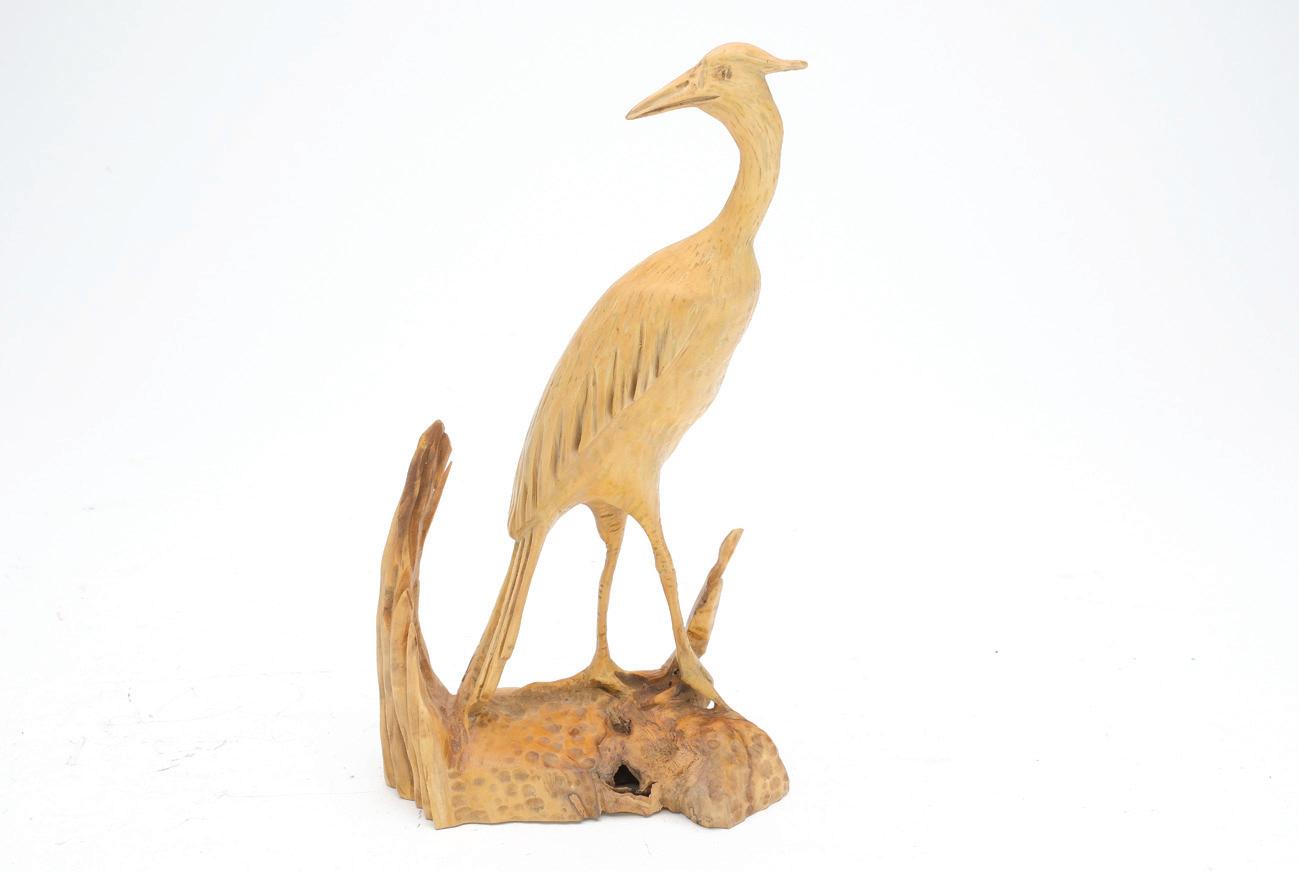
105
133 135 134 136
137 Diamondback terrapin, Eddie Wozny, Cambridge, Maryland. Turtle is walking with outstretched neck and head. Relief carved texturing on shell. Identified, signed, and dated 2016 on the underside. Measures 11.5” long. Excellent and original. (1,200 - 1,800)
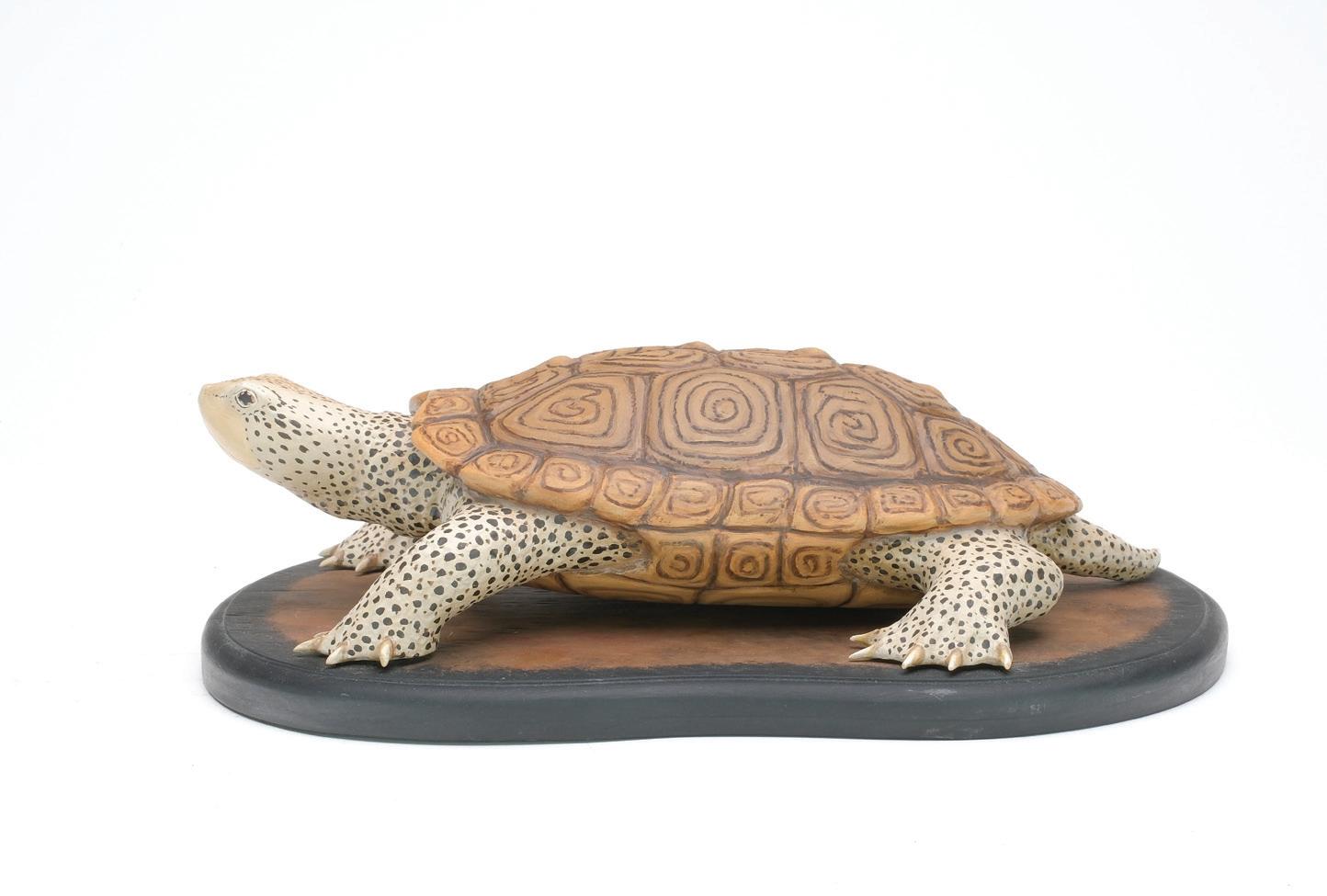
138 Eastern box turtle, Eddie Wozny, Cambridge, Maryland. Turtle is walking with outstretched neck and head. Relief carved texturing on shell and skin of turtle. Identified, signed, and dated 2011 on the underside. Measures 9.75” long. Excellent and original. (1,200 - 1,800)
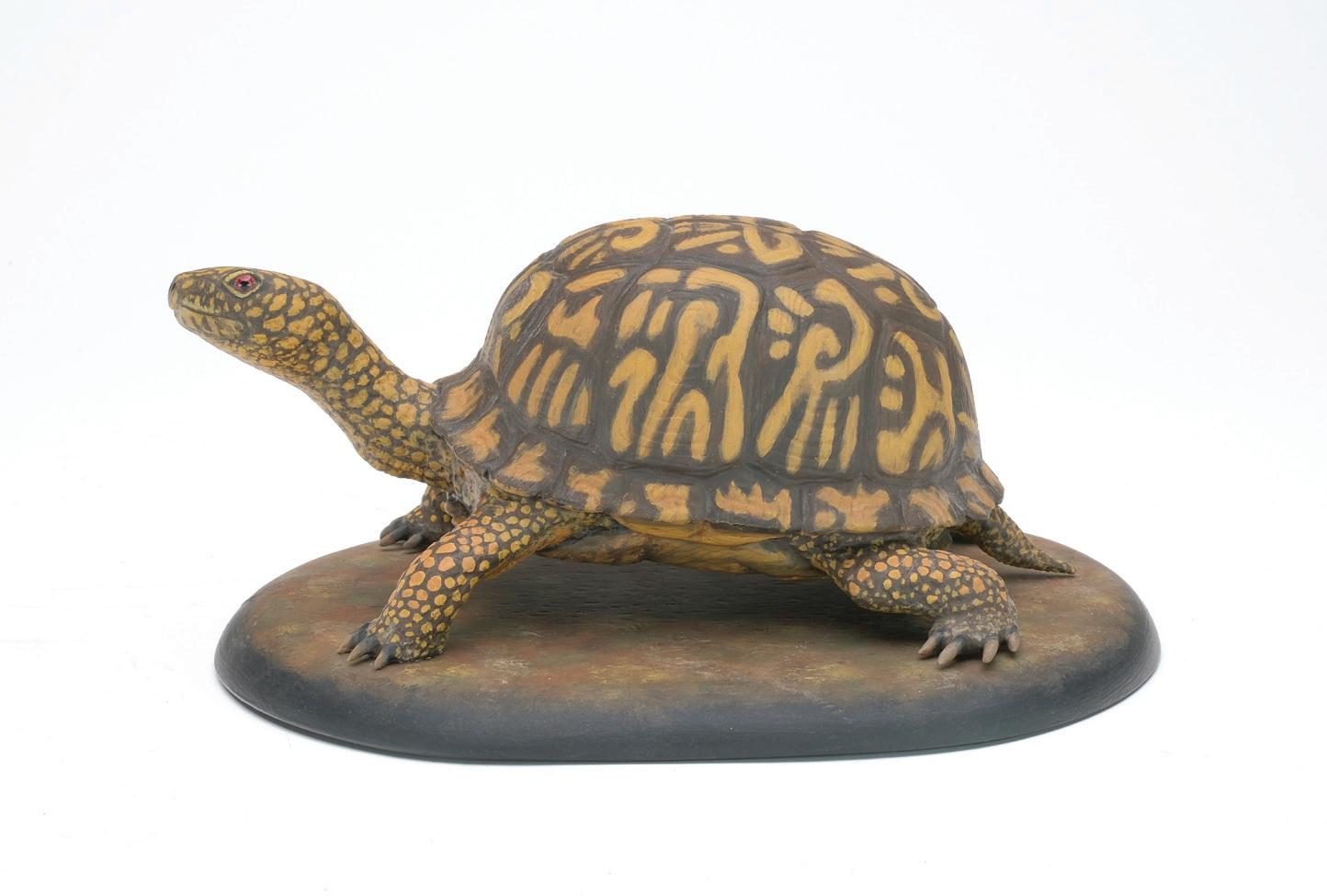
139 Miniature eastern painted turtle, Eddie Wozny, Cambridge, Maryland. Turtle is walking with outstretched head and neck. Identified, signed, and dated 2019 on the underside of base. Measures 5” long. Excellent and original. (1,200 - 1,800)

106
137 138 139
141 Miniature standing turkey, Marty Hanson, Hayward, Wisconsin. Head is reared back and tucked on to body. Dropped wings and fanned out tail. Inserted paint brush bristles for beard. “H” carved in the underside of base. Also signed on one edge of base. Measures 6” long, and stands 6” tall. Excellent and original. (1,500 - 2,500)

140 Excellent pair of ruddy ducks, Marty Hanson, Hayward, Wisconsin. Very thinly hollowed with thin bottom boards that are signed on the underside. Also with the maker’s initials carved on the underside. Drake in preening pose, and hen with slightly turned head. Relief wing and tail feather carving. Measure 9.25” long. Excellent and original. (3,000 - 4,000)
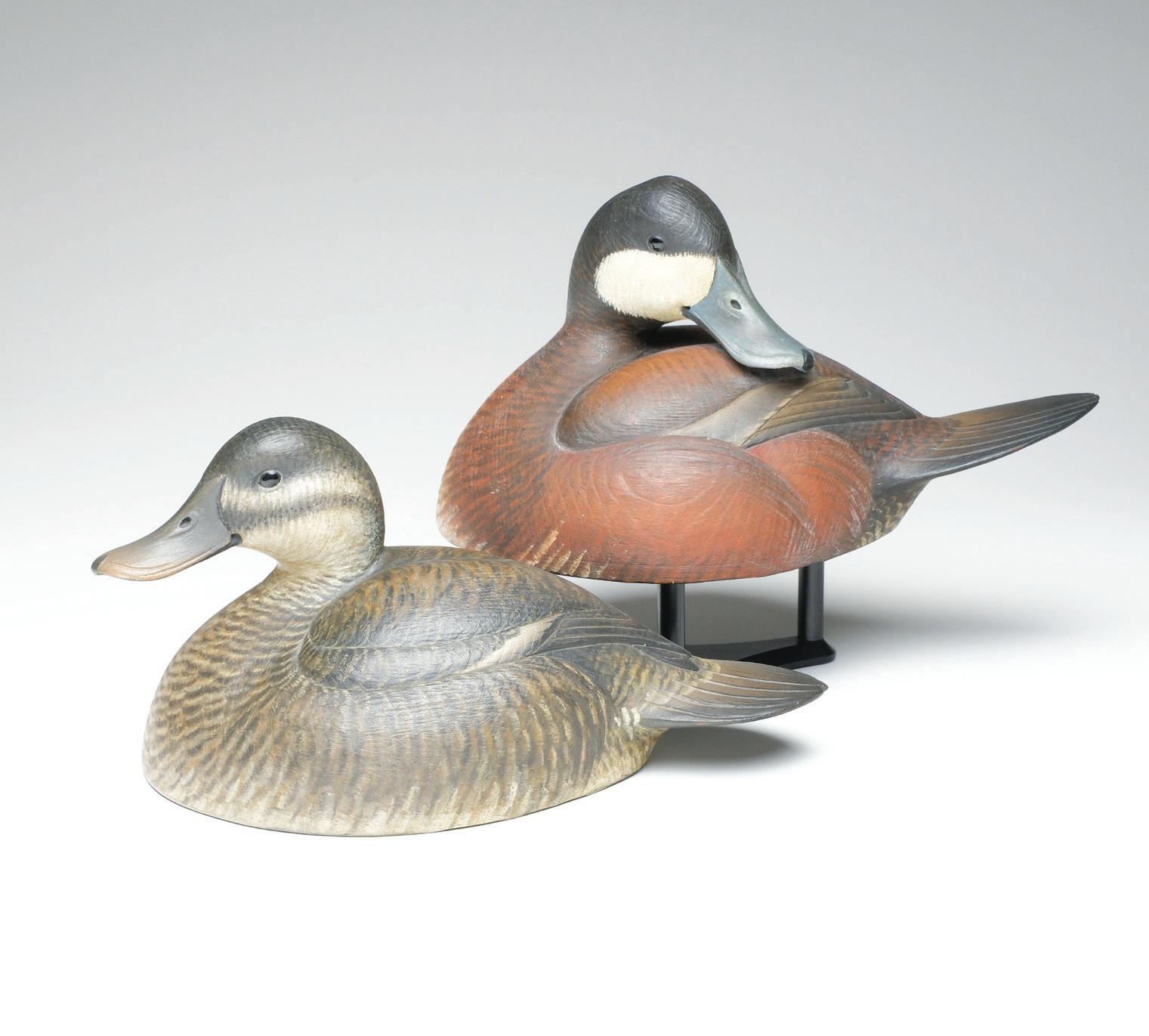
107
140 141
142 Owl, crow, and crow call, Robert Moreland, Harrisonburg, Virginia. Owl opens to store crow and call. Crow also opens. Applied wing on crow is moveable with a pull cord through owl. Initialed and dated ’02 on the inside of crow and owl. Owl measures 19 1/2” tall. With included perch and base 50 ½” tall. A few minor paint rubs and piece of leather latch on owl is missing, otherwise excellent and original.

(1,000 - 1,500)
144 Full size great blue heron, Robert Moreland, Harrisonburg, Virginia. With slightly turned and reared back head. Open beak and extended crest. Initialed and numbered ‘04 under tail. Mounted on carved wooden legs. Measures 31” long, stands 43.5” tall including base. Very good and original.

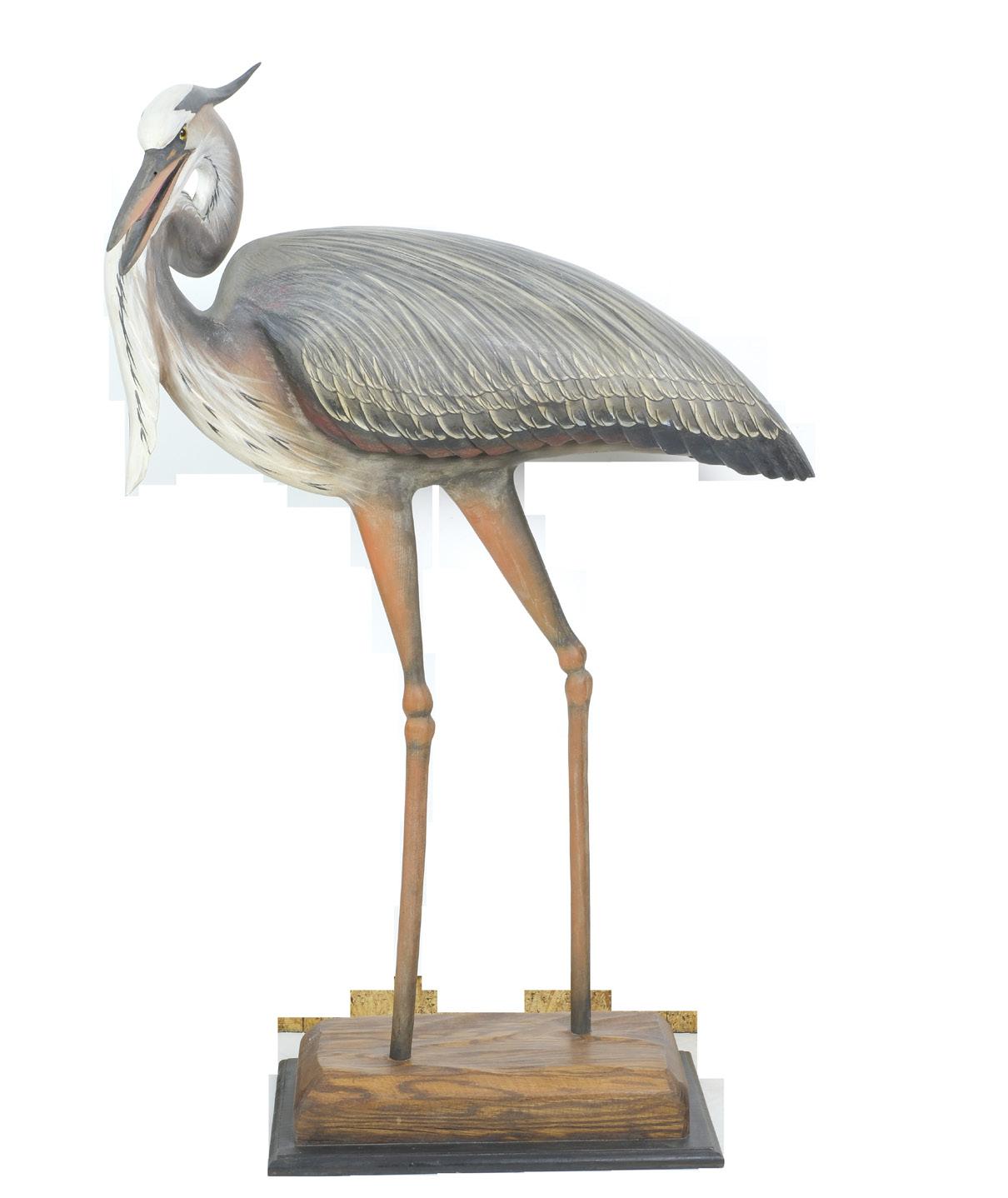
(1,000 - 1,500)
143 Full size osprey, Robert Moreland, Harrisonburg, Virginia. Mounted on carved perch. Slightly raised wings with deep relief feather carving. Head is turned 50 degrees, with extended head feathers. Osprey is removable from feet. Initialed and dated ‘18 on carved log. Bird measures 23” long, stands 28” tall including base. Very good and original.
(1,000 - 1,500)

108
142 143 144
145
Pair of razor billed auk, Sean Sutton, Paulsboro, New Jersey. Mounted to carved wooden bases, with carved clamshells. Both with slightly turned heads and deep relief wing carving. Identified and signed on the underside of bases. Measure 16” and 17” long, stand 10.5” and 17” tall. Fine hairline crack on one side of male, otherwise both excellent and original. (2,000 - 3,000)

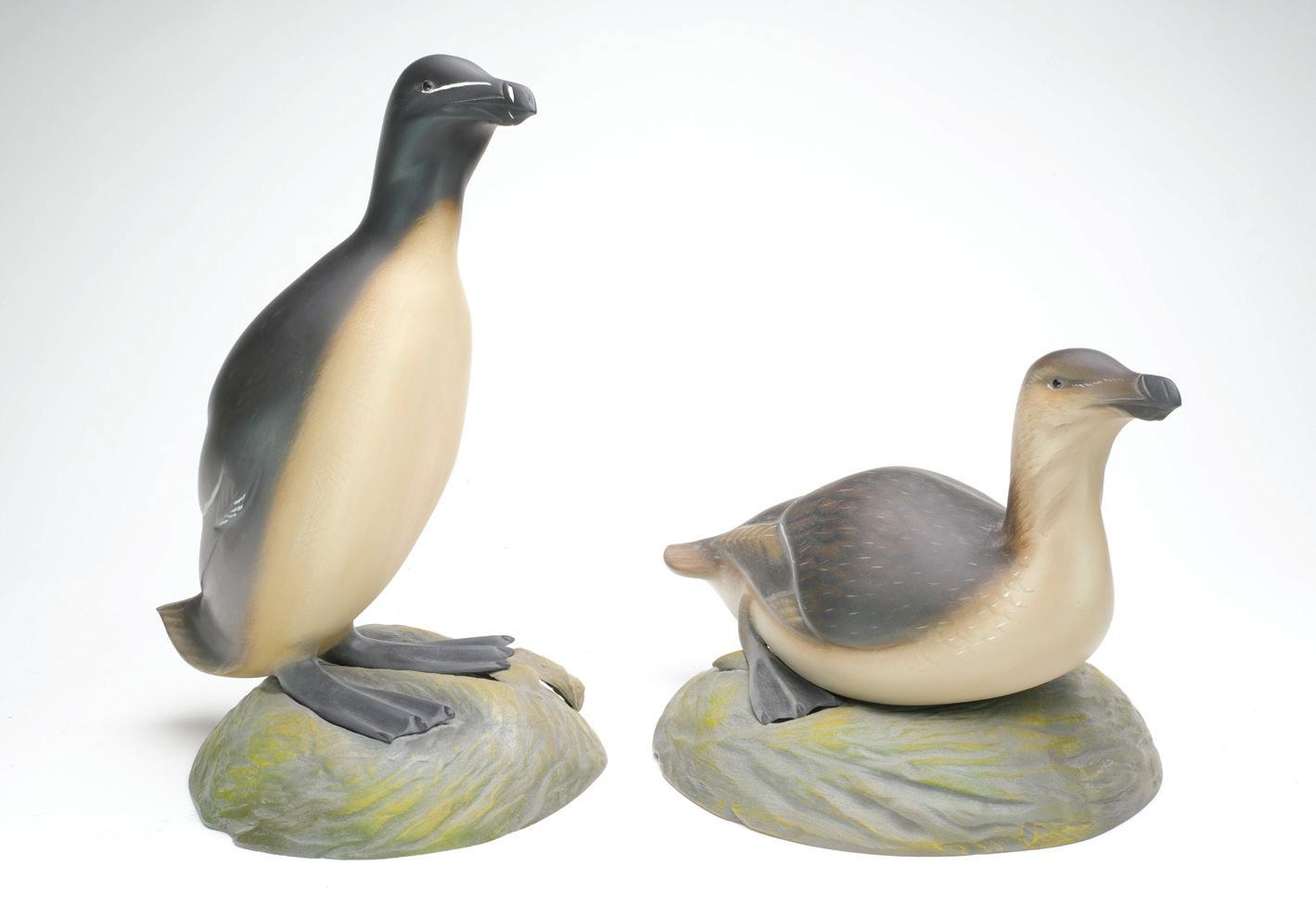
146 Yellowlegs,

carving and raised wingtips. Maker’s initials carved on the underside. Stick hole allows for three different positions on stand. Measures 12.5” long. Excellent and original. (800 - 1,200)
147
in the style
Crowell with relief wing feather carving and raised wingtips. Head is removable, and body opens revealing a carved recess for head and removable bill. Maker’s name and 2008 carved on the inside. Stand included. Measures 12” long. Excellent and original. (1,200 - 1,800)
145 146 147
109
Marty Hanson, Hayward, Wisconsin. Relief wing
Feeding black bellied plover, Steve Weaver, Cape Cod, Massachusetts. Carved
of Elmer
Maryland
Ward Brothers
Crisfield, Maryland
148 Black duck, Ward Brothers, Crisfield, Maryland, circa 1936. Slightly turned head and metal tack eyes. Measures 17” long. Original paint with very minor wear protected under a thin coat of varnish; tight crack along bottom part of neck; bill is a professional replacement.

Provenance: David Fannon collection. (5,000 - 8,000)

110
149 Bluebill hen, Ward Brothers, Crisfield, Maryland. 1936 style with slightly turned head. Signed and dated by the makers at a later date. Sam Dyke collection ink stamp on the underside. Measures 15” long. Original paint with minor to moderate discoloration and wear; cracks along the back were filled in the making; hairline crack along one lower side.
149a Canvasback, Ward Brothers, Crisfield,


Deep ice groove behind neck seat. Typical thick stipple paint on back and sides. Museum inventory number in ink on the underside. Also signed Robt Staniford” twice. Measures 15.5” long. Original paint with moderate gunning wear; bill is a professional replacement; thin wash of black on the breast and face done when the bill repair was made.
Provenance: Recently deaccessioned from an East Coast Museum. (4,000 - 6,000)
111
Provenance: Sam Dyke collection. David Fannon collection. (5,000 - 8,000)
Maryland.
149
149a

 150 Pair of canvasbacks, Ward Brothers, Crisfield, Maryland. Balsa bodies with slightly turned heads. Thick stipple paint on backs. Signed and dated 1952 on the underside. Measure 15” and 16.5” long. Original paint with minor to moderate gunning wear; small dents on drake’s back; tight crack along one side of hen.
(2,500 - 3,500)
151 Rigmate pair of bluebills, Ward Brothers, Crisfield, Maryland. Both are signed and dated 1972 on the underside. Heads are turned. Excellent stipple painting on backs of both with fine detail feather painting. 15” long. Original paint with very minor wear; varnish from underside spilled over to lower side pocket on drake.
150 Pair of canvasbacks, Ward Brothers, Crisfield, Maryland. Balsa bodies with slightly turned heads. Thick stipple paint on backs. Signed and dated 1952 on the underside. Measure 15” and 16.5” long. Original paint with minor to moderate gunning wear; small dents on drake’s back; tight crack along one side of hen.
(2,500 - 3,500)
151 Rigmate pair of bluebills, Ward Brothers, Crisfield, Maryland. Both are signed and dated 1972 on the underside. Heads are turned. Excellent stipple painting on backs of both with fine detail feather painting. 15” long. Original paint with very minor wear; varnish from underside spilled over to lower side pocket on drake.
150 151 112
(4,000 - 6,000)
152 Pair of pintails, Ward Brothers, Crisfield, Maryland, circa 1970. Shooting stool models, carved in the 1938 style with slightly turned heads and extended tails. Signed and dated 1938 on the underside. Measure 17” long. Original paint with very minor paint rubs; hen with some paint shrinkage from sap bleed on breast and behind neck seat; very minor hairline separation at each neck seat, otherwise excellent structurally. (4,000 - 6,000)

153 Pair of canvasbacks, Ward Brothers, Crisfield, Maryland. Shooting stool models with heads turned 45 and 60 degrees. Signed and dated 1973 on the undersides. Measure 15.75” and 16.75” long. A few very minor paint rubs and a tiny paint flake on the underside of hen’s bill, otherwise near mint. (3,000 - 5,000)

113
152 153
153A Pair of 2/3 size hooded mergansers, Ward Brothers, Crisfield, Maryland, circa 1948. Both have slightly turned heads with extended crests. Measure 8” long. Drake is excellent and original; hen has professional restoration to a break in the neck, otherwise very good.


(1,500 - 2,000)
153B Rare pair of miniature red breasted mergansers, Ward Brothers Crisfield, Maryland, circa 1948. Both have turned heads with extended crests. Strong original paint; a few minor dents to balsa; head on drake was recently tightened.

(1,500 - 2,000)
153C Pair of miniature redheads, Ward Brothers, Crisfield, Maryland, circa 1948. Balsa bodies. Both have turned heads. Professional restoration around neck on hen, otherwise both are very good and original. (1,500 - 2,000)
114
153C
153A 153B
153D Rare miniature long tailed duck, Ward Brothers, Crisfield, Maryland, circa 1948. Turned head. Long extended, inserted tail. Measures 9” long. Original paint; tiny spot of damage to very tip of tail. (800 - 1,000)
153E Miniature greenwing teal drake, Ward Brothers, Crisfield, Maryland, circa 1948. Turned head with extended crest. Balsa body construction. 8.5” long. Tiny chip at tip of bill, otherwise excellent and original. (500 - 700)

153F Miniature Canada goose, Ward Brothers, Crisfield, Maryland, circa 1948. Slightly turned head. Paint feathering detail. Balsa body. 8.25” long. Very good and original. (500 - 800)


153G Miniature mallard hen, Ward Brothers, Crisfield, Maryland, circa 1948. Balsa body and turned head. 8.5” long. Neck seat has been reglued; otherwise very good and original. (500 - 700)

115
153D
153F
153E
153G
154 Pair of mallards, Ward Brothers, Crisfield, Maryland. Shooting stool models with reared back heads. Signed and dated 1967. Decoys originally had keels that were removed. Measure 15” long. Original paint with very minor wear; very good structurally.

Provenance: Made for Phil Williamson collection. (3,000 - 5,000)
155 Canada goose, Ward Brothers, Crisfield, Maryland. Hollow carved with bottom board added at some point. Slightly turned head and detailed bill carving. Measures 25” long. Mix of original and early in use repaint with minor flaking and wear; decoy was hollowed at some point and a bottom board added; filler along cracks in back appear to be from when the decoy was made; tight cracks in neck; repair to a chip in one side of the bill.

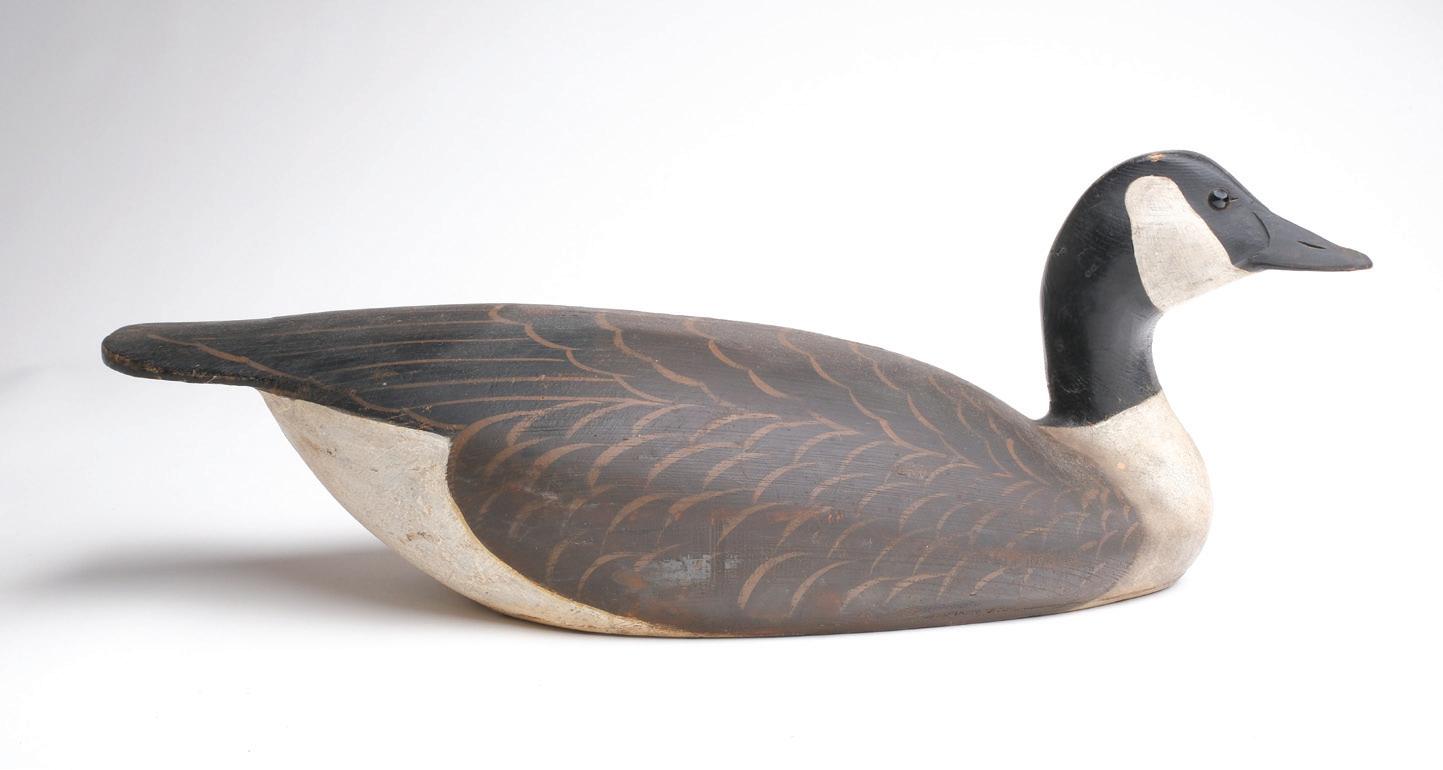
Provenance: David Fannon collection. (2,000 - 3,000)
156 Canada goose, Ward Brothers, Crisfield, Maryland. 1936 style with slightly tucked, forward head pose. Signed on the underside at a later date by the Ward Brothers. Ink stamps from the collection of Tommy O’Conner and Mort Kramer. “MK” carved in the underside. Measures 24.75” long. Paint was restored by Oliver Lawson in the Ward Brothers style with very minor wear; early neck crack repair and filler added to a split in the back; hairline cracks in body; loss on edge of tail.
Provenance: Tommy O’Connor collection. Mort Kramer collection. David Fannon collection. (1,200 - 1,800)
157 Goldeneye drake, Ward Brothers, Crisfield, Maryland, circa 1950. Balsa body construction with turned head and inserted hardwood tail. 14” long. Small dent in back and a little handling wear near top of head and edge of tail; otherwise very good and original. (2,500 - 3,500)

116
154 156 155 157
158 Outstanding early canvasback, Madison Mitchell, Havre de Grace, Maryland, circa 1940s. North/South line tie staple, as seen on Mitchell’s earliest carvings. Measures 15” long. Original paint with very minor wear; line of filler added to a loss in heartwood on underside when the decoy was made; excellent structurally.
(1,200 - 1,800)
159 Two-piece black duck, Sappington Lee Bowman, Havre de Grace, Maryland, 3rd quarter 20th century. Two-piece body with scratch feather paint detail and original head by Madison Mitchell. Measures 15.5” long. Original paint with moderate gunning wear; much of the paint has worn off the hard chine line on sides; drip of green paint on top of head.
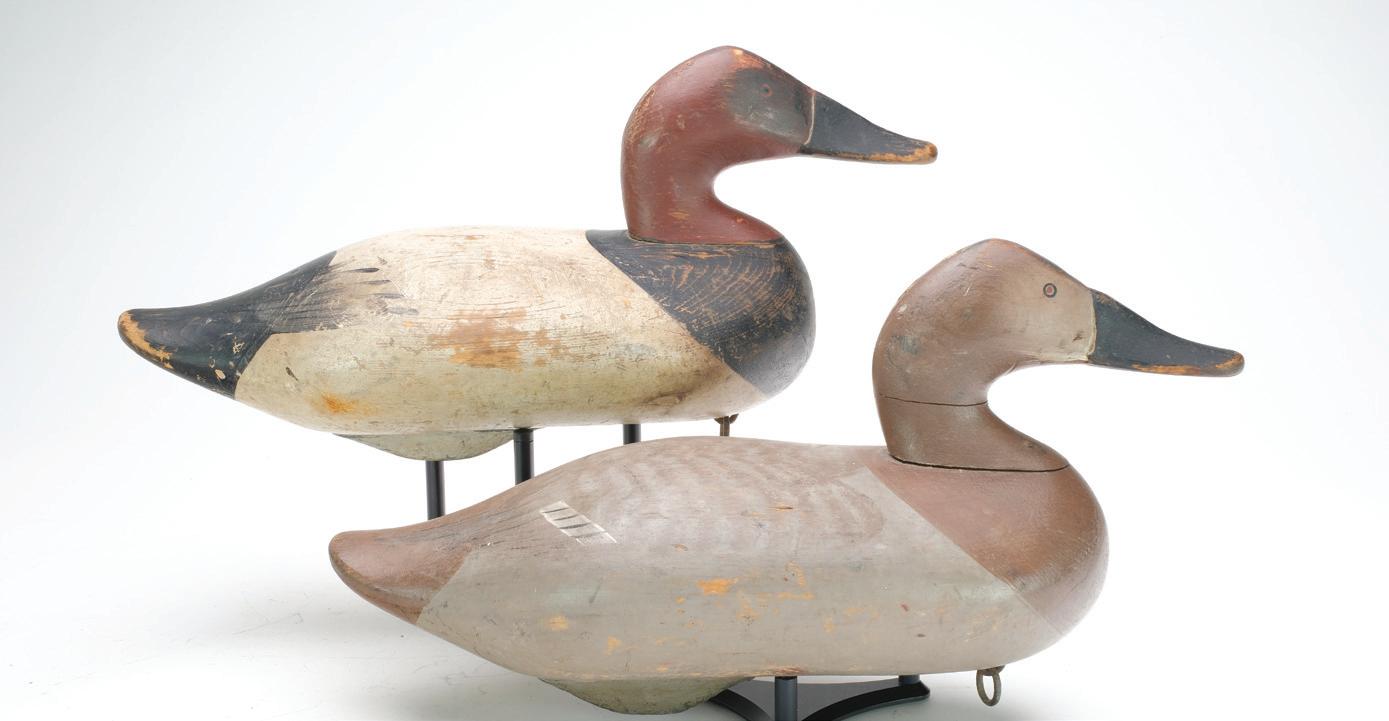

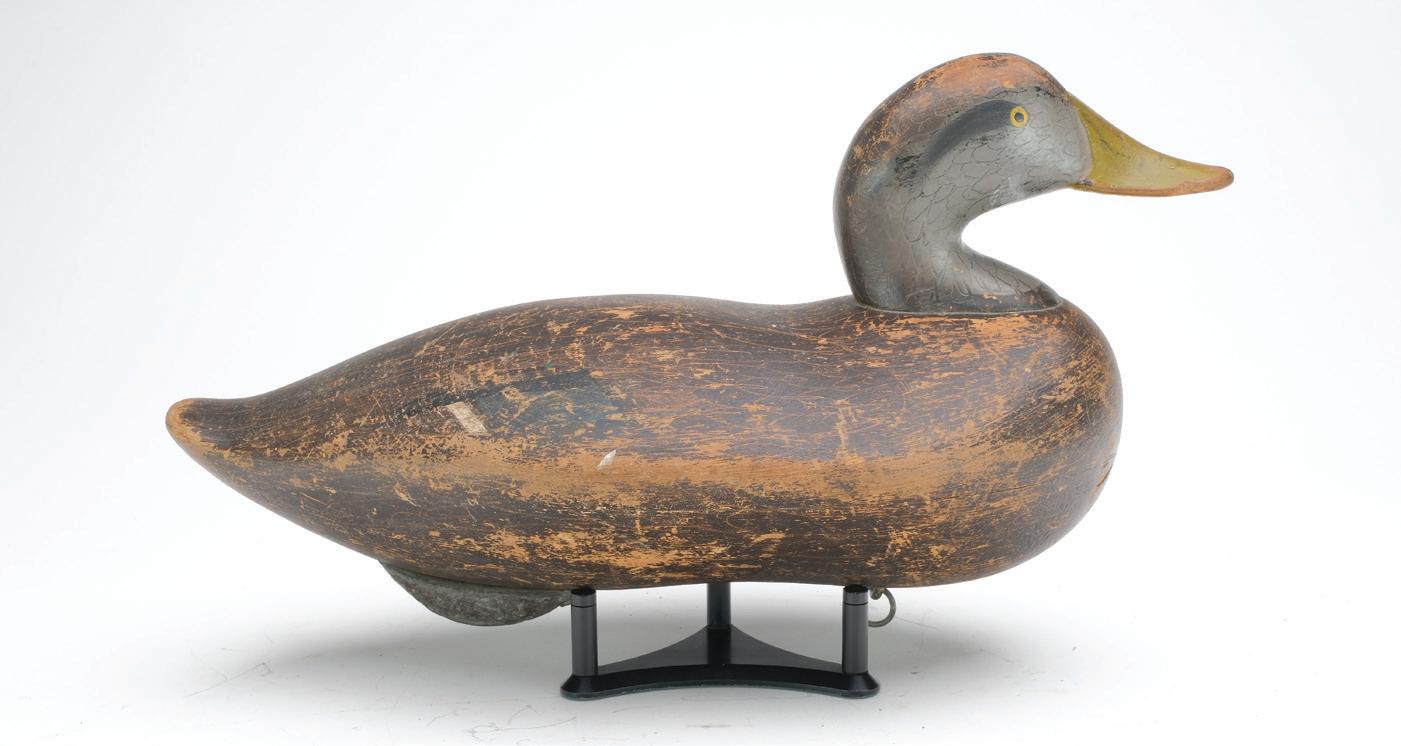

Provenance: Mark and Ann Terry collection.
(400 - 600)
160 Early pair of redheads, Madison Mitchell, Havre de Grace, Maryland. North/South line tie staple, as seen on Mitchell’s earliest carvings. Signed and dated 1940 in electro pen at a later date. Measure 14” long. Original paint with minor gunning wear; crack through hen’s neck; hairline cracks and slight separation at a large knot in hen’s breast.
(1,200 - 1,800)
161 Early pair of canvasbacks, Madison Mitchell, Havre de Grace, Maryland. North/South line tie staple, as seen on Mitchell’s earliest carvings. Signed and dated 1939 in electro pen at a later date. “F” branded on the underside of each for the collection of Henry Fleckenstein, Jr. Measure 15.5” long. Original paint with minor to moderate wear; tight crack through hen’s neck; minor roughness on edge of drake’s bill and tail.
(1,200 - 1,800)
117
158 160 159 161
162 High head canvasback hen, Robert McGaw, Havre de Grace, Maryland, 2nd quarter 20th century. “LL” carved on the underside. Large “B” branded on the underside. Retains the original McGaw weight. Measures 15.25” long. Original paint with moderate wear; hairline cracks in body; tight cracks in neck.

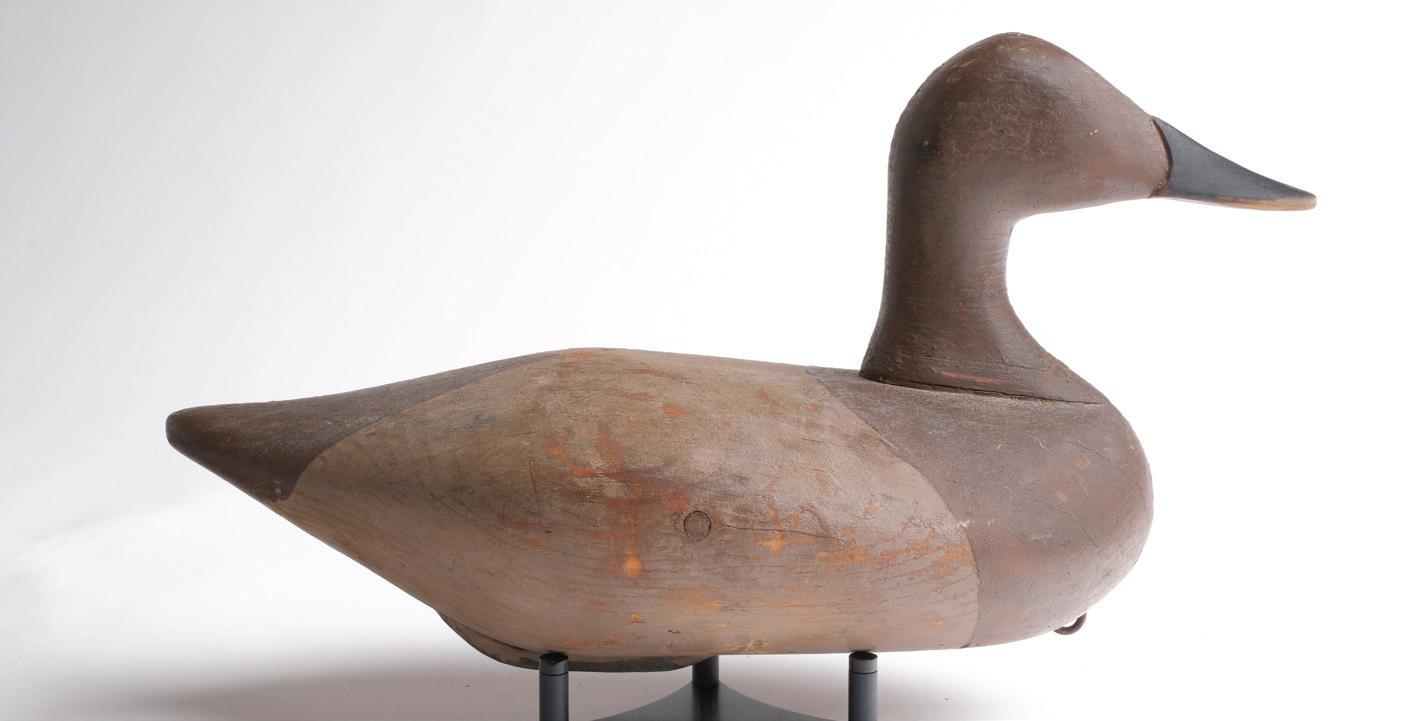
Provenance: Mark and Ann Terry collection. (1,200 - 1,800)
163 Flat bottom style widgeon drake, Robert McGaw, Havre de Grace, Maryland. Retains McGaw’s original dogbone weight. Stamped “SGH” on the underside for the collection of Somers G Headley. A rare species for this maker. Measures 14” long. Original paint with moderate flaking and wear; drying cracks in breast; split along the underside; tight crack through neck.
Provenance: Provenance: Somers G. Headley collection. Sam Dyke collection. Mark and Ann Terry collection. (1,200 - 1,800)
164 Mallard, Robert McGaw, Havre de Grace, Maryland. Retains the original Bob McGaw weight. Measures 15.25” long. Original paint with moderate gunning wear under a thin coat of varnish; wooden patch added along one side at a defect in wood when the decoy was made; minor chipping and roughness on tip of tail.
Provenance: Mark and Ann Terry collection. (800 - 1,200)

165 Pair of pintails, Robert McGaw, Havre de Grace, Maryland. High head models with extended tails. Both retain the original McGaw weights. Measure 16” and 17” long. Drake is in original paint with moderate to significant flaking and wear; drying cracks and dents in body; crack through neck; drying cracks along the back of neck and front of head; small amount of filler and touchup to a chip in top of tail; hen appears to have originally been a drake, as the wing patch paint detail of a drake is visible under the surface; surface has been restored in the McGaw style with artifical wear; many drying cracks and splits.
Provenance: Mark and Ann Terry collection. (1,200 - 1,800)

118
162 164 163 165
166 Canvasback, James Holly, Havre de Grace, Maryland, 1st quarter 20th century. “JB” carved in the underside. Measures 14.5” long. Original paint with moderate gunning wear; small dents and shot marks; tight crack through neck; hairline cracks in breast and along the back; area of original filler added to a loss in wood on underside has flaked away; early chip from a shot strike in top of head.
Provenance: David Fannon collection. (800 - 1,200)
167 Canvasback drake, James T. Holly, Havre de Grace, Maryland, circa 1900. “JD” carved in underside. 15” long. Original paint with light wear, mostly at sides of decoy; a wood imperfection on one side of body and underside near weight; several shot scars; a knot appears to be pushing at one side of head; paint and wood putty have fallen out around nail holes at lower neck.

Provenance: David Fannon collection. (1,000 - 1,500)
166
168 Rare wooden wingduck, James Holly, Havre de Grace, Maryland. “JAH” branded on the underside. Measures 15.25” long. Appealing early in use repaint with minor wear; tight crack through neck; minor separation at neck seat.


Provenance: Mark and Ann Terry collection. (600 - 900)
167
168
119
168a Pair of cast iron canvasback decoys, Havre de Grace, Maryland Measure 14.25” long. Paint appears original with moderate flaking and wear. (800 - 1,200)


168b Canvasback cast iron sink box decoy. Measures 13” long. Old working paint; a “W” is scratched in to the underside; old paint shows stainings, chips, and rubs. (600 - 900)

168c Canvasback iron wingduck, John Graham, Charlestown, Maryland. Measures 13” long. Old paint with moderate discoloration and wear.
Provenance: David Fannon collection. (400 - 600)
120
168a
168c
168b
168d Cast iron sink box decoy, probably from Maryland Measures 15” long. A few small traces of old paint; structurally good.
(400 - 600)
168e Cast iron sink box decoy. Measures 14” long. Old rusted surface; no traces of paint; structurally good. (400 - 600)



168f Cast iron sink box decoy. Measures 13.5” long. A few small traces of old paint; structurally good.
(400 - 600)
121
168d
168f
168e
(600 - 900)
169 Very rare, full-size swan, Horace Graham, Havre de Grace, Maryland, 3rd quarter 20th century. Removable head that is made from laminate construction. “HD Graham” carved in the underside. Measures 37” long. Thick original paint with minor paint rubs; hairline cracks in body; minor separation and cracks at seams in wood on head and neck.

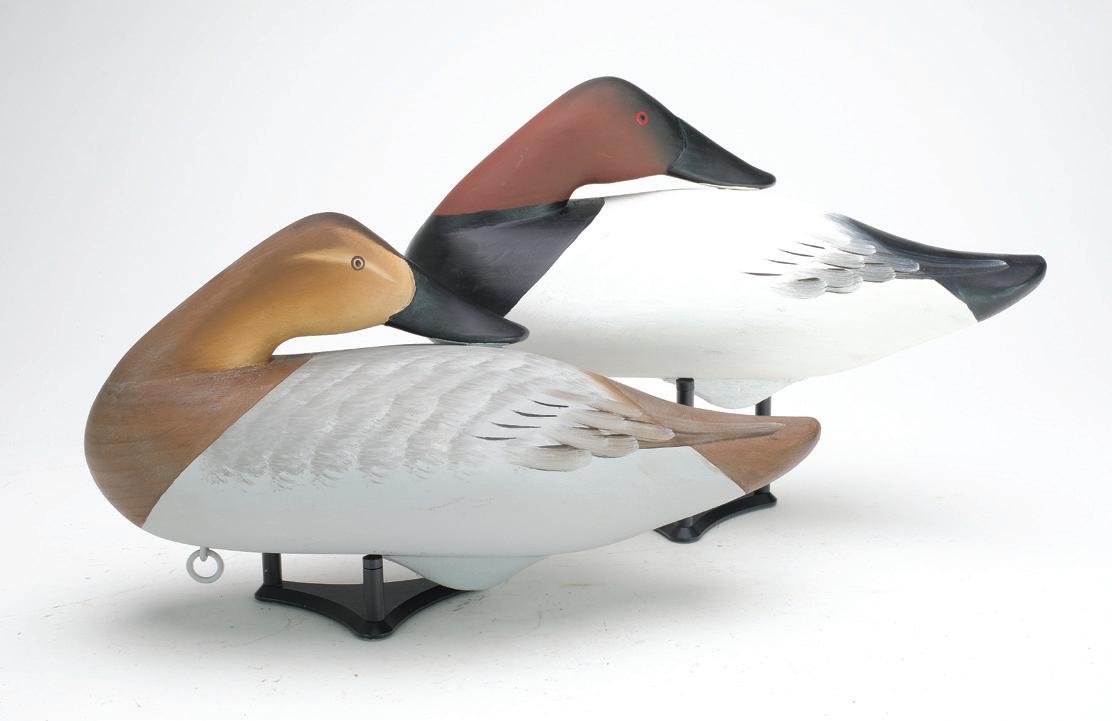

(3,000 - 5,000)
171 Pair of
Extended crests. Signed and dated 1996. Measure 16.25” long. A few very minor paint rubs; fine hairline crack along one side of hen’s neck seat; otherwise excellent.
(800 - 1,200)
122 169 170 171
170 Pair of preening canvasbacks, Charlie Joiner, Chestertown, Maryland. Heads turned back over bodies. Signed and dated 1995. Measure 14.5” long. Excellent and original.
mergansers, Charlie Joiner, Chestertown, Maryland.
172 Pair of red breasted mergansers, Oliver Lawson, Crisfield, Maryland. Slightly turned heads with extended crests. Signed and dated 1981 on the underside. Measure 16.5” long. Very minor paint rubs on tip of each tail, otherwise excellent.
Provenance: Gordon Mulava collection.
(600 - 900)
173 Pair of goldeneye, Oliver Lawson, Crisfield, Maryland. Slightly turned heads. Signed and dated 1981 on the underside. Measure 13” long. Very good and original.



Provenance: Gordon Mulava collection.
(500 - 800)
174 Pair of sleeping canvasbacks, Charlie Joiner, Chestertown, Maryland. With heads turned resting on back. Signed on the undersides. Measures 14” long. Original paint with very minor wear; excellent structurally.
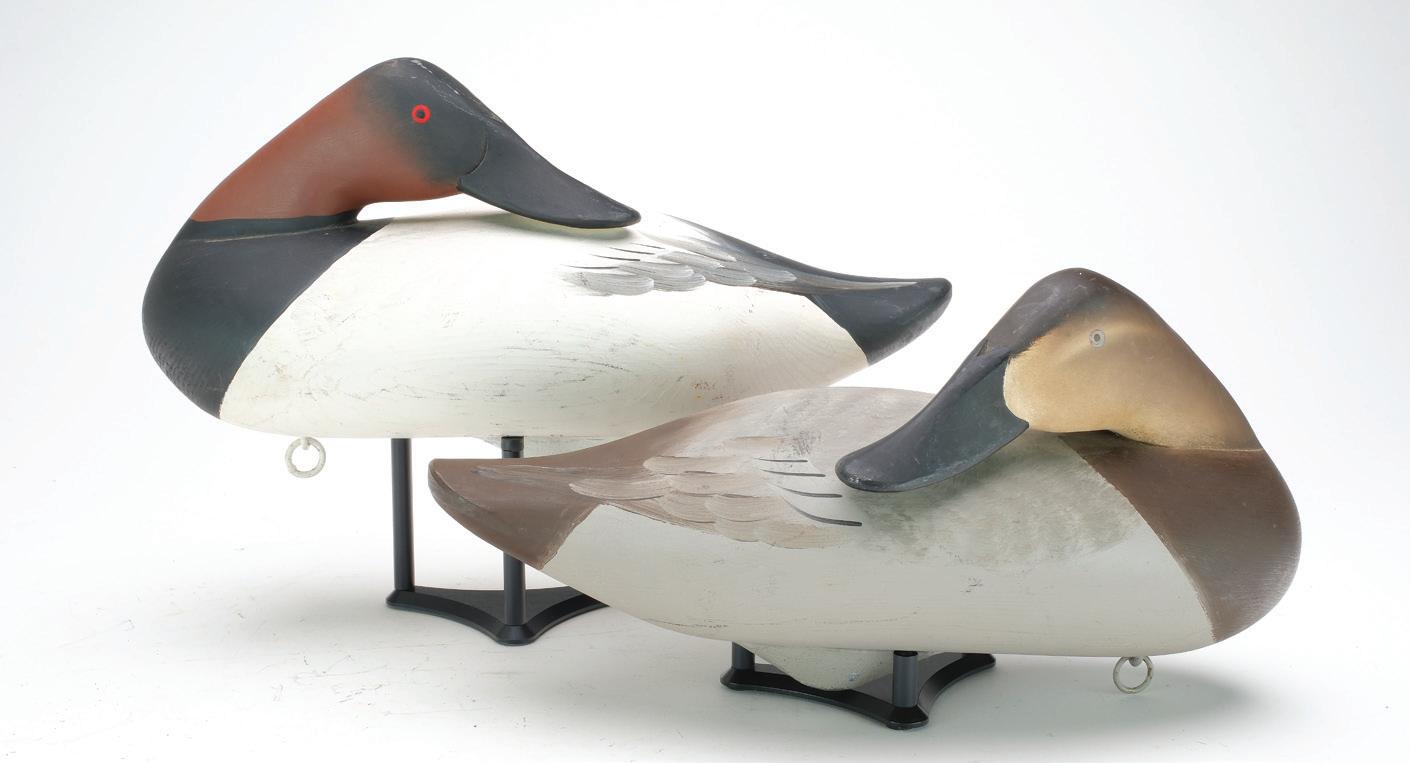
(600 - 900)
175 Pair of redheads, Charlie Joiner, Chestertown, Maryland. Flat bottom style with slightly turned heads and thick stipple paint on back. Signed on the undersides. Measure 14” long. Excellent and original.
(500 - 800)
123
172 174 173 175
Some knew Mr. Rue through his carvings and his years of involvement with Easton’s Waterfowl Festival. A master storyteller, on par with his master ranking as a carver, he had a dry wit and gentle way of making his point.The extent of his knowledge went far beyond ducks and the people who carve them, from ancient history to current events. Mr. Rue learned a lot while he whittled, which is what he called what he did.His introduction to carving is classic, a boy who needed decoys for hunting who decided to make his own. Mr. Rue usually had something good to say about everybody. But he had little good to say about the Maryland Department of Natural Resources. He hinted that encounters with the law caused him to stop hunting. And in latter years he sometimes incorporated little jokes about the DNR into his carvings.
When much was first made of pfisteria and then Gov. Parris Glendening was worrying it would spread to the beaches of Ocean City, Mr. Rue began carving miniature rockfish pins with tiny sores. On the back he wrote, “DNR managed rockfish.” A few years ago he began carving oysters, wryly explaining that was one way to bring the oysters back.
As a young man, he began decorative carving. Among his favorite stories was the one about the day he brought one of his early works to Crisfield, to show to the famed carving team of Steve and Lem Ward.As the story goes, he saw everything that was wrong with his carving of a merganser when he compared it to the carvings in the Ward Brothers’ shop. But the brothers showed an interest in his carving and showed him what was right about his work. And they became his friends. It was the first of many visits to the Ward Brothers, who offered Mr. Rue advice which he passed on many times over to other beginning carvers.



For many years he taught carving classes at the Dorchester Arts Center in Cambridge, encouraging several generations of carvers — including some now well recognized for their art — by showing them what they were doing right.An original inductee into the Waterfowl Festival Hall of Fame in Easton, Mr. Rues also was inducted into the Havre de Grace Decoy Museum. Among his many other honors was presenting a carving of a Baltimore Oriole to Princess Anne of Great Britain in 1976.
Mr. Rue had also enjoyed being selected to demonstrate his craft at the Chesapeake Maritime Museum in St. Michaels. He had fun talking with museum visitors. But he was sadden to realize there were so many people who didn’t understand how decoys are used for hunting.
124 176 177
176 Pair of shoveler, Ron Rue, Dorchester City, Maryland. Slightly turned and tucked head. Comb feather paint detail on drake’s sides. Relief wing carving with raised, crossed wingtips. Wide spoon bill carving. Signed and branded “Rue”. Both retain the original cast lead corn cob weights. Measure 14” and 15” long. Excellent and original.
(400 - 600)
177 Pair of Cinnamon teal, Ron Rue, Dorchester City, Maryland. Slightly turned head. Signed and branded “Rue”. Both retain the original cast lead corn cob weights. Measure 12.25” long. Excellent and original.
(400 - 600)
Ron Rue 1931 - 2005 | Dorchester City, Maryland
178
Pair of long tail ducks, Ron Rue, Dorchester City, Maryland. Slightly turned and tucked head. Relief wing feather carving and inserted leather tail sprig on drake. Signed and branded “Rue”. Both retain the original cast lead corn cob weights. Measure 12.5” and 17” long. A few small dents on drake, otherwise excellent and original. (400 - 600)

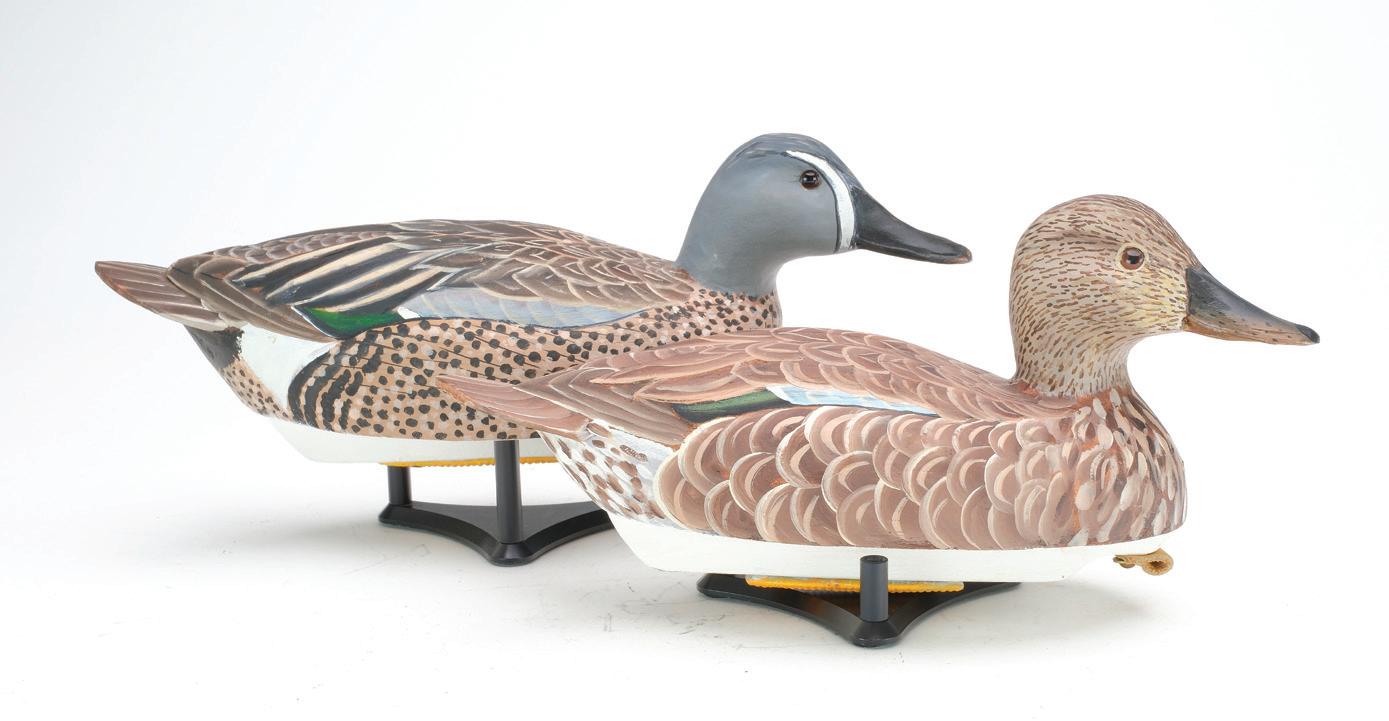

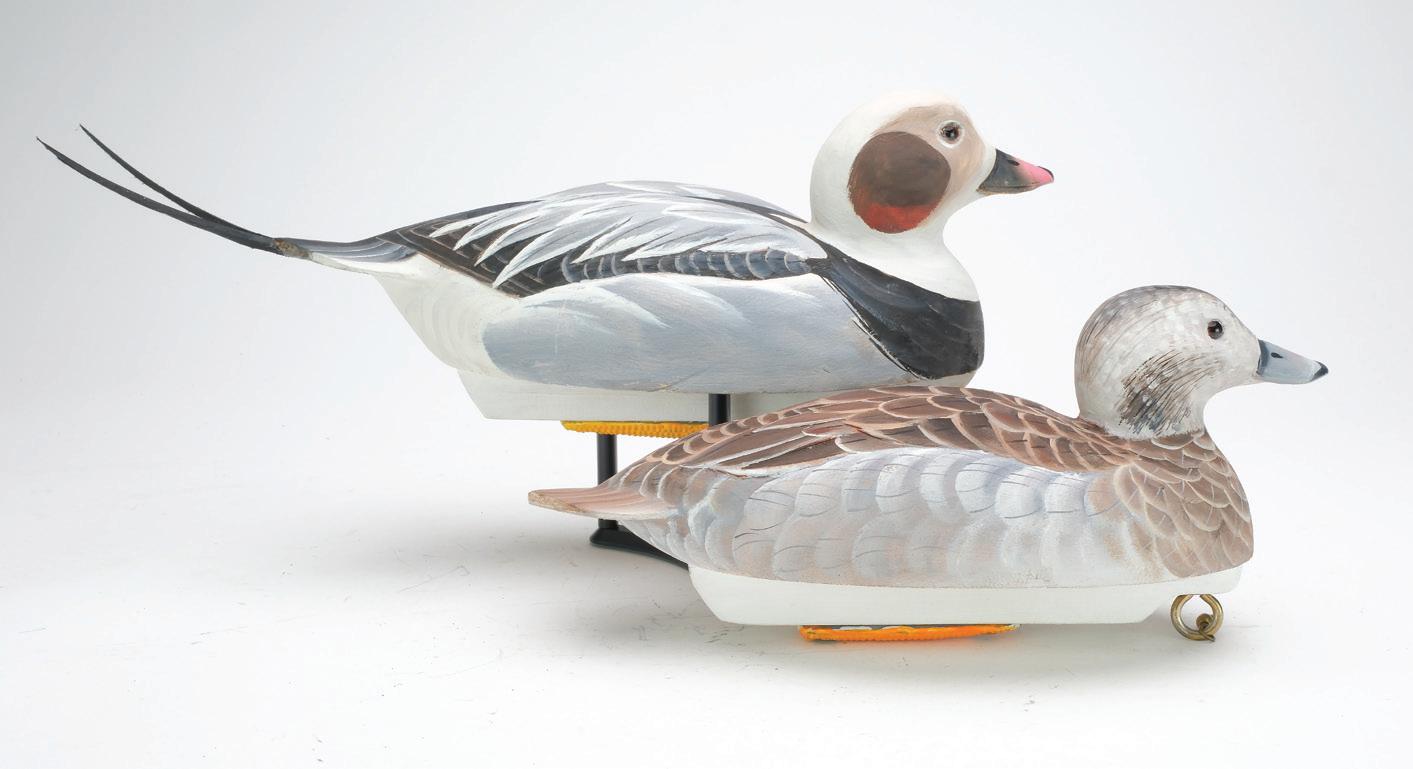
179 Pair of widgeon, Ron Rue, Dorchester City, Maryland. Slightly turned and tucked head. Signed and branded “Rue”. Both retain the original cast lead corn cob weights. relief wing feather carving on drake. Measure 12.75” and 13.25” long.
Excellent and original. (400 - 600)
180 Pair of bluewing teal, Ron Rue, Dorchester City, Maryland. Slightly turned head, with drake in swimming pose. Signed and branded “Rue”. Both retain the original cast lead corn cob weights. Measure 12” and 13.5” long.
Excellent and original. (400 - 600)
181 Pair of greenwing teal, Ron Rue, Dorchester City, Maryland. Slightly turned and tucked head. Comb feather paint detail on drake’s sides. Signed and branded “Rue”. Both retain the original cast lead corn cob weights. Measure 11” long. Excellent and original. (400 - 600)
125
178
179
180
181
Ned Burgess 1868 - 1962 | Knotts Island, North Carolina
While Ned Burgess became one of, if not the most prolific decoy carver from the Tar Heel State, deciphering the early years of his life is a challenge. He is said to have spent his youth largely “fending for himself”, fishing, trapping, and signing on aboard sailing vessels. Both Dick McIntyre and Kroghie Andresen have researched Burgess and state that, based on a 1957 interview, Burgess’ father died when he was five and he was orphaned by age nine. At twelve, Burgess is said to have lost the sight of one eye when a neighborhood girl threw sand in his face. The only vague written mention of his birth or early years is a reference in his brief obituary stating that “he was a native of Perquimans County, (N.C)”. The


first verifiable printed record pertaining to him is his 1895 marriage to Laura Ellen Harris in Currituck County, North Carolina. The couple resided in Atlantic Township on the Outer Banks through at least 1900, while Ned worked as a fisherman. Their daughter, Eunice, was born in 1906 and, by 1910, the family had moved to New Hope in Perquimans County where Ned found employment as a farmer. Between 1917 and at least 1923, Burgess was in Norfolk, Virginia working as a fisherman and employed at a shipyard. During the 1930s and 40s, he had moved the family back to North Carolina, living in Poplar Branch. His daughter died young in 1946 and Laura died in 1950. Andresen states that after the death of his loved ones he moved to Waterlilly and lived out his years in a simple, tar paper covered home, assisted at times by his grandchildren.
(6,000
182 Canvasback, Ned Burgess, Knotts Island, North Carolina, circa 1930s. Measures 17.5” long. Original paint with minor to moderate gunning wear; very minor roughness on edge of tail and bill; otherwise excellent structurally.
- 9,000)
Not having had the easiest of childhoods, with losing the sight in one eye in his youth, Burgess’ vision began to fail in his “good” eye in adulthood. He suffered a number of ailments throughout his life, ultimately having a leg amputated due to poor circulation. He died in the Norfolk General Hospital after a lengthy 38-day stay and is buried in Waterlilly, NC.
Regardless of his misfortunes, Burgess was a prolific carver over his lifetime. It is commonly accepted that Burgess never owned a bandsaw and hand chopped all of his decoys. In his 1957 interview he is said to have estimated that his normal production was about 500 decoys per year and it is estimated that his life long total is between 5,000 and 10,000 birds. The thin necks on his heads were strengthened with a nail driven in from below before they were fastened to the body with three additional nails. The surfaces were left textured, which he felt reduced glare when on the water. His production was, as one would suspect, driven by the demand for those species most commonly sought and, thus, canvasbacks comprise a very large portion of his total output. His very few mallards therefore are extremely
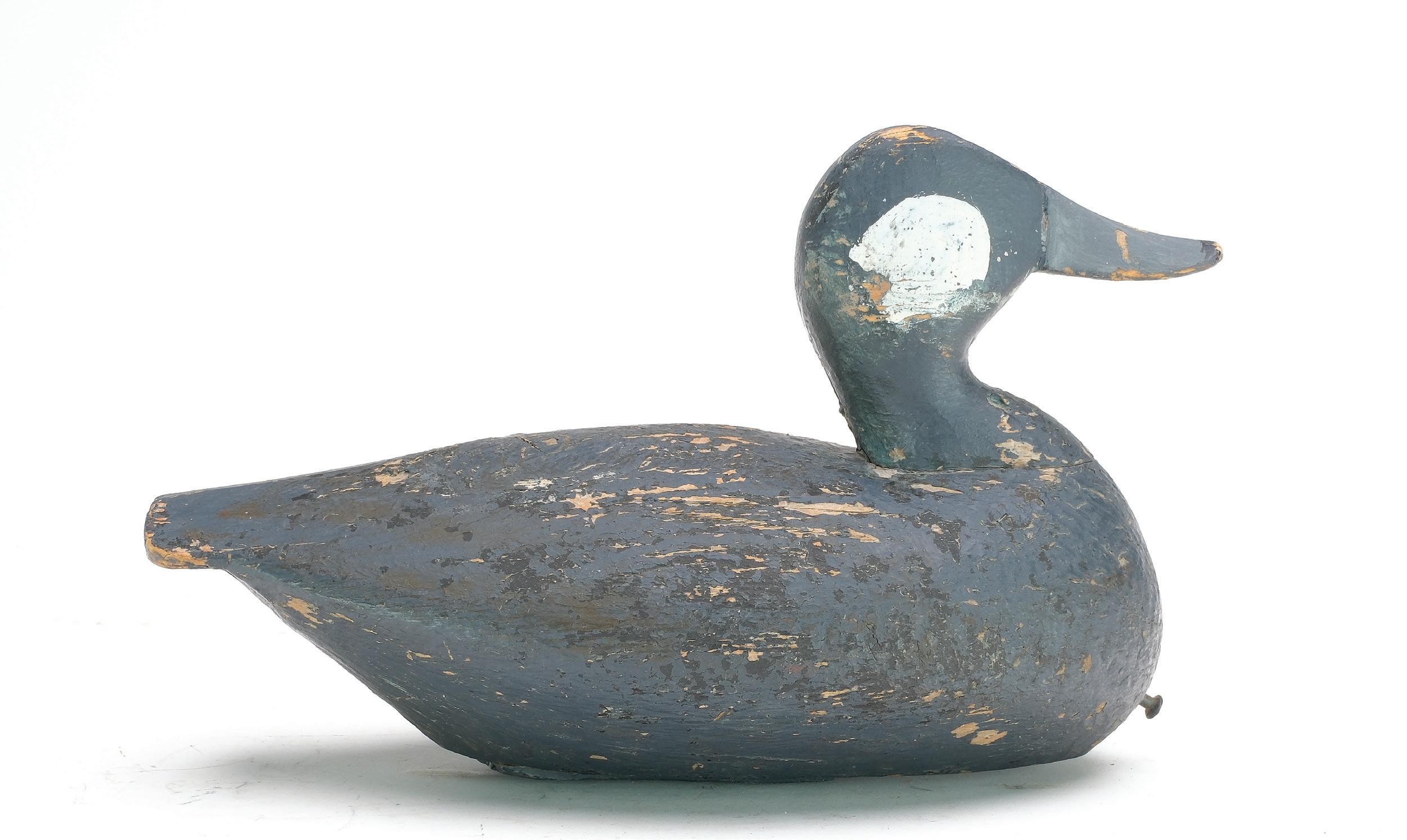
rare and almost impossible to find in original paint today. He did most of his carving in a simple outdoor structure which, due to his poor eyesight, afforded him better lighting. His paint patterns were, likewise, kept quite minimalistic and have sometimes been referred to as somewhat “art deco” in nature. Apparently, Burgess was not overly fastidious for, in his later years, his house and yard were said to be covered with shavings scattered everywhere from his carving. The demand for his work never diminished and he had a reliable following from a number of U.S. Congressmen and Senators for their own rigs. He also filled sizable orders for some of the better gunning clubs of his day, such as The Currituck Shooting Club, the Dews Island Club, Pine Island Club and others.
183 Ruddy duck, Ned Burgess, Knotts Island, North Carolina. Reared back head. Dick McIntyre collection ink stamp on underside. Measures 11” long. In use repaint with moderate flaking and wear; drying crack in the underside; otherwise very good structurally.
Literature: “Southern Decoys”, Henry A. Fleckenstein Jr, page 227, exact decoy pictured. (8,000 - 12,000)

(10,000



128
184 Canvasback, Lee Dudley, Knotts Island, North Carolina. “LD” branded on the underside. Measures 12.5” long. Old over paint was professionally removed and the remaining paint strengthened; moderately hit by shot; tight cracks along the underside and tail; professional neck crack repair; bill is a professional replacement.
- 15,000)
184a Very rare ruddy duck, attributed to James Best, Kitty Hawk, North Carolina, circa 1930. Slightly raised neck shelf with an upswept tail. A slightly humped back and wide body profile. Measures 10” long. A light, thin coat of paint was applied, presumably in the making, but perhaps at a later date; it is covered by a light coat of varnish on the head which is visible under black light; repair to a sliver at one side of the bill; worn to bare wood on approximately 50% of body and top of head.

(10,000 - 15,000)

129
185 Canvasback drake, Robert Morse or Ned Burgess. Iron City weight on the underside. Branded “F.C.G.C” on the underside for the False Cape Gun Club. Measures 18” long. Old repaint with minor to moderate wear
(1,200 - 1,500)
186 Pintail used at the Swan Island Club, Sam Smith, Amityville, Long Island, 1st quarter 20th century. Branded “W.H. Forbes” also “BWP”. Measures 16” long. Old in use repaint with moderate to significant flaking and wear; tight drying crack in tail; crack through neck.
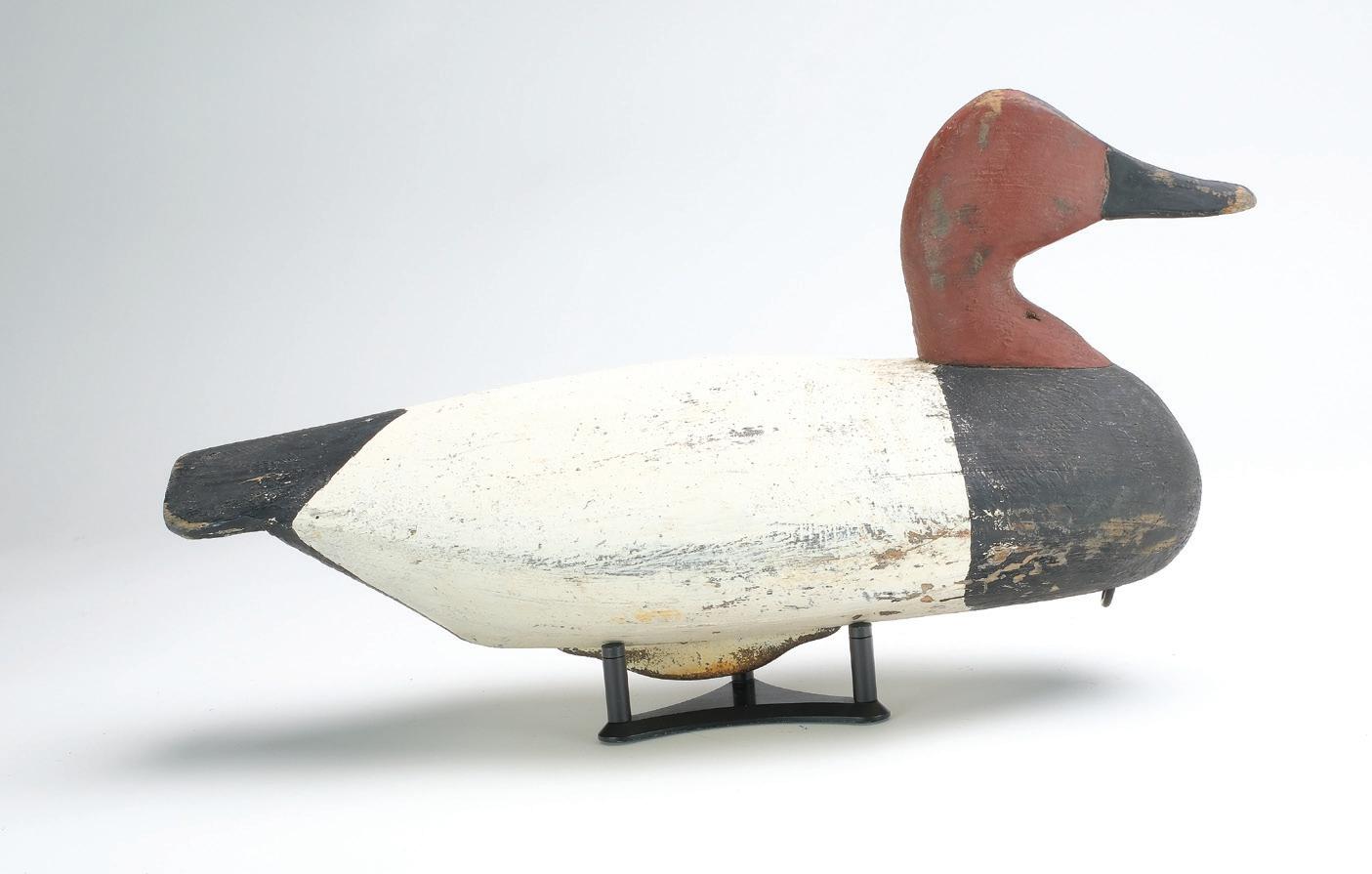
(800 - 1,200)
187 Canvasback drake, used in North Carolina, 1st quarter 20th century. Reared back head and wooden keel. Used at the Currituck Club. Illegible brands on the underside. Measures 13.5” long. Original paint with moderate flaking and wear; fine hairline cracks in body; wooden dowel has risen on top of head.

(600 - 900)
188 Root head willet, Manson Ellis Meekins, Avon, North Carolina. Two piece body with applied root head and bill. Museum inventory number in ink on the underside. Measures 16” long. Original paint with moderate flaking and wear; hit by shot; minor roughness on edge of tail; head has been off and reattached long ago with small amount of glue visibile.
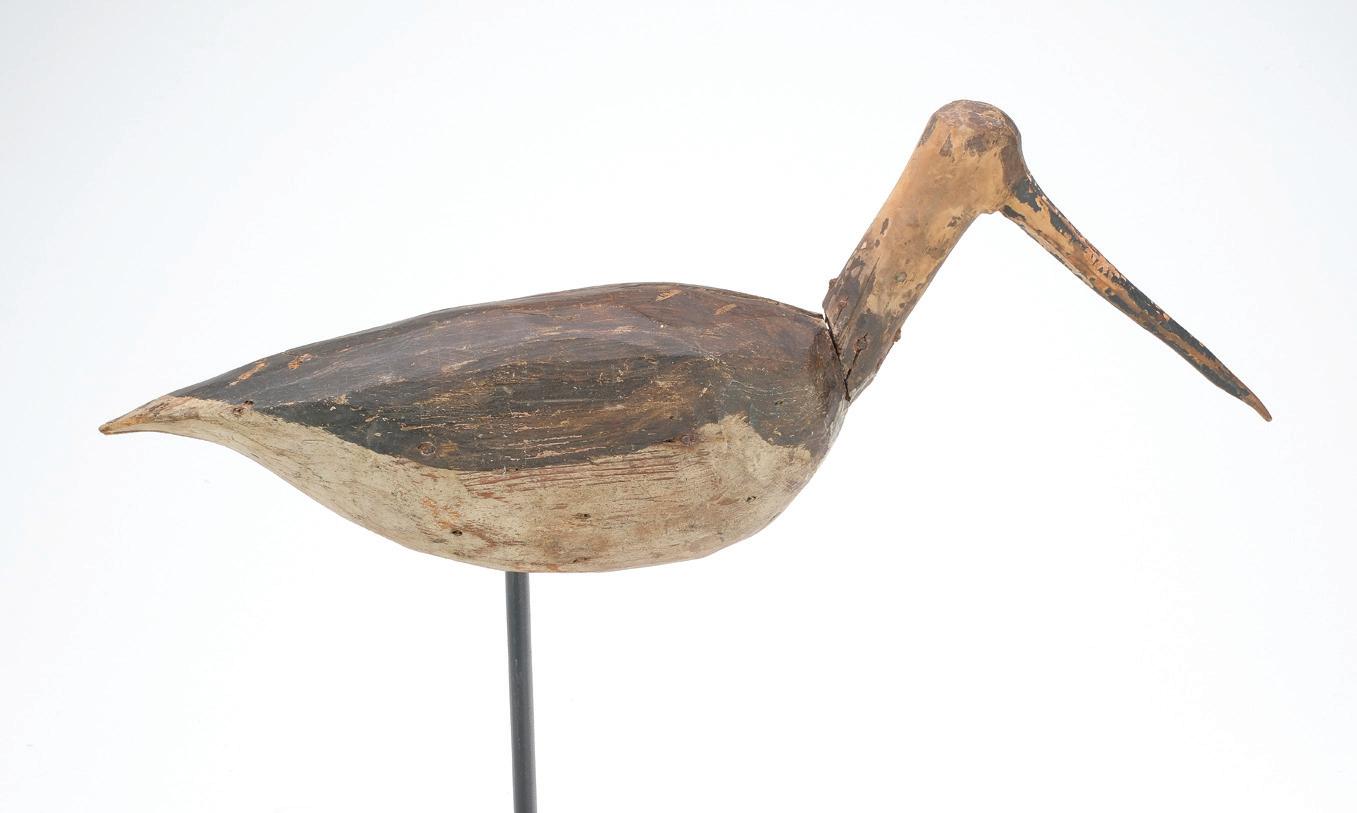
(1,200 - 1,800)

185 187 186 188
189 Widgeon, Ivey Stevens, Back Bay, Virginia, 1st quarter 20th century. Measures 15.25” long. Early in use repaint with moderate flaking and wear; hairline drying cracks in breast; very lightly hit by shot; the original bill was cracked down and tightly reset with small amount of filler added to a small chip.
(1,200 - 1,800)
190 Brant, Gary Bragg, Ocracoke, North Carolina, 2nd quarter 20th century. Used at the Green Island Hunt Club. Measures 19.5” long. Original paint with minor to moderate wear; area of roughness on one lower side and tail; minor roughness on tip of bill with small amount of touchup.



(1,200 - 1,800)
191 Canvasback, Avery Tillet, Kitty Hawk, North Carolina. Canvas over wire frame, with wooden bottom board that has “RA” carved in it for the rig of James Quidley and Ross Allen. Measures 18.5” long. Original paint with moderate flaking and wear; some tears in canvas, mostly at metal ribs; old crack through neck with a few small nails added to secure.
Provenance: Mark and Ann Terry collection.
(500 - 800)
192 Coot, Gallop Brothers, North Carolina, 2nd quarter 20th century. Lath turned head and neck with applied canvas bill. Measures 9” long. Original paint with moderate wear; tight drying cracks in body; split in the underside.
(500 - 800)
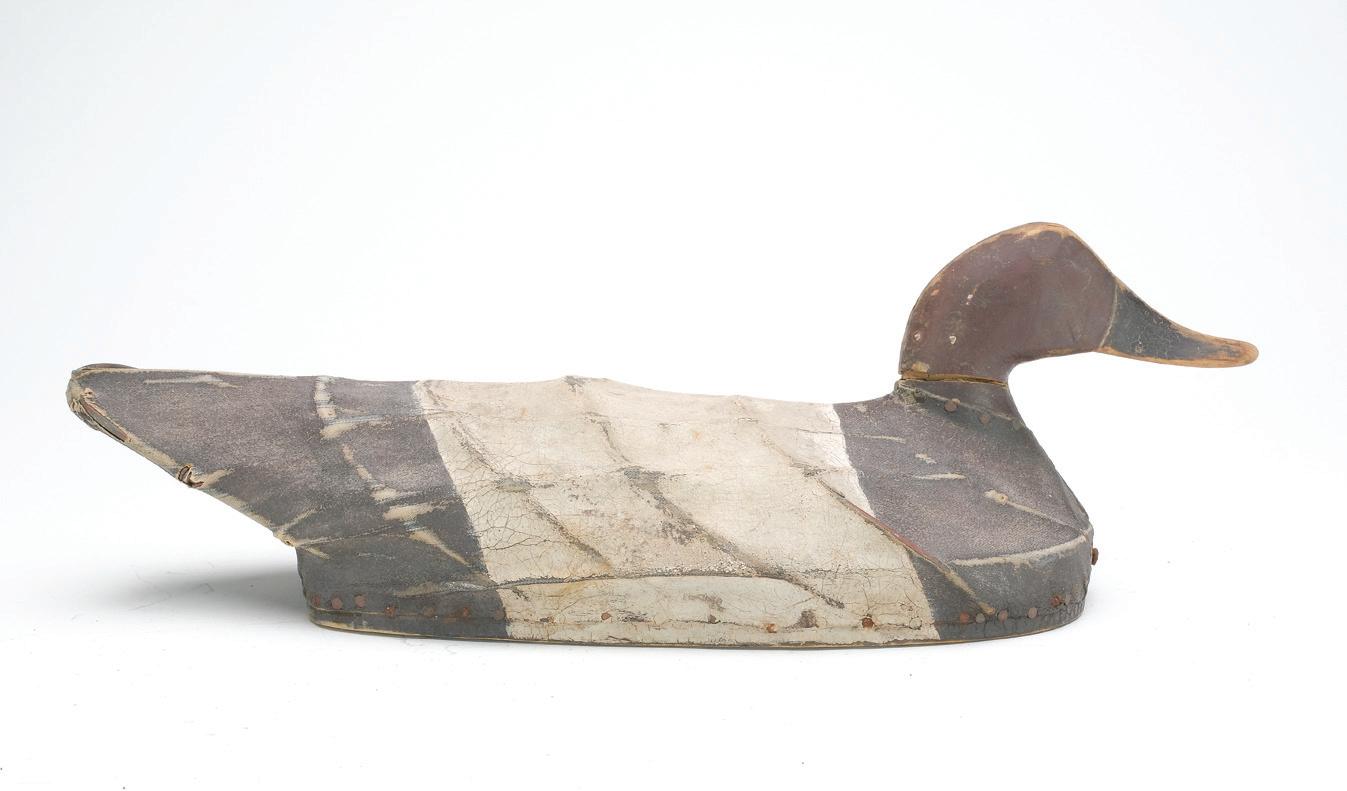
131
189 191 190 192
193 Bluebill, Albin Aydlett, Spot, North Carolina, 2nd quarter 20th century. Measures 13.25” long. Old overpaint was taken down and the surface strengthened; professional neck crack repair; otherwise good structurally.
(800 - 1,200)
194 Brant from Wanchese, North Carolina, 2nd quarter 20th century. Measures 18.25” long. In use repaint with moderate flaking and wear; tight drying cracks in body; moderately hit by shot in one side; minor roughness on edge of tail




(1,200 - 1,800)
195 Redhead, Albin Aydlett, Spot, North Carolina, 2nd quarter 20th century. Measures 15.5” long. Original paint with minor wear; hairline crack along the back.
(1,200 - 1,800)
196 Redhead, John Austin, Corolla, North Carolina. Weight has been removed. 15” long. Paint has been restored; head has been off and possibly an old replacement.
(800 - 1,200)
193 195 194 196
197 Rocking head black duck, Gus Wilson, South Portland, Maine, circa 1930. With carved eyes, carved bill delineation, and relief wing carving. Measures 18.25” long. Near mint original paint; hairline crack partway down the back; a few tiny rough spots on edge of tail.
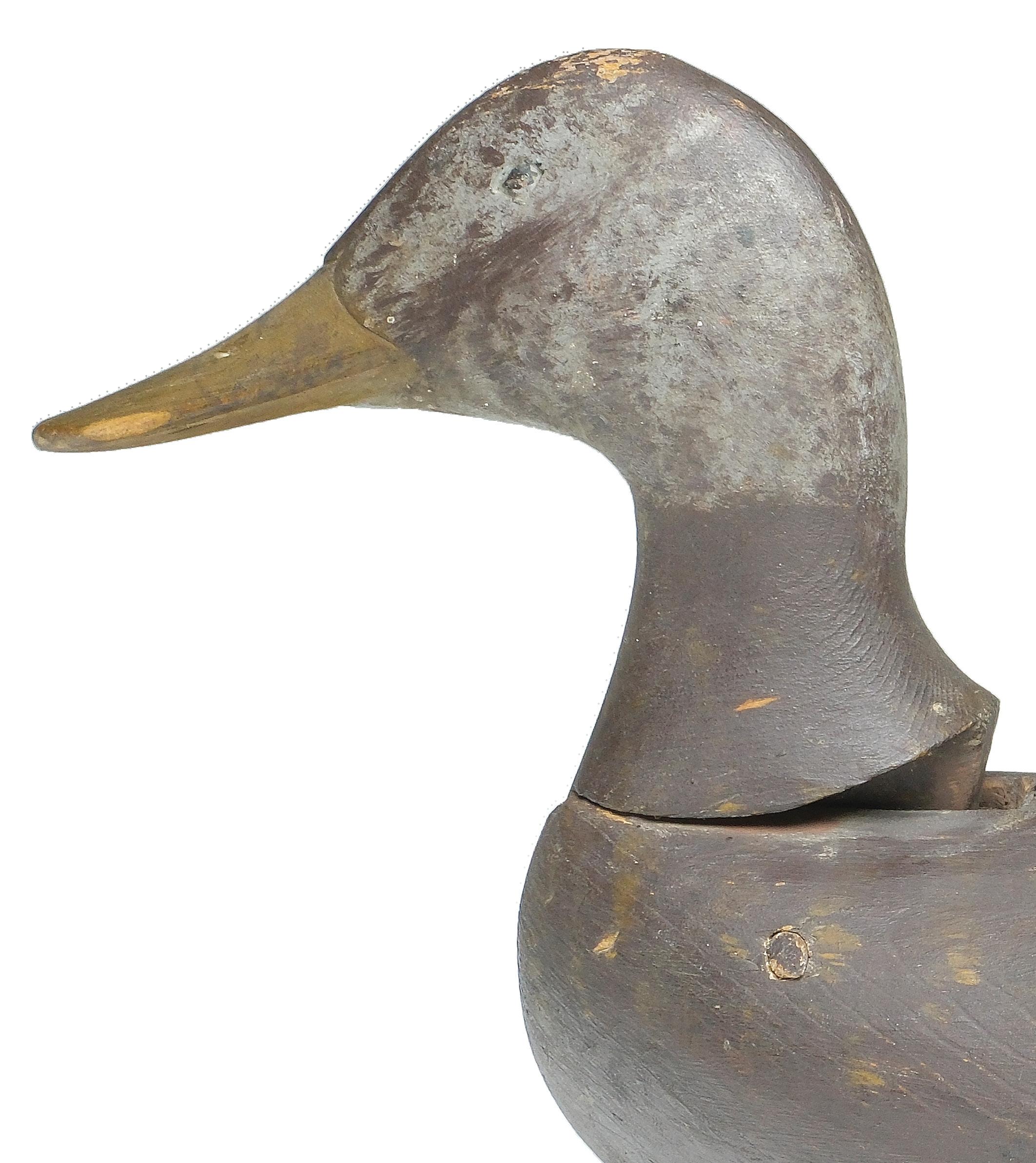
Literature: “New England Decoys,” John and Shirley Delph.

Wilson
- 1950 | South Portland, Maine
Gus
1864
198 Red breasted merganser, George Huey, Friendship, Maine, 2nd quarter 20th century. Inlayed neck seat with extended crest and carved eyes. Relief wing carving. Measures 18” long. Mostly original paint with minor wear; protected under an early coat of varnish; lightly hit by shot; shot marks have been touched up with a few being filled; small gouge on one side of breast with touchup; roughness on underside of bill with touchup.

(2,000 - 3,000)
199 Sculptural eider, Gus Wilson, South Portland, Maine, 1st quarter 20th century. Two piece vertically laminated body with large inlayed neck seat. Measures 18” long, and 9.75” wide. Head is a professional replacement circa 1970s; paint was restored at that time; multiple drying cracks and splits. (2,000 - 4,000)
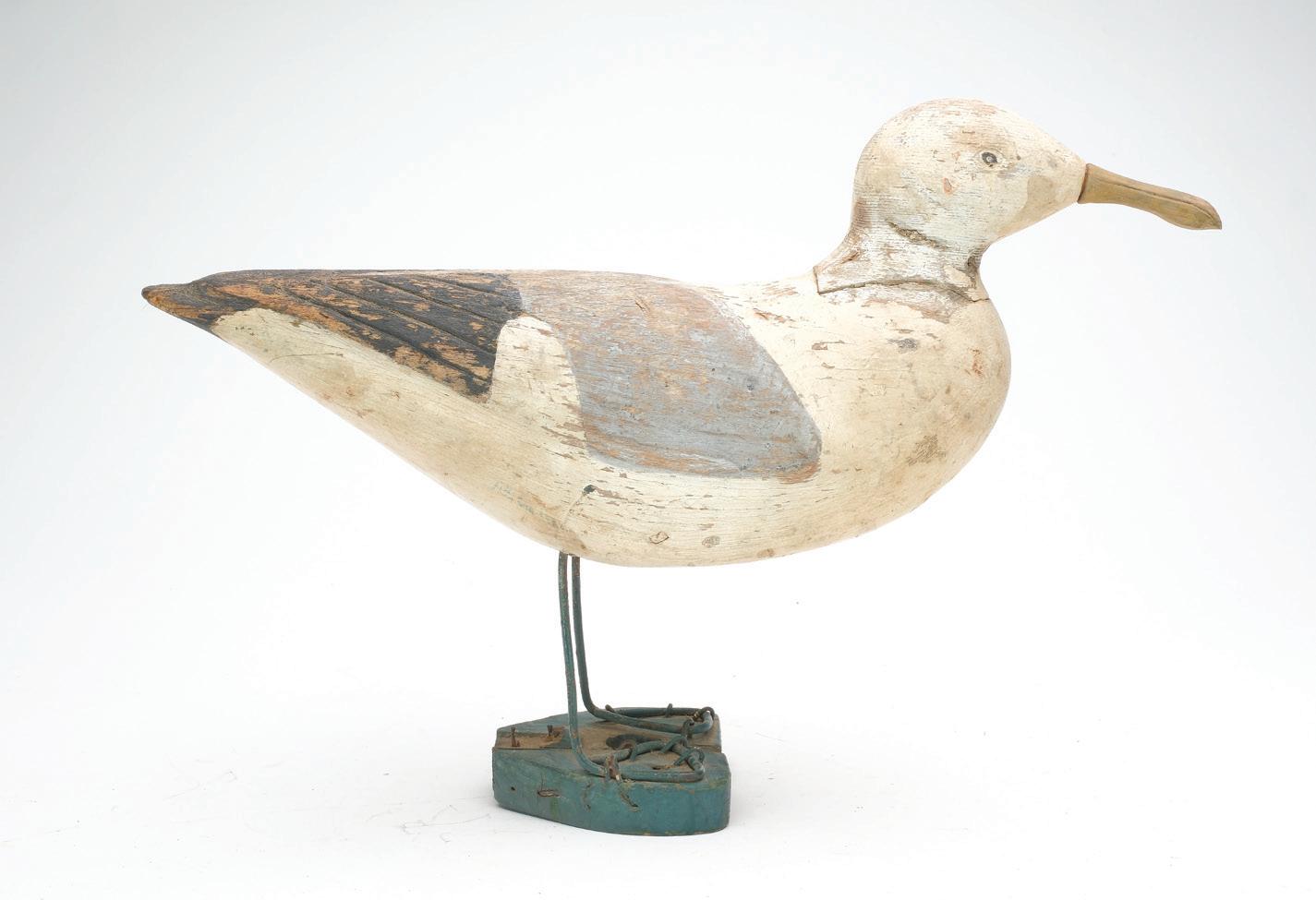
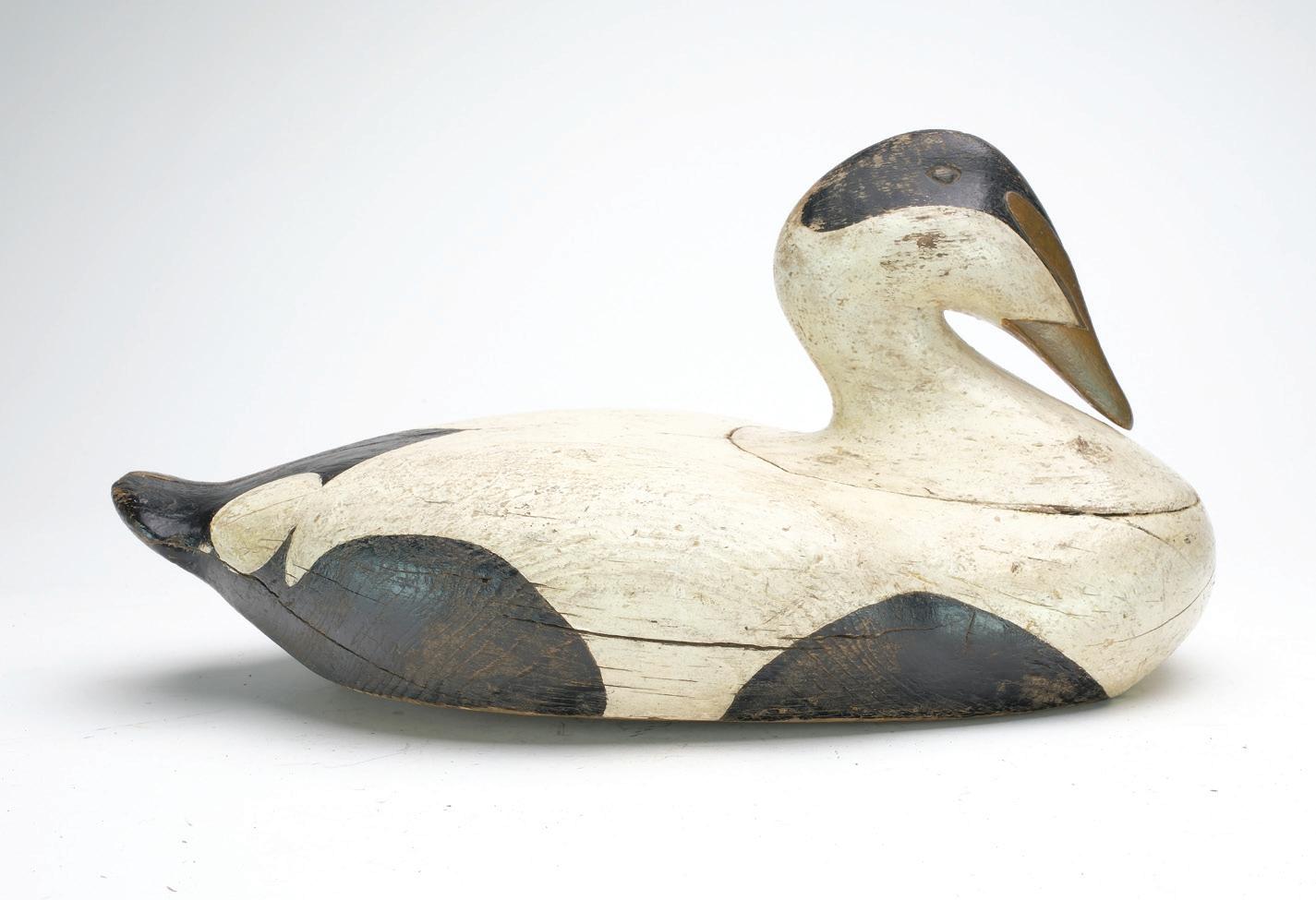
200 Standing gull, Gus Wilson, South Portland, Maine. Relief wing carving and inlayed neck seat. Carved eyes. Wilson made these as fence post toppers or porch railing ornaments. Tim Eastland collection ink stamp on underside of wood base. Measures 18.25” long. Original paint on wings and back; white areas with an early second coat; shows moderate to significant flaking and wear; old chip in tail; tight drying cracks; bill is a later replacement and is doweled in to face.
Provenance: Timothy Eastland collection.
(2,000 - 3,000)
134
198 199 200
eyes. Measures 26” long. Original paint that has darkened with age; minor to moderate gunning wear; minor chipping and roughness on tip of bill; tight crack in tail; minor roughness on edges of tail; small spots of touchup on canvas near breast.
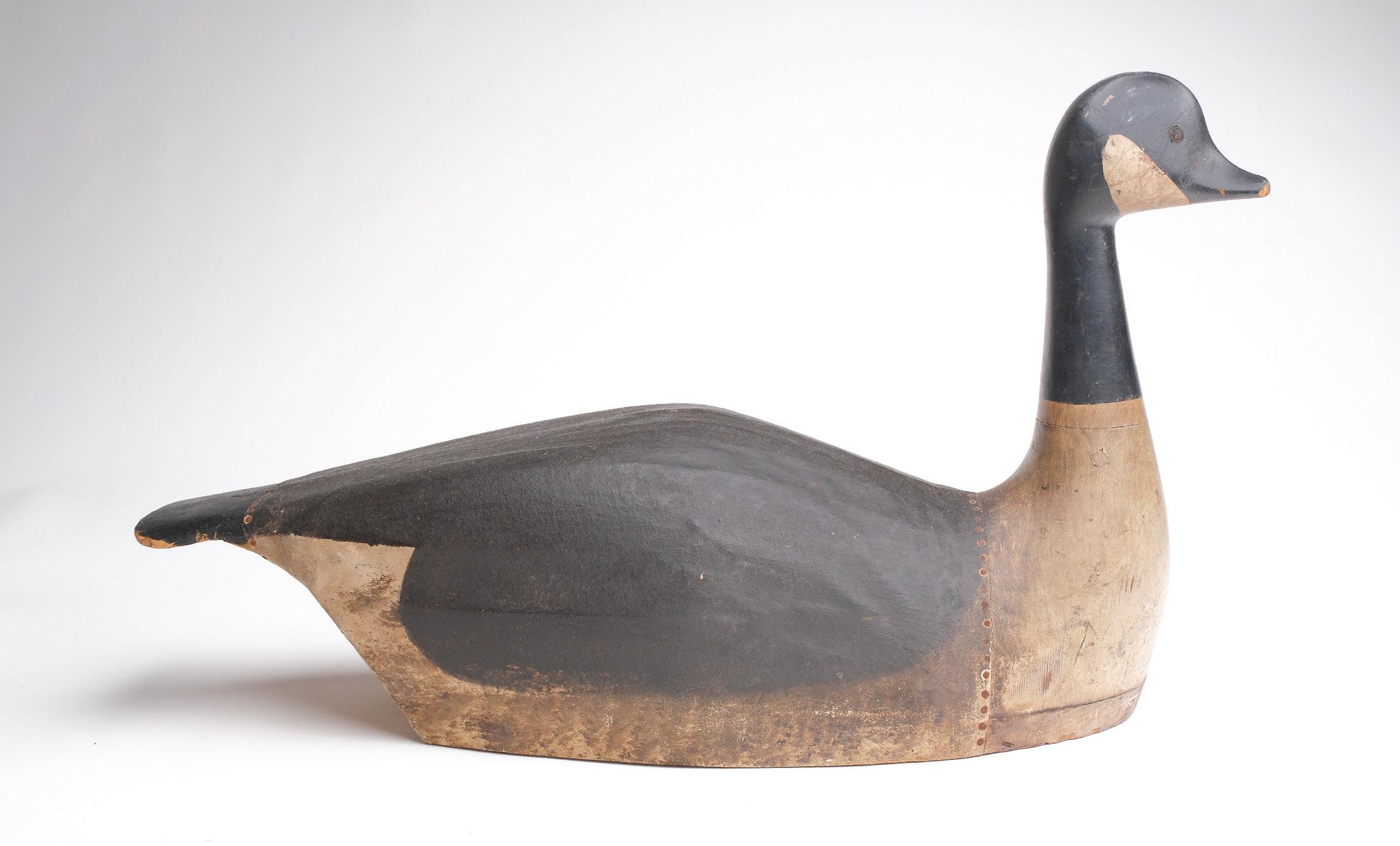
and round inlayed lead weight on the underside. Roberts collection sticker on the underside. Measures 14.25” long. Original paint with very minor crazing and wear; a few small spots of touchup on body and top of bill; excellent structurally. (2,000 - 3,000)

135
201 Canada goose, George Boyd, Seabrook, New Hampshire. Canvas over wood slat construction. Tack
Provenance: David Fannon collection. (4,000 - 6,000)
201 202
202 Redhead, Keyes Chadwick, Oak Bluffs, Martha’s Vineyard, Massachusetts. Slightly turned head
203 Scoter, Joseph Lincoln, Accord, Massachusetts, 2nd quarter 20th century. Canvas over wood slat construction. Measures 18.25” long. Original paint with minor gunning wear; two shot strikes on one side of neck; puppy chews with roughness on tip of bill; thin wash of black paint on head and neck.
Provenance: Joel Barber collection.
(1,200 - 1,800)
204 Early redhead hen, Keyes Chadwick, Oak Bluffs, Marthas Vineyard, 1st quarter 20th century. Tucked and reared back head. Inlayed lead weight on the underside. Measures 15.5” long. Original paint with moderate to significant flaking and wear; hairline crack along the underside; otherwise very good structurally.
(1,000 - 1,500)
205 Rigmate pair of goldeneye, Friendship, Maine, 1st quarter 20th century. Inlayed neck seats and carved eyes. Measure 13.5” long. Original paint with moderate gunning wear; some rust staining on underside and breast of hen; some darkening to flaking around drake’s tail and along one side; both are good structurally.


(800 - 1,200)

136
203 204 205
206 Goldeneye hen, Alan Stewart, Martha’s Vineyard, Massachusetts, 1st quarter 20th century. Slightly forward head pose with carved eyes. Measures 15.25” long. Original paint with moderate wear; small dents in body; tight drying crack in breast; minor roughness on top of head; half of the bill is professionally replaced. (1,500 - 2,500)
207 Merganser hen, Marblehead, Massachusetts, 1st quarter 20th century. Very sleek body. Hollow carved from the back. Tack eyes and wooden keel typical of Marblehead. Measures 17.5” long. Old over paint was stripped down and strengthened showing moderate wear; lightly hit by shot; repair to the base of neck. (800 - 1,200)
208 Hollow carved merganser, Frank Adams, West Tisbury, Martha’s Vineyard, Massachusetts. Hollow carved with .5” bottom board, raised neck seat, and carved eyes. “WP” branded on the underside for Winward (“Bud”) Prescott, Swansea, Massachusetts. Measures 18.5” long. Original paint with moderate to significant flaking and wear; rust spots at nails in bottom board; crack in neck where head was off and reglued.


Provenance: Timothy Eastland collection. (1,200 - 1,800)

137
206 207 208
209 Rigmate pair of Massachusetts mallards. Both have side pocket carving and a soft paint texture. 16” long. Original paint with some flaking, possibly from heat exposure to head of each; a few small rubs; small rough area on hen’s tail.
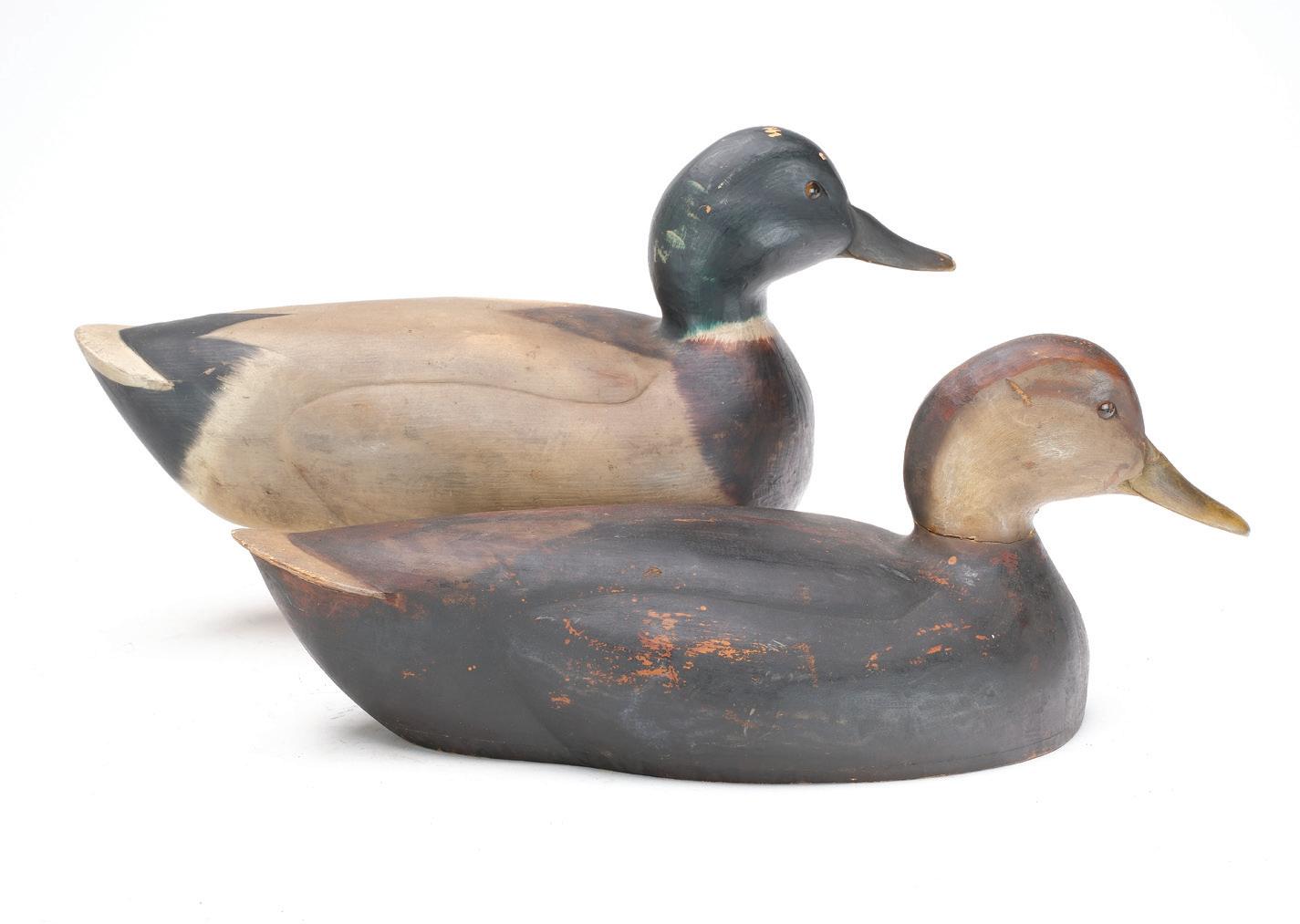
(1,250 - 1,750)
210 Pair of hooded mergansers, R.G. Jansson, Cape Cod, Massachusetts. Decorative carvings with relief wing and tail feather detail. Carved, extended crests. Maker’s brand on the underside. Dated 1963. Measure 14.75” long. Original paint with very minor wear under an uneven coat of varnish that has darkened slightly with age. (800 - 1,200)



211 Rigmate pair of Canada geese, Alfred Gardner, Hingham, Massachusetts. Gardner was a gunning partner of Joseph Lincoln. Both have leg holes drilled for field or beach use. Tack eyes. Feeder measures 32” in length. Both are in original paint with very light wear; spider droppings some of which can be cleaned away; feeder has small break areas at base of neck and old split in body which has probably been there since it was made.
(800 - 1,200)
138
209 210 211 211
Lou Rathmell
1898 - 1974 | Stratford, Connecticut
212 Excellent sleeping black duck, Lou Rathmell, Stratford, Connecticut, 2nd quarter 20th century. Cork body with inserted cedar tail and head turned back and resting on body. Scratch feather paint detail on head and neck. Inlayed lead weight on the underside is stamped with the maker’s name and dated 1941. Measures 16.75” long. Original paint with very minor wear; a few tiny dents, otherwise excellent structurally.

 (6,000 - 9,000)
(6,000 - 9,000)
213 Sleeping black duck, Stratford, Connecticut, 1st quarter 20th century. Balsa body with slight relief wingtip carving. Scratch feather paint detail on head. Stratford style weight has been removed. Measures 14.75” long. Original paint with moderate gunning wear; multiple small dents in balsa; a few shot marks in face and bill were filled and touched up; minor roughness on edge of tail; two spots on one side of body have been darkened.


Provenance: Timothy Eastland collection. (1,200 - 1,800)
214 Pair of American mergansers, Sam Collins, Essex, Connecticut. Long neck seats and painted eyes. Measure 17.5” and 19.5” long. Mix of original and early in use repaint; showing moderate flaking and wear; cracks in necks; chip in each bill; splits in the underside of hen; chipping and roughness on hen’s tail; hairline crack in hen’s bill.
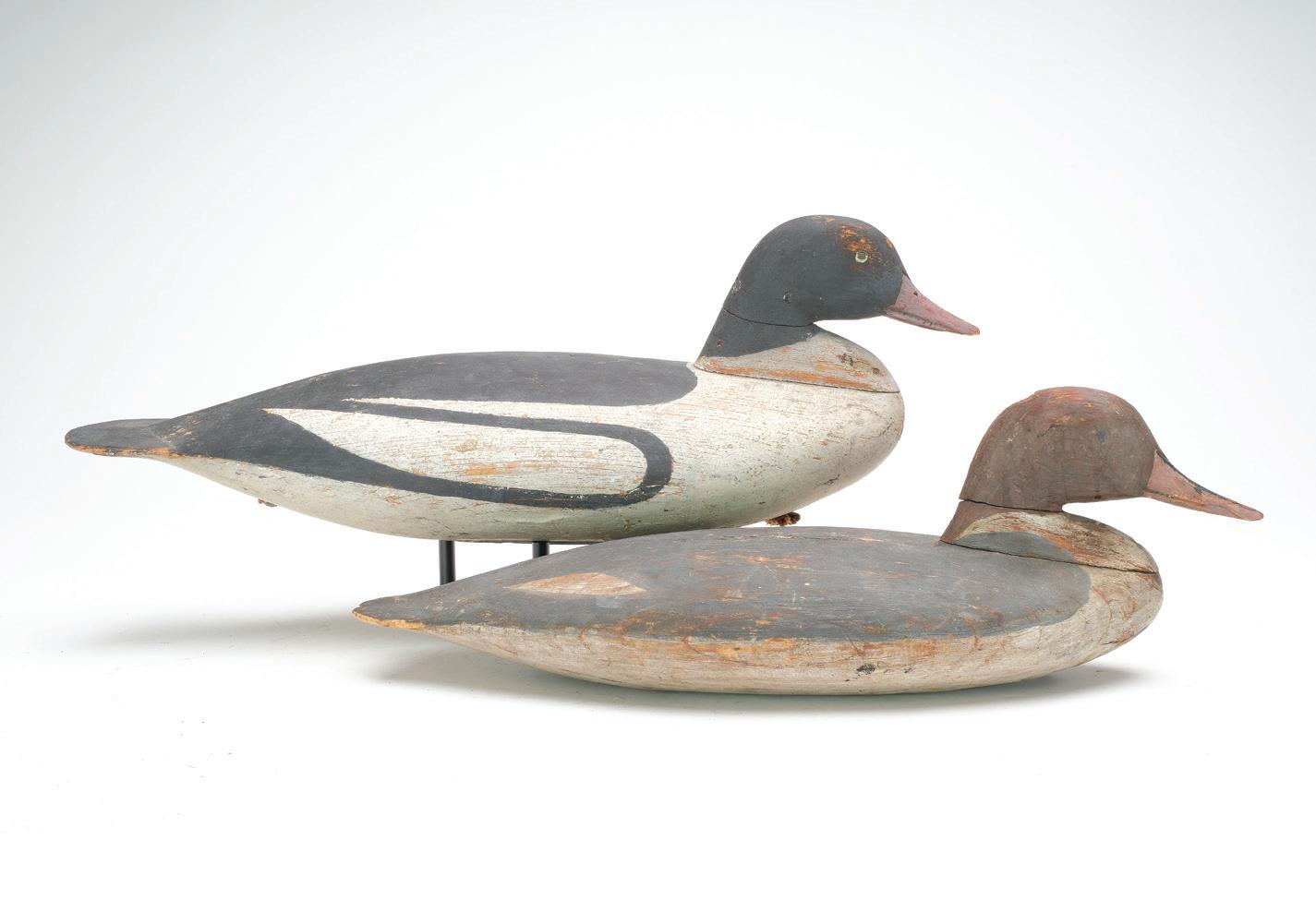
Provenance: Timothy Eastland collection. (800 - 1,200)
215 Hollow carved black duck, Roy Collins, Portland, Connecticut, circa 1930s. Slightly turned and feeding head pose with raised wingtips and relief carved side pockets. Measures 15.75” long. Original paint with moderate wear; down to some bare wood; minor roughness on raised wingtips; crack through neck.
Provenance: Timothy Eastland collection. (1,200 - 1,800)
140
213 214 215
216 Sleeping mallard, Ted Mulliken for Wildfowler Decoy Company, Old Saybrook, Connecticut, 2nd quarter 20th century. Balsa body with head turned and bill partially inlet into the back. Old Saybrook stamp on the underside. Measures 14” long. Excellent original paint with very little wear; a few small dents and scratches, otherwise excellent structurally.
Provenance: Timothy Eastland collection.
(600 - 900)
217 Hollow carved black duck, Stratford, Connecticut, 1st quarter 20th century. Hollow carved with extensive incised feather carving and tack eyes. Measures 16.5”. Mostly original paint with some filler and touch up along body seam, and at a crack that runs around the breast; slight blunting to tail; some wear along one edge of bill; hairline crack in bill; slight separation at body seam.
Literature: “Connecticut Decoys”, Henry C. Chitwood, page 131, rigmate pictured.
(600 - 900)
218 Sleeping black duck from Connecticut, 1st quarter 20th century. Carved from a single piece of wood with head turned and resting on the back. Tack eyes. Measures 14” long. Paint has worn down to mostly bare wood; multiple dents and shot marks; chip in top of head.

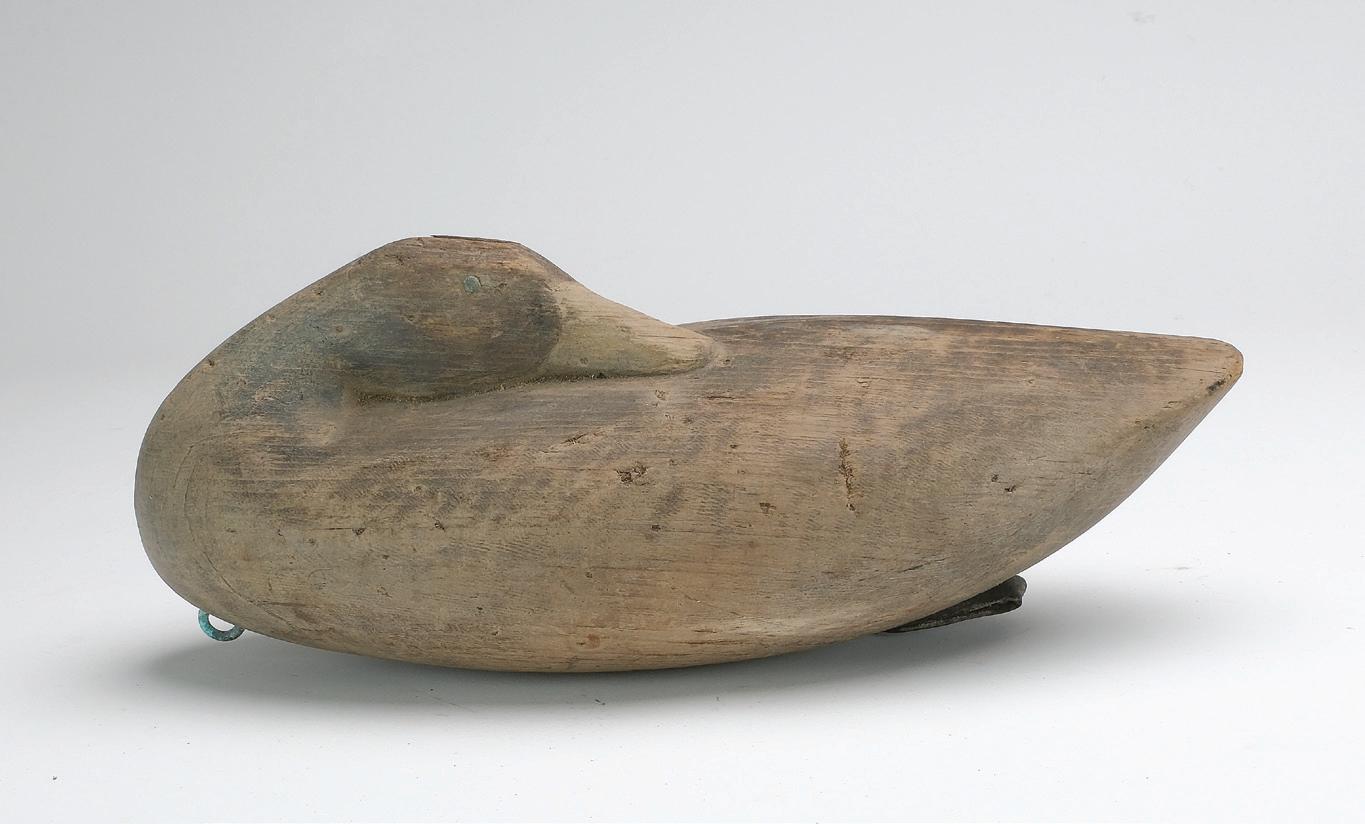


Provenance: Timothy Eastland collection.
(500 - 800)
219 Goldeneye drake, James G. Hurlburt, Connecticut River area, Connecticut, last quarter 19th century. Slight ice groove carving behind neck seat. Detailed bill and eye carving. Pencil writing on wing. In talking about a rigmate to this decoy in his book “Connecticut Decoys”, author Henry Chitwood describes it as being “The best looking decoy from the Connecticut River region known to the writer”. Measures 15” long. Mix of original and thin in use repaint with minor wear; very good structurally.
Provenance: Timothy Eastland collection.
Literature: “Connecticut Decoys: Carvers and Gunners”, Henry C. Chitwood, page 152, rigmate with the same pencil writing pictured.
(600 - 900)
216 218 217 219
Shorebird Decoys


Elmer Crowell
1862 - 1952 | East Harwich, Massachusetts
220
Rare dowitcher, Elmer Crowell, East Harwich, Massachusetts, circa 1890s. Up-looking head pose and split tail carving. Fine paint detail and shoe button eyes. Measures 12” long. Original paint with very slight wear and good patina; thin line of touchup at a crack in the neck; minor blunting at tip of raised wing tips.

Literature: New England Decoys,” John and Shirley Delph. (25,000 - 35,000)
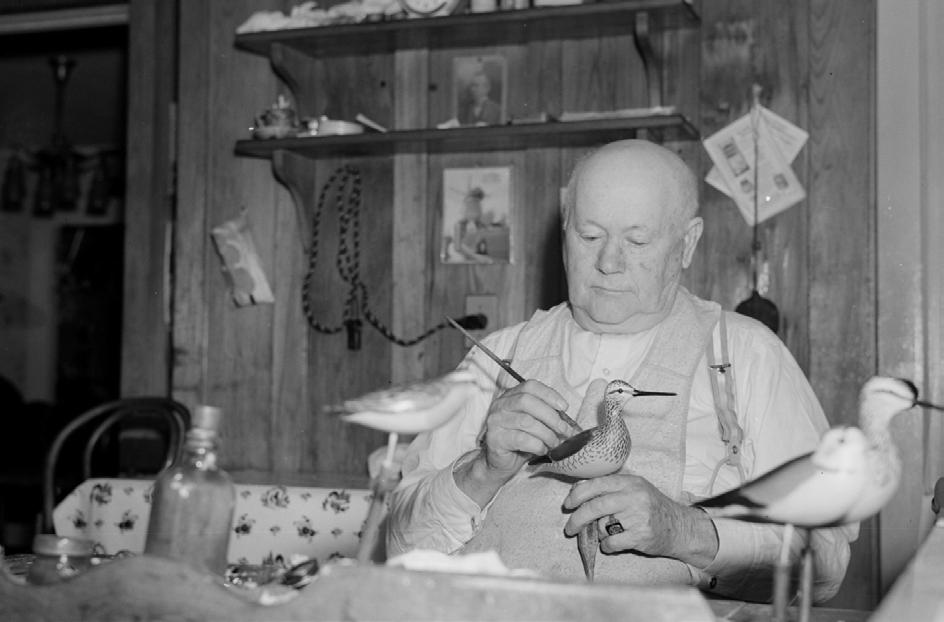
eyes with split tail. Measures 13” long. Original paint that has worn down through moderate use; several shot scars; possibly a very small amount of old restoration around shoulder groove on each side.
Feeding pose with relief wing carving and raised wingtips. Measures 13” long. Original paint with very minor wear; protected under a thick and uneven coat of varnish; very good structurally. (5,000 - 8,000)


144
221 Feeding yellowlegs, Elisha Burr, Hingham, Massachusetts, 1st quarter 20th century.
221a Yellowlegs, Lothrop Holmes, Kingston, Massachusetts, last quarter 19th century. Tack
(4,000 - 6,000)
222 Early willet from Rhode Island, last quarter 19th century. Very similar to those by Newton Dexter and Dr. Clarence Gardner. In running pose with relief wing carving and raised wingtips. Measures 12.5” long. Original paint with very minor wear under an early coat of varnish that has darkened slightly; a few shot marks and small dents; professional bill crack repair.


(4,000 - 6,000)
223 Yellowlegs from Massachusetts, last quarter 19th century. Deep relief wing carving and raised wingtips. Inventory number and “GNG” in ink near stick hole for the collection of Gary Giberson. Measures 10” long. Original paint with minor wear; very small dents in breast; bill is a professional replacement; repair to half the tail.
(2,000 - 3,000)
145
224 Excellent black bellied plover, George Boyd, Seabrook, New Hampshire, 1st quarter 20th century. Slightly forward head pose with tack eyes and split tail carving. Muller collection ink stamp on underside. Measures 11.25” long. Original paint that has darkened slightly with age; very minor gunning wear; small blunt in bottom tip of tail.

Provenance: Dr. Peter Muller collection. Private Rhode Island collection. (6,000 - 9,000)
224A Group of five plovers, Cape Cod, Massachusetts, last quarter 19th century. All with raised wingtips. Three have been hollowed from the underside for use as windbirds. Measure from 10.25” to 11.25” long. Original paint with significant gunning wear; multiple dents and shot marks; chipping and roughness on edges of tails and raised wingtips; split along the underside of one; one has had the head broken off and reattached; one has had its head broken off and replaced by the maker; two bills appear replaced.
Provenance: David Fannon collection. (4,000 - 6,000)

146 224 224a
225 Black bellied plover, George Boyd, Seabrook, New Hampshire, 1st quarter 20th century. In winter plumage with split tail carving and metal tack eyes. Measures 11.25” long. Original paint with minor wear; surface has darkened with age; bill is an early replacement.


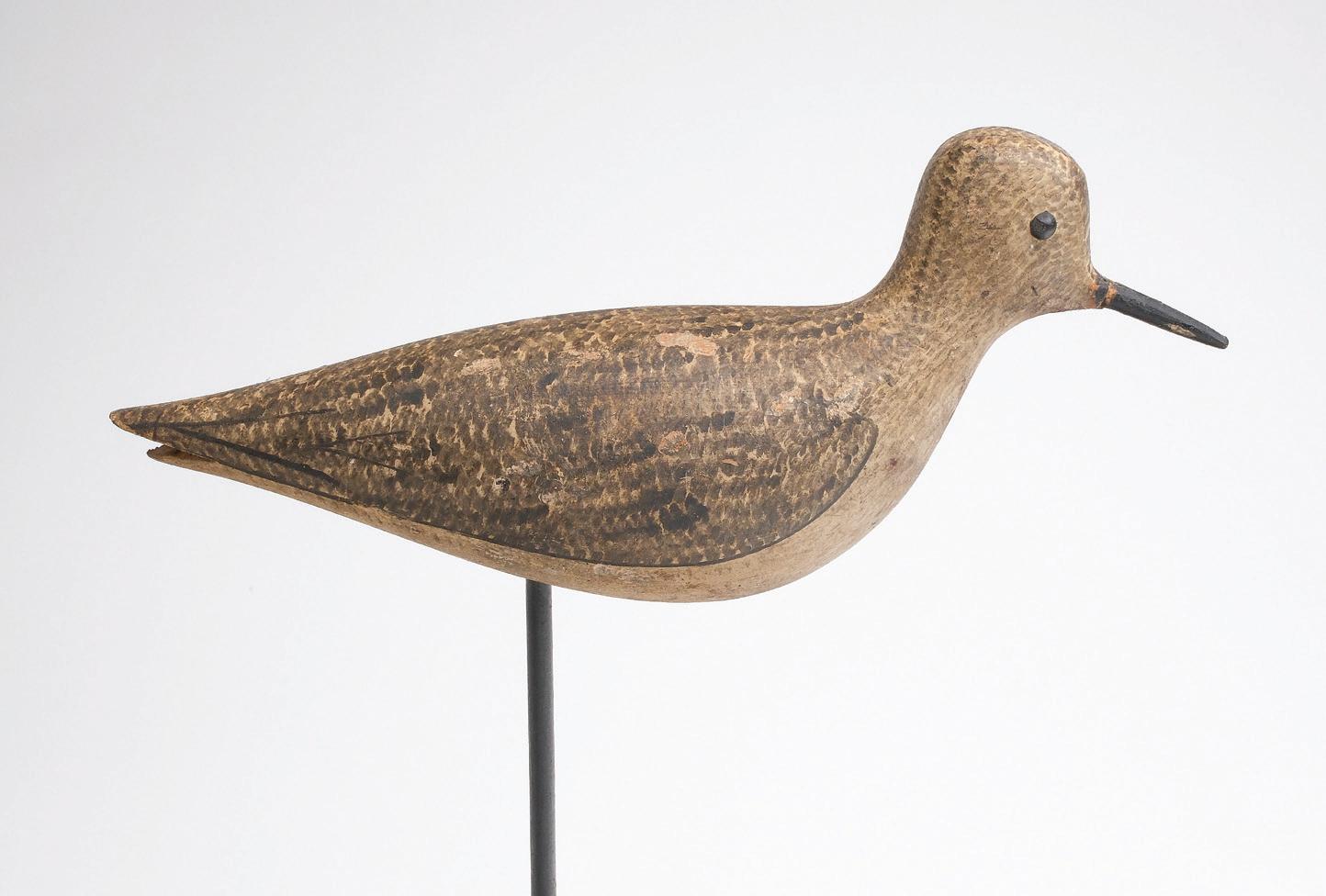
Provenance: David Fannon collection. (2,000 - 3,000)
226 Two yellowlegs, George Boyd, Seabrook, New Hampshire, 1st quarter 20th century. Split tail carving and metal tack eyes. Measure 11.25” long. Original paint with minor wear; under an early coat of varnish that has darkened with age; one is moderately hit by shot in breast and head; tight cracks in each head and one neck; drying split along the underside of one; one with 3/4 of bill professional replaced.
Provenance: David Fannon collection. (3,000 - 5,000)
227 Yellowlegs, George Boyd, Seabrook, New Hampshire, 1st quarter 20th century. Split tail carving and metal tack eyes. Measures 9.75” long. Original paint with minor wear protected under an early coat of varnish that has darkened with age; lightly hit by shot; hairline crack through neck; approximately half the bill is missing; drying crack along the underside.
Provenance: David Fannon collection. (1,500 - 2,500)
147 225 226 227
228 Large willet, Charles Thomas, Assinippi, Massachusetts, 1st quarter 20th century. Deep relief wing carving and large tack eyes. Measures 15” long. Original paint with minor wear under a thin coat of heavily crazed varnish; a few shot strikes.



(2,500 - 3,500)
229 Three piece yellowlegs from the south shore of Massachusetts, 1st quarter 20th century. Similar in form to those by Charles Thomas. Relief wingtip carving and glass bead eyes. Measures 12” long. Original paint with minor gunning wear; reglued crack in bill; thin coat of varnish has crazed slightly.
(1,200 - 1,800)
230 Plover in winter plumage, Massachusetts, 1st quarter 20th century. Split tail carving and large brass tack eyes. Measures 10.25” long. Original paint with minor wear; small chip in one side; the bill is a professional replacement with some restoration where bill meets the face.
Provenance: David Fannon collection.
(600 - 900)
148
228 229 230
231 Golden plover, Coffin family, Nantucket, Massachusetts, last quarter 19th century. Two piece head and body with polka dot paint detail. Measures 9.5” long. Original paint with very minor wear; original bill was glued tightly with small amount of glue visible in seam; very minor roughness on edge of tail.
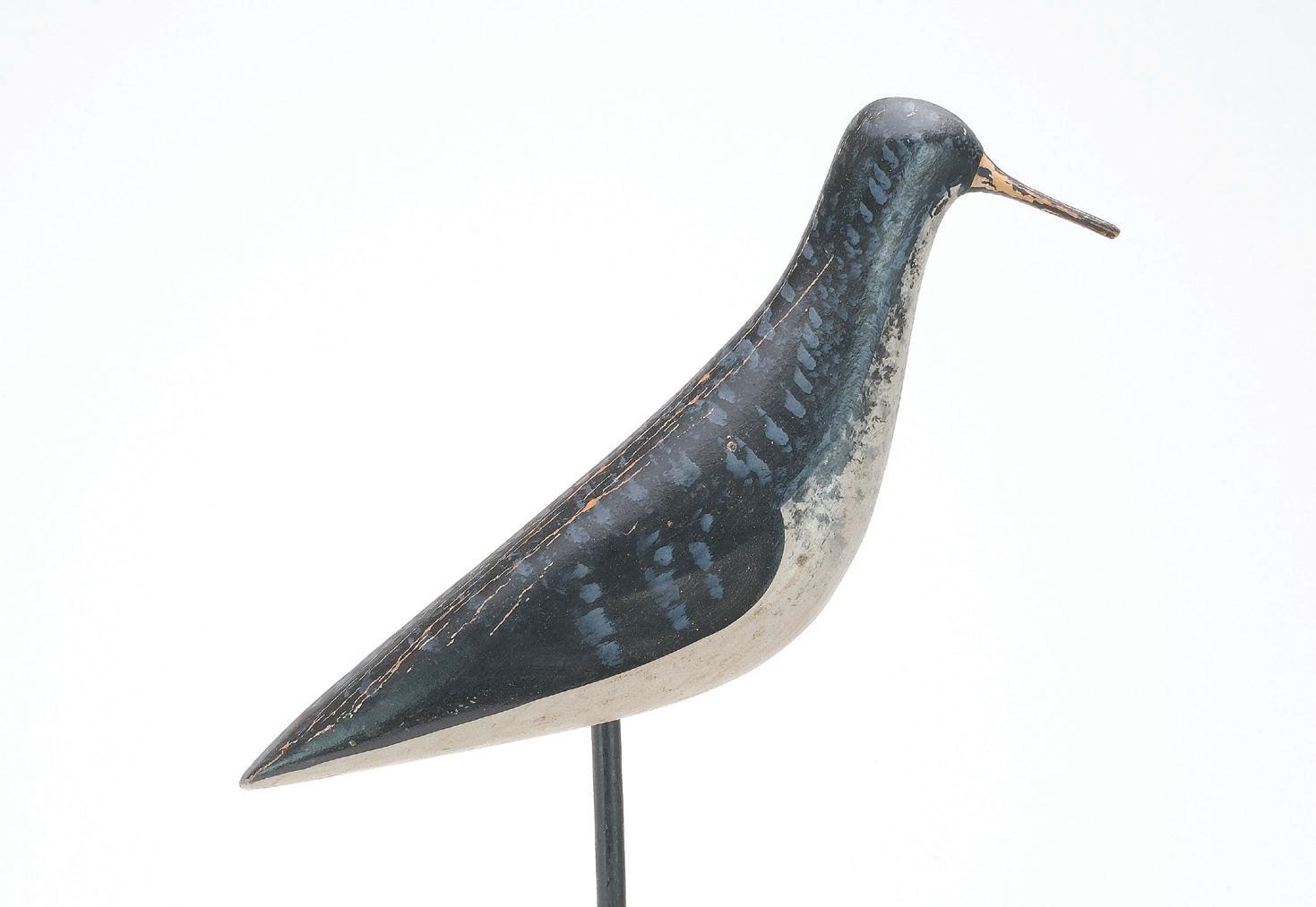

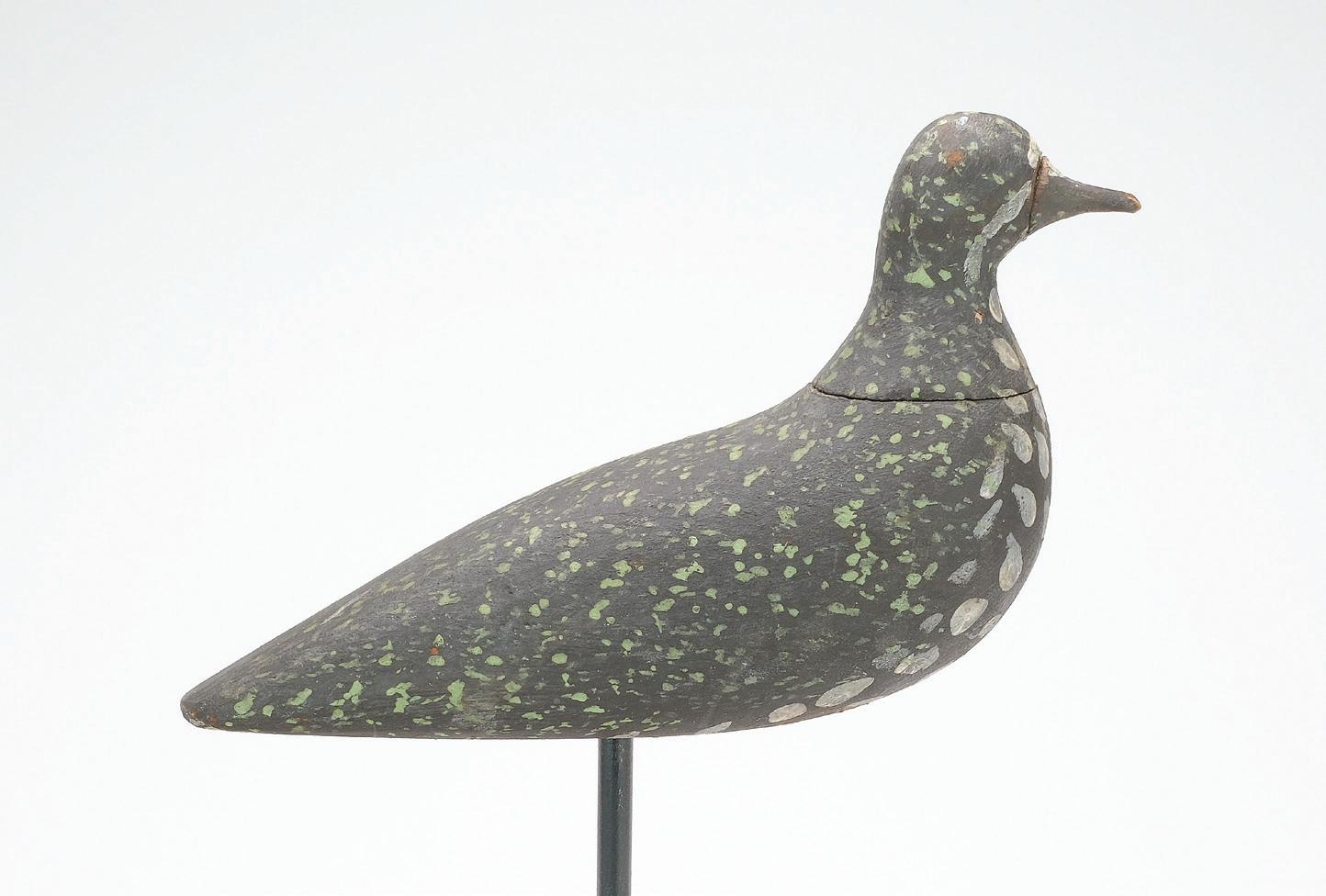
Provenance: Timothy Eastland collection.
(800 - 1,200)
232 Pair
David Goodspeed, Duxbury, Massachusetts, circa 1900. Carrying holes drilled through tails. Measure 8” long. Original paint with minor wear; moderate flaking on the undersides and on hardwood bills; chip in tip of one bill.
(1,200 - 1,800)
233
Frank Adams, Martha’s Vineyard, Massachusetts, 1st quarter 20th century. Measures 9.25” long. Original paint under a thin coat of varnish; with minor flaking along back; significant paint flaking on hardwood bill.
(600 - 900)
149
of sanderling,
Plover,
233
231 232
Oscar Peterson
1887 - 1951 | Cadillac, Michigan
233a Relief carved wall plaque of a great horned owl, Oscar Peterson, Cadillac, Michigan, 1st quarter 20th century. With carved, painted, yellow eyes. Perched in a tree. Peterson’s metal strapping along the backside, as well as top and bottom edges of plaque. Carved down from a board that measures 1.5” thick. this is the largest owl plaque known to have been made by him, measuring 26.25” x 11.5”. Excellent original paint; protected by a coat of varnish that has crazed to create a very appealing surface; in additional to the paint decoration on this Peterson has added his aluminum flake decoration to enhance the surface.
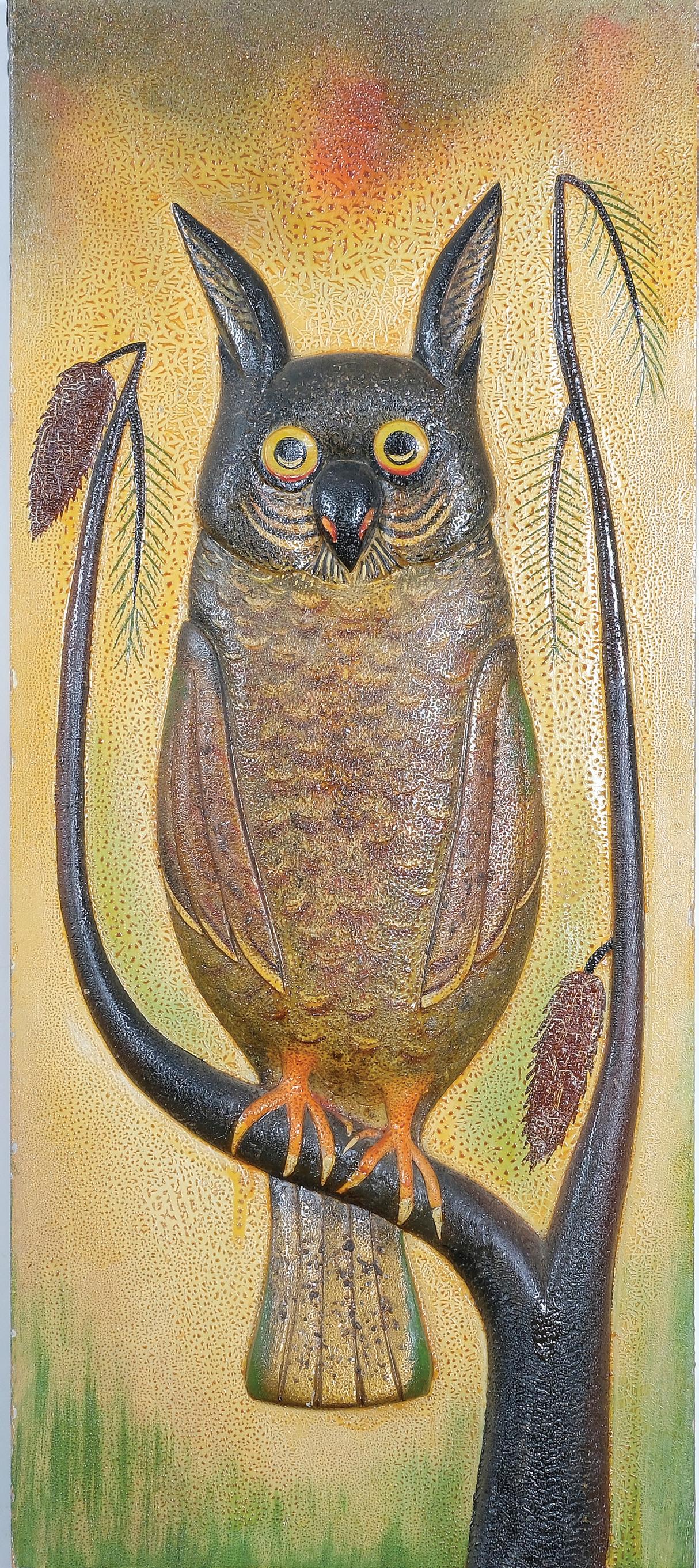
Provenance: David Fannon collection. (10,000 - 15,000)

150
233b Rare and one of only three or four known tadpole spearing decoys, Oscar Peterson, Cadillac, Michigan, 1st quarter 20th century. Tack eyes. Carved mouth and metal fins. Measures 5.5” long. Strong original paint; small amount of loss at fins and belly weight.

Provenance: Ex Collection Allister Martin. (10,000 - 15,000)
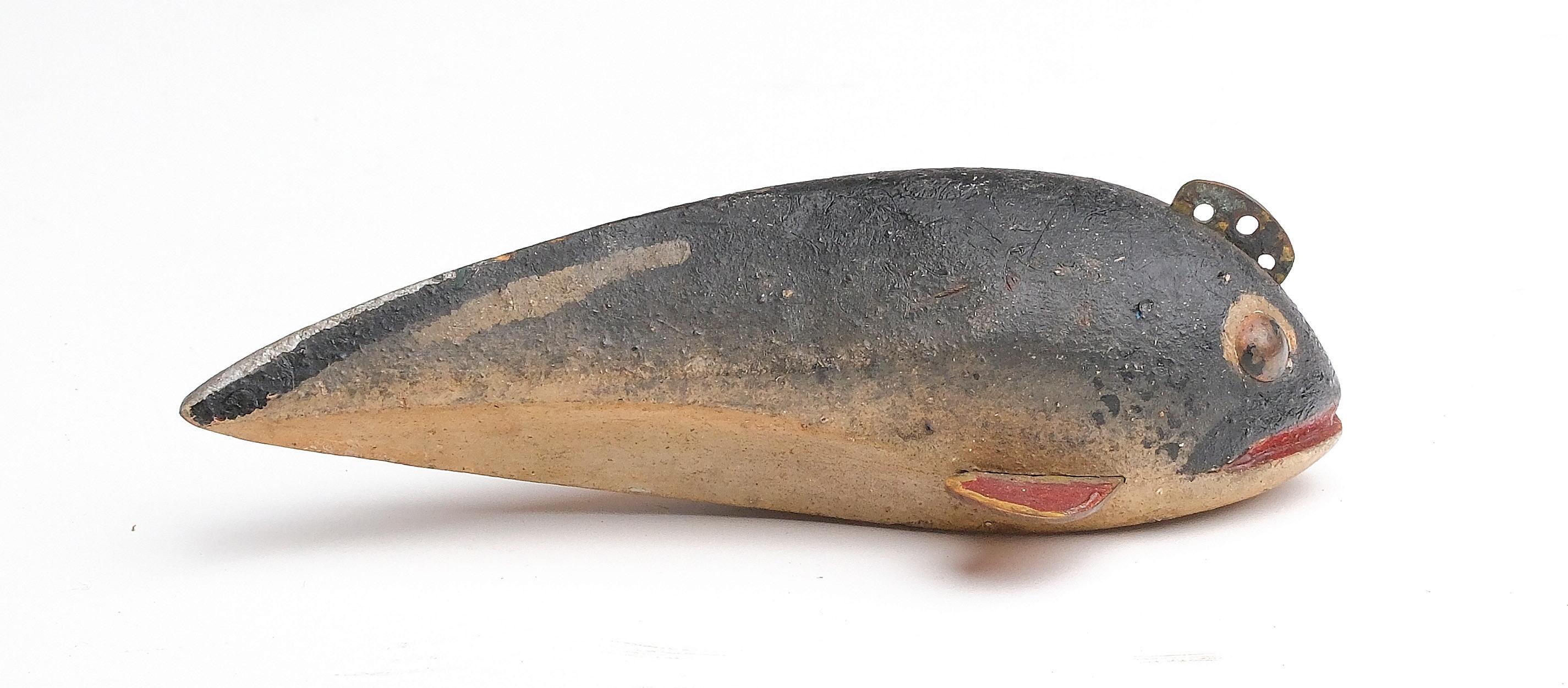
151
233C Brown trout, Oscar Peterson, Cadillac, Michigan, 2nd quarter 20th century. Dome painted, tack eyes. Measures 7” x 1” high x .5” wide. Paint flaking mostly off top of one fin, otherwise original protected by a light coat of varnish.
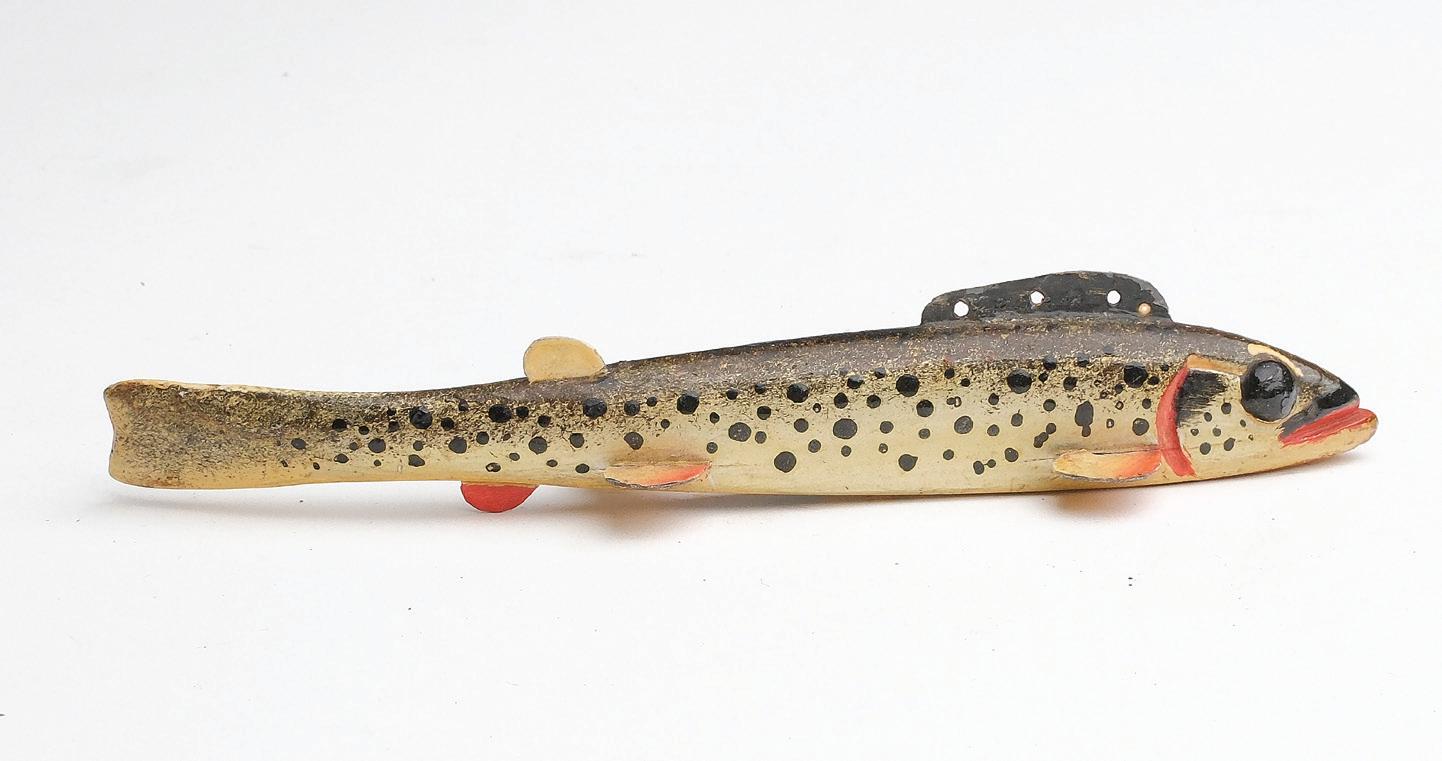
Provenance: George and Miriam Van Wallegham collection. (1,000 - 1,500)
233D Fish decoy, Oscar Peterson, Cadillac, Michigan, 2nd quarter 20th century. Perch with tack eyes. Measures 7” x 1” x .5”. Original paint protected by a coat of varnish that has darkened and did not coat exactly evenly; a couple front fins are bent slightly.
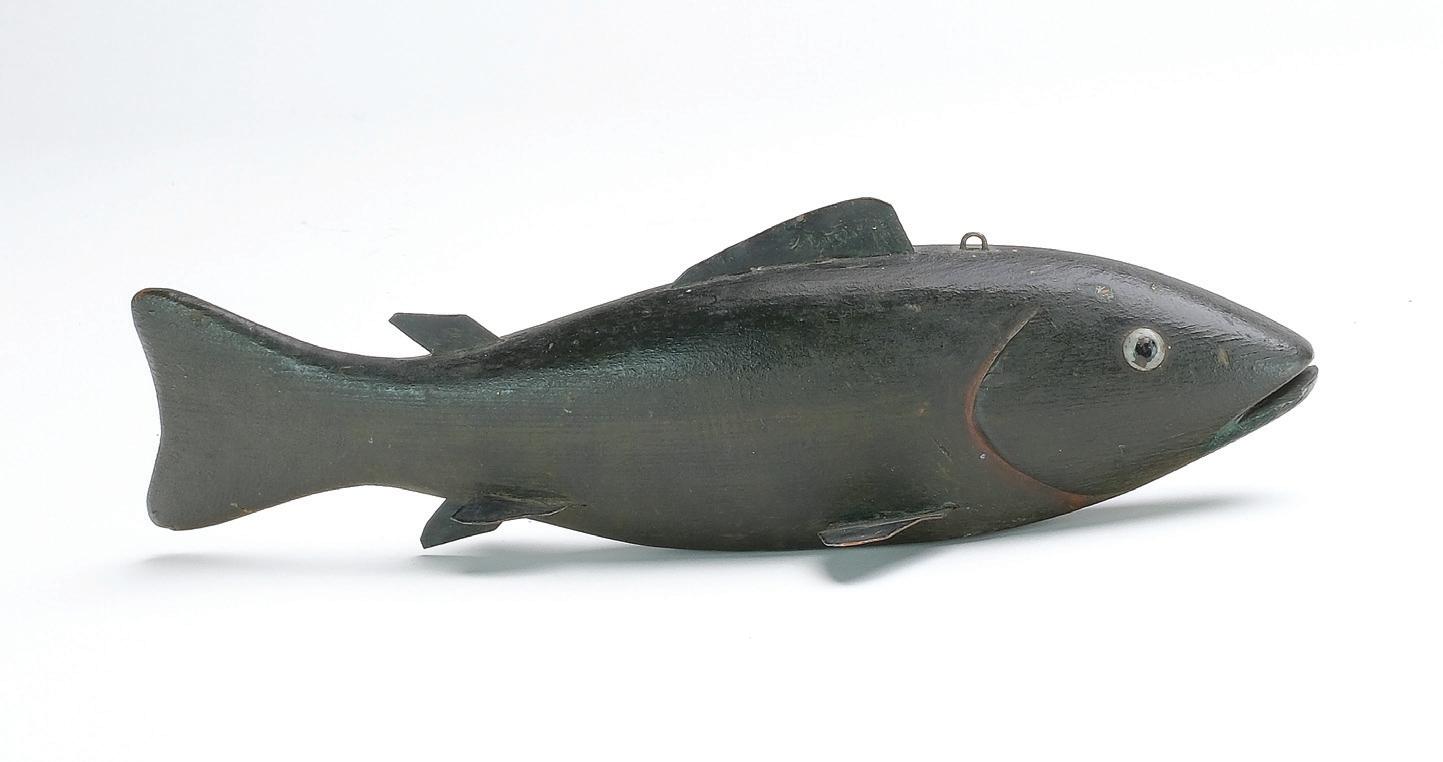
Provenance: George and Miriam Van Wallegham collection. (800 - 1,200)
233E Large bass fish decoy, Lake St Clair, Michigan, 1st quarter 20th century. Tack eyes with carved open mouth. Carved gills. Metal fins and wooden tail. Measures 10.5” long. Original paint; good structurally. (1,500 - 2,500)
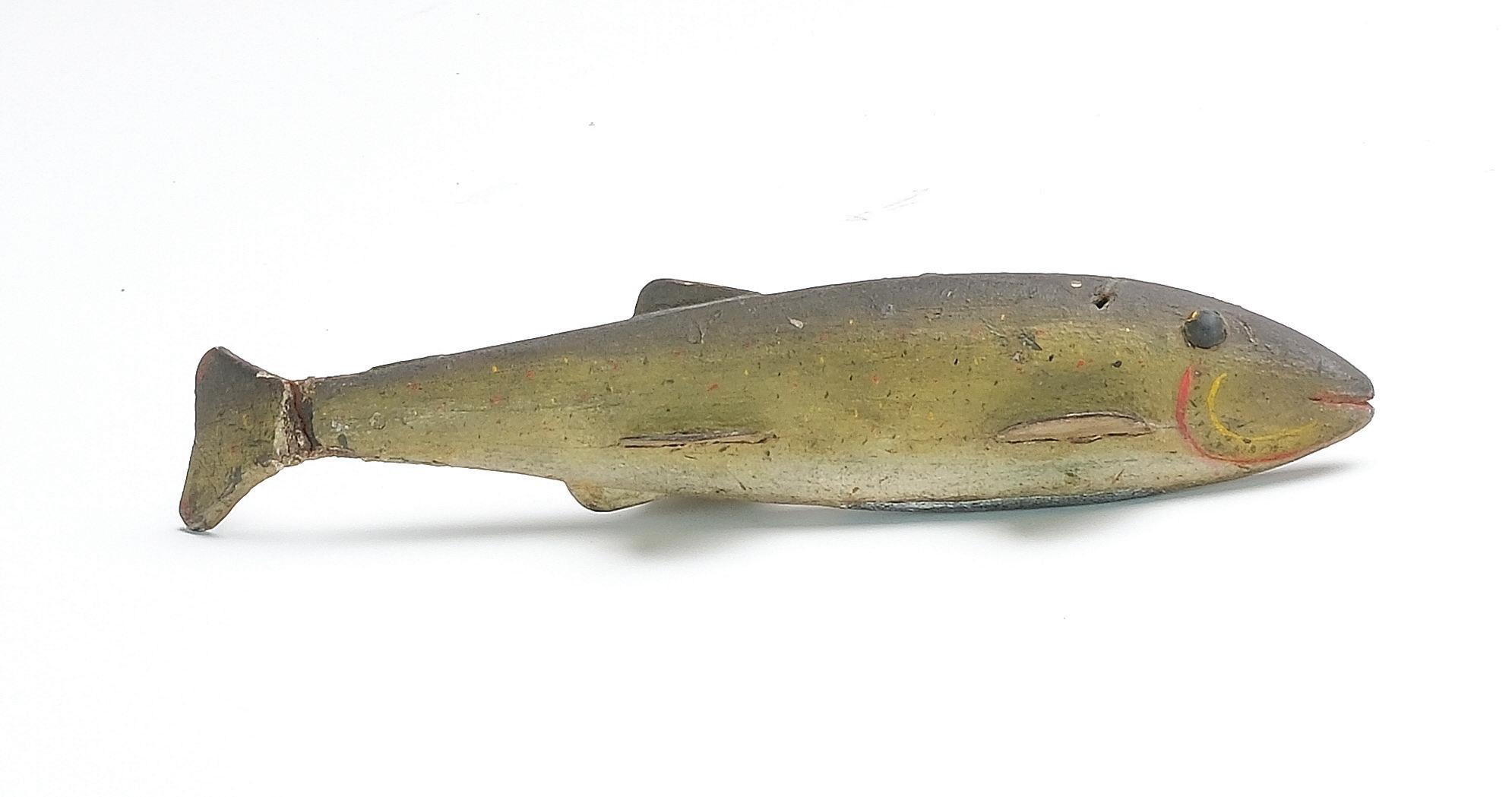
233F Fish decoy, Lake Chautauqua, New York, last quarter 19th century. Trout with tack eyes, carved gills and mouth. Metal fins and leather tail. Line tie runs through hole in back. Measures 7” long. Fine original paint of a blended green with yellow, black, and red dots; blemish where paint has been disturbed at top of one side of back and area near tail. (1,000 - 3,000)

152
233C 233E 233D 233F
233G Sucker fish decoy, Leroy Howell, Hinkley, Minnesota, 2nd quarter 20th century. Measures 8.75” long. Original paint with minor wear; flaking where fins meet the body; reglued chip in top part of tail. (800 - 1,200)
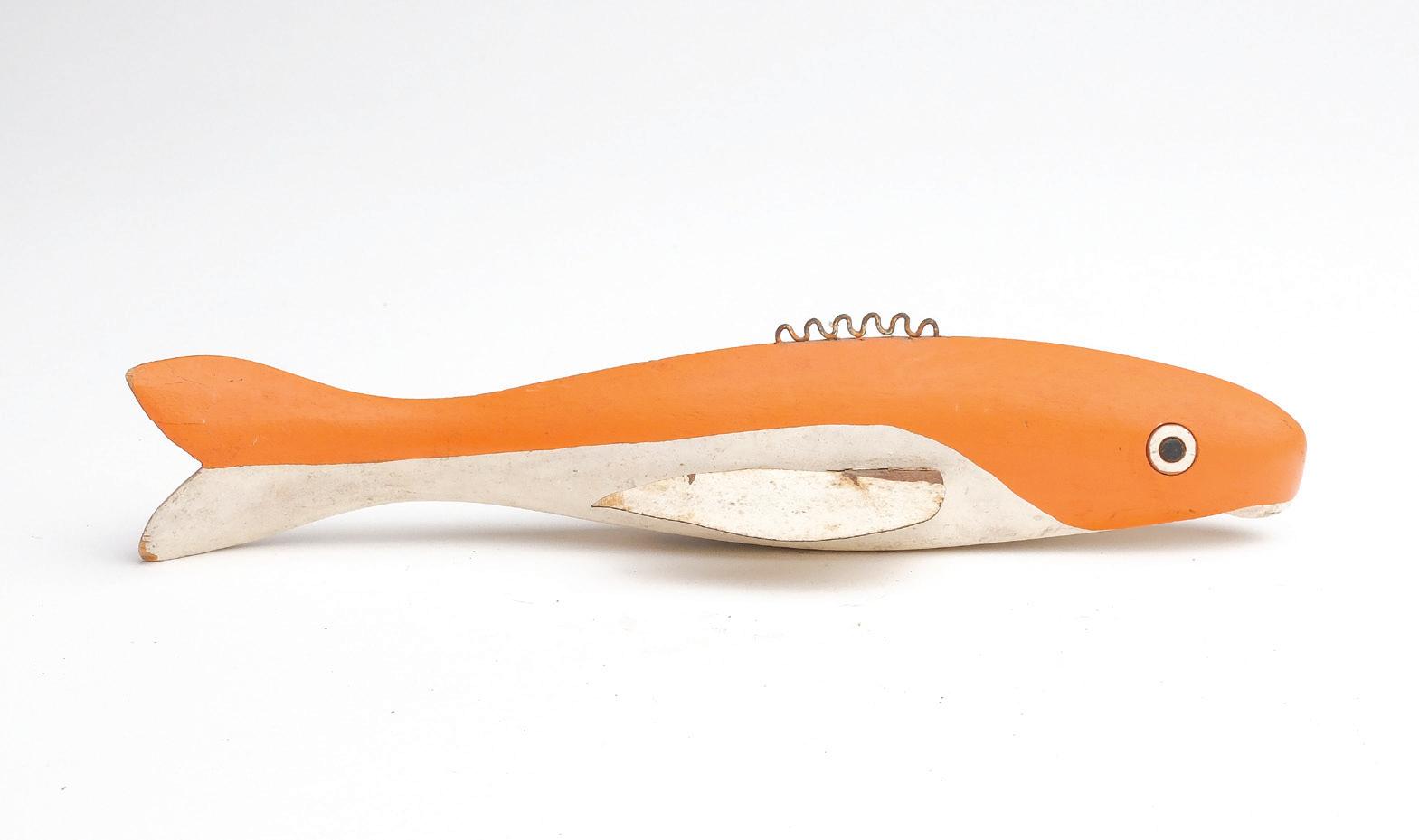
233H Fish decoy, Leroy Howell, Hinkley, Minnesota, 2nd quarter 20th century. Measures 9.25” long, and almost 3” tall. Original paint protected under a thin coat of varnish; shows minor flaking and wear; spot of touchup on back near tail. (800 - 1,200)

233I Rare sunfish decoy, John Tax, Osakis, Minnesota. Stylish carved dorsal fin and line tie. Painted eyes. Slightly curved tail with metal fin. 4.5” long. Original paint; flaking mostly at the front of the decoy around one lower fin. (1,500 - 2,500)

153
233G
233H
233I
233J Carved Atlantic salmon trophy fish, Farlow and Company. Retains Farlow stamp on backside which reads “C Farlow and Company fishing rod manufactures, 191 Strend London”. Bottom of plaque reads “Weight 32 lbs Sandene June 24, 1896. 2/0 Black Doctor”. Plaque measures 16” x 51”. Every scale is textured, fins are carved. Retains excellent original paint with two areas of discoloration from a knot hole.
Provenance: George Quay collection.
(5,000 - 8,000)
233K Very rare 51 lb Atlantic salmon trophy fish. Plaque reads “Caught 31st May 1923 at Skogmo Bjora River by L. Fradgley”. Fish has cross hatch scaling pattern done with a brush. Fins are carved and applied. Plaque measures 20” x 54”, fish measures 47.5” long. Strong original paint with crazing near head and on fins; a varnish coat has darkened around lower fins; tight crack in body.


Provenance: George Quay collection.
(3,000 - 5,000)
154
233L Atlantic salmon carved wooden trophy fish. With carved and applied gills. Mounted to backboard with decorative oak frame. Remnants of sticker in lower right says “taxidermist invernes”. Board measures 22” x 58”. Original paint covered by a light coat of varnish; some light crazing throughout; one fin has a small amount of damage at edge.

Provenance: George Quay collection. (3,000 - 5,000)
233M A rare carved trophy fish of a grilse at 5 lb. Meaning a small Atlantic salmon. Plaque indicates fish was “Caught at River Ribele August 1914 grassed by Fred Morgan”. Plaque measures 11” x 29”. Original paint with heavy

crazing along top of back; bottom center fin appears to be a replacement; some paint restoration to tail fin; mounted on a newer board.
Provenance: George Quay collection. (1,500 - 2,500)
233N Very rare carved wooden brown trout, P.D. Malloch Company, Perth. Board reads “Salmo Fario 6 lb caught with fly by A. Burton, Top Shin September 3rd 1915”. 10.5” x 28, fish measures 25”. Excellent original condition; plaque was at one time encased in a glass dome, which is why the fish remains in such great condition; backboard shows tight crack. (3,000 - 5,000)

155
233L
233M
233N
233O Brown trout plaque, Lawrence Irvine, Winthrop, Maine. Relief gill and eye carving, with open mouth. Unsigned. Trout measures 22” long. Surface has darkened slightly from an early coat of varnish; pectoral fin was off and reglued.
Provenance: David Fannon collection.
(1,000 - 1,500)
233P Brook trout plaque, Lawrence Irvine, Winthrop, Maine. Relief carved gill and eye and open mouth. Backboard is painted to resemble birch bark. Signed on the back of plaque. Trout measures 17.5” long. Two fins are replaced with some touchup where the fin meets the body.



Provenance: David Fannon collection.
(800 - 1,200)
233Q Brook trout plaque, Lawrence Irvine, Winthrop, Maine. Relief carved gills and eyes, and open mouth. Backboard is painted to resemble birch bark. Identified but not signed on the back of plaque. Trout measures 15.25” long. Top of one fin with repaint, otherwise excellent and original.
Provenance: David Fannon collection.
(600 - 900)
156
233O
233P
233Q
Items of Interest
Advertising Figure. Cast iron body with articulated lead composite head and wooden bill. These were used as countertop advertising in stores, where it would have been wound up, causing the head to bob up and down and the hinged bill to open and close. Measures 14” long and 11.25” tall. The exterior winder is missing and the condition of the interior mechanism is unknown; no noticeable damage, just wear from age and use.

(5,000 - 8,000)

157
233R Rare Duck Brand Mackintoshes
234 Large full body copper pilot eagle or weathervane. Mounted on copper globe, includes directionals. Surface has been cleaned to expose a mix of verdigris, old copper, and gold paint. Measures 41” tall from base. A normal amount of damage and small separation at welds; small dented area at beak.
(2,500 – 3,500)
235 Full body copper ‘Blackhawk’ weathervane, probably Harris Manufacturing Company. Surface has been painted a dark gold color, with some remnants of gold verdigris showing from underneath. Measures 27” long, and 21” tall. Appears to be structurally good.

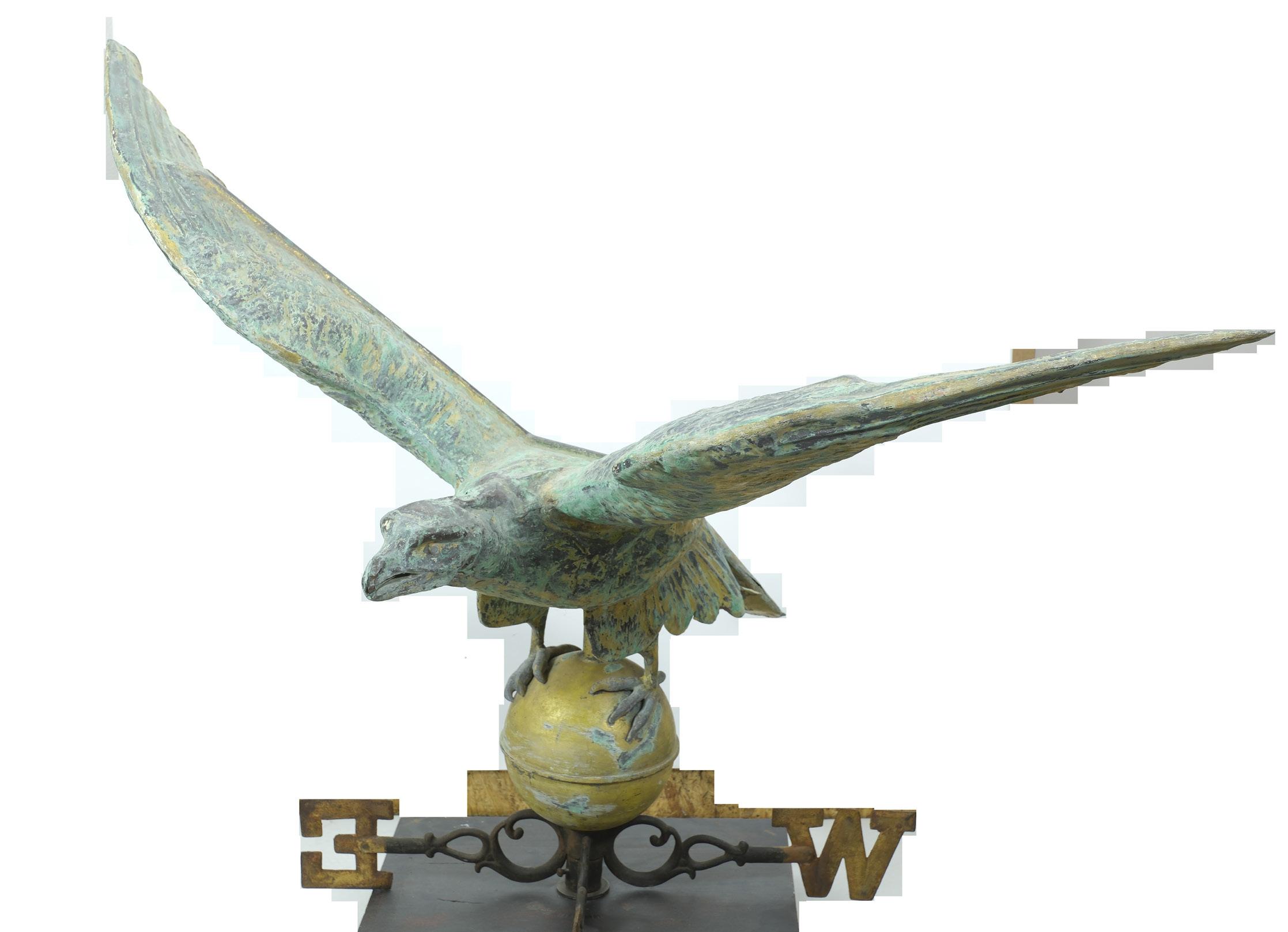
(3,000 - 5,000)
236 Full body copper weathervane with zinc head. Measures 25” in length. Three bullet holes; separation of copper halves at front of body; front leg has bent; one zinc ear is broken; old surface shows some green verdigris.
Provenance: George Quay collection. (500 - 700)

158
234
235
236
237 Rooster weathervane, Rochester Iron Works. Two piece cast iron body. Approximately 23” tall. Some toes missing from one foot; surface is rusted but appears natural; structurally good. (3,000 - 4,000)

238 Early leather fire bucket, 1st quarter 19th century. Painted bannerette with “G.W. Brown 1820” on one side. Measures 13” tall to rim. Surface has darkened with age; moderate to significant crazing; leather on bottom edge has misshapen slightly.

Provenance: David Fannon collection.
(600 - 900)
239 Large, swing handle, lightship basket, Nantucket, Massachusetts, 1st quarter 20th century. Measures 11.25” across, stands 14” tall with handle raised. A few tight cracks and two small losses to weaving, otherwise excellent.

Provenance: David Fannon collection.
(800 - 1,200)
159
237 238 239
239a Cigar store Indian chieftess trade sign, Samuel Robb, New York City, New York, last quarter 19th century. Figure holds Robb’s signature carved rose, which was added to some of Robb’s female figures to honor his wife after her death. Well carved, large head dress. Also holds a bundle of cigars, three boxes of tobacco, and leaves. Decorative tobacco leaves hang from her mid waist over a yellow/ochre colored dress. Princess stands 59” from top of base. A tight, well stabilized crack in one side of front of body; well crazed and appealing surface; old paint with some small areas of restoration.


 Provenance: Mark Goldman collection.
(20,000 - 30,000)
Provenance: Mark Goldman collection.
(20,000 - 30,000)
239b Cigar store Indian trade sign, Samuel Robb, New York City, New York, circa 1885. Holding a knife and bundle of cigars with tobacco boxes. Retains the original base. Total height from floor is 74”. As found condition with no restoration; surface shows lots of age; thick old paint that has crazed and worn to bare wood in areas; typical tight crack in back runs from top of head to bottom of dress.

Provenance: Mark Goldman collection. (20,000 - 30,000)

Large cigar store Indian trade sign, sold by William DeMuth & Co, New York City, New York, circa 1875. Cast zinc with original bow and feathers, surviving feathers are extremely rare. This was DeMuth’s most expensive figure at the time, which sold for $175 and was probably his best selling figure. Stands 80” tall. Original mold carved by Samuel Robb. Figure was cast by A. Selig in Williamsburg, Brooklyn. A copy of DeMuth catalog can be found in “Artists in Wood,” by Frederick Fried. Structurally good with exception of a crack at the rear of the figure where stump meets lower legs; figure was partially filled with sand or concrete to prevent theft, a common practice of the time; restored paint.

Provenance: Mark Goldman collection. (15,000 - 25,000)
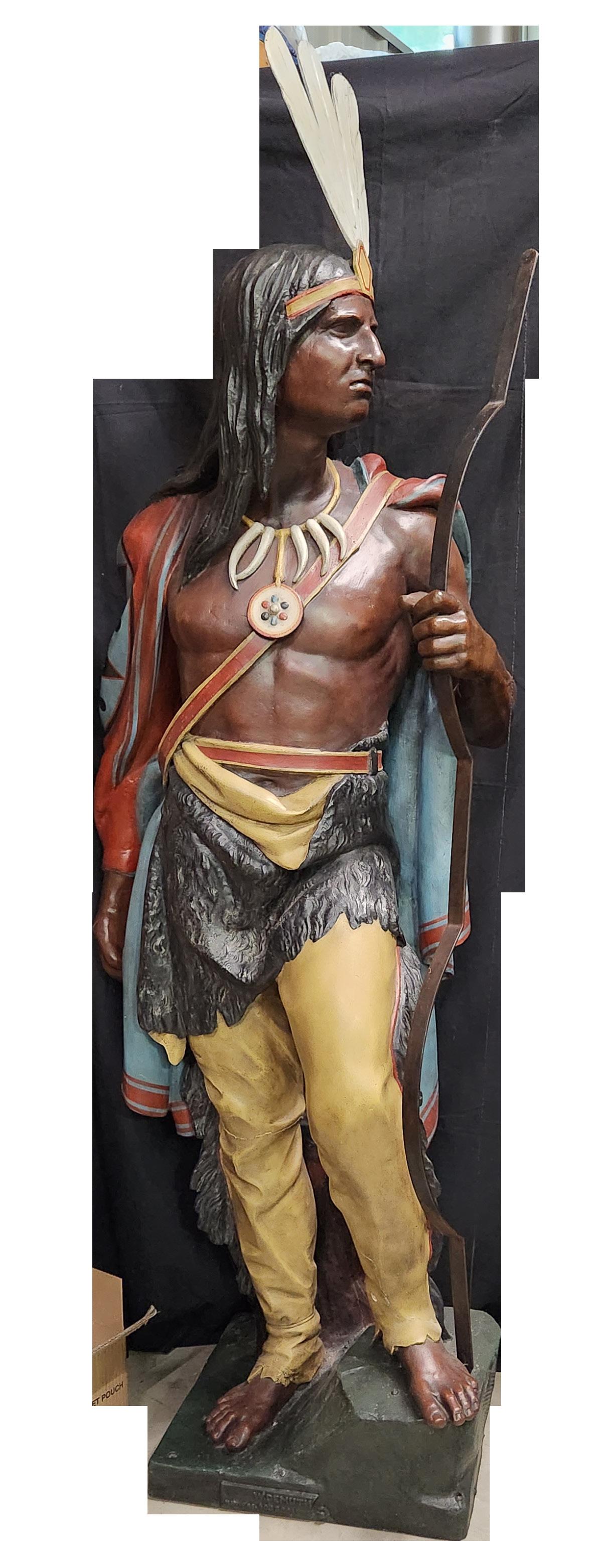
162
Provenance: David Fannon collection. Ex Bob Burger collection. (1,500 - 2,500)
239e An appealing decorative wall cupboard that was not a part of another piece of furniture. Has a single 9 pane door with two three pane sides. Stands 38” x 41”. Original blue and white paint; two shelves inside cupboard; shows wear around areas where hands would have touched to open and close door. (800 - 1,200)

239f Red painted gate or swing leg game table, circa 1900. Double pull single drawer. Stands 30” x 36” wide x 17.5” deep and folds out to 36” deep. Red paint appears to be a later addition; some surface wear; structurally good. (400 - 600)
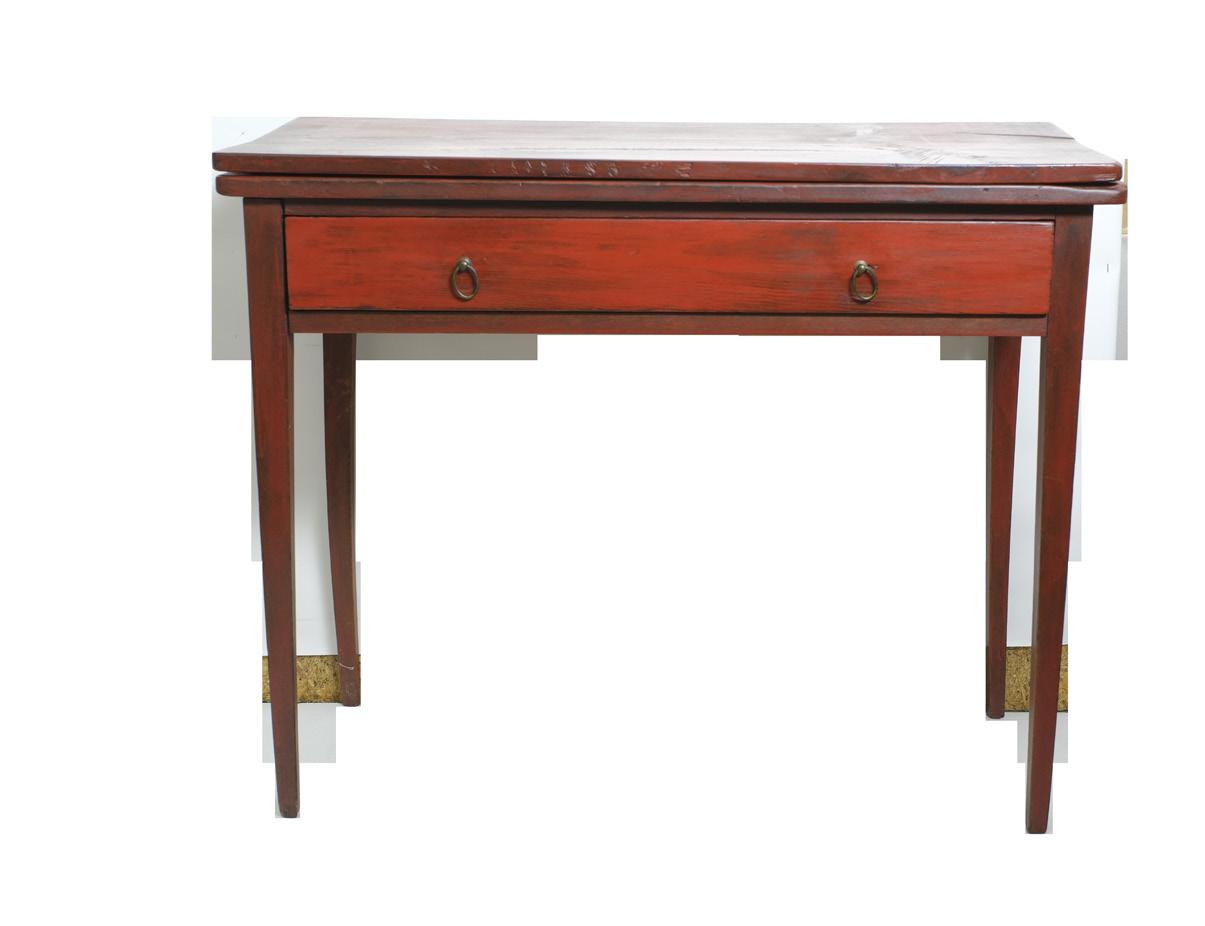
239g Lavender painted blanket box, last quarter 19th century. Turned feet. Key hole with metal eschtuen. Lift top box with small drawer. measures 27.5” tall x 53” wide x 23” deep. Original paint with wear and exposed bare wood at top and edges mostly. (400 - 600)

239h A hunter’s whirligig whimsical, circa 1930. Four mallards with moveable wings that catch the wind to spin. The figure which is mounted to a base that stands approximately 48”. Whirligig is 44” wide. Remains good structurally with excellent crazed surface.

Provenance: George Quay collection. (800 - 1,200)

239d
239f
239e
239g
239h
240 Excellent southern carved walking stick, last quarter 19th century. Deep relief carved alligator, fish, frog, and dog with two spiraling snakes wrapping around the stick. Measures 35.75” long. Small inlay between frog and alligator’s tail with insert missing; dark natural finish with even wear from use and age; small chips in one of frog’s feet; three of alligator’s feet and the bottom portion of fish’s tail.

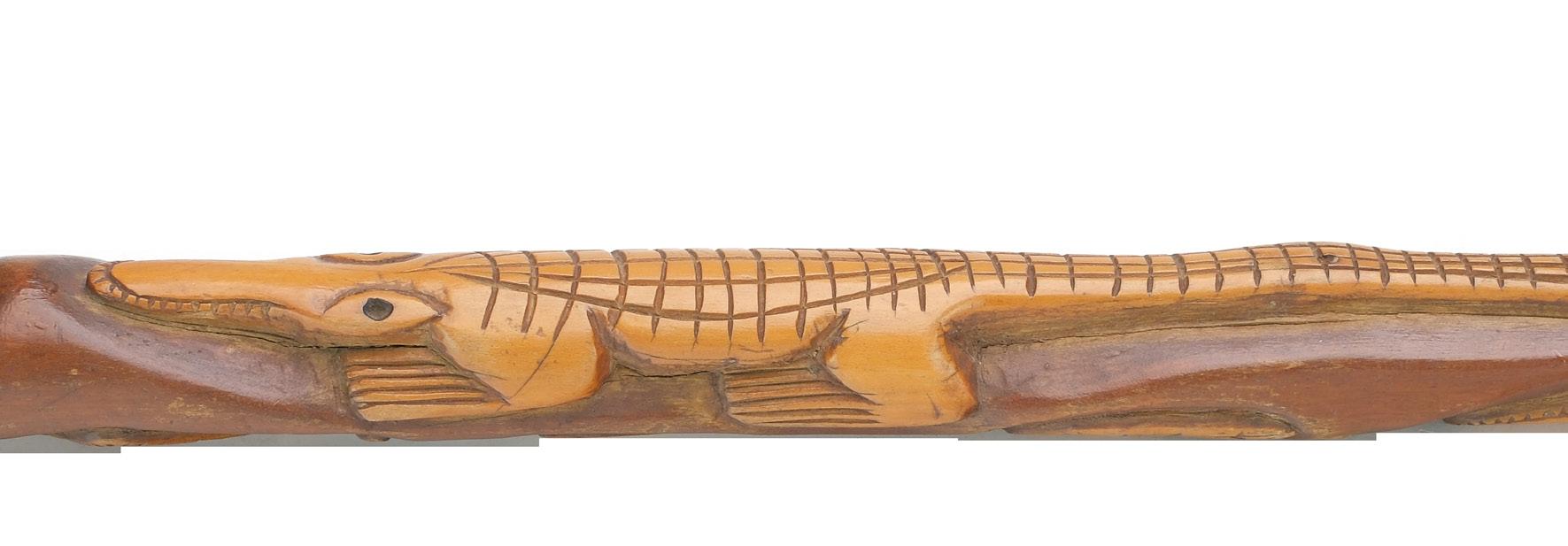
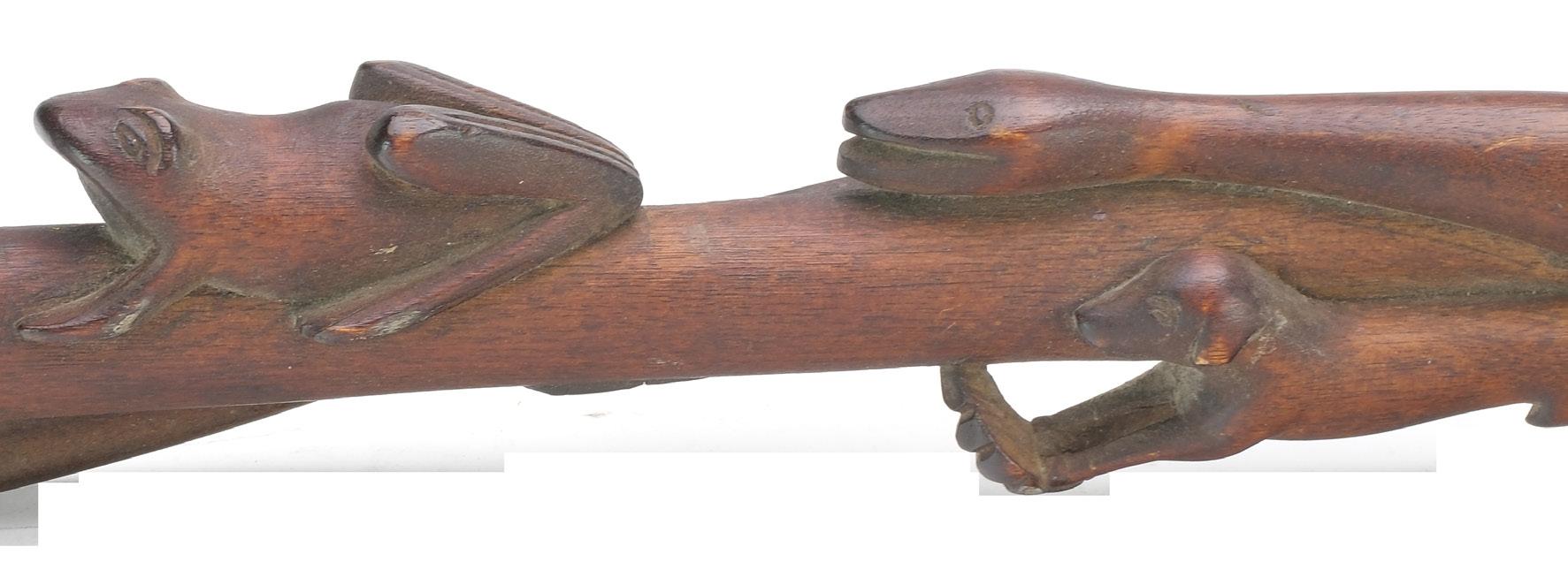

Provenance: David Fannon collection.
(1,200 - 1,800)
241 Folk carved walking stick. With snake, alligators, leaves, and hands. Also with relief carved heart, bible, and cross. Measures 35.75” long. Two tone stained finish with moderate wear from use and age; repaired break 5” from the bottom with a small chip missing in snake.


Provenance: David Fannon collection.
(600 - 900)
164 240 240 241 241
242 An early well carved figure of a mermaid with a flipped tail, circa 1900. Hair in a fancy bonnet, with arms outstretched holding a turned wooden figural. Measures approximately 19”. Original paint with some flaking and a few small chips.

Provenance: David Fannon collection. (1,000 - 1,500)
243 Large whirligig, 2nd quarter 20th century. A gentleman with top hat and mustache. Stands 39.5” tall, wooden paddle arms 48” from tip to tip. Original paint with minor crazing and wear; a few small scratches; seam in one arm where it was cracked and reattached.

Provenance: Purchased at Northeast auction, circa 1980. Mark Goldman collection.
(2,000 - 3,000)
244 Early American hessian soldier whirligig. Stands 18” tall. With applied metal nose and hat. Original paddle arms have a replaced dowel; traces of paint remaining mostly on paddles and back of figure, otherwise it has been weathered away to bare wood. (800 - 1,200)

165
243 244
242
245 Two sided trade sign. In black, red, and white. Measures 10” x 34”. Original paint with wear that is consistent with approximately 50-60 years of age and possibly earlier.

(300 - 400)
246 Blue bucket bench in original paint. Probably last quarter 19th century. Measures 42” long, 15” high, and 16” deep. An excellent color of blue with an appropriate amount of wear for its age; structurally good.

(1,500 - 2,500)
247 Blue painted storage box, circa 1900 or earlier. Dry old surface and lift top. With double hinge and lock at center. Measures 29” tall x 43” wide x 17.5” deep. Structurally sound with dry surface; cracks, rubs and expected amount of wear.

(300 - 500)
248 Cast iron dove and base, 1st quarter 20th century. With outstretched wings and two legs. Unmarked. Measures 10” x 7.5”. Painted surface with appealing crazing and even wear; very good structurally.
Provenance: David Fannon collection. (300 - 500)

166 245
247 248
End of session one



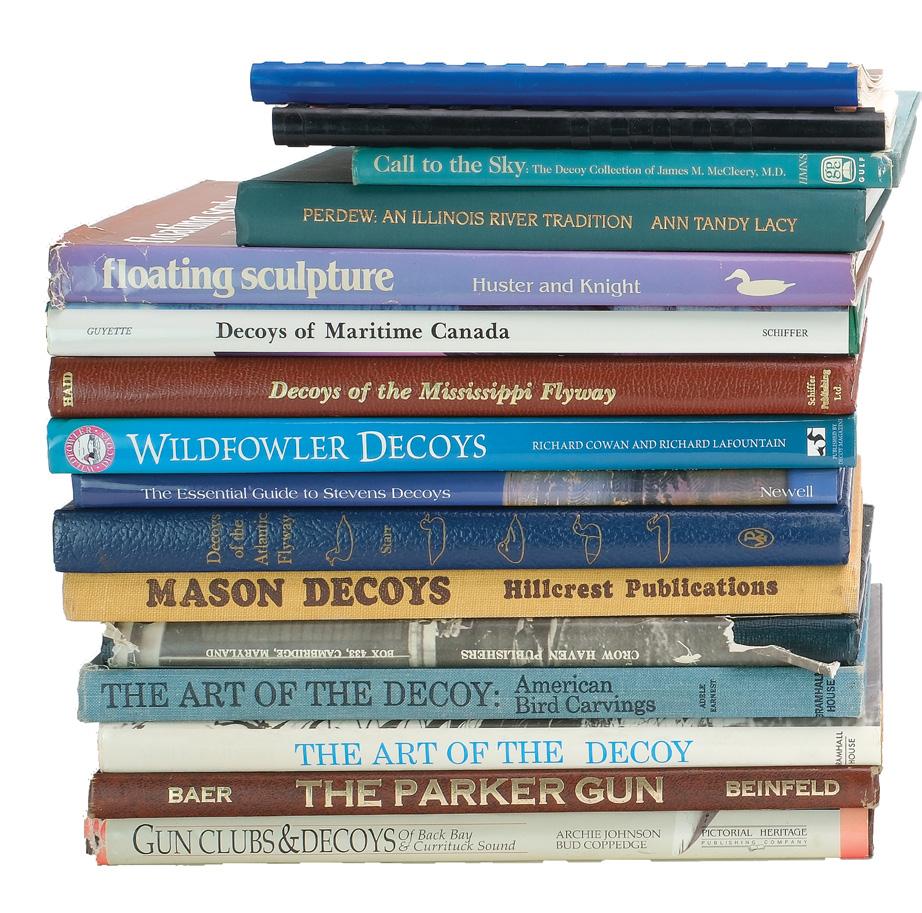
167 249 250 251
249 24 books and several pamphlets. (800 -
1,000)
250 18 reference books. (300 - 500)
251 10 reference books. (300 - 500)
Jim Schmiedlin
1945 - 2015 | Bradfordwoods, Pennsylvania
252 Outstanding back preening greenwing teal drake, Jim Schmiedlin, Bradfordwoods, Pennsylvania. Made 7/2009. Jim’s Return for Reward label on underside. Branded “JAS” with an additional “C.B.” carved in underside. Notes say “Upper body Cyprus wood from Iron City brewery, Pittsburg, Pennsylvania”. Tail is slightly swept out which is anatomically correct with the bird back preening over the right side and wing shoulder slightly protruding. Very few teal or any decoys of this style were made by Jim. 12.5” long. Excellent and original.
(8,000 - 10,000)

168 Session Two • Sunday, November 12, 2023 • 10:00am

169
253 Bufflehead drake, Jim Schmiedlin, Bradfordwoods, Pennsylvania. An oversize model, made October 98. Branded “JAS” with Jim’s Reward for Return label. Note in pencil on underside says “Kelley Is, Oh and Erie, PA.” Turned head with wingtip and tail carving. Measures 16” long. Strong original paint; approximately 1” crack at lower left hand side of breast.
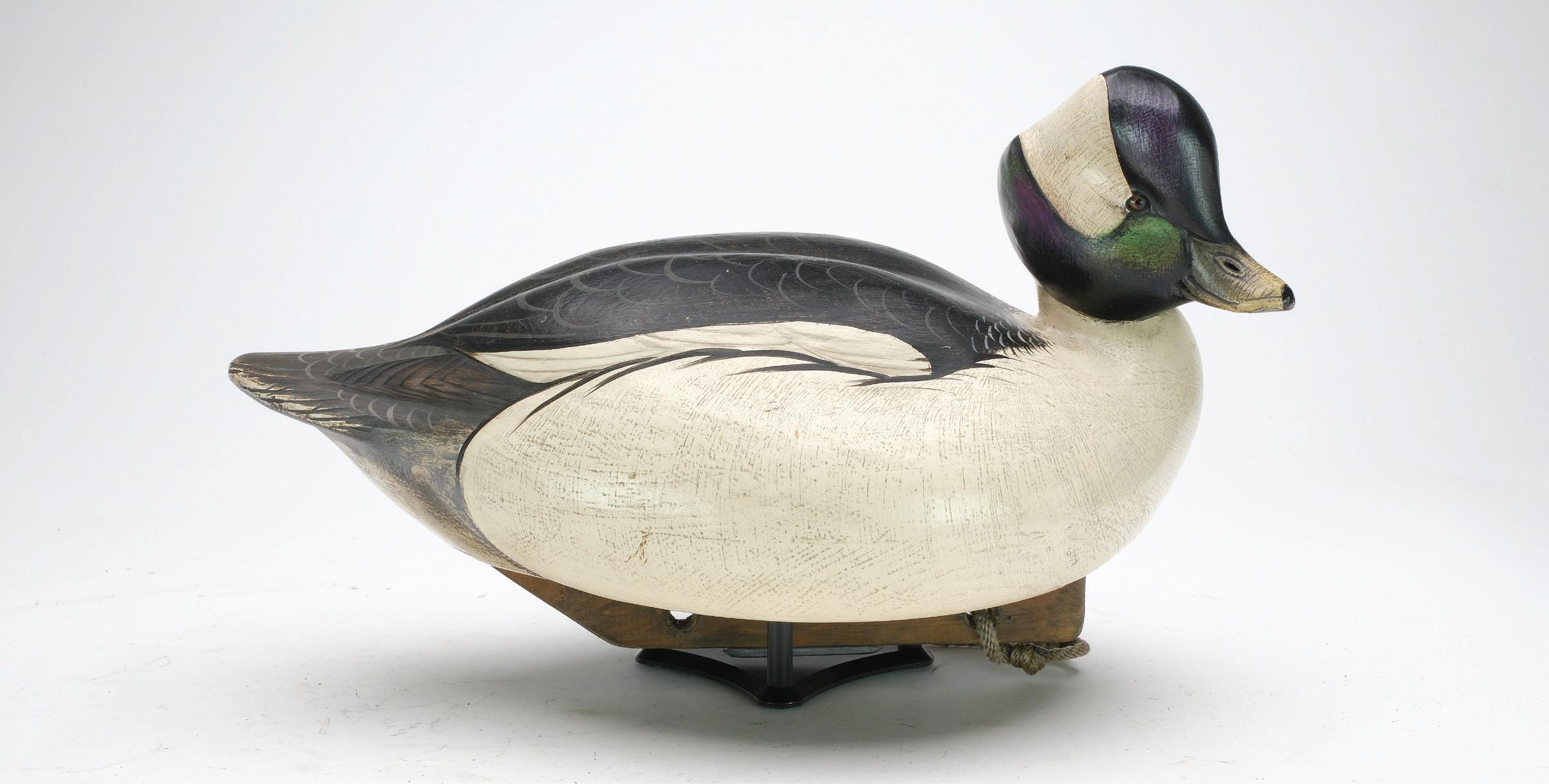
(3,000 - 4,000)
254 Pair of redheads, Jim Schmiedlin, Bradfordwoods, Pennsylvania. Hollow carved laminate construction. Drake in preening pose with one slightly raised wing. Both with relief tail carving. “JAS” branded on the underside, also with Jim’s Reward for Return label. Hen is dated 7/’89, drake is dated 10/’88. Measure 14” and 15.25” long. Original paint with moderate gunning wear; some paint flaking at one of hen’s wing patches has been sealed with a light coat of varnish; both are very good structurally.
(8,000 - 12,000)
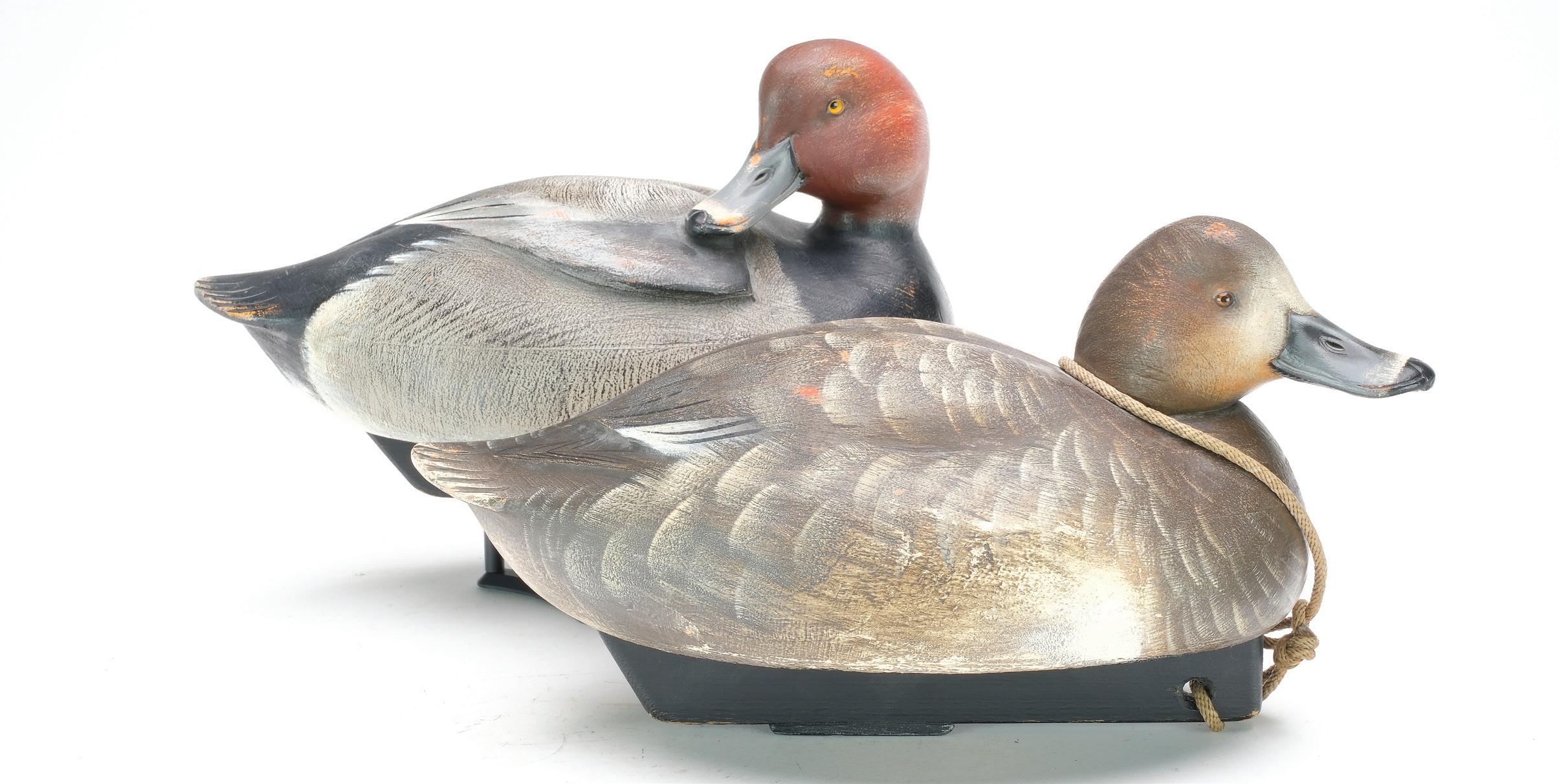
170
253 254
255 Pair
long tail ducks, Jim Schmiedlin, Bradfordwoods, Pennsylvania. Hollow carved, .25” bottom board. “JAS” branded on undersides, along with Jim’s Reward for Return on undersides. Each is dated 1986. Measure 16” and 18.5” long. Original paint with moderate gunning wear; spots of flaking on hen’s breast and back; hen is hit by shot on one side; each with cracks extending up from the bottom board.


(5,000 - 8,000)
256 Pair
Jim Schmiedlin,
Pennsylvania. Hollow carved with .25” bottom boards and slightly turned heads. Relief wing and tail feather carving. Branded “JAS” on the underside, also with Jim’s Reward for Return label. Both are dated 9/2000. Measure 13” long. Original paint with very minor gunning wear; tiny spot of touchup on tip of drake’s bill; scattered spots of touchup on hen’s back and one side of breast; both are very good structurally.
(8,000 - 12,000)
171
of
of ringnecks,
Bradfordwoods,
255 256
Measures 15.5” long. Filled crack in the breast from when the decoy was made; otherwise very good and original.
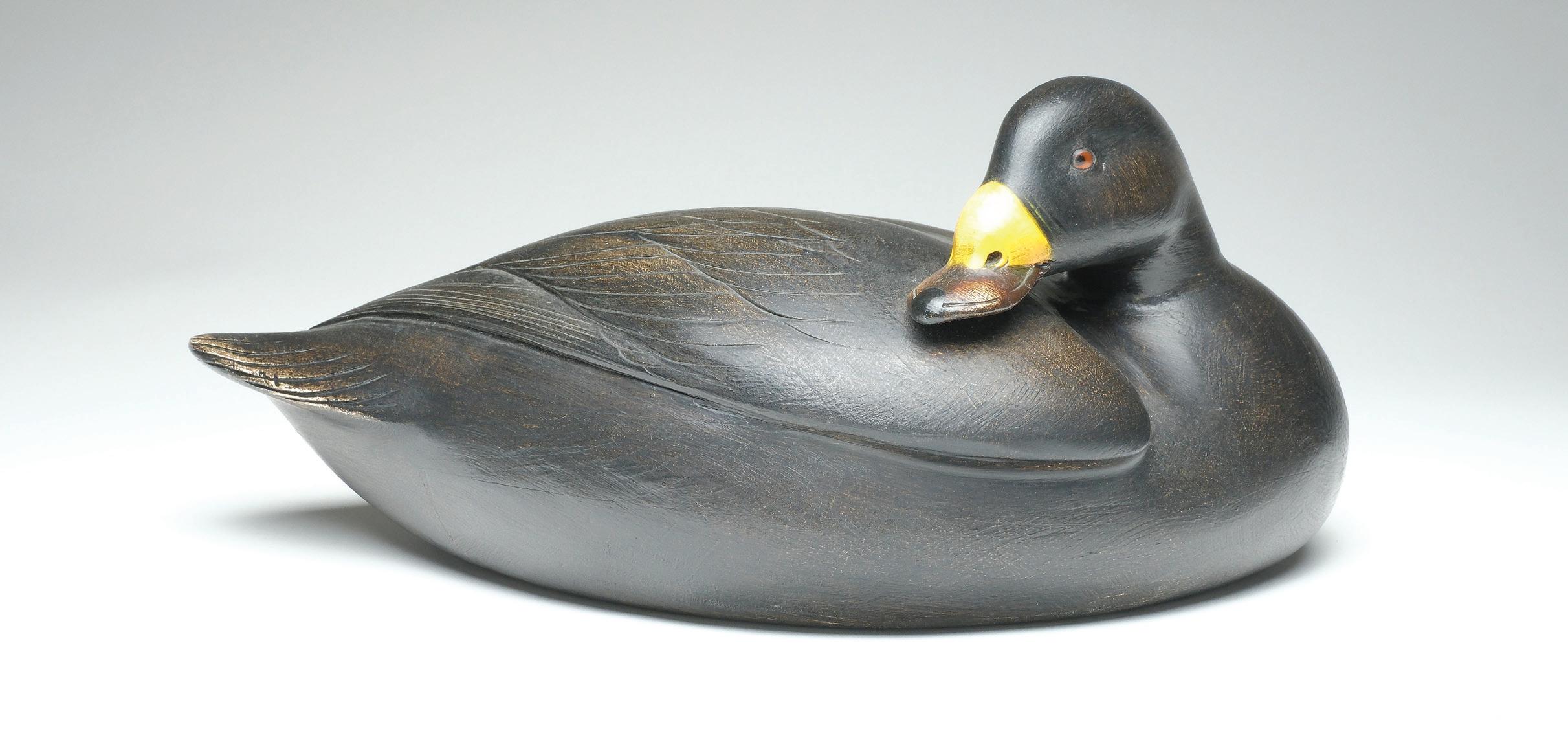
(2,500 - 3,500)
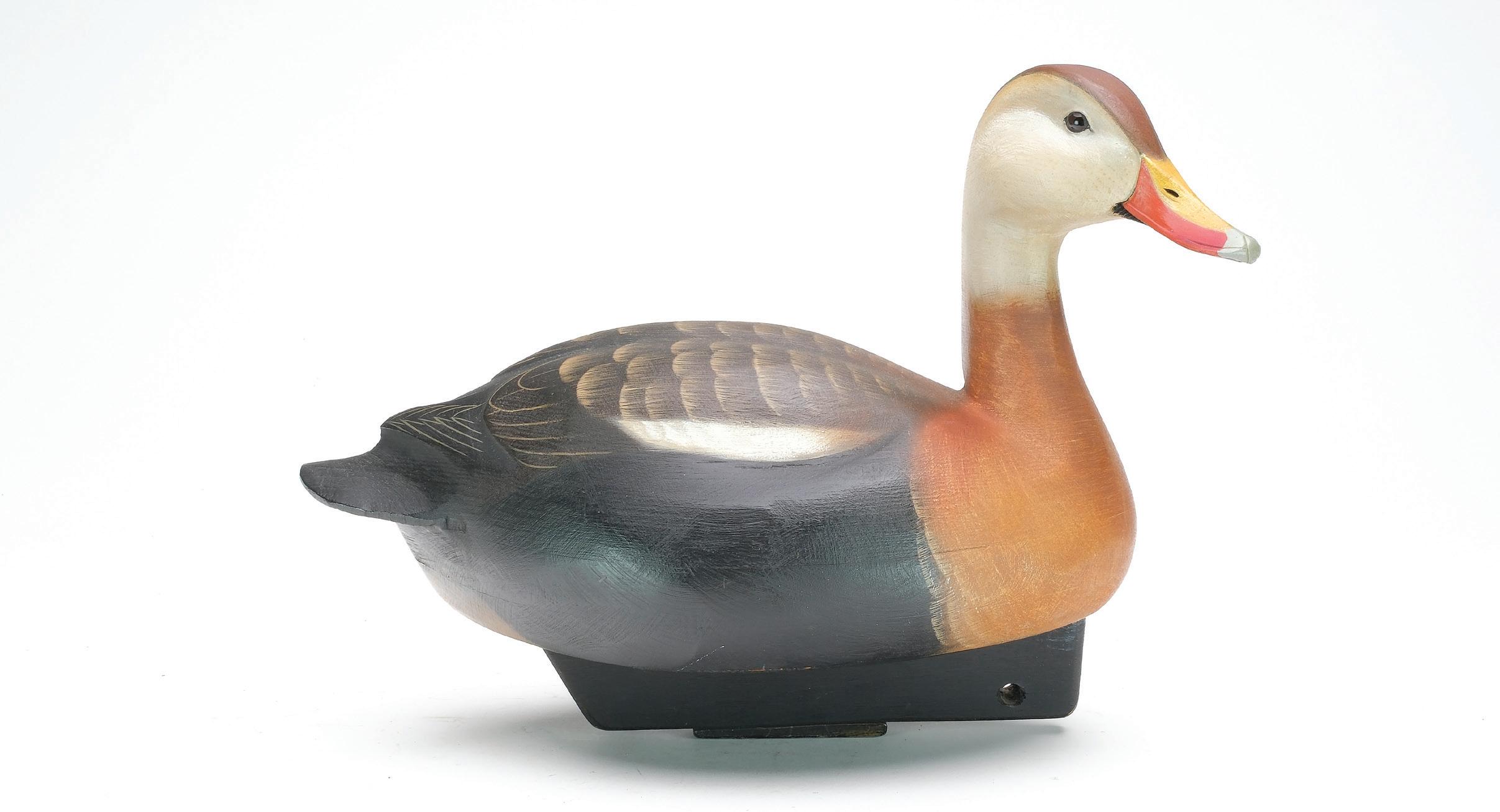
172
257 Excellent black bellied tree duck, Jim Schmiedlin, Bradfordwoods, Pennsylvania. Hollow carved with relief wing carving and slightly turned and raised head. “JAS” branded on the underside, also identified and dated with “early 80’s”. Schmiedlin private collection stamp on underside. Measures 13.5” long. Near mint. (5,000 - 8,000)
258 Preening black scoter, Jim Schmiedlin, Bradfordwoods, Pennsylvania. Hollow carved with .25” bottom board that is signed and dated 1986 on the underside. With maker’s initials branded. Head is turned and preening one raised wing. Relief wing tip and tail feather carving.
257 258
259 Excellent rigmate pair of canvasbacks, Heron Lake, Minnesota, circa 1930. Original paint with minor to moderate gunning wear; small chip in tip of drake’s bill; very minor roughness on edge of both bills. (5,000 - 8,000)

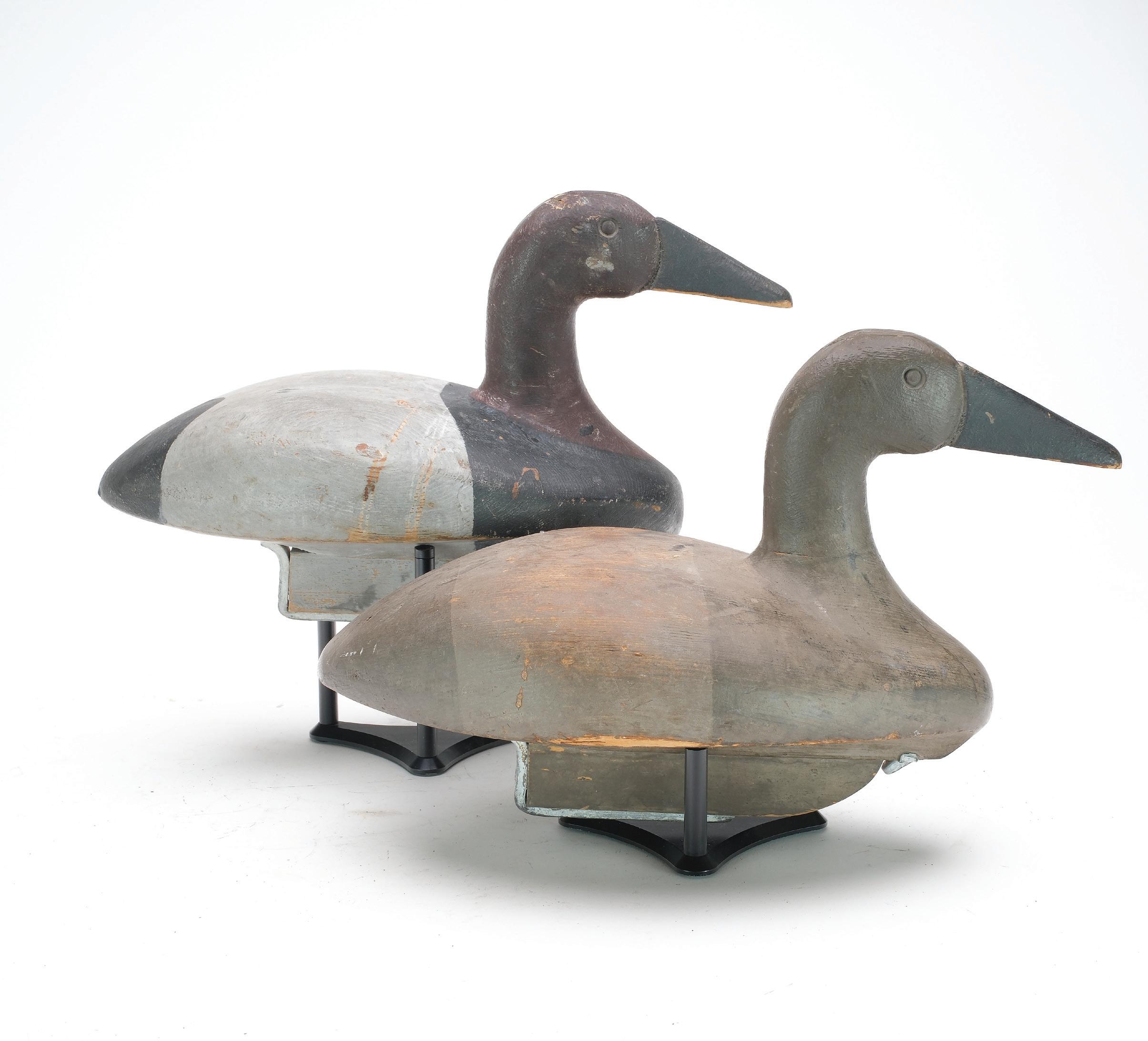
173
Ferdinand Bach 1888 - 1967 | Detroit, Michigan


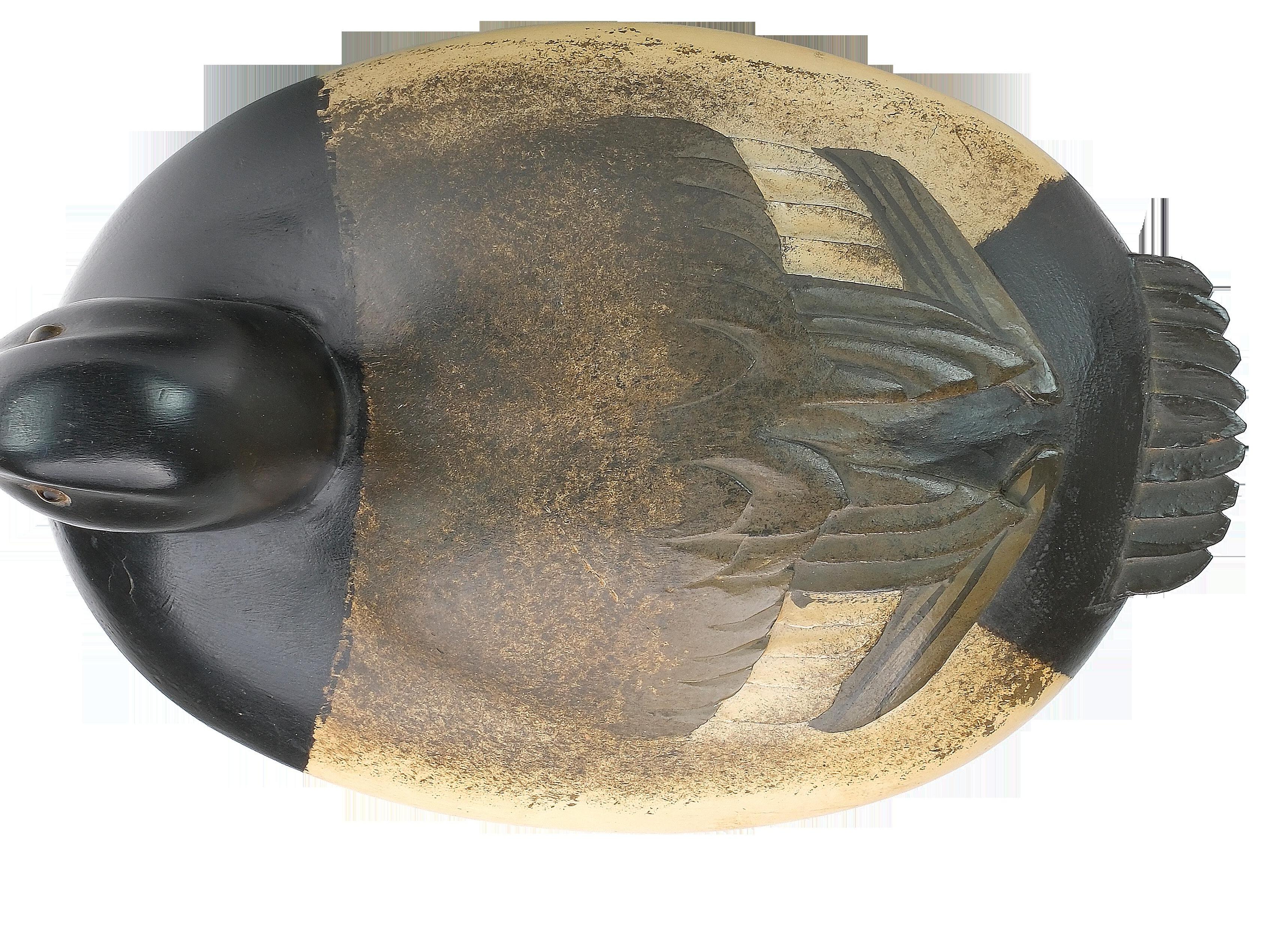
174
Jim Aiken with his favorite pair of decoys.


175
260 Excellent rigmate pair of bluebills, Ferdinand Bach, Detroit, Michigan, circa 1930. “F. Bach” carved in the underside of each, and both retain the Hy Dahlka brand. Both have carved feather and wingtip details. Carved and extended tail. Measure 14” long. Drake is in excellent original condition; hen was heavily hit by shot in one side with shot strikes filled and the area repainted by Bach.
Provenance: Ferdinand Bach hunting rig. Hy Dahlka collection. Jim Aiken collection. (30,000 - 50,000)
261 Redhead, Frank Buchner, Erie, Pennsylvania, 1st quarter 20th century. Relief heart and anchor wing carving. Measures 13.5” long. Early in use repaint with moderate flaking and wear; tight crack through neck; narrow chip and roughness on one side of bill.
(800 - 1,200)
262 Bluebill, Frank Buchner, Erie, Pennsylvania, 1st quarter 20th century. Relief heart and anchor wing carving. Small yellow bead eyes. From Buchner’s personal rig with name and address on copper tag on underside. Measures 12.5” long. Early second coat of paint by Buchner with minor gunning wear; crack through neck; minor roughness on edge of bill and one side of tail.
(600 - 900)
263 Rare canvasback, Ole T. Gunderson, Ashby, Minnesota, circa 1920’s. Two piece head and neck. and typical cut glass eyes. “OTG” in red paint under the weight. Also stenciled “OT Gunderson” on the underside. Measures 18” long. Original paint with moderate gunning wear; heavily hit by shot in breast and neck; hairline cracks in one side of neck; half of bill is a professional replacement.


(2,000 - 3,000)

176
261 262 263
Mason Decoy Factory


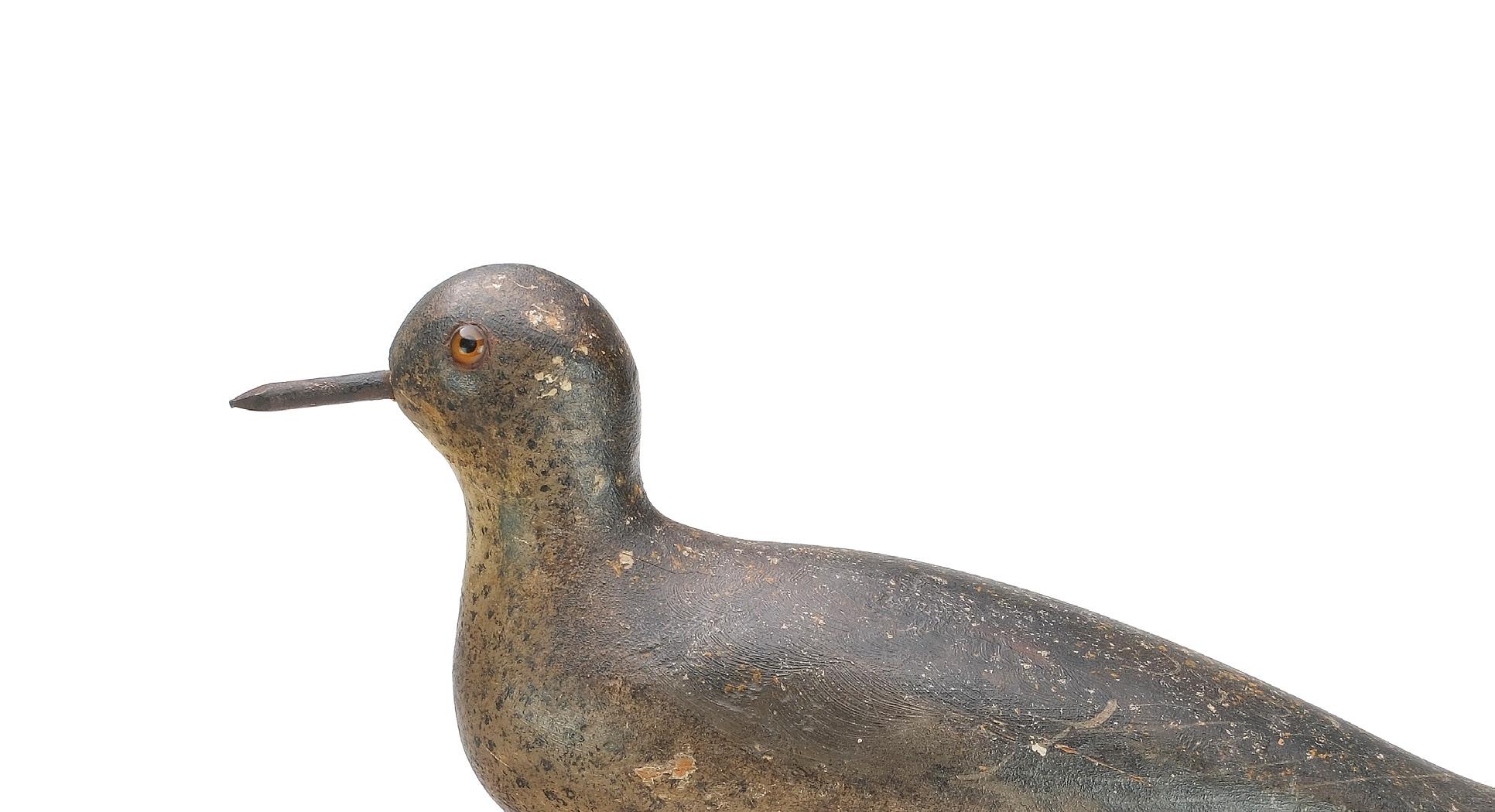

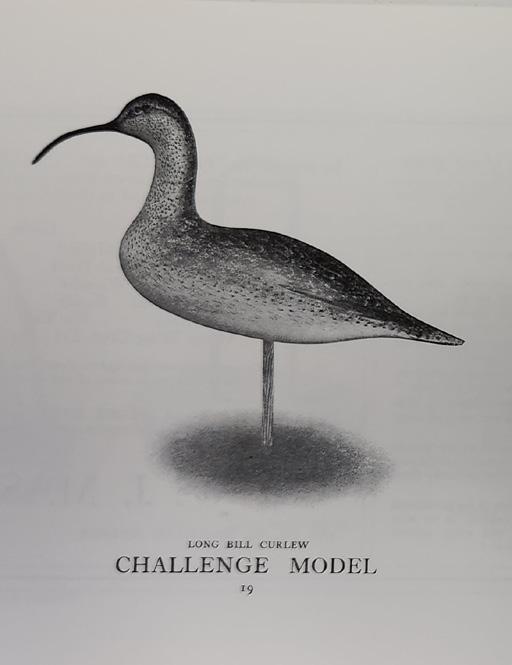

1896 - 1924 | Detroit, Michigan
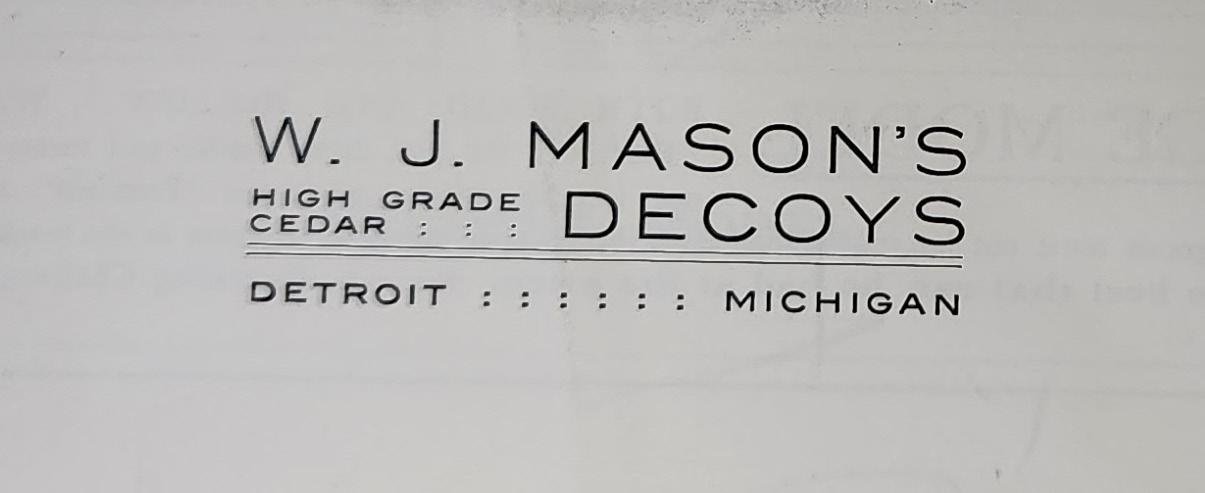
264
Exceedingly rare special order willet, Mason Decoy Factory, Detroit, Michigan, circa 1900. From a special order rig of willet that were made by the factory in the style of shorebirds by Charles Thomas of Assinippi, Massachusetts. Glass eyes and iron bill. Measures 14.5” long. Near mint original paint; structurally very good.

Literature: “Mason Factory Decoys,” Russ Goldberger and Alan Haid. (25,000 - 35,000)

178
265
Exceptional two piece curlew, Mason Decoy Factory, Detroit, Michigan, circa 1910. Glass eyes and iron bill. Measures 18” long. Near mint original paint with very slight wear; in factory crack, approximately 4” long on the underside; otherwise structurally very good.

Literature: “Mason Factory Decoys,” Russ Goldberger and Alan Haid. (20,000 - 25,000)

179
Detroit, Michigan, circa 1900. One of the so called “Salesman Samples”. With species “Golden plover” and price of $7.50 per dozen written on underside. Glass eye model with fancy feather detail. 10” long. Strong original paint with some rubs and small spots of flaking around bill and spot on body, and side of head.
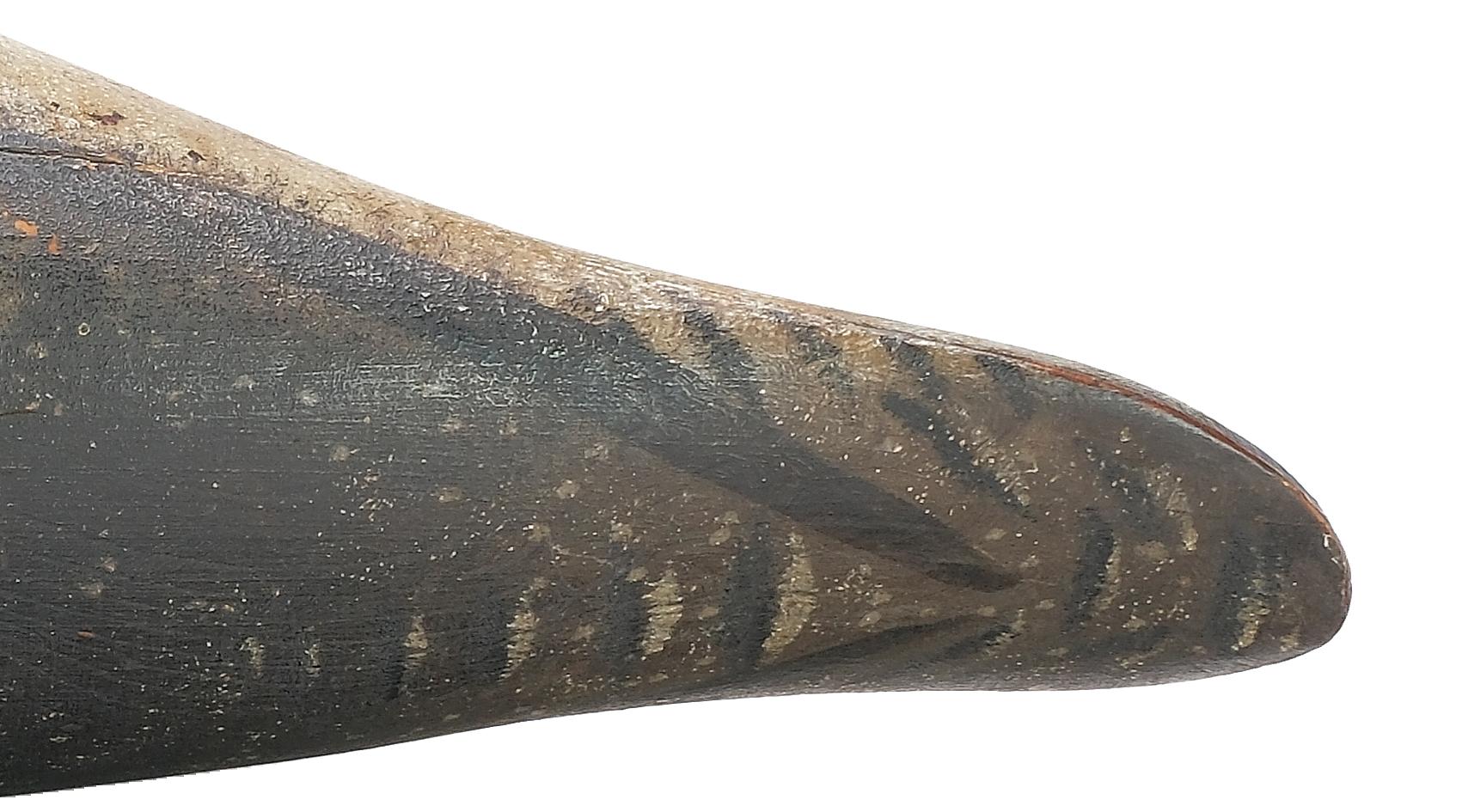

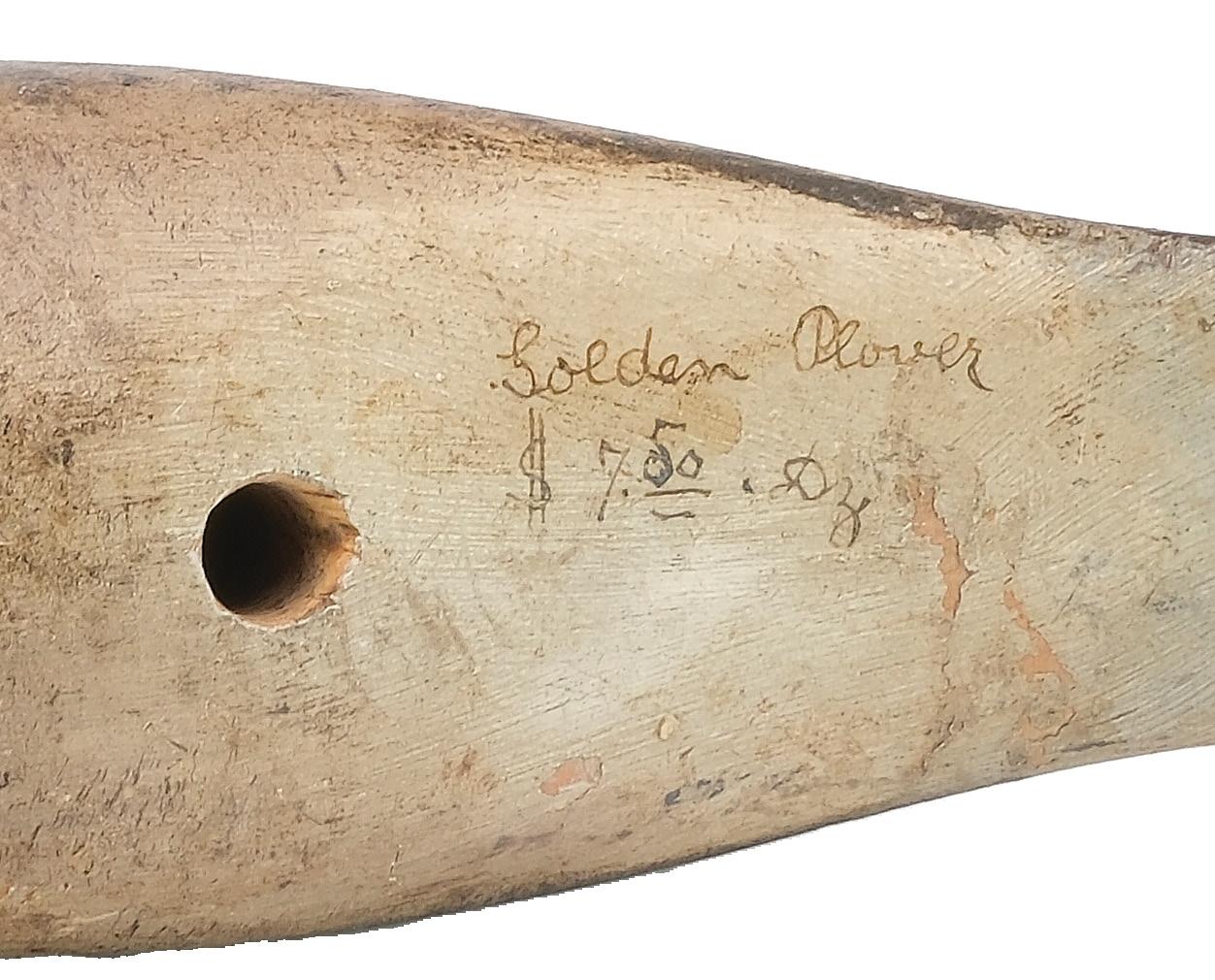

Provenance: Ex collection of Jim Doherty. (3,000 - 4,000)
circa 1900. Glass eye model with fancy paint feathering. 12” long. A few tiny shot scars; two filled cracks in underside extending up near neck area; small stain under bill otherwise very good and original.
Provenance: David Fannon collection. (2,500 - 3,500)
266 267
266 Rare and desirable golden plover, Mason Decoy Factory,
267 Willet, Mason Decoy Factory, Detroit, Michigan,
268 Black bellied plover, Mason Decoy Factory, Detroit, Michigan, circa 1900. Glass eye model. 10.5” long. Original paint; several shot scars; a knot at lower breast has paint loss; couple of small rubs at top of head.
Provenance: David Fannon collection.
(1,800 - 2,200)
269 Dowitcher, Mason Decoy Factory, Detroit, Michigan, 1st quarter 20th century. Glass eye model with iron bill. Measures 12” long. Original paint with very minor wear; hairline crack in one side of neck with a small nail added to secure.
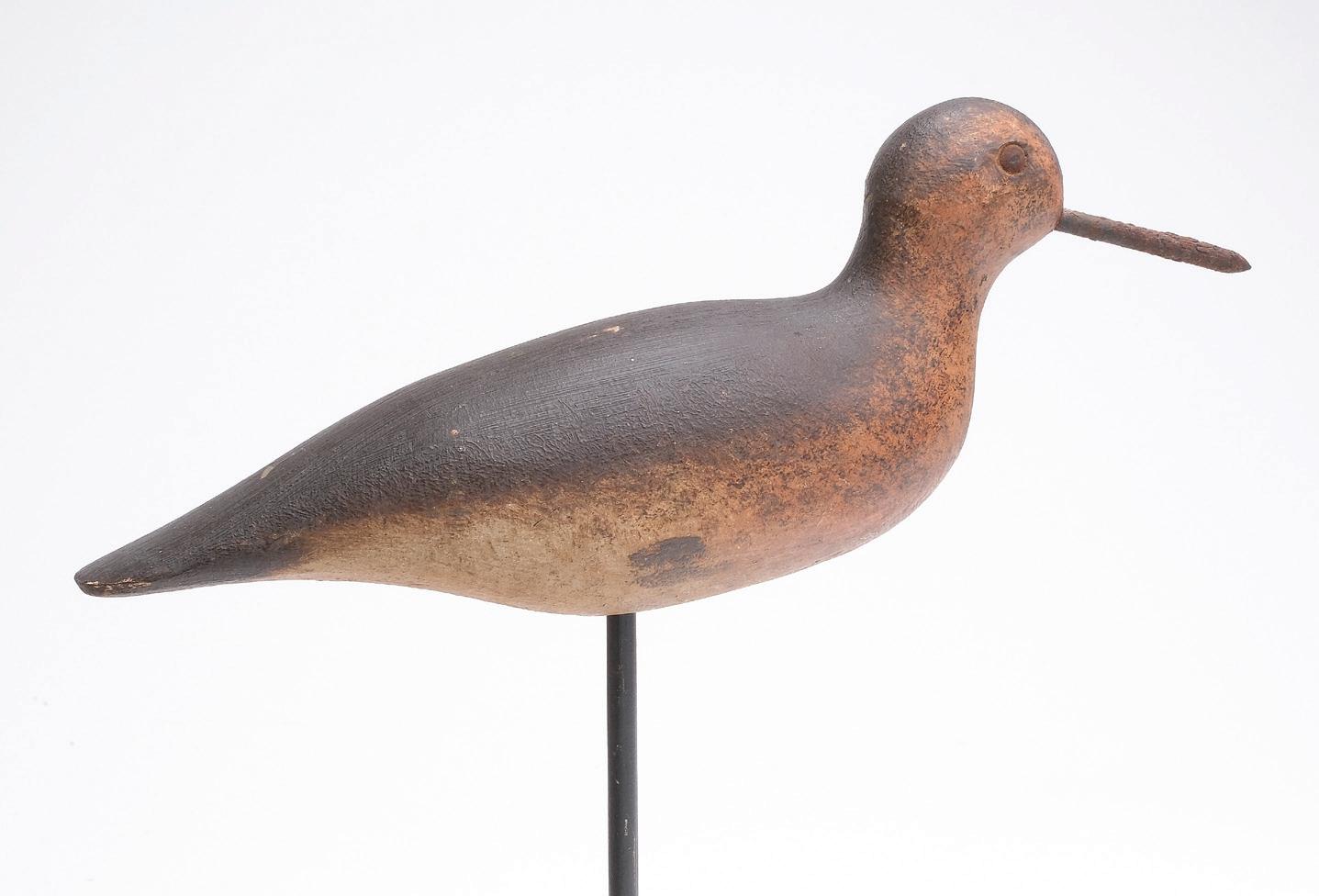


Provenance: David Fannon collection.
(2,500 - 3,500)
270
Decoy
Detroit, Michigan, circa 1900. Tack eyes with iron bill. 10” long. Good original paint; shot scar on one side of body; small paint smudge on the other; one rust stain approximately .25” round behind one eye.
(1,800 - 2,200)
181
Red knot, Mason
Factory,
268 269 270
271 Excellent mallard, Mason Decoy Factory, Detroit, Michigan, 1st quarter 20th century. Hollow carved, premier grade with relief bill carving and glass eyes. Decoy was never rigged or weighted. Measures 18” long. Outstanding dry original paint with very minor wear; ink lettering on sides from being wrapped in newspaper; dent in each side and on back near neck seat.

Provenance: David Fannon collection. (4,000 - 6,000)

182
272 Excellent mallard hen, Mason Decoy Factory, Detroit, Michigan, 1st quarter 20th century. Hollow carved, premier grade with relief bill carving and glass eyes. Decoy was never rigged or weighted. Measures 17.75” long. Outstanding untouched original condition, with only a few minor paint rubs; excellent structurally.

Provenance: David Fannon collection. (3,000 - 5,000)

183
273
Rare Canada goose, Mason Decoy, Factory, Detroit, Michigan, circa 1915. Premier grade with loop feather paint detail. Measures 24.5” long. Original paint with minor discoloration and wear; tight crack in one side as well as the underside; professional bill repair with touchup in that area; slight separation at a knot in the back.

Literature: “Mason Factory Decoys,” Russ Goldberger and Alan Haid. (12,000 - 18,000)

184
274 Bluewing teal, Mason Decoy Factory, Detroit, Michigan, 1st quarter 20th century. Hollow carved premier grade with relief bill carving and thick paint detail. Measures 12” long. Original paint with minor to moderate flaking on lower half of decoy; very slight separation at neck seat; hairline crack on one side of back; a thin 2” long line of touchup on one side.

(5,000 - 7,000)
275 Rare early style coot, Mason Decoy Factory, Detroit, Michigan, circa 1900. Up looking and slightly turned head. Measures 11” long. Original paint with very minor wear; several small dents; professional neck crack repair; thin 3” crack in underside.
(4,000 - 6,000)

185
276 Redhead, Mason Decoy Factory, Detroit, Michigan, 1st quarter 20th century. Challenge grade with incised bill carving. Measures 15” long. Original paint with minor gunning wear; areas of touchup on each wing patch and around neck seat; thin varnish layer has worn unevenly on head and breast; drying crack along the underside. (800 - 1,200)
277 Bluewing teal hen, Mason Decoy Factory, Detroit, Michigan, 1st quarter 20th century. Hollow carved, premier grade with relief bill carving. Measures 12” long. Original paint under a thin coat of varnish with minor gunning wear; old over paint was taken off of wing patches; small area of touchup on each side near tail; wooden patch in back from when the decoy was made with slight separation and a nail added; second coat of paint on the underside.
Provenance: Mark and Ann Terry collection. (1,500 - 2,500)
278 Mallard, Mason Decoy Factory, Detroit, Michigan, 1st quarter 20th century. Challenge grade with incised bill carving. Retains the challenge ink stamp on the underside. Very deep rig brand on the underside. Measures 16.25” long. Original paint with minor gunning wear; a few small dents and shot marks; professional tail chip repair; separation at neck seat; drying split along the underside.
Provenance: Mark and Ann Terry collection. (800 - 1,200)
279 Black duck, Mason Decoy Factory, Detroit, Michigan, 1st quarter 20th century. Challenge grade with incised bill carving and glass eyes. Extensive feather looping on body. Measures 16.5” long. Original paint with minor wear; typical tail chip repair; drying crack along each side; drying cracks in breast and a split along the underside that has caused an inlayed weight to fall out; minor roughness on tip of bill. (1,200 - 1,800)




276 278 277 279
280 A near perfect mallard drake, Dodge Decoy Factory, Detroit, Michigan, last quarter 19th century. Glass eyes with fine high quality Dodge detailed painting. 16” long. A small rub at the tip of one side of bill; factory filled crack at back; this decoy has never been rigged. (2,500 - 3,500)
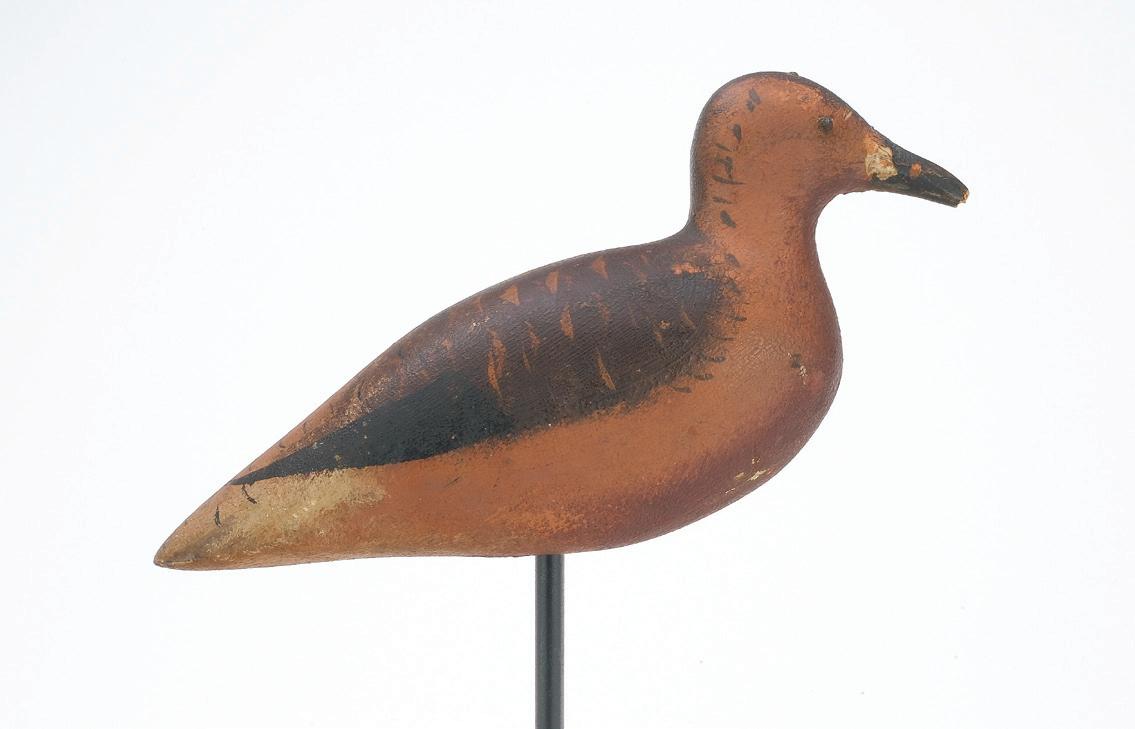


187 280 281 282
281 Ruddy turnstone, Dodge Decoy Factory, Detroit, Michigan, last quarter 19th century. Tack eyes and wooden bill. 9” long. Strong original paint with some shot mostly to one side of body and head; rub at tip of bill and tail. (800 - 1,200)
282 Rare red knot, Dodge Decoy Factory, Detroit, Michigan, last quarter 19th century. Tack eyes with wooden bill. Classic Dodge feather painting on back. 10” long. Strong original paint with a few shot scars; flaking near stick hole and one side of breast and area where bill meets face; rough edge to tip of bill. (1,800 - 2,200)
Illinois River


188
283 Rigmate pair of mallards, Charles Perdew, Henry, Illinois, circa 1950. Both painted by Charlie. Fine comb painting on drake. Heads are slightly turned. Both retain the original Perdew weights. 16” long. Near mint.
(6,000 - 9,000)
(3,000 - 5,000)
284 Pintail, Bert Graves, Peoria, Illinois, 2nd quarter 20th century. Hollow carved with comb feather paint detail. “GFS” painted on the underside. Measures 17.75” long. Original paint with minor crazing and wear; early coat of varnish has darkened slightly; old chipping on one side of bill; filler above nail holes has flaked away; weight has been removed.


285
hen, Bert
Peoria, Illinois, circa 1920s. Hollow carved. Retains Graves weight on underside. Measures 17” long. Original paint with good feather paint detail and very minor wear; a few tiny dents; small shot scar under one edge of tail.
Literature: “Decoys of the Mississippi Flyway,” Alan Haid. (6,000 - 9,000)
189
Fine “white sided” mallard
Graves,
284 285
286 Hollow carved canvasback drake, Bert Graves, Peoria, Illinois, 2nd quarter 20th century. Retains Graves weight. Good feather paint detail. Kirby Roberts collection sticker on underside. Measures 17” long. Original paint with minor discoloration and wear; structurally good. (3,000 - 5,000)

287 Mallard, Bert Graves, Peoria, Illinois, 2nd quarter 20th century. Hollow carved with comb feather paint detail on sides. Retains the original Graves weight. Measures 17.25” long. Original paint with moderate flaking and wear; surface has darkened slightly from an early coat of varnish; lightly hit by shot; minor separation at a small knot in tail. (1,500 - 2,500)
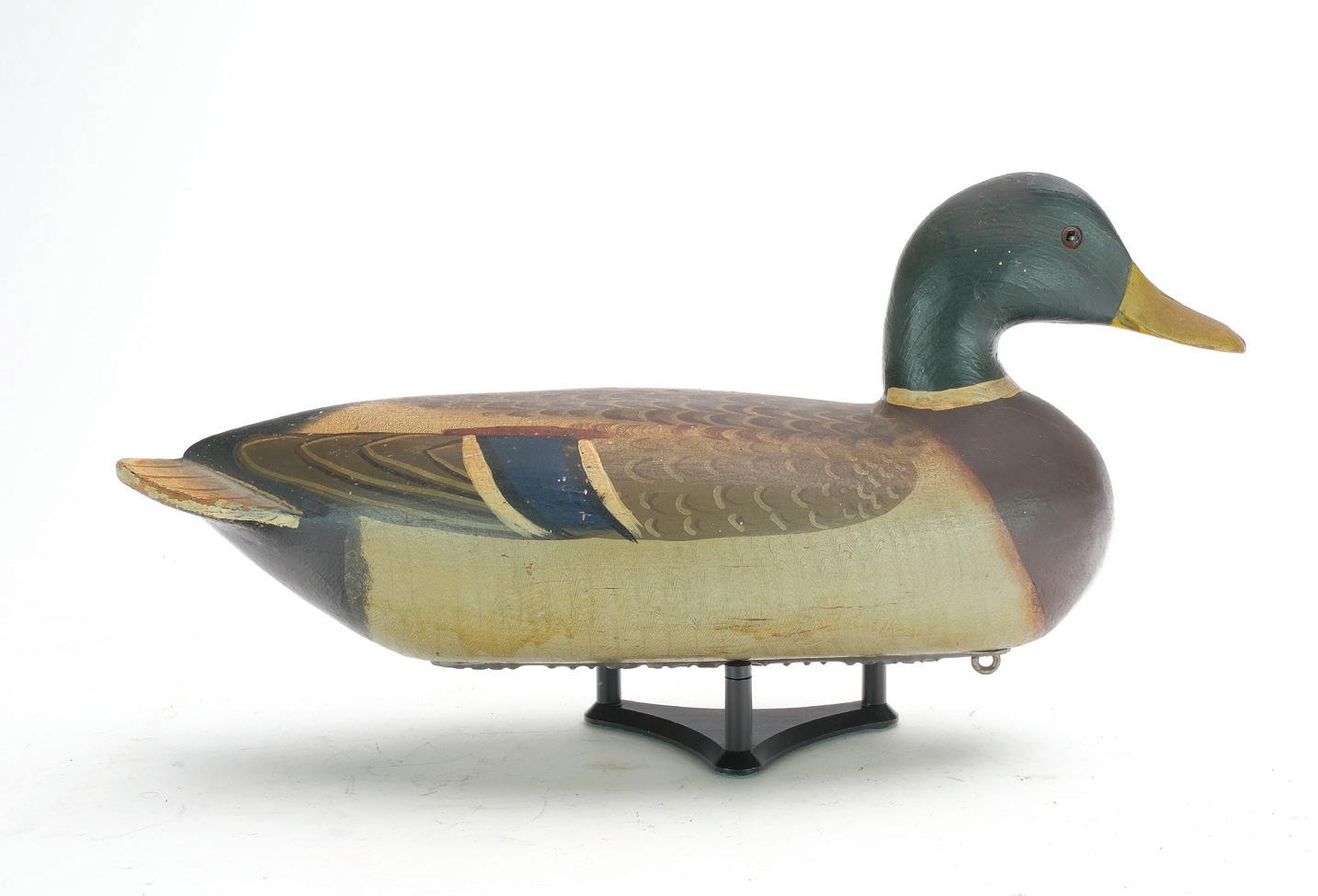
288 Mallard drake, Charles Perdew, Henry, Illinois, 2nd half 20th century. Two piece hollow body with original Perdew weight. Measures 16” long. Strong original paint protected by a coat of varnish that has darkened very slightly; a few small specs of discoloration on top of back; very small amount of flaking at head. (2,500 - 3,500)

190
286 287 288
289
Very early pintail drake, Charles Perdew, Henry, Illinois, 1st quarter 20th century. The earliest style of three piece body, with pencil weight. Measures 16” long. Old working repaint with traces of original; crack at neck; heavy in use wear.
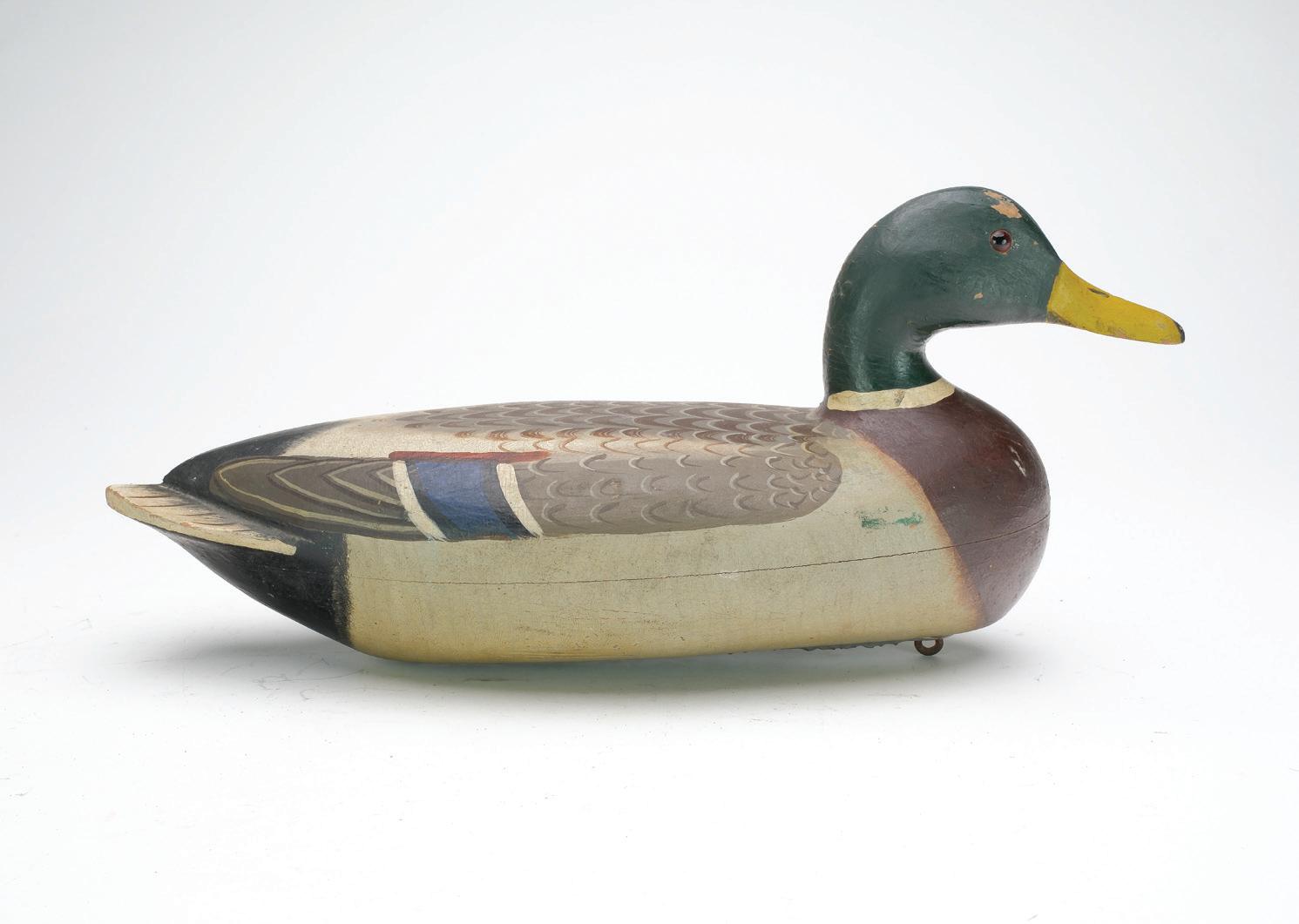

Provenance: Recently deaccessioned from an East Coast Museum. (1,200 - 1,800)
290 Canvasback, Bert Graves, Peoria, Illinois, 2nd quarter 20th century. Hollow carved with comb feather paint detail. Appealing scalloping where white meets the black. Measures 17” long. Original paint with moderate gunning wear; drying crack around one side of neck seat; very slight separation at body seam; weight has been removed. (2,000 - 3,000)
291 Mallard, Charles Perdew, Henry, Illinois, 2nd quarter 20th century. Hollow carved with comb feather paint detail on sides. Retains the original Perdew weight. Measures 16” long. Original paint with minor flaking and wear under a thin coat of varnish; minor roughness on one edge of bill, otherwise good structurally. (2,000 - 3,000)
 289
289
290 291


192
William Bowman
1824 - 1906 | Lawrence, Long Island
292 Rare dowitcher in content pose, William Bowman, Lawrence, Long Island, New York, last quarter 19th century. Believed by some to have been carved by Charles Sumner Bunn. Relief wing carving with extended wingtips and shoe button eyes. Measures 9.5” long. Original paint with good patina and minor wear; moderately hit by shot in one side; wear at the edges of stick hole.



193
(17,500 - 22,500)
last quarter 19th century. Relief wing carving. Measures 12.75” long. Highly detailed original paint with minor wear; hit by shot in one side; bill appears to be a professional replacement.
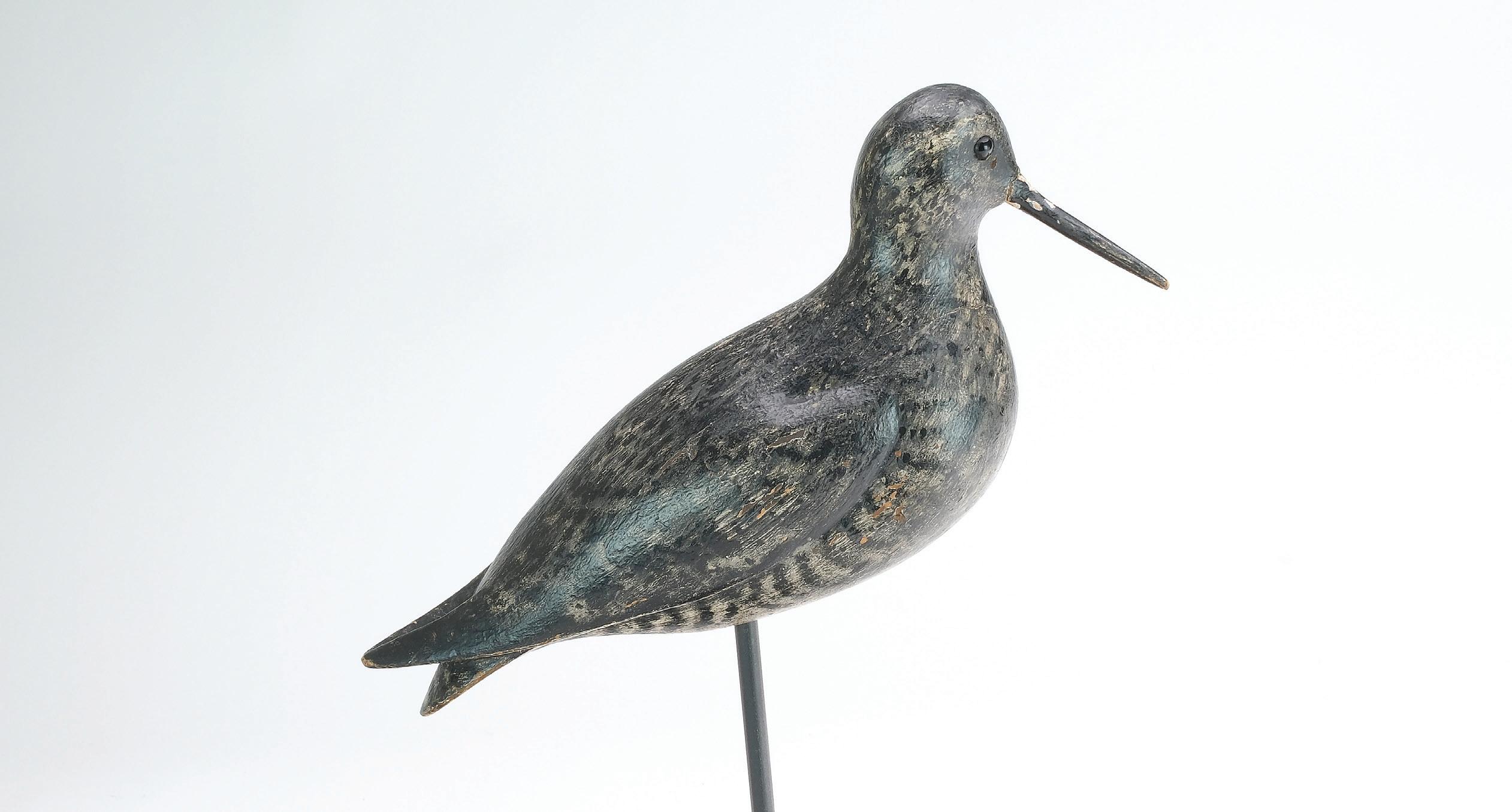
Provenance: David Fannon collection. (2,500 - 3,500)
Believed by some to have been carved by Charles Sumner Bunn. Relief wing carving with extended wingtips and shoe button eyes. Just under 12” long. Original paint with minor flaking and wear, protected under an early coat of varnish; wear to the wood at the stick hole; tight crack in breast; one raised wingtip was cracked and tightly reset.
Provenance: Formerly in the collection of Fred Caseman. (10,000 - 15,000)

194
293 294
A rare pair of black ducks. One in a back reaching position. Both have carved eyes. Both have a Christie’s auction house sticker indicating lot 168 from a previous sale. Straight head measures 16.5” long. Both are in original paint; sleeper has a rub to bare wood at tip of tail and small rub at one side of body; straight head has paint loss around areas where copper nails were used; both show light gunning wear. (1,750 - 2,250)


195
295 Pair of black ducks, Townsend Garvie Carman, Amityville, Long Island, New York, circa 1910.
295 296
296 Swimming brant from the Suydam rig, Long Island, 1st quarter 20th century. Root head, carved in swimming pose. W.L. Suydam branded in underside. Measures 18.5” long. Original paint with moderate wear; tight drying cracks in neck; drying split in the underside. (800 - 1,200)
For decades, the occasional sportsmen or carver may have kept a particular decoy simply on a whim or as a memento of a favored hunt. For hundreds of years, decoys were simply tools. One needed a decoy to hunt ducks just as one needed a hammer to build a boat! Eventually, this was to change in the early 20th century with Joel Barber, a Cornell University trained New York architect who practiced during the height of the Art Deco period. Barber, however, was not a hunter, so it is unclear what, in 1918, drew him to a dusty shed in coastal Babylon, New York on Long Island. Whatever the reason, it was here that he chanced upon a discovery that was to change his life and usher in the beginnings of the recognition of decoys as an American folk art form. His eyes fell upon a hen merganser which struck him as something other than merely an object used to attract its live brethren. He saw the decoy as sculpture – it was more than a tool, it was art. This revelation was to become his obsession for the remainder of his life. He began to visit old boat yards and fishing shanties along the length of the Atlantic seaboard in search of additional examples. Along the way, he met and befriended men whose names are now synonymous with some of the finest decoys ever produced. He began to promote the decoy as art to likeminded individuals. He helped to organize the first decoy show in the country on Long Island in 1923. As early as 1931, he was giving talks and staging public exhibits of decoys at locations such as Abercombie and Fitch in downtown Manhattan, an establishment that catered to the most influential sportsmen of the day. As more and more
people began to appreciate a decoy as more than a simple lure, national publications began to take notice, including Fortune Magazine who published an article on his collection in 1932. During his travels, in addition to collecting and recording some of the earliest provenance about decoys, his architectural and drafting skills enabled him to record some of the first renderings of important examples. These notes and drawings were the seeds for the monumental and seminal book on decoys, his 1934 “Wildfowl Decoys”, published by Eugene Connett. This thesis became the bible that sparked a new generation of individuals that shared his passion for decoys as folk art to be collected, studied, and cherished.

196
1876 - 1952 | New York, New
Joel Barber
York and Wilton, Connecticut
Joel Barber. Photo credit Gene Kangas
“A dapper little man with a fondness for tidewater and bourbon Manhattens”
After his retirement in 1940, Barber moved to Wilton, CT where he lived with his son, David. It was here, in an old chicken coop, that he established the first museum dedicated to decoys, his “Shanty Museum of Old Decoys”. During his waning years, he never abandoned researching, recording and amassing decoys and their history. He died of a heart attack at his workbench while working on his second book on decoys.


Upon his death, with the assistance of sporting artist Ogden Pleissner, Barber’s decoys and writings were donated to the Shelburne Museum in Vermont, where they became the nucleus for their outstanding Dorset House collection. His role in promoting the lowly decoy to the status it enjoys today cannot be overstated and this is his just legacy.
The never-before-seen small assemblage of assorted items, mostly from his desk, being offered here, have, until now, been retained by the family. They provide an intimate insight into the private life of the man who changed the face of decoy collecting forever. Their historical significance is immense.

197
Shanty Museum of Old Decoys
297 Joel Barber (1877-1952), watercolor. Important original watercolor of the ‘Havre de Grace’ or Holly swan, as it is now known. Signed and dated 1950 lower right. With the inscription “In the afternoon it began to snow.” Barber’s monogram in upper left. Image measures 18” x 26”. A few small spots of foxing around white edges of mat; professionally framed and matted.
Provenance: Joel Barber collection. (8,000 - 12,000)

198
298 A unique and important shadow box made by Joel Barber. With a carved miniature version of the Havre de Grace swan, made as a scale model. With painted background. Decoy measures 5” long, shadow box is 8” x 12”. Glass is dirty; swan has discoloration and some small areas including where neck is pieced together.

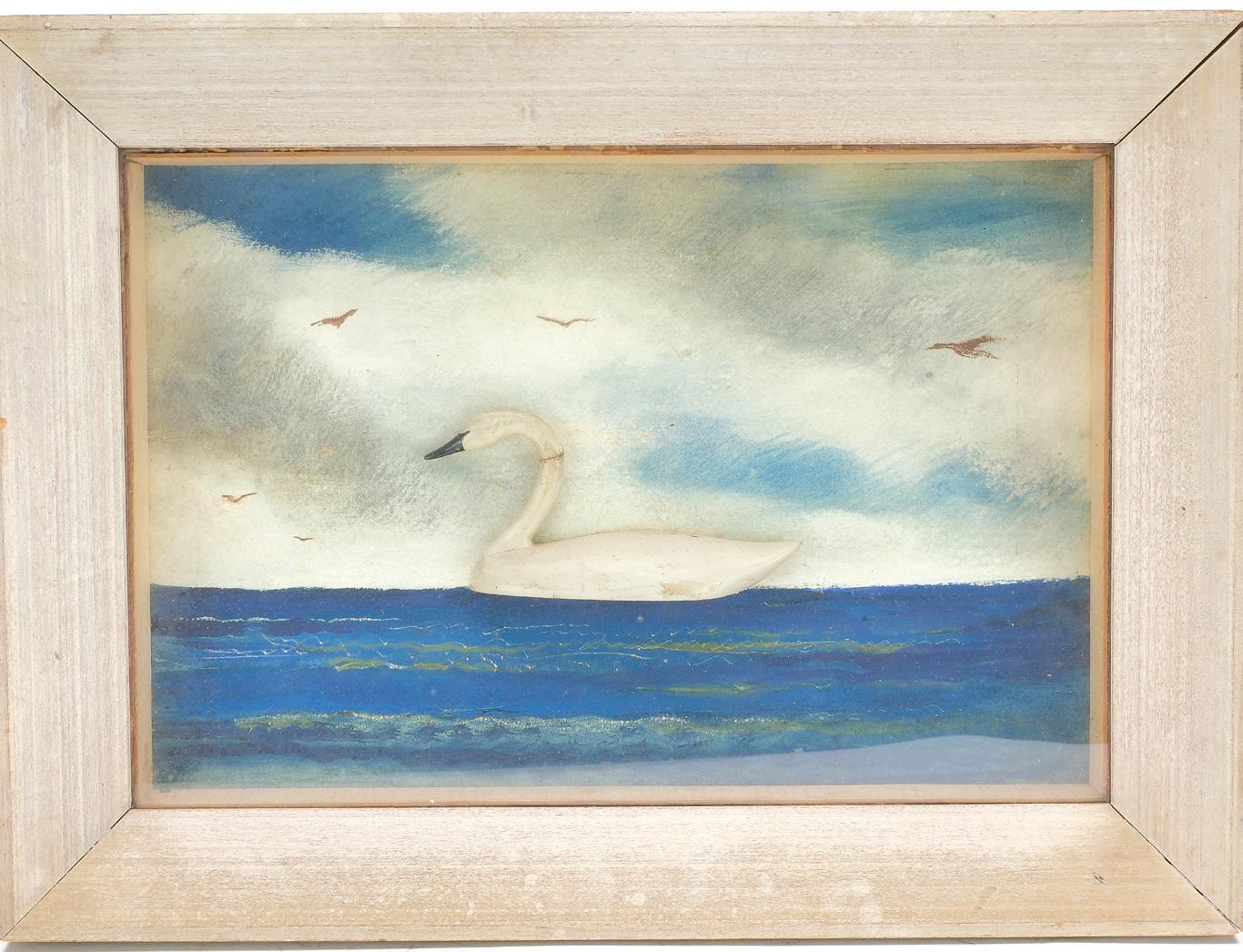
Provenance: Joel Barber collection.
(2,000 - 3,000)
298a Two small original images, Joel Barber. A small architectural drawing of the Havre de Grace swan, Joel Barber. Dated 1937. Image measures 5” x 5”. Second is mallard head decoy, illustration of a Saskatchewan Canada head decoy with provenance on back of picture dating to 1928. Illustration of this in Barber’s book. Slightly darkened with very small stains.

Provenance: Joel Barber collection.
(1,000 - 1,500)
299 A maple turning pattern for a canvasback body, Joel Barber, Wilton, Connecticut, 2nd quarter 20th century. Used on a duplicating lathe for decoys created by Joel Barber. Sticker on underside with a date of 1940. Measures 14” long. All but underside has been protected by a coat of varnish that has mellowed slightly; structurally good.

Provenance: Joel Barber collection.
(1,000 - 1,500)
300 Canvasback drake, Joel Barber, Wilton, Connecticut, 2nd quarter 20th century. On the underside of tail in white paint reads “Model made by Joel Barber 1940”. Body is hollowed and open on underside. Head is turned. Measures 16” long. Original paint with white area showing heavy amount of flaking down to the primer coat.

Provenance: Joel Barber collection.
(2,000 - 3,000)
199
298
298a
299 300
301 Shop sign from Joel Barber’s personal garage or barn. The letters “Barber” are screwed into the front and appear to be cast metal. Made from a 1.25” thick board. Measures 23” in length. Original paint with flaking and wear from exposure to outdoor elements.

Provenance: Joel Barber collection. (300 - 500)
302 Three duck heads created by Joel Barber. Two are brass, one of which is mounted on a marble base. One is ceramic. All measure approximately 6” in length. Ceramic has a break repair at neck and some discoloration on one side of bill.



Provenance: Joel Barber collection. (1,200 - 1,800)
303 Three brass and one wooden silhouette flyer. All made by Joel Barber. Measure 7” long. Wooden flyer has break that has been reattached at one wing and an
original coat of white paint that has discolored, also old patina with good age.
Provenance: Joel Barber collection. (300 - 500)
304 14 pieces of metal. 10 are cast ducks that vary slightly, 6 of which are heavy brass. Four appear to be a lighter white metal and one is iron. Also included are 2 half hulls made of brass that measure 6”. All show nice aged patina.
Provenance: Joel Barber collection. (500 - 800)
305 Two miniature boats. One made from wood and one made from brass. Wooden boat has a base, mast is broken but taped to the base and measures 11.5”. In original paint with parts of rigging still intact. Other boat is a hull made of brass and measures 10.5” in length.
Provenance: Joel Barber collection. (200 - 400)

200
301 304 303
302
305
306 Metal ashtray with flying ducks and JDB engraved in underside. Foundry name ‘JS Hanson Studio’. This was Barber’s personal ash tray. Bookends are heavy and appear to be made from brass, with flushing quail and picket fence. Both are 7.5” tall. Nice patina from age and use.

Provenance: Joel Barber collection. (500 - 800)
307 Six miniature birds. Standing gull from New England mounted to a cork float, measures 6.5”, original paint with slight staining and discoloration, crazing to the gray areas of wings. Two mergansers similar to Doug Jester. Measures approximately 5.5”. in original paint. A Joseph Lincoln wood duck with broken bill and reattached head, stamped Lincoln on underside. A redhead made of ceramic. And a sleeping swan made from multi colored pieces of wood, measures 7”.

Provenance: Joel Barber collection. (500 - 800)
308 Two small goldeneye from Nova Scotia, 2nd quarter 20th century. Drake is in original paint with moderate wear, discoloration to white areas, and rust bleed around
nails. Measures 11” long. Hen is in thick but original coat of paint with areas of flaking; crack in back and wear around underside and tail. 11.5” long.
Provenance: Joel Barber collection. (800 - 1,200)
310 Sleeping black duck, probably Long Island. Carved from a single piece of wood. Possibly made by Joel Barber. Second to 3rd quarter 20th century. Glass eyes. “H.W.” carved in underside. Measures 15” long. Stained or painted black on body and head, with green on bill, all of which is original; surface appears to have been stressed to create the appearance of age.
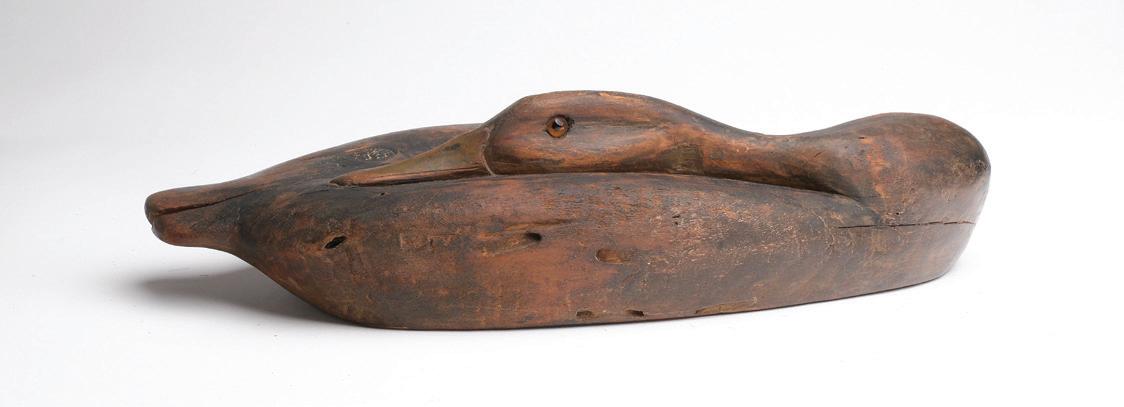
Provenance: Joel Barber collection. (600 - 800)
311 Miniature wood duck drake, probably from the eastern shore of Virginia, 2nd quarter 20th century. Carved crest and patined eyes. Wire legs. Mounted in fungi base. Measures 4.5” long. Original paint that has crazed with small amount of loss near top of wire legs.
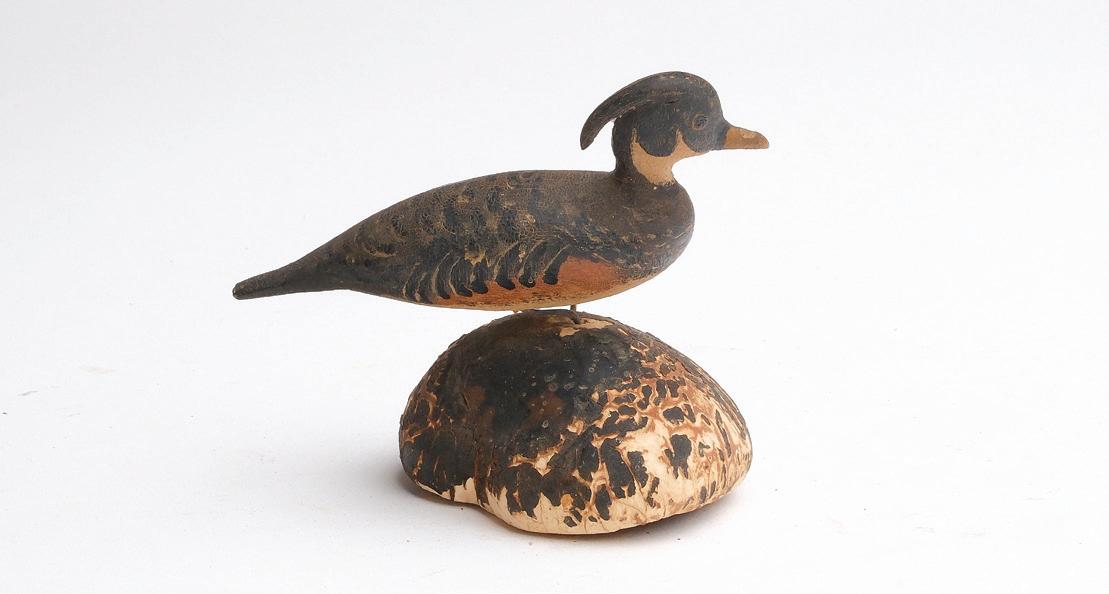
Provenance: Joel Barber collection. (300 - 500)

201 306 307 310
311
308
Frank Kellum
1858 - 1930 | Babylon, New York

Information in the decoy literature concerning Mr. Kellum is, indeed, scant. What little that has been recorded is based, almost entirely, on what was written in 1934 by Joel Barber in his “Wild Fowl Decoys”. Barber (1876 –1952) was somewhat contemporaneous with Kellum so his information deserves to be considered. He wrote:
“Kellum was a well known and picturesque figure of the ‘nineties, and apparently very talented. So much so that a group of New York sportsmen of the old Wy-Wy-an-da Club became interested and made it possible for him to go to New York to study art. Many stories are told of this episode, but it appears that the idea didn’t work out. Kellum had always followed the water and soon came back to it. What he knew of guns and boats, decoys and the Great South Bay, was enough for any man. The art of schools meant nothing at all to him”.
Both “Gunners Paradise” and “The Decoys of Long Island” add slightly to Barber’s narrative by stating that he guided at the Wa-Wa-Yanda club on Crabtree Island off Belport. Both references state that he was a “painter” and “The Decoys of Long Island” adds that he was a “carpenter”. No reference in the census can be found that lists a Frank Kellum (c1858 - c1930) as a “painter”. The 1880 Federal Census, however, does list a Frank Kellum, 22 years of age, living in Babylon and working as a house carpenter. Unfortunately, this Frank Kellum disappears from the record after that date. Much of Barber’s description of Kellum, based on his use of terms such as “apparently”, “stories are told”, “it appears”, etc, and the fact that he misspelled the name of the Wa-WaYanda club, would suggest that his material was based on information supplied to him verbally and oral history can often be notoriously inaccurate.

Needless to say, much more needs to be researched to elaborate accurately on the Frank Kellum of decoy fame. For the present we must simply enjoy the vague word-ofmouth stories about his life and, certainly, appreciate his superbly crafted decoys.
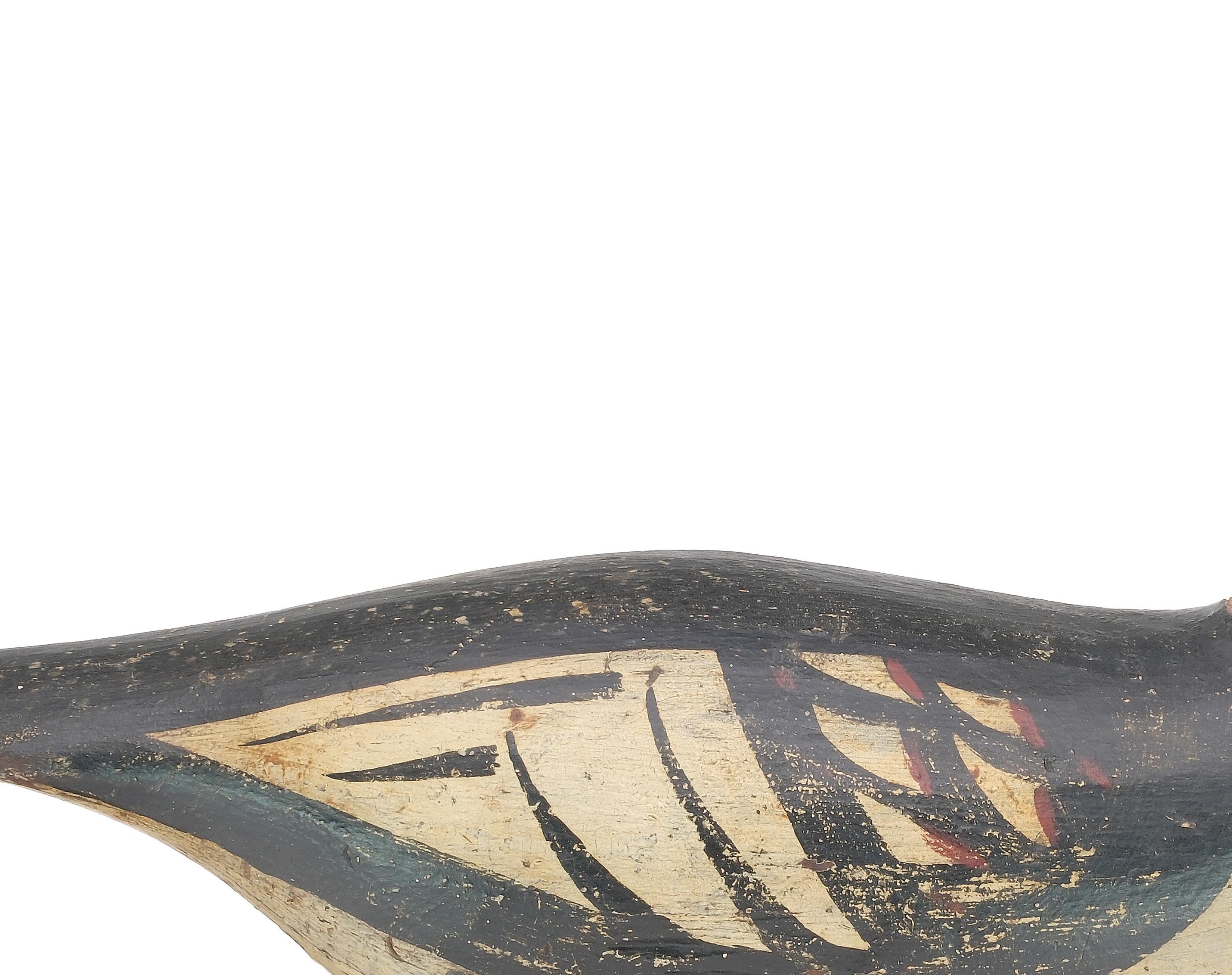
202
Hotel Dupont where Barber designed his famous decoy themed bar
Crabtree Island 1858
Babylon
Crabtree Island
While Joel Barber was waiting for a museum that was being built to house and display his decoy collection, he loaned this exact decoy to the Dupont Hotel in Wilmington, De. The hotel displayed the decoy proudly in the Brandywine room for several years. Prior to the return of the decoy to Mr. Barber, the hotel manager, Frank Gregson, ordered a special memento that was to be hung around the neck of the decoy as a reminder of its past home. The silver plate around the neck reads, “Brandywine Sheldrake” The neck plate was ordered in 1949.
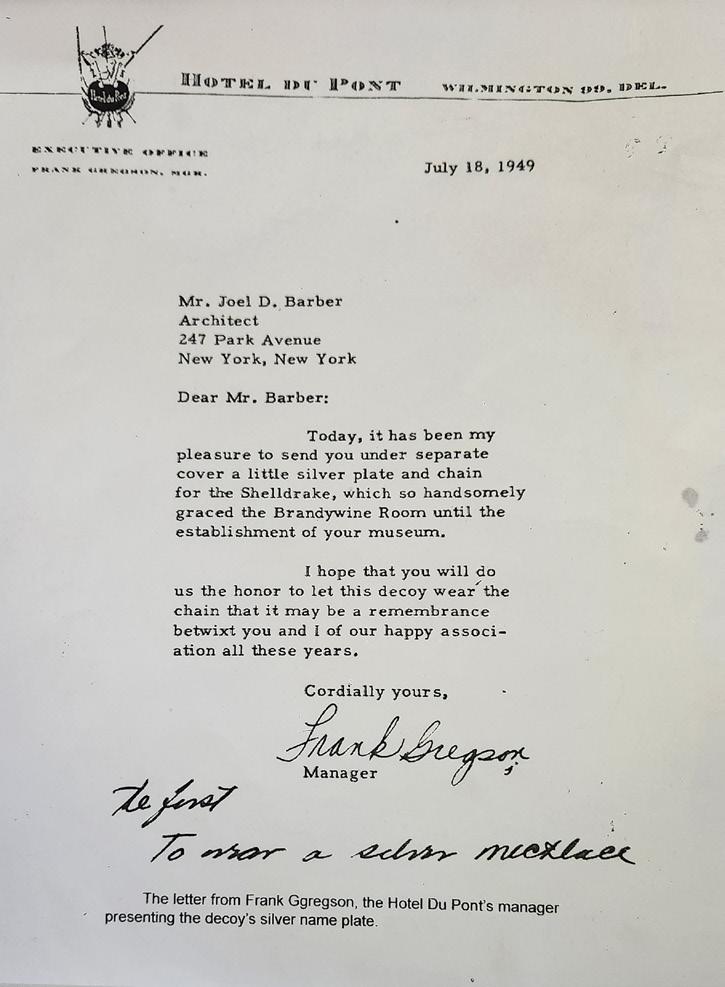

312 Very rare and important merganser drake, Frank Kellum, Babylon, Long Island, last quarter 19th century. Swimming position with a raised crest and carved eyes. Joe Barber sticker remains on underside stating “red breasted merganser, sheldrake in spring plumage by Frank Kellum, pictured in plate 91, Wildfowl Decoys by Joel Barber”. Accompanied with copy number 750 of “Long Shore” by Joel Barber, and is signed by Barber himself. Measures 18” long. Light gunning wear around body; bill repair was done at some point, possibly by Barber where putty was used to smooth it out a small amount may have also been used at front of crest; original bill pieces have remained intact; tiny spots of overpaint around neck seat to cover nails. (8,000 - 10,000)

203
313 Swan decoy, Albert Laing, Stratford, Connecticut and New York City, 3rd quarter 19th century. Twopiece hollow body with slightly raised and canted neck seat. Ice groove behind neck. Underside is branded ‘F. Burritt’ for the gunning rig of Francis Burritt (1850-1928). Measures 23” long. Numerous coats of old white paint; seam separation at body with a few imperfections in wood.

Provenance: Joel Barber collection. (8,000 - 12,000)

Provenance: Joel Barber collection. (4,000 - 6,000)
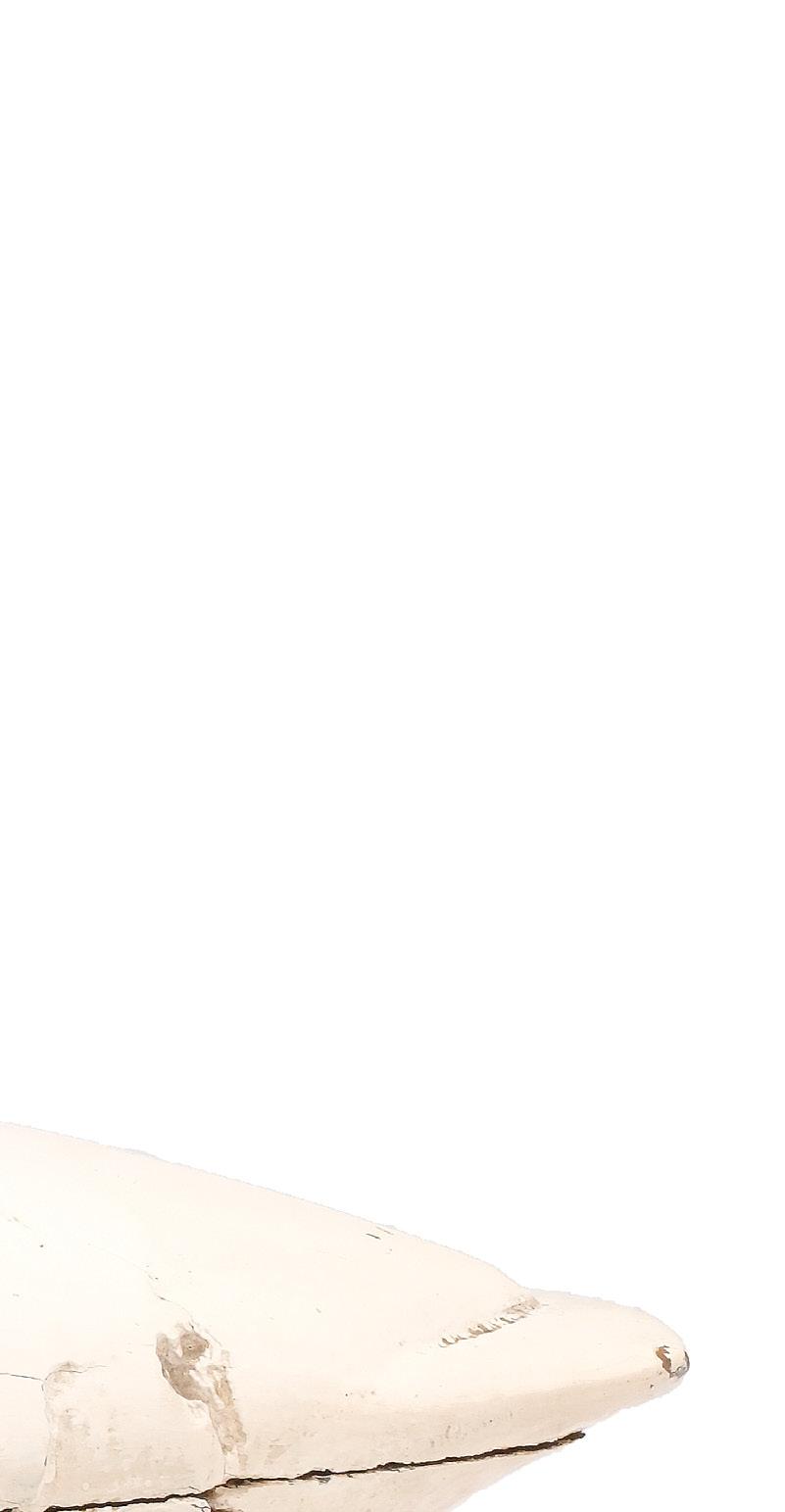
314 Curlew, from a member of the Verity Family, Seaford, Long Island, last quarter 19th century. Relief wing carving and carved eyes. Measures 12” long. Appealing old in use repaint with numerous shot marks; bill is broken and missing; wear around tail and crazing that has exposed bare wood.



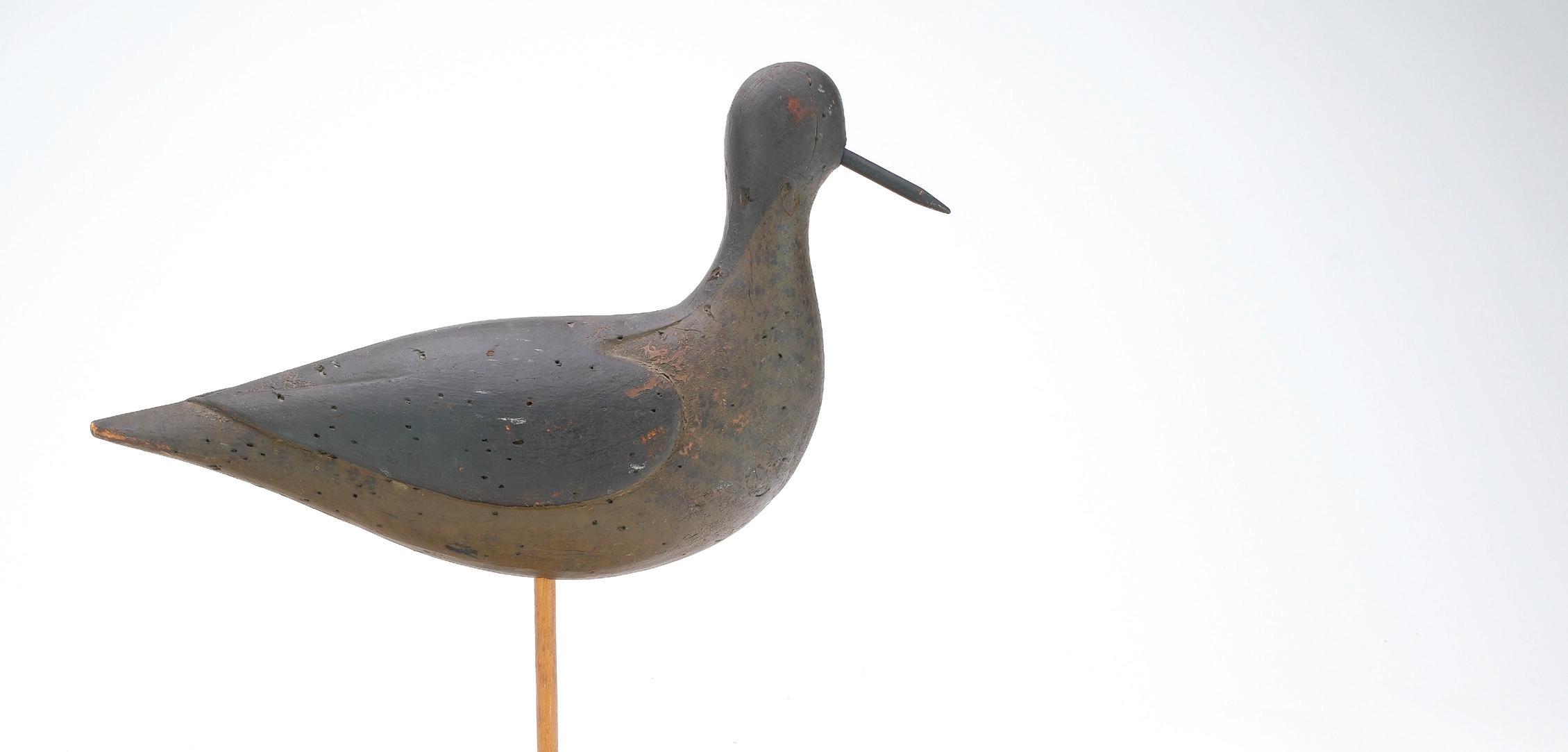
Provenance: Joel Barber collection. (1,000 - 2,000)
mellowed nicely to reflect age; one small chip with paint missing on side of head.
Provenance: Joel Barber collection. (800 - 1,200)
314 315 315 316
315 Sora rail, Charles E. ‘Shang’ Wheeler, Stratford, Connecticut. In walking pose with glass eyes and wire legs mounted to carved lily pad base. 6.5” in height. Original paint with small areas of restoration to both thighs, tip of tail, toes, and bill by Russ Allen.
316 Well executed miniature swan, carved from balsa wood. With “Ry Taggart Elkton Maryland 1953” written on underside. Wings are raised and separated. Measures 8” long. Original white paint has
James Brade Sword
1839 - 1915
Acclaimed for his sporting, landscapes, seascapes, portraits, and genre scenes, Sword was born in Philadelphia to Captain John D Sword and Mary Parry (see note 1). He spent between 1840 and 1849 in Macao, China while his father was engaged in the tea and silk business. Returning to Philadelphia, he received a high school education in 1855 and spent his early years employed as a civil engineer, engaged in projects ranging from canal construction and railroad tunnels to conducting coastal surveys.
Between 1861 and 1863, he had begun to focus on sketching and enrolled in the Pennsylvania Academy of the Fine Arts where he studied under landscape artist, George Washington Nicholson and, later, with William Trost Richards, and Christian Schussele. In 1869, he married his wife, Matilda, and they would ultimately have four children. He briefly worked in the silversmithing trade but returned to a career as an artist by 1871, opening a studio in New York.
During his lifetime he traveled extensively, with trips ranging from the mountains of the Adirondacks, the Alleghenys, the Green and White Mountains in Vermont and New Hampshire, to the coastal regions of New Jersey, Bar Harbor, Maine, Lake George, New York and Conanicut Island, Rhode Island. While at Lake George, he met and painted with Asher B Durand and, in 1889, while at Conanicut, he built a summer home for himself and his family while enjoying painting along its shores.
He was active in the art community, becoming the founder of the Art Club of Philadelphia and serving as president of both the Artist Fund Society and the Philadelphia Society of Artists.
During his lifetime he exhibited widely, including showings at The Pennsylvania Academy of the Fine Arts, The Centennial Exhibition, The American Art Association, The Brooklyn Art Association, The Art Institute of Chicago, The National Academy of Design, The American Watercolor Society, The Art Institute of Chicago, and The Boston Arts Club, among others.
His works are included in some of the finest public and private collections, such as The Colby College Museum of Art, The Reading Public Museum, The Farnsworth Art Museum, The Pennsylvania Academy of the Fine Arts, The University of Pennsylvania, the Brigham Young University Museum of Art, the Yale University Art Gallery, the Boston Art Club, The Smithsonian American Art Museums, and the Boston Museum of Fine Art. His portrait of former speaker of the US House of Representatives, John W Jones, hangs today in the Speaker’s Lobby at the US Capital.
While the Chesapeake is synonymous with the canvasback and the sinkbox, Sword’s engrossing “Duck Shooting Chesapeake Bay, Maryland” wonderfully depicts another equally fascinating aspect of gunning the Bay, by portraying two hunters shooting out of grassed in sneakboats, hunting puddle ducks, along a secluded shore.

James Brade Sword is buried in the Laurel Hill Cemetery in Philadelphia, PA.
Notes: One genealogical source states that he was born at sea, presumably on route to China.
317 James Brade Sword (1839-1915), oil on canvas. Titled “Duck Shooting: Chesapeake Bay”. Signed lower left and dated 1883. Image measures 23.5” x 35.5”. Gold gilt frame measures 30” x 42”. Exhibition sticker on verso from Terra Museum of American Art, Evanston, Illinois. From the exhibition of Life in 19th century America. Collection of Arthur J Phelan. As viewed under black light painting appears to have been lightly cleaned and re-varnished; no visible tears or punctures; canvas has been relined.
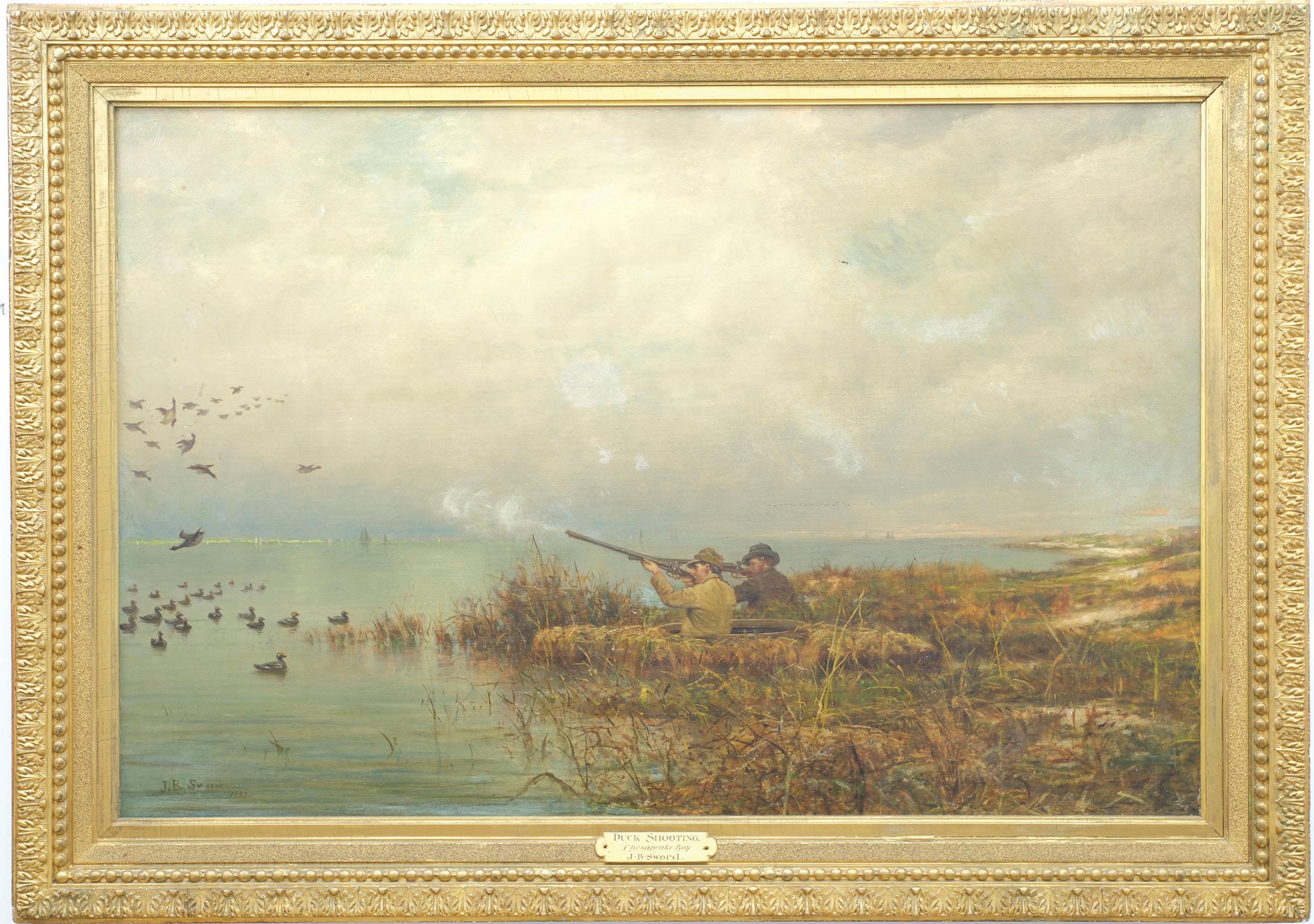
Provenance: David Fannon collection. (25,000 - 35,000)
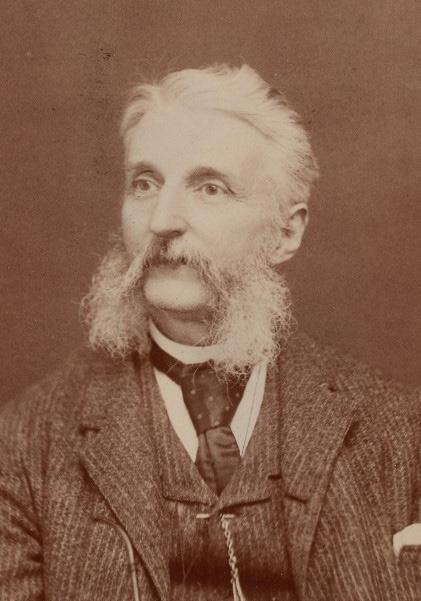
207
Lynn Bogue Hunt
1878 - 1960
Born in Honeoye, (Mendon), in northern New York, the young Lynn Bogue Hunt spent most of his childhood in Albion, Michigan with his, then divorced, mother. Here, he developed his deep love of the outdoors and had the first of his lifelong experiences with hunting and fishing. While in high school, he took art lessons from a professor at Albion College and, ultimately, went on to attend that school. While a student there, he made his debut on the national scene with “A King of Game Birds,” a story on ruffed grouse that he wrote and illustrated for Sports Afield. He worked for three years as staff artist for the Detroit Free Press and, in 1903, he made his dramatic move to New York City where he began his long career as artist and illustrator. He soon received numerous accolades and commissions and became very successful. During the Depression, he made as much as $50,000 a year – about $650,000 in today’s dollars. He moved to Long Island where he commuted to the city daily from his fashionable home, complete with a maid, in Hempstead (Long Island). A bon vivant, appearances mattered to Hunt, and he was known to be a meticulous dresser. His marriage to Jessie Bryan became contentious, and he made no secret of his long relationship with his mistress. An early conservationist, he advocated catch and release gamefishing as early as 1935 and eagerly supported the newly formed Ducks Unlimited. He became friends with the leading sportsmen and writers of the day such as Ray Holland, Earnest Hemingway, Zane Gray, Burton Spiller, Gordon MacQuarrie, and others.

A list of his accomplishments is, indeed, a lengthy one. He completed about 250 separate covers for nearly 40 magazines including over 106 cover illustrations for Field & Stream alone. He designed corporate murals, the 1939/40 Federal Duck stamp and he illustrated numerous books such as Game Birds of America, Grouse Feathers and More Grouse Feathers and, his own, An Artist Game Bag.
Hunt was, undisputedly, the most famous outdoor artist and illustrator of his time. “His work has come to define the look, feel, and abundant unfettered spirit of what was truly the Golden Age of American Field Sports.” Beginning to lose his sight, he cleaned his brushes for the last time in 1951 and lived out the remainder of his life in semi seclusion at his home in Western Long Island. His obituary in the New York Times described him as “The Audubon of his time,” a characterization that surely would have pleased him.
318 Lynn Bogue Hunt (1878-1960), oil on canvas. Titled “Down by the Rio Grande”. Illustrated in “A Book On Duck Shooting”, Van Campen Heilner, Penn Publishing, 1939. Signed lower left. Pintails pitching into the Rio Grande with hunter in blind. Image measures 21.25” x 15.5”. Carved gilt frame measures 27” x 20”. Under black light image appears excellent; varnish coat that has darkened and would benefit from a light cleaning.
Provenance: David Fannon collection.
Literature: “A Book on Duck Shooting”, Heilner Van Campen, page 122, exact image pictured. (12,000 - 18,000)
208

209
Edmund Henry Osthaus

1858 - 1928
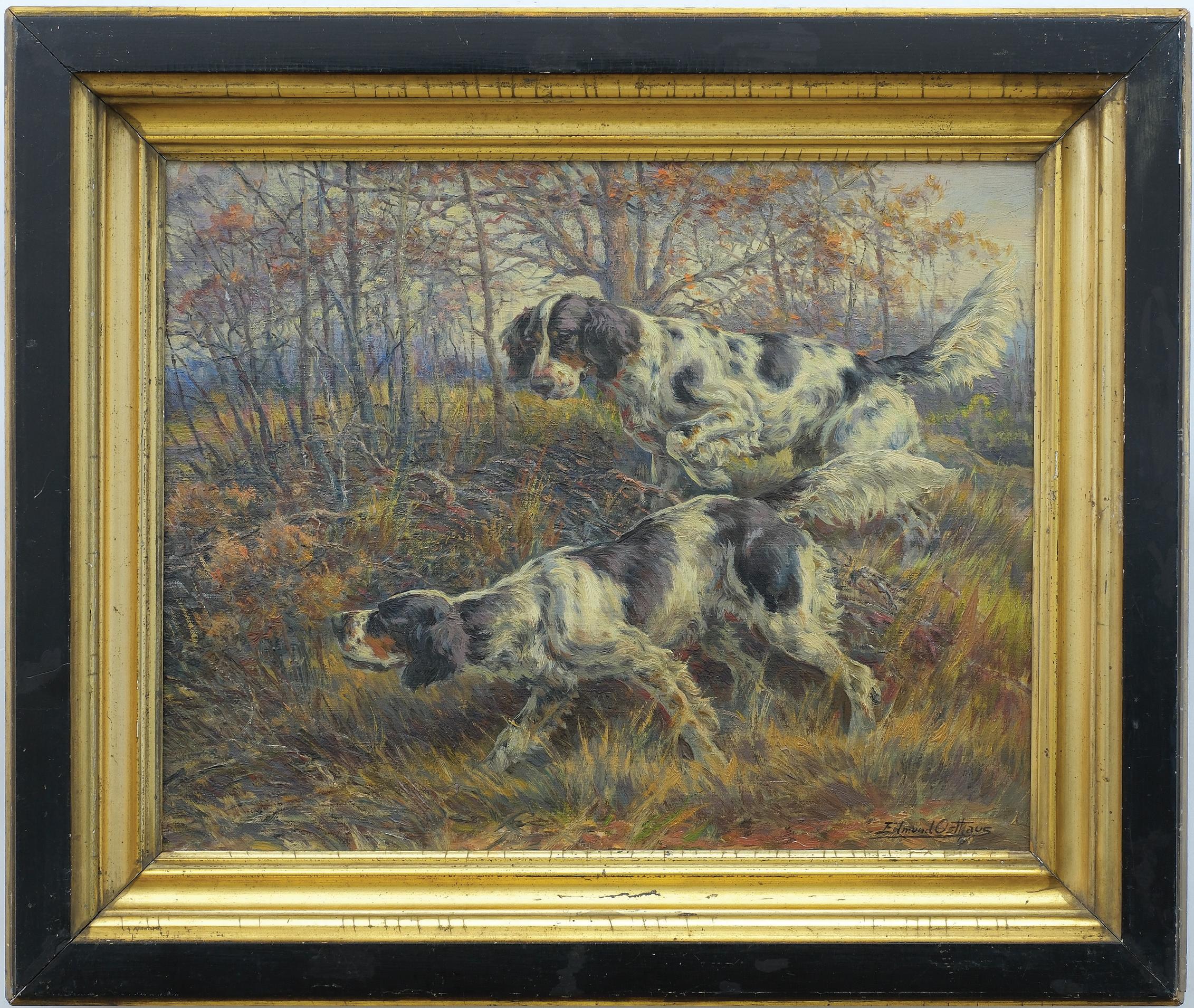
211
319 Edmund Henry Osthaus (1858-1928), oil on canvas. Two English setters on point. Signed lower right. Image measures 16” x 20”, frame measures 22” x 26”. As viewed under black light image is very good and original; period frame has had some inpainting around black areas.
Provenance: David Fannon collection. (20,000 - 30,000)

212
320 Lynn Bogue Hunt (1878-1960), oil on canvas. 25.5” x 17.5”. Signed lower left. Titled “Traveling Companions”. Painting has been relined and professionally conserved with craquelure filled and revarnish mostly in blue sky areas of clouds.
Provenance Ex Jim Cook collection. (6,000 - 9,000)
Image measures 15.5” x 19.5”. Frame size 22” x 26”. As viewed under black light appears that some of the deeper yellow color in upper right was applied on top of varnish but not likely restoration; frame has small chip lower left.


(2,500 - 3,500)
Signed lower left. Image size 16.5” x 10.5”. Frame measures 20.5” x 15.5”. As viewed under black light surface is excellent.
(3,000 - 4,000)
213
321
322
321 George Brown (19181958), oil on canvas.
322 John Henry “Hy” Hintermeister (1869-1945), oil on canvas. Image of flushing birds and hunter taking aim. Fall color scene. Exhibited at the Brush with Wild: A Sporting and Wildlife Exhibit, Bozeman, Montana.
323 Aiden
(1896-1969), watercolor. Titled “The Grouse Hunter”. A well executed and finely detailed example of Ripley’s best work. Signed A. Lassell Ripley lower left. Image of hunter with double barrel, dog, and flushing grouse. Image measures 19” x 15”. As viewed under blacklight excellent and original; professionally framed and matted. (18,000 - 22,000)

214
Lassell Ripley
324 Hy Sumner Watson (1868-1933), oil on canvas. A cover art illustration for the 1910 Field and Stream Magazine, which a copy of is framed and included with this lot. Signed lower right. Image measures 29.5” x 20.5”. As viewed under black light a small amount of crazing is visible in two spots; a partial tear approximately .75” near Watson’s name lower right and a repair to a tear in the trees center top with some inpainting in that area.
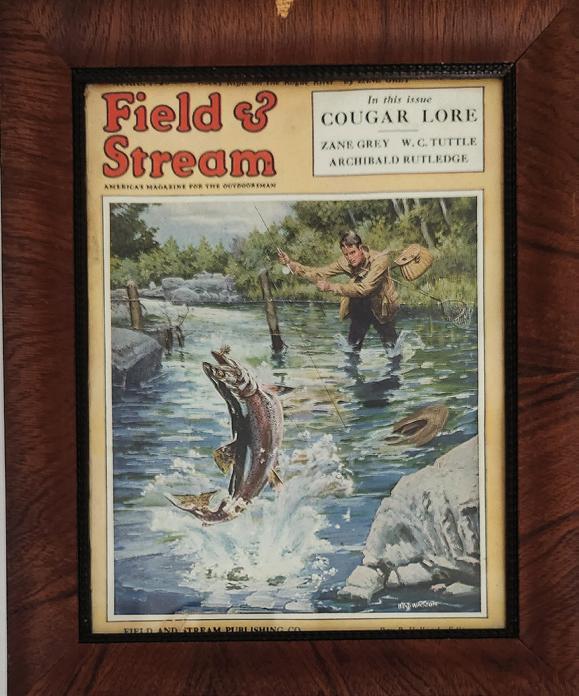
Provenance: David Fannon collection. (4,000 - 6,000)

215

216
325 George Viavant (1872 - 1925), watercolor. Image measures 20” x 15”. Signed and dated lower left, “New Orleans 1920”. Image remains in very good condition. (6,000 - 9,000)
Image of pheasant flushing with hunter and two dogs. Fall scene with peak foliage. Signed lower left. Image measures 19.5” x 25.5”. Frame measures 28.5” x 36”. As viewed under black light excellent and original. (3,500 - 4,500)


38” x 28”.
lower left. As viewed under black light small spots of flaking have been professionally restored, almost exclusively in the upper half of the painting. (5,000 - 7,000)
217
326
327
326 Ralph Crosby Smith (1907-1962), oil on canvas board.
327 Reginald Bolles (1887-1967), oil on canvas board.
Signed
328
used as an illustration
produced
It also retains a label stating “This drawing is the property of A.B. Frost. Please handle carefully and return to 330 Chestnut Street”. An early gallery letter from 1984 is taped to the back, as well as Red Fox Fine Art sticker. Image measures 12” x 14.5”. Professionally framed and matted in quality gilt frame that measures 18” x 21”. One small foxing spot and a piece missing approximately 1/16” x 1/8” near hunter on right hand side.

Provenance: David Fannon collection.
(8,000 - 12,000)
218
Arthur Burdett Frost (1851-1928), ink & gouache on paper. Titled “Quail Shooting - Walking Up”. Two hunters and two setters. Signed lower right. This piece was
for a print
in 1881.
329 Hugh Monahan (1914-1970), oil on canvas. Titled “Evening Feed in the SnowHonkers”. Retains original gallery sticker from Abercrombie & Fitch Company Madison, New York. Canada geese setting into a snow covered corn field. Signed lower right, and dated 1950. Image measures 19.5” x 29.5”. Condition remains excellent. (2,000 - 3,000)

330 Hugh Monahan (1914-1970), oil on canvas. Image measures 20” x 24”. Signed lower right. Greenwing teal lifting out of marsh. Professionally framed, measures 28.5” x 32”. Excellent and original. (800 - 1,200)
331 Hugh Monahan (1914-1970), oil on canvas. Titled “Moving Day on the Bay”, written on the frame. Signed lower left and dated 1952. Canada geese taking flight from open water marsh. Image measures 20” x 30”. Frame measures 26” x 36”. A patch is present at lower center of painting, along with some restoration to paint surface on canvas in that area.
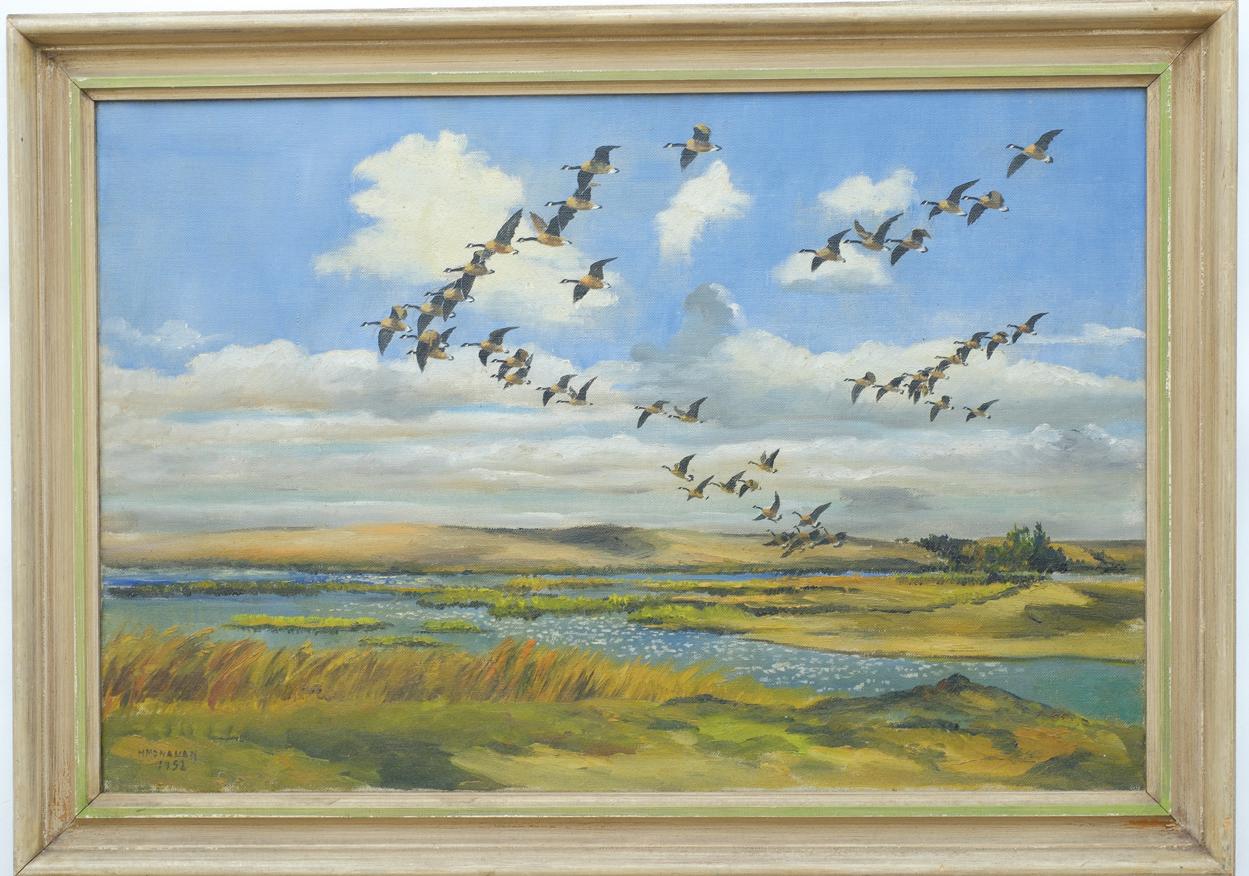
Provenance: David Fannon collection. (1,000 - 1,500)

219
329
330
331
332 Roy Martell Mason (1886-1972), oil on canvas. Titled “Coming to the Decoys.” Depicts a duck hunter in a brush blind with five ducks landing into decoys. Signed lower left. Image measures 19.5” x 24.25”. Fine craquelure scattered throughout.
(3,000 - 5,000)
333 Dr. Edgar Burke (1889-1950), oil on canvas board. Four canvasbacks in flight. Signed lower right. Image measures 9.5” x 13.5”. A small amount of flaking at both lower left and right corners; tiny chip, about 1/16” missing center left canvas; otherwise very good.
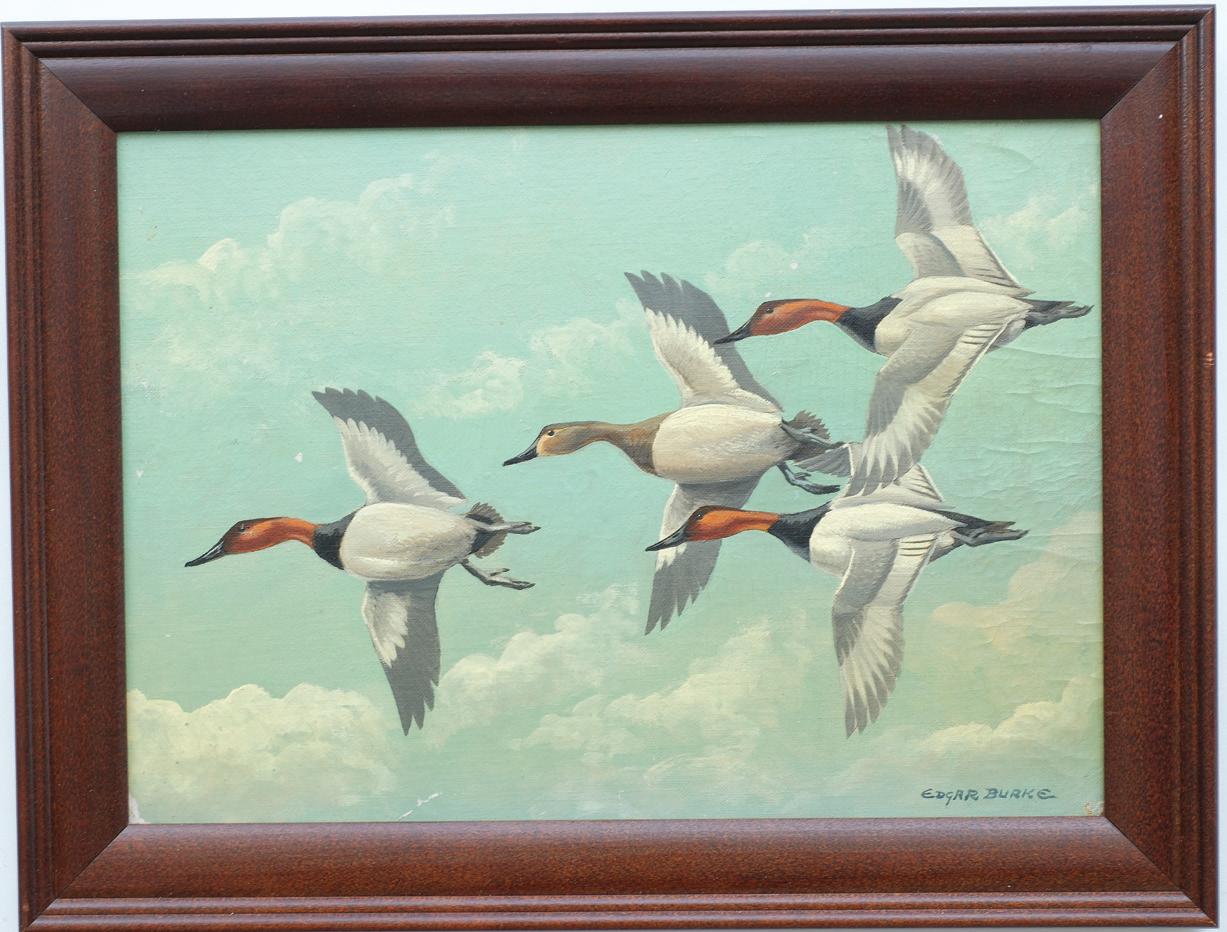

Provenance: David Fannon collection. (1,500 - 2,500)
334 Louis Frisino (1934-2020), oil on canvas board. Canada geese setting in to decoys. Signed lower left. Image size 17.5” x 23.5”. Frame measures 24” x 30”. Varnish has darkened slightly, but painting is in excellent condition.
Provenance: David Fannon collection. (500 - 800)
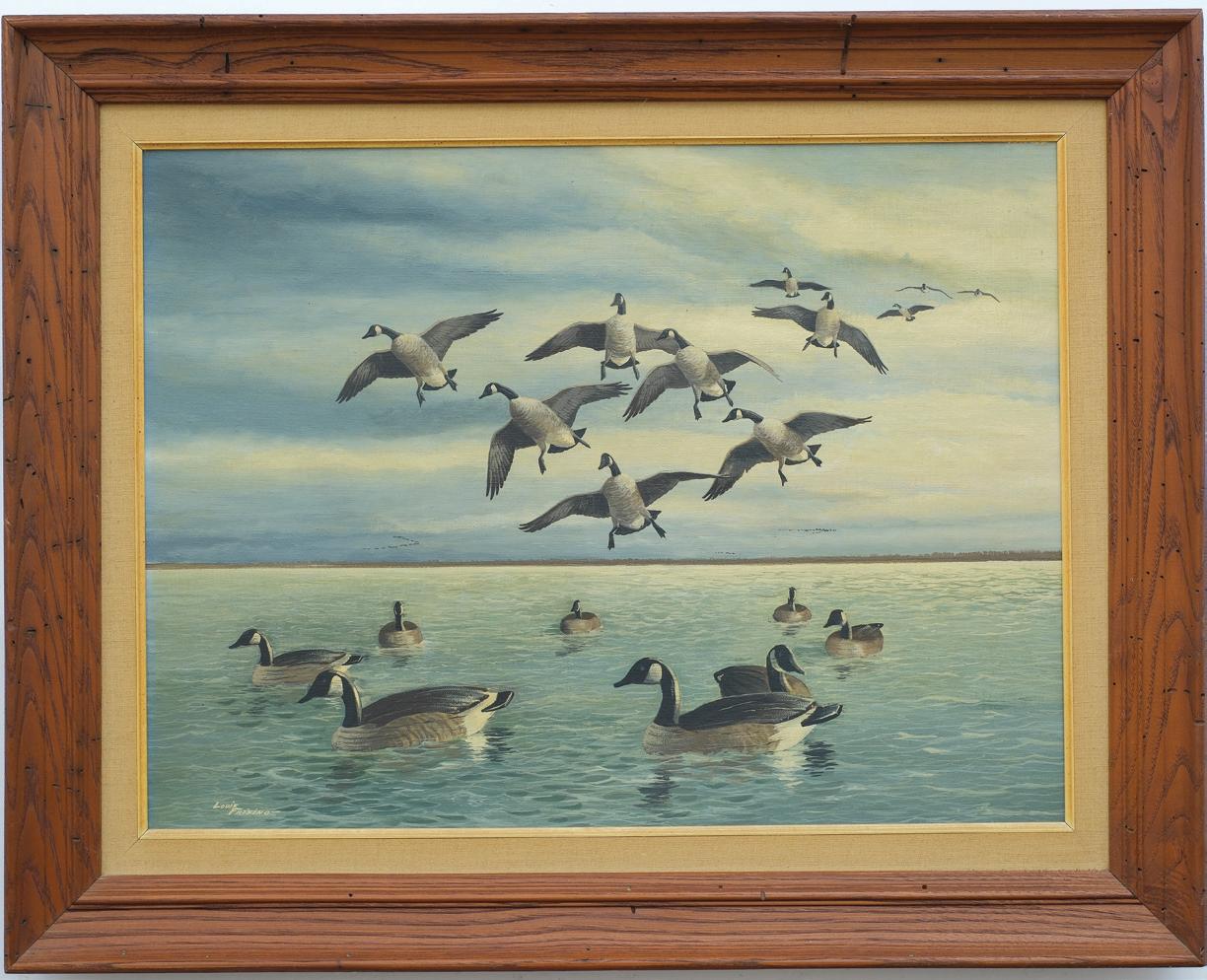
220 332 333 334
335 William M. Hollywood (1923-2007, UK) oil on canvas. Of two shelducks at water’s edge. Image measures 19.5” x 29.5”. Signed lower right. Professionally matted and framed. Excellent.

(2,000 - 3,000)
336 Arnoud Wydevelt (1823-1888), oil on panel. Berry-Hill Galleries label on backside of painting. Signed lower right. Image measures 13.5” x 20”. Frame measures 21” x 27”. Restoration to a 7” tear upper right hand side along frame; puncture to right hand side approx 2” from side of frame.

Provenance: David Fannon collection. (1,500 - 2,000)
337 Lynn Bogue Hunt (1878-1960), pen and ink. Image measures 18” x 14”. Signed lower center. Titled “Mississippi Mallards” with a type written poem affixed to lower margin of matting. Artwork is very good and original. Frame size 28” x 23”.

Provenance: David Fannon collection.
(800 - 1,200)
221 335 336
337
Lloyd Cargile b. 1938
Lloyd Cargile has been a long time resident of Essex, Maryland. He was born in Atlanta, Georgia in 1938 and came to Baltimore in 1943 where his father worked in the Ship Yard repairing damaged War Ships. His family moved to the Essex area to be near the Chesapeake Bay, as close as his Mother would allow. She had a fear of water that kept his parents from buying waterfront property. This did not deter Lloyd and his two brothers from spending every moment they could on the water. His father owned what waterman called a Hoopers Island Duck Ass work boat with a Model T Ford engine. Lloyd learned what a watermans work was all about, he and his brothers with their father would pull the boat into Drydock, scrape the bottom, replace bad boards, caulk and paint it. This was important, during the 40s and 50s there were times when work was tight and his father was laid off. He would have to hire out the boat for fishing parties with Lloyd and his brothers as “crew”.
Lloyd always had a love for sketching and drawing and subject matter was everywhere. After graduating from High School in 1956 he applied to the Maryland Institute College of Art [MICA]. He was accepted and majored in Fine Arts with Portrait and sculpture. In Fine Arts he studied with Leonard Bahr, R. Mcgill Mackall, Jacque Maroger, Joseph Shephard, Howard Frech, and Anne Schuler. Painting styles ranged from Post American Impressionism, the study of light and brush work to Jacque Marogers old masters discipline using drawing, anatomy and transparent glazes. He studied Photography with Grace Cooper, Associate Editor for Camera Magazine. Using this experience he began
to use photography as a means of referencing sites for landscapes and controling light on artifacts and subject matter for future paintings. While at MICA he won the Henry Walters Scholarship and graduated second in his class of 1960.
Over a period of time in the late 1950s he and close friend Mark Stewart, a fellow student, would travel by canoe through the marshes and Islands from southern Dorchester County to the Mouth of the Choptank River. For generations Mark and his family owned a large farm in the area and knew Dorchester County well. Our goal was to photograph and paint some of the disappearing portions of the Eastern Shore. Occasionally in the marsh they would find an old derelict decoy and incorporate it into a Still Life painting and sell it with the finished work. Along the way Mark introduced him to Duck Hunting on his family marsh, which meant helping to build and maintain Duck Blinds. This experience added to his ability to use Duck Hunting themes with confidence. During this time he bought his first decoy a Joe Dye Redhead [.50 cents], the start of his collecting. He still has it.
Five years ago he turned 80 and had open heart surgery. While recuperating he began to think about what he and his friend did, why they did it and the need to pick it up again and continue. This began a series of paintings of Maryland, the landscape, the bounty of the Bay and especially the early decoy carvers.

222 340
340 Lloyd Cargile (b.1938), oil on board. Image measures 10.5” x 13.5”. An oyster basket with shucked oysters and knife. Signed lower right. Titled “Chesapeake Bay Oysters”. Back of painting is signed and dated 2020. Excellent and original. (600 - 800)
341
An Ira Hudson bluebill with an oyster basket and handful of oyster shells. Signed lower right and dated 2014.

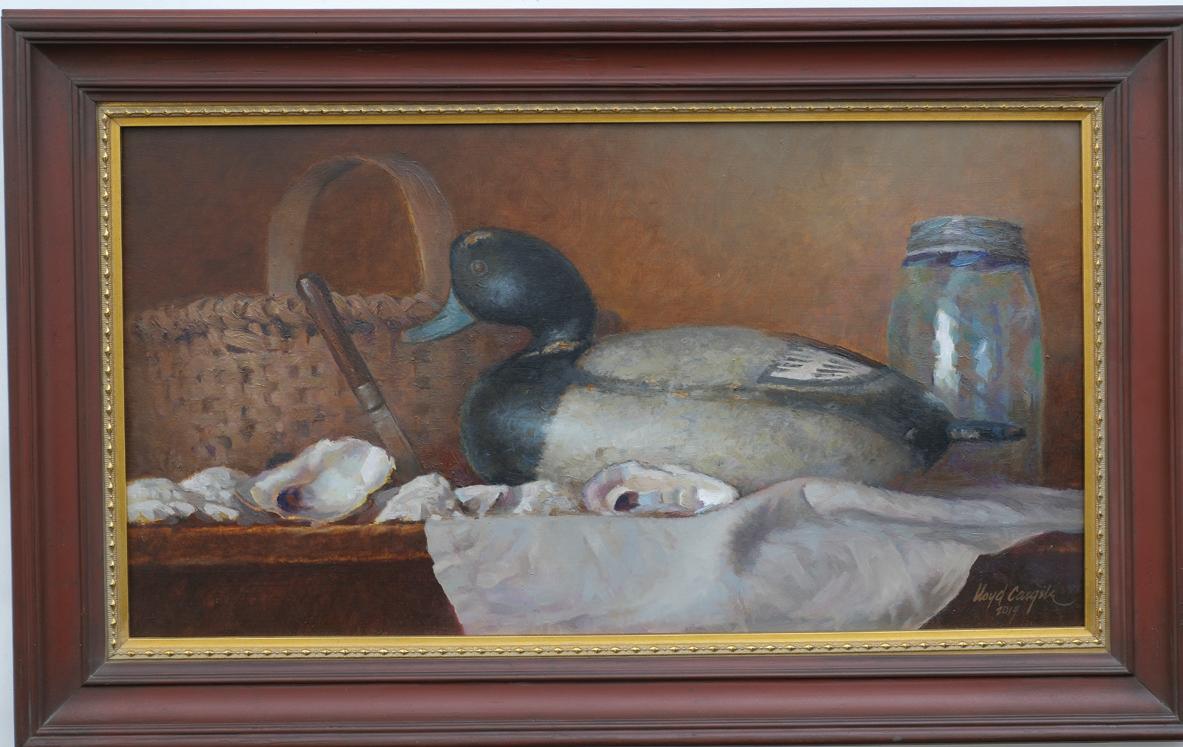
Image measures 12.5” x 23.5”. Frame measures 18” x 29”. Excellent and original.
(2,000 - 2,500)
Image
(2,000 - 2,500)
a Bob McGaw theme with a greenwing teal, oyster shells, and 1940 hunting license. Signed lower left, and dated 2020. Image measures 16” x 19.5”. Frame measures 20.5” x 24.5”. Excellent and original.
Skipjack at sail. A thick impasto brush technique has created a wonderful texture. Signed lower left and dated 2014. Image measures 23.5” x 17.5”. Frame measures 29” x 23”. Excellent.
(2,000 - 3,000)

223 341
342 343
Lloyd Cargile (b.1938), oil on board.
342 Lloyd Cargile (b.1938), oil on board.
of
343 Lloyd Cargile (b.1938), oil on board.
Provenance:

224
344 Charles John Waldron (1836-1891), oil on canvas. Image measures 23.5” x 35.5”. Three mast schooner with American flag. As viewed under black light several small areas of restorations ranging in size from dime to half dollar; a few other small areas of inpainting.
David Fannon collection. (2,500 - 3,500)


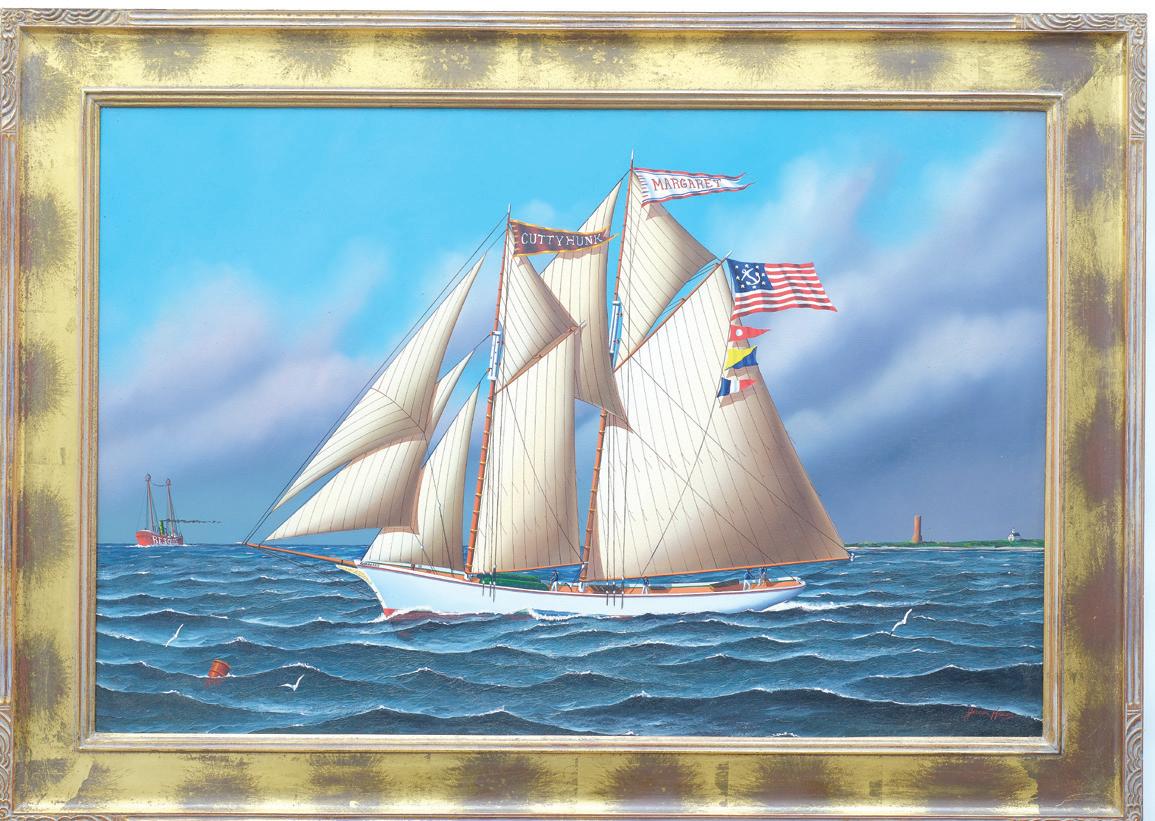
225 345 346 347
345 Jerome Howes (b.1955), oil on board. 23.5” x 35.5”. Signed lower right. Sailing schooner with Cuttyhunk and Margaret flags. Professionally framed. Frame size 30.5” x 42.5”. Excellent and original. (1,250 - 1,750)
346 Jerome Howes (b.1955), oil on board. Image measures 18” x 24”. Signed lower right. Two sail boats with American flag and lighthouse in background. Excellent and original. (600 - 800)
347 Jerome Howes (b.1955), oil on board. Image measures 48” x 24”. Still life image of musical instruments against a green door. Board is unframed. Remains in very good condition. (1,000 - 1,500)
348 Arthur Burdett Frost (18511928), watercolor. Titled “A Common Cause”. Professionally matted and framed. Image size approximately 13” x 15”. Very good and original.
Provenance: Ex Paul Tudor Jones II collection. Sold in a January 29, 1964 Parke-Bernet auction as being from a Philadelphia private collector. Literature: “Colliers Magazine,” August 1919, illustrated. (9,000 - 10,000)
349 Arthur Burdett Frost (18511928), watercolor. Titled “The Argument”. Signed. Professionally matted and framed image size approximately 14” x 19”. Excellent and original.
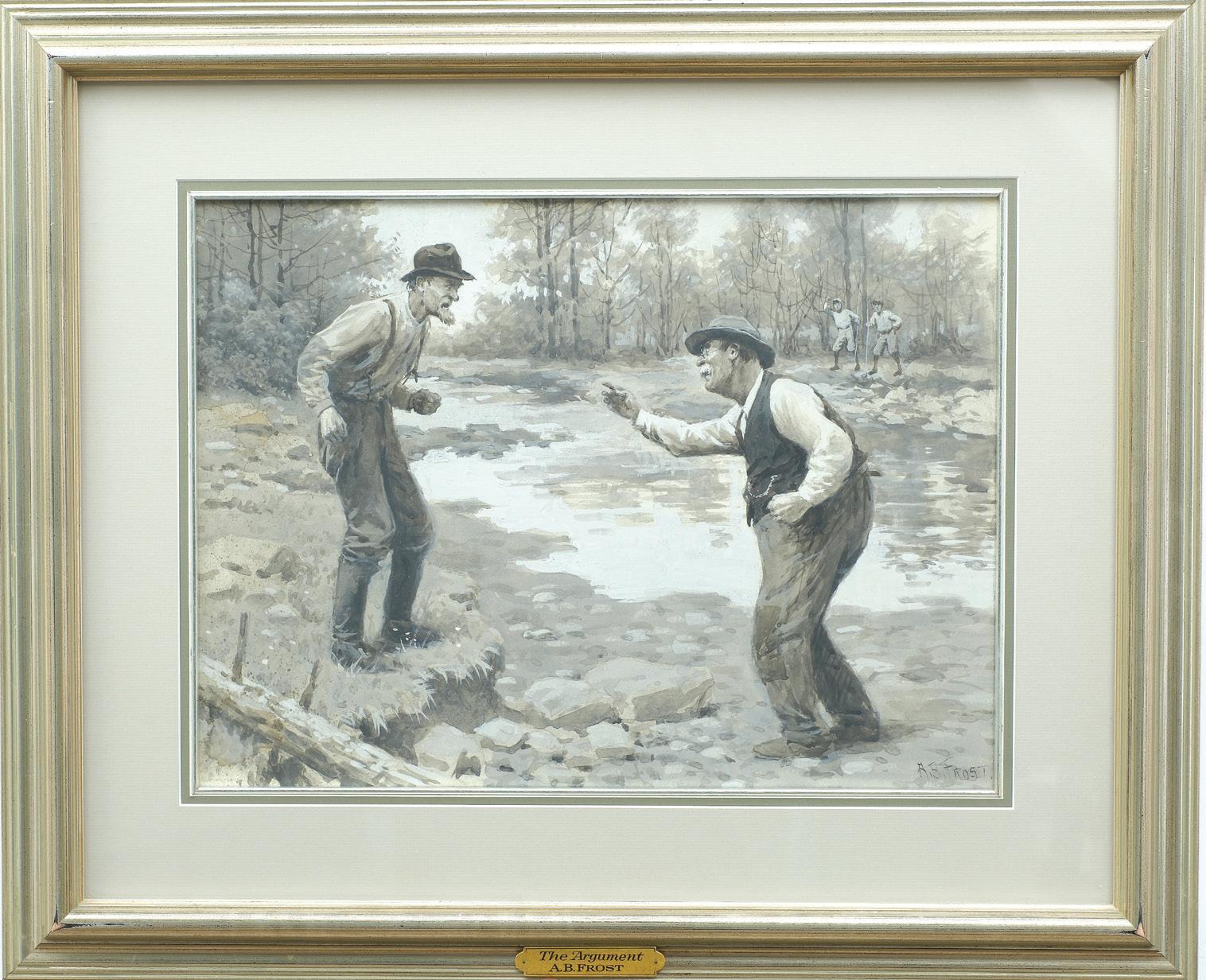
Provenance: Ex Paul Tudor Jones II collection. Literature: “Colliers Magazine,” August 1919, illustrated. (9,000 - 10,000)
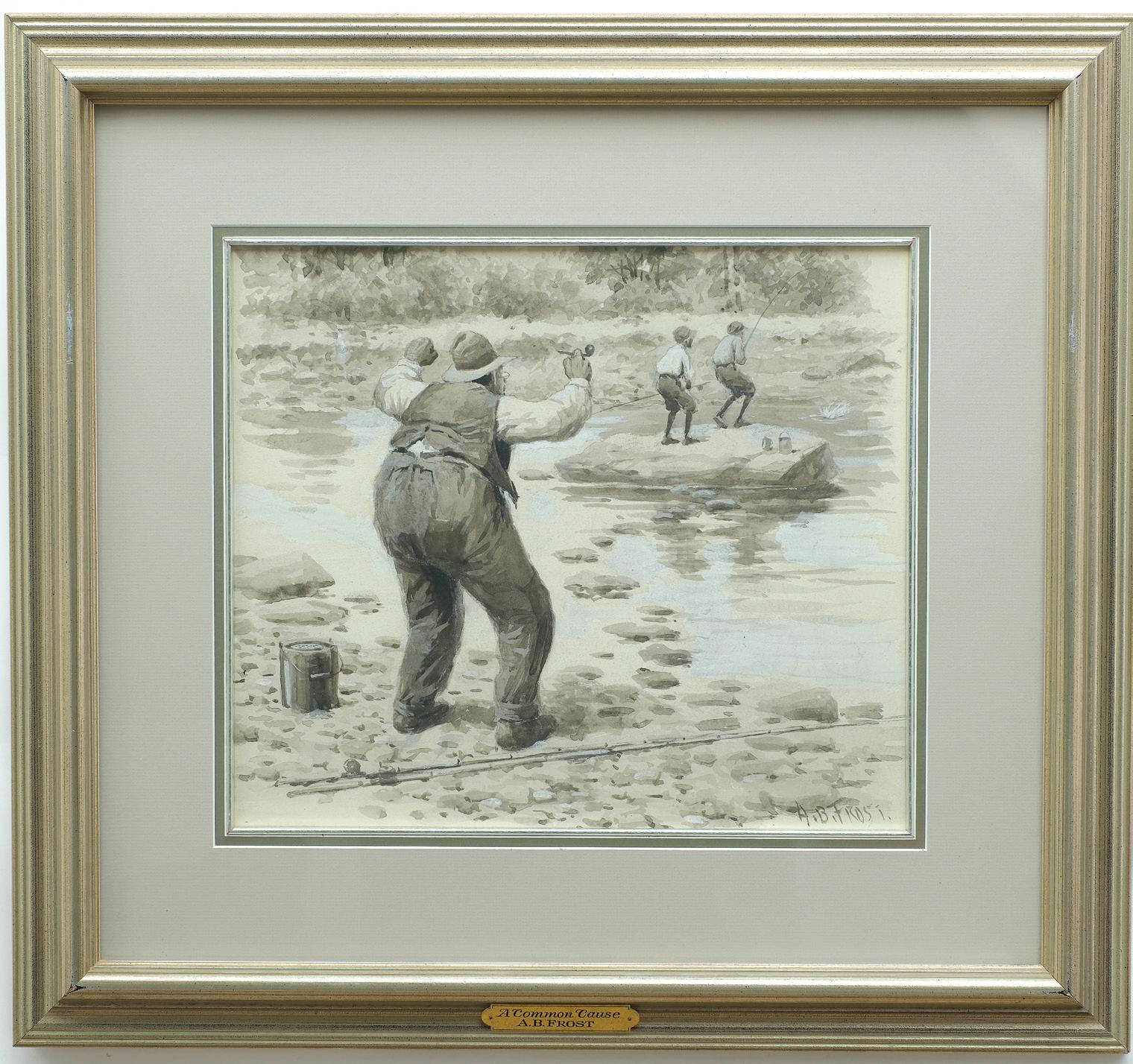
226
348 349
350 Two sets of framed federal duck stamps. One includes uncanceled stamps dating from 1935-1983, with the addition of the dry point etching by Richard Bishop used for the 1937 federal duck stamp. Second 1936 - 1983. Stamps are uncanceled and unsigned. (1,500 - 2,500)


351 Arthur Fuller, charcoal on paper. Image measures 11.75” x 21”. Signed lower center. Professionally framed.
Provenance: David Fannon collection. (800 - 1,000)
352 Milt Weiler (1910-1974), watercolor. Measures 10” x 15.5”. Mallards landing in marsh. Signed lower right. Personalized on back “To Bill Joeckle. From Mr. Weiler”. Professionally framed and matted.

Excellent. (1,000 - 2,000)

227 350 351 352
353 Frank Benson (1862-1951), drypoint etching. “Old Tom”. Signed lower left. Professionally framed and matted with acid free material. Etching measures 14.75” x 9.5”. Frame measures 23” x 17.5”. Very small amount of discoloration where it was previously framed.

Provenance: David Fannon collection.

(1,500 - 2,500)
354 A must see collection of Delaware resident hunting licenses. Starting in year 1913 through 1993. Also included are many duck stamps including 1935 Ding Darling. Appears as if a nearly complete mint set of federal duck stamps 19341993. In a two separate volume book published by Russell Fink. Many detailed items collected and inventoried.
(4,000 - 5,000)

353 354
356 Nathaniel Currier (1813-1888) & James Ives (1824-1895), lithograph with hand coloring, 1863. Titled ‘Camping in the Woods, Laying Off’, after the original by Aurthor Fitzwilliam Tait (1819-1905). 18.5” x 27.5”. Remains in very good condition. Gallery stickers on the verso for Hirschel & Adler and the Albany Gallery. Frame measures 28” x 36”. Rough area to two corners of frame.

Provenance: David Fannon collection. (2,000 - 2,500)
357 Charles Whymper (1853-1941), chromolithograph. Titled “Snipe Shooting”. Published December 1893 by I.P. Mendoza. Seller and publisher to the Queen. Image measures 17.5” x 25”. Professionally framed in acid free matting.


Provenance: David Fannon collection. (500 - 800)
358 Percival Rosseau (1859-1937), chromolithograph. Image measures 16” x 23”. Signed lower right, with remark lower left. Published Feb 25, Arthur Ackerman. East 57th St New York. Professionally framed and matted.
Provenance: David Fannon collection. (300 - 500)
229 356 357 358
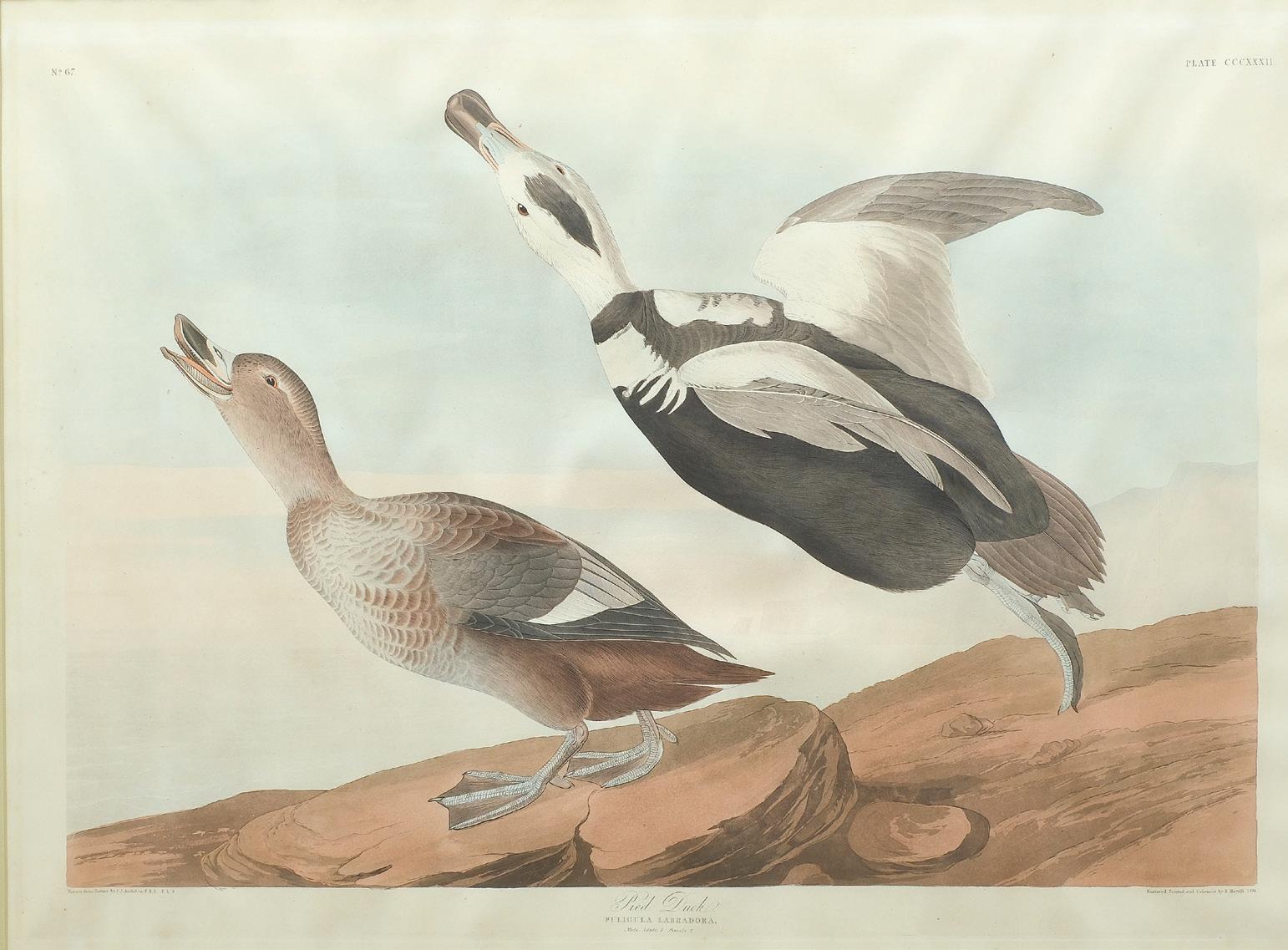

230 359 360
359 John James Audubon (1785-1851), Pied Duck. Engraving and color by R. Havel 1836. Drawn from nature by John James Audubon. Professionally framed with conservation glass and matting. Sheet measures 24.75” x 37.25”. “J Whatman 1838” watermark. Slightly darkened; and two very small spots of discoloration areas. (4,000 - 6,000)
360 John James Audubon (1785-1851), Great red breasted rail. Engraving and color by R. Havel 1834. Drawn from nature by John James Audubon. Great grey breasted rail or marsh hen. Male spring plumage, young autumnal plumage. Number 41 Plate CC111 Professionally framed with conservation glass and matting. Image size 12” x 18.75”, full print 25.25” x 38”. J Whatman 1858 watermark. Retains bold colors, a few small foxing spots in the exposed area. (2,000 - 3,000)
b. 1938 | Crisfield, Maryland
361 Rare mute swan, Oliver Lawson, Crisfield, Maryland, dated 2014. Head is cocked back and to the side slightly. Carved wingtips and tail feathers, with a deep groove carved along the back. Approximately 31” long. Excellent original paint with a few small rubs; tight crack in between wings at top of back; slight separation on one side of neck seam.

 (8,000 - 12,000)
Oliver Lawson
(8,000 - 12,000)
Oliver Lawson
361A Highly decorative and exceptional pair of black ducks, Oliver Lawson, Crisfield, Maryland. Signed and dated 1978 on underside, and personalized to Dr. Herrington. Each has the head turned back and resting. Female’s bill is carved open. Both wings are outstretched, with each feather individually carved and textured. Both appear to be made from a single piece of wood. This is the finest level of work made by Oliver Lawson. Longest measures 16”. Both are excellent and original.
Provenance: Lynwood Herrington collection. (10,000 - 15,000)
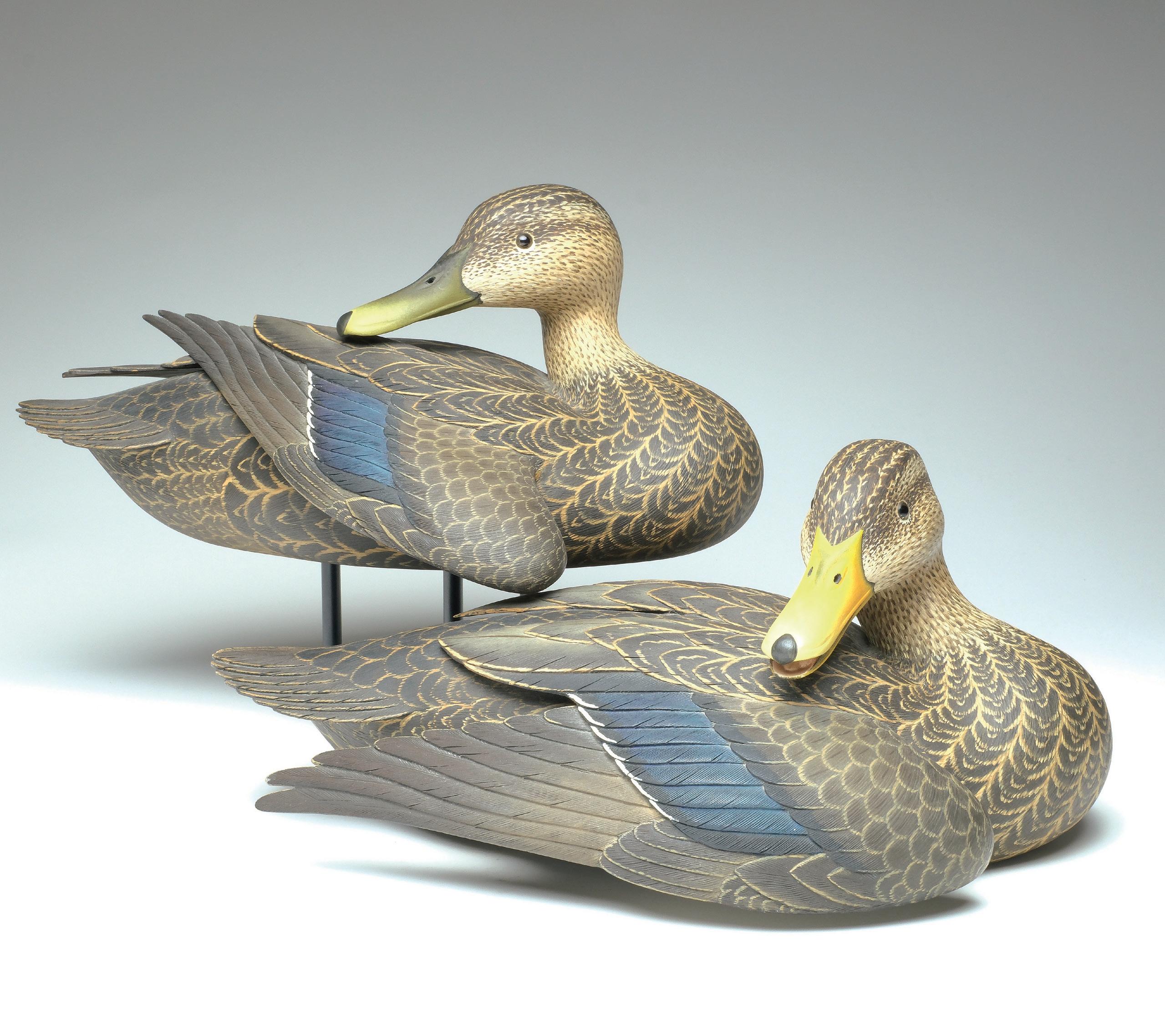
232
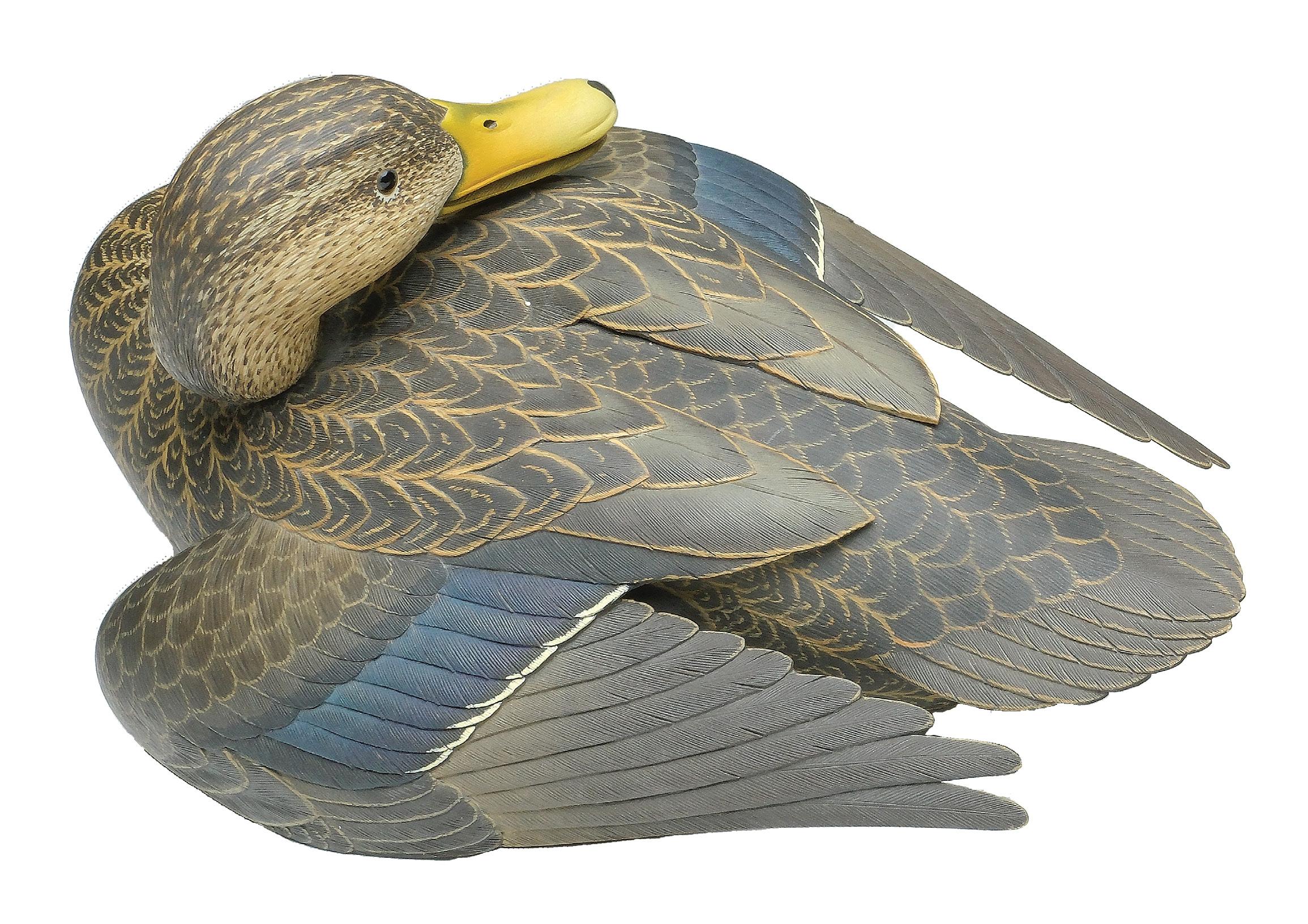

233
361B Decorative gadwall, Pat Godin, Ontario. Hollow carved with round inlayed bottom board. Slightly turned head with raised, crossed wingtips and detailed feather carving throughout. Identified and signed on the underside. Also “Best of Show Canadian National Decoy Contest 1976” on underside. Measures 15” long. Minor paint rubs at tip of tail feathers, otherwise excellent and original.


Provenance: Lynwood Herrington collection.
(4,000 - 6,000)
362 Pair of goldeneye, Jim Foote, Gibraltar, Michigan. Hollow carved with inlayed bottom boards. Slightly turned and tucked heads with relief wing carving and raised, crossed wingtips. Detailed feather carving throughout. Identified, signed, and dated 1976 on undersides. Measure 14” and 14.5” long. Minor paint rubs on edges of tail and at the tips of the bills, otherwise very good and original.
Provenance: Lynwood Herrington collection.
(5,000 - 8,000)
234
361B
362
363 Canvasback drake, Dennis Schroeder, Trinity Alps, California. Signed and dated on underside Oct 2002, #182. Turned head . Fine feather painting and carved muscle sculpture. Raised, crossed wingtips and extended tail. Measures 13.5” long Excellent and original.



Provenance: Gordon Mulava collection. (800 - 1,200)
364 Barrow’s Goldeneye, Dennis Schroeder, Trinity Alps, California. Slightly turned, reared back head. Relief wing carving with raised, crossed wingtips. The underside of tail with relief carved feathers. Maker’s brand on the underside. Also identified and dated 2010. Measures 13.75” long. A few very minor paint rubs, otherwise excellent and original.
Provenance: Gordon Mulava collection. (1,000 - 1,500)
365 Spectacled eider, Dennis Schroeder, Trintiy Alps, California. Head is tucked and turned 45 degrees. Relief wing carving with raised, crossed wingtips. Maker’s brand on the underside. Also dated 2008. Measures 15.5” long. A few very minor paint rubs, otherwise excellent and original.
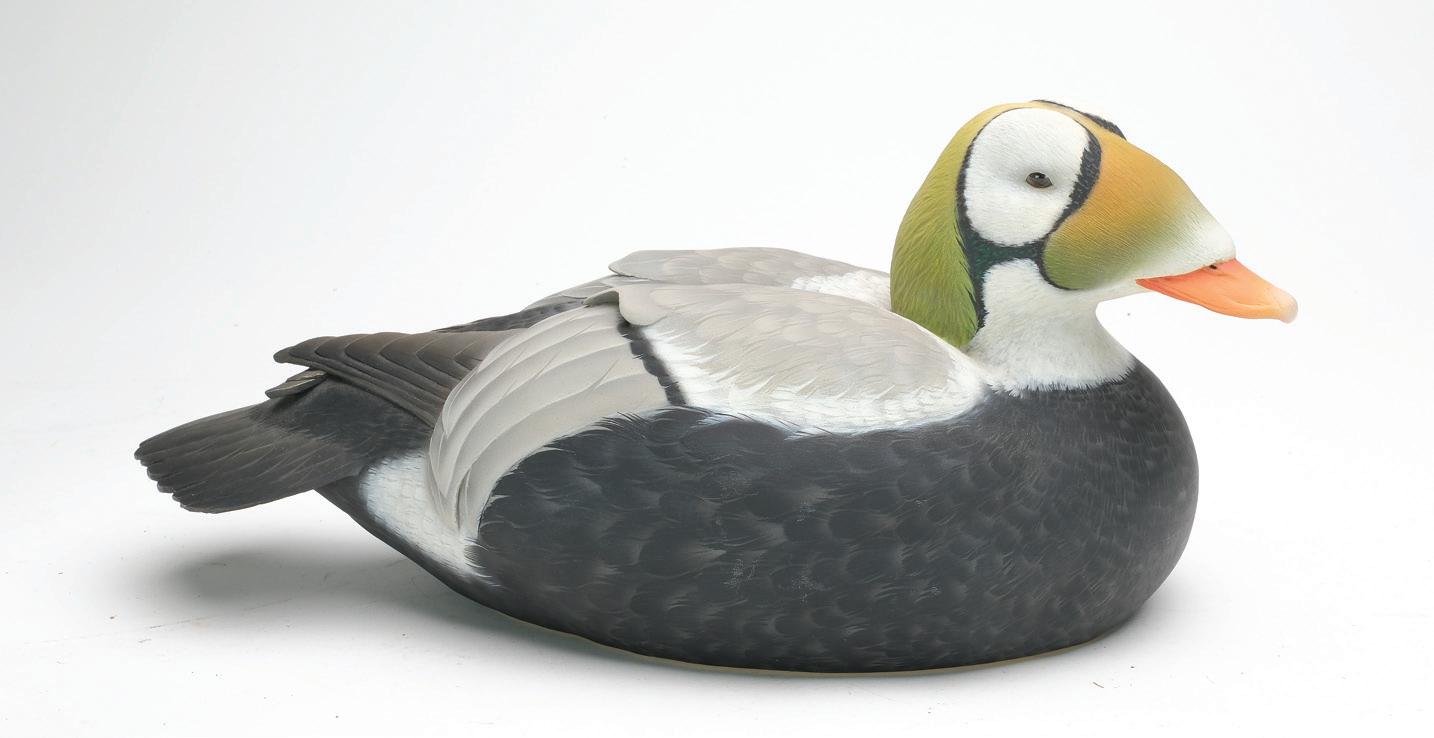
Provenance: Gordon Mulava collection. (1,000 - 1,500)
366 Bluebill, Dennis Schroeder, Trinity Alps, California. Head is tucked and turned 45 degrees. Relief wing carving with raised, crossed wingtips. Maker’s brand on the underside, also dated 2009. Measures 13” long. Excellent and original.
Provenance: Gordon Mulava collection. (1,000 - 1,500)
235
363
365
364
366
Underside reads “Chesapeake
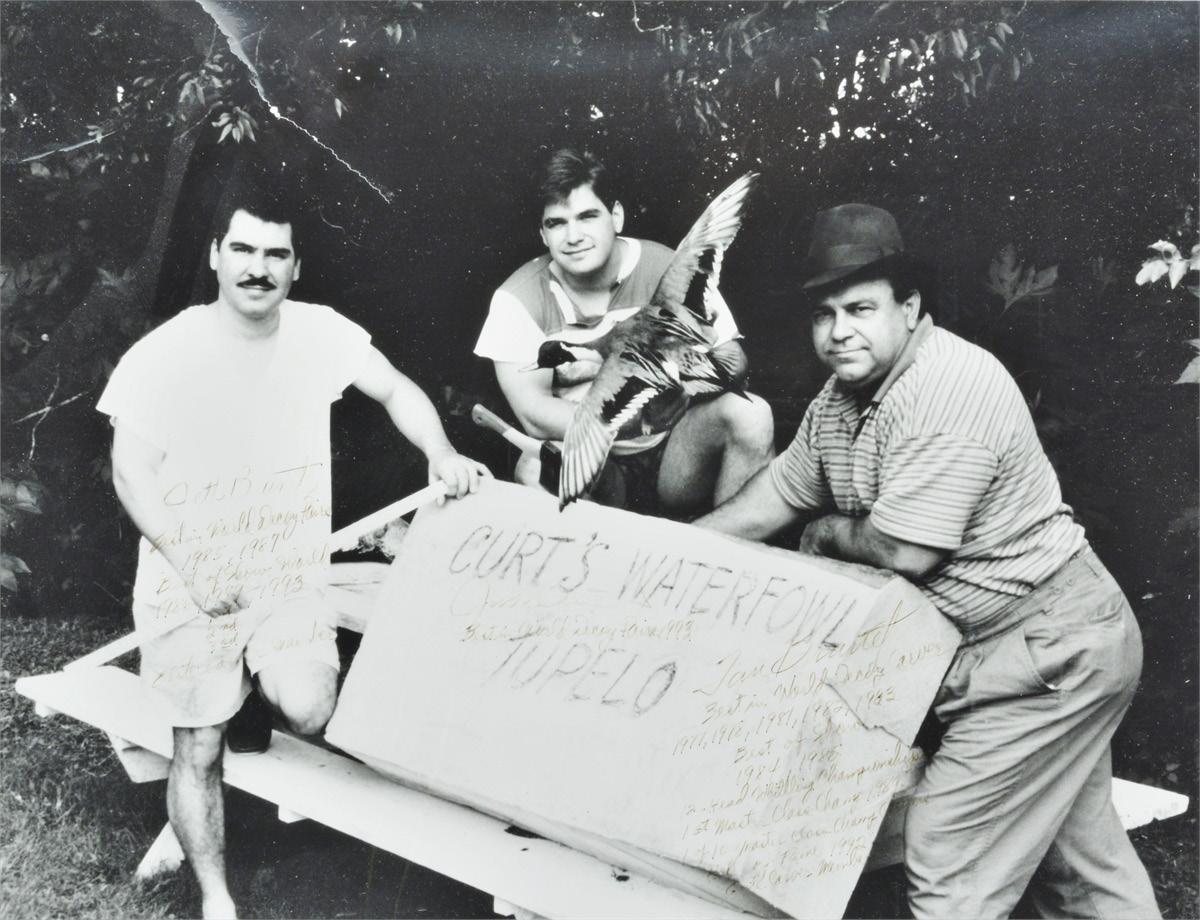
Bull Neck Can by Tan”. With a remarque style carving of a canvasback in flight on underside. Dated 10/95. Individual feather carving with raised crossed wingtips and extended tail. Slightly turned head. Measures 14” long. (4,000 - 6,000)


236
366A Canvasback drake, Tan Brunet, Galiano, Louisiana.
The Brunet family; Tan, Jett and Jude.
366B Excellent goldeneye drake, Jett Brunet, Galiano, Louisiana. Signed and dated 11/96. Individual feather carving with extended raised wingtips and fanned tail. Head is turned. Measures 13” long. Excellent and original. (3,000 - 4,000)

366C Hutchins Canada goose, Jude Brunet, Galliano, Louisiana. Signed and dated 1997 on underside. Excellent detailed individual feather carving with extended tail and wingitps. Turned head. 18” long. A very small amount of wingtip damage to approximately 1/32” of an inch at both tips, otherwise excellent. (3,000 - 5,000)

237
366B
366C
366D Red breasted Merganser drake, Pat Godin, Paris, Ontario. Signed on the underside. Dated 1992 with inscription that reads “An original creation by Pat Godin Paris Ontario”. Raised and turned head with extended crest and raised wingtips. Measures 18” long. Original paint; one feather is broken at tip of crest; otherwise excellent.
(3,000 - 5,000)
366E Excellent preening black duck, George Kruth, Pittsburgh, Pennsylvania. Signed and dated 93. In preening pose with raised, extended wingtips and fanned tail. Measures 15” long. Excellent and original.
(2,000 - 3,000)
366F Highly detailed woodduck drake, George Kruth. Pittsburgh, Pennsylvania. Signed and dated 95. Hyper decorative style with individual carved feathers and raised wingtips. Slightly turned head with extended crest. Measures 14” long. Excellent and original


(2,000 - 3,000)

366F
366D 366E
367 Full size flying ruffed grouse, Ben Heinemann, Rocky Mount, North Carolina. This well painted bird is mounted to a weathered post. Excellent detailed feather painting with fanned tail and open wings. Grouse measures 15.5” in length. Excellent and original. (1,500 - 2,000)
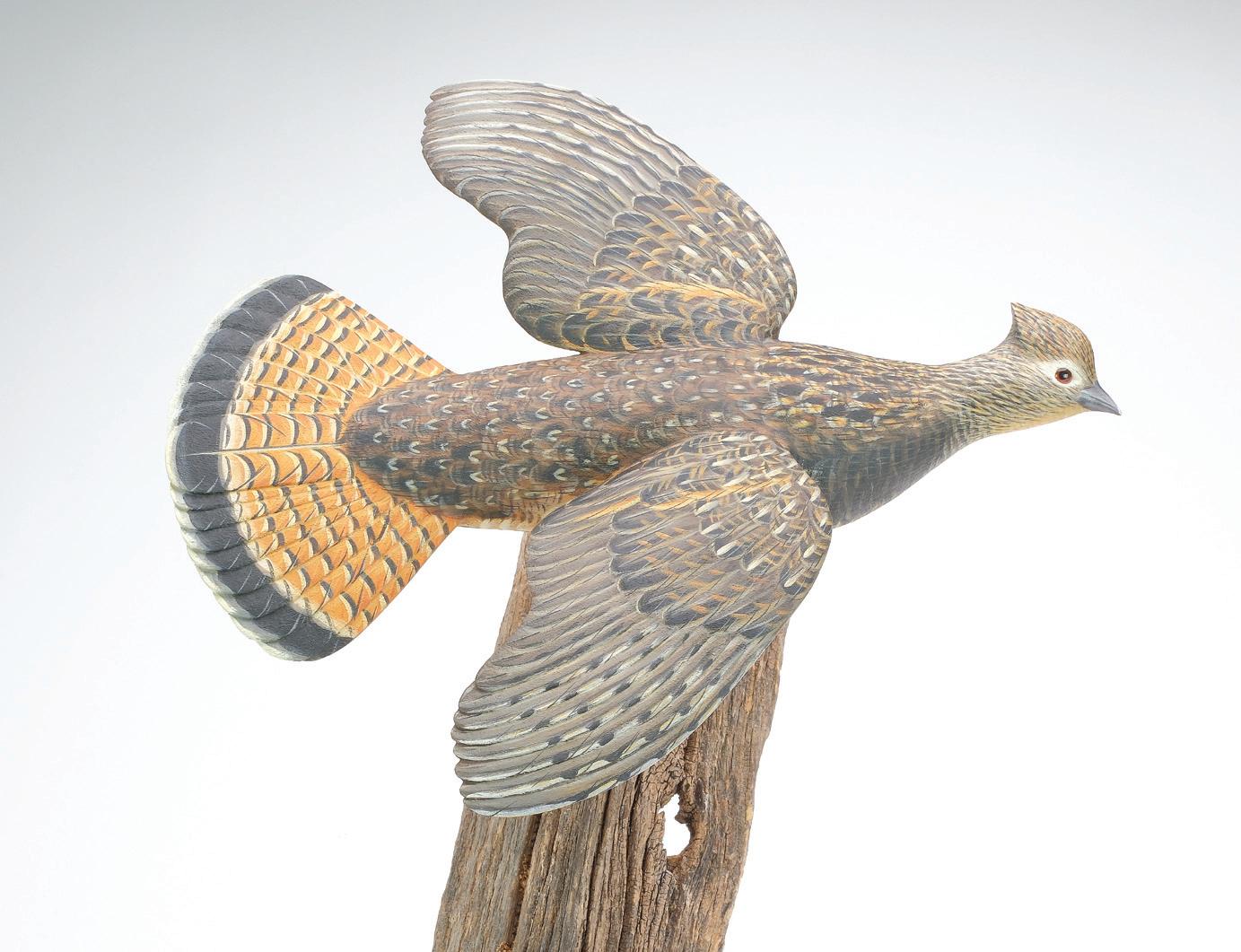
368 Pair of pintails, Ben Heinemann, Rocky Mount, North Carolina.
Hollow carved with tucked heads that are turned almost 90 degrees. Raised, crossed wingtips. Comb feather paint detail on drake. Maker’s brand on the underside of each. Measure 15.5” and 17.5” long. A few very minor paint rubs, otherwise excellent and original.
Provenance: Gordon Mulava collection. (800 - 1,200)
369 Rigmate pair of widgeon, Ben Heinemann, Rocky Mount, North Carolina. Branded and signed on underside. Both are hollow with turned heads, raised crossed wingtips and split tail. Drake measures 16”. Excellent and original. (800 - 1,200)


367 368 369
370 Pair of pintails, Leo McIntosh, Henderson, New York. Hollow carved with slightly turned heads. Hen with open bill carving. Drake with comb feather paint detail. Maker’s name carved in the underside of each. Measure 16.5” and 17.5” long. Tight crack on one lower edge of drake; otherwise excellent and original.

Provenance: Gordon Mulava collection. (1,200 - 1,800)
372 Pair of mallards, Leo McIntosh, Henderson, New York. Hollow carved with slightly turned heads. Comb feather paint detail on drake. Maker’s name carved in the underside. Measure 16.5” long. Excellent and original.

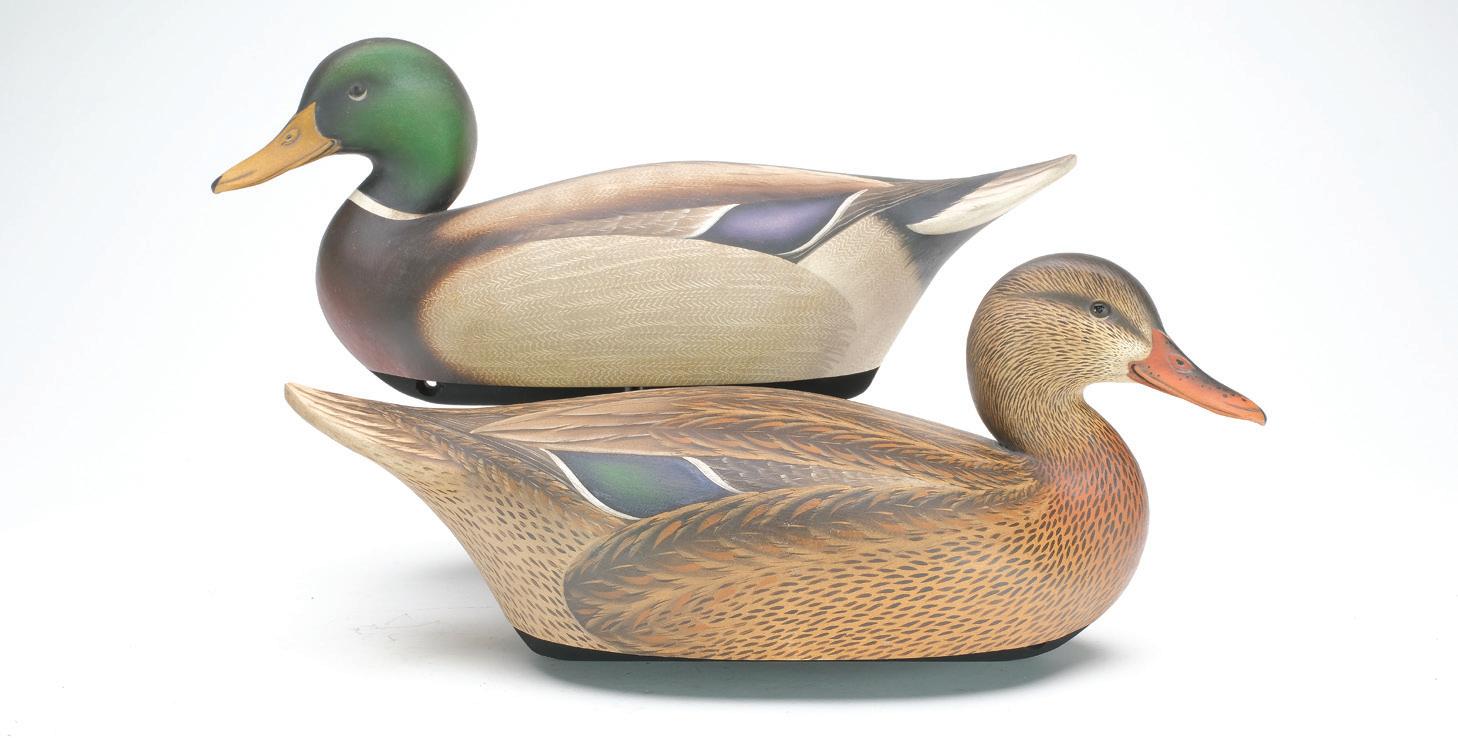
Provenance: Gordon Mulava collection. (1,200 - 1,800)
373 Pair of red breasted mergansers, Walter Gaskill, Harker’s Island, North Carolina. Hollow carved with slightly turned heads. Extended crests and detailed bill carving. Relief wing and tail feather carving. Comb feather paint detail on drake. Both are signed and dated 2005. A number of show ribbons included with pair. Measure 18.5” and 19.25” long. Excellent and original (1,500 - 2,500)
374 Preening whimbrel, Keith Mueller, Killingsworth, Connecticut. Carved and painted in the style of Elmer Crowell, with head turned over back and raised wingtips. Maker’s name carved around stick hole. Stand included. Measures 9.75” long, stands 11.75” tall including stand. Excellent and original. (1,000 - 1,500)

370 373 372 374 240
Ward World Championship
Since the inaugural World Championship Wildfowl Carving Competition in 1971, there has been no other singular event to advance the art form of decorative bird carving, anywhere else in the world. From beginners to ‘Master Class’ carvers the Ward World Championships, held annually at the end of April, is the Super Bowl for bird carvers.

Many of the greatest feats of decorative bird carving would not exist if not for this prestigious event. The most talented carvers in the world will spend many hundreds and sometimes thousands of hours on a single piece, for the chance at a blue ribbon win and the recognition as being among the best in the World. In fact, nowhere else in the world can you find decorative bird carvings of this level.

Many of the following carvings were created for the Ward World Carving Championships or commissioned directly from the artist. All are outstanding accomplishments for their makers and should be appreciated for the degree of skill and the patience and time involved in creating such a piece of art.
The next Ward World Championship will be held April 26 - 28 in Ocean City, Maryland.

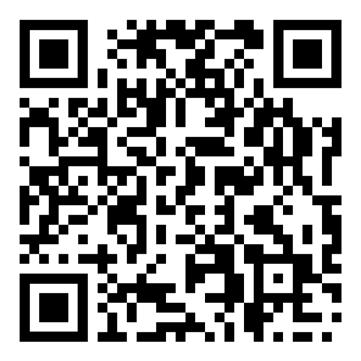

241
Videos from past Ward Championships
Pat Godin
Paris, Ontario
In the last five decades, Pat has achieved multiple World Championship titles in four out of five World Class categories. Most recently in 2015, Pat won his fourteenth World Champion Award in the World Championship Shootin’ Rig class named the Jimmie Vizier Memorial Award after his father-in-law.
Pat’s other accolades include:
• Two Best in World awards in the Shootin’ Rig class
• Two titles in the World Decorative Lifesize category
• Five titles in World Decorative Decoy Pairs category

• Five titles in the World Decorative Miniature category
• Best of Show awards in several competitions including: The Canadian National Decoy Contest in Toronto, the North American Wildfowl Carving Competition in Livonia, Michigan, the Midwest Decoy Contest in Pte. Mouillee, Michigan, the Gulf South Championship in New Orleans, Louisiana, the California Open Wildlife Art Festival in San Deigo, California, the Pacific Flyway Wildfowl Art Show in Sacramento, California, and the Northern Nationals
in Minneapolis, Minnesota. Pat is the proud recipient of numerous other honours including an invitation to represent North American carvers at the opening of the International Bird Carving Exhibition in Yokohama, Japan in 1993 as well as his induction into the Waterfowl Festival Hall of Fame in 1994 and Brantford’s Walk of Fame in 2001. Most recently, Pat was honoured at the 2015 Ward World Champion Wildfowl Carving Competition and Art Festival in Ocean City, Maryland and presented the title of Living Legend by the Ward Foundation.
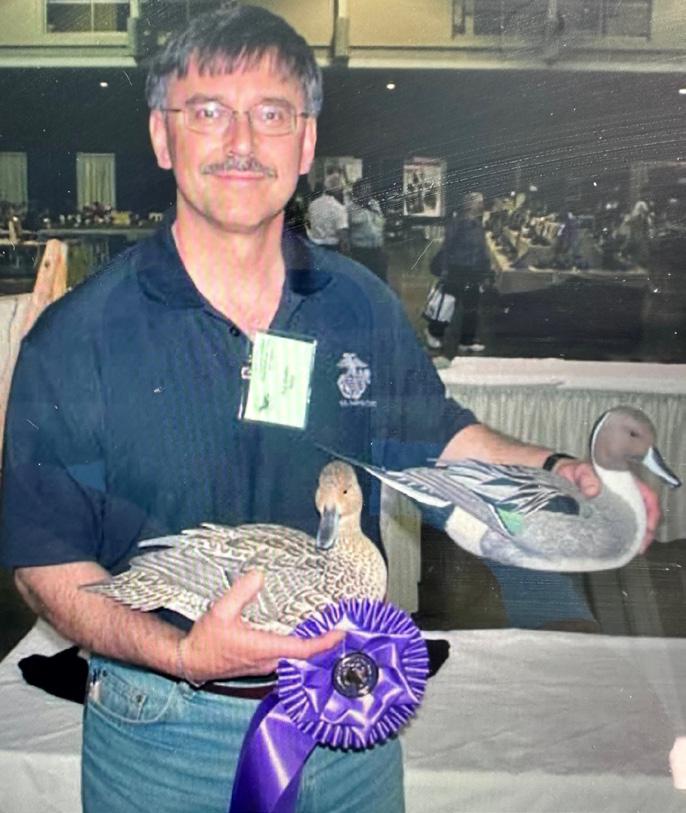
242
375
Standing preening bluewing teal drake, Pat Godin, 1991. Stone and brass base with a highly decorative bluewing teal grooming side feathers. Stands 13” tall. Excellent and original. (12,000 - 18,000)

243
Gilles Prud’homme
Sudbury, Ontario
Master Carver Gilles Prud’homme of Sudbury, Ontario, Canada, is one of the world’s elite in the art of wildfowl wood carving. His sculptures, renowned as being among the best in the world, capture moments in time and reflect the relationship between predator and prey, the thrill of the hunt, and the powerful beauty of nature.

An eye for fine detail, a love of wildlife, and the dedication required to spend hundreds, possibly thousands, of hours creating one carving are qualities possessed by the world’s elite carvers. Carving both lifesize and miniature birds for over 25 years, Gilles is a third generation carver following in the footsteps of both his father and grandfather.
A master at creating his subjects with precision and detail, Gilles has won numerous awards at the international level. With an extremely successful year at the 2006 Ward World Wildfowl Carving Championships, Gilles earned the title Master Carver. In 2007, Gilles not only entered the Masters Class with great success, but also for the first time competed in the prestigious World Class, where he earned the distinction of being named Third Best in World. Gilles repeated this amazing feat and once again placed Third Best in World in 2009, 2010 and 2011. He also has two, Canadian National, Best of Show titles to his credit.

376 Barn owl and chipmunk, Gilles Prud’homme, Sudbury, Ontario, 2010. Wings outstretched with highly detailed individual feather carving. All mounted to one long piece of driftwood. Chipmunk is sheltered by carved lily pads. Measures 23” tall, and nearly 44” in length. Excellent and original.
(7,000 - 10,000)
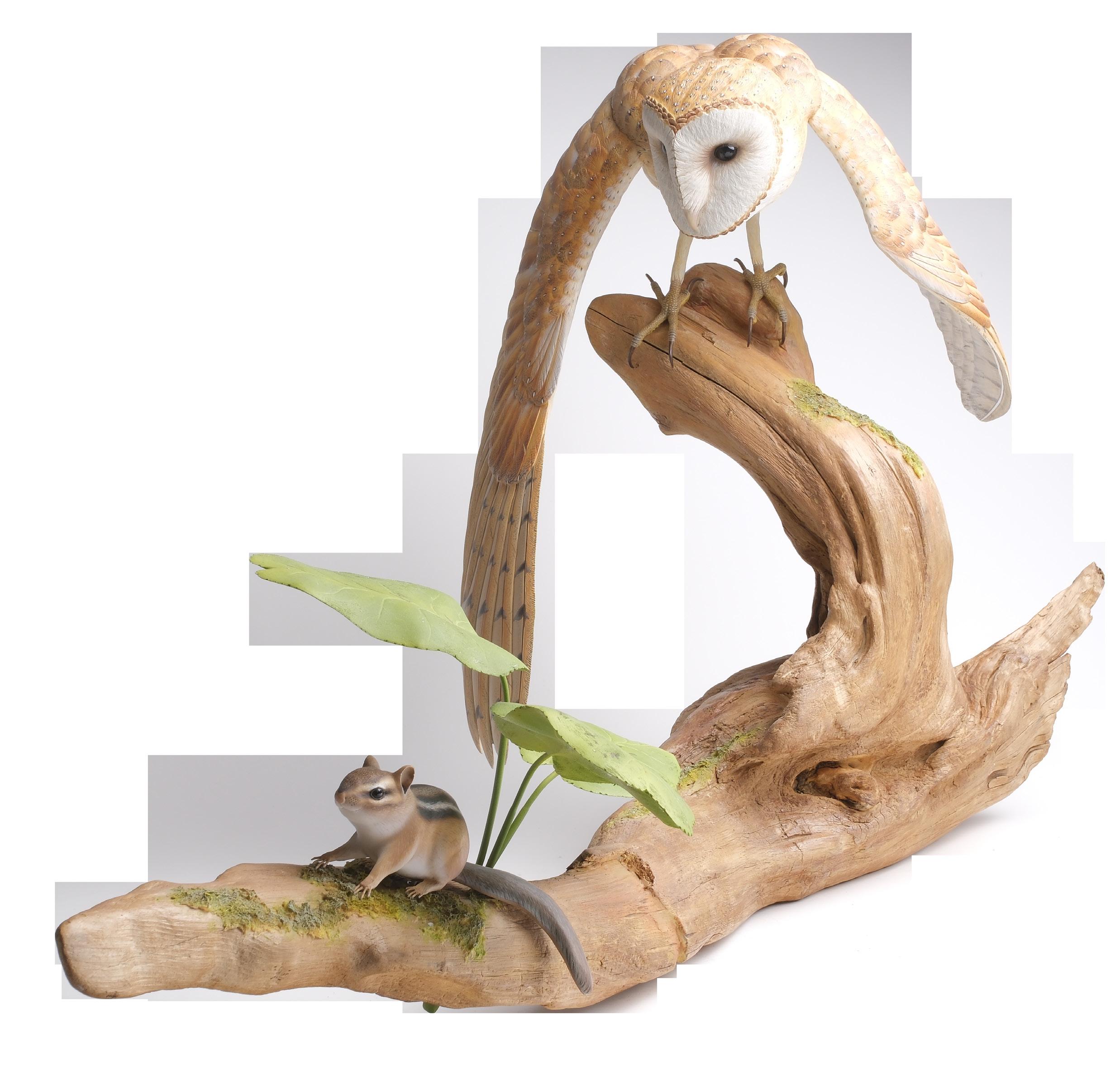
245
377
Exceptional pair of common kingfishers, Gilles Prud’homme, Sudbury, Ontario, 2010. One resting on a bloom of a lily pad and the other one a submerged branch. Both have wings spread and open beaks. Measures 17” tall. Excellent and original. (5,000 - 8,000)

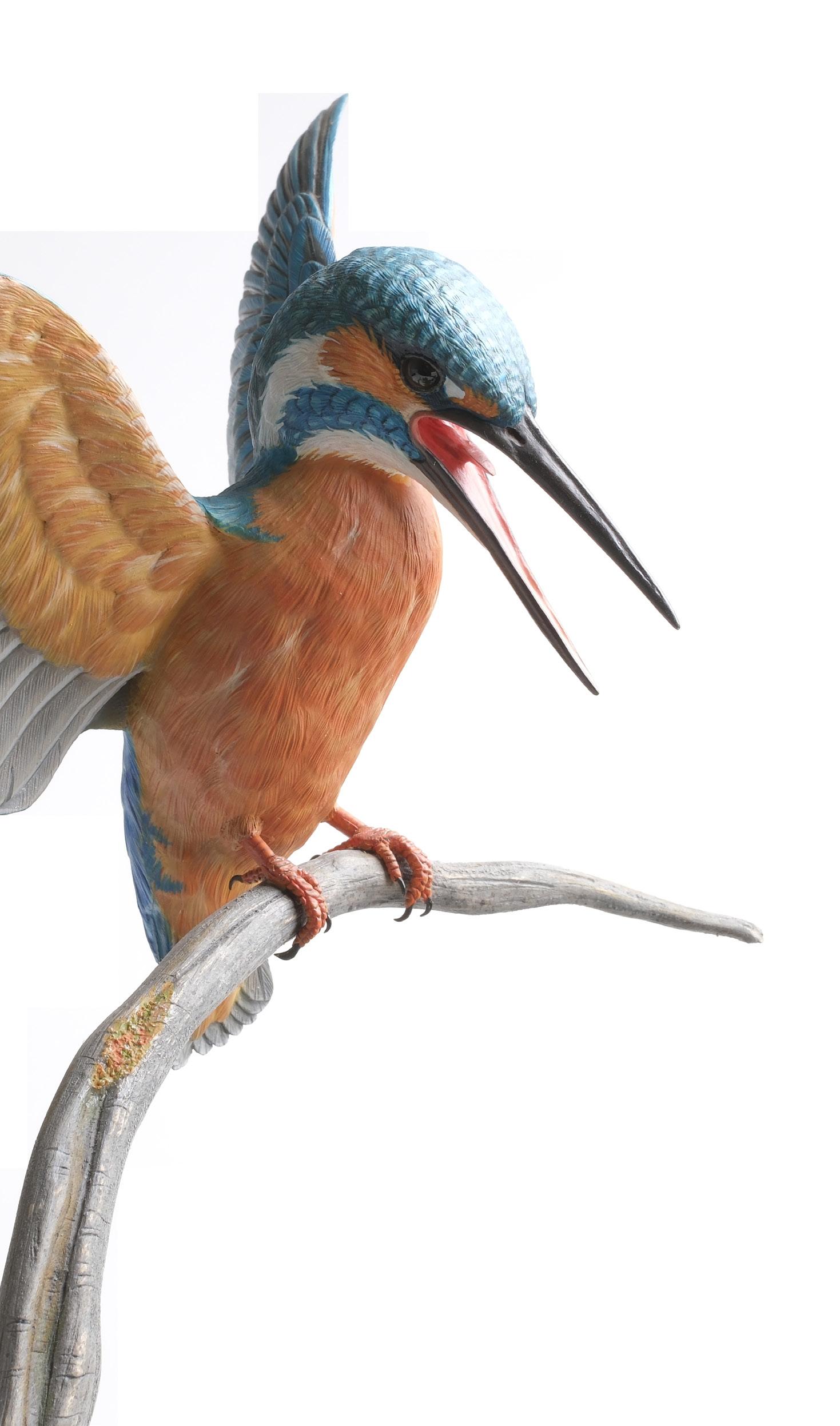
246
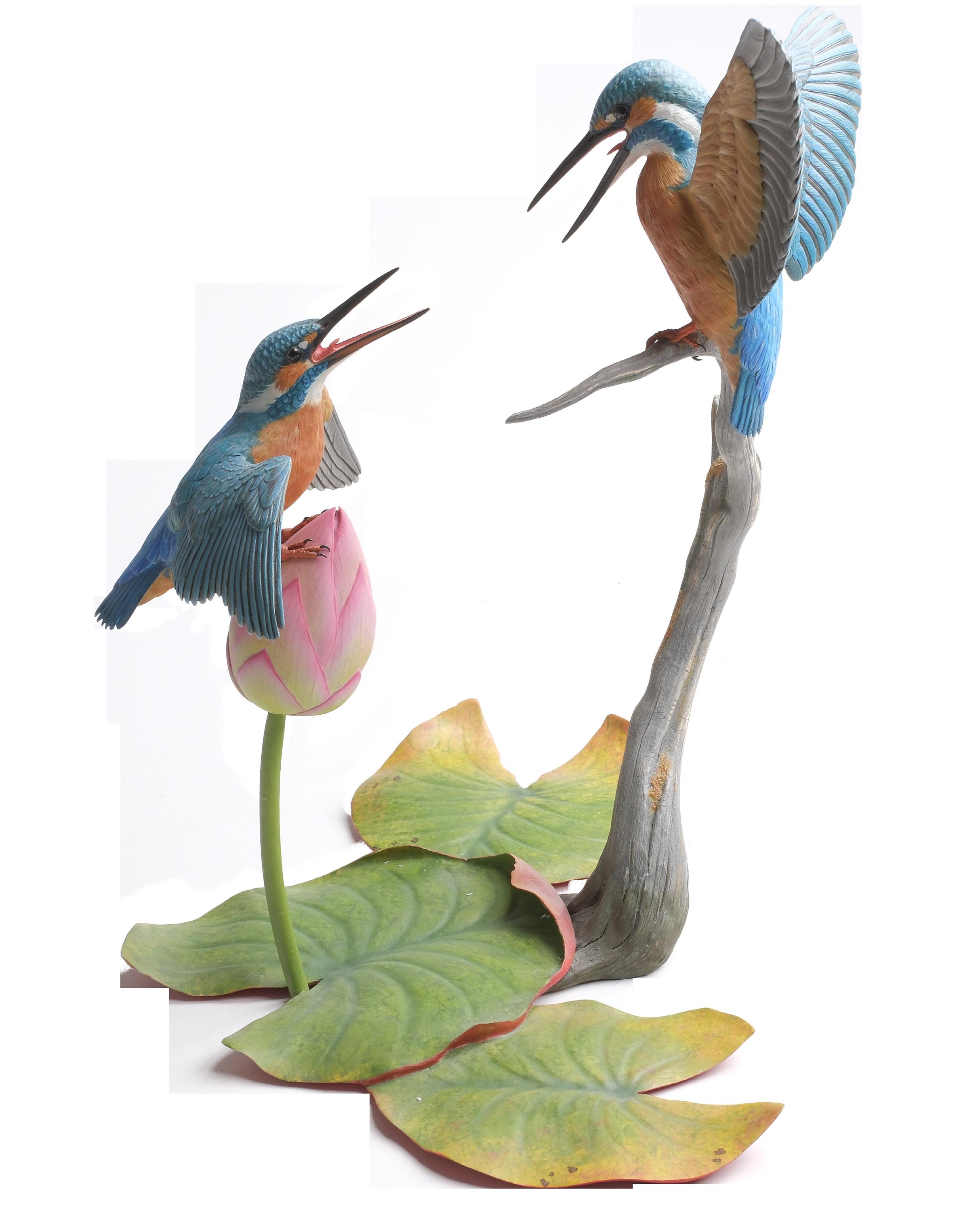

247
Gary Eigenberger Green Bay, Wisconsin
With a love for nature and the outdoors, and an intriguing interest in three-dimensional sculpture, Gary started sculpturing animals and birds in clay at an early age. His first exhibit was at his local public library at age seven. At age 14, Gary started sculpturing and carving birds out of wood with his only tool then being a pocketknife. Gary started carving seriously in 1987 as he became aware of the deep love he had for wildfowl and the art form. Having vivid impressions from observing nature, coupled with his natural artistic sense of design, intricate detail, and realism, allowed him to create various sculptures that have been on exhibit worldwide. He has received numerous “Best of Show” awards over the years throughout the United States. He has won Best in World title eight times, in the Masters Class 22 1st Best of Show, and in 2002, 2013 and 2019 was awarded first place Peoples Choice Award at the Ward World Wildfowl Carving Championships. He is also a sixteen time Gulf South Champion in the Miniature class and also won the Decorative Life-size purchase award in 2003, 2005, 2011 and 2012 sponsored by ConocoPhillips Petroleum.

Eigenberger also extends his knowledge of birds and his artistic expertise by judging various shows, teaching in carving seminars, and educating the public awareness of the art form of wildfowl carvings in conjunction with the conservation of our wildlife resources. He is featured in many national art and collecting magazines throughout the United States and his works can be found in various private and corporate collections, galleries, and exhibits including the prestigious Leigh Yawkey Woodson Art Museum “Birds in Art” exhibits in 1991 - 1993, 1995, 2007, 2008, 2010, and 2013-2023, Christie’s of London, England “Wildlife Art” in 1997 - 2000, and the Easton Waterfowl Festival in 1999 - 2010, and was the selected artist to do the Masterpiece Carving for the Easton Waterfowl Festival in 2006, solo exhibits at the Bush Art Center in 2005, the Neville Public Museum in 2006 and 2011, Paine Art Center in 2016. Also a designated Signature Member Artist with the Society of Animal Artists. In 2023, his work was selected in the SAA exhibition tour celebrating the 63rd SAA annual exhibition.

248
378
Highly decorative carving of a green tailed towhee and vesper sparrow, Gary Eigenberger. Mounted to desert out groove and cactus. Stands 37” tall. Excellent and original. (5,000 - 10,000)

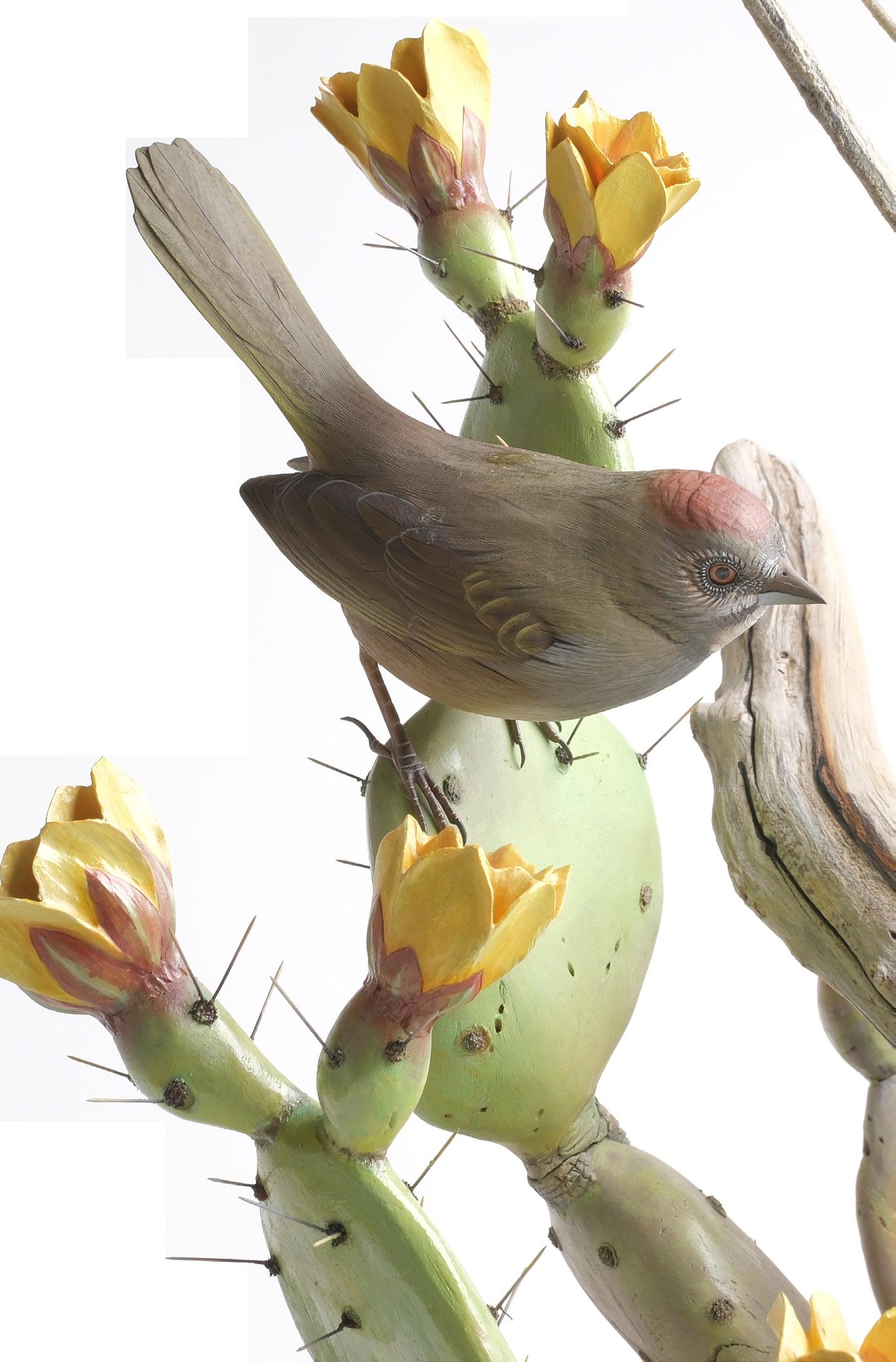
249
Gary Yoder Garrett County, Maryland
Gary Yoder grew up on a farm in Garrett County, Maryland and is a keen observer of song birds and water fowl. Gary creates nearly life-like sculptures of birds he has viewed in the region. As well he carves a variety of individual feathers. Gary attributes his initial interest to an elementary school teacher who encouraged him to pursue his love of birds and his skills as a carver.

Gary has earned numerous awards and recognition, including five first place finishes at the Ward Foundation World Bird Carving Championships. His bird sculptures can be found in private collections all over the world, as well as in the Ward Foundation Museum in Salisbury, MD. Gary’s exhibition list includes The Smithsonian, The Bruce Museum, The Leigh Yawkey Woodson Art Museum, and the World Bird Carving Exhibition in Japan.
Gary Yoder has been the Carver-inResidence at the Spruce Forest Artisan Village since 1972. Gary mentors area carvers, and over the years those artists have also earned awards.

250
379 Green herons, Gary Yoder, Garrett County, Maryland. An alert pair, perched on a partially submerged root with carved wooden lily pads. This exact piece won first best of show at the world championship in 2001. Stands 17” all. Very small amount of damage to the crest at top of head on the top bird, and beak has been blunted on the lower bird.

251
(12,000 - 15,000)
Thomas Horn
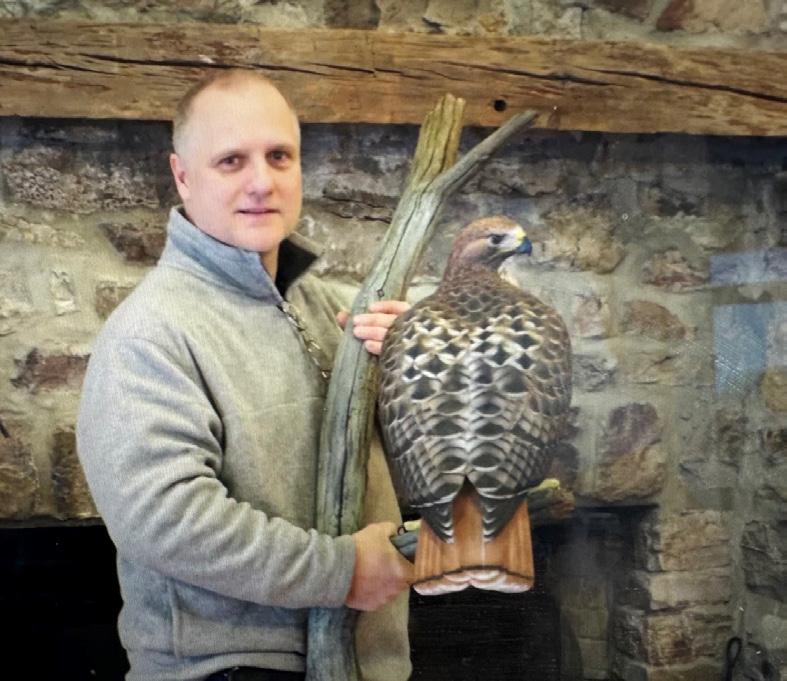
Emmaus, Pennsylvania
This is a pair of ocellated antbirds found in central America. They can be found on the forest floor, following army ants and feeding off of insects. The snake is a Fer-de-lance, a very common venomous pit viper found through central and south America. It is very well camouflaged and difficult to see. When I was viewing these birds in Costa Rica the guides overly expressed caution for these snakes when I stepped of the trail to photograph. I wanted to create that danger dynamic with this piece. The birds and snake are carved from tupelo wood and hand textured. The habitat is forged from brass and steel and the entire piece is then painted with acrylics. The piece was commissioned in 2014 and completed in 2015.

252
380
Two ocellated antbirds, Thomas Horn, Emmaus, Pennsylvania, 2015. Nearly hidden because of camouflage in the leaf foliage at the base, is a central American Fer-de-lance, which is well disguised. 22” tall. Excellent and original. (8,000 - 12,000)


253
“This piece was a 2016 ward world championship life size 1st place winner. The entire piece is carved and fordged, making the base special apart from the bird just being mounted. (Just like all my pieces, the base is as special as the subject and an equal part of the entire sculpture.) The branch is forged and brazed brass. The thin crest feathers are inserted bamboo and the judges said it was one of the best insert transitions they have seen. They also commented on intricate pattern the neck and chest feathers have. All the feathers were actually done under a microscope with special burning tips I make to achieve the hair like pattern. The iridescence technique I used in this piece as well as the hummingbird piece is a technique I developed and as far as I know no one has achieved this effect to date. As you can see it actually is interactive. It changes color depending on viewing direction and in different lighting conditions. It is one of my most rewarding technique. It truly represents iridescence and is very difficult to promote online. It is something that is best viewed in person.”
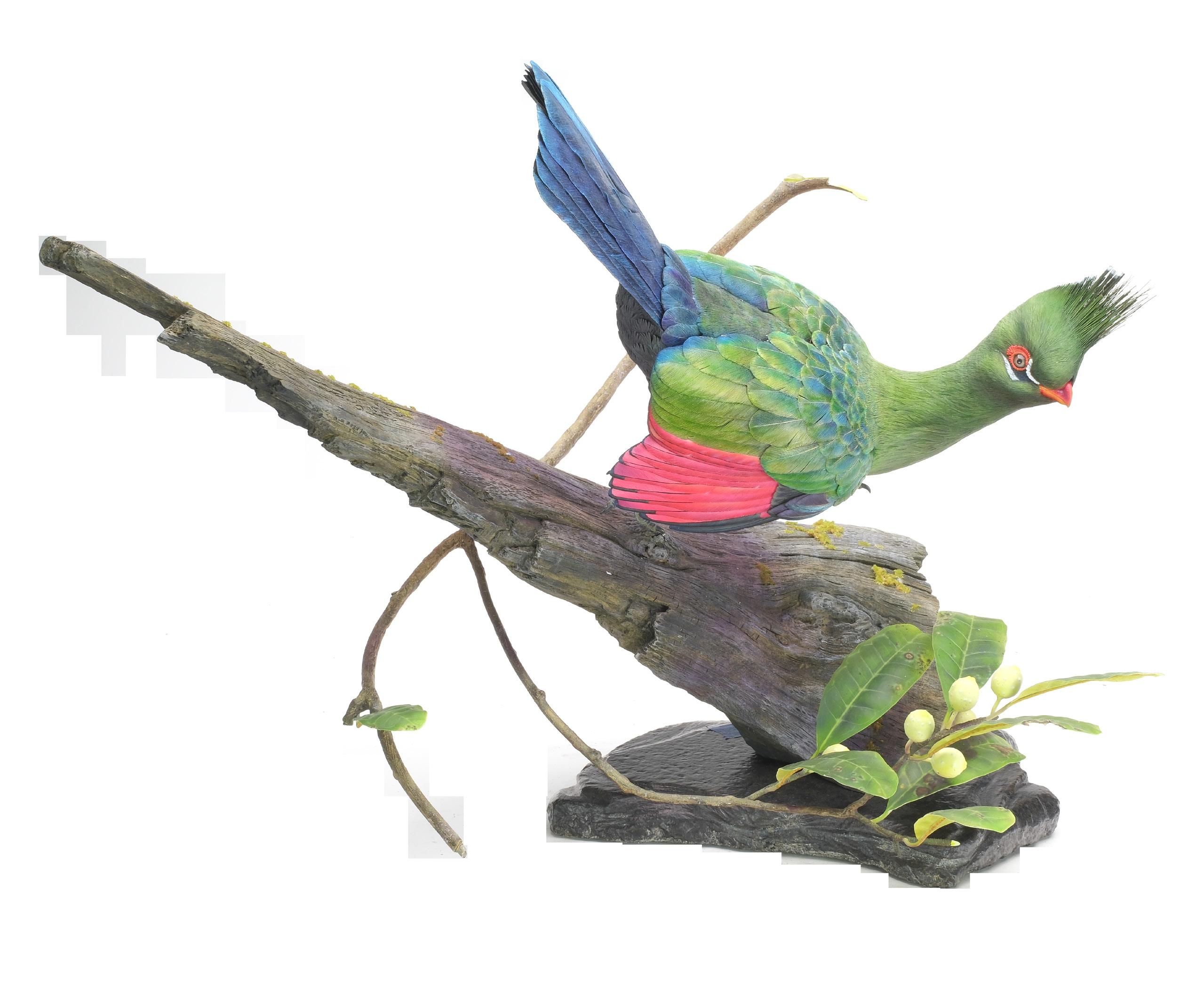
254
381
Decorative Livingstone’s turaco,

Thomas Horn,
Emmaus,
Pennsylvania. Fully wooden carved. Mounted on jungle base. Bird measures 14” from head to tail. Total height is 19” tall. Small amount of damage in fine crest feathers, otherwise very good and original. (10,000 - 20,000)
Highly decorative sculpture creation of two falcons fighting over a snared bufflehead drake, Joe Cootes. Made in 2000. Stands 34” One tail feather on lower falcon broken with approximately .75” missing. (4,000 - 6,000)
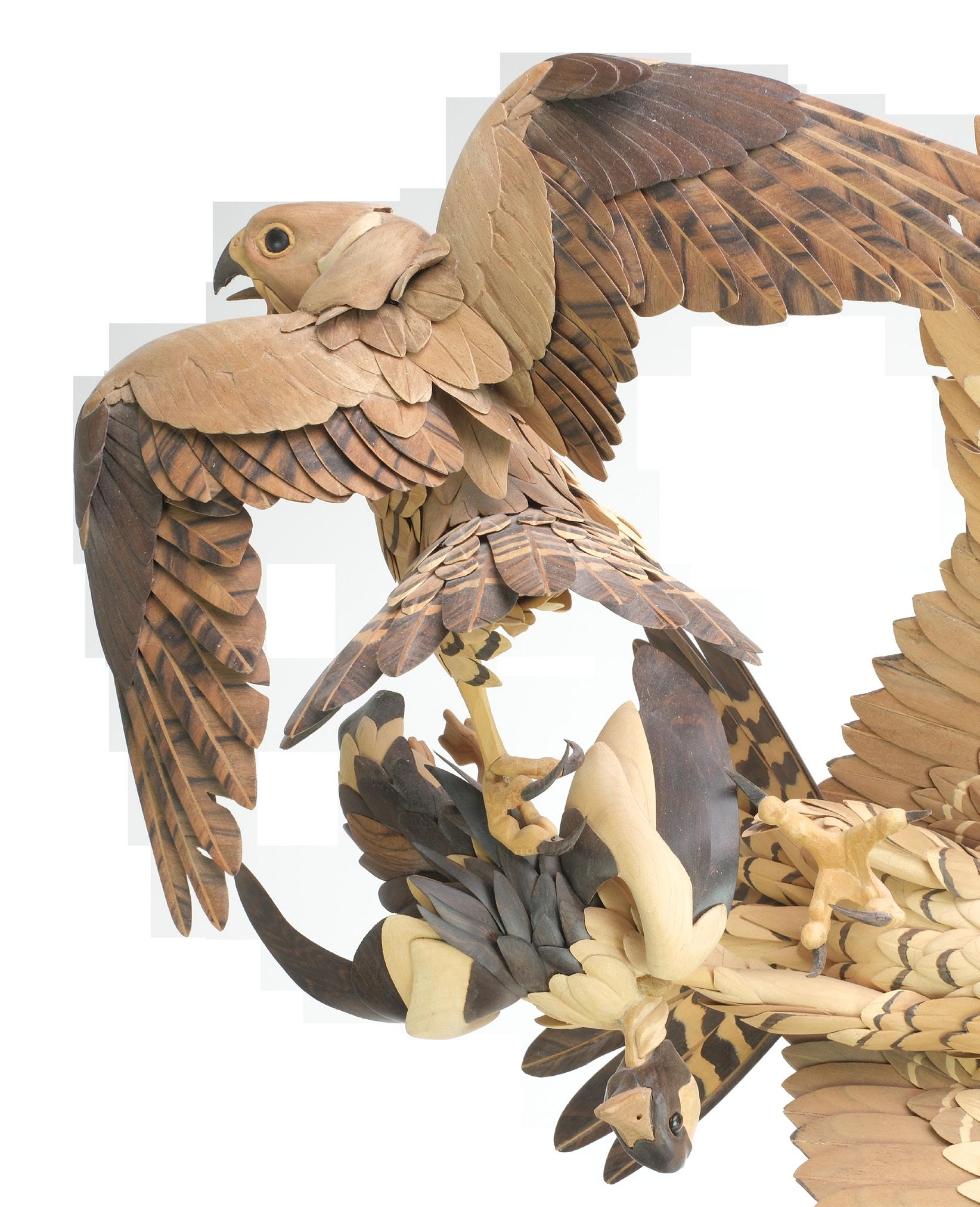

382a Decorative carving titled “Startled”, Gregor Gillespie. Halliburton, Ontario, Canada. Carved from black walnut. Measures 29” x 14” x 24”. Finished with flamed linseed oil and beeswax. The carving depicts unexpected coming together of two aquatic inhabitants a muskrat and a duck with the question who startled who. This piece disassembles into its own wood case carrying box. This carving earned Greg ‘Master Carver’ status in 2016 when it placed Third at the Ward World Championship Interpretive Sculpture division. Excellent and original.
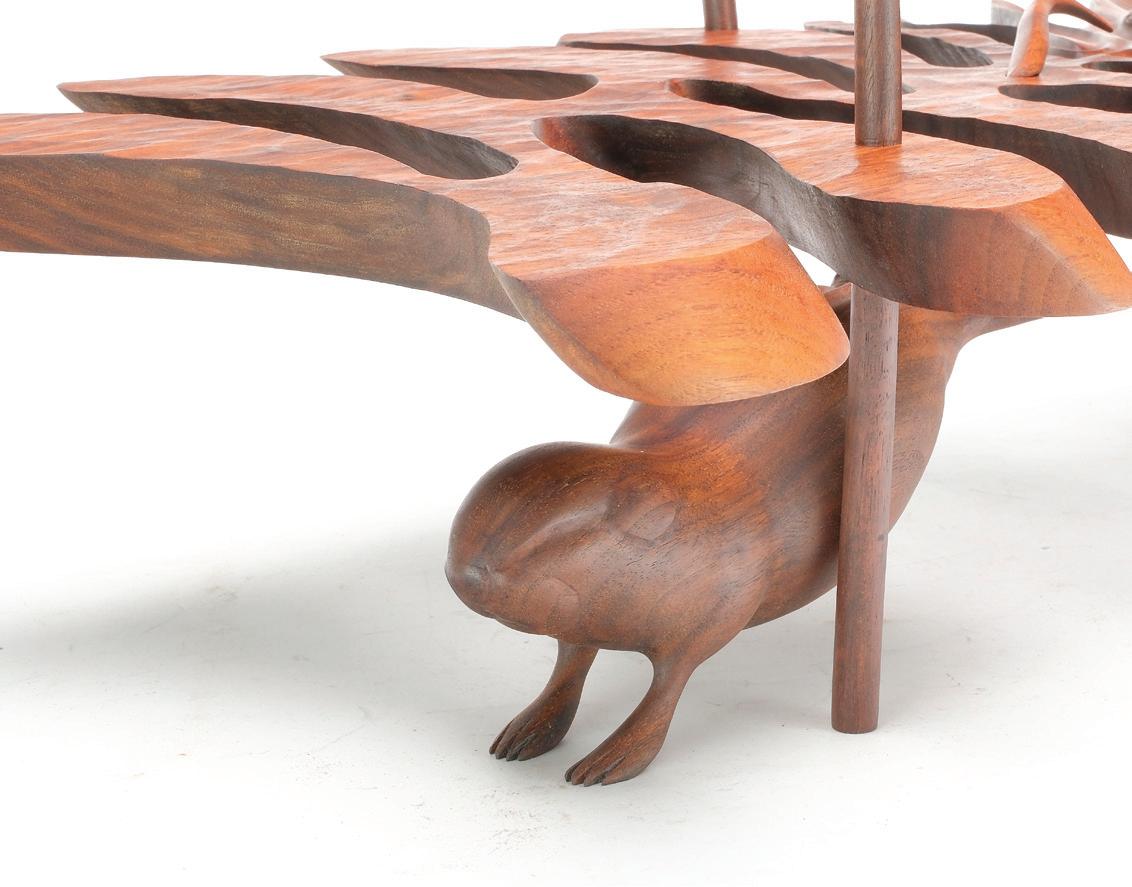

(3,000 - 5,000)

257
Larry Barth
Marinette, Wisconsin
Born in 1957 in Marinette, Wisconsin, Barth attended Carnegie Mellon University, where he studied graphic design and was heading toward a degree in illustration. That changed when, during the fall of his freshman year, his family visited a Ward Museum show. There Barth realized that he was not the only one interested in carving birds; it was an “eye opening” experience for him. Following this, Barth worked toward entering the 1976 World Competition, his first time at Worlds. Though he would have welcomed advice and guidance in these formative years, in hindsight Barth has remarked that he was fortunate to have begun to carve before seeing others do it too; it meant he would not have to follow “a prescribed set of guidelines.” His work has remained recognizably unique throughout the course of his career, and he has blazed many trails within the field.
Just as each bird representation that Barth creates is unique, so too are the “non-bird” components that set his pieces apart. Barth is expert at balancing a bird’s form and color in its environment, without adding anything unnecessary—whether positioning birds on branches, on ferns, or in water. 2015 Living Legend and 14-time Best in World winner Pat Godin told the Ward Museum that Barth is “the master of simplicity.” Godin states that despite simplicity, or more likely because of it, Barth is “incredible at communicating things” in sculpture; he “takes away anything unnecessary” and leaves the feeling or essence of a natural scene.

This ability to convey information and emotions through his art so elegantly has set Barth apart from much of his field. He has pushed the progression of the art form as a master of design and execution. Yet, Barth has remained accessible and helpful to his fellow carvers, making himself available to examine and critique others’ carvings and art at competitions, well articulating what he has learned and developed over the years.
Barth’s award-winning work has been shown at museums and in private collections around the country, as well as internationally. In 2015 Barth won his 16th Best in World title at the annual Ward World Championships.
258
383 Pileated woodpecker, Larry Barth, Stahlstown, Pennsylvania, 1994. Full size woodpecker mounted to a carved bark base. Woodpecker measures 16”, overall height is 33”. Very small chip near top of bark is missing approximately .5”.


(10,000 - 15,000)

259
383a Full size decorative northern goshawk, Ron Tepley, Racine, Wisconsin. With raised, outstretched wings and open beak. Highly detailed feather carving. Signed and dated 1988 on the base. Hawk measures 21.75” long, 16.5” wide across the wings. Measures 19.5” tall including base. Minor roughness on edge of one wing feather, otherwise excellent.


260
Provenance: Lynwood Herrington collection. (7,000 - 10,000)
383b Full size red tail hawk, Ron Tepley, Racine, Wisconsin. Signed and dated ‘88 on underside. Hawk has slightly spread wings and very detailed feather tail carving. Glass eyes and open mouth. Perched on a part of a fence post with barb wire. Carved wooden stones and even an acorn tucked in between the post and a rock. Measures 24” tall. Very good and original.
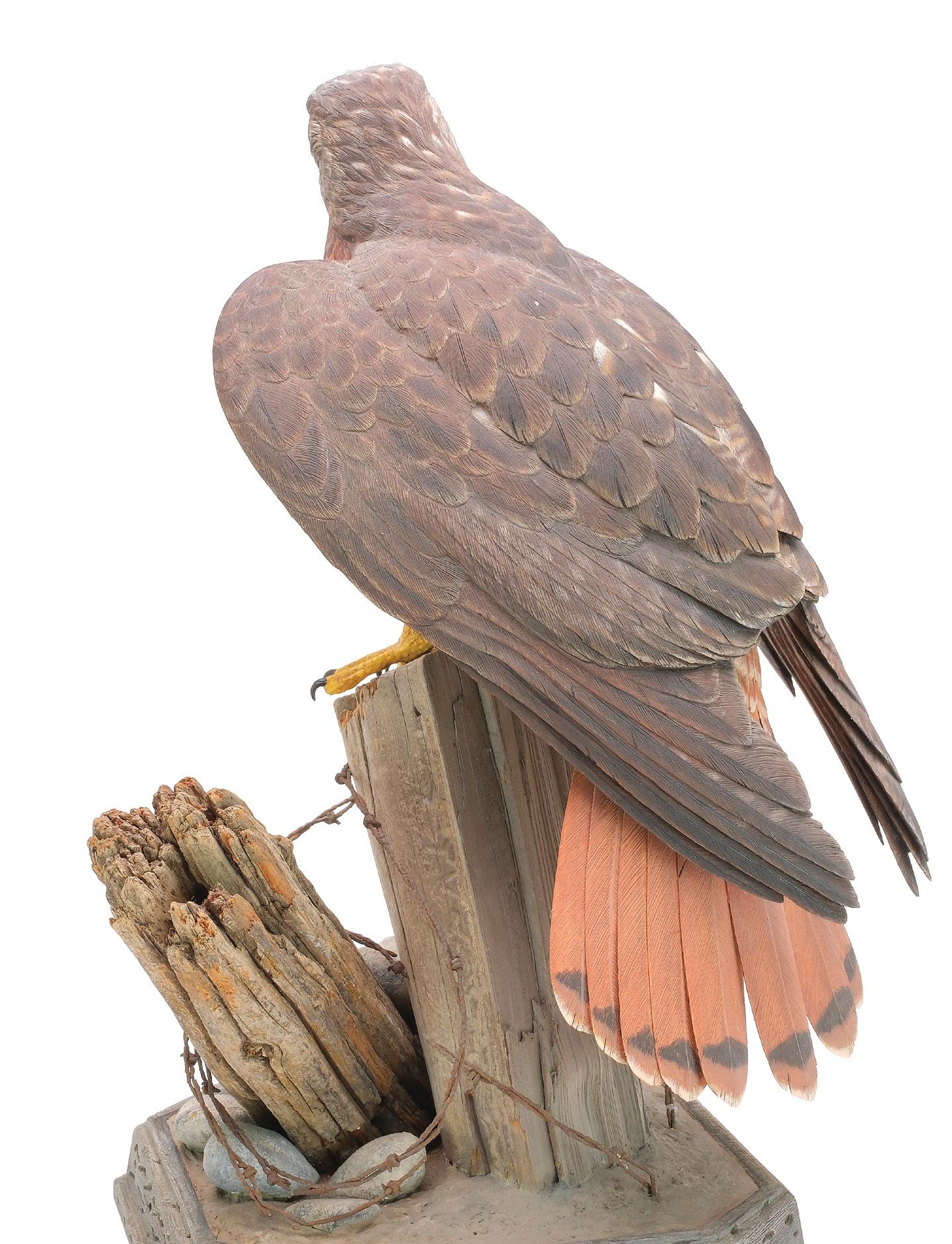
Provenance: Lynwood Herrington collection. (6,000 - 9,000)

261
384 Yellowlegs standing pearched on a single foot, Robert Ptashnik. Bird is standing on a carved oyster shell. Highly decorative with individually carved feathers. Stands 11.5”. Excellent. (1,500 - 2,500)

385 Harlequin, Jon Jones, Algonac, Michigan. Signed and dated 1988 on underside. Raised, turned head with bill slightly open. Extended and raised wingtips. Detailed feather carving. 12.5” long. Tips of three very small tail feathers are slightly blunted otherwise excellent and original. (4,000 - 6,000)

262
384 385
(1,500 - 2,500)

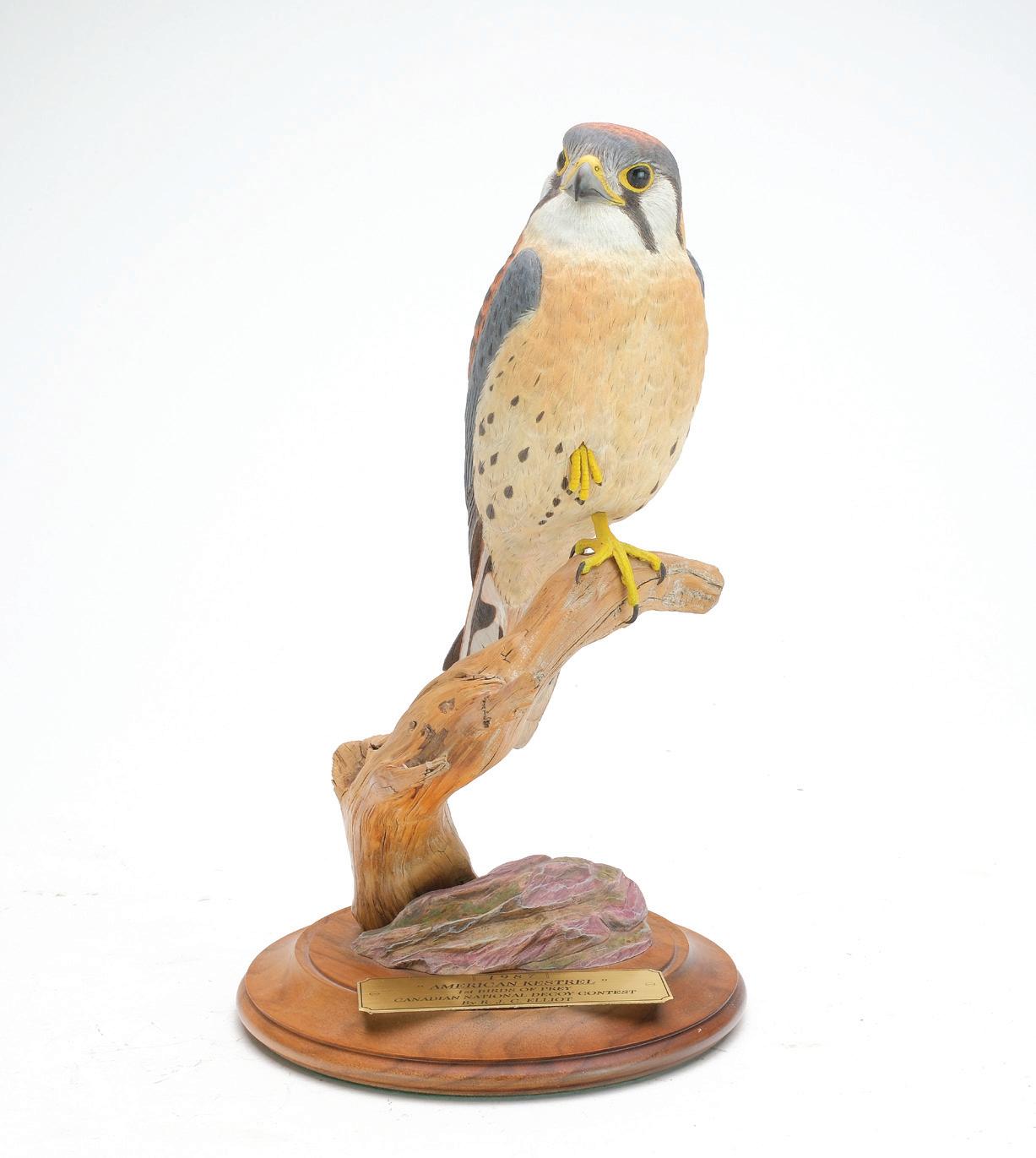
263 386
386 American kestrel, R.J.C. Elliot, 1987. Full size kestrel mounted to branch on decorative bass. Stands 12” tall. Very good and original. (1,000 - 2,000)
387 Pair of standing sanderling, John Sharp, Kent, Ohio. Carved from a single piece of walnut. Birds with heads turned and bills buried in back feathers. Signed and dated ‘85 in base. Base measures 14.5” across, birds stand 6.75” tall. Excellent and original.
American West
387a Harry Jackson (1924-2011), bronze. Signed and dated 1991. War chief on horse with scalp in one hand. Bronze is painted with lighter colors brown. Measures 42” tall. Titled “The Victor”. Very good and original. (2,000 - 4,000)

264

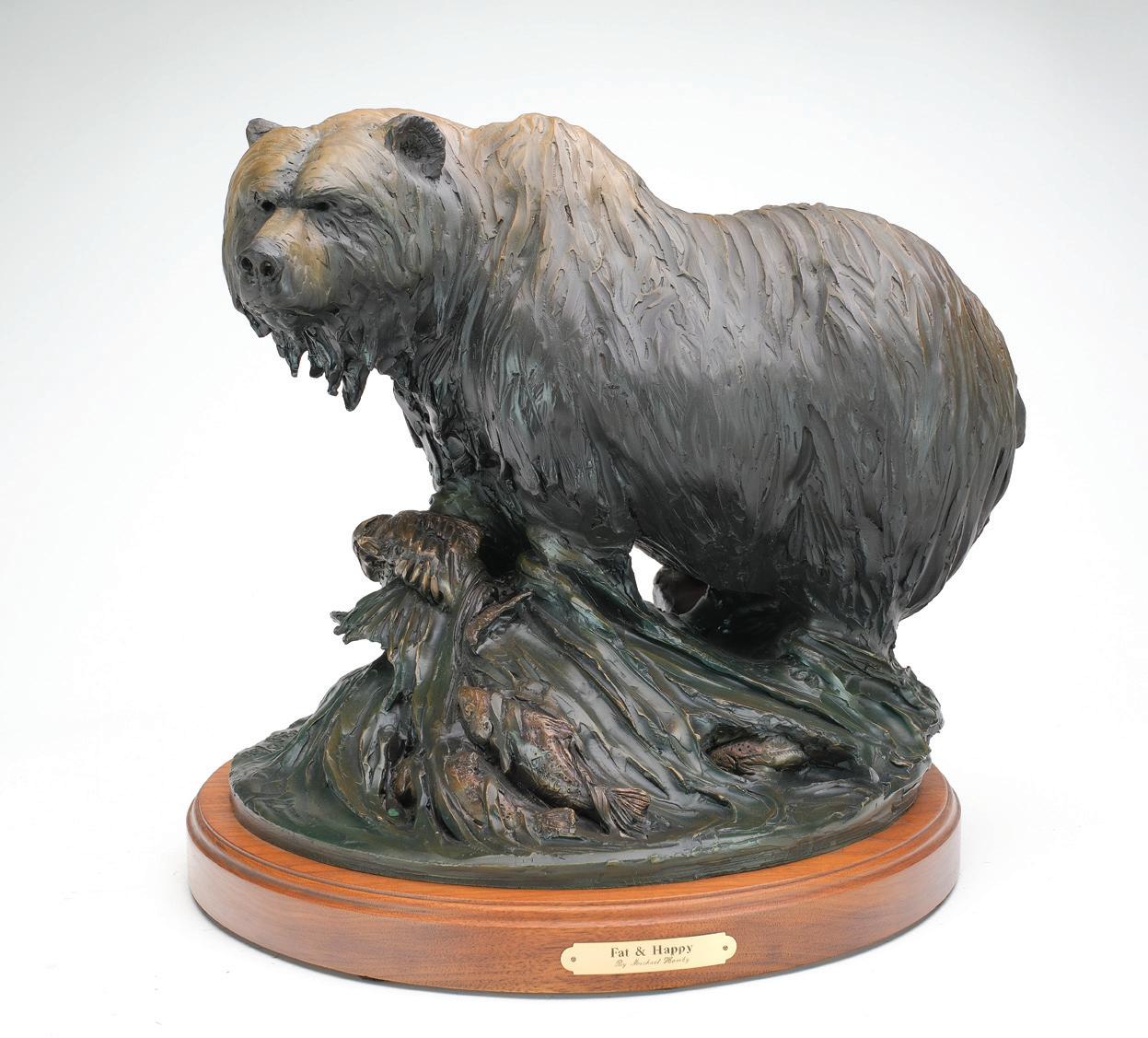
265
387b Harry Jackson (1924-2011), bronze. Sacagawea. Signed and dated 1980 on back. Bronze with marble base stands 20”. (2,000 - 3,000)
387c Michael Hamby (b.1962), bronze. 1998 35/35. Titled “Fat and Happy”. Brown bear catching salmon on swivel base. Measures 18” tall. (1,000 - 1,500)
387b
387c
Harold Lyon was born in 1930 and spent his youth working in the northern Ontario woods with his father before attending the Meinzinger School of Art in Detroit, Michigan. He also attended the Ontario College of Art in Toronto.
Lyon then taught art on his own CBC television series, worked in advertising, and illustrated on a freelance basis, including time working as an illustrator for the Hudson’s Bay Company in Calgary. Lyon turned to painting full time in 1965 while living in Calgary.
Painting Western genre, his works feature realistic subject matter in vivid color.

266
387d Harold Lyon (1930-2020), oil on canvas. Image measures 40” x 60. Signed lower left. Professionally framed. Frame measures 50” x 70”. Excellent; small puncture lower right. (3,000 - 4,000)
Jim Wilcox’s home, studio, and the Wilcox Gallery are across the highway from a national elk refuge about a mile north of Jackson Hole, Wyoming. His favorite painting subject is the Teton Mountain Range of which he paints thousands of plein air landscapes, but he also travels widely to paint landscapes, including ocean scenes of Hawaii.
He studied at Brigham Young University and took two years off to serve as a missionary for the
Mormon Church. Following graduation, he taught art at a high school near Seattle, Washington and then moved to Jackson to become a full-time artist. Wilcox is praised for his ability to capture abstract design, light and mood in his paintings. The artist’s love of nature and the scene captures the attention of the viewer.
In 1987, he won the Prix de West Award at the National Cowboy Hall of Fame in Oklahoma City, and in 1994, won the coveted $50,000 Grand Prize in the “Arts for the Parks” contest with his beaver pond painting, “Home of the Beaver.” Wilcox continues to win awards and praise from critics and collectors. In 2003 Jim Wilcox was named the featured artist for the Jackson Hole Fall Arts Festival.

267
387e Jim Wilcox (b.1941), oil on board.
Image measures 40” x 30”. Signed lower right. Copyright 1989. Landscape of the Tetons. Frame size 49” x 38.5”. Excellent.
(2,500 - 3,500)
Provenance: David
(1,500 - 2,500)
Provenance: David
(1,200 - 1,800)
Provenance: David
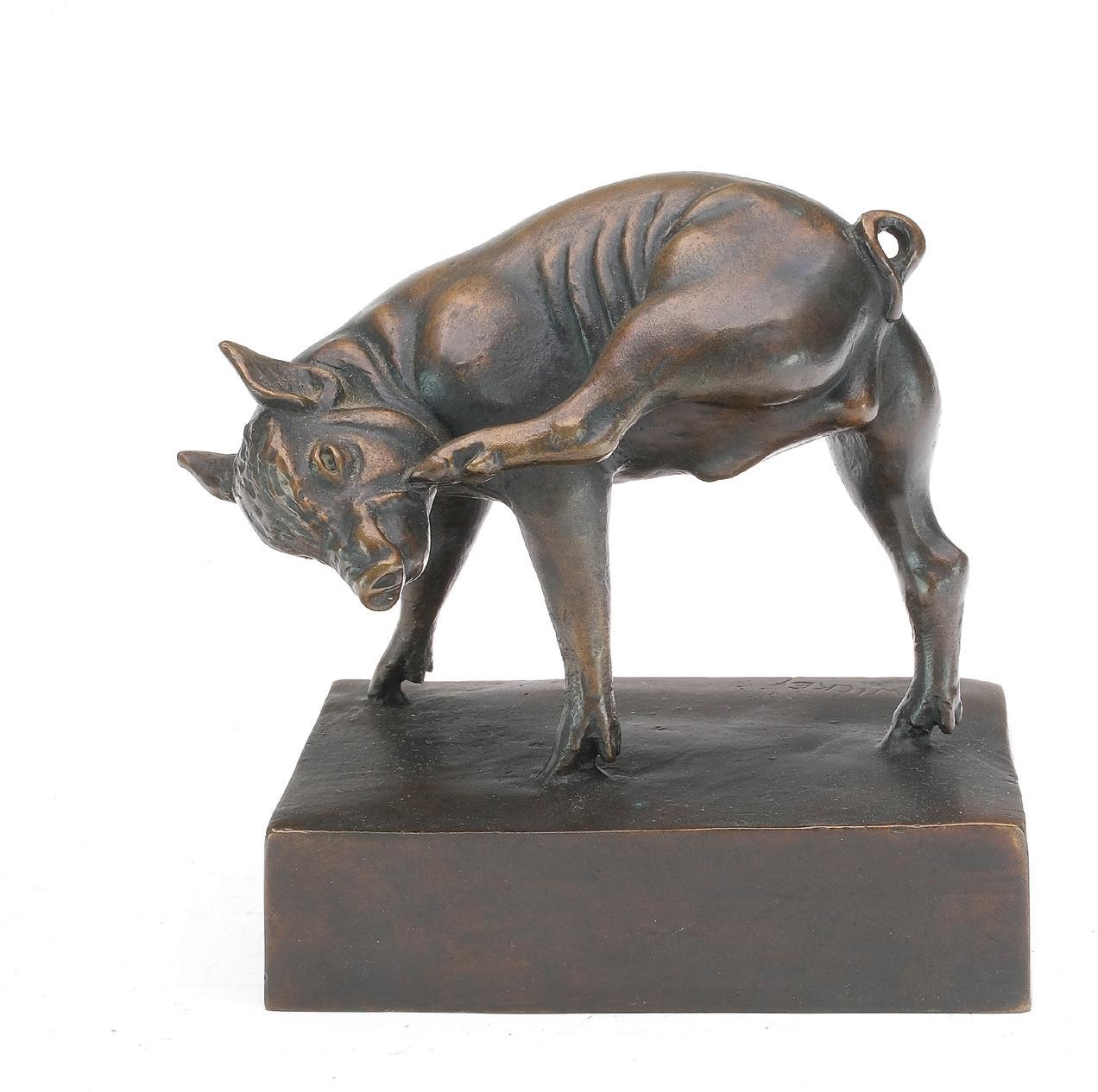

(500 - 800)

268 388
390
389
388 Harry Herman Wickey (1892-1968), bronze. Seated sow. Signed “Wickey” and dated 1940 on base. Measures 11.5” across and 8” tall. Very good.
Fannon collection.
389 Harry Herman Wickey (1892-1968), bronze. Standing lady checking her makeup. Signed “Wickey” and dated ‘40 and “eleventh avenue series” in base. Stands 17” tall. Very good and original.
Fannon collection.
390 Harry Herman Wickey (1892-1968), bronze. Small bronze of a pig with an itch. Signed “Wickey” on base. Measures 5” long and 5” tall. Very good and original.
Fannon collection.
391 Bill Ohrmann (b.1919), bronze. A grizzly bear on wooden base. Measures 12” tall, and 13” long. Excellent and original. (200 - 400)

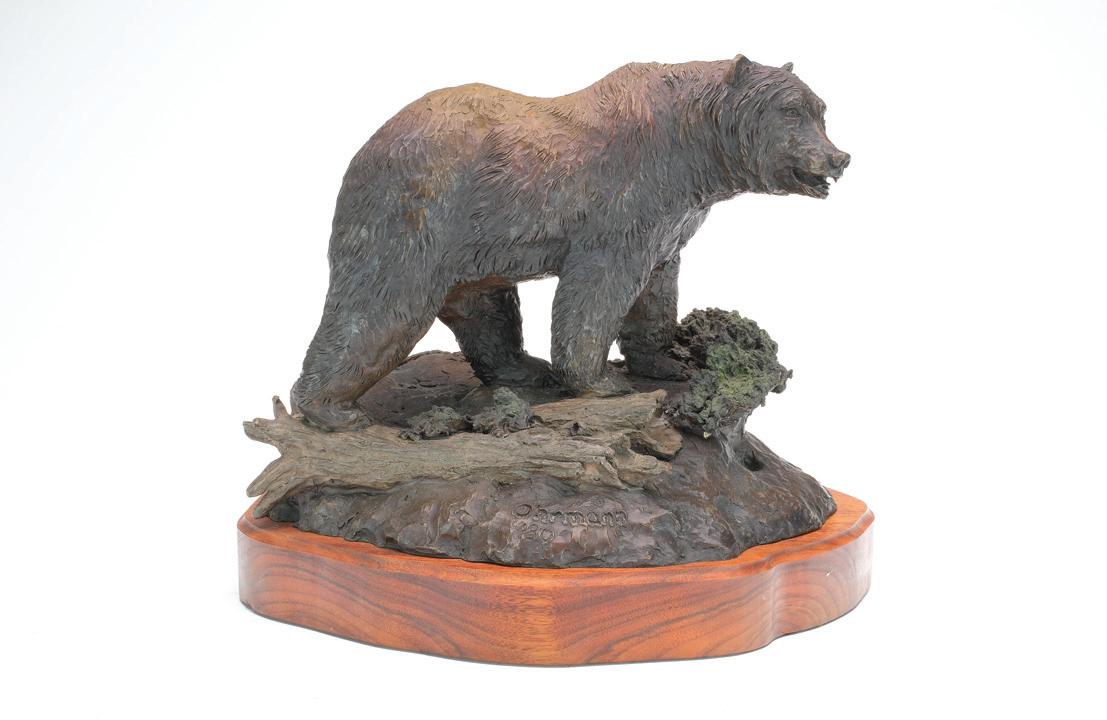
392 Burl Jones (20th century), bronze of a moose. Signed and dated 1997. Stands 13” tall. Very good and original. (200 - 400)

393 Bill Ohrmann (b.1919), bronze of a big horn sheep. Marked 16/25. and Marhmat. Stands 13”. Very good and original. (200 - 400)

394 AJ ‘Jack’ Richardson (1912-1978), bronze of a black bear. Dated 1982. Titled “Bugs for a black bear”. 8” tall. Excellent and original. (200 - 400)
395 Burl Jones (20th century), bronze of a kudu. Stands 20” tall. Original and good. (200 - 400)

396 Kevin Powell (20th century), bronze of a bull elk. Titled “Royal Retreat”. 39/100. 14” tall. Original and good. (200 - 400)
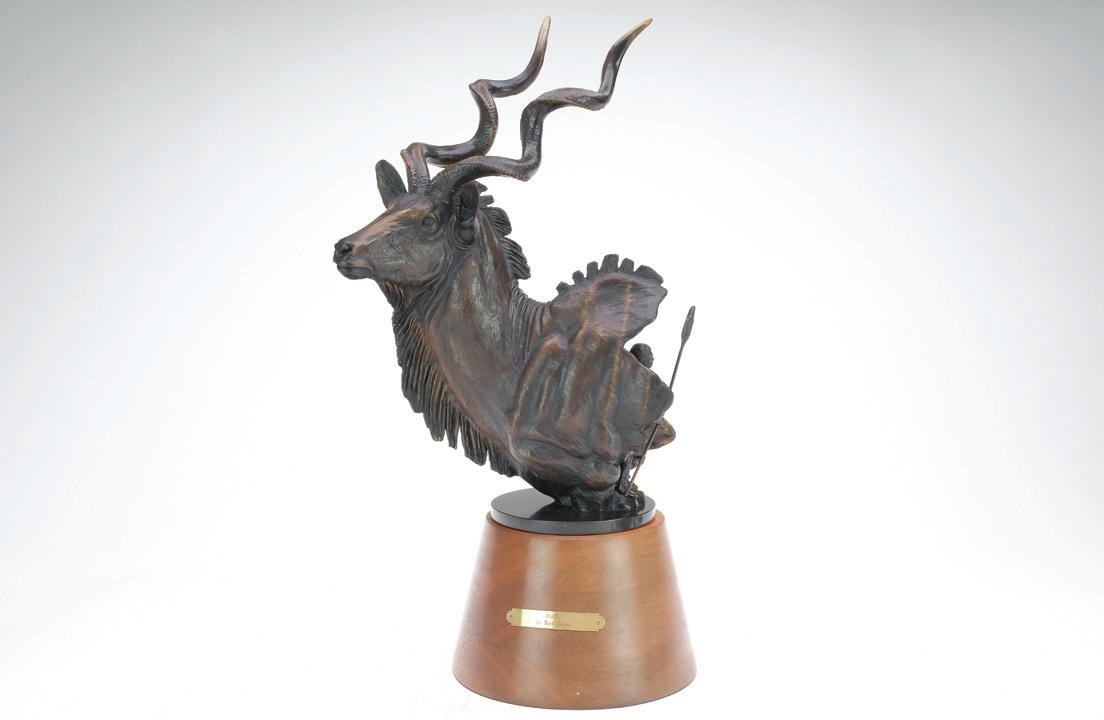
269
392
391 394
395 393 396
Charles Bergman


1856 - 1946 | Astoria, Oregon

270
(40,000
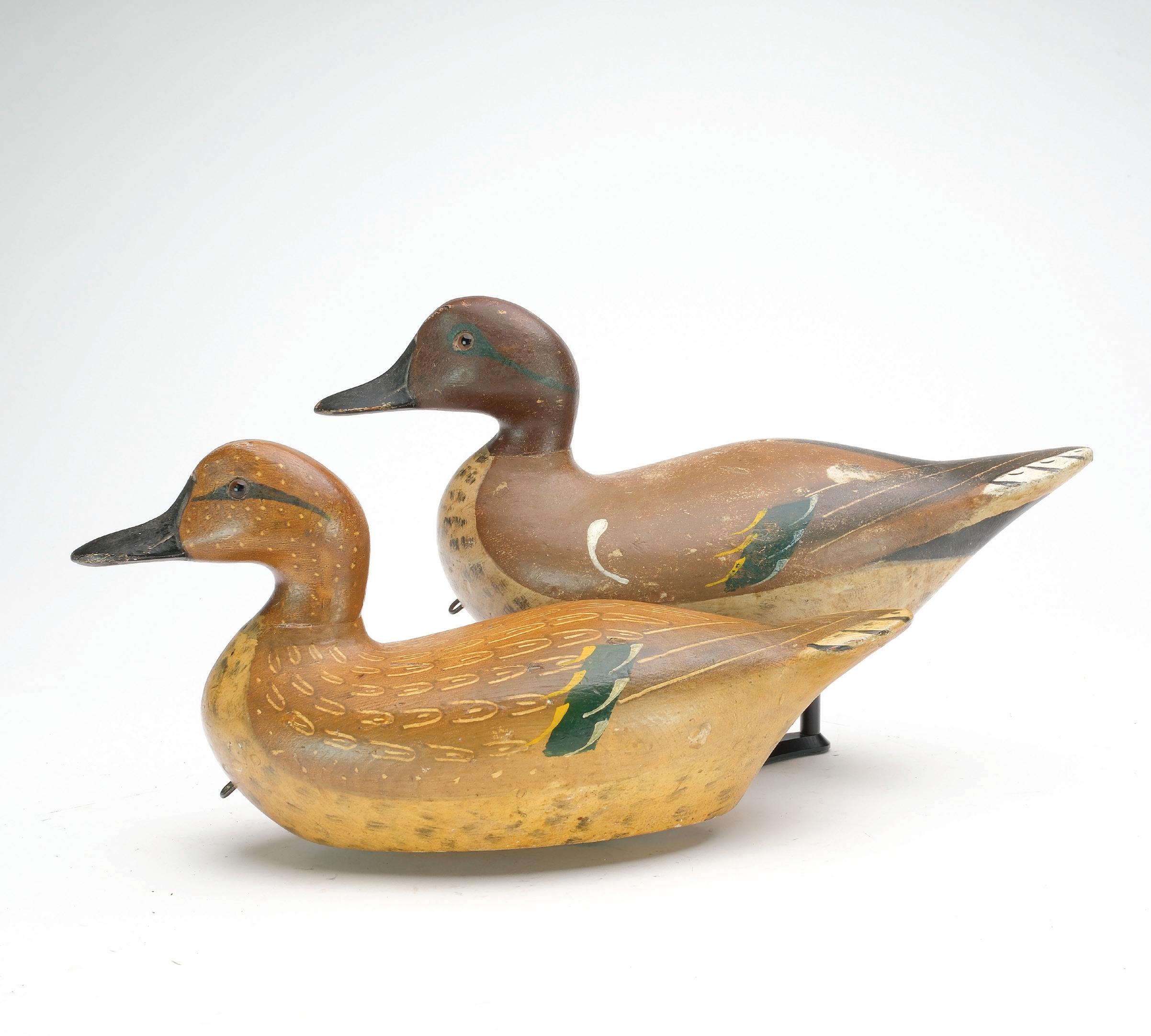
271
397 Pair of greenwing teal, Charles Bergman, Astoria, Oregon, 2nd quarter 20th century. Hollow carved with raised neck seats. Scratch feather paint detail on hen. “X” carved in underside of hen. Measure 13” long. Original paint with minor gunning wear; small dents; fine hairline seam in drake’s bill where it was tightly reset; thin coat of varnish on each has darkened with age.
- 60,000)
398 Very rare and desirable pair of hooded mergansers, Julius Middlestadt, Rochester, New York, 2nd quarter 20th century. Only one other pair of hooded mergansers by Middlestadt are known to exist. Tack eyes with carved crest. Wide bold bodies. This pair was never rigged for hunting. Measure 14” long. Strong original paint which has darkened with age, more so on white areas; very tight neck crack on hen; a few small dents on drake; small amount of wear around tail; tight crack in hen’s bill has been reset with a small amount of paint restoration to approximately .5” of the front of the bill.
(8,000 - 12,000)

272
399 Fine bluebill hen, Frank Coombs, Alexandria Bay, New York. Head is extended and turned. Excellent wet on wet body paint with fine feather detail at both wing patch and white area around bill and face. 15” long. A few small rubs from very light gunning wear.
(1,800 - 2,200)
400 Pintail drake, Harvey Stevens, Weedsport, New York, last quarter 19th century. In pencil on underside reads ‘Pintail’ with ‘HA Stevens Maker’ stencil, as well as ‘Standard Decoy’ stencil. Fine scratch painting . Head swivels as it should. Measures 16.5” long. Original paint with significant gunning wear; bill has been cracked and reset; two cracks in neck.


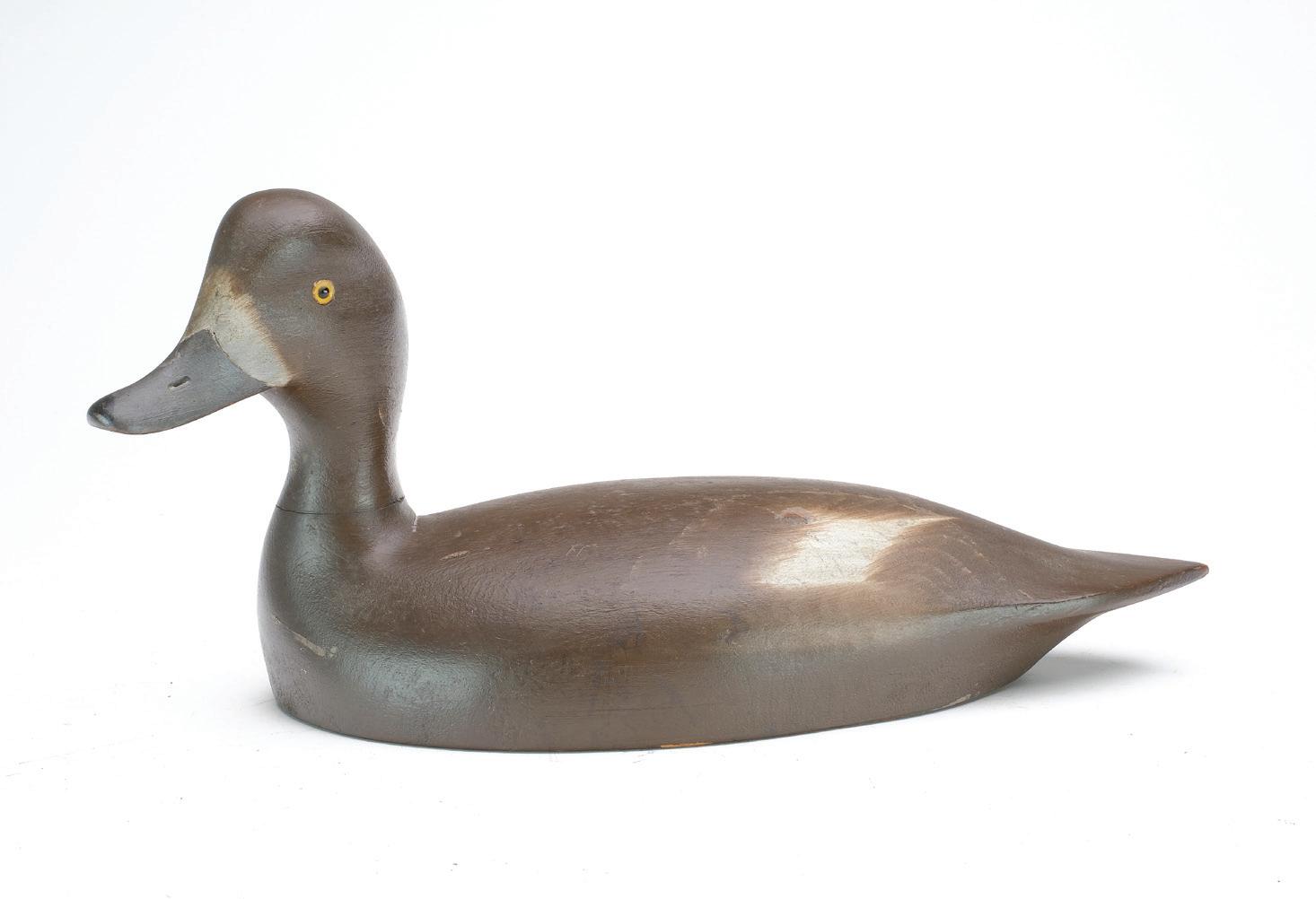
Provenance: Recently found in a home in the UK.

(2,500 - 3,500)
401 Bluebill, George Stevens, Weedsport, New York, last quarter 19th century. Inlayed lead weight and line tie staple. Comb feather paint detail on back. Head swivels as it should. Measures 14” long. Original paint with minor flaking and wear under an early coat of varnish; thin wash of white on the lower part of decoy; chip along one side of the bill; minor flaking along seam of a wooden patch in back.
(1,200 - 1,800)
273
399 400 401
Lloyd Sterling
1880 - 1964 | Crisfield, Maryland
402 Rare pintail drake, Lloyd Sterling, Crisfield, Maryland. Large decoy with reared back head and wide, extended tail. Scratch feather paint detail. Measures 21.5” long. Original paint with moderate flaking and wear; significant wear on breast; head is slightly loose; tight crack in upper part of neck; split along the back and underside; repair to a chip in one side of tail.


Provenance: David Fannon collection.
(8,000 - 12,000)
403 Pintail hen, Lloyd Sterling, Crisfield, Maryland. Wide body with upswept tail and slightly reared back head. Scratch feather paint detail. George Starr collection ink stamp on the underside. Kangas collection brand on the underside. Also stamped “PTS”. Measures 19.5” long. Original paint with significant wear; small dents and shot marks; filled crack with touchup along the back and tail; hairline cracks in each eye; fine hairline cracks in neck; much of the bill is a professional replacement; large chip in one side of neck was filled and touched up.


Provenance: David Fannon collection.
(6,000 - 9,000)
404 Decorative greenwing teal hen, Lloyd Sterling, Crisfield, Maryland, 2nd quarter 20th century. Head is turned with bill buried in to back feathers. One applied wing is dropped to one side, the other is raised off of body. Measures 9.5” long, stands 8” tall. Original paint under an original coat of varnish that has darkened with age; hairline crack in one side of breast; minor separation at neck seat; a few tiny spots of touchup on raised wing.


Provenance: David Fannon collection. (4,000 - 6,000)
405 Pintail, Lloyd Sterling, Crisfield, Maryland, 1st quarter 20th century. Wide body with upswept tail and reared back head. Scratch feather paint detail on wings. Measures 18” long. Paint was restored in the Sterling style with moderate discoloration and wear; filled split on back and breast; crack in one side of tail.
Provenance: David Fannon collection. (1,500 - 2,500)
404 405 276
406 Pair of canvasbacks, Henry Lockard, Elk Neck, Maryland, circa 1900. Drake is stamped “SGH” for the collection of Somers Headly. Measure 14.25” long. In use repaint by Severin Hall with minor wear; hen is excellent structurally; drake with a tight crack through neck and minor separation on one side of neck seat.
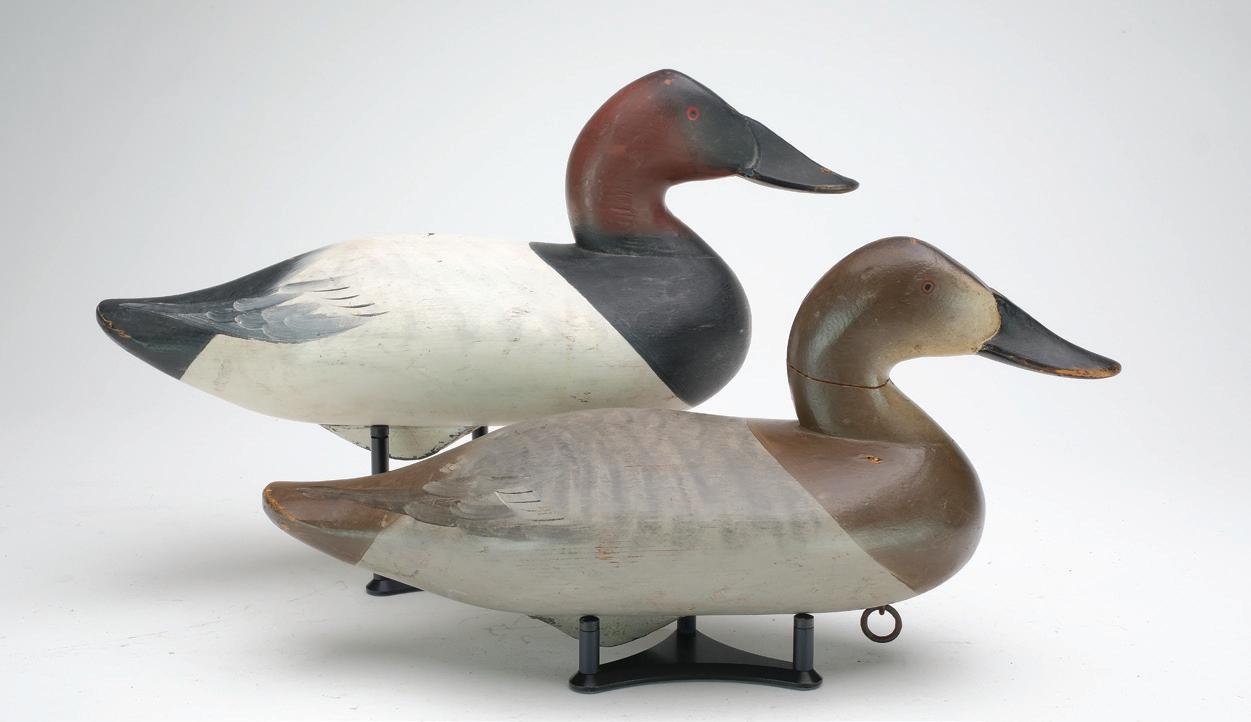


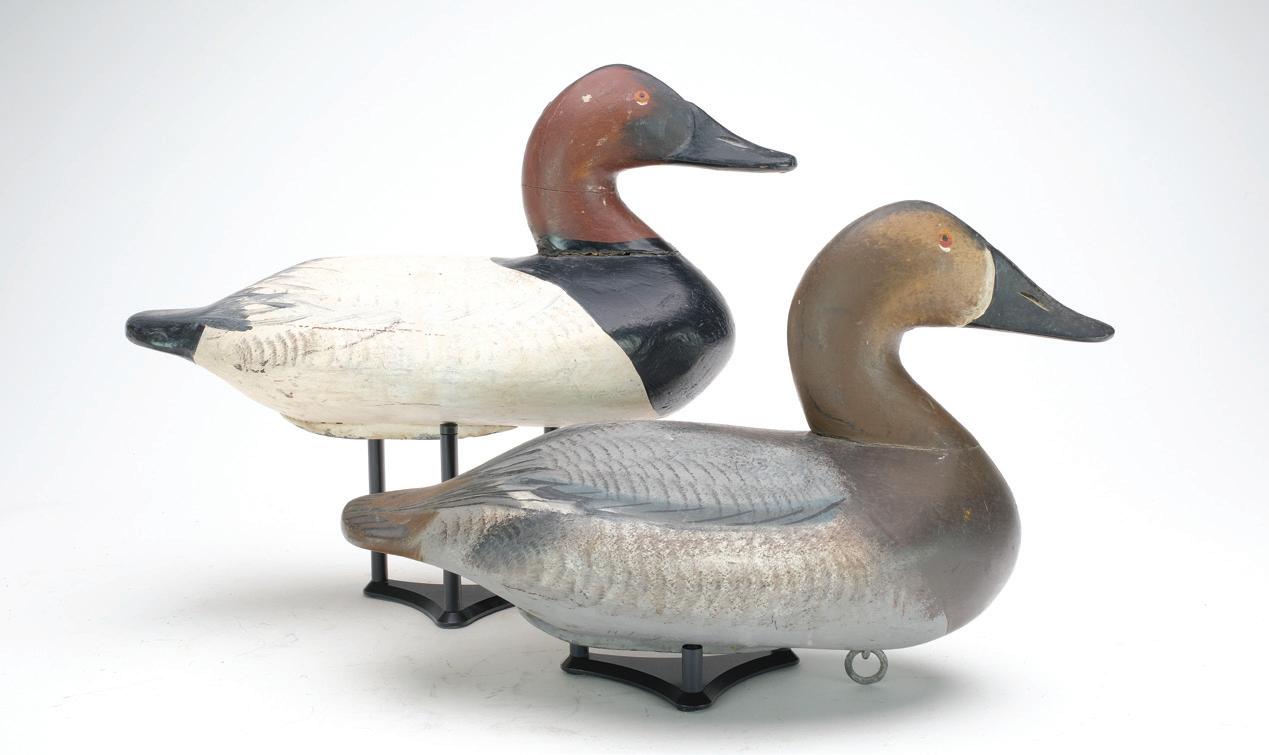
Provenance: Somers Headley collection. Mark and Ann Terry collection.
(1,200 - 1,800)
407 Pair of canvasbacks, Leonard Pryor, Chesapeake City, Maryland. “Bayard” deeply branded on the undersides. Measure 15.25” long. In use repaint by Charlie Joiner with minor to moderate wear; cracks and roughness on each neck; old puppy chews on drake’s bill; drake’s neck seat is slightly off with filler added to a small chip on one side.
Provenance: Mark and Ann Terry collection.
(600 - 900)
408 Pair of canvasbacks, Henry Davis, Maryland. 16” long. Both have had old paint removed down to the original surface with moderate wear; cracks at neck and body; shot scars.
Provenance: Mark and Ann Terry collection.
(500 - 700)
409 Early pair of canvasbacks, Charlie Joiner, Chestertown, Maryland. Each with wide bills and very slightly turned heads. Measure 16.25” long. Original paint with minor gunning wear; each is moderately hit by shot; crack through hen’s neck.
Provenance: Mark and Ann Terry collection.
(600 - 900)
277
406 408 407 409
410 Canvasback drake, James T. Holly, Havre de Grace, Maryland, 1st quarter 20th century.. A rare high head model. 16” long. White paint on body and red on head appear to be original; black has been strengthened a very long time ago; several shot scars; imperfection on underside of body which was secured by two nails. (1,000 - 1,400)
411 Canvasback hen, James Holly, Havre de Grace, Maryland, 1st quarter 20th century. Measures 14.25” long. Appealing second coat of paint appears to be by the maker showing moderate crazing and minor wear; lightly hit by shot; minor roughness on top of head and one side of bill tip.



Provenance: Mark and Ann Terry collection. (500 - 800)
412 Canvasback drake, Dick Howlett, Havre de Grace, Maryland, last quarter 19th century.. Old Oliver sticker on underside. 14.5” long. Multiple coats of old working repaint; repair to bill; crack in neck.
Provenance: Mark and Ann Terry collection. (500 - 700)
413 Canvasback, John Graham, Charlestown, Maryland, last quarter 19th century. Fat body with raised neck seat. Measures 14” long. Old in use repaint with significant flaking and wear; small dents and shot marks; crack through neck; repair to a .75” chip in tip of bill; chipping and roughness on edge of tail. (600 - 900)

278
410 412 411 413
414 Pintail, James Holly, Havre de Grace, Maryland, 1st quarter 20th century. Long body style with raised neck seat and tack eyes. “F” branded in the underside for the collection of Henry Fleckenstein. Measures 17.25” long. Early paint restoration with minor wear; hairline crack in breast; minor roughness on edge of bill. (600 - 900)
415 Canvasback, John Graham, Charlestown, Maryland, last quarter 19th century. Slightly flat bottomed, with raised neck seat and tack eyes. “J.B.Graham” branded twice on the underside. Measures 14” long. Old repaint with minor wear; early neck crack repair that has separated slightly; paint above brands was sanded down; 1/3 of the bill is professionally replaced. (1,000 - 1,500)
416 Mallard drake, Josiah Travers, Vienna, Maryland, 2nd quarter 20th century.. Gunning weight has been removed. Decoy has seen very little use. Appealing upswept bill. 13.5” long. Strong original paint structurally good. (800 - 1,200)


417 Wooden wingduck, Wallie Algard, Charlestown, Maryland. “AV” carved in the underside. Measures 13.25” long. Old paint with significant wear; hairline drying cracks in back and breast; tight crack through neck with old glue visible.

Provenance: Mark and Ann Terry collection. (500 - 800)

279
414 416 415 417
418 Full size egret decoy by an unknown maker
1st quarter 20th century. Used as a confidence decoy at the Remington Marsh and previously sold at a Richard Oliver auction in the 1980s. Balsa body with inserted leg and detachable head with glass eye. Stands 34” tall. Original paint shows nice age; wing and shoulder carving extending down back with a split dropped tail; has been mounted to a later decorative base; chip missing near cheek of head; crazing, rubs to white areas all which help show good age and make for a nice patina.

Provenance: David Fannon collection. (3,000 - 4,000)
418A Pair of cut and colored glass serving items. Each is engraved
“Cobb Island, Virginia” personalized on back. One says Elkanah and the other is Verna. These types of items were used at the Cobb Island hotel. Both measures 4” in height. Structurally good. (1,200 - 1,800)

280
419 Black duck, Nathan Cobb, Jr., Cobb Island, Virginia, last quarter 19th century. Two piece hollow body with inletted neck and beaded eyes. Fancy backwards “N” carved in underside. A sticker from Bourne indicates the decoy was sold March 7, 1987, and was at one time in the collection of Charlie Hunter, III. Measures 16” long. Old paint which is a mix of second coat and original; bill was broken and reset with a nail inserted from underside; seam separation at body halves.


 Provenance: Ex Charlie Hunter collection. (10,000 - 15,000)
Provenance: Ex Charlie Hunter collection. (10,000 - 15,000)
420 Brant, Nathan Cobb, Jr., Cobb Island, Virginia, last quarter 19th century. Head is slightly turned. Strong carving between tail and wings. Bill is splined through back of head. Carved eyes. Measures 17” long. Old paint possibly by Ira Hudson; shot scars; wear to bare wood; wear at tail and back of head from heavy in use wear. (7,000 - 10,000)
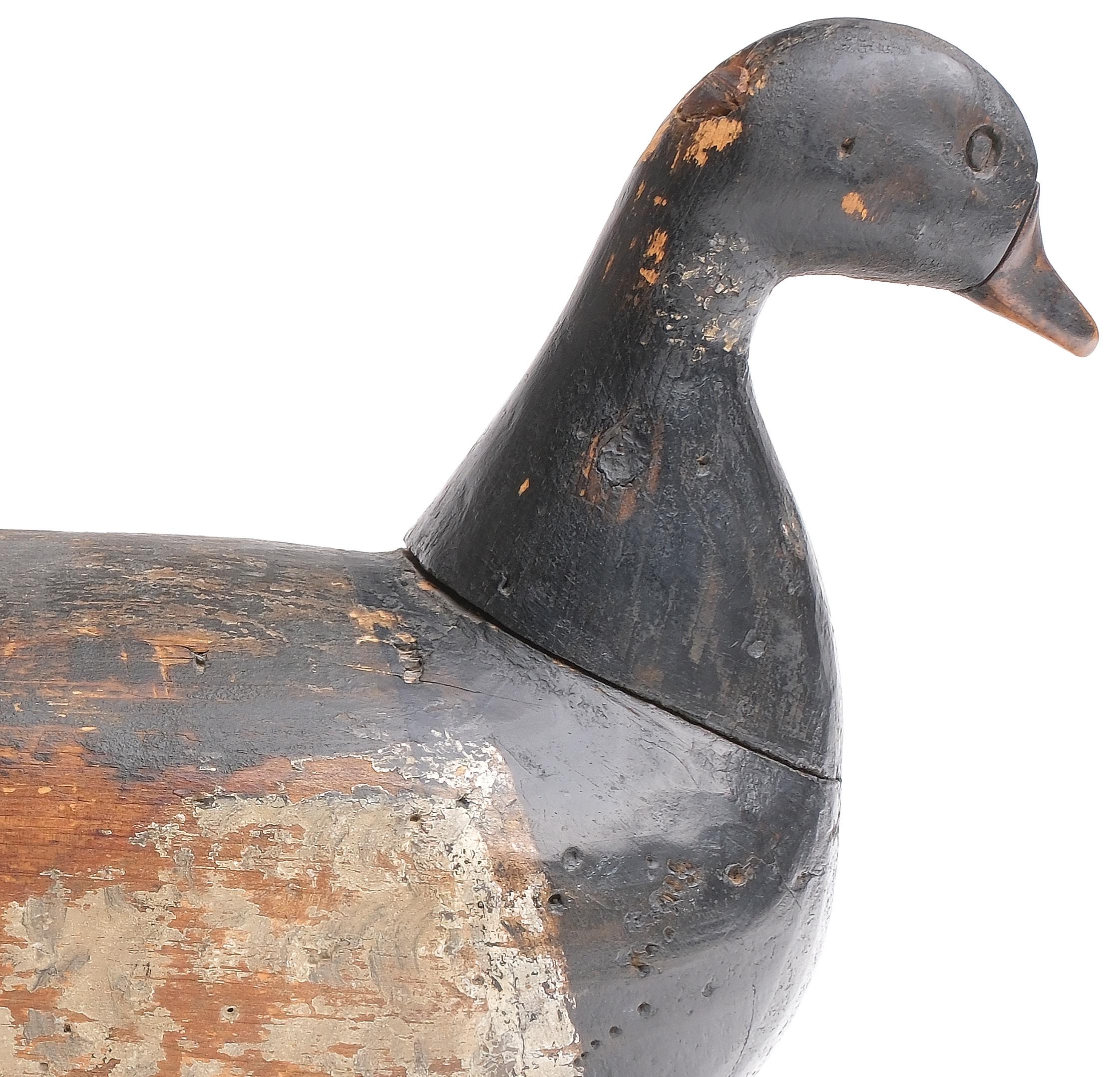

421 Black duck, Cobb Family, Cobb Island, Virginia, last quarter 19th century. A large, bold body with inletted neck. Measures 17” long. Old paint appears to be second coat; several tight cracks in body; professional replacement to approximately half of the bill; original head has been off and resecured.


(3,000 - 5,000)
422 Plump brant, Cobb Island, Virginia. Solid body with carved, split tail. Splined inserted bill and carved eyes. Measures 16” long. Faint remnants of the original paint exist, but has mostly weathered away; a few tight cracks in body and neck; wood scar on back of body; worm hole damage near tail; weathering on this decoy has created a nice dry appealing surface.
(5,000 - 8,000)
283
421 422
423 Bluebill drake, attributed to John Williams, Cedar Island, Virginia, circa 1900. Retains Hunter collection stamp and Oliver sale sticker from Nov. 9 1990. Measures 12” long. Old crazed paint that has worn away in many areas to expose bare wood or darkened wood.
Provenance: Charlie Hunter, III collection. (2,000 - 4,000)
424 Merganser hen, attributed to Ira Hudson, Chincoteague, Virginia, 1st quarter 20th century. Raised neck seat and relief wingtip carving. Extended crest and tack eyes. Like those found at the Gargatha,

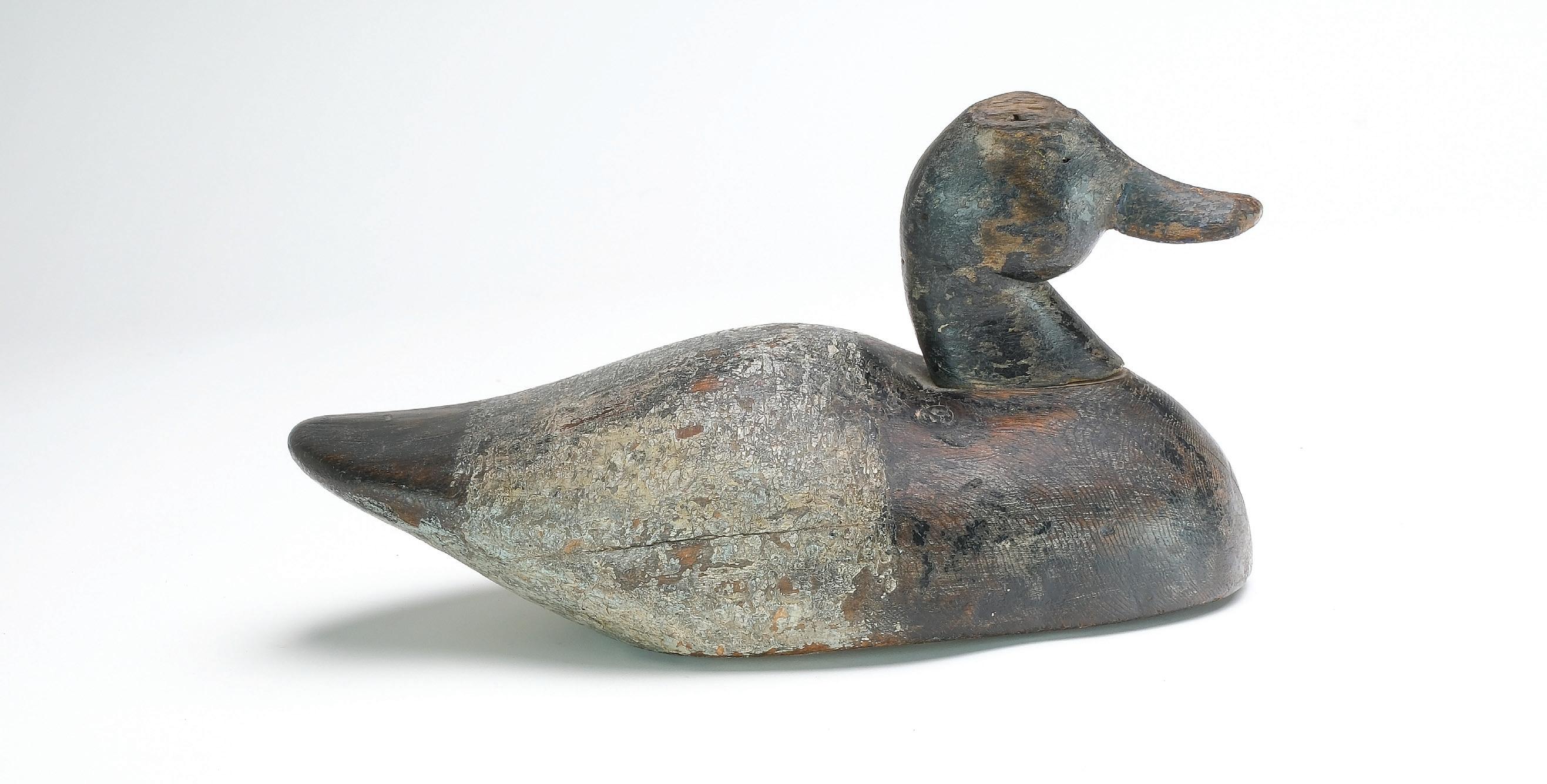
Virginia estate sale, May 1983. Measures 13.5” long. Old in use repaint with moderate flaking and wear; decoy was recently waxed; bill is a professional replacement; hairline crack along the back.
Provenance: Gargatha sale. (1,500 - 2,500)
425 Bufflehead drake, Ira Hudson, Chincoteague, Virginia, 1st quarter 20th century. Tack eyes. Measures 12” long. Worn original paint; imperfection that runs the length of the underside; head appears to have been off and resecured. (800 - 1,000)

284
423 424 425
426 Extremely rare pair of miniature redheads, Charles Clark, Chincoteague, Virginia, 2nd quarter 20th century. Mounted on carved and painted base mimicking water. Birds measure 7.5” long. Original paint with minor flaking on drake; moderate to significant flaking on hen; small chip in base near drake’s breast.


Provenance: Passed down in the Clark family. (1,500 - 2,500)
and
hen. Upswept tail on drake. Signed on one side of base. Ducks measure 2” long, base measures 2.75” across. Near mint with vibrant paint. (1,200 - 1,800)
(800 - 1,000)

285
427 Miniature pair of ruddy ducks, A.J. King, North Scituate, Rhode Island. Relief wing carving
raised wingtips on
428 Miniature black duck, George Boyd, Seabrook, New Hampshire. Slightly turned head with tack eye. Ex collection of Donal O’Brien. 4” long. A very small spot of professional restoration at one side of neck.
426 427 428
429 Miniature walking yellowlegs, Steve Weaver, Cape Cod, Massachusetts. In walking pose, with outstretched neck. Deep relief wing carving and raised wingtips. Signed and dated 2003 on the underside of base. Measures 6.75” long. Excellent and original. (1,200 - 1,800)

430 Miniature resting woodcock on carved decorative base, Eddie Wozny, Cambridge, Maryland. Signed and dated 2021 on underside. Detailed wing and tail carving. Measures 4.5” long. Excellent and original. (300 - 500)

431 Four miniature carvings, William Reinbold, Pennsylvania. Includes a shoveler, gadwall, bluewing teal, and calling Gambel’s quail. All with relief wing carving and raised wingtips. Quail with open beak. All signed on the underside of bases. Measure from 3” – 3.75” long. Excellent and original. (600 - 900)

432 1/3 size fighting cock, A.J. Dittman, Williamstown, Massachusetts, 2nd quarter 20th century. Applied metal fighting spurs. Stands 10” including base. Original paint with moderate flaking; scattered spots of touchup to flaking; applied tail is slightly loose at the seam.
Provenance: David Fannon collection. (600 - 900)

286
429 431 430 432
433 2/3 size grouse, Carl Malstrom, Long Cove, Maine. Standing on natural wood base with outstretched wings and fanned out tail. Detailed feather carving. Stands 13.5” tall. Very good and original.
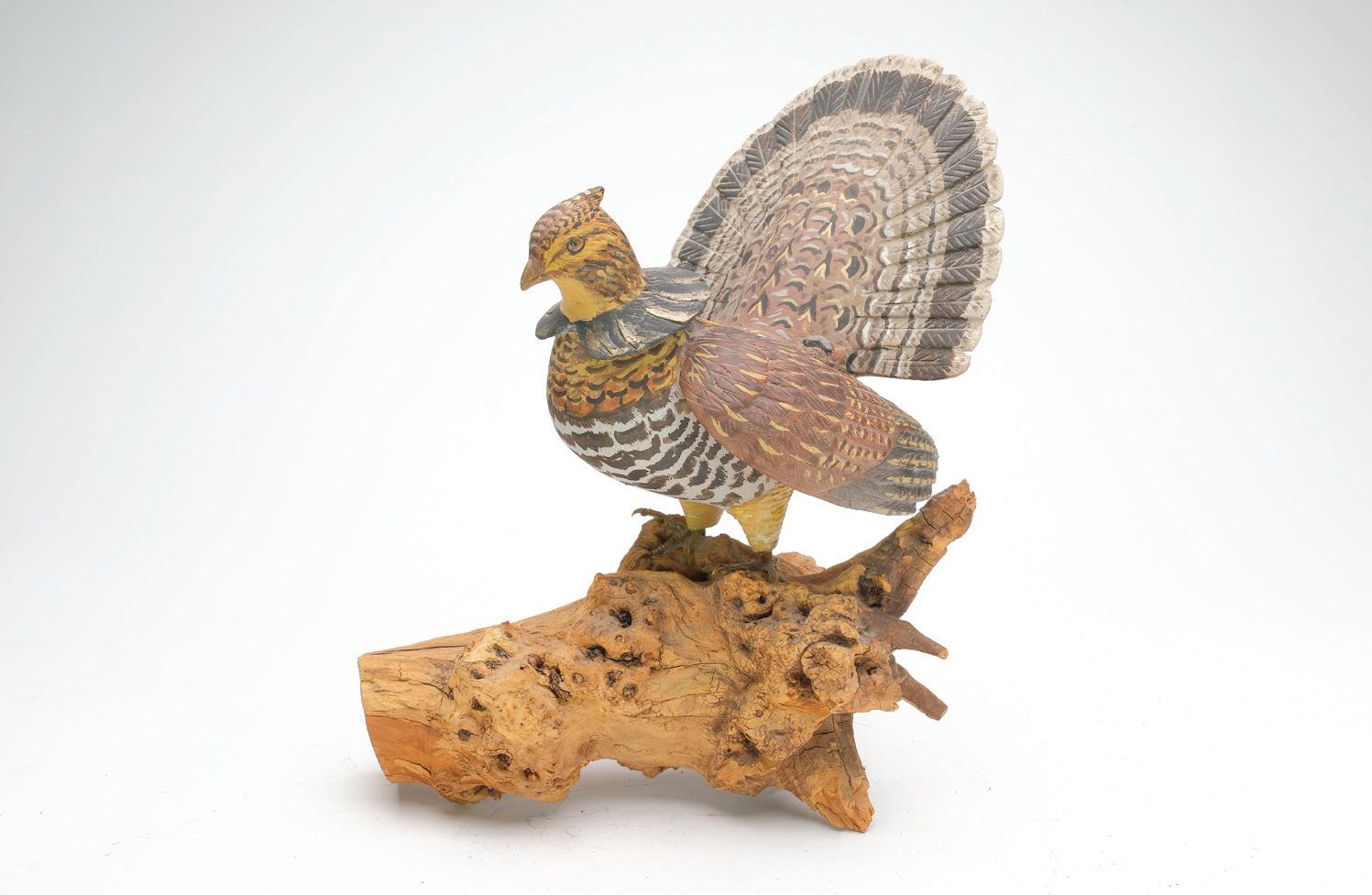
(400 - 600)
434 Pair of 1/3 size pheasant, Carl Malstrom, Long Cove, Maine. Rooster with relief wing carving, hen with outstretched wings. Identified on underside of base as being carved while Malstrom was in Ft. Lauderdale, Florida. Hen measures 11.5” long, rooster measures 13.5”. Chip in the tip of hen’s tail, otherwise very good.
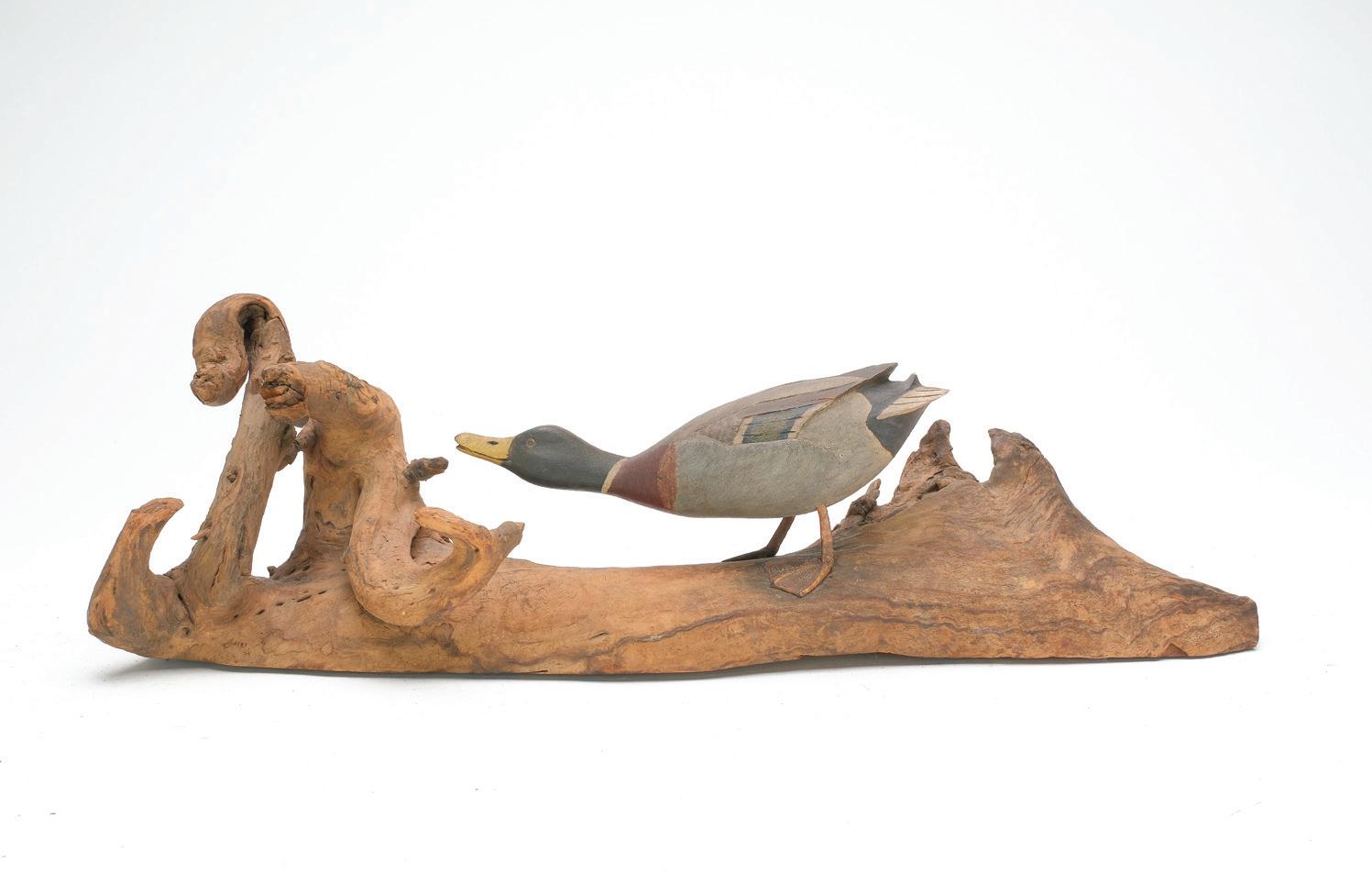

(400 - 600)
435 Miniature mallard, Carl Malstrom, Long Cove, Maine. An earlier example in reaching pose with bill slightly open. Relief wing and tail feather carving. Signed and titled “Mallard Going to Bug” on the underside of base. Mallard measures 6.75” long, wood base measures 16” long. Small amount of flaking on lower leg with touchup; otherwise very good and original.
(400 - 600)
287
433 434 435
Harry V. Shourds 1861 - 1920 | Tuckerton, New Jersey


288
435A Robin snipe in spring plumage, Harry V. Shourds, Tuckerton, New Jersey, last quarter 19th century. With wide, round body. Measures 9” long. Original paint with very minor discoloration and wear; small amount of touchup on the top of the bill.
Literature: “Classic New Jersey Decoys,” James Doherty, Jr. (9,500 - 12,500)
435B Hudsonian curlew, Captain Jess Hepron, Cape May County, New Jersey, circa 1900. Applied wings and painted eyes. Some researchers now believe the name may have been Herron, and not Hepron. Measures 15” long. Original paint with very minor wear; small amount of rust stains above small nails holding applied wing; tiny chip at stick hole, otherwise excellent structurally.
Provenance: Purchased directly from Isabelle Hillman, August 1, 2006 from her home in Seagirt, New Jersey.
(3,000 - 5,000)
435C Curlew, from New Jersey, last quarter 19th century. “DH” carved in the underside. Measures 14.5” long. Original paint that has darkened with age; minor gunning wear with dents and shot marks; minor roughness on edge of tail; many small drops of varnish on back and one side; small amount of touchup to paint rubs on one side of neck.
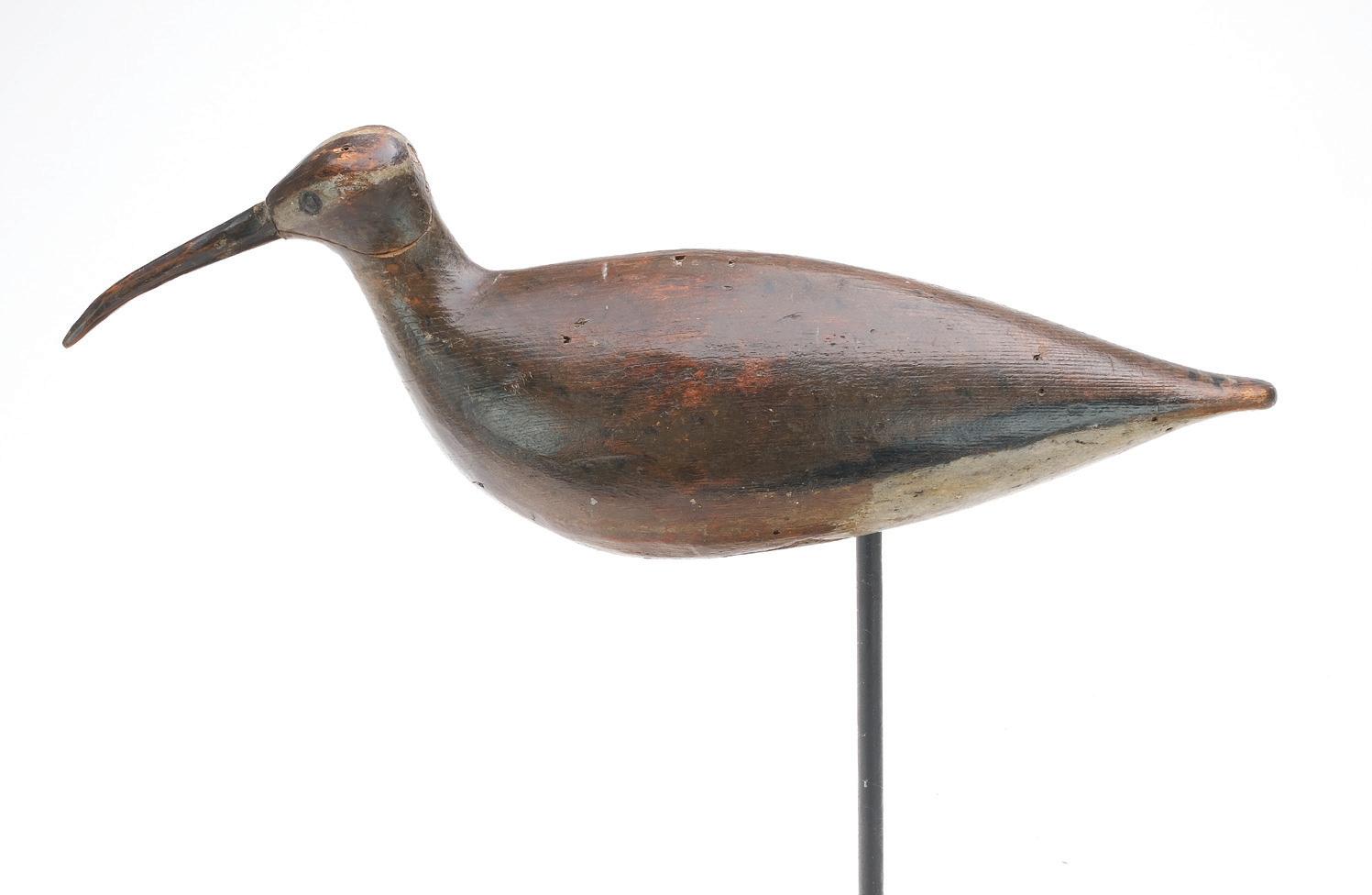


(800 - 1,200)
435D Curlew, Harry Boice, Absecon, New Jersey, circa 1900. Bill is splined through back of head. Carved eyes. 15” long. Original paint on body; white and black areas have been strengthened; crack in head is all the way through with additional crack in top of head; several shot scars mostly on one side of body and head.
(800 - 1,000)
289
435b
435c
435d
435E A set of three curlews, attributed to Ezra Hankins, Point Pleasant, New Jersey, last quarter 19th century. One retains Hillman collection stamp, has a slightly turned head. All three have painted eyes and bills splined through back of head. 17” long. Thin original paint; one has had the tip of the bill reset and one with a neck crack repair; very light gunning wear; Hillman bird and one other have a small hole in one side of body. (6,000 - 8,000)

435F Rare robin snipe in fall plumage Harry V. Shourds, Tuckerton, New Jersey, last quarter 19th century. Measures 9” long. Original paint with very minor wear; a few tiny dents.

Literature: “Classic New Jersey Decoys,” James Doherty, Jr. (9,000 - 12,000)

290
435e
435f
Ezra Hankins
435G Yellowlegs, Taylor Johnson, Point Pleasant, New Jersey, last quarter 19th century. Markings on underside indicate decoy was at one time in Gary Giberson’s collection. Mort Hanson collection stamp on underside as well. Measures 11.25” long. Original paint with minor discoloration and wear.
Provenance: Mort Hanson collection. Gary Giberson collection. Private Texas collection. (5,000 - 8,000)
436 Tiny sanderling from New Jersey, last quarter 19th century. Plump little shorebird with painted eyes. Measures just under 6” long. Mix of original paint with areas of paint restoration to flaking along sides and underside; lightly hit by shot; chip in bottom half of bill.
(600 - 900)
437 Black bellied plover, Bill Harris, Brigantine, New Jersey, circa 1900. Known as “Brigantine Bullheads”. Measures 12.5” long. Original paint with minor flaking and wear; old chip in tip of tail; separation at a knot in back.
(1,200 - 1,800)
438 Black bellied plover, from New Jersey, last quarter 19th century. Deep relief wing carving and tack eyes. “D.H.” carved on the underside. Multiple stick holes for different positions. Measures 9.75” long. Original paint with moderate flaking and wear; surface has darkened with age; lightly hit by shot; small amount of touchup around one eye. (800 - 1,200)




291
435g 437
436 438
439 Oversize eider, Charles F. Jacobs, Grand Manan Island, New Brunswick, 1st quarter 20th century. Angular body with long, raised neck seat and brass tack eyes. branded “CF Jacobs” on the underside. Measures 20.5” long. Original paint with moderate flaking and wear under an early coat of varnish; small knot missing on one lower edge; tight crack and minor separation at neck seat with small amount of glue visible.


Provenance: David Fannon collection. (3,000 - 4,000)
440 Excellent bluebill hen, Orel Leboeuf, St. Anicet, Quebec, circa 1930. Mackey stamp on underside. With Leboeuf’s highest grade carving on the back. 14.5” long. Excellent original paint with one small nick in side of body. (2,000 - 3,000)
292
439 440
441 Stick up brant and black duck from Prince Edward Island, Canada, 1st – 2nd quarter 20th century. Both standing on inserted iron legs. One with inlayed neck seat and reared back head. Measure 11.5” and 13” long. Smaller one with original paint and minor wear, head is slightly loose; the other in a mix of original and early in use repaint with moderate flaking and wear; small dents and tight drying cracks; split along one lower side; tight crack through neck.

Provenance: George Quay collection. (1,000 - 1,500)
442 Pair of stickup goose decoys, from New Brunswick, 1st quarter 20th century. Primitive carving with burn and scrape color technique typical of the region. Two iron stakes inserted on the underside of each. Measure 21” and 17” long. Stand 30 and 26” tall including base. Original surface with moderate to significant wear; white paint on head and upper neck has flaked mostly to bare wood; tight cracks at small nails in neck seat; drying split in the underside of one.


Provenance: George Quay collection. (3,000 - 5,000)
443 Working loon decoy, from Nova Scotia, 2nd quarter 20th century. Painted eyes with erect head. 19” long. Original paint; bill is probably an early working replacement; moderate in use wear with dents and paint exposed bare wood on back; discoloration to white paint on breast. (1,000 - 1,500)
293
441
442
443
(1,000


294
445 Blackduck, William Hart, Belleville, Ontario, 1st quarter 20th centuy. In a swimming position with head tilted forward. Hollow with bottom board. Comb painting on back with upswept tail. 15.5” long. Strong original paint with very light gunning wear; a dent in the back; rough area at tail. (2,000 - 3,000)
444 Redhead drake, Thomas Chambers, Toronto, Ontario, circa 1900. Branded “AH Buhl” on underside. Also a business card states purchased from Barney Crandall 4/87. 16” long. Strong original paint; wood imperfection was spliced and repaired at time of making; a few shot scars on one side of body.
444 445
- 1,500)
446
merganser drake, unknown maker, upstate New York, probably 2nd quarter 20th century. Head is similar to the work of Billy Ellis. Fanned crest and detailed bill carving. Removable head. 14” long. Original paint with white area around breast appears to be strengthened; imperfection to wood where putty has flaked on one side of body.



(1,000 - 1,500)
447
1st quarter 20th century. Extended paddle tail with inlet weights. Red glass eyes and extended crest on head. Measures 9” long. Mix of original and in use repaint with just a little bit of edge wear and small wood loss near neck seat.
(1,500 - 2,000)
20th
Maker” on underside. Solid body with feather paint detail throughout entire body. 17.5” long. Original paint; crack in the bill is present and is also in the area of an early bill restoration.
(500 - 800)
295
Stylish hooded
Bufflehead drake from upstate New York or Ontario, Canada,
448 Black duck, John Ralph Wells, Toronto, Ontario, 1st quarter
century. Branded “JRW
446 447 448
449 Black duck, David Wilson Mattis, 1st quarter 20th century. “J.M.” carved in underside with a weight that has initials “RW”. Solid body, but with a concave underside which is exhibited in “The County Decoys,” by Jim Stewart. Fine scratch painting over body and head. Measures 19” long. Light in use wear with some rubs to bare wood and a couple of shot marks. (2,000 - 2,500)



450 Bluebill hen, Adam Brown, Gananoque, Ontario, 1st quarter 20th century. Tucked head with painted eye. 12” long. Edge wear around tail and bill; couple of small rubs on body.
Literature: “Decoys of the Thousand Islands,” Jim Stewart, exact decoy p. 82. (1,500 - 2,500)
451 Black duck, Tobin Meldrum, Fair Haven, Michigan, circa 1900. Hollow body with bottom board. “A” is carved under the bill, as Meldrum did on many of his own decoys. 17.5” long. Working repaint by Meldrum.
Literature: “St Clair to St Lawrence,” Barney Crandall, exact decoy pictured p. 30. (1,200 - 1,800)
296
449 450 451
paint with moderate crazing and wear; minor separation to a long wooden patch in back from when the decoy was made; red on head is an early second coat of paint; professional neck crack repair with touchup.
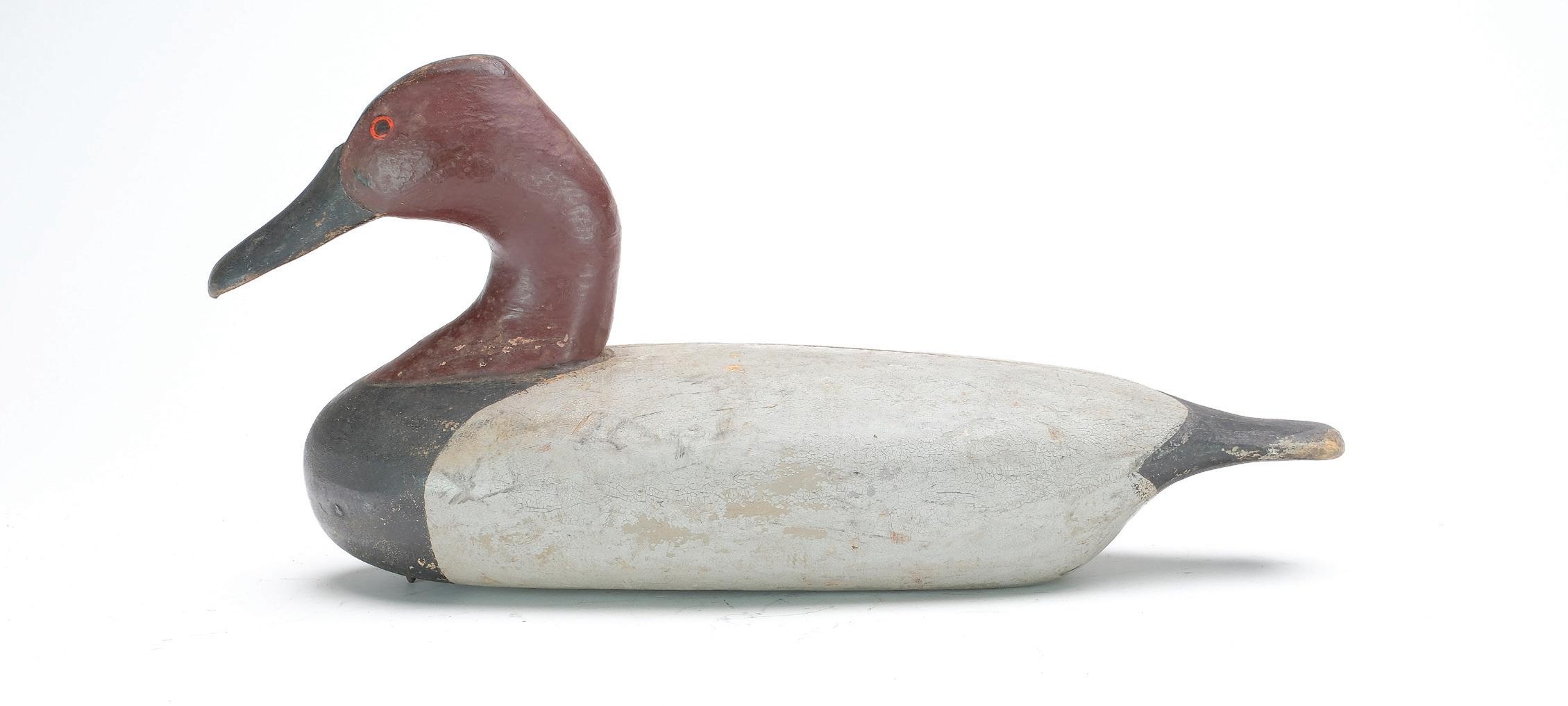

297
452 Pair of mallards, George Frederick Jr., Davant, Louisiana, 2nd quarter 20th century. Both have glass eyes. 16” long. Original paint; drake has had approx 1/2 of bill replaced; hen has had professional restoration to shot scars in body. (8,000 - 10,000)
453 Canvasback, Mark Whipple, Bourg, Louisiana, 2nd quarter 20th century. Measures 15.5” long. Original
(3,000 - 4,000)
452
453
454 Coot, Mark Whipple, Bourg, Louisiana, 2nd quarter 20th century. Measures 9” long. Original paint with minor gunning wear under a thin coat of varnish; separation at knots or wood patches in breast and under tail; hairline crack in bill. (4,000 - 6,000)

455 Rare pair of bluewing teal, George Frederick Jr., Davant, Louisiana, 2nd quarter 20th century. Relief wing carving and slightly turned heads. Measure 11.25” long. Original paint with minor wear; small dents; otherwise very good structurally. (4,000 - 6,000)

298
454 455
456
Louisiana, 2nd quarter 20th century. Measure 15.75” and 14.75” long. Original paint with minor wear on hen and moderate wear on drake; early coat of varnish has yellowed slightly on drake; hen is missing one eye; drake is missing both eyes; drying crack in drake’s breast; seam in drake’s neck where head was off and reset.
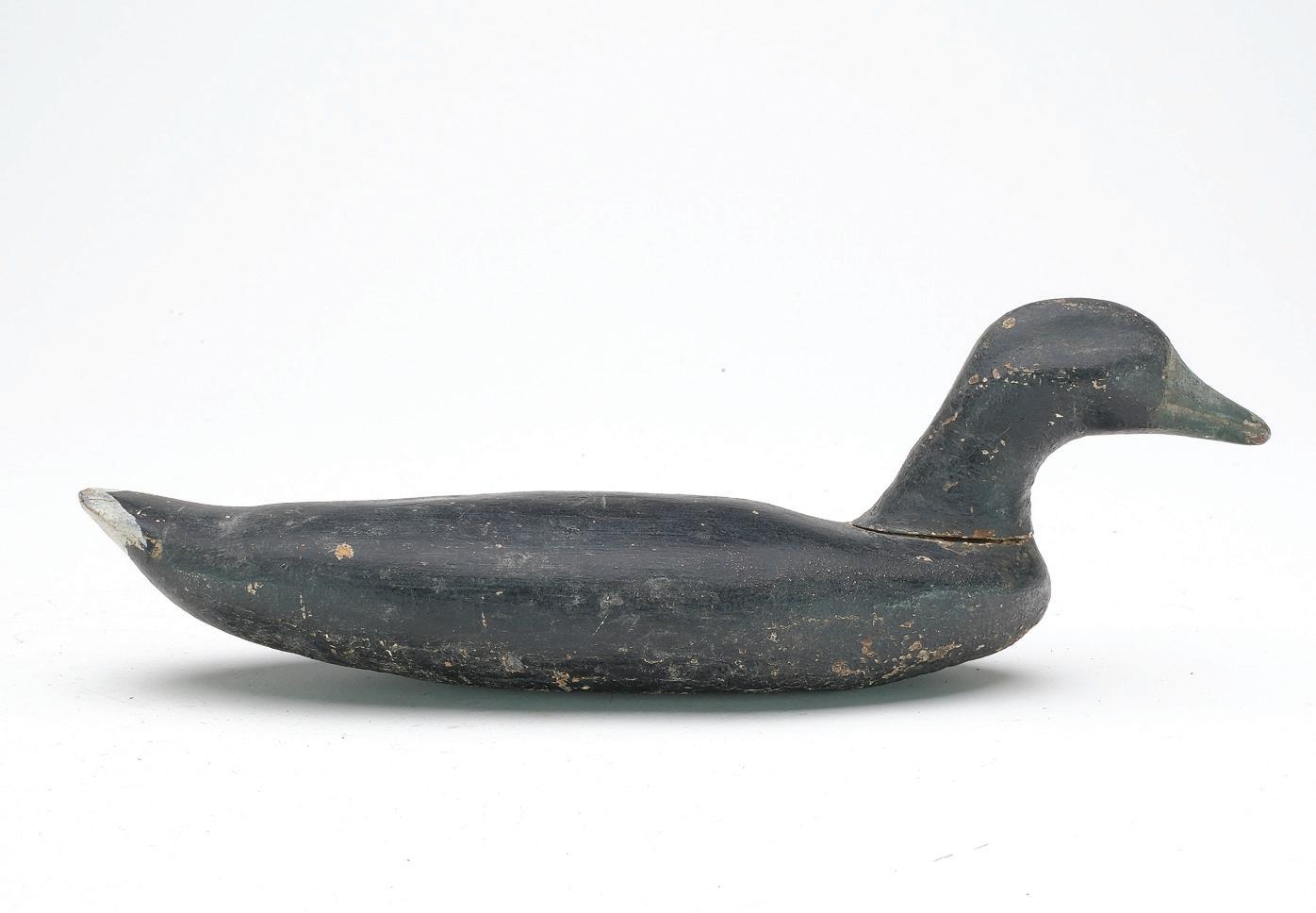


(1,500 - 2,500)
strengthening to the blue wing patches.
(1,200 - 1,800)
456
(2,000 - 3,000)
299
Mallard hen and drake, John Dufresne, Des Allemands,
457 Bluewing teal hen, Rudy Lecompte, Bourg, Louisiana, 2nd quarter 20th century. Measures 10” long. Original paint with moderate flaking and wear;
458 Early coot, attributed to Ernst Vidocovich, Avondale, Louisiana, 2nd quarter 20th century. Swimming position with upswept tail. Measures 11.5”. Original paint with light gunning wear.
457 458
459 Ringneck, Mitchell LaFrance, New Orleans, Louisiana, 2nd quarter 20th century. Relief wing carving. Measures 11.5” long. Original paint with moderate wear; minor roughness on edge of tail and along one lower side; hairline cracks in underside; small dents in back. (3,000 - 5,000)
460 Bluebill, Reme Roussell, Raceland, Louisiana, 2nd quarter 20th century. Raised wingtip carving. Measures 11.25” long. Original paint with minor to moderate gunning wear; very good structurally. (2,000 - 3,000)
461 Mallard hen, A. Tex Aguzin, New Orleans, Louisiana. Relief wingtip carving and upswept tail. Paper label from Sports Art Gallery on underside. Measures 15.25” long. Original paint with moderate crazing and minor wear; paint has darkened with age; small dents in back and one side; cracks and chipping in each glass eyes; old chipping to wood around one eye with touchup. (1,200 - 1,800)
462 Mallard hen, Mark Whipple, Bourg, Louisiana, 2nd quarter 20th century. Fine feather painting on back of decoy. 15” long. Original paint that has crazed, mostly around head and bill; light gunning wear with a few small dents. (4,000 - 6,000)


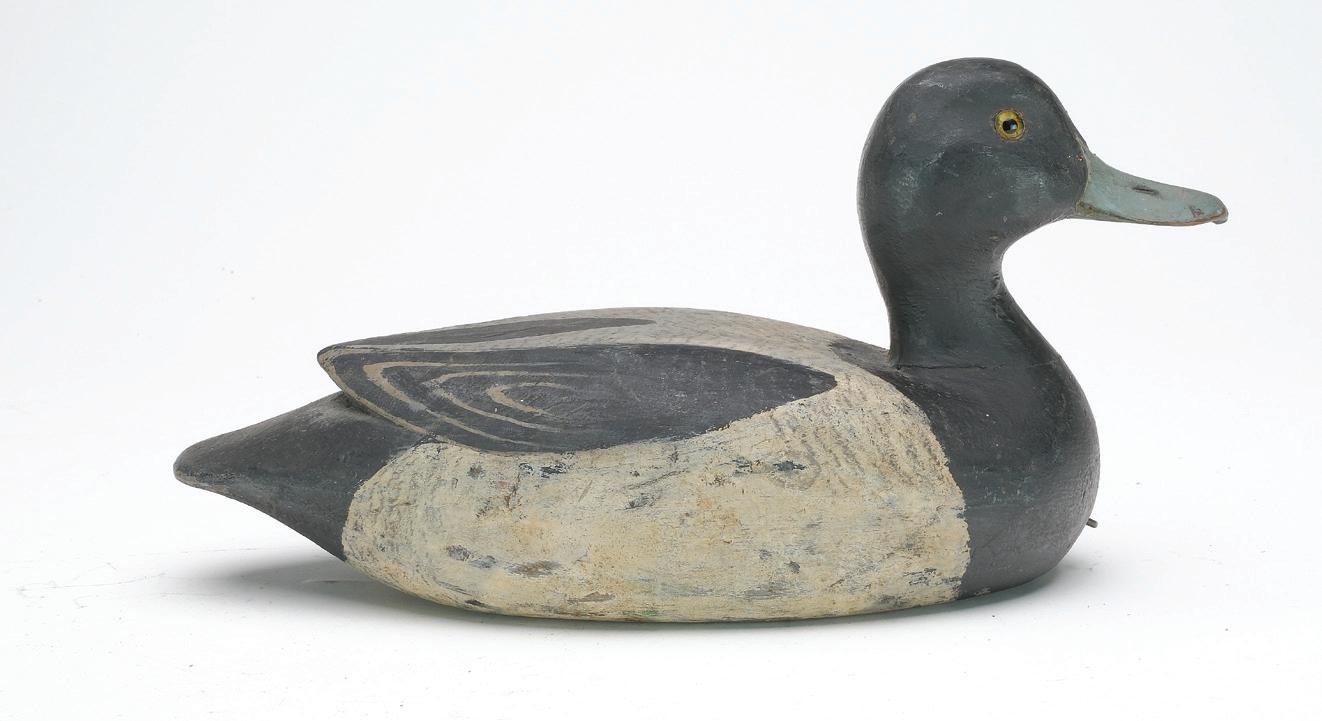

300
459 461 460 462
463 Bluewing teal drake, Mark Whipple, Bourg, Louisiana. Paint has been restored in the Whipple style; crack in neck has been reset. (500 - 800)
464 Mallard drake in the style of Nicole Vidocavich. Possibly made by Bill Hanneman. Head is turned. Glass eyes. Measures 15.5” long. Paint that has been aged to create the appearance of age.
(1,000 - 1,500)
465 Mallard hen, Arthur John Dugar, Buras, Louisiana, 1st quarter 20th century. Relief wing carving. Measures 16.25” long. Original paint on head, neck, and back; shows moderate crazing and minor flaking; paint restoration on lower half of decoy; structurally good.

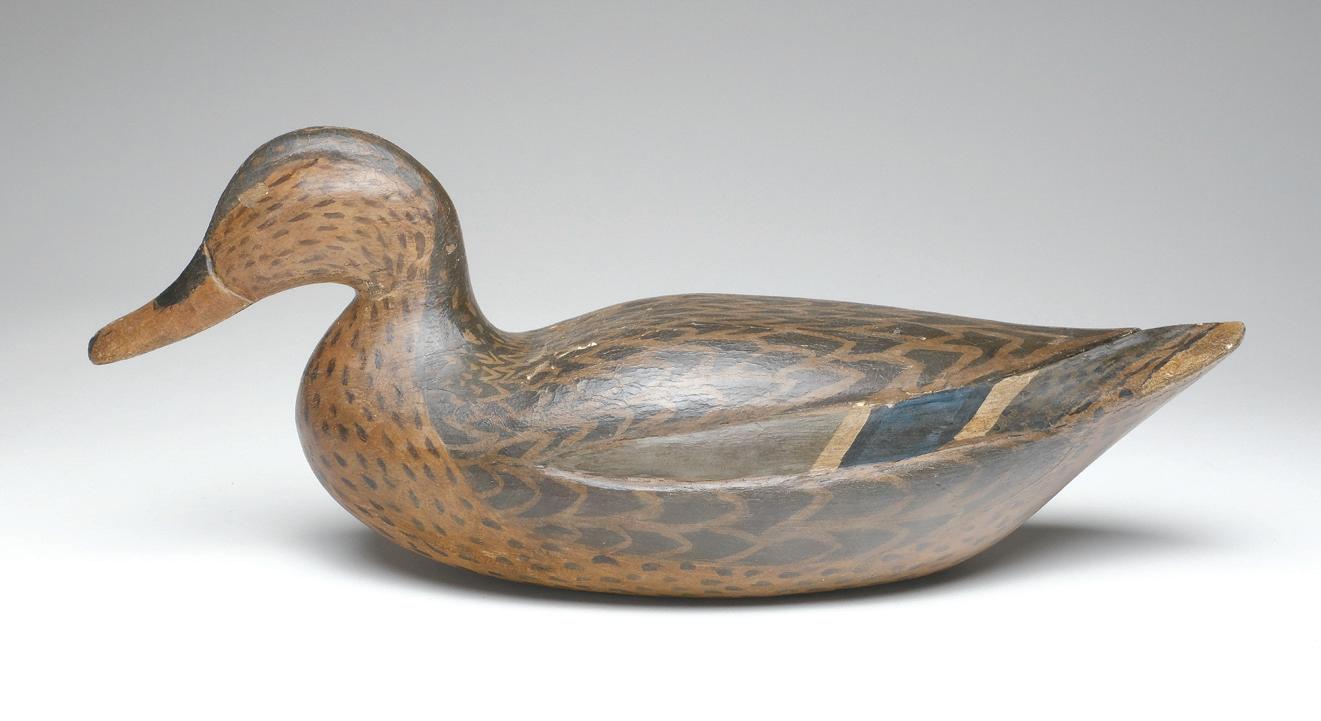


(2,500 - 3,500)
466 Mallard, Mark Whipple, Bourg, Louisiana, 2nd quarter 20th century. Decoy was never rigged or weighted. Jimmie Hanneman, NOLA brand on the underside. Measures 16” long. Original paint with minor flaking and wear; many shallow dents.
(2,000 - 3,000)
301
463 465 464 466
467 William Goadby Lawrence, oil on canvas. Measures 30” x 41.5”. Signed lower right. Slight yellowing and crazing evenly distributed throughout painting; structurally good.
(3,000 - 4,000)
468 Lem Ward (1896-1984), oil on canvas. Image measures 19.25” x 25.25”. A setter on point in a marshy landscape, titled “Mack”. Signed and dated lower right. Scattered flaking in upper part of sky; minor yellowing to varnish; scattered inpainting to flaking throughout.
(1,500 - 2,500)
469 William Koelpin (1938-1996), watercolor on artist board. Image measures 13” x 10”. Signed under image. Full sheet measures 18” x 15”. Unframed, but remains very good and original; a few small discoloration spots but not in image. (300 – 500)
470 Lou Frisino (1934 - 2020), watercolor. Image measures 14” x 18”. Signed lower right. Redheads landing. Old, probably original frame. Image appears to be excellent.


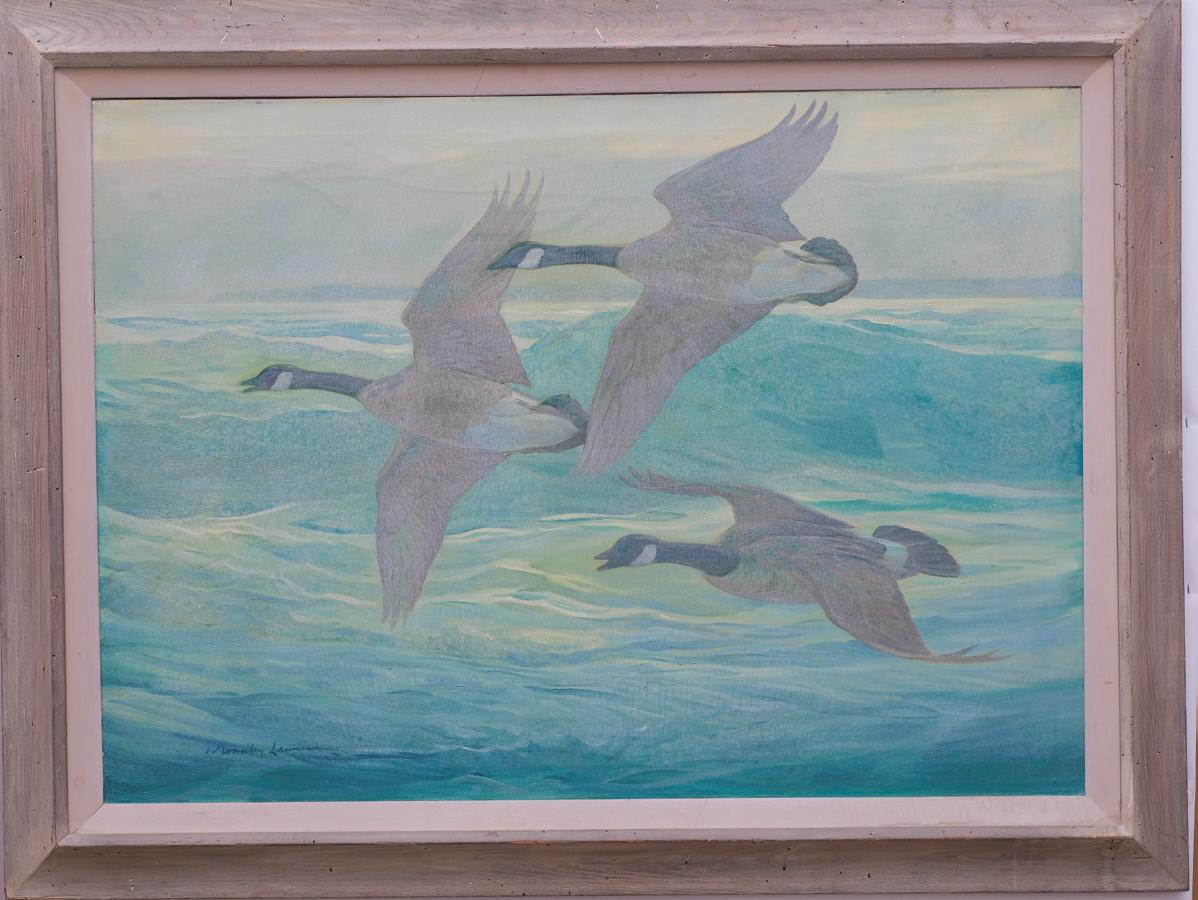
Provenance: David Fannon collection. (300 - 500)

302 467
468 470 469
471 Daniel
472
(b.1954), oil
canvas. Image measures 14” x 19”. Signed lower right. Professionally framed and matted. Excellent and original. (600 - 900)



(1862-1951), Dry point etching. Image measures 7” x 12”. Signed lower left. Professionally framed and matted. Very good and original. (400 – 600)

473
7”. Signed lower center. Professionally framed and matted, frame measures 18” x 16”. Excellent and original. (300 - 500)
474 Jack
Image measures 16” x 24”. Signed lower right. Probably original frame. Behind plexiglass. Staining to matting, but image is good. (400 - 600)
(1915-1998), tempura on
303
471 473
472
474
Loge
on
Frank Benson
Jim Tungeon, watercolor. Image measures 9” x
Dumas
paper.
Anton (Tony) Stetzko
A 1972 graduate of the DuCret School of Art, Tony an avid fisherman and Salt Water Fly Fishing Guide (holds the World’s Record for catching the largest Striped Bass, 73 pounds from the surf) paints to capture the peace and serenity of the woods, water, sand and surf.
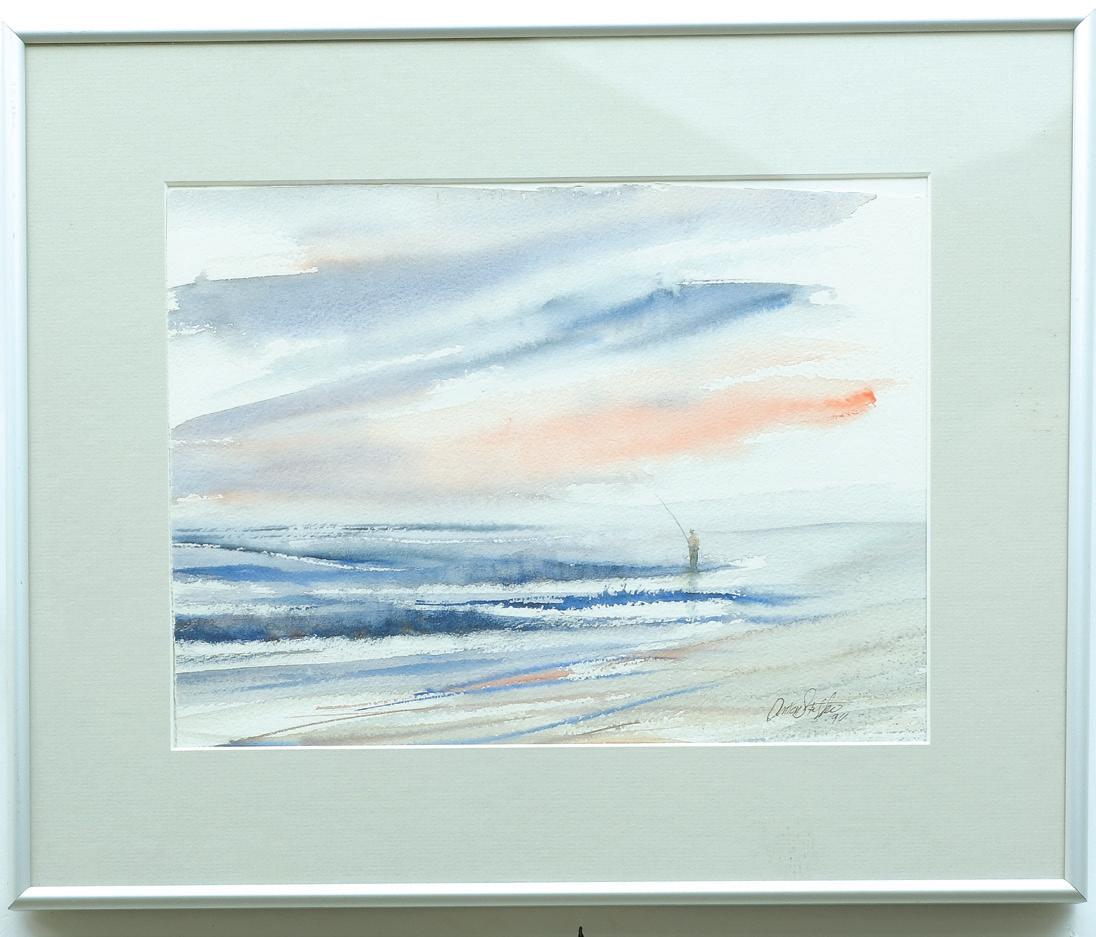


His watercolors were chosen by Margot Page for the cover and inside illustrations of her new book “LITTLE RIVERS” Tales of a Woman Angler, published by Lyons & Burford.
His paintings were shown in a one man show at The American Museum of Fly Fishing, and have been well received at the many benefit auctions of the Museum and the Miramichi Salmon Association. One of his paintings was chosen to become the cover of the Orleans Vacation Guide, and he just completed the cover for the November issue of FISHERIES magazine.
475 Anton Stetzko (1950 - 2015), group of four watercolor on paper. All four are fishing scenes. Largest measures 10” x 14”. Then 10” x 12”, 5” x 6.75”, and 4.75” x 6.5”. Three smaller images are signed lower right. Excellent. (400 – 600)

304 475
(200 – 400)
477


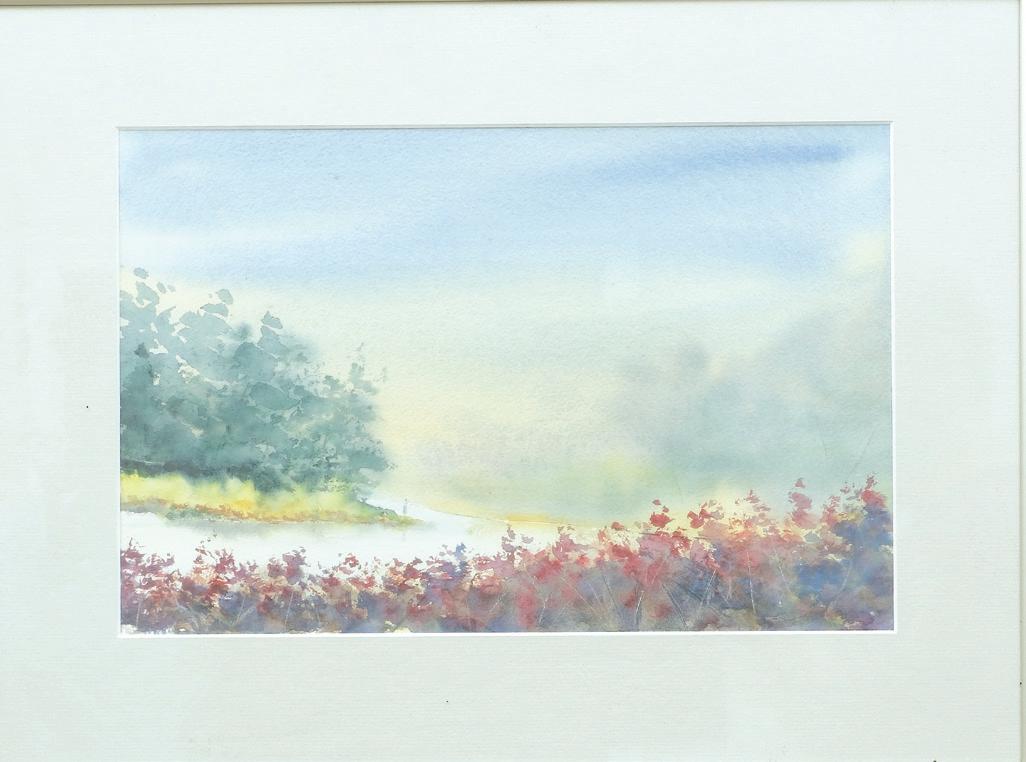

(300 – 500)

305
476
End of session two
476 Anton Stetzko (1950 - 2015), two watercolor on paper. Both are landscapes with fisherman. Largest measures 10” x 14.5”, smallest is 6.25” 9.5” both are professionally framed and matted. Excellent.
477 Anton Stetzko (1950 - 2015), group of three watercolors. Two fishing scenes and one landscape of a river. Both smaller images are signed. Largest measures 9.5 x 14.5”, then 5.5” x 7”, and 4.5” x 6.75”. All three in excellent condition.
Index of Carvers
Adams, Frank 208,233 Algard, Wallie 417 Archer, Sam 92 Audubon, John James ....................................................... 359,360 Augusim, Tex 461 Austin, John 196 Aydlett, Albin 193,195 Bach, Ferdinand 260 Barber, Joel ......................................................... 297-298A,300,302 Barnard, Charles Nelson 58,59,63,73 Barnes, Sam ................................................................................. 79 Bart, Larry 383 Benson, Frank 353,472 Bergman, Charles 397 Birch, Reggie 26-29 Black, Charles .............................................................................. 99 Blair, Jr., John 98 Boice, Harry 435D Bolles, Reginald 327 Bowman, William 292,294 Boyd, George ........................................................201,224-227,428 Bragg, Gary 190 Brown, Adam ............................................................................. 450 Browne, George 321 Brunet, Jett 366B Brunet, Jude 366C Brunet, Tan 366A Buchner, Frank .................................................................... 261,262 Burgess, Ned 182 Burgess, Ned 183 Burke, Dr. Edgar 333 Burr, Elisha 221 Cargile, Lloyd ...................................................................... 340-343 Chadwick, Keyes 202,204 Chambers, Thomas 444 Clark, Charles 56,426 Cobb, Albert 47 Cobb Family ............................................................................ 421 Cobb, Jr., Nathan 46,419,420 Coffin Family ............................................................................ 231 Collins, Sam 214 Collins, Roy 215 Coombs, Frank 399 Cootes, Joe 382 Crowell, Elmer ..................................................................... 100-120 Currier & Ives, 356 Davis, Henry 408 DeFresne, John 456 Dittman, A.J. 432 Dodge Decoy Factory ..................................................... 280-282 Doughty family 41 Dudley, Lee ................................................................................ 184 Dugar, John 465 Dumas, Jack 474 Dye, Ben 68,71,72 Dye, Joe ....................................................................................... 77 Eigenberger, Gary 378 Elliott, R.J.C. 386 English, Dan 93 English, John 91,96 Farlow and Company ........................................................... 233J Fessel, Bill 233R Finney, Frank ....................................................................... 119-136 Foote, Jim 362 Frederick, George 452 Frisino, Louis 334 Frisino, Lou 470 Frost, Arthur Burdett ..................................................... 328,348,349 Fuller, Arthur 351 Gallop Brothers 192 Gardner, Alfred 211 Garvey, Townsend 295 Gaskill, Walter ............................................................................ 373 Gibian, William 21-25 Godin, Pat ................................................................ 361B,366D,375 Goodspeed, David 232 Graham, John 70,79A,413,415 Graham, Horace 169 Graves, Bert 284-287,290 Gunderson, Ole ......................................................................... 263 Hamby, Michael 387C Hancock, Miles 33-36 Hankins, Ezra 435E Hanson, Marty 140,141,146 Harris, Bill .................................................................................... 437 Harris Manufacturing Company, 235 Heinemann, Ben 367-369 Heisler, Jess 94 Hepron, Jess 435B Heverin, William ...................................................................... 74-76 Hintermeister, John Henry “Hy” 322 Holly, John “Daddy” ..................................................... 67,78,80,81 Holly, James 60,62,69,166-168,410,411,414 Hollywood, William M. 335 Holmes, Lothrop 221A Horn, Thomas 380,381 Horner, Nathan Rowley ............................................................... 83 Howell, Leroy 233G,233H Howes, Jerome 345-347 Howlett, Dick 82,412 Hudson, Ira 43-45,52-54,424,425 Huey, George ............................................................................ 198 Hunt, Lynn Bogue 318,320,337 Hurlburt, James G. ..................................................................... 219
Irvine, Lawrence 233O-233Q Jackson, Harry 387A,387B Jacobs, Charles 439 Jannsen, R.G. ............................................................................. 210 Jester, Doug 30-32,37 Jester, Charles 42 Johnson, Taylor 435G Joiner, Charlie 170,171,175,175,409 Jones, Jon .................................................................................. 385 Jones, Burl 392,395 Kellum, Frank .............................................................................. 312 King, Joseph 95 King, A.J. 427 Koelpin, William 469 Kruth, George 366E,366F LaFrance, Mitchell .............................................................. 455,459 Laing, Albert 313 Lawrence, William Goadby 467 Lawson, Oliver 172,173,361,361A Leboeuf, Orel 440 LeCompte, Lee .......................................................................... 457 Lincoln, Joseph 203 Lockard, Henry .......................................................................... 406 Loge, Daniel 471 Lyon, Harold 387D Madera, Clark 89 Mallcoh, P.D. 233N Malstrom, Carl .................................................................... 433-435 Mason, Roy Martell 332 Mason Decoy Factory 264-279 Mattis, David Wilson 449 McGaw, Robert 66,162-165 McIntosh, Leo ..................................................................... 370,372 McNair, Mark 10-20 Meldrum, Coven 451 Middlestadt, Julius 398 Mitchell, Madison 158-161 Monahan, Hugh .................................................................. 329-331 Moreland, Robert 142-144 Morse, Robert ............................................................................ 185 Mueller, Keith 374 Nottingham, Luther Lee 49 Osthaus, Edmund Henry 319 Parker, Lloyd 84 Perdew, Charles .................................................... 283,288,289,291 Peterson, Oscar 233A-233D Phillips, Ike 38 Powell, Kevin 396 Prud’homme, Gilles 376,377 Pryor, Leonard ........................................................................... 407 Ptashnik, Robert 384 Rathmell, Lou ............................................................................. 212 Reinbold, William 431 Richardson, A 394 Ripley, Aiden Lassell 323 Robb, Samuel ................................................................. 239A,239B Robinson, William 233S Rochester Iron Works 237 Rosseau, Percival 358 Roussell, Reme 460 Rue, Ron .............................................................................. 176-181 Salmons, Bradford 90 Schick rig ............................................................................... 64,65 Schmiedlin, Jim 252-258 Schroeder, Dennis 363-366 Sharp, John 387 Shourds, Harry V. 85-88,435A,535F Smith, Ralph Crosby .................................................................. 326 Smith, Sam 186 Sterling, Lloyd 402-405 Stetzko, Anton 475-477 Stevens, Ivey 189 Stevens, Harvey .................................................................. 400,401 Stewart, Alan 206 Sutton, Sean ............................................................................... 145 Sword, James Brade 317 Tax, John 233I Tepley, Ron 383A,383B Thomas, Charles 228 Tillet, Avery ................................................................................. 191 Travers, Isiah 416 Tungeon, Jim 473 Verity Family 293,314 Viavant, George 325 Waldron, Charles John .............................................................. 344 Ward, Lem 468 Ward Brothers, 1-9,148-157 Watson, Dave “Umbrella” 39,40,55 Watson, Hy Sumner 324 Weaver, Steve .................................................................... 147,429 Weiler, Milt 352 Wells, John Ralph ....................................................................... 448 Wheeler, Charles E. “Shang” 315 Whipple, Mark 453,454,462,463 Whymper, Charles 357 Wickey, Harry Herman 388-390 Wilcox, Jim ............................................................................... 387E Wildfowler Decoy Factory, 216 William DeMuth & Co, 239C Wilson, Gus 197,199,200 Wozny, Eddie 137-139,430 Wydevelt, Arnoud ...................................................................... 336 Yoder, Gary 379
Additional information references
1.Cheever. Byron. “L.T. Ward & Bro – Wildfowl Counterfeiters”. North American Decoys Pub. Heber City UT.
2.Connett, Eugene V (ed). 1947. “Duck Shooting Along the Atlantic Tidewater”. William Morrow and Co. New York, NY.
3.Gard, Ronald J and B. J. McGrath. 1989. “The Ward Brothers – A Collectors Guide”. Hennington Publishing Co. Wolfe City, TX.
4. 2007. “Timeless Treasures: Ward Brothers Decoys”. Privately printed. Ward Museum of Wildfowl Art. Salisbury, MD.
Lot 6a
1.Colio, Quintina. 1972. “American Decoys”. Privately printed Quintina Colio
2.Dunlap, David W. 2012. “When Trade Shows Were Both Grand and Central”. New York Times Dec 18. New York, NY
Lot 47
Lot 58
1.Newberry, Dr S Lloyd. “Wings of Wonder – The Remarkable Story of the Cobb Family and the Priceless Decoys They Created on Their Island Paradise”. Sporting Classics Pub. Columbia, SC.
1.Sullivan, C John. 2003. “Waterfowling on the Chesapeake, 1819 – 1936”. The John Hopkins University Press. Baltimore, MD.
2. 1965. “Joel B Pusey (Obituary)”. The Evening Sun, Sept 6. Baltimore, MD.
3.Personal correspondence C. John Sullivan
Lot 60
Lot 62
Lot 64
Lot 83
1.Sullivan, C John. 1992. “The Holly’s of Havre de Grace – Innovators of the Harford County Style”. Decoy Magazine Jan./Feb. Burtonsville, MD.
2.Tragakis, Chad. 2020. ”Percussion Caps – Jim Holly and the Bayside Cornet Band”. Decoy Magazine, Sept./Oct. Lewes, DE.
1.Tragakis, Chad. 2015. “Chesapeake On the Delaware”. Decoy Magazine, Nov/Dec. Lewes, DE
1.Personal correspondence, Kevin Peel and Chad Tragakis
1.Burke, Patricia H. 1985. “Barnegat Bay Decoys and Gunning Clubs”. Privately printed Ocean County Historical Society. Toms River NJ.
2.Doherty, James R. 2011. “Classic New Jersey Decoys” privately printed James R Doherty, Philadelphia, PA.
3.Fleckenstein, Henry A Jr. 1983. “New Jersey Decoys”. Schiffer Publishing LTD. Exton, PA.
4.Linkchorst, Allen. 1999. “Nathan Rowley Horner – Refining the Tuckerton School of Carving”. Decoy Magazine, July/August. Lewes, DE.
Lot 84
1.Doherty, James R. 2011. “Classic New Jersey Decoys” (including interview with Chris Sprague). Privately printed. James Doherty, Philadelphia, PA.
2.Fleckenstein, Henry A. 1983. “New Jersey Decoys”. Schiffer Publishing. Exton, PA.
3.Gosner, Kenneth L. 1985. “Working Decoys of the Jersey Coast and Delaware Valley”. Art Alliance Press, NY and Cornwall Books, London.
4.Harrell, Loy S. 2000. “Decoys – North America’s One Hundred Greatest”. Krause Publications. Iola WI.
5.Mackey, William J Jr. 1965. “American Bird Decoys”. Bonanza Books, NY.
6.Personal correspondence Mr. Russ Alen
Lot 91

1.Fleckenstein, Henry A. 1983. “New Jersey Decoys”. Schiffer Publishing Ltd. Exton, P.
2.Gosner, Kenneth L. 1985. “Working Decoys of the Jersey Coast and Delaware Valley”. Art Alliance Press, NY.
3.Huster, Harrison and D Knight. “Floating Sculpture – The Decoys of the Delaware River”. Hillcreast Pub. Spanish Fork, UT.
4.Linkchorst, Allen.2000. “John English – The Innovator of the Delaware River Style”. Decoy Magazine, March/April. Lewes, DE.
Lot 105a
1.1960. “Dr. Davenport West (obituary)”. Daily News, April 1. New York, NY.
2. 2019. “Summer Decoy Auction” Privately printed. Decoys Unlimited. Barnstable, MA
Lot 297
1.Kangas, Gene. 2016. “A Letter From Joel”. Decoy Magazine, May/June. Lewes, DE.
2.Kraft, Virginia. 1956. “Joel Barbers Decoys”. Sports Illustrated Magazine, October. Chicago, IL.
3.Parker, Jackson. 1999. “1965: The Turning Point – Dick Bourne and the Birth of an Industry”. Decoy Magazine, Sept/Oct. Lewes, DE.
4.Rogers, Kory W. 2017. “Birds of a Feather: Wildfowl Decoys at Shelburne Museum”. Skira Rizzoli, NY.
5.Smith, Greg. 2019. “Q&A: Kory Rogers”. Antiques and the Arts Weekly. Newtown, CT.
Lot 312
1.Barber, Joel. 1934. “Wildfowl Decoys”. Garden City Publishing. Grden City, NY.
2.Sieger, Timothy et al. 2010. “The Decoys of Long Island”. Privately printed Long Island Decoy Collectors Association. Water Mill, NY.
3.Townsend, E Jane. 1979. “Gunners Paradise”. Privately printed. The Museums at Stonybrook. Stonybrook, NY.
Lot 317
1.Reuter, F. Turner Jr. 2008. “Animal and Sporting Artist in America”. The National Sporting Library. Middleburg, V.
2.Zellman, Michael D. 1987. “Three Hundred Years of American Art”. Wellfleet Press. Seacaucus, NJ.
The
Available To order call Ken Cole at: (810) 845-2434 E-mail: kencole3@aol.com Or write to: Ken Cole 201 W. Rising St Davison, MI 48423 Custom Sizes and Colors Upon Request $30 each plus shipping and handling • Black anodized aluminum construction. • Rubber padded tops & bottoms. Will not mar your furniture or decoys. • 3 post and 4 post styles to choose from. • 1 in to 4 in heights in 1/4 in increments
Best Decoy Stands
1
Lot
Collection Planning Program
While you continue to enjoy collecting today, you can rely on Guyette & Deeter to collaborate with you on your estate planning and collection management needs. Whether it’s for tax purposes, estate planning, gifting, charitable giving, or insurance, we can develop and periodically update a comprehensive written appraisal of your collection. We have extensive experience working closely with banks, attorneys, trustees, estate officers, probate court, private clients and family members responsible for the dispersal of collections as part of larger estat es.
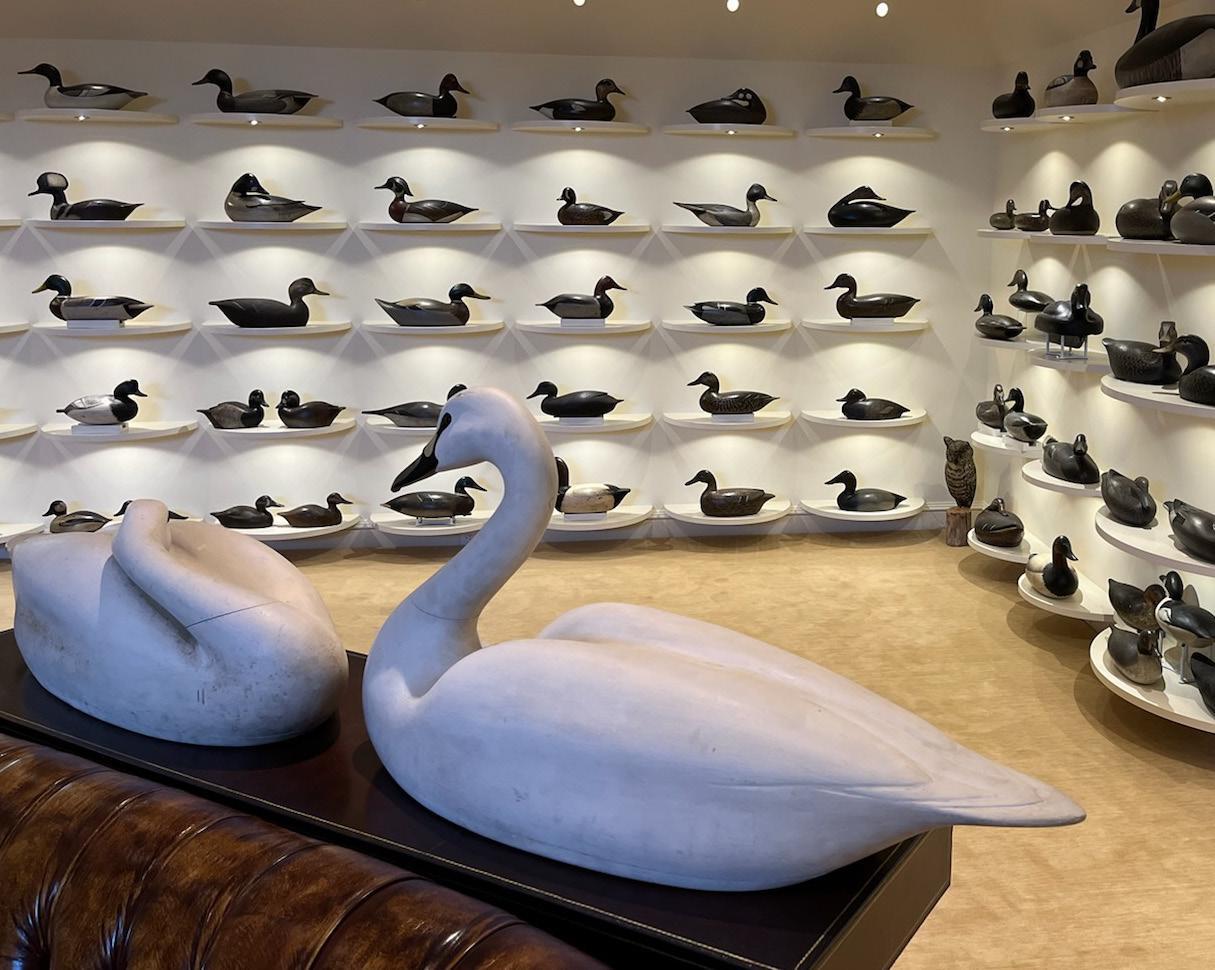
O ur unmatched market understanding allows us to more accurately document the value and description of each item in your collection. We know that working together to ensure that your wishes are established now will make it easier to administer your estate lat er.
Co ntact Jon or Zac to discuss our Legacy Planning Program today.
Jon Deeter | 440-610-1768 jdeeter@guyetteanddeeter.com
Cote | 207-321-8091
zcote@guyetteanddeeter.com
Zac
Collect Today, Plan for Tomorrow





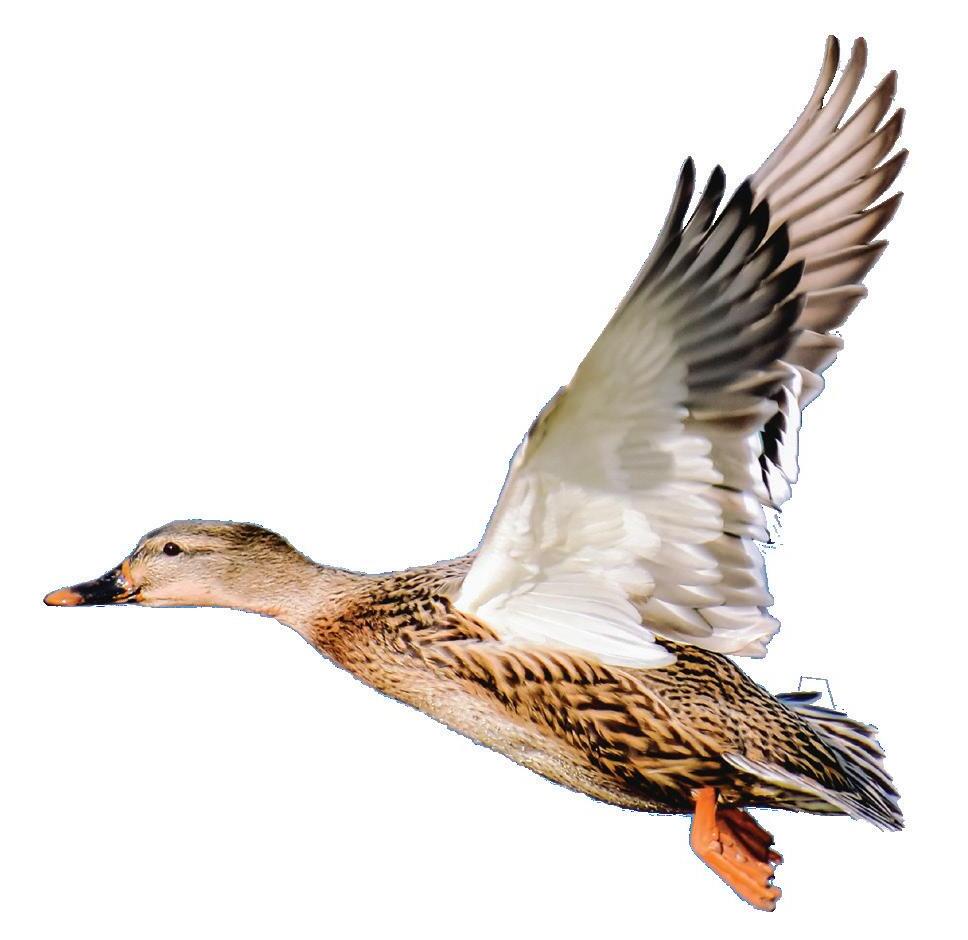
One of the best places to buy decoys, wildlife art, and carvings. See the latest in sporting gear. Watch world calling contests and retriever demos. Something for everyone! Tickets, event schedule and MORE at WaterfowlFestival.org! Your visit and art purchases benefit waterfowl and wetland restoration and conservation efforts in the region. THE PLACE TO BE FOR DECOY ARTISTS and COLLECTORS TICKETS $25 FOR ALL THREE DAYS 2023WATERFOWL FESTIVAL NOVEMBER 10–12, 2023
MARYLAND
EASTON,
Art
PREMIERE NIGHT PARTY
THURSDAY | NOVEMBER 9 | 2023
To benefit waterfowl, conservation, and community.
WATERFOWL FESTIVAL ® OPENING CEREMONIES
4 p.m. Tidewater Inn
ART BUYERS’ PREVIEW
5–8:30 p.m. All Downtown Galleries Open

Photography: Eastern Shore Land Conservancy
Sculpture, Carving and Painting: Academy of the Arts, Armory, Avalon, Featured Art Pavilion

Working Artist Forum: Christ Church
DELIGHTFUL BITES, SPIRITS & MUSIC
HORSE DRAWN CARRIAGE RIDES
EXCLUSIVE VIP ART DISCOUNT
VIP HOSPITALITY SUITE at the BULLITT HOUSE
To buy tickets or more about VIP Packages and Benefits, visit WaterfowlFestival.org/PremiereNight or 410.822.4567
Cocktails Cuisine Conservation
VFW - 355 GLEBE ROAD - ORANGE LINE BUS STOP
JOIN THE PARTY AT THE WATERFOWL FESTIVAL'S NEWEST VENUE

BIG TRUCK FARM BREWING

DOG DEMOS BY MASON DIXON GAME OUTF
RAGING BULL RIDING
EASTERN SHORE DELICACIES
AERIAL TARGET ARCHERY

BIRDS OF PREY DEMOS
FISH & WILDLIFE AND DNR

FESTIVAL TICKET REQUIRED



$5 VETERAN DISCOUNT ON FRIDAY

*Menu includes oysters on the half shell, pulled pork, oyster stew, cream of crab soup, chili and sweet potato fries with salted caramel!
WaterfowlFestival.org/VFW
Learn
more at
Plus a free beer on us for Veteran's Day!



SAVE THE DATE 57TH NORTH AMERICAN Vintage Decoy & Sporting Collectibles Show Sponsored by the North American Decoy Collectors Assn. For information go to nadecoycollectors.org or call 586-530-6586 • Room to Room Trading • Ballroom Dealer Event • Guyette & Deeter Auction • Seminars • Displays • Carving Demonstrations • Free Appraisals • And more April 23-27, 2024 The Westin Lombard – LOMBARD, IL –



Proudly presents: THE EASTERN SHORE OF V IRGINIA D ECOY S HOW Saturday February 3, 2024 9:00 a.m. to 4 p.m. Located in the Pearl Events Center 700 Marina Village Circle Cape Charles, Virginia Sponsor Levels Diamond: $1000 Gold: $500 Silver: $250 Good food, drink & decoys! Exhibitor tables are $125 each FREE ADMISSION Come see Legendary Eastern Shore Carver Pete Peterson For More Information Contact Tommy O’Connor at: (757) 620-8520
35th Annual CORE SOUND DECOY FESTIVAL
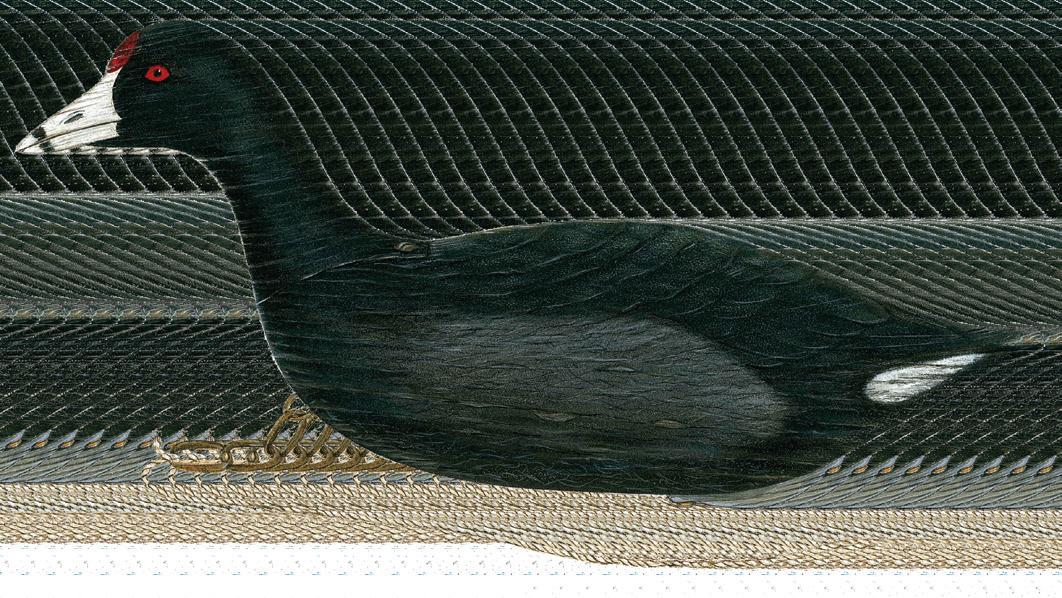
December
2nd and 3rd Harkers Island Elementary School
1163 Island Road, Harkers Island, NC
www.decoyguild.com


Saturday, December 2nd, 9:00 am - 5:00 pm; Sunday, December 3rd, 10:00 am - 4:00 pm. Admission: $10.00 daily, children under 12 free. Sunday is Youth Day, and all children under 18 will receive free admission and door prizes! Festival events include antique decoy exhibits, retriever demonstrations, children’s decoy painting, head whittling contest, and more. Over 90 exhibitors will be displaying and selling decoys and waterfowl artifacts. Sample local favorite dishes, such as clam chowder and banana pudding, in the school cafeteria. For more information, please visit the Guild’s website at www.decoyguild.com, or find us on Facebook!

CONDITIONS OF SALE ‑‑ PLEASE READ
1. GUARANTEE ‑ We have made a concerted effort to accurately catalog and describe the property to be sold. The decoys and paintings have guaranteed condition reports. Should the need arise, the auctioneer reserves the right to make verbal corrections and provide additional information from the block at the time of the sale. Absentee bids will not be executed on items that are found to be other than described in the catalog. Since opinions can differ, particularly in the matter of condition, the auctioneer will be sole judge in the matter of refunds. If we fail to identify a flaw that has an impact on the value, you can return the decoy.
2. DURATION OF GUARANTEE ‑ Request for a refund for items purchased IN PERSON at the auction must be made within 3 days of the sale. If you bid absentee, by phone, or on the internet, it is your responsibility to examine the lot immediately upon receipt and notify us of any issues. The guarantee will end 5 days from the date of delivery. Therefore, all guarantees on items purchased will become null and void 10 calendar days from the date of shipment. IT IS VERY IMPORTANT TO NOTE THAT IF YOU PAY LATE, YOU WILL NOT BE ELIGIBLE FOR THE GUARANTEE. Payment must be postmarked no later than 30 days after the auction.
3. PROTESTED BIDS ‑ In the case of a disputed bid, the auctioneer is the sole determinant as to who the successful bidder is, and at his discretion, may reoffer and resell the article in dispute. If a dispute arises after the sale, the auctioneer’s sales records shall be conclusive as to who the purchaser was, and the purchase price.
4. BIDDING Bidding usually starts below the low estimate and advances in increments of approximately 10% of the open ing bid subject to the auctioneer’s discretion. The auctioneer reserves the right, at his sole discretion, to refuse any bids that he deems unreasonable. The minimum bid increment guideline is as follows:
$500 to $1000 $25 $10,000 to $20,000 $500 $100,000 and above $2,000 $1000 to $10,000 $100 $20,000 to $100,000 $1,000
5. ABSENTEE BIDS ‑ Phone or mail bids, at the discretion of the Auctioneer, will be accepted with a 20% deposit. In such case, the bookkeeper will execute such bids competitively. Absentee bids are executed by the bookkeeper on behalf of the bidder in accordance with the bid increment policy shown above. Please review the rules governing both absentee and phone bids in the back of the catalog.
6. TERMS ‑ All items are to be paid for in U.S. funds on the day of the auction. No items will be released until they are paid for. Those who have not established an account with us and wish to pay by check, must do so prior to the beginning of the auction, by presenting a current letter of reference from their bank, or by providing references, that are suitable to the Auctioneer. The Auctioneer reserves the right to hold merchandise purchased by personal check, until the check has cleared the bank. Phone and absentee bidders ‑ You will be notified one week after the auction of your bids/results. PAYMENT IS DUE UPON RECEIPT. A late charge will be accessed on all balances not paid, at the rate of 12% A.P.R. commencing 30 days after the auction. If any accounts become more than 60 days overdue, the consignor will be given the name of the buyer who is responsible for holding up their funds. Guyette & Deeter will not carry insurance on items that are not paid for within 35 days of the auction. Also, the auctioneer may retain and/or recover the deposit specified as liquidated damages. In addition, the property can be resold at public or private sale without further notice. Any defi ciency resulting from such resale shall be paid to the auctioneer by the defaulting buyer, together with all charges, fees, and expenses incurred by such resale, or the enforcement of the obligation hereunder. Buyer agrees to pay all charges and expenses incurred by reason of any breach of the Terms and Conditions of Sale, including without limitation, reasonable attorney fees.
7. PAYMENT FOR PURCHASES CAN BE MADE WITH CREDIT CARD (VISA, MasterCard, American Express, or Discover), CASH, CHECK, OR WIRE TRANSFER.
8. BUYERS PREMIUM The buyer’s premium, assessed on each selling lot, is 20% of the hammer price up to and includ ing $1,000,000, plus 10% on any amount in excess of $1,000,000. For payments made using a credit card, the buyer’s premium is 23% up to and including $1,000,000, plus 13% on any amount in excess of $1,000,000.
9. TTAX ‑ THERE IS AN 6% SALES TAX IN MARYLAND. TAX IS WAIVED IF BUYER PRESENTS A VALID RESALE CERTIFICATE FROM ANY STATE OR HAS PURCHASES SHIPPED OUTSIDE OF MARYLAND.
10. ACCEPTANCE OF CONDITIONS ‑ Bidding on any articles in this catalog indicates your acceptance of all the above items.
11. BIDDING AGENT RESPONSIBILITY ‑ If you are registering for someone or if you execute a bid for someone else under your number, you are responsible for the settlement of that account. You are also responsible for examining the decoy(s) for your client regarding the guarantee.
12. WITHDRAWAL ‑ We reserve the right to withdraw any property before the sale and shall have no liability whatsoever for such withdrawal.
13. TITLE ‑ Title passes upon the fall of the auctioneer’s hammer. It will then be the responsibility of the buyer to make full payment prior to removing the goods from the premises. Removal is at both the buyer’s risk and expense, and must be made at the conclusion of the sale, unless other arrangements are made with the Guyette & Deeter staff. Any lots we might make arrangements for moving or storing are solely at the risk of the owner, and any damage or loss occurring after the fall of the hammer becomes that of the buyer.
14. LEGAL DISPUTE ‑ Any legal disputes arising from this auction shall be settled in the court system of the State of Maine. UNIFORM COMMERCIAL CODE The Maine Uniform Commercial Code, Title II, Section 2328 applies to this auction.
15. Cases are not included with shotgun shell boxes. All dimensions are approximate and are not guaranteed. All calls are sold “As Is”.
THE OFFICE WILL NOT BE OPEN UNTIL WEDNESDAY AFTER THE AUCTION.
ABSENTEE, PHONE, AND ONLINE BIDS
1. Absentee bids are a service provided to our customers free of charge. Every effort is made to execute all absentee bids, however, in the event of an error or omission, or failure to properly execute absentee bids, the Auctioneer shall not be held liable.
2. All absentee bids must be accompanied by a 20% deposit, which will be refunded immediately after the auction if your bid is unsuccessful. If your bid is successful, the deposit will be applied to the purchase price and the balance due upon presentation of your bill. All absentee bidders are notified by mail, whether successful or unsuccessful.
3. Visa and Mastercard numbers can be given in place of a check deposit, if your bid is submitted by phone. Your card number will not be used to make payments for purchases, it is only used as collateral. Your card number will only be used to make payment for purchases if you default on payment.
4. To execute an absentee bid, fill out the enclosed form listing catalog number, description, and your top bid price (not including the 20% buyer’s premium). Send this together with your deposit as soon as possible. If your bids are sent seven days or less prior to the auction, you should call our office three days prior to the auction, to confirm that we have received your bids. If they have not been received at that point in time, we will take your bid over the phone. We cannot guarantee that bids received after the auction has started will be executed.
5. If two or more bids are received on the same item from different people, the bidding will open at the next logical raise above the second highest bid. If two absentee bids are received with the exact same amount, the first one received will take precedence.
6. All bids must be in even dollar amounts. Bids in fractions of dollars will be considered the next lower even dollar amount.
7. Bid increments: The bid increment policy, which also applies to both absentee and phone bidders, is listed under “CONDITIONS OF SALE” (item #4), in the front of the catalog.
8. Open bids, bids with no set top amount, or orders to just simply buy the lot, cannot be accepted. You must have a definite top limit before we can execute your bid. Alternatives to this are as follows:
a. To bid over the telephone. This can be done by simply sending a 20% deposit for what you wish to bid on the object. This will bind whatever bid amount you wish to bid over the telephone. (NOTE: There are only 8 phone lines into the auction room and phone bids will be handled on a first come, first serve basis.)
b. Some bidders concerned that a lot might just go for one bid above their top limit, leave a top bid plus one bid. This works as follows: the top bid submitted might be $1,000, but not wishing to lose the lot for simply $25 more, the party might bid $1,000 + 1 bid if they definitely don’t want to go over a certain price, they would indicate $1,000 +1 ($1,025) (NOTE: One possible problem that occasionally arises with absentee bids is when someone in the audience bids exactly the amount, which you specify is your limit. In such a case, we would not go one extra bid unless your bid sheet indicates “plus one” bid.).
9. If you are a successful bidder, a bill will be sent a few days after the auction. Purchasers should indicate their desired method of shipment, if such is necessary. There is a charge for shipping, labor, materials, and insurance. Please provide notice in writing if items are covered under your own insurance policy. Shipping is done on a first come, first serve basis, and can take up to 4 weeks Please note that a certified check, Visa, Mastercard, or any other form of guaranteed funds will expedite shipping.
10. For expensive oil paintings and delicate carvings, we need a written statement from the purchaser, assuming the responsibility of pursuing any claims, in the event of damage incurred during shipping. Valuable lots need to be sent 2nd day air UPS due to values. Under no circumstances will we be liable for damage to glass or frames, or fragile decoratives, regardless of cause.
11. TERMS Phone and absentee bidders You will be notified one week after the auction of your results. Payment is due upon receipt. Interest will be charged on all balances not paid within 30 days after the bill is sent at the rate of 12% APR. If any accounts become more than 60 days overdue, the consignor will be given the name of the buyer who is responsible for holding up their funds. If an account is 75 days overdue, the items may be returned to the consignor and overdue buyer will pay the buyers premium and commission from the sale, if they wish to participate in future Guyette and Deeter auctions.
12. Bidding on any article(s) indicates your acceptance of these terms above.
13. If you would like any additional information on any of the lots, please contact: Jon Deeter at (440) 610-1768, Zac Cote at (207) 321-8091, or Gary Guyette at (410) 745-0485.
If you have any questions concerning absentee bids, please call us.
OFFICE:
PO Box 1170
OFFICE: PO Box 1170
St. Michaels, MD 21663
St. Michaels, MD 21663
410-745-0485
410-745-0485
Fax 410-745-0487
Fax 410-745-0487
michael@guyetteanddeeter.com
decoys@guyetteanddeeter.com
I desire to bid on the following items in the sale. The bids are to be executed by Guyette & Deeter, up to but not exceeding the amount(s) specified on the below bids. All bids will be executed and accepted subject to the Terms of Sale and Absentee Bids Procedure outlined in the catalog. (Please be sure that you understand our procedures before using this Absentee and Phone Bid Form.) Office will not be open until Wednesday after the auction.
A PREMIUM OF 20% WILL BE APPLIED TO ALL ITEMS SOLD, TO BE PAID BY THE BUYER

EMAIL
Page 2 NAME PHONE AUCTION DATE OFFICE USE IN CATALOG # ORDER DESCRIPTION BID AMOUNT


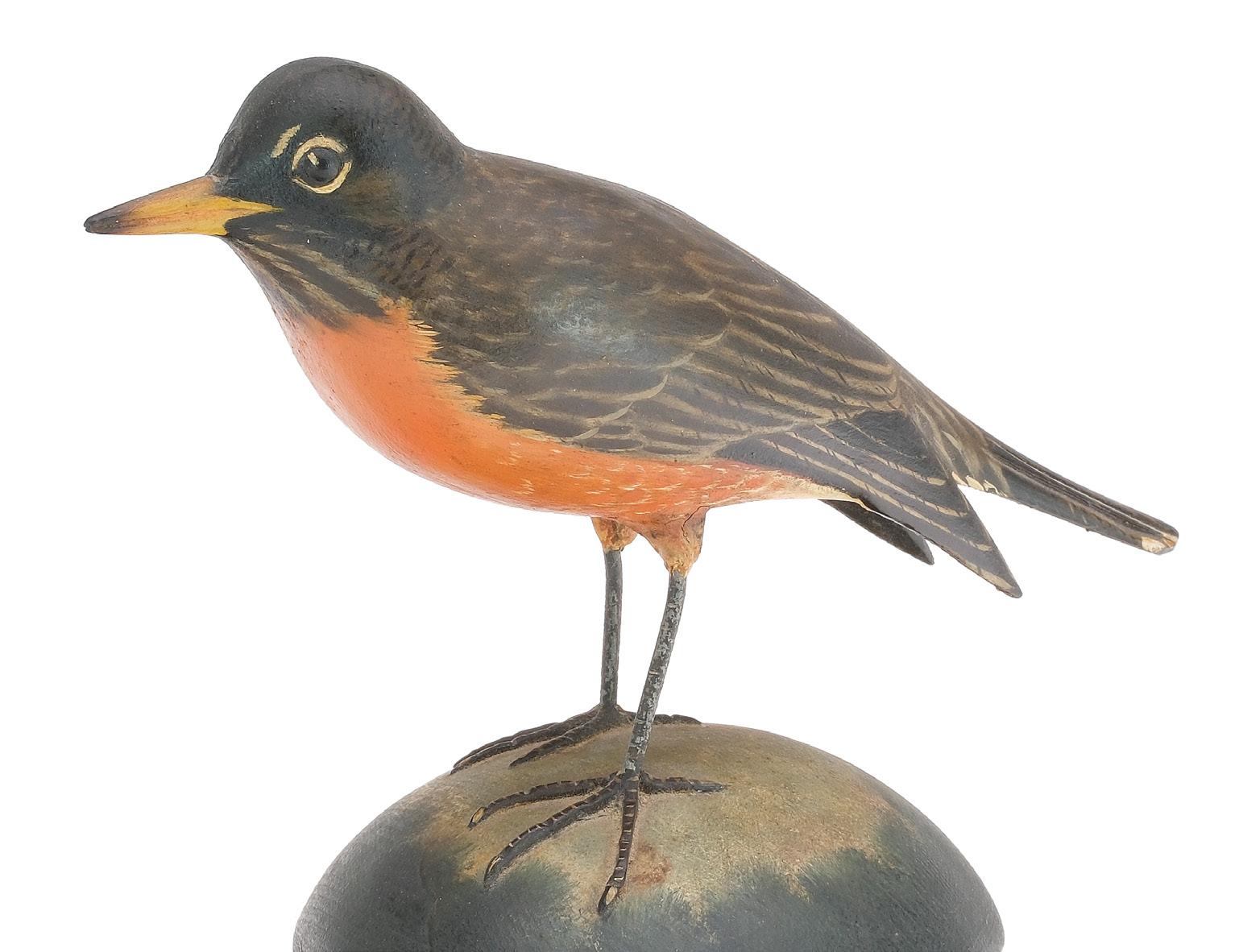
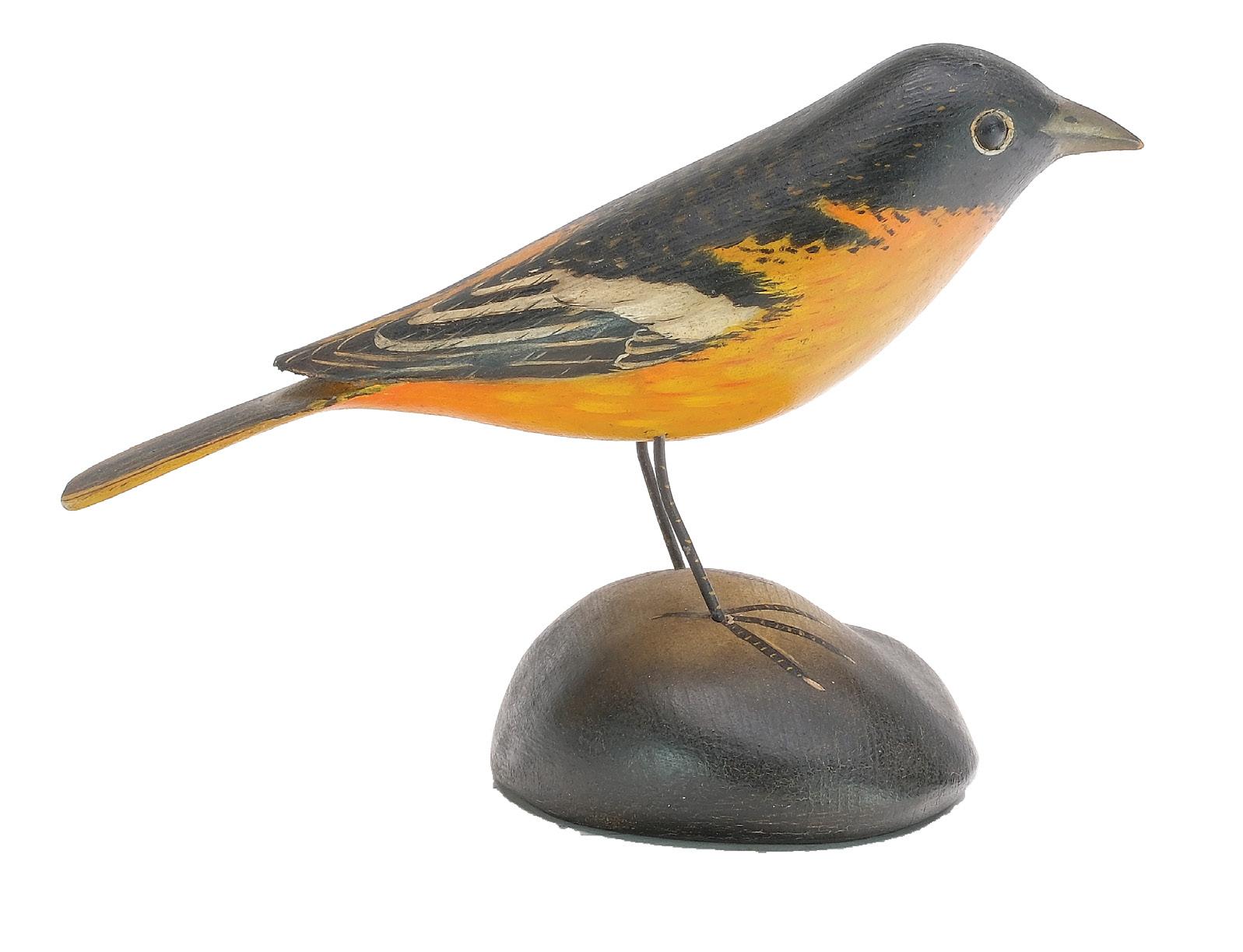
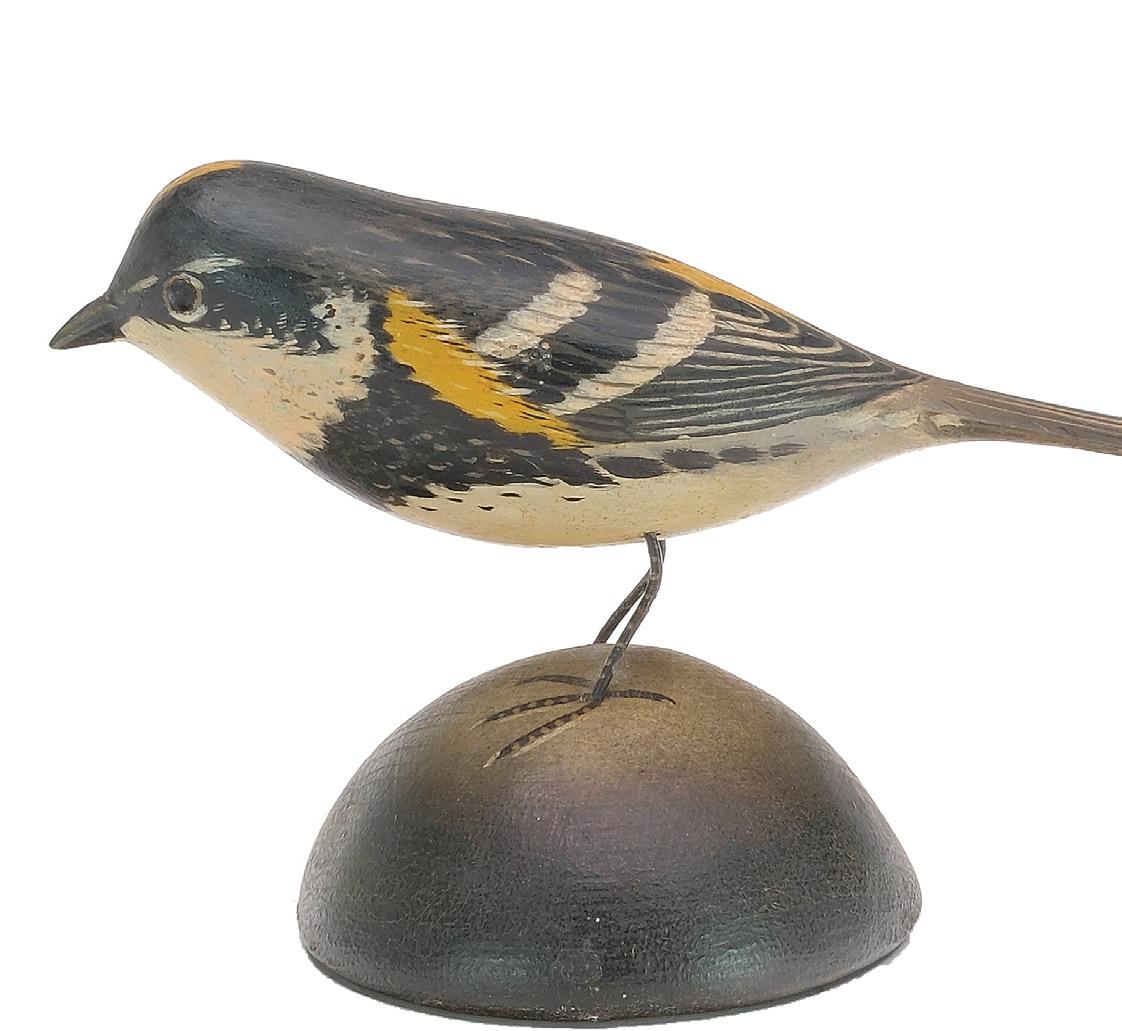


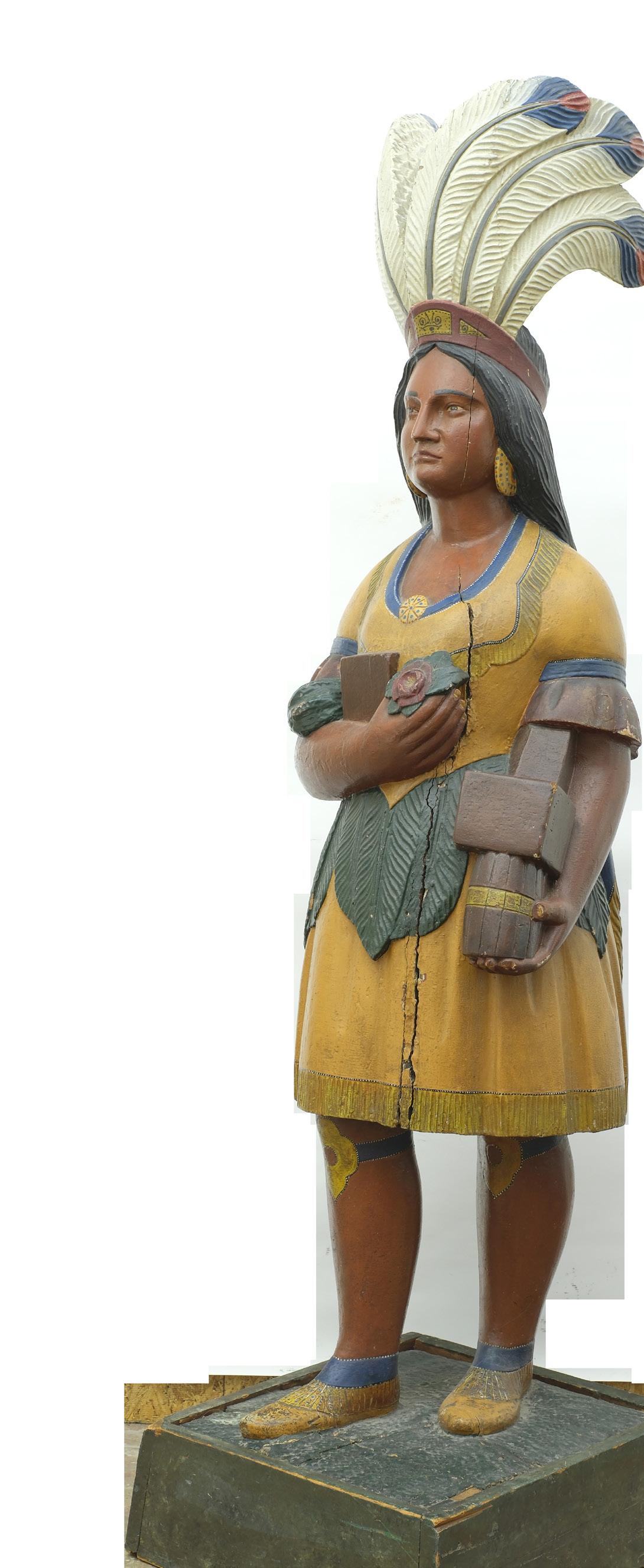
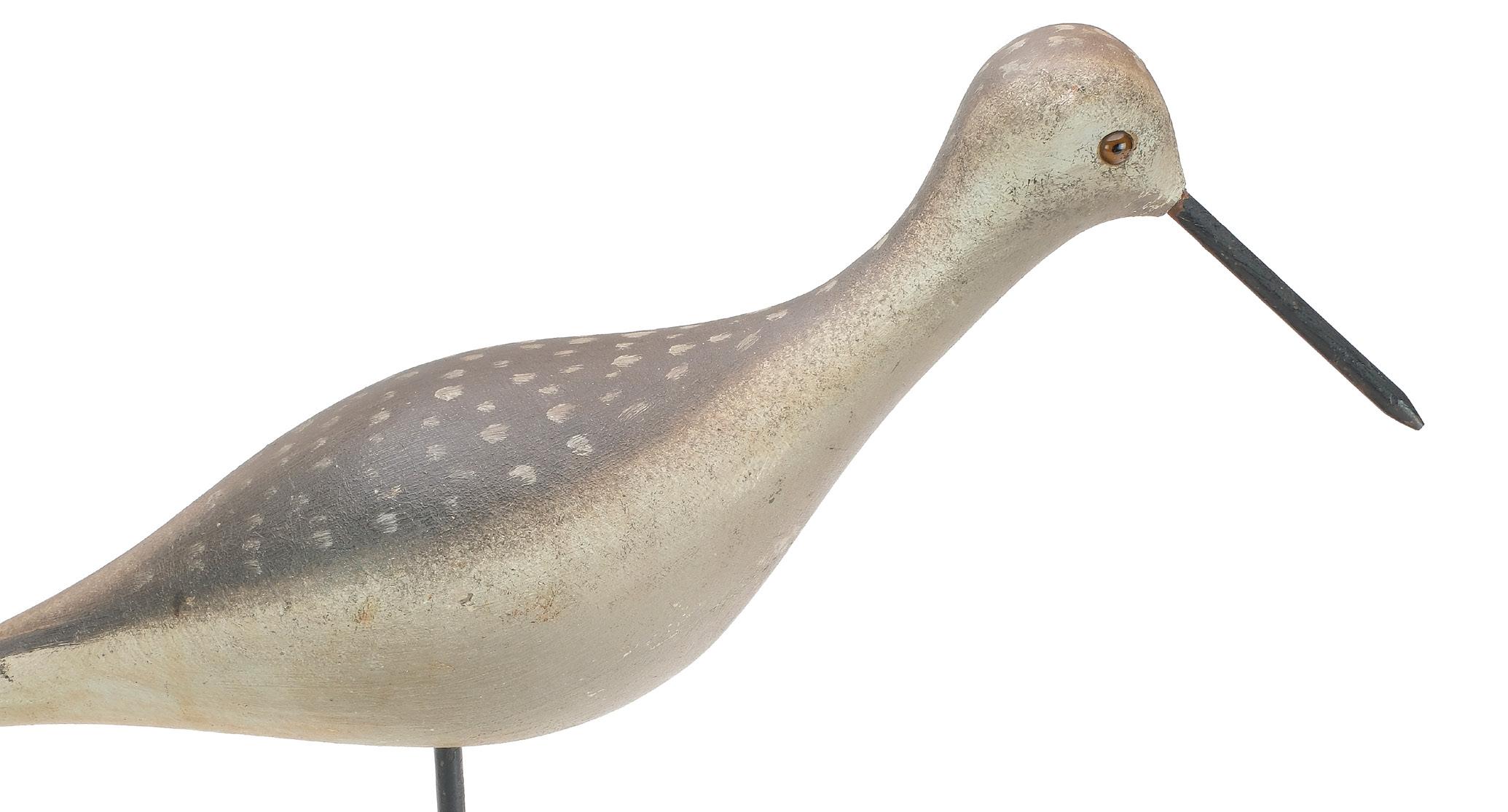
119a 105a - 105d 239a 264 233a 319




Guyette & Deeter, Inc. PO Box 1170, St. Michaels, MD 21663 www.guyetteanddeeter.com 410-745-0485








































































































 Doughty family Canada goose pictured in “Decoys: North America’s One Hundred Greatest,” Loy S. Harrell, Jr.
Doughty family Canada goose pictured in “Decoys: North America’s One Hundred Greatest,” Loy S. Harrell, Jr.













 George Doughty hunting shorebirds, circa 1890, most likely on Cobb’s Island. Photo credit, “Wings of Wonder,” Lloyd Newberry
Photo credit, “Wings of Wonder,” Lloyd Newberry
George Doughty hunting shorebirds, circa 1890, most likely on Cobb’s Island. Photo credit, “Wings of Wonder,” Lloyd Newberry
Photo credit, “Wings of Wonder,” Lloyd Newberry


















 The Pusey brothers, John M and Clarence
Pusey farm
The Pusey brothers, John M and Clarence
Pusey farm






 James T Holly c1880
James T Holly c1880

















































 Lloyd Parker mergansers pictured in “Decoys: North America’s One Hundred Greatest,” Loy S. Harrell, Jr.
Lloyd Parker mergansers pictured in “Decoys: North America’s One Hundred Greatest,” Loy S. Harrell, Jr.

















































































 - Frank Finney
- Frank Finney









































 150 Pair of canvasbacks, Ward Brothers, Crisfield, Maryland. Balsa bodies with slightly turned heads. Thick stipple paint on backs. Signed and dated 1952 on the underside. Measure 15” and 16.5” long. Original paint with minor to moderate gunning wear; small dents on drake’s back; tight crack along one side of hen.
(2,500 - 3,500)
151 Rigmate pair of bluebills, Ward Brothers, Crisfield, Maryland. Both are signed and dated 1972 on the underside. Heads are turned. Excellent stipple painting on backs of both with fine detail feather painting. 15” long. Original paint with very minor wear; varnish from underside spilled over to lower side pocket on drake.
150 Pair of canvasbacks, Ward Brothers, Crisfield, Maryland. Balsa bodies with slightly turned heads. Thick stipple paint on backs. Signed and dated 1952 on the underside. Measure 15” and 16.5” long. Original paint with minor to moderate gunning wear; small dents on drake’s back; tight crack along one side of hen.
(2,500 - 3,500)
151 Rigmate pair of bluebills, Ward Brothers, Crisfield, Maryland. Both are signed and dated 1972 on the underside. Heads are turned. Excellent stipple painting on backs of both with fine detail feather painting. 15” long. Original paint with very minor wear; varnish from underside spilled over to lower side pocket on drake.



















































































 (6,000 - 9,000)
(6,000 - 9,000)























































 Provenance: Mark Goldman collection.
(20,000 - 30,000)
Provenance: Mark Goldman collection.
(20,000 - 30,000)






















































































 289
289



























































































 (8,000 - 12,000)
Oliver Lawson
(8,000 - 12,000)
Oliver Lawson


















































































































 Provenance: Ex Charlie Hunter collection. (10,000 - 15,000)
Provenance: Ex Charlie Hunter collection. (10,000 - 15,000)
















































































































